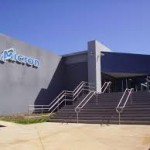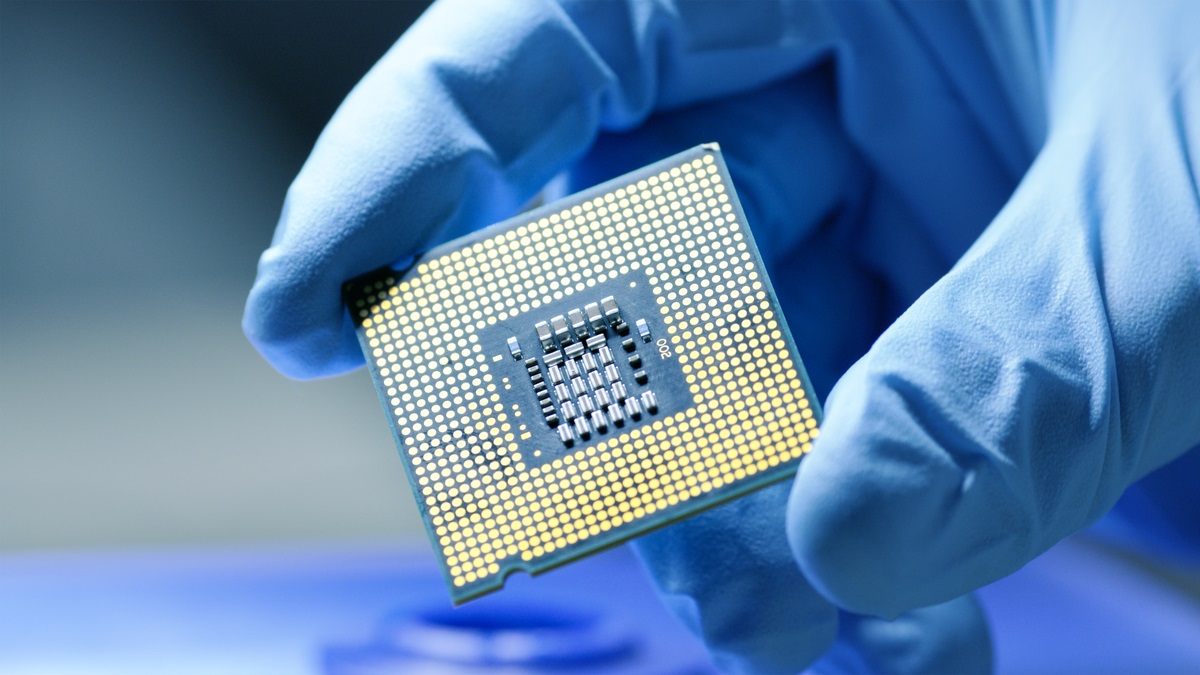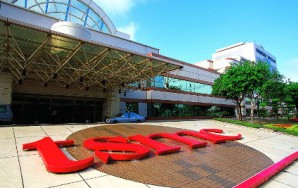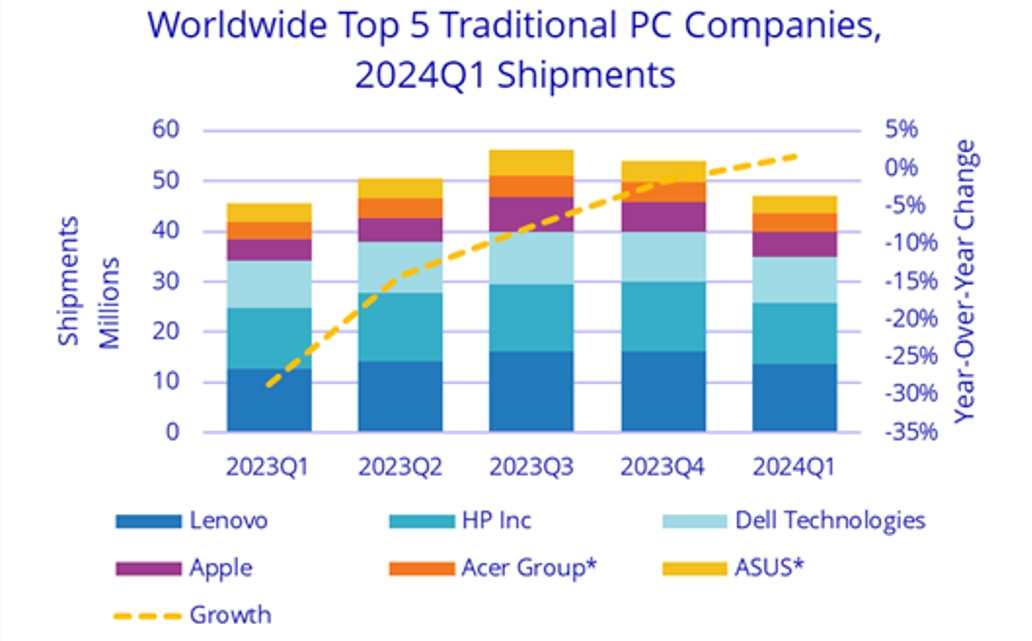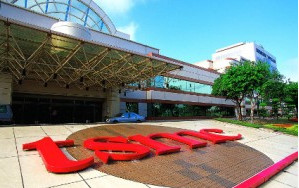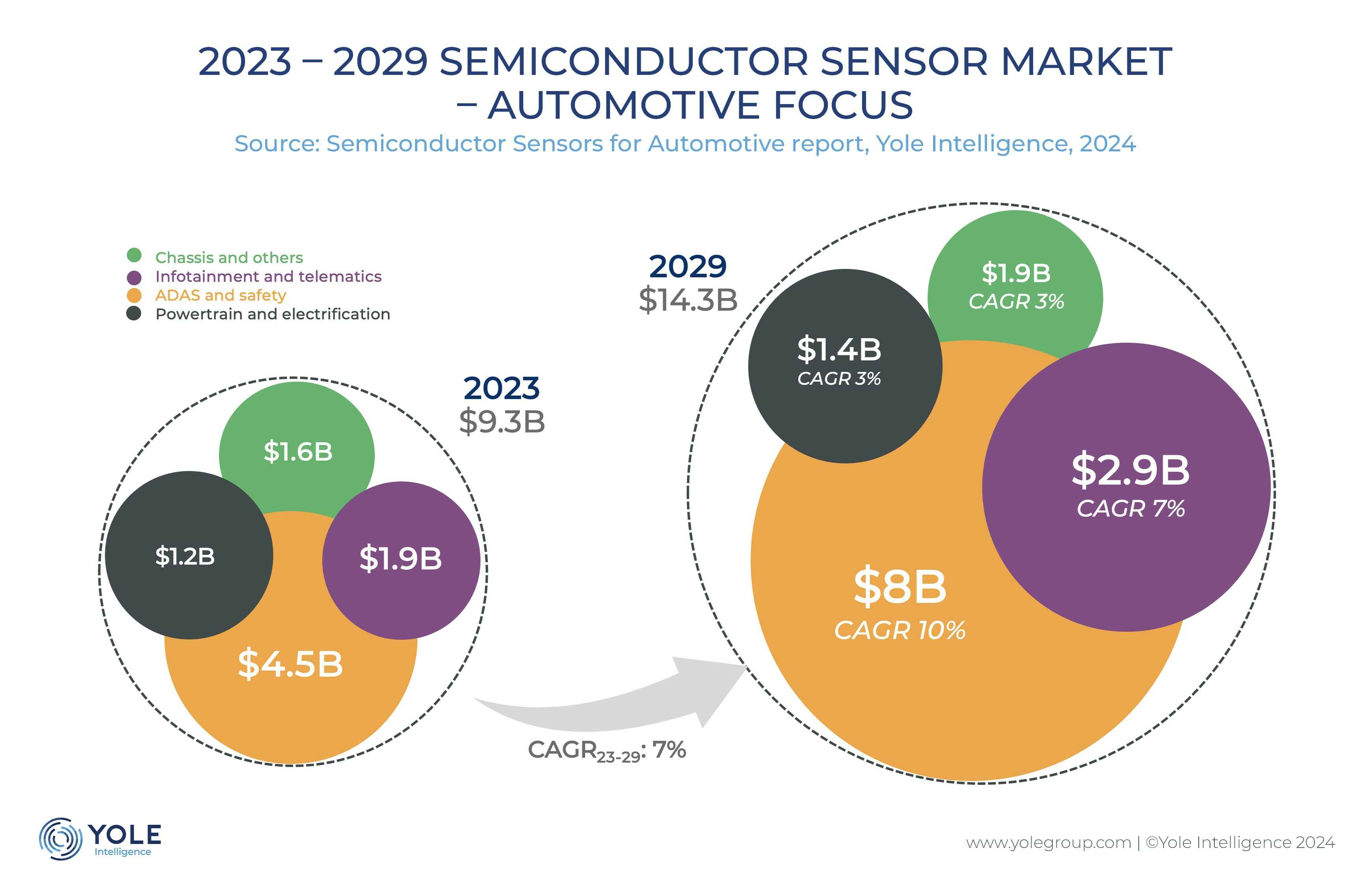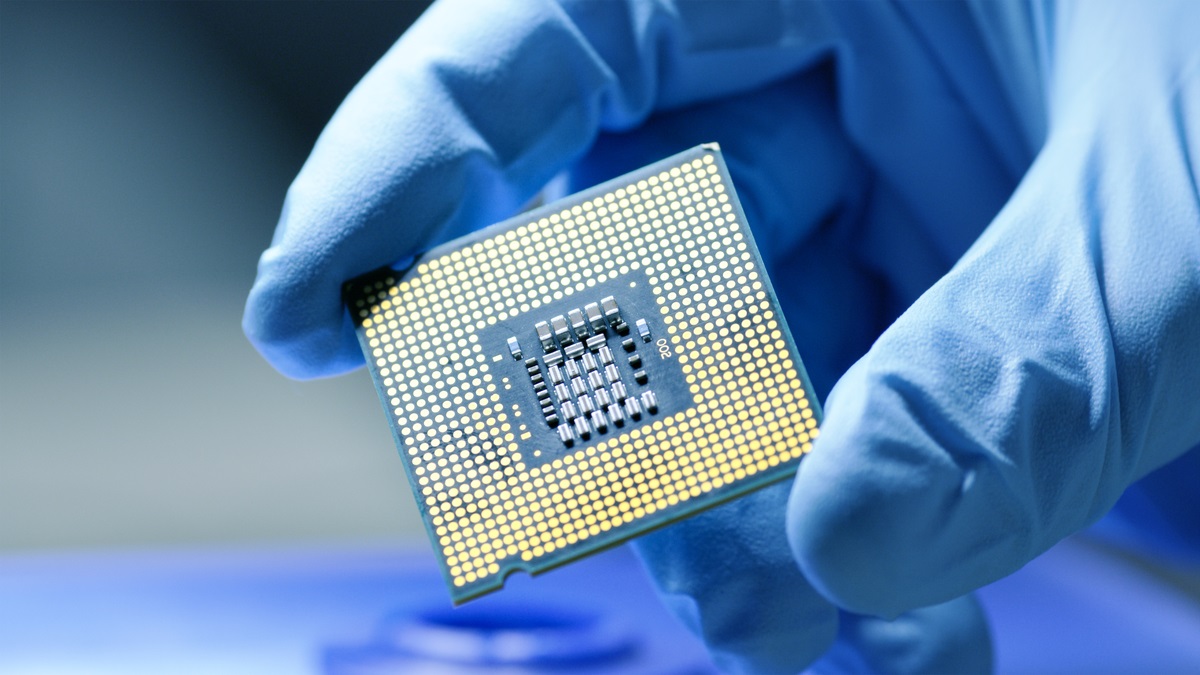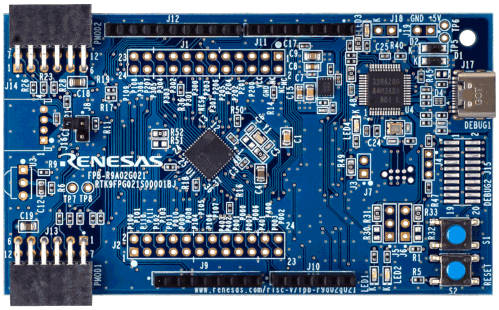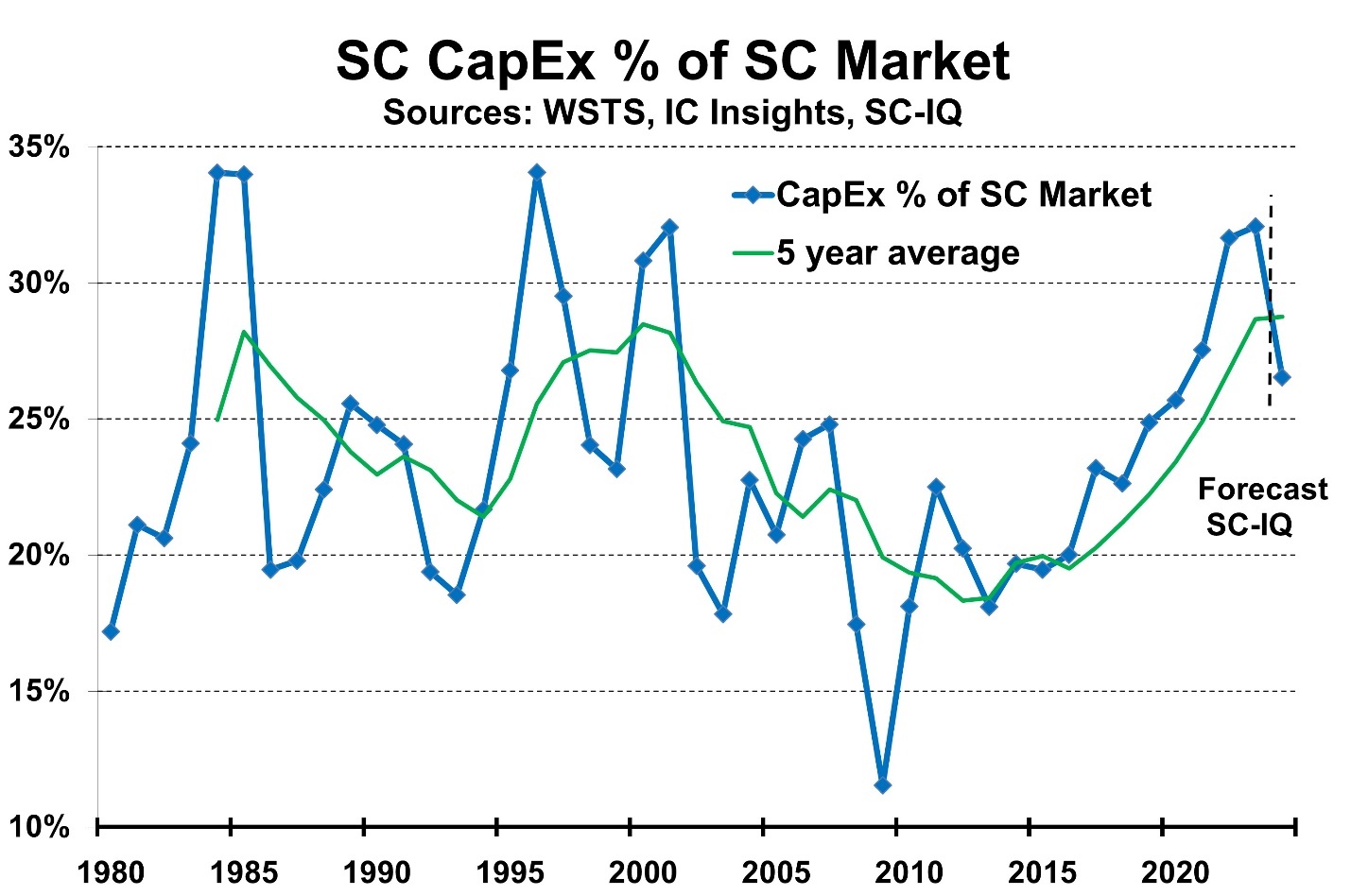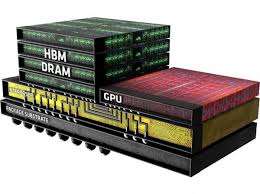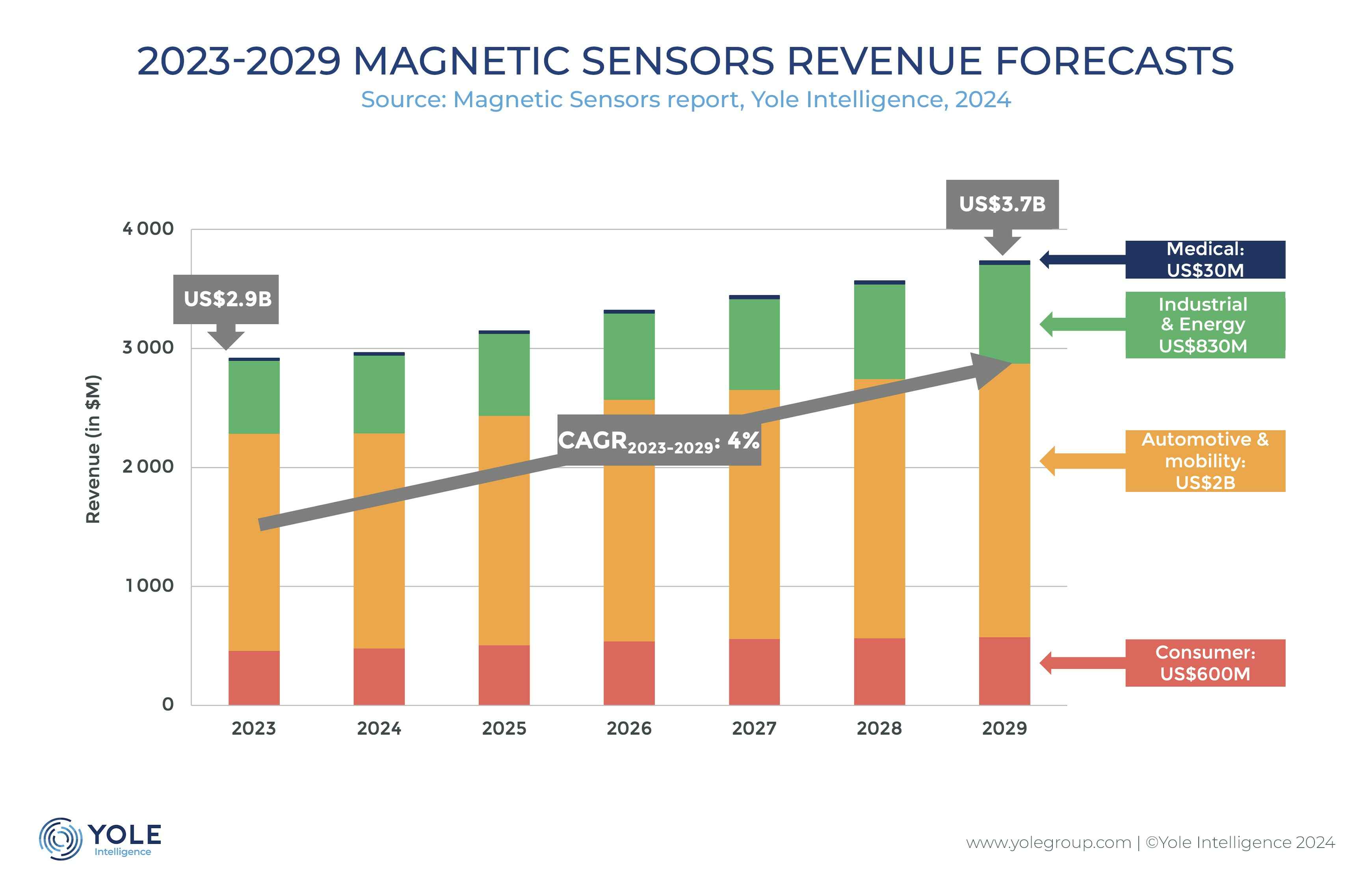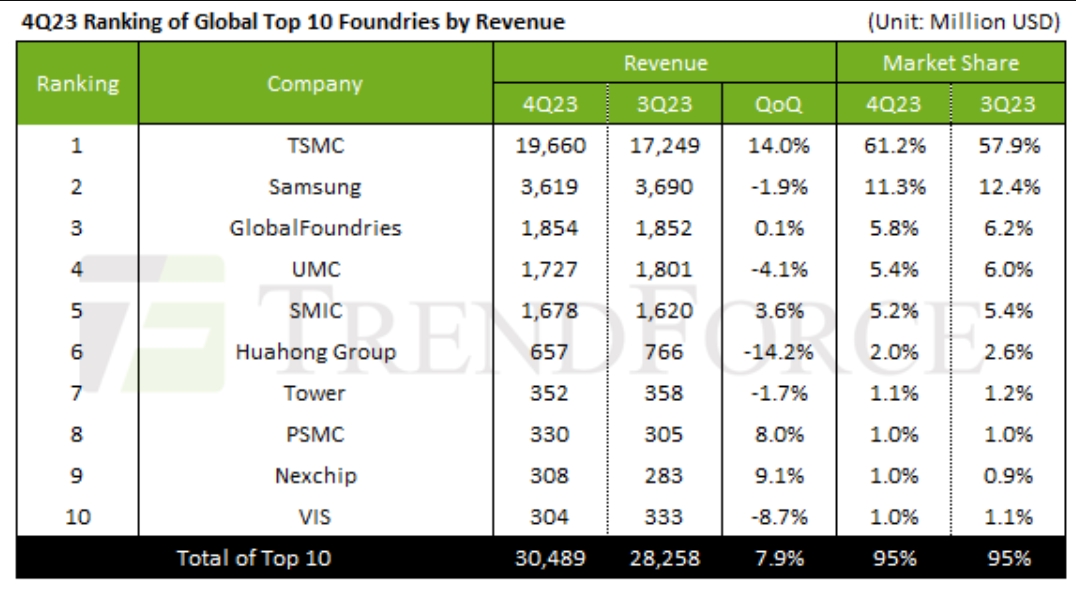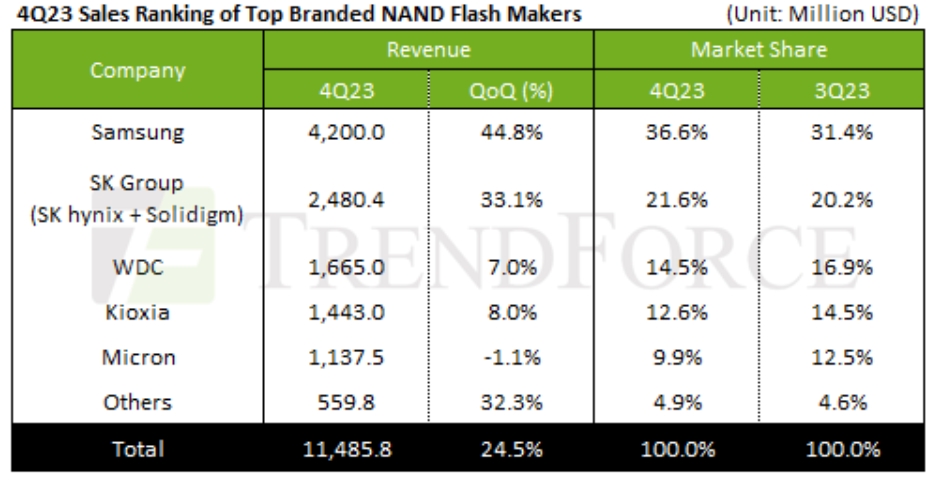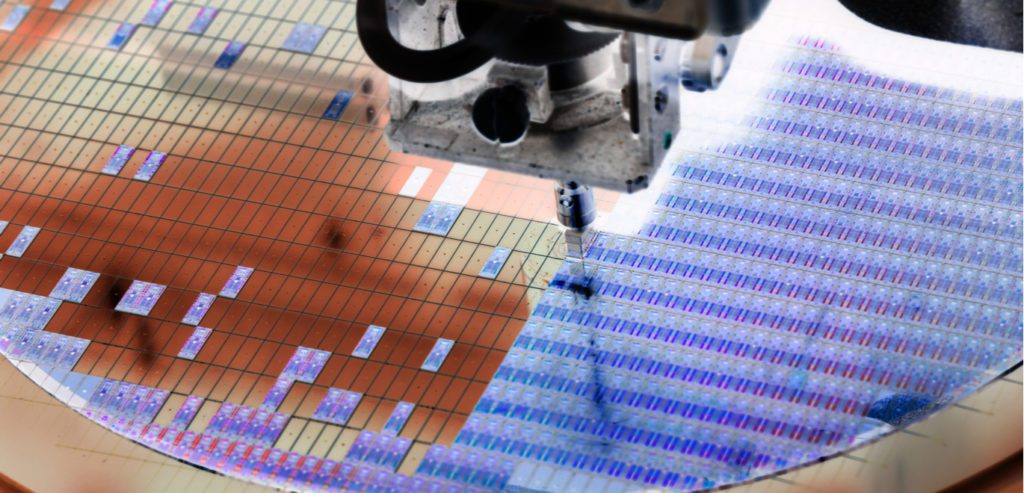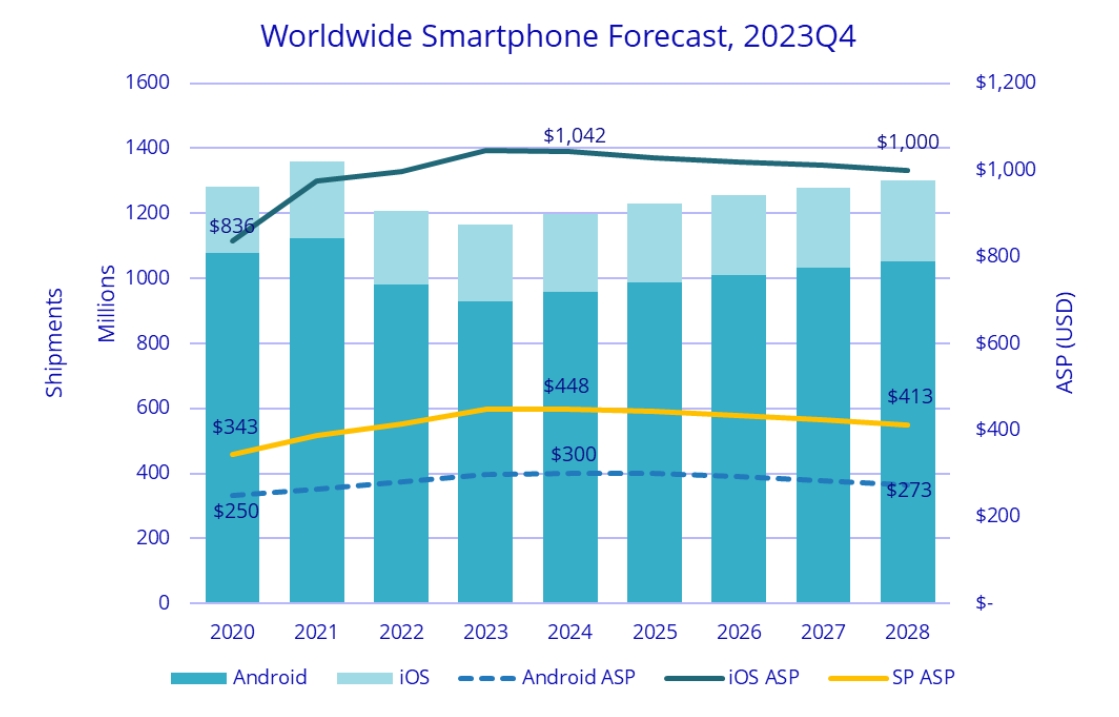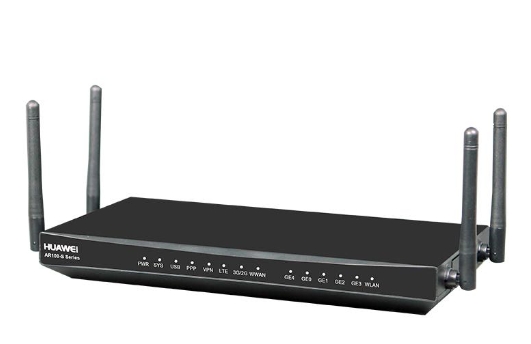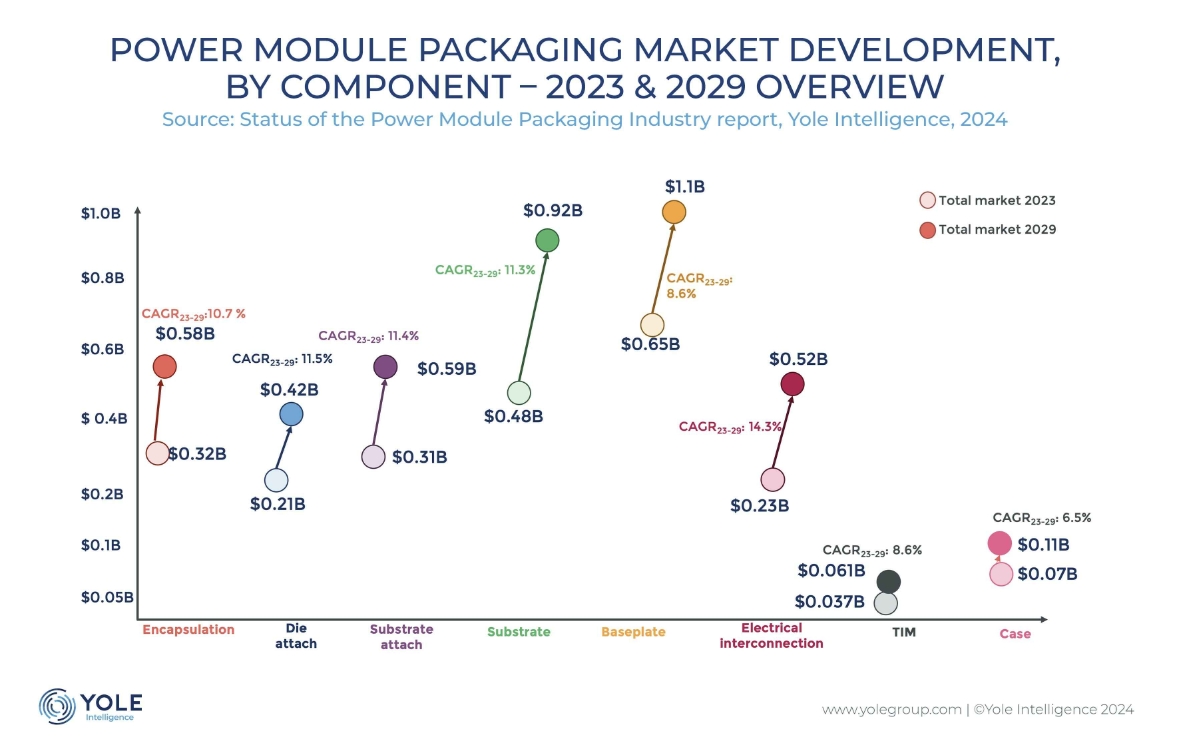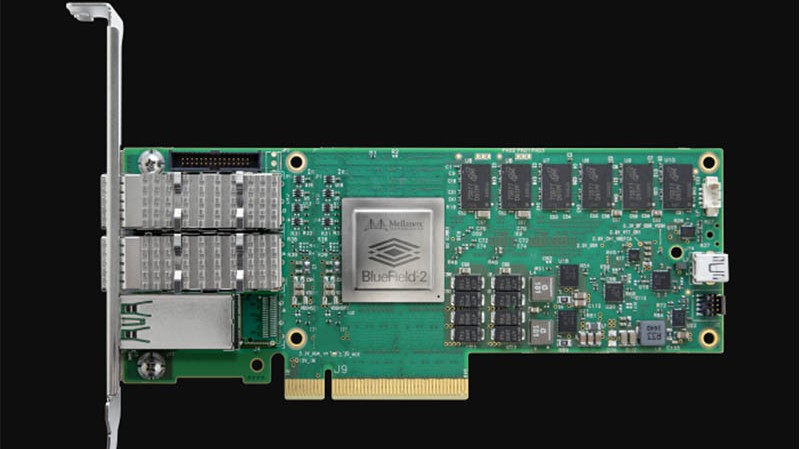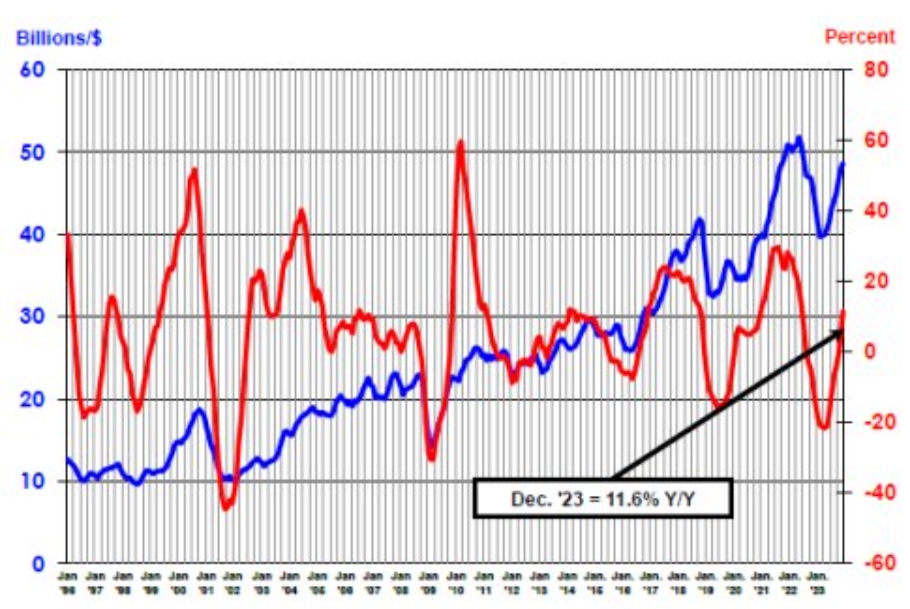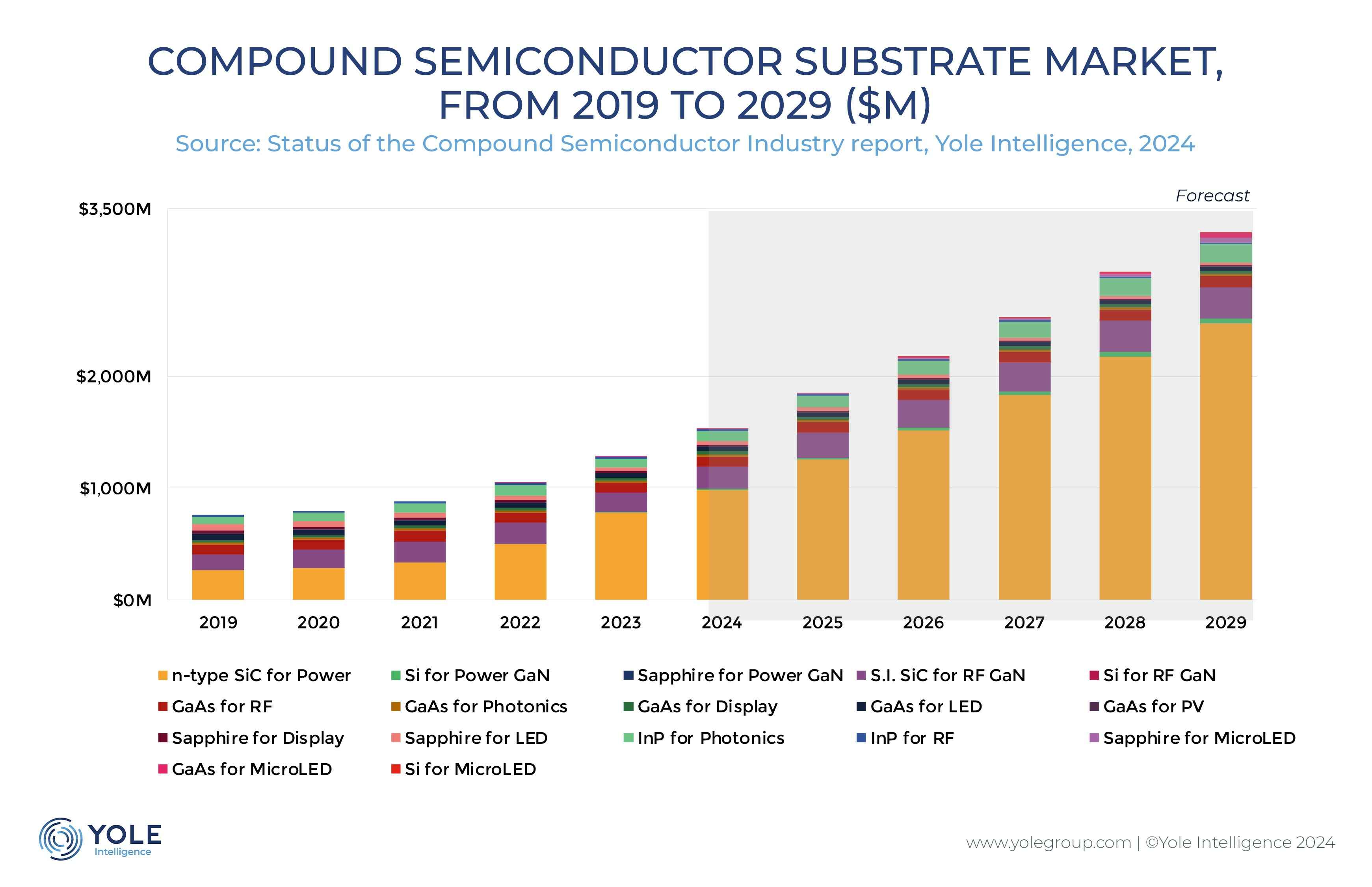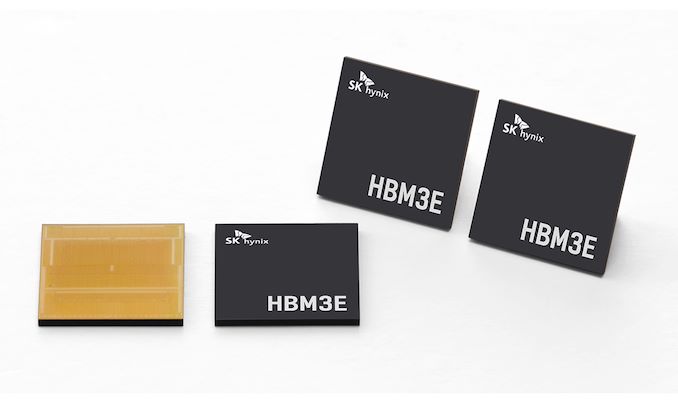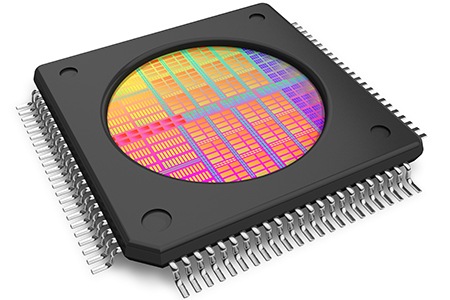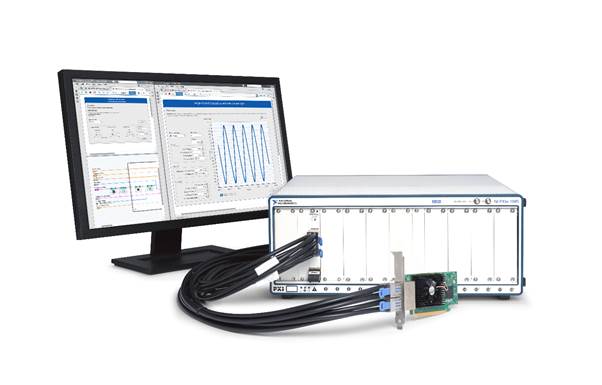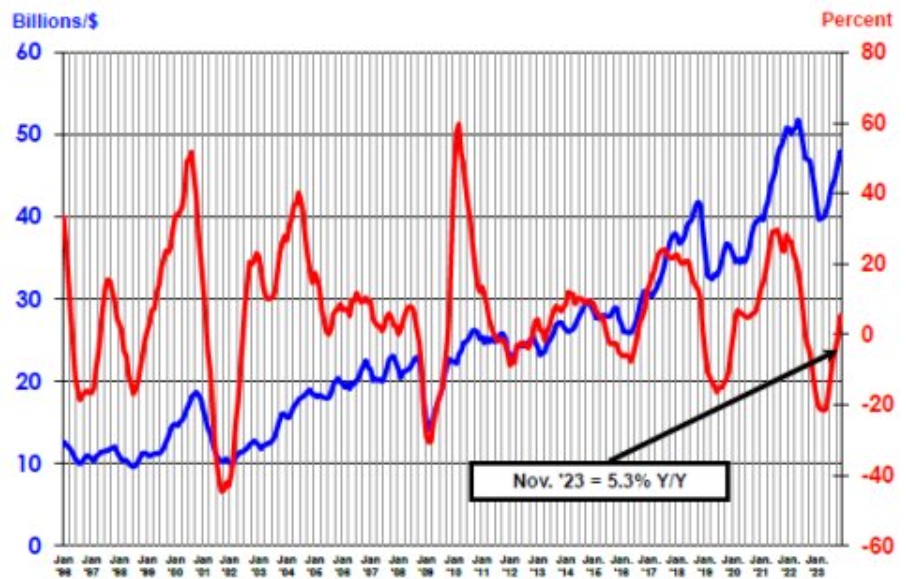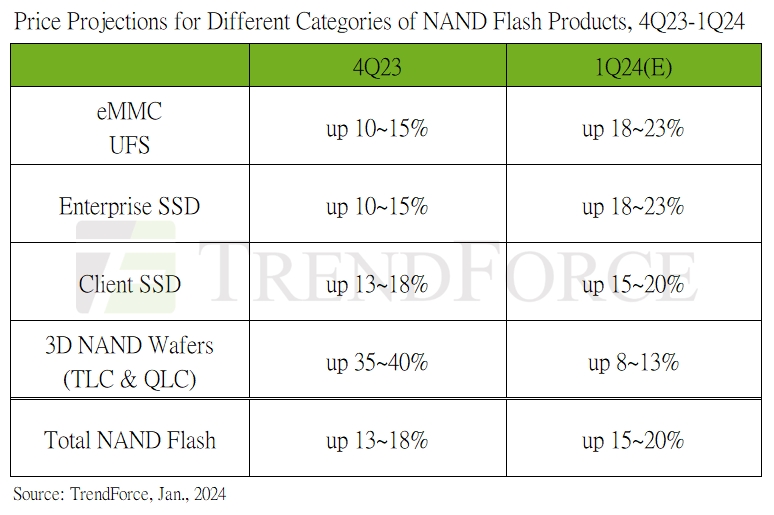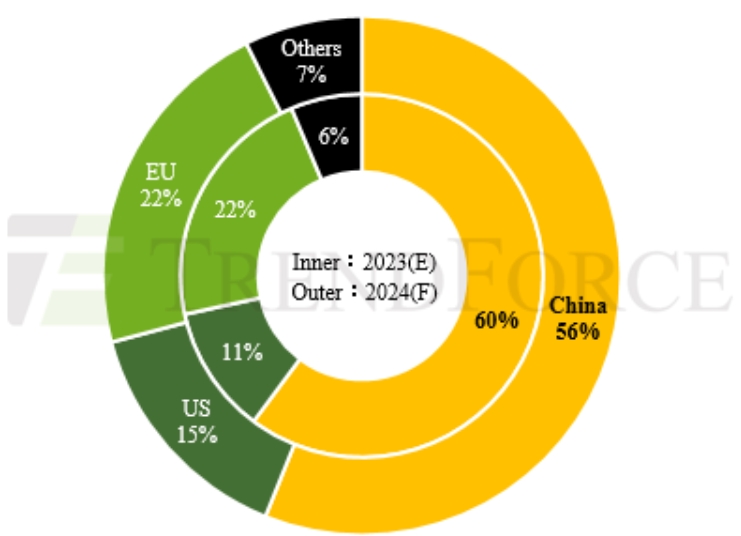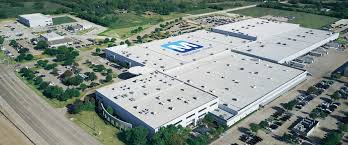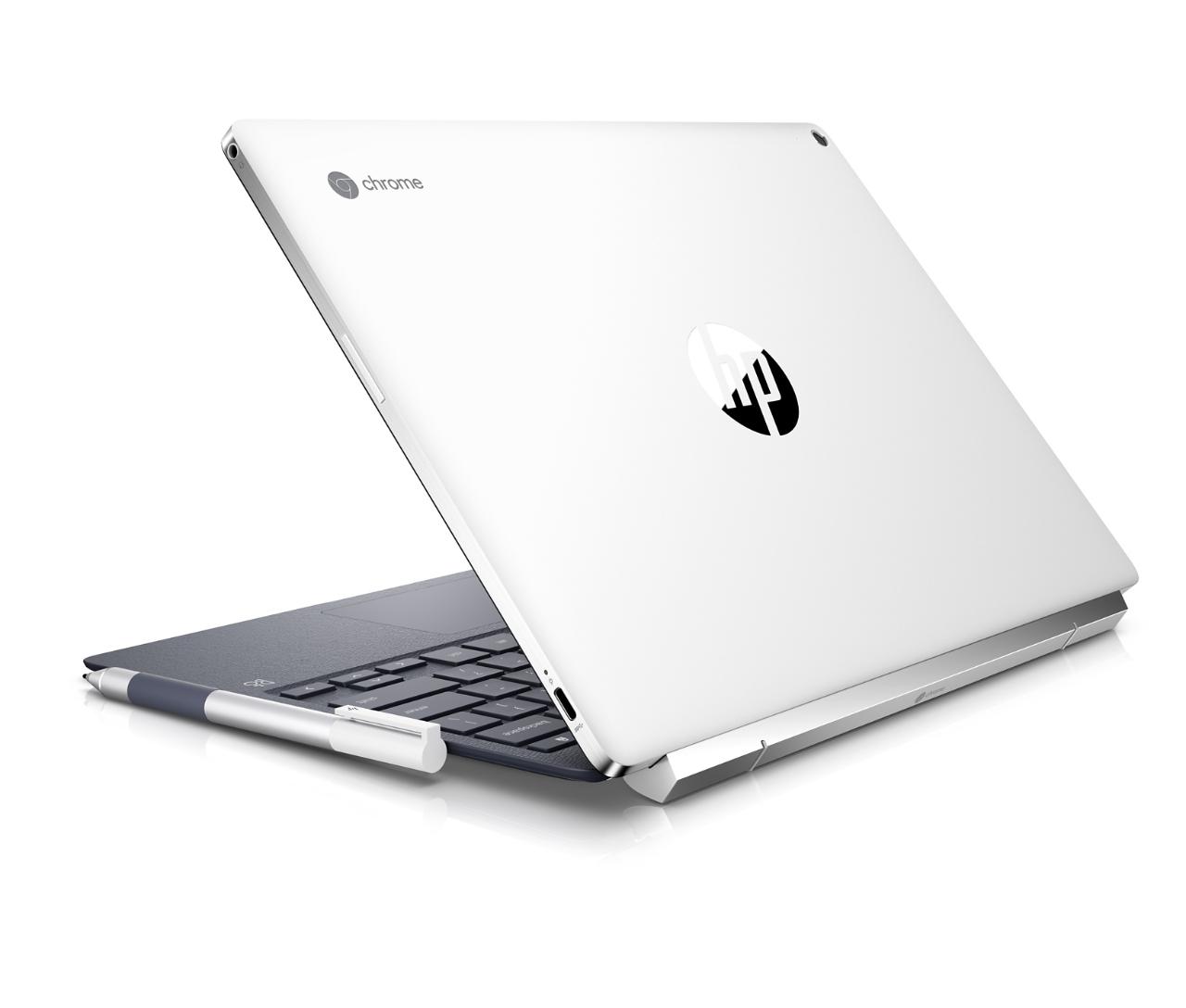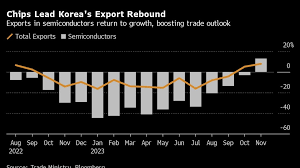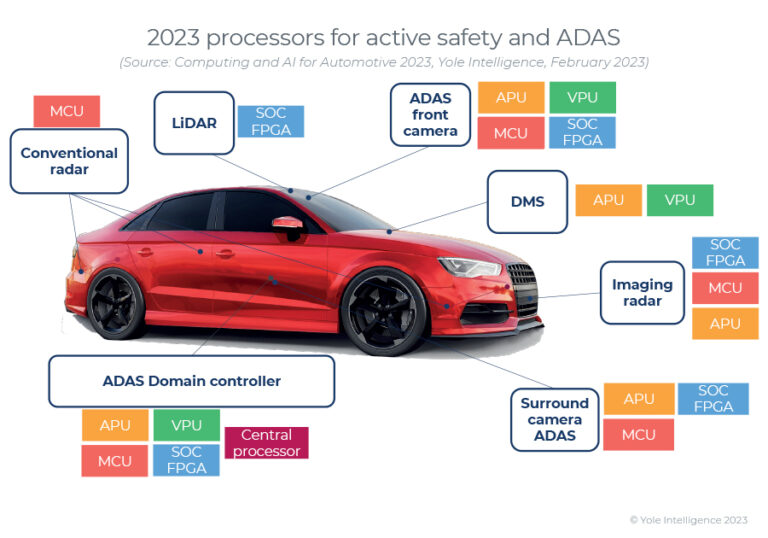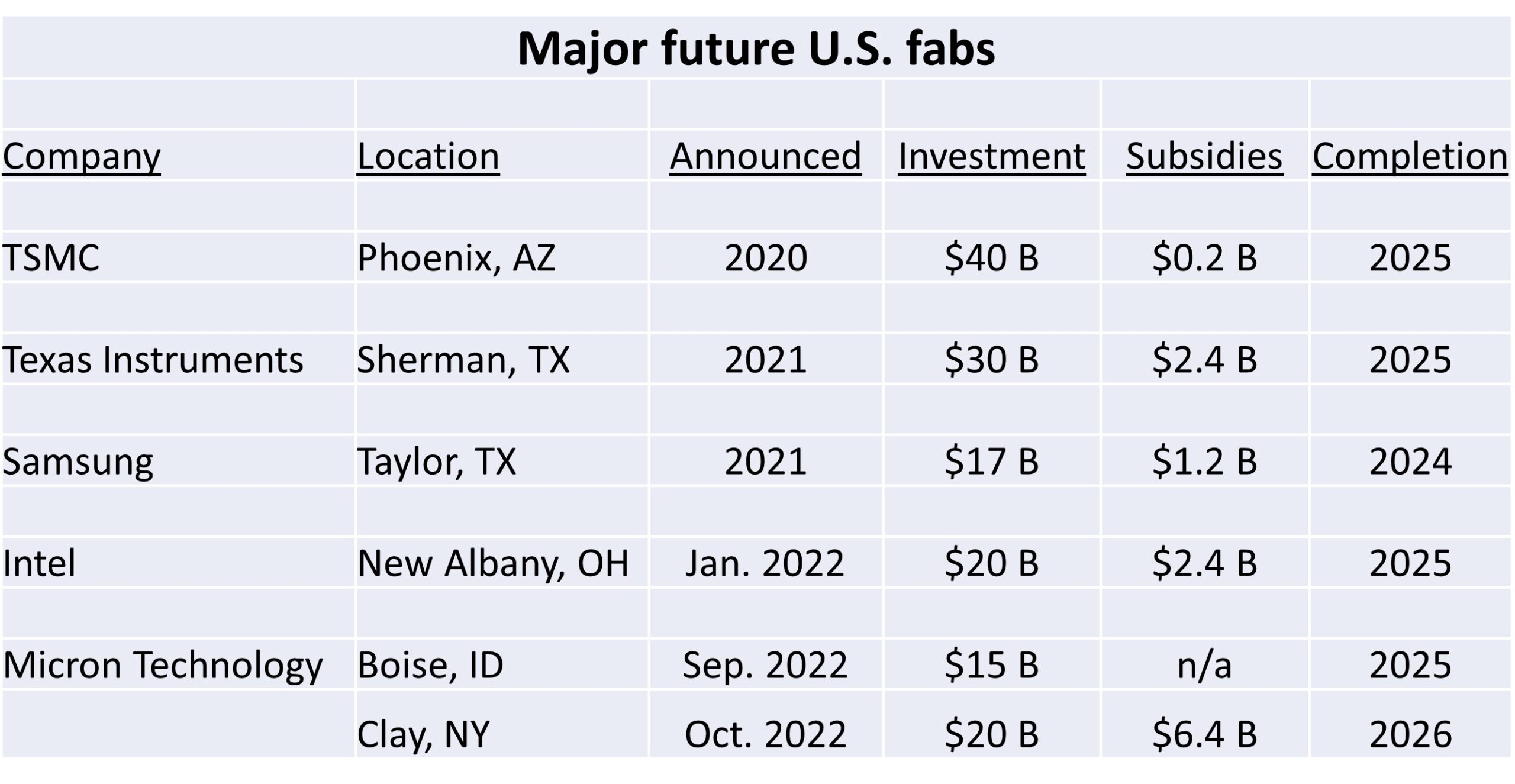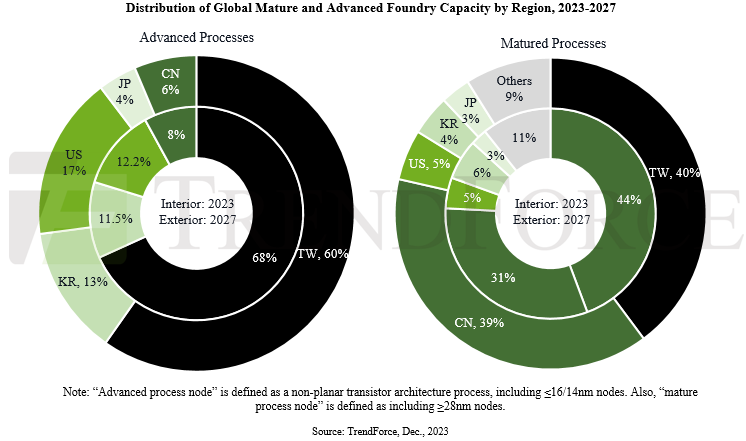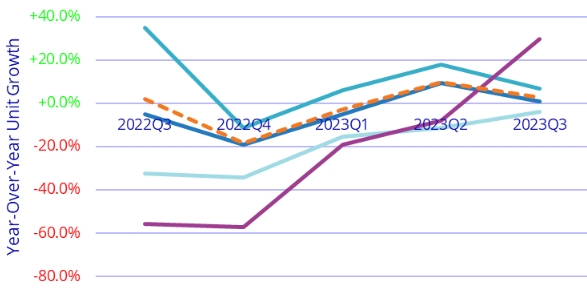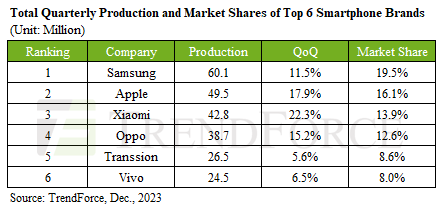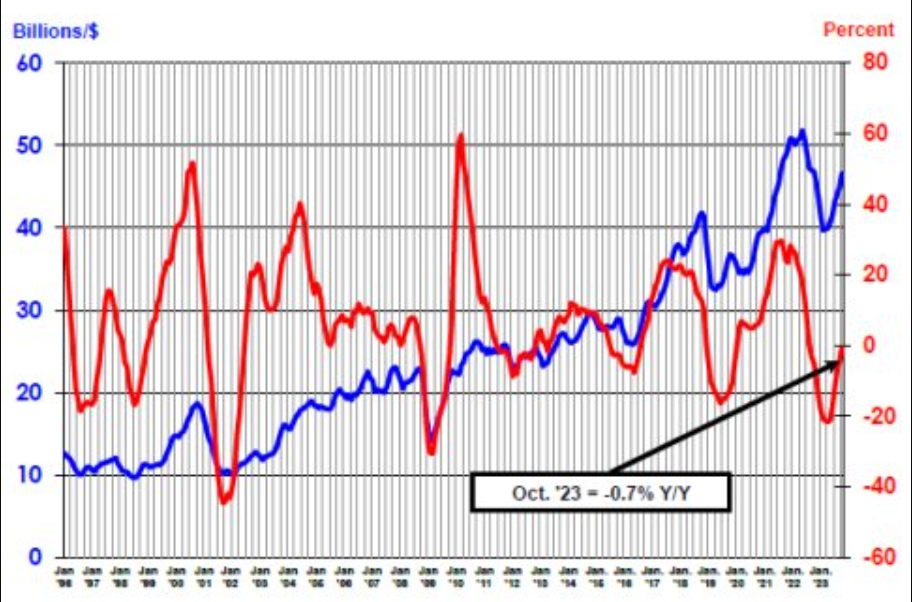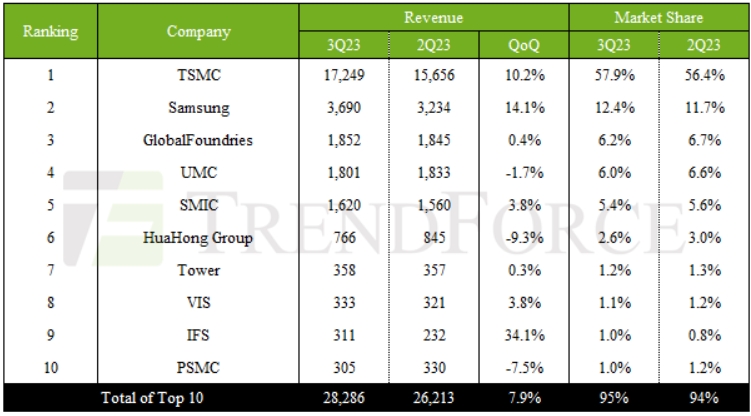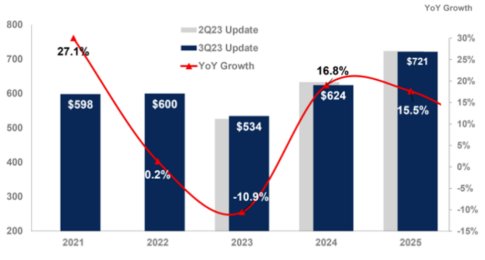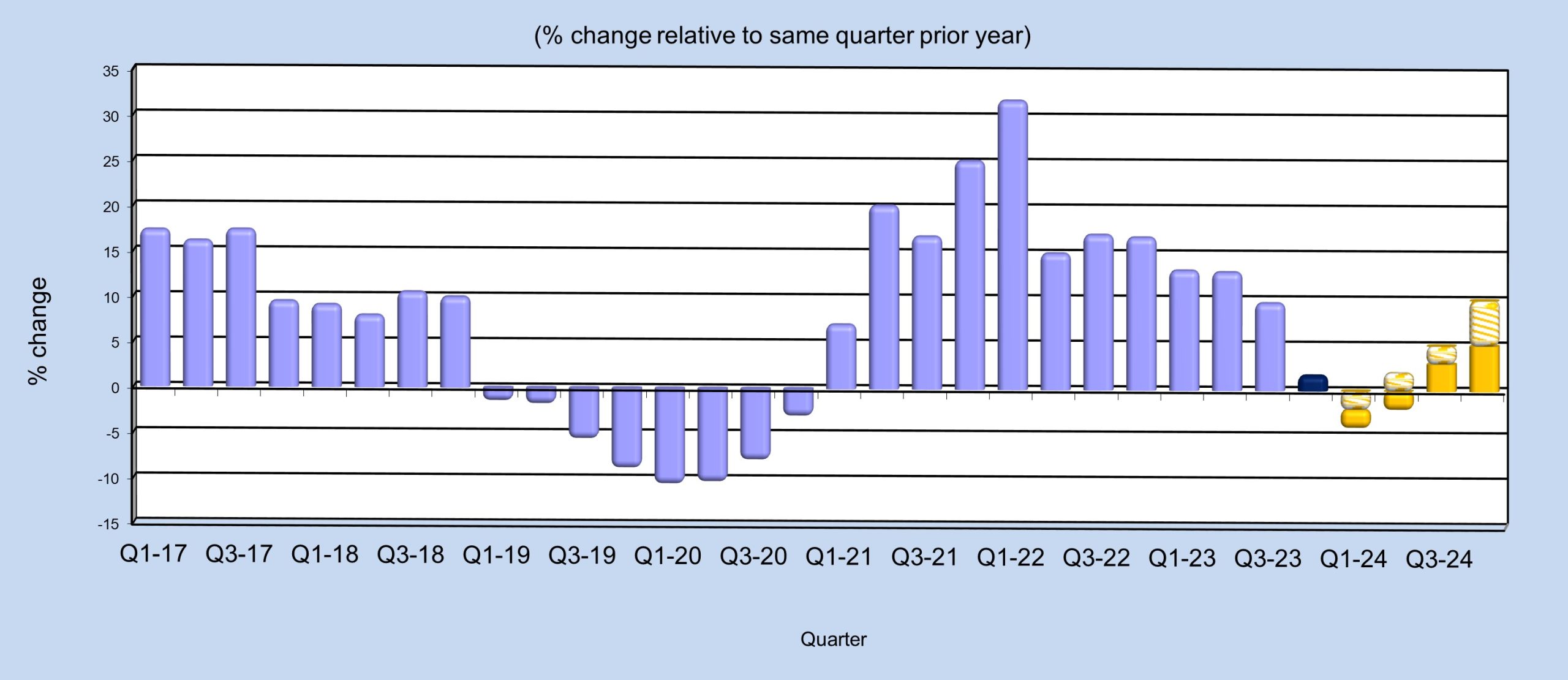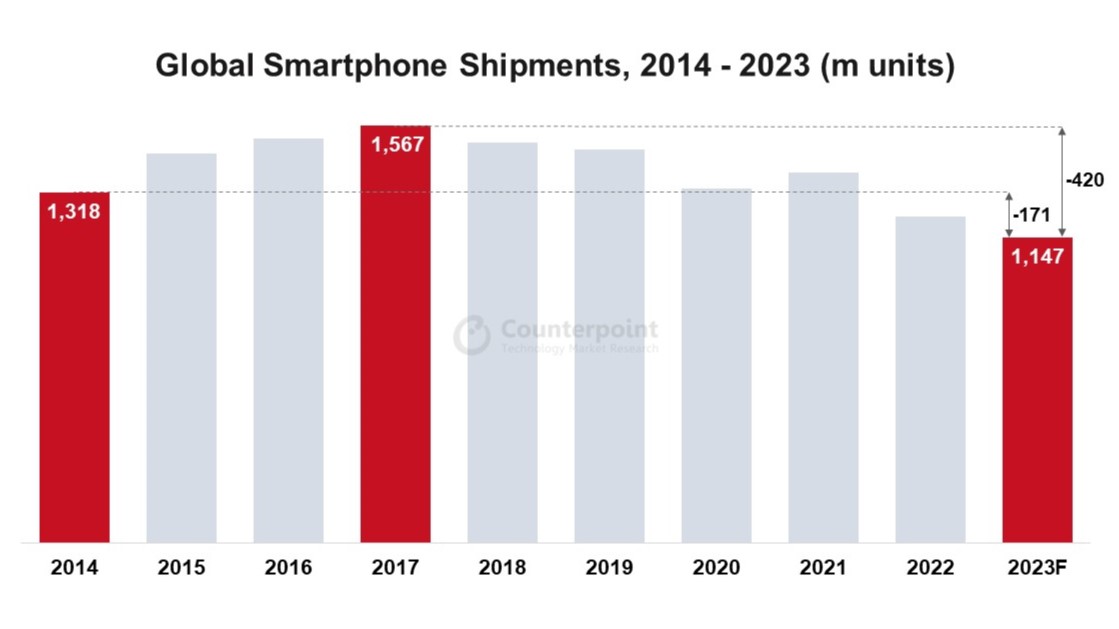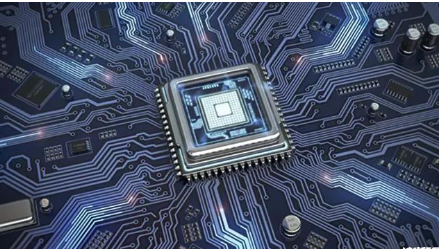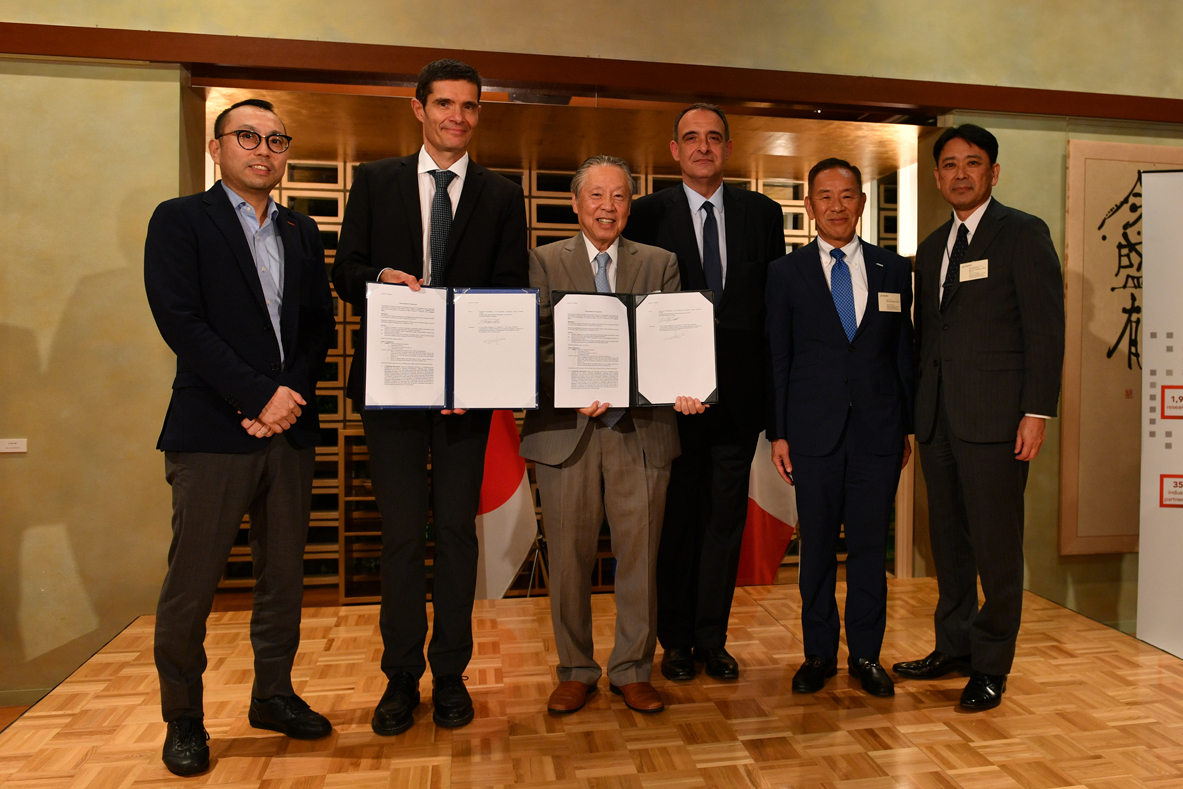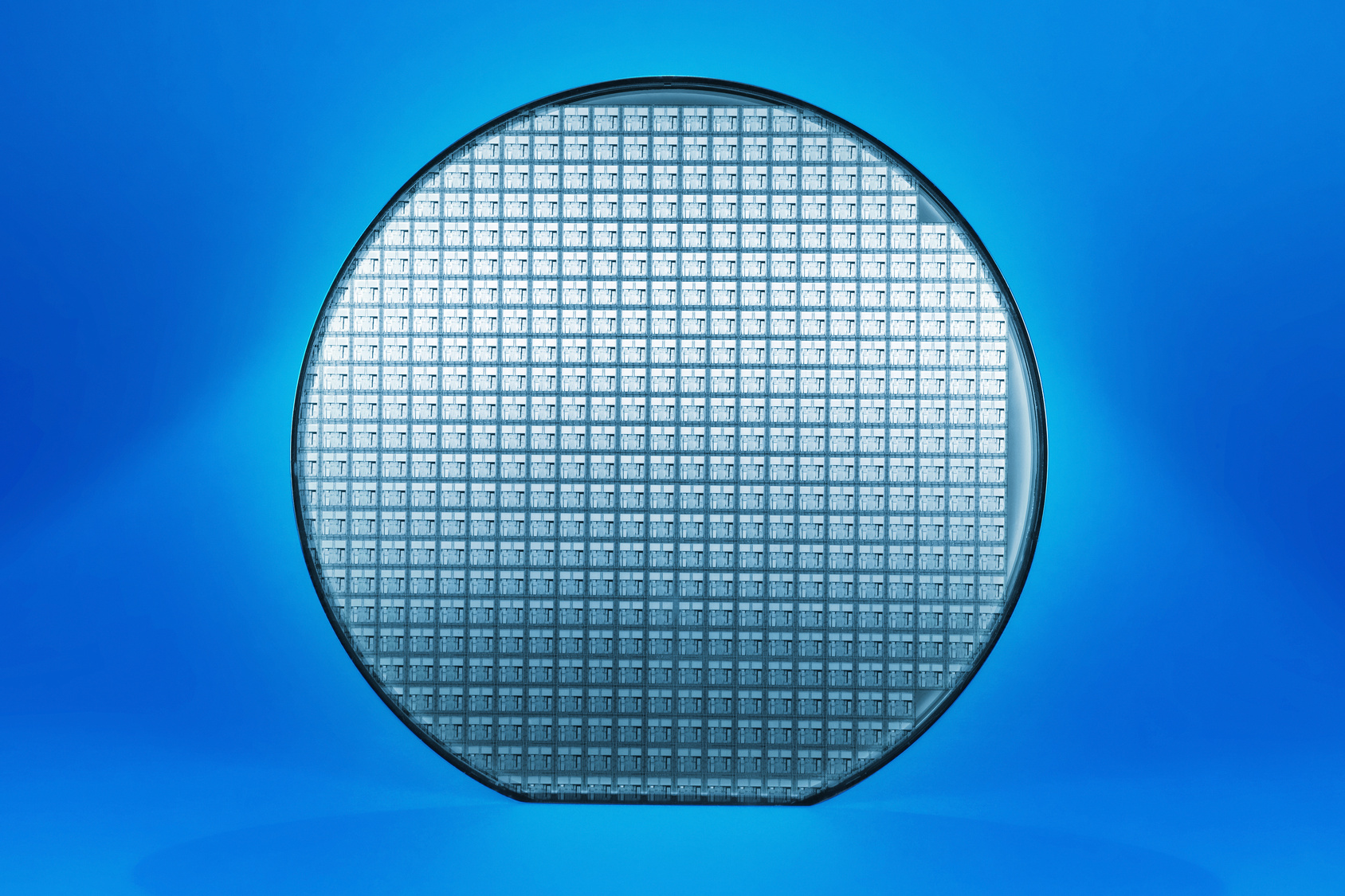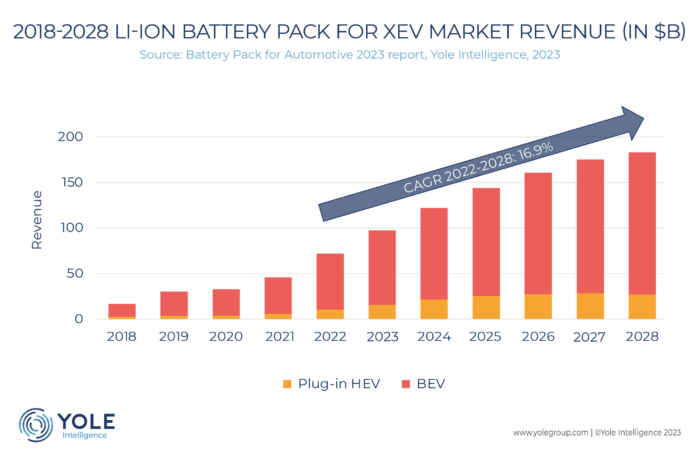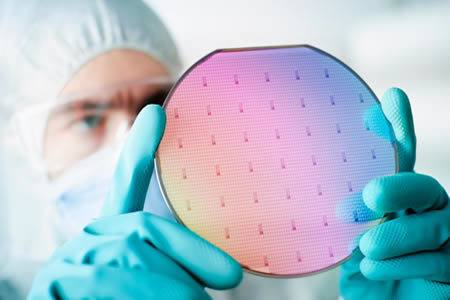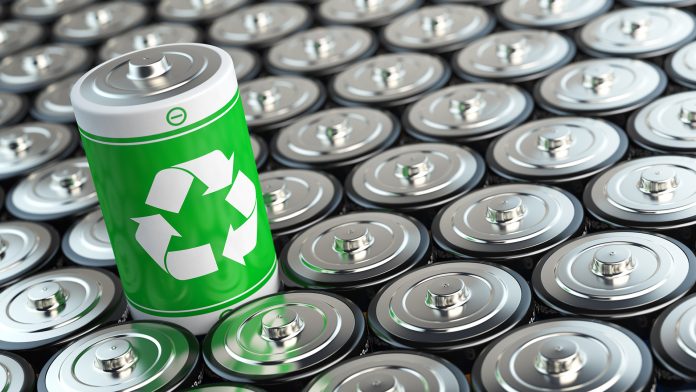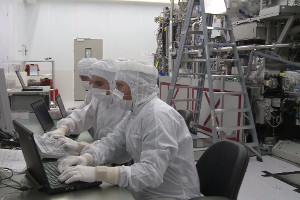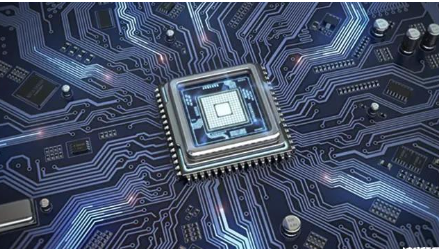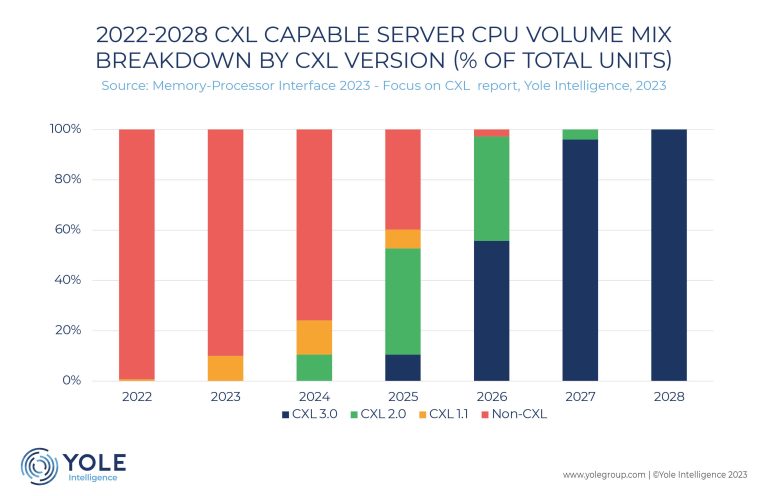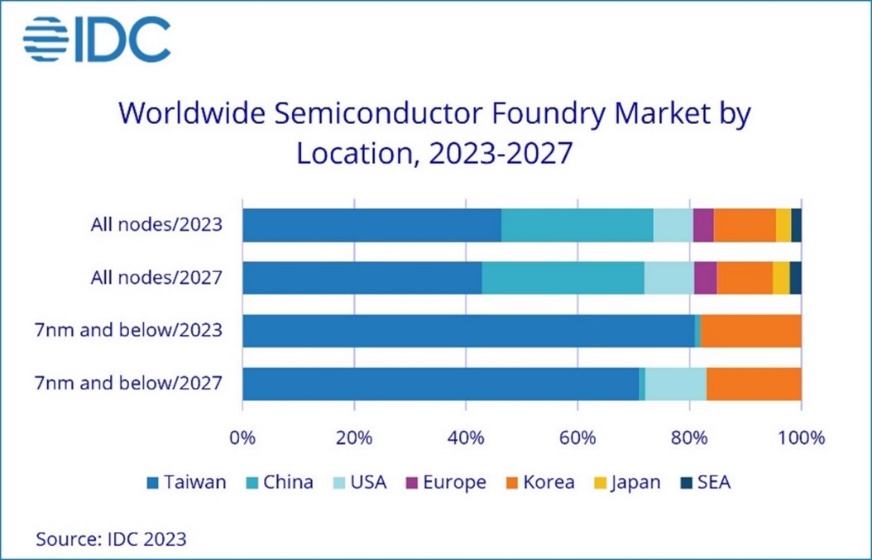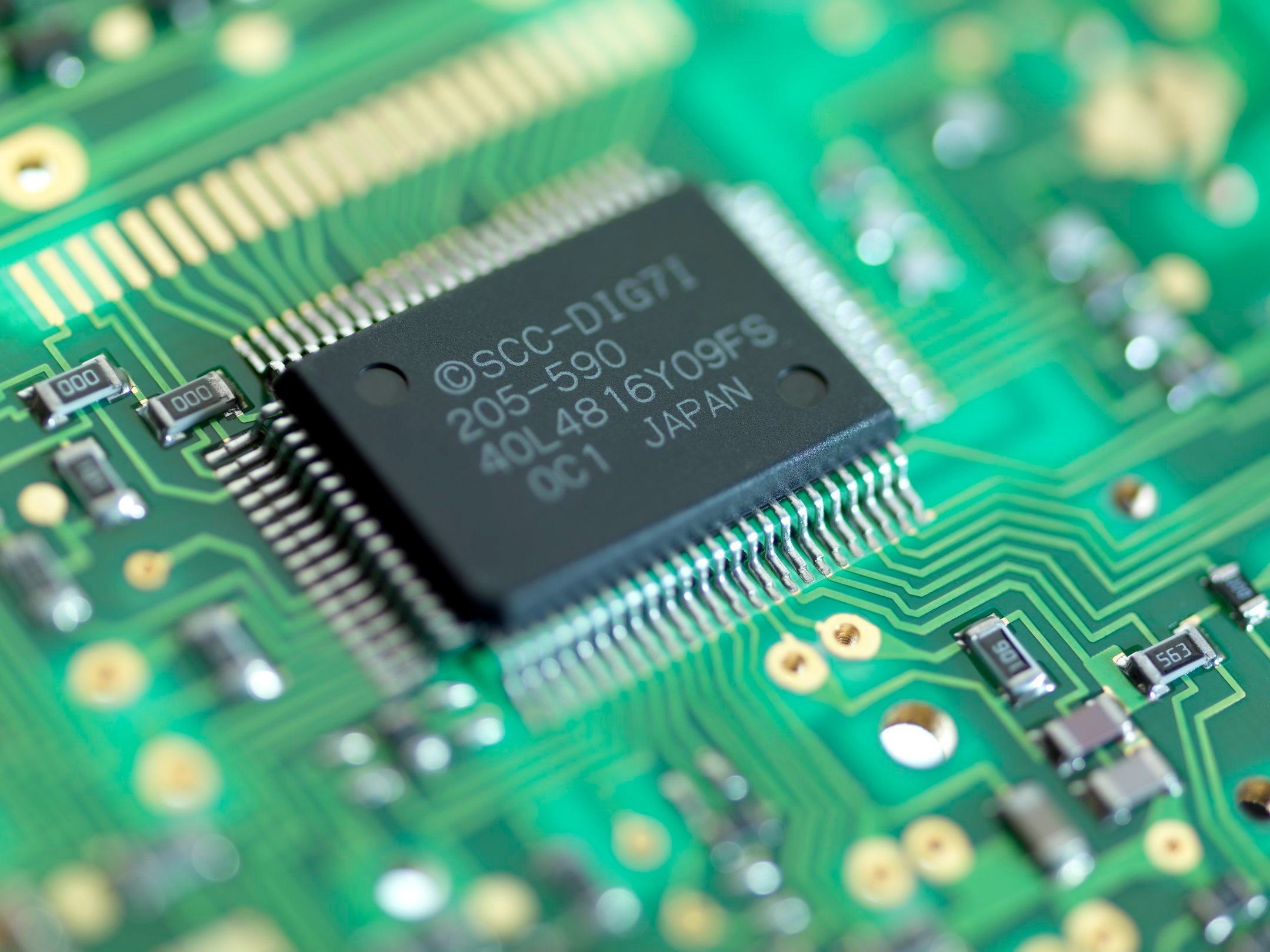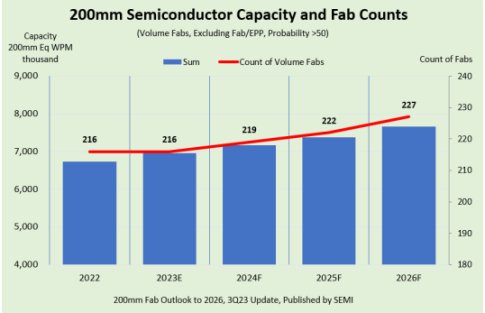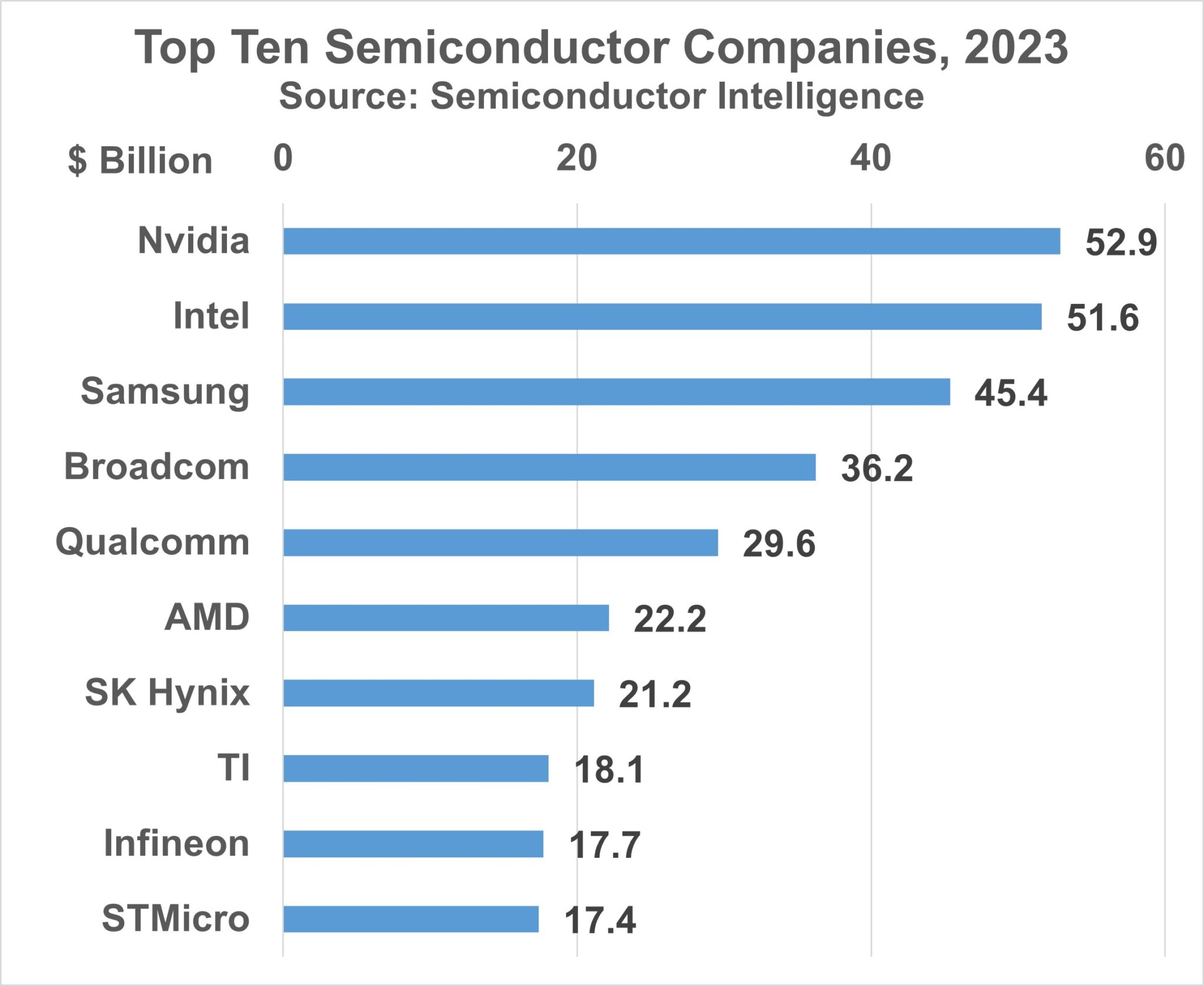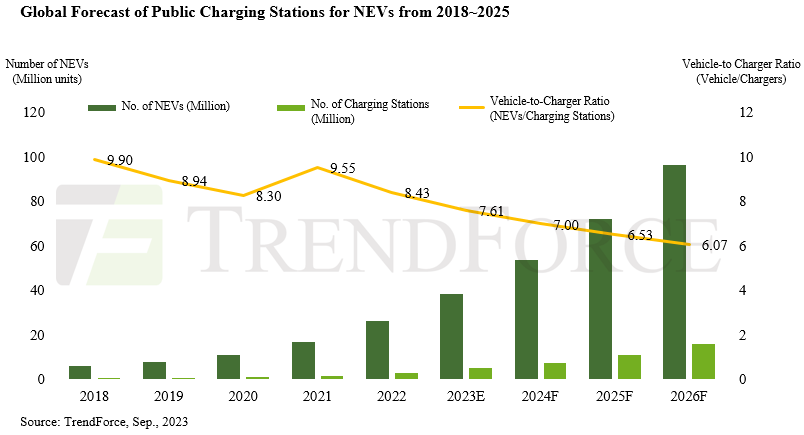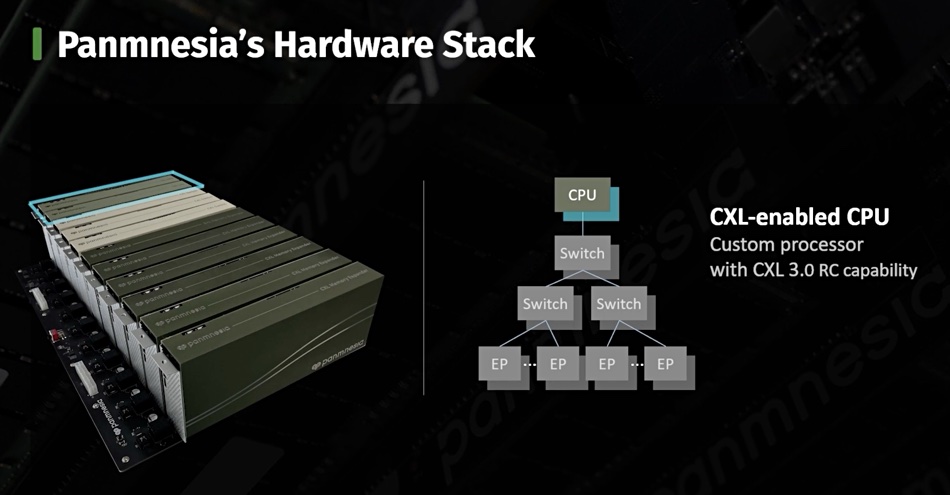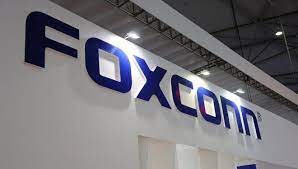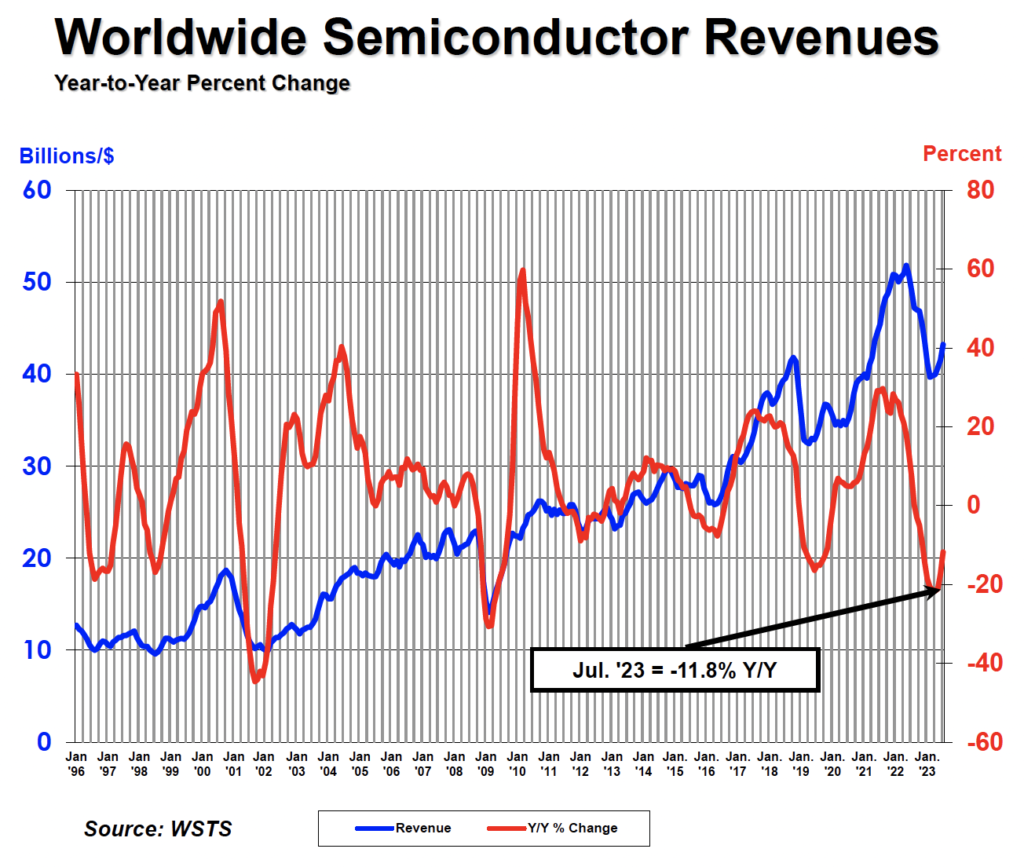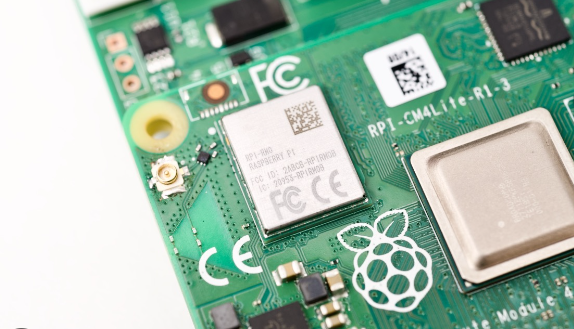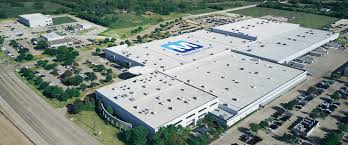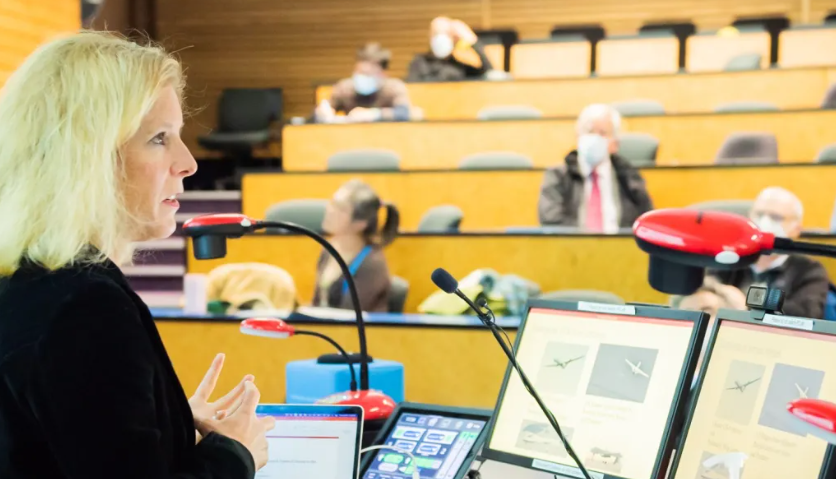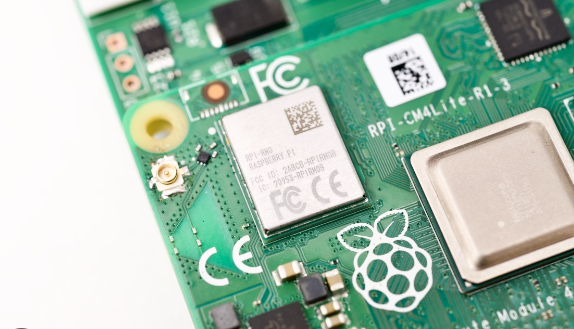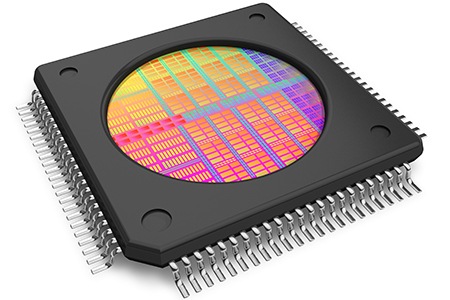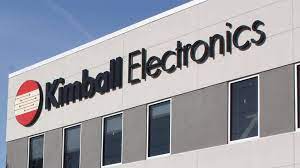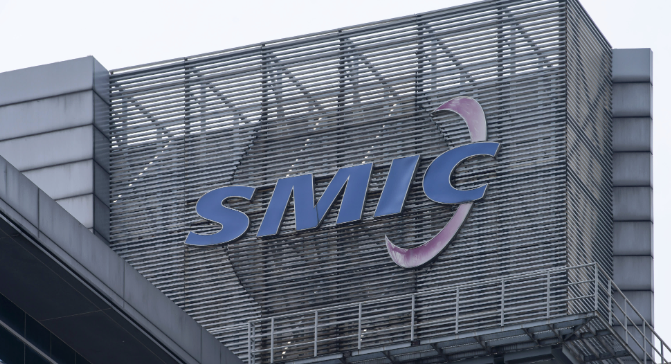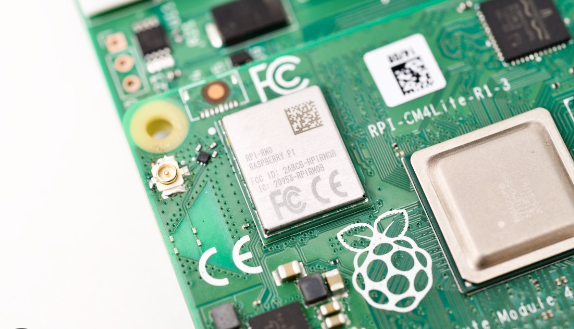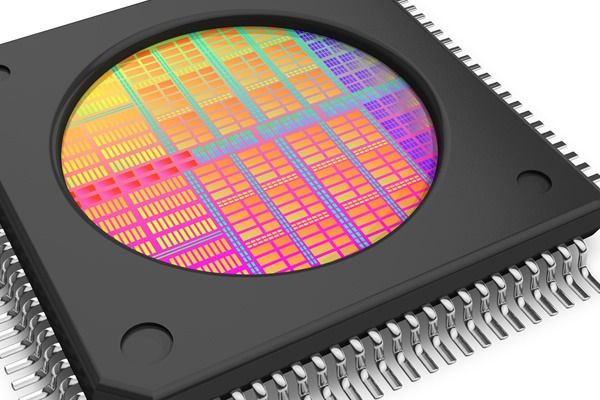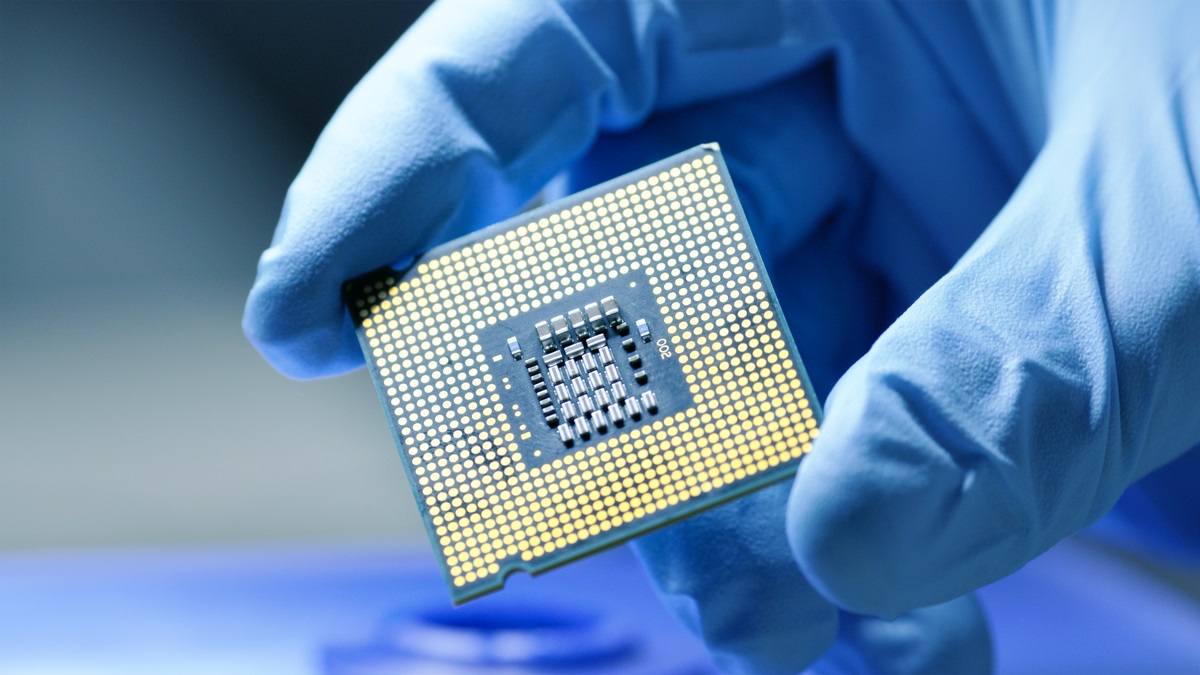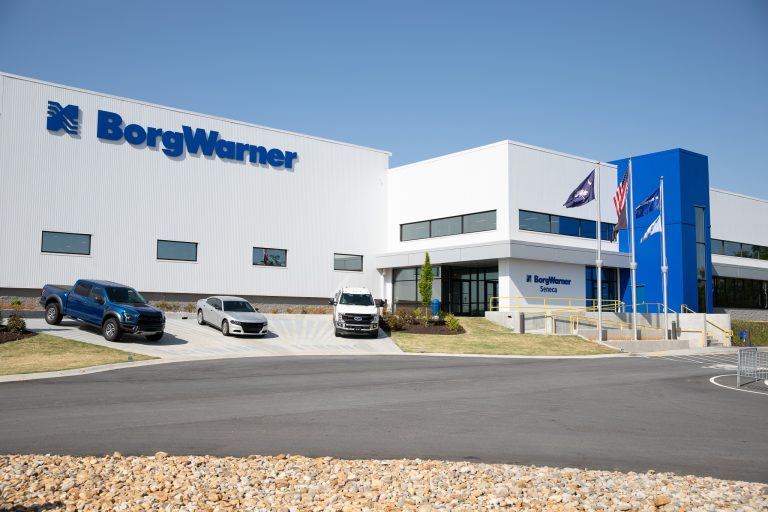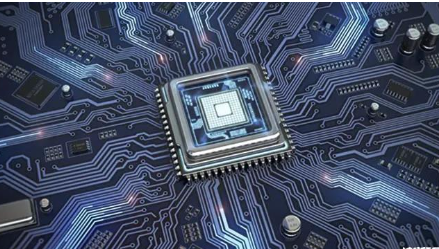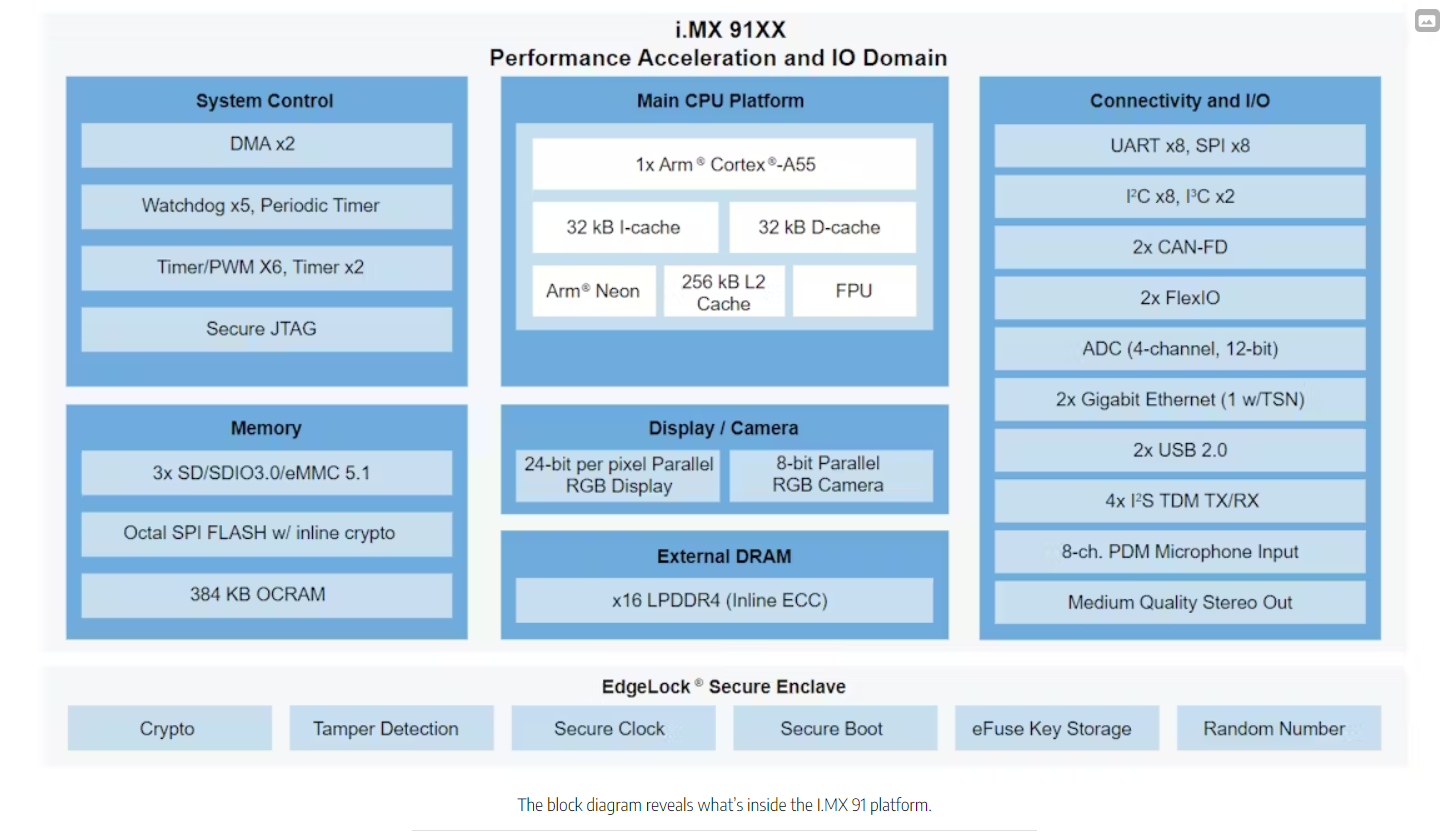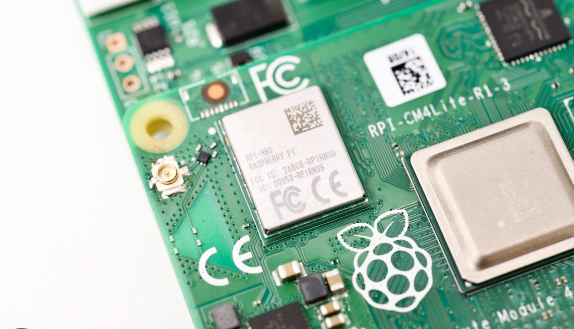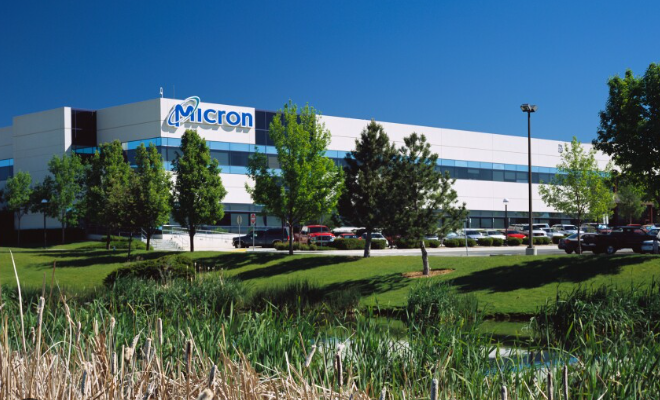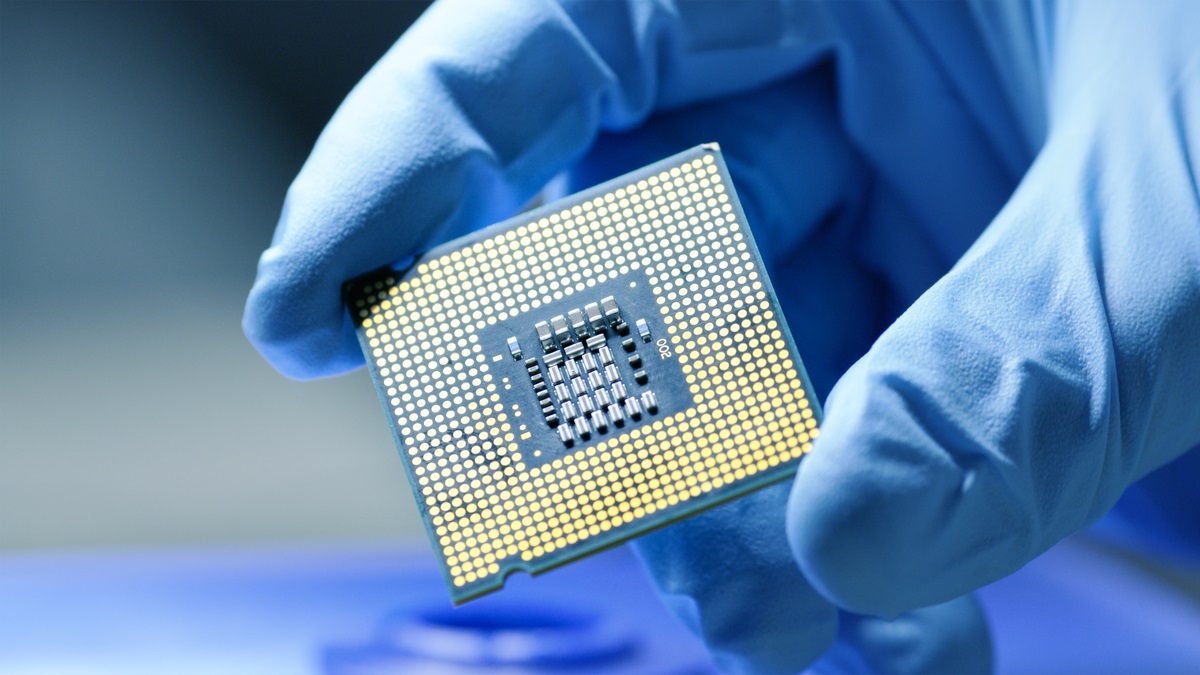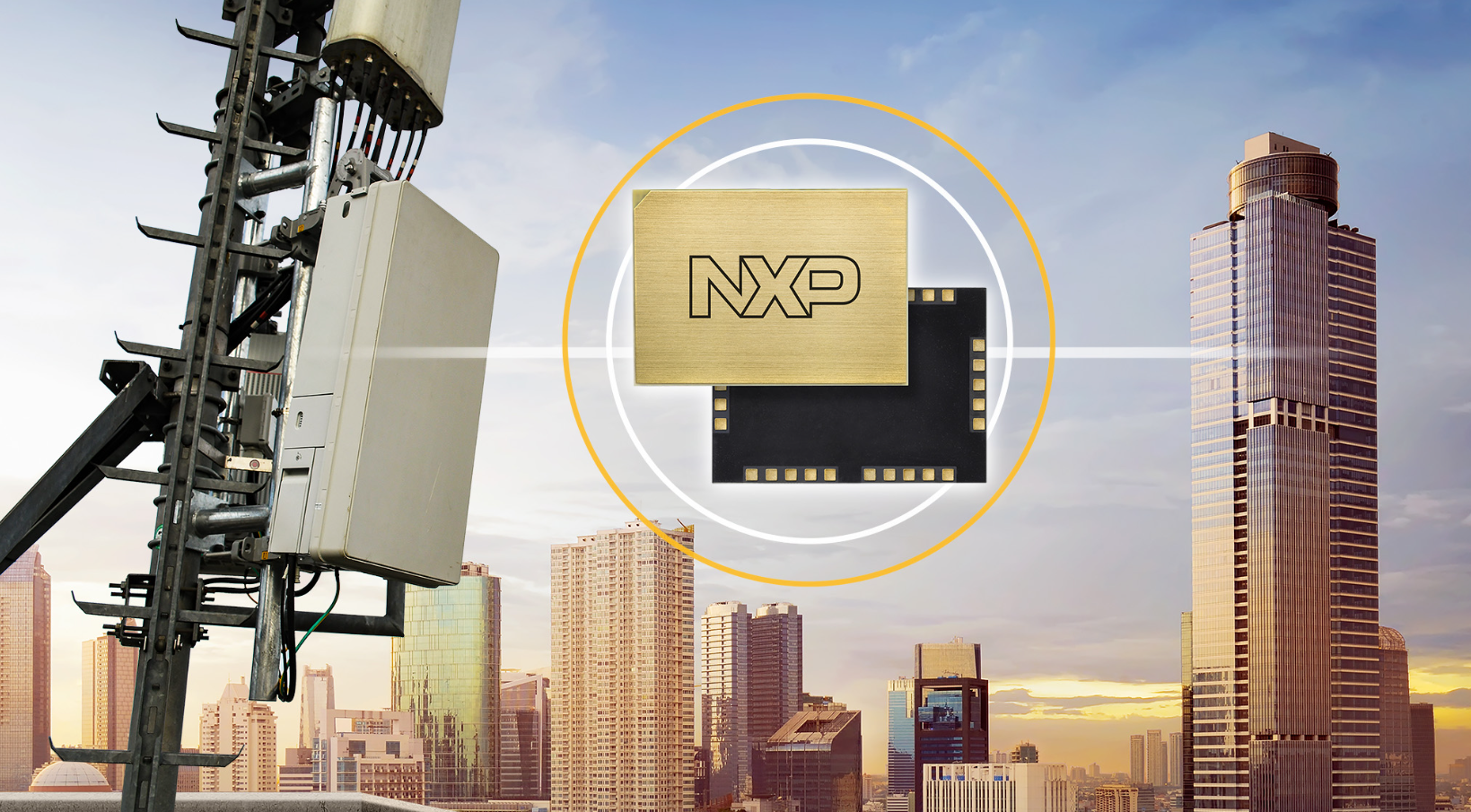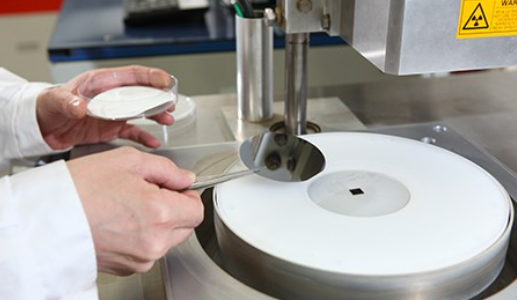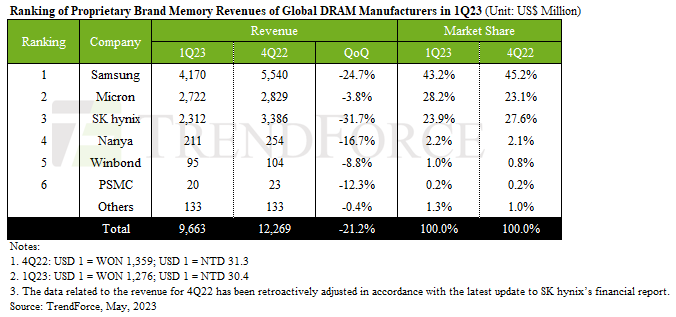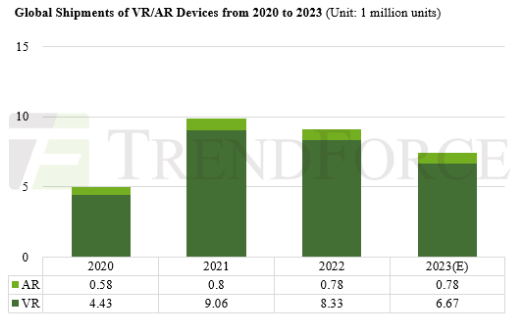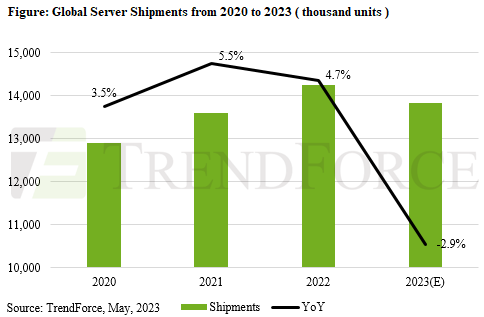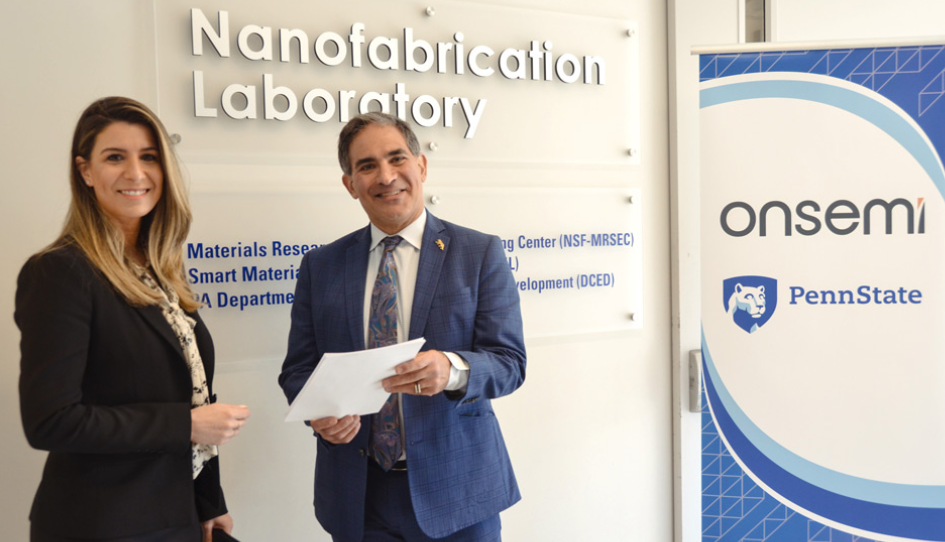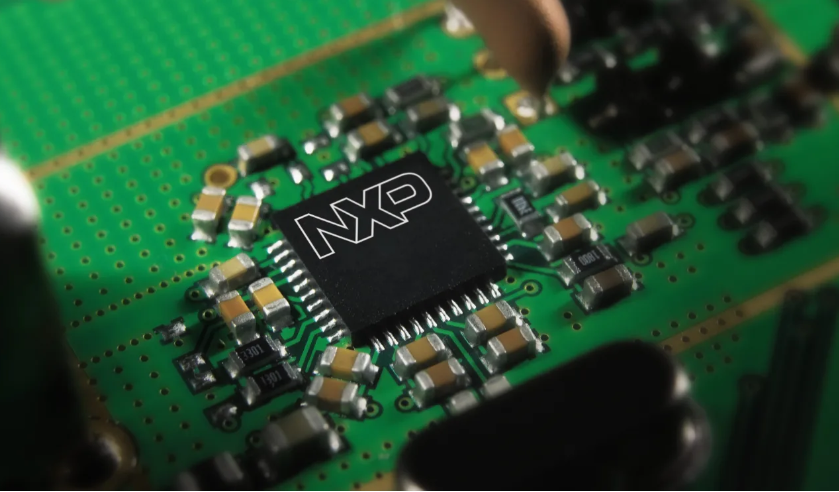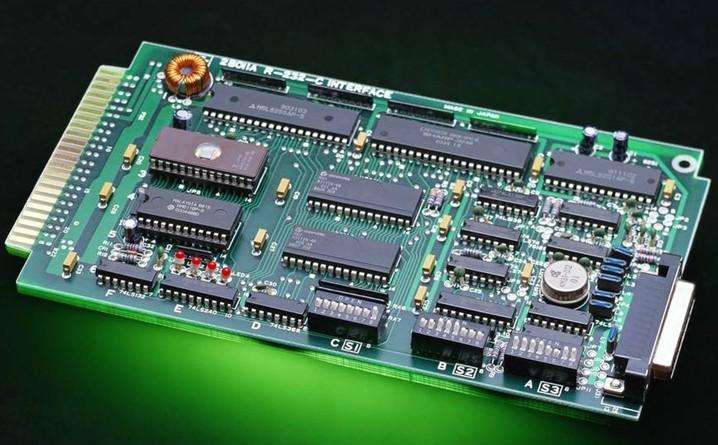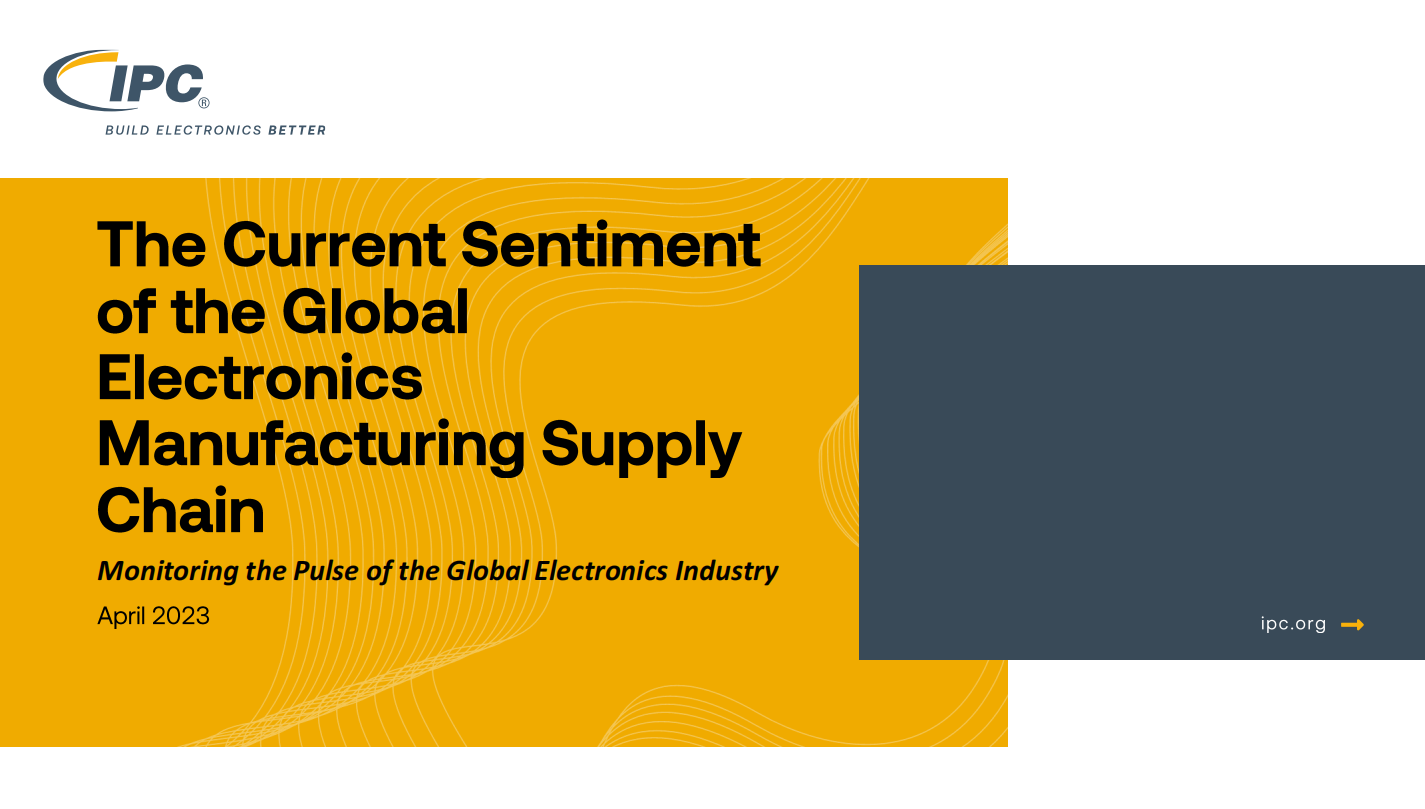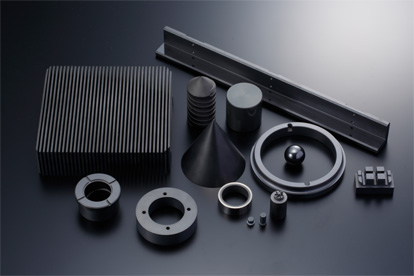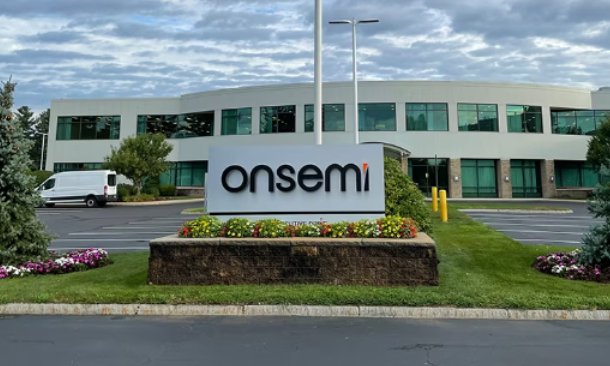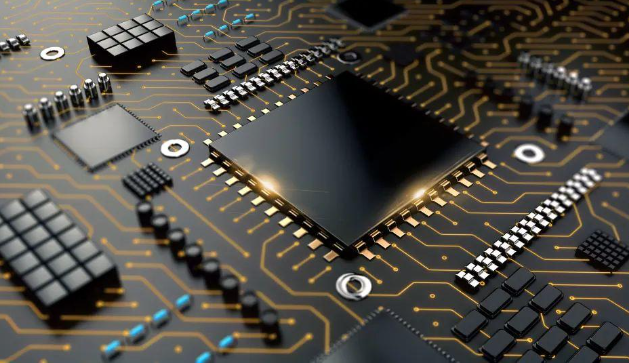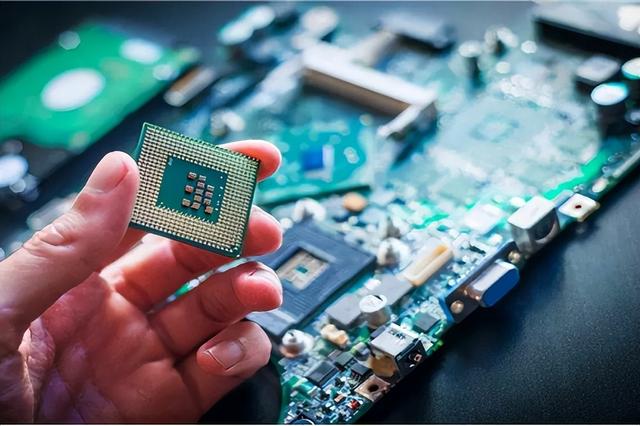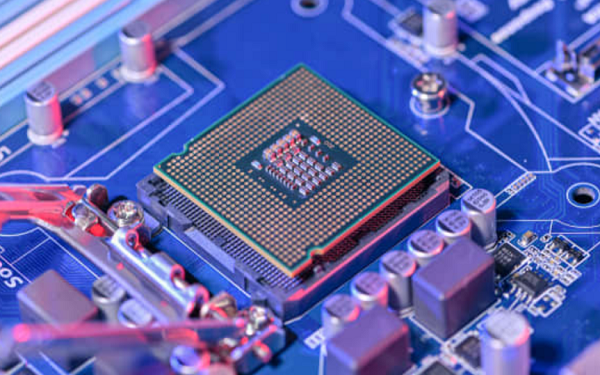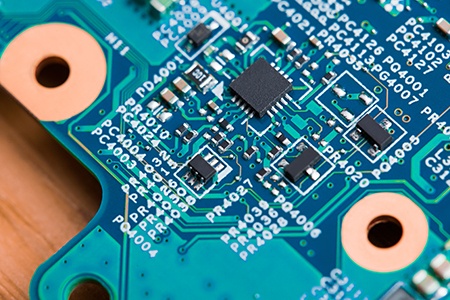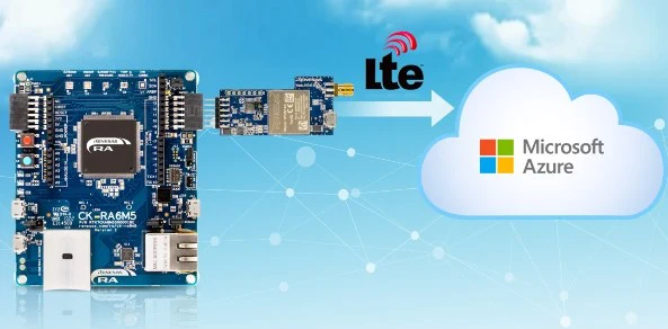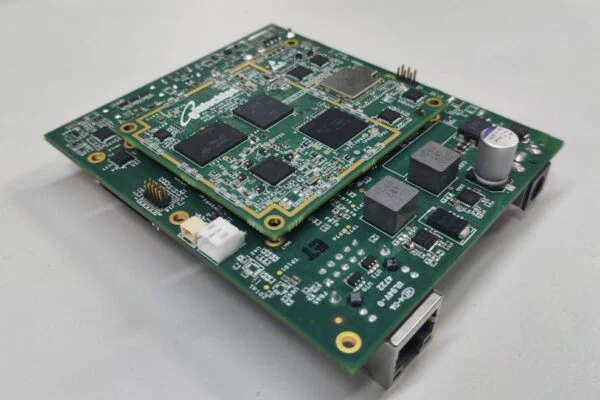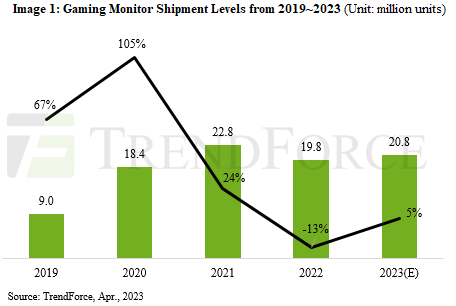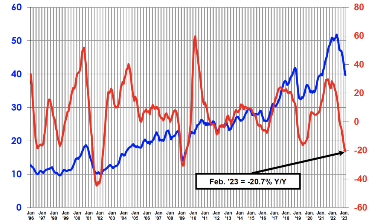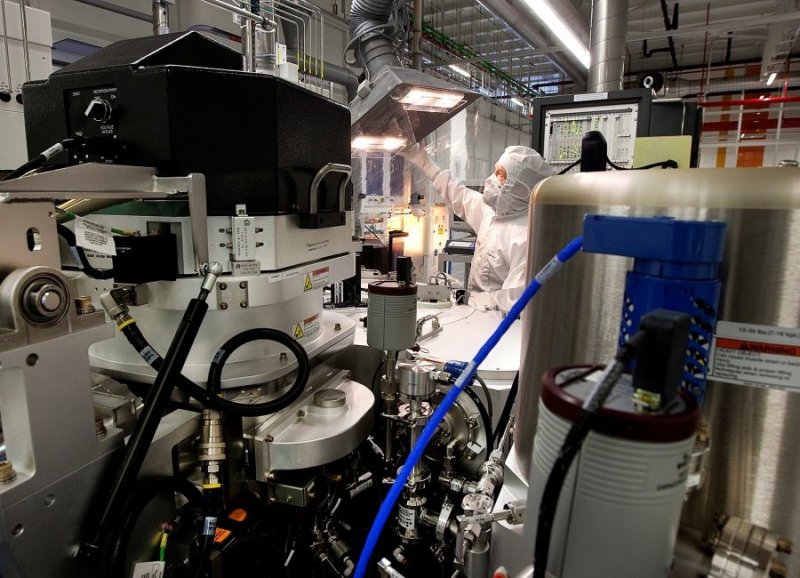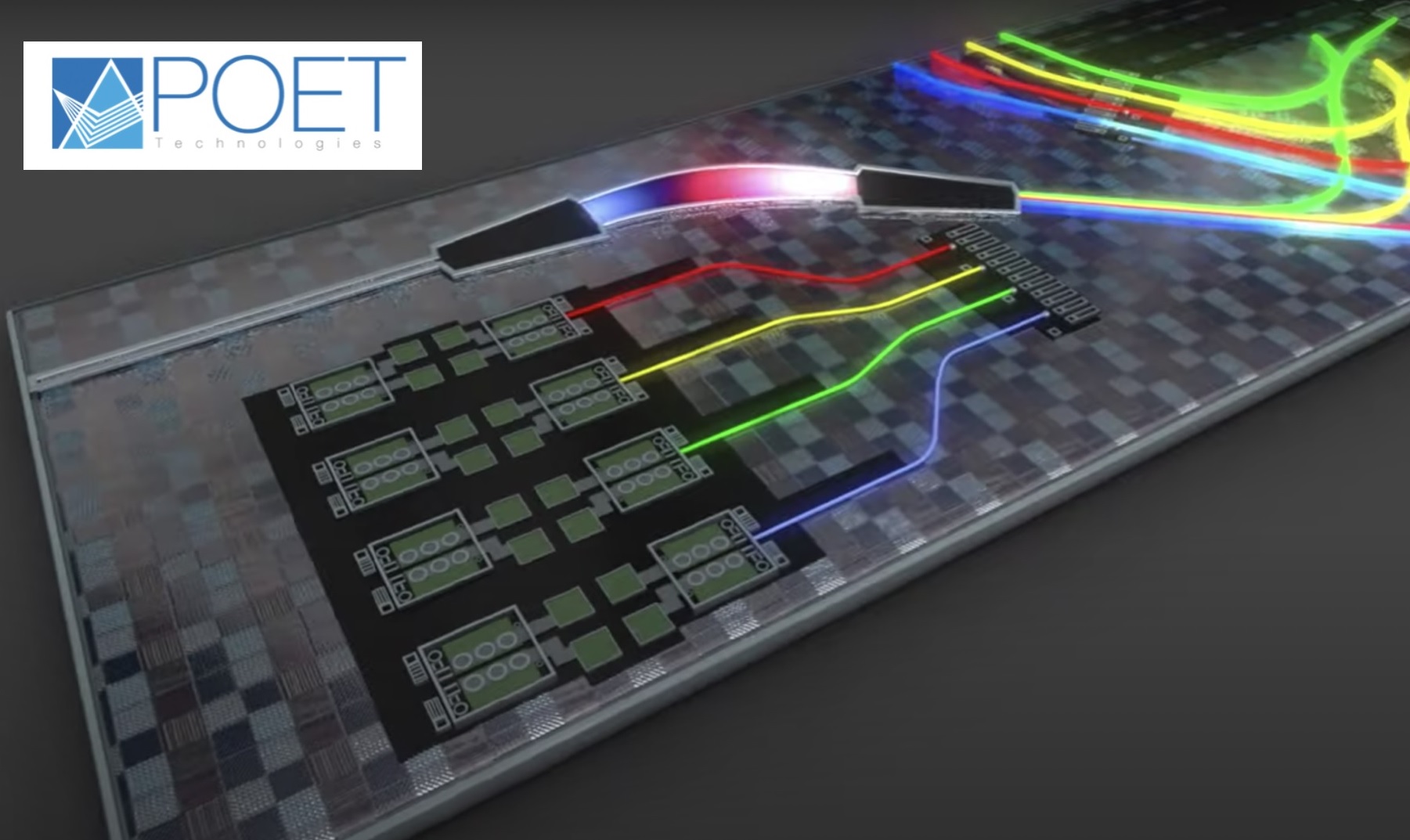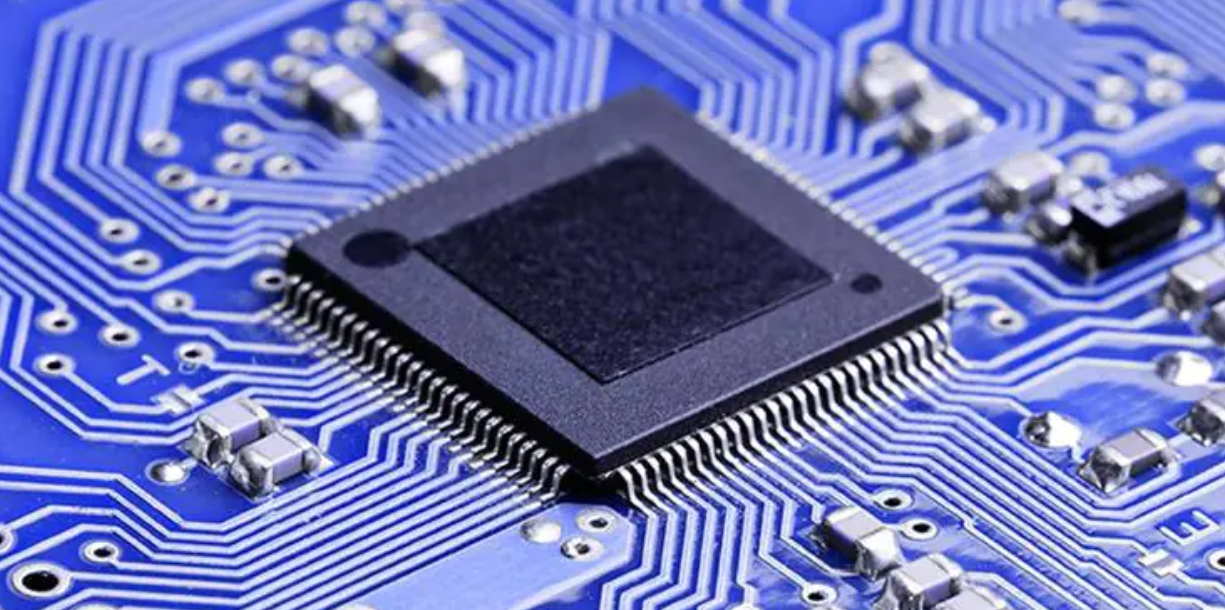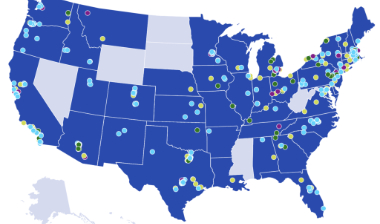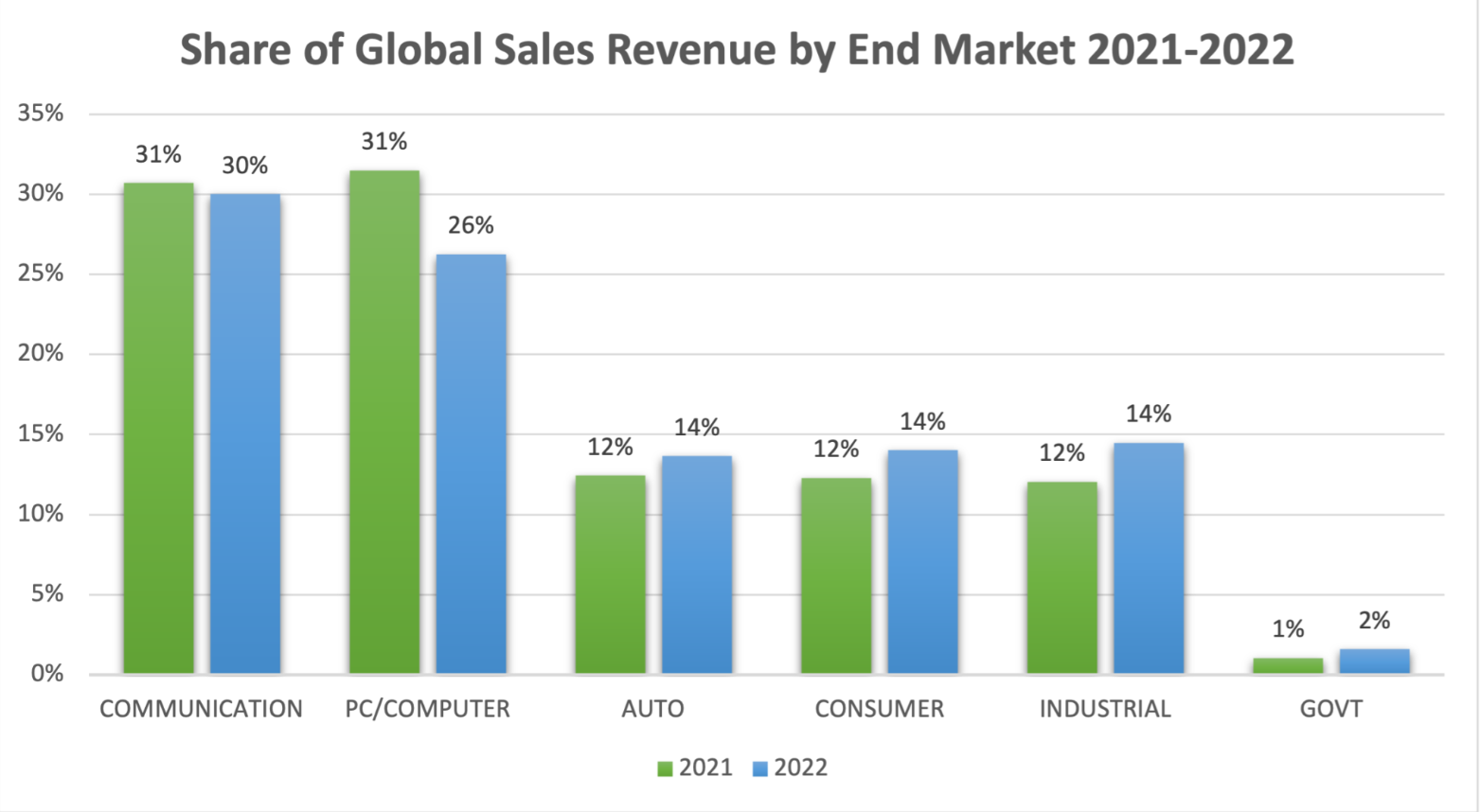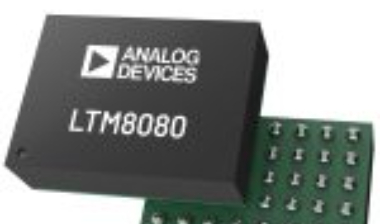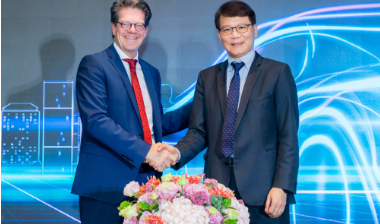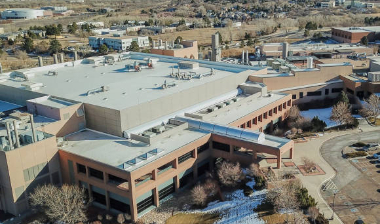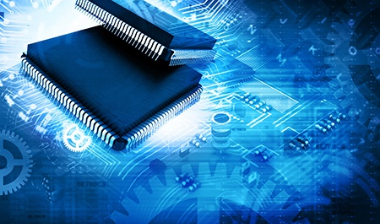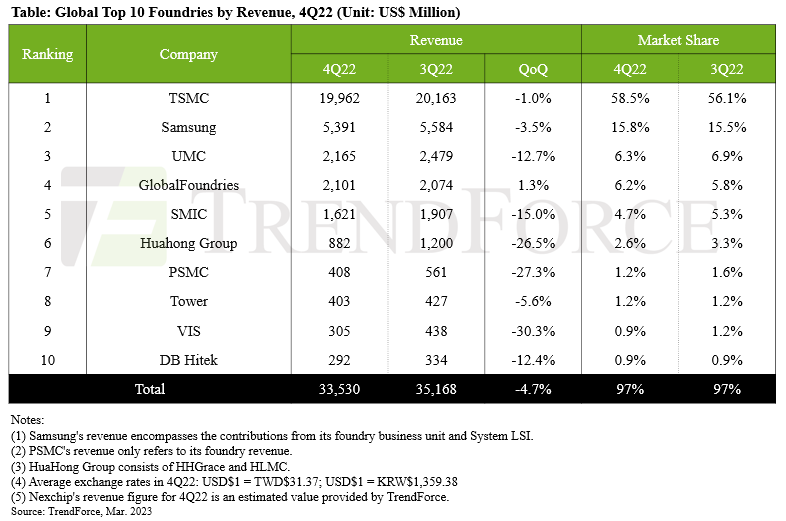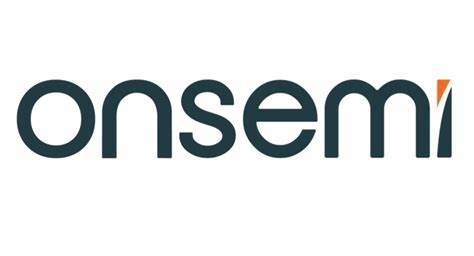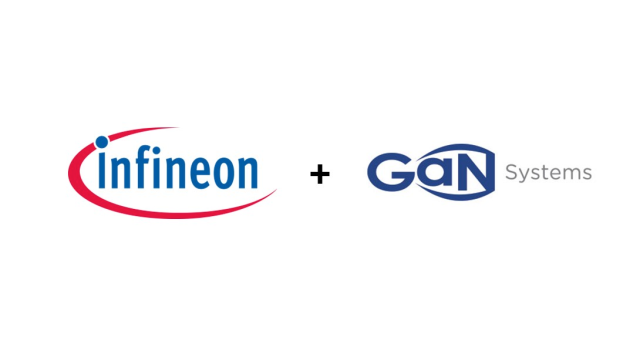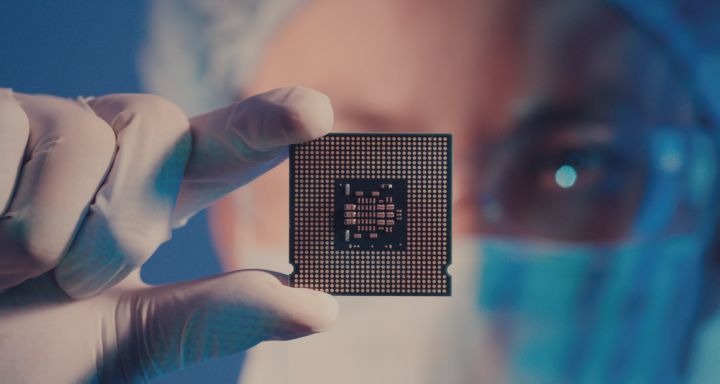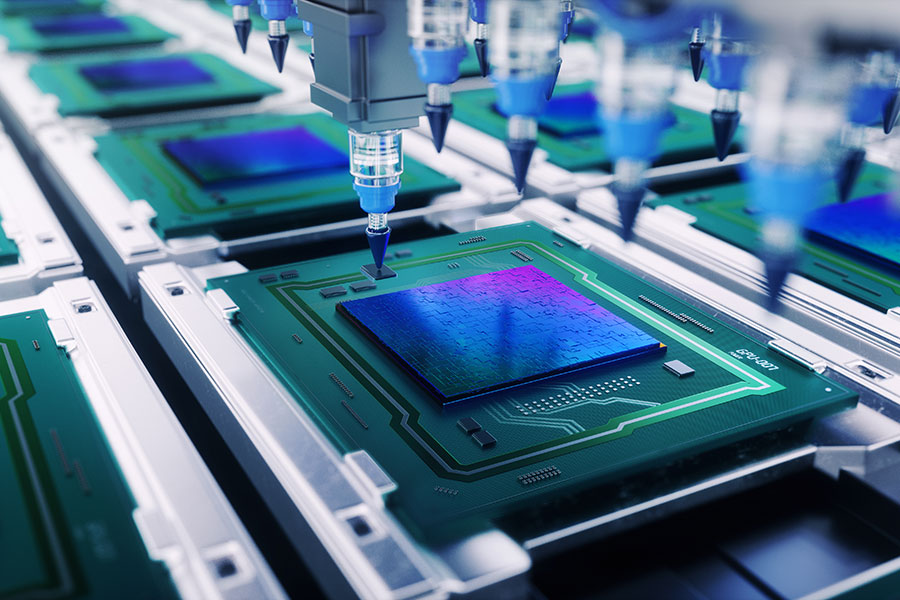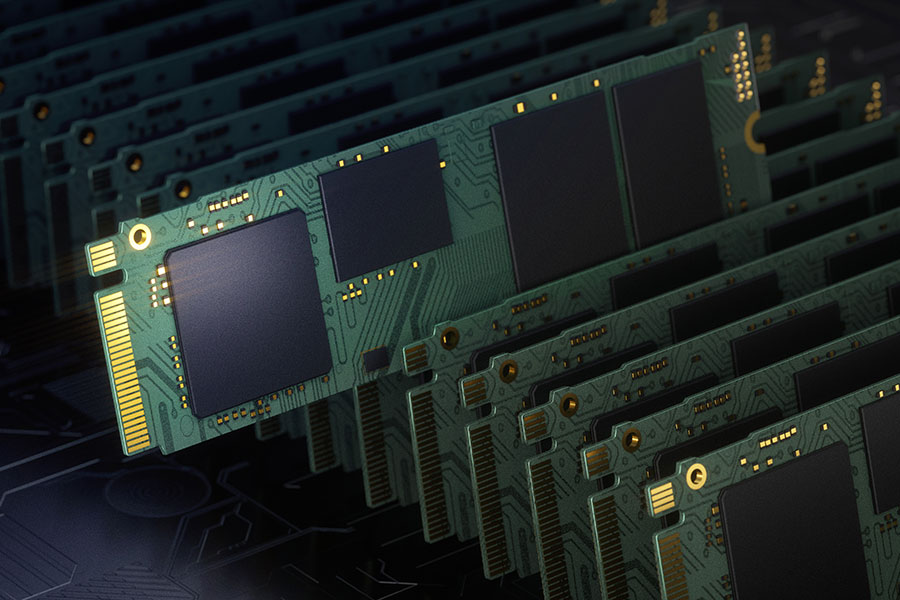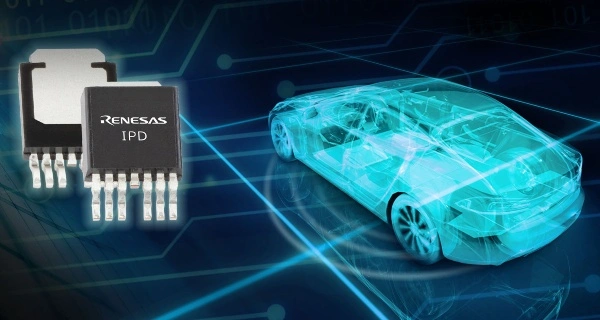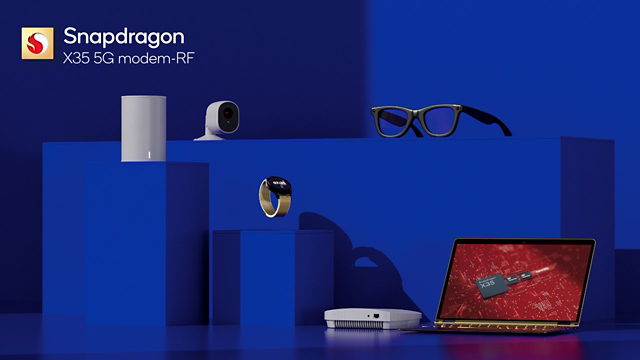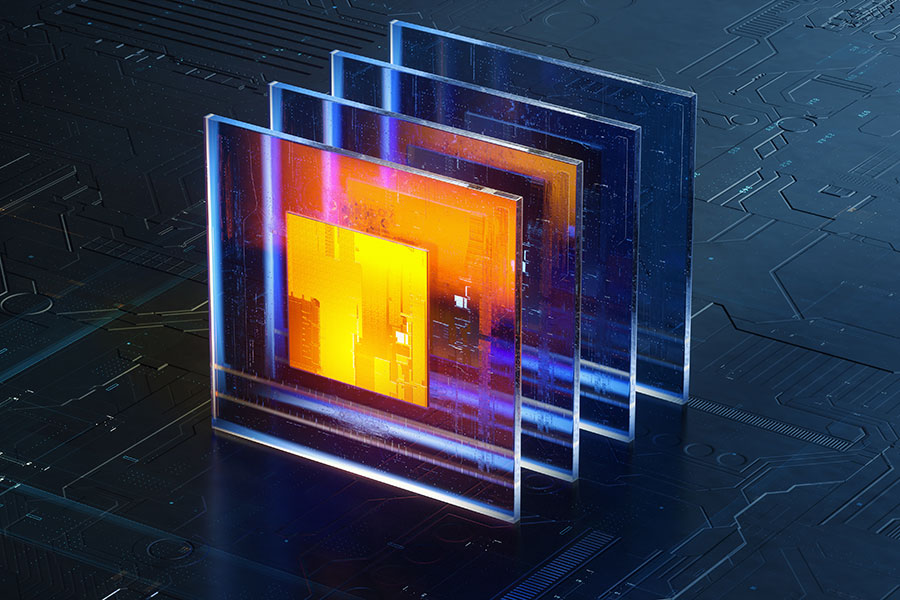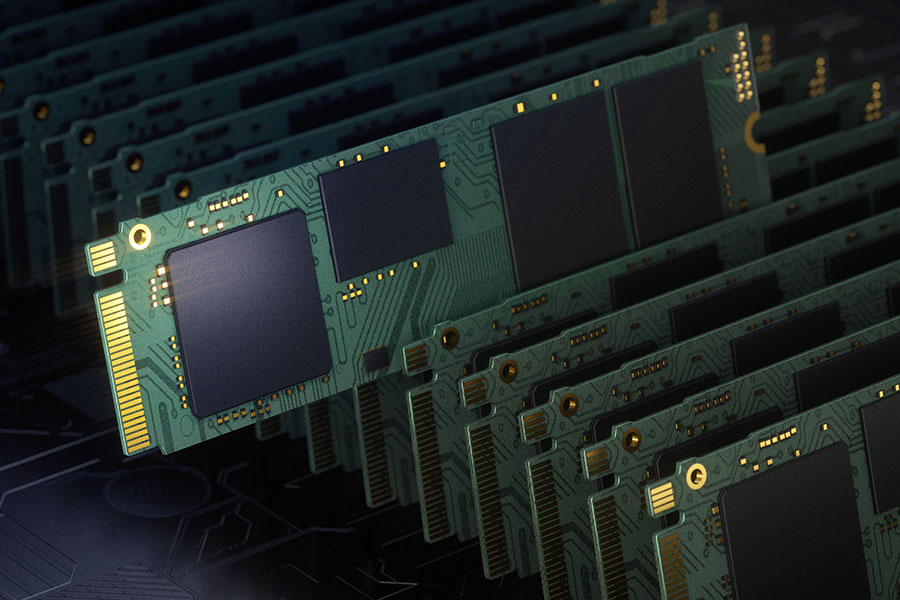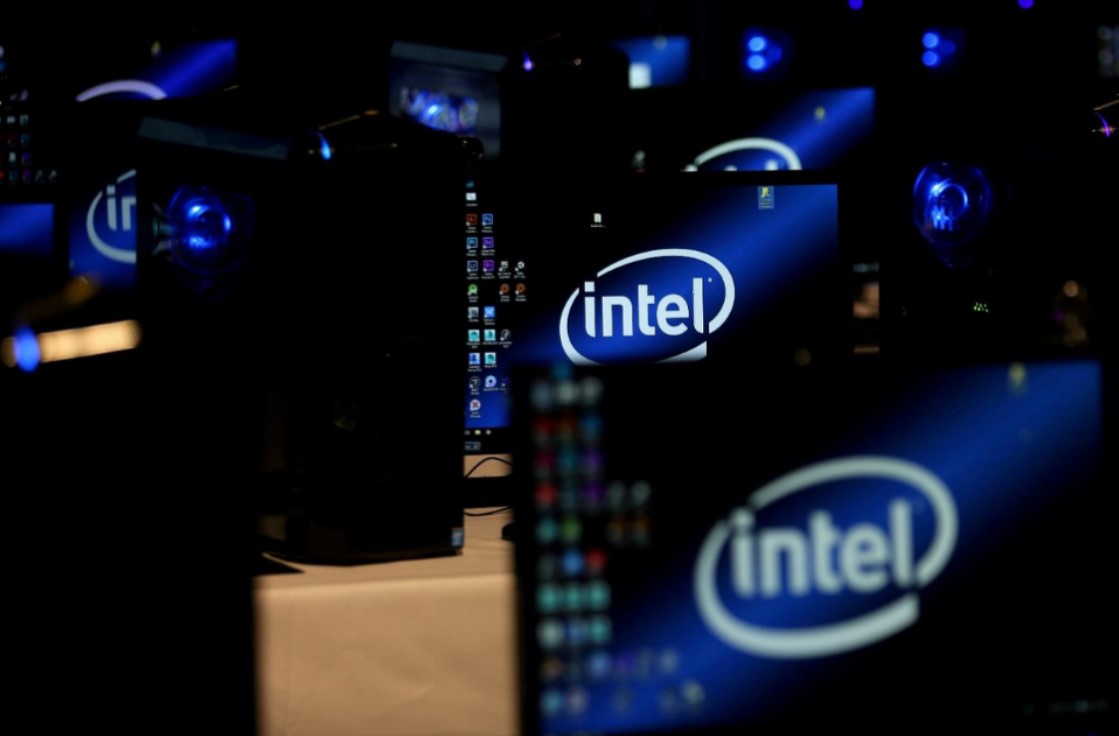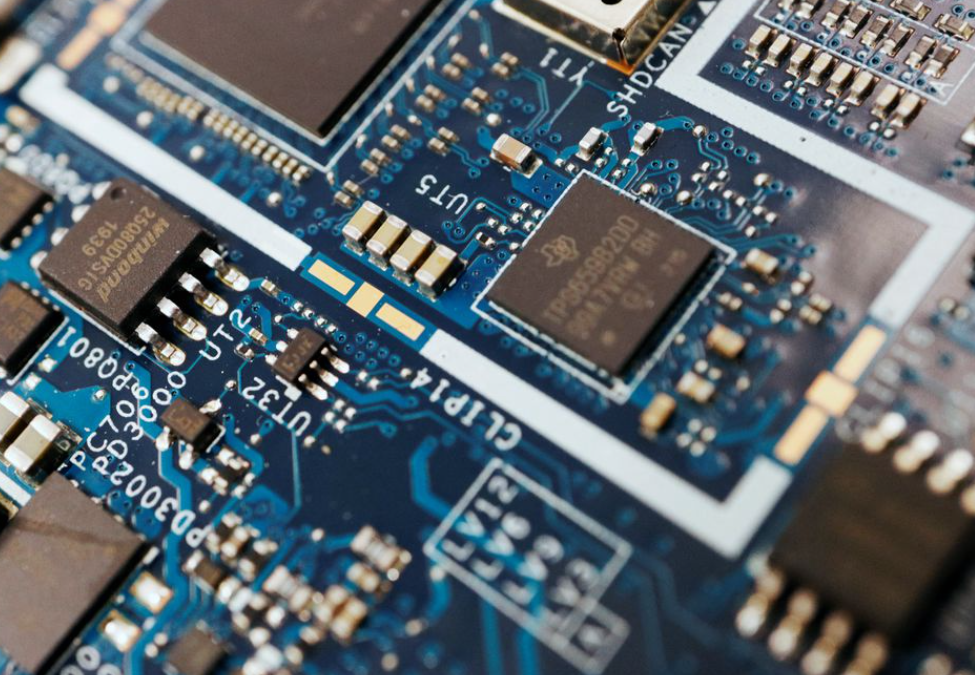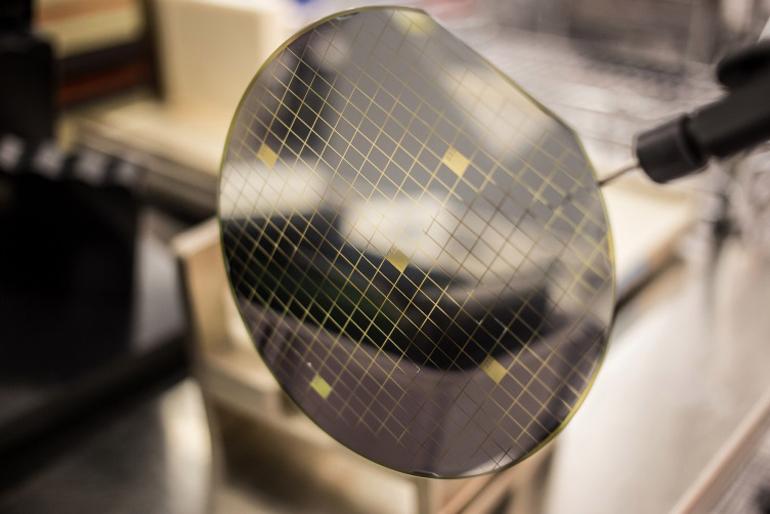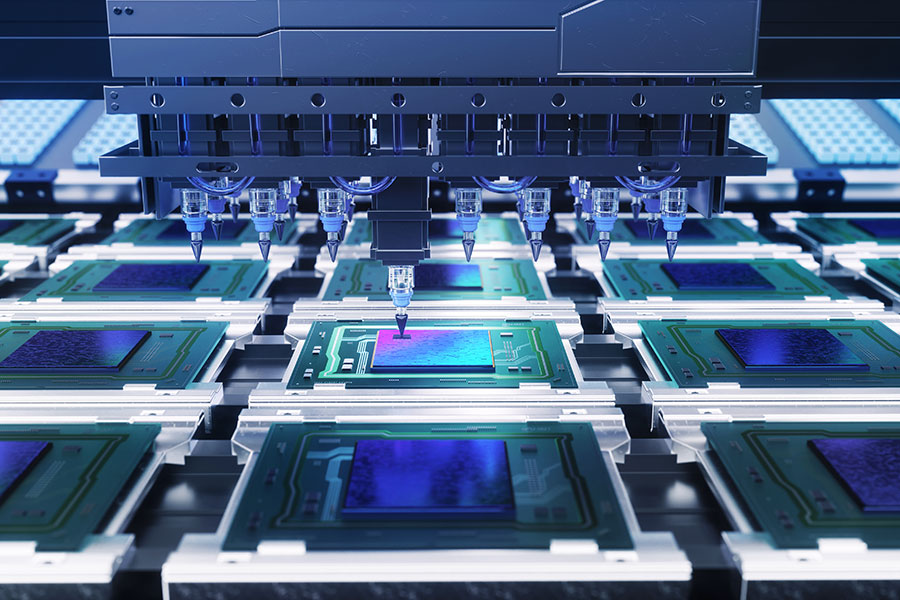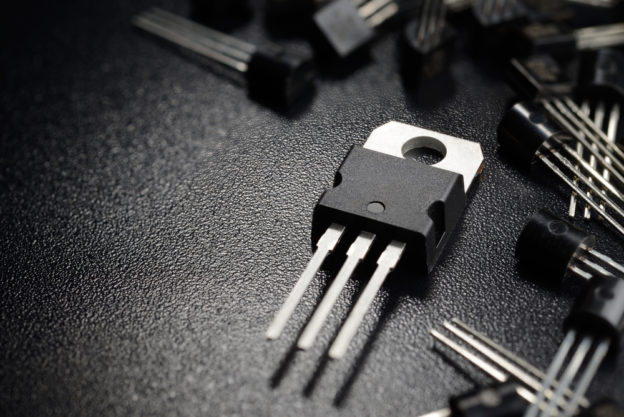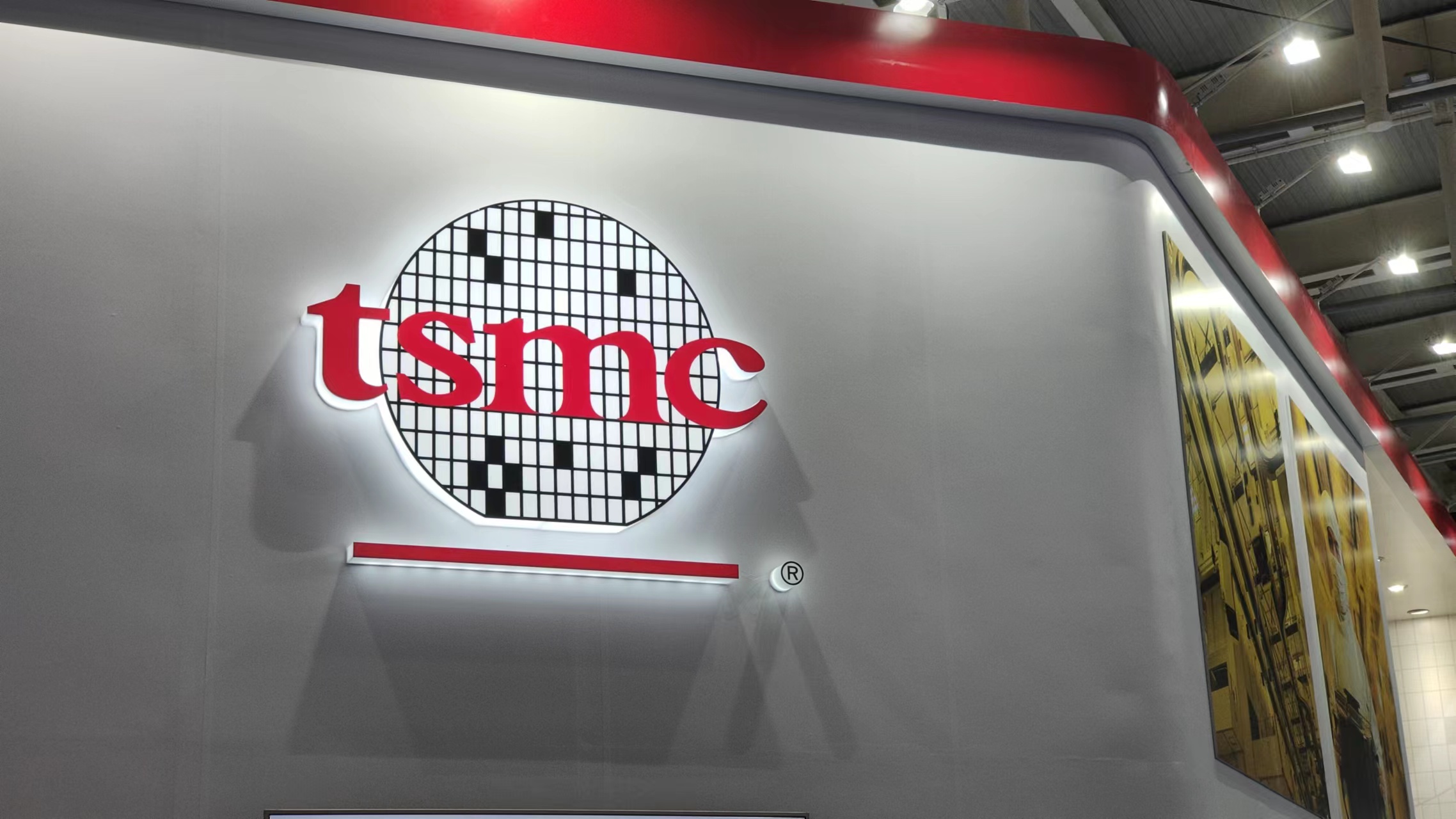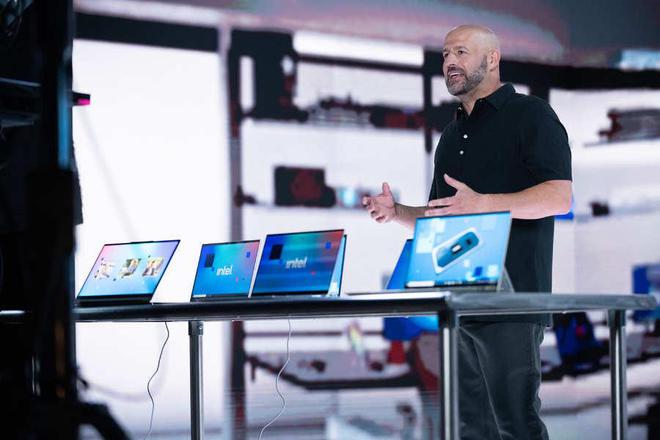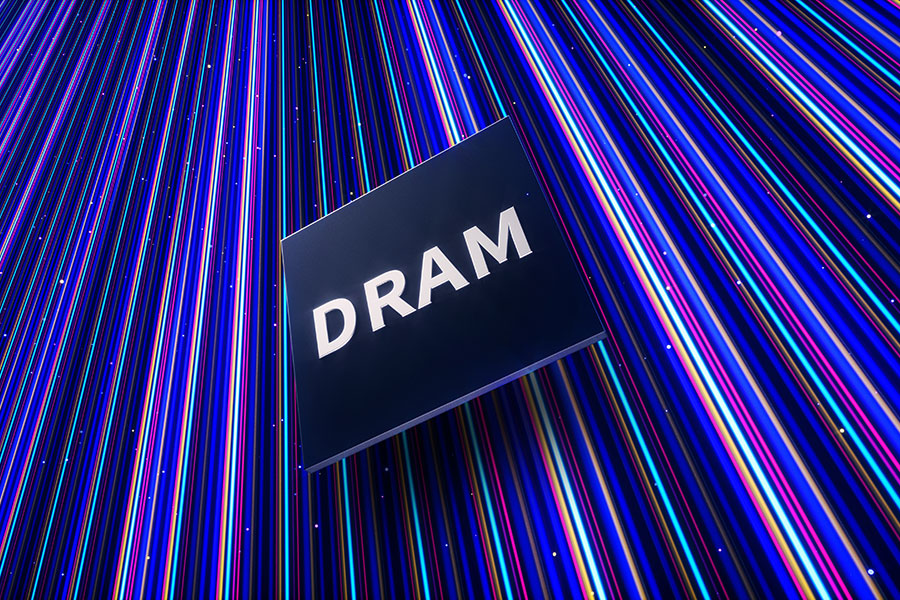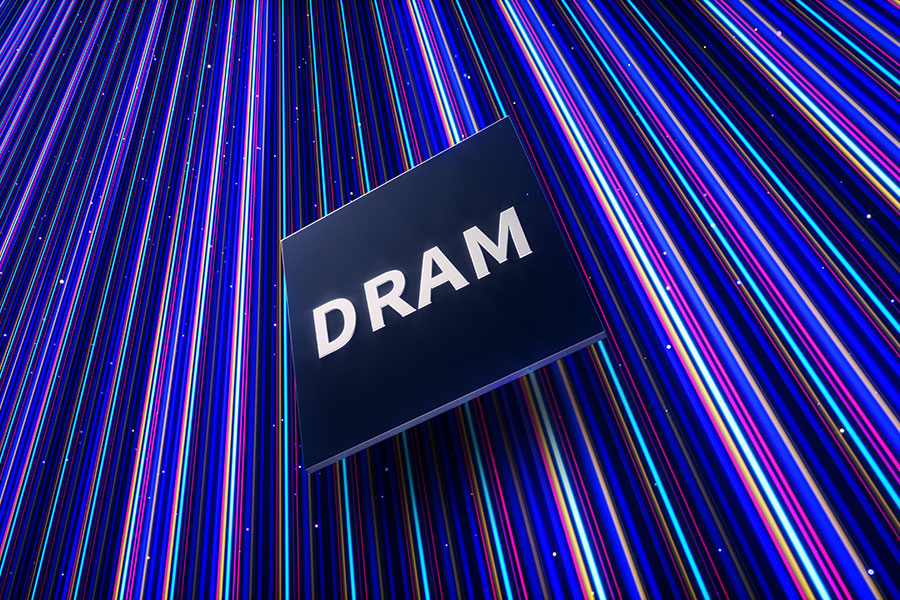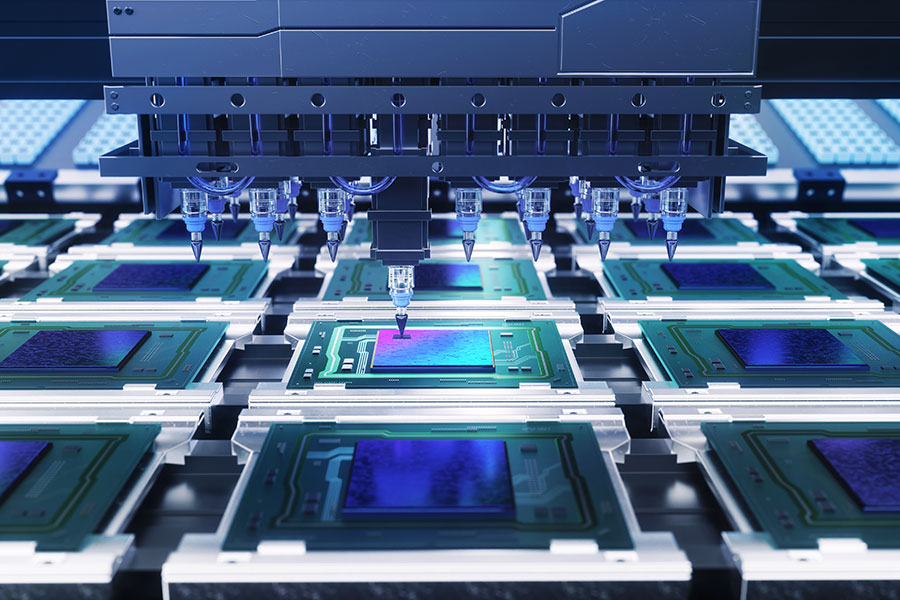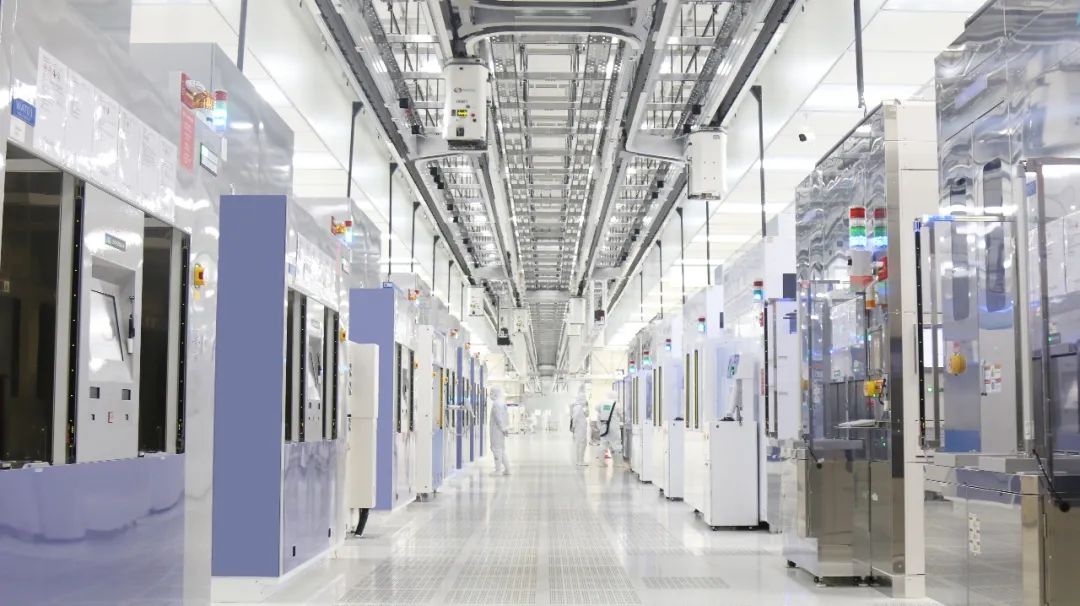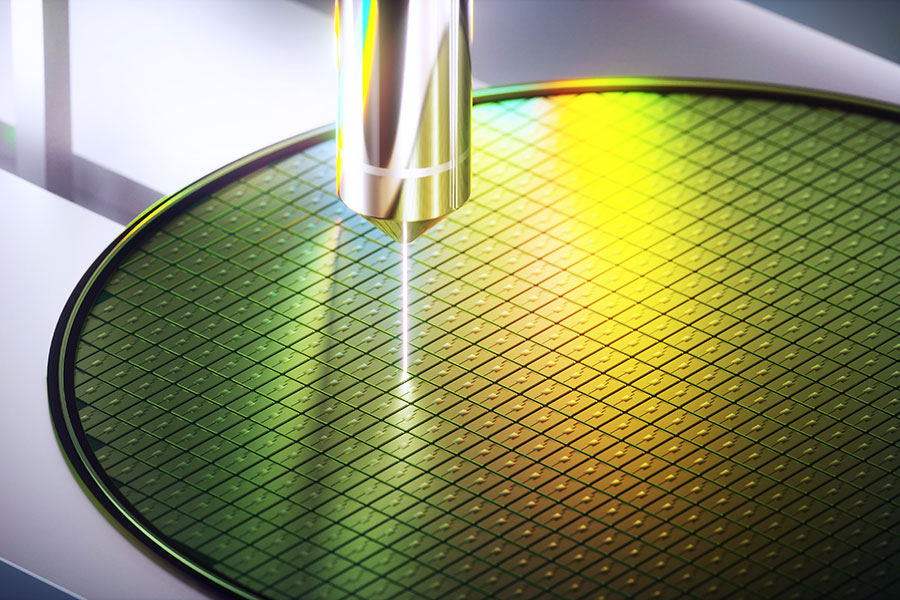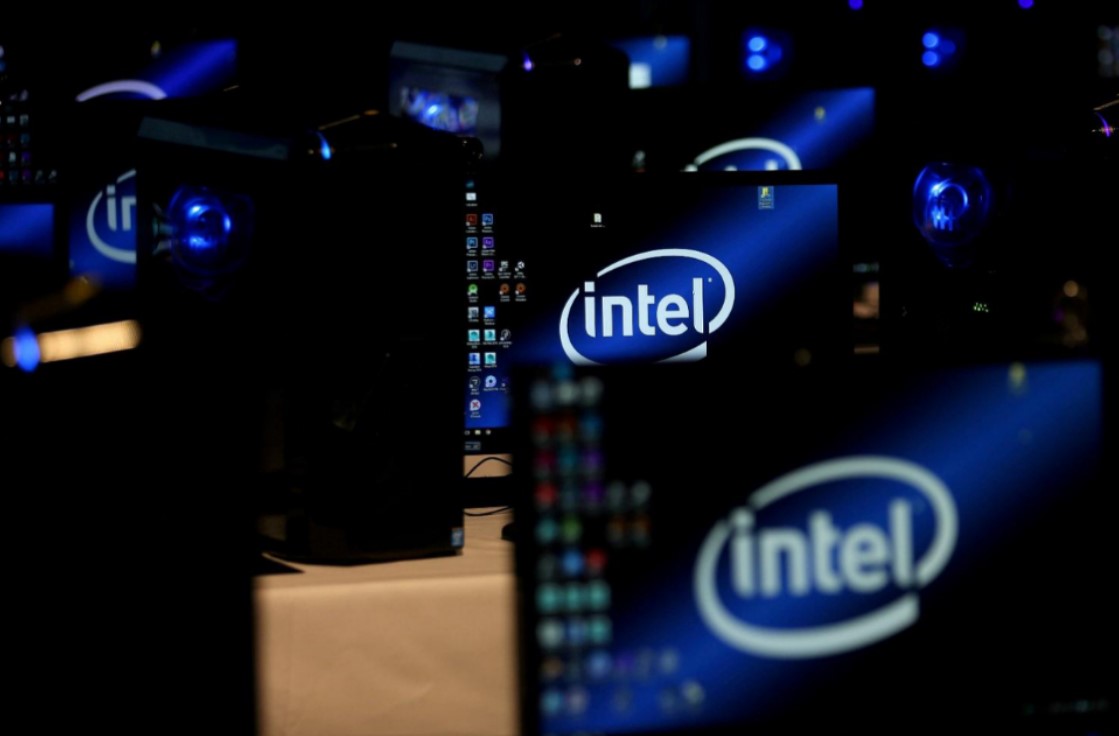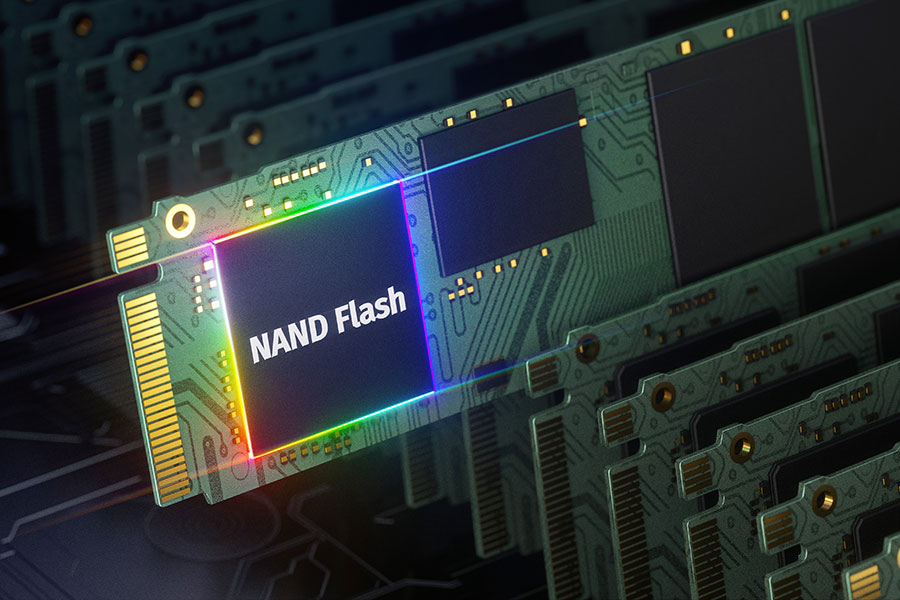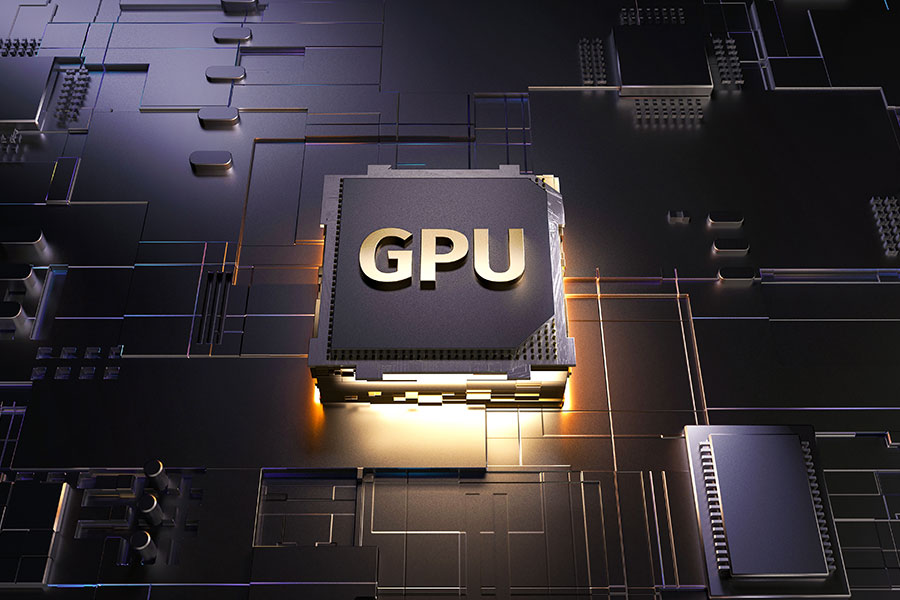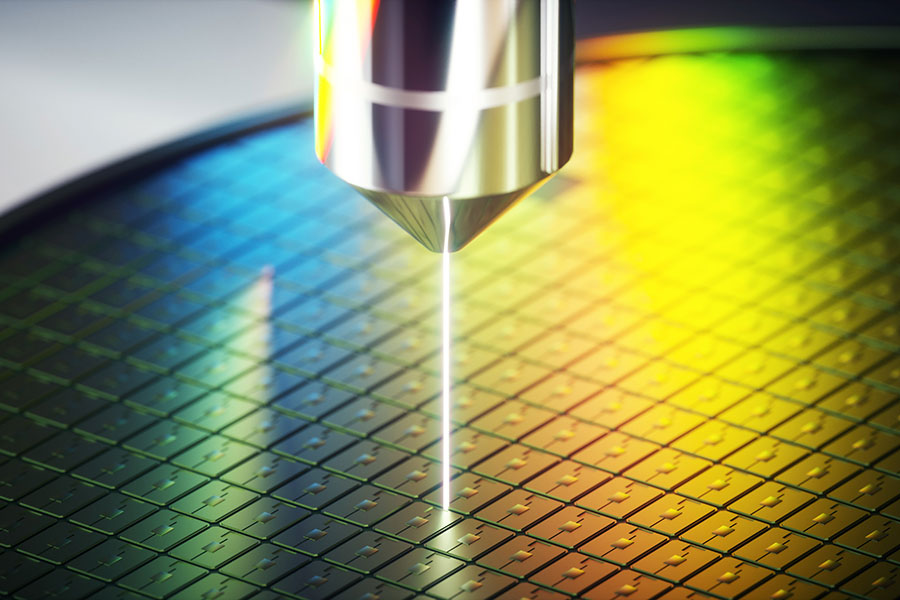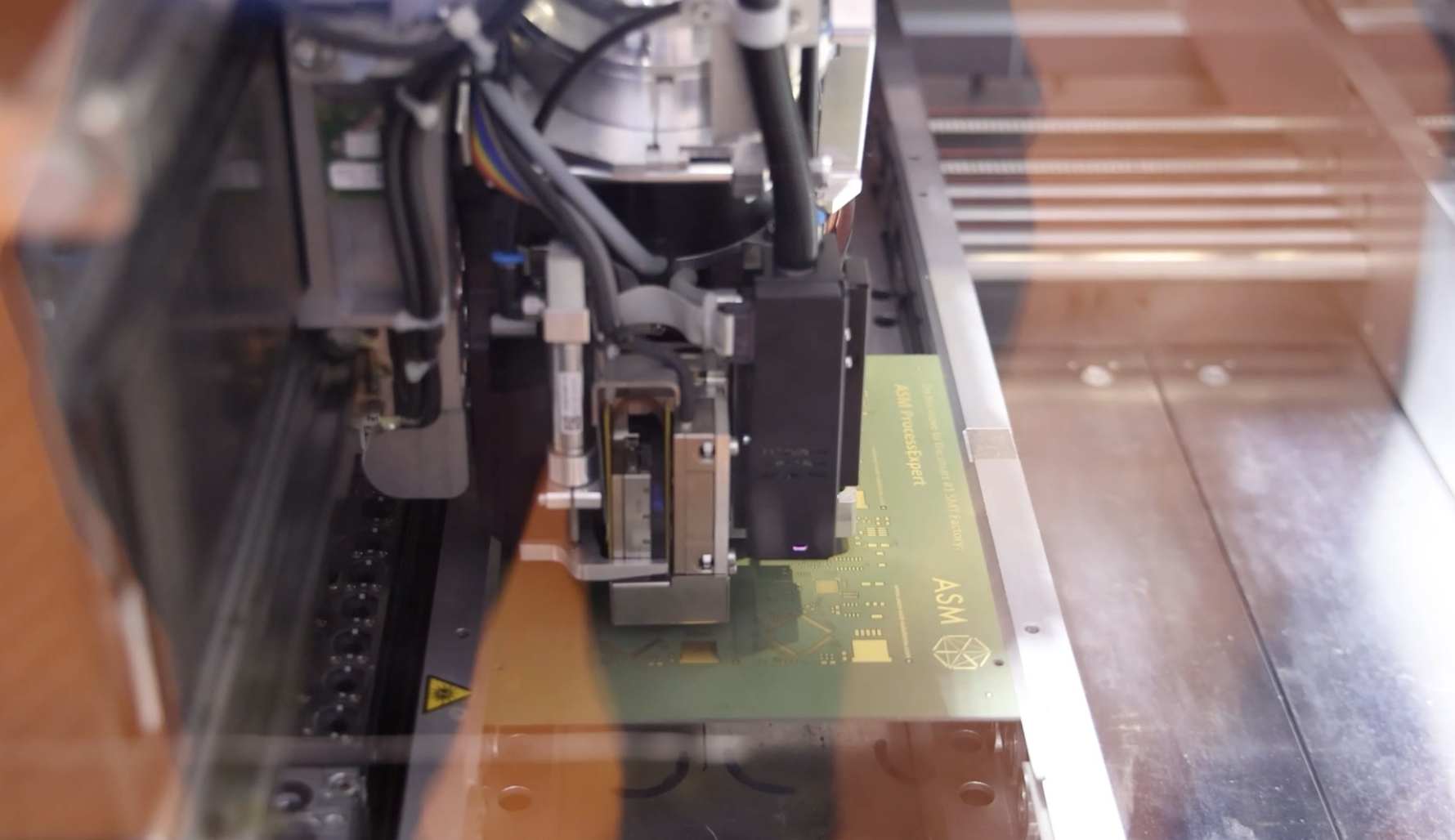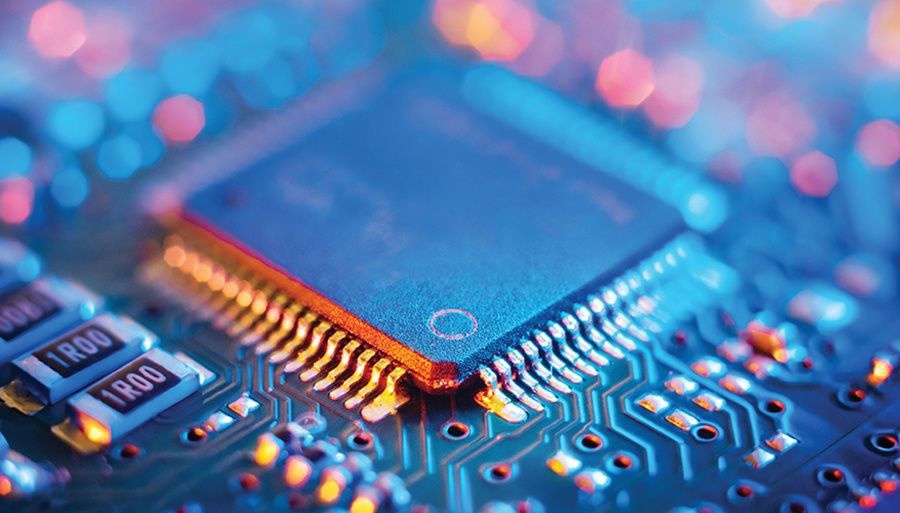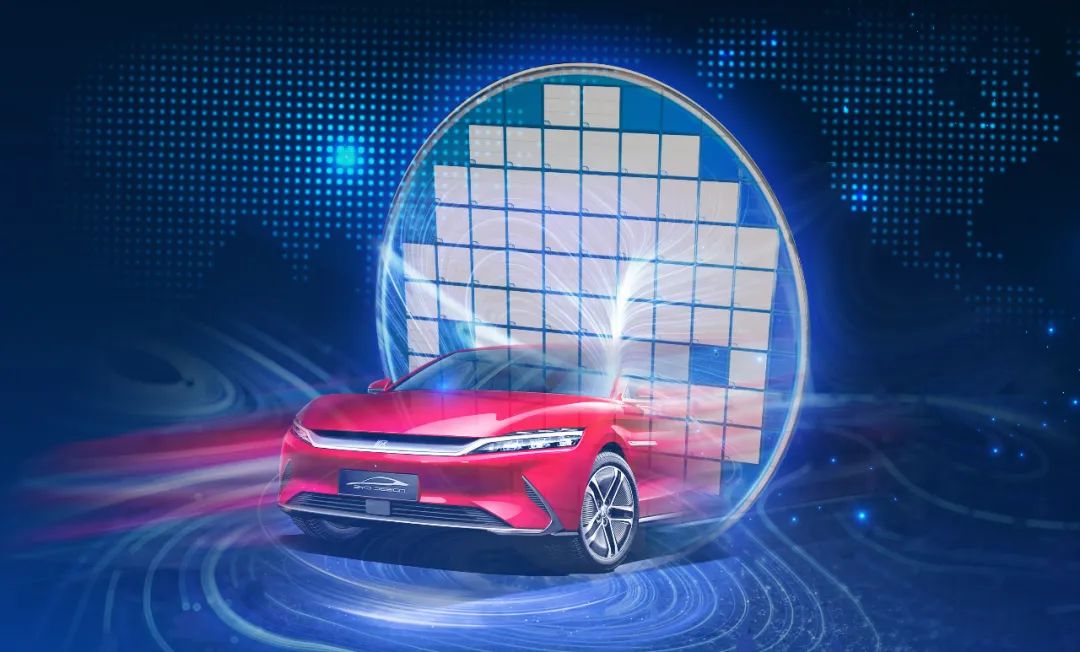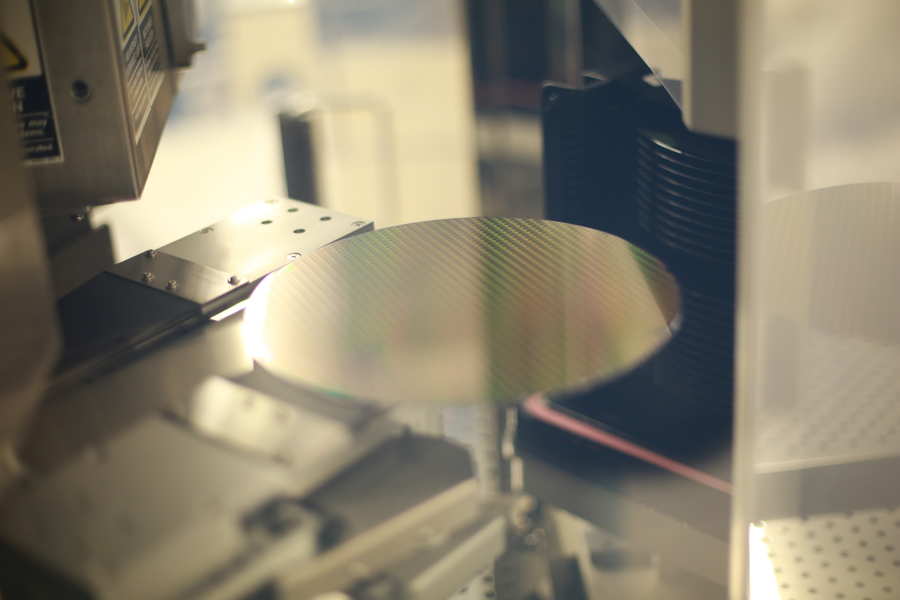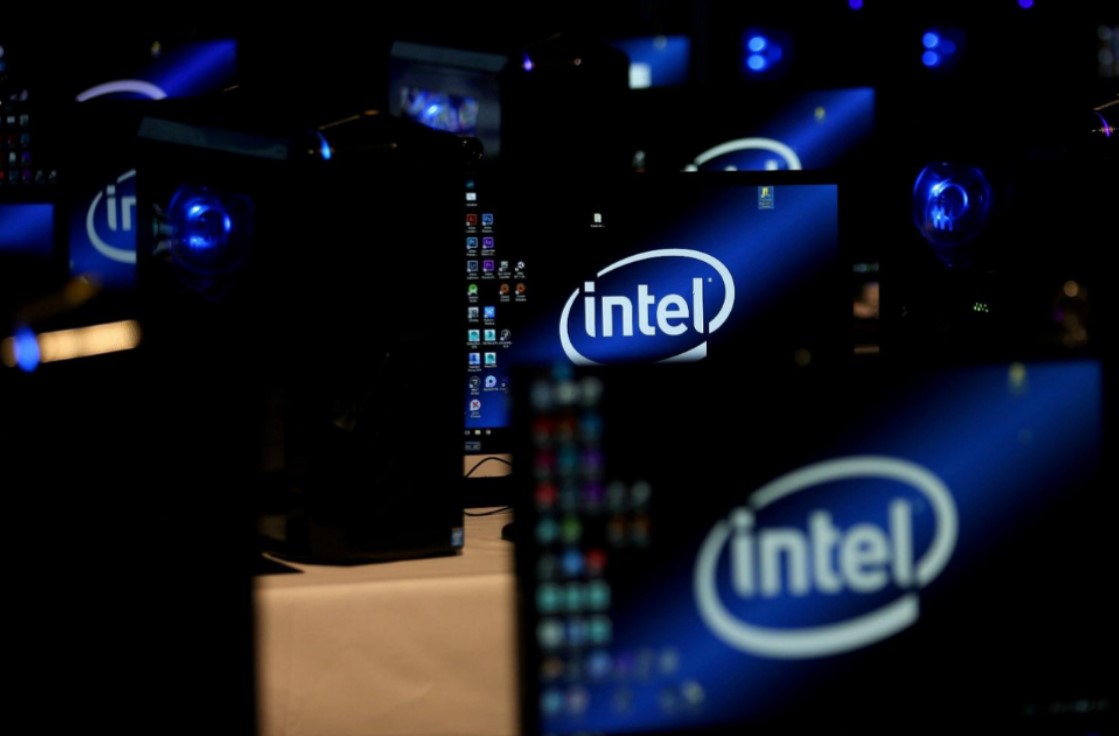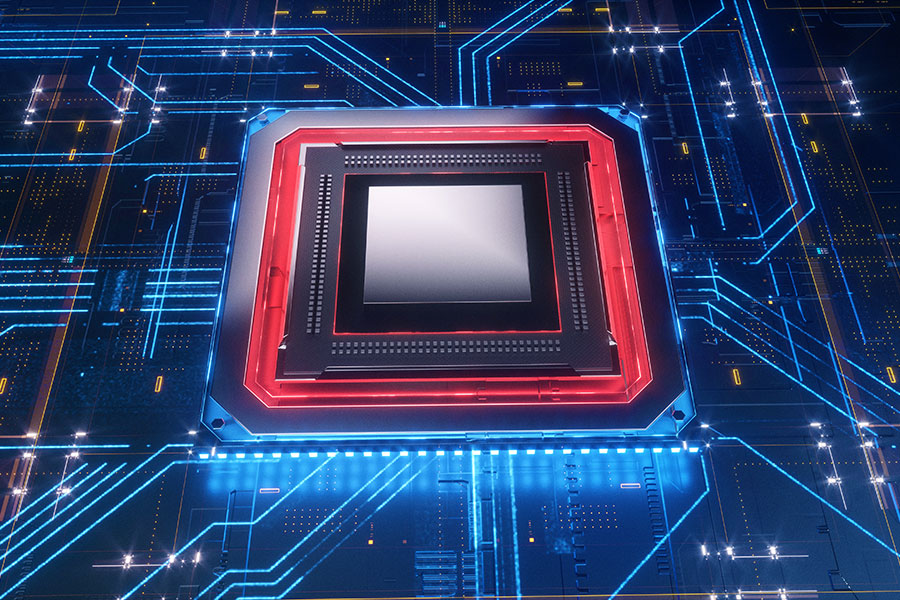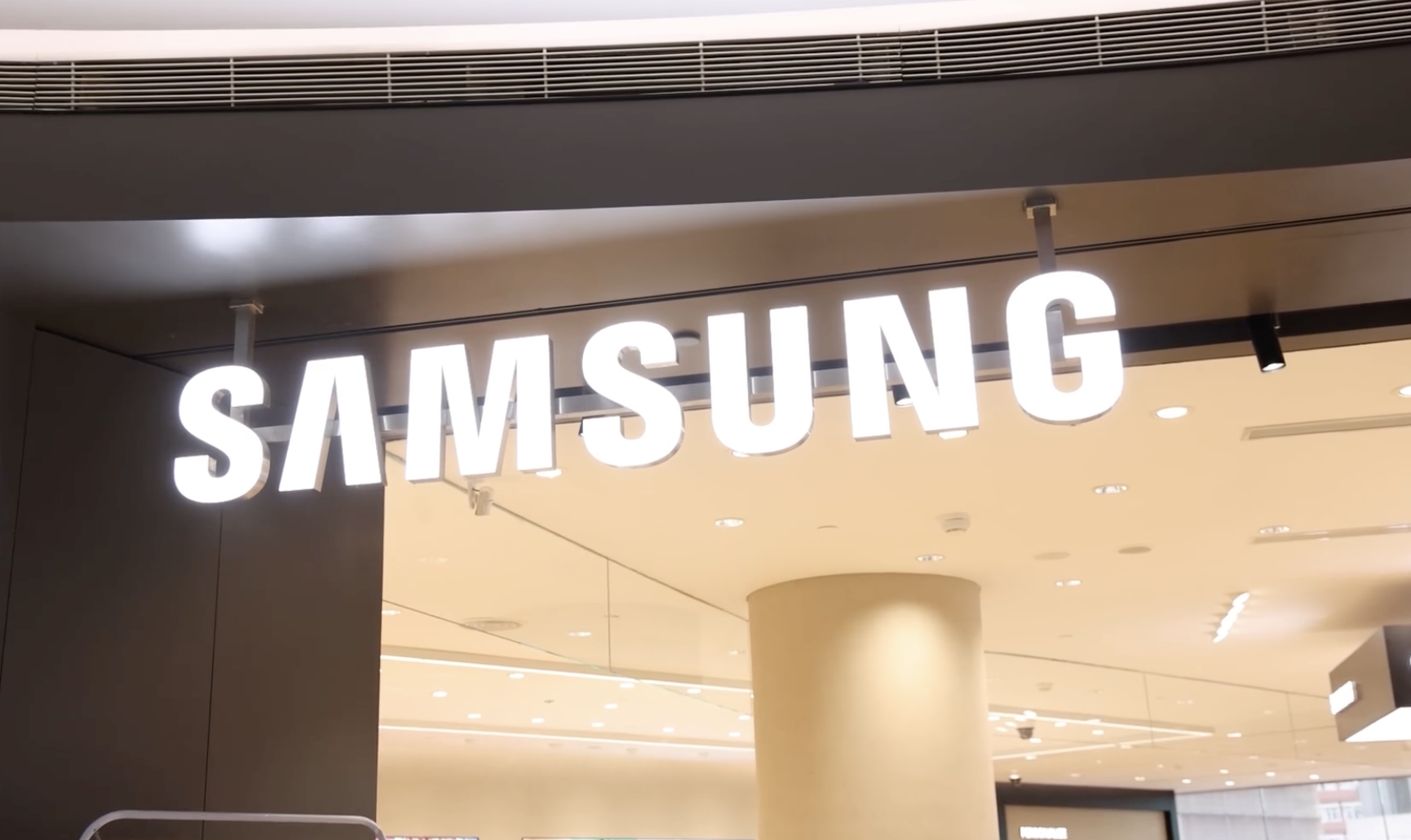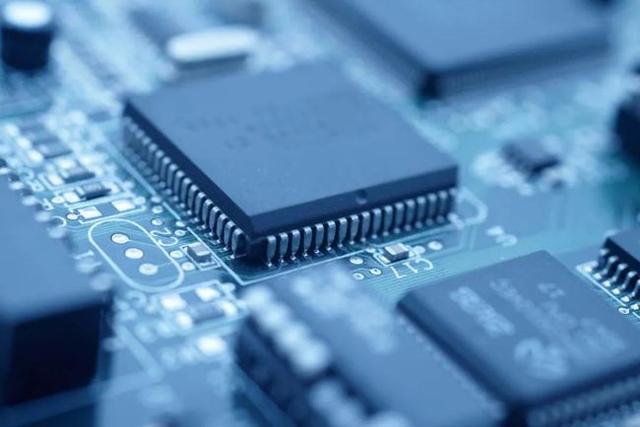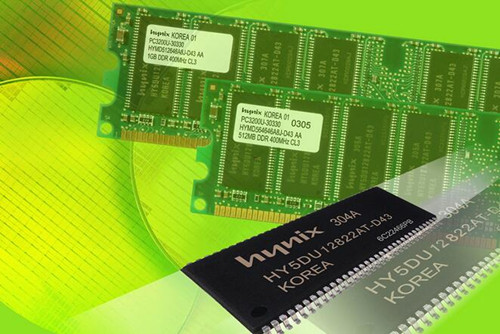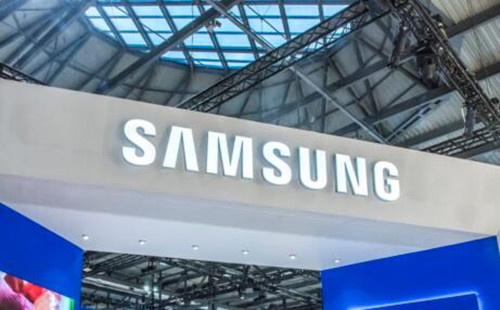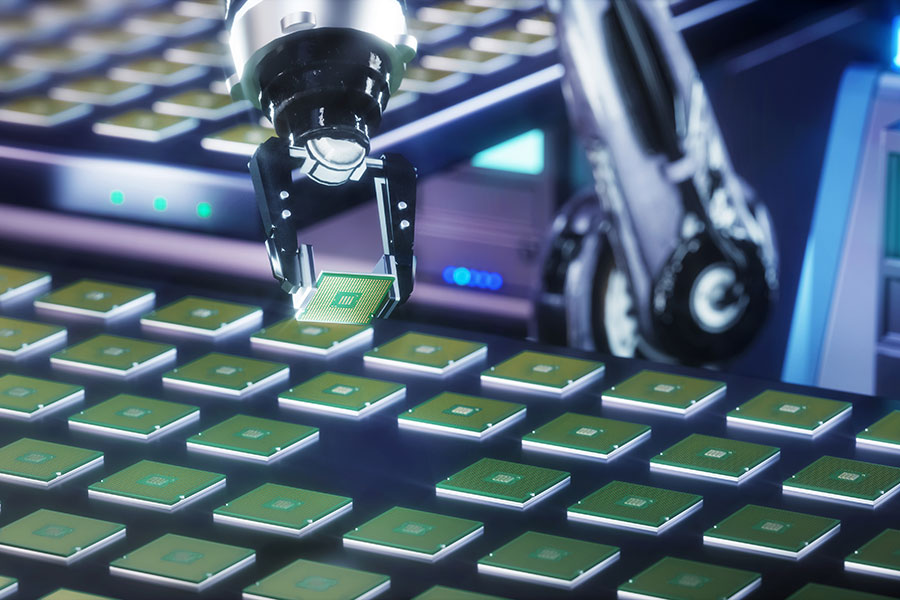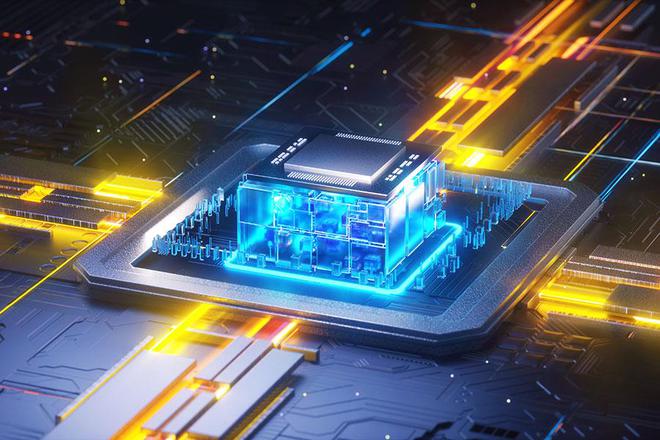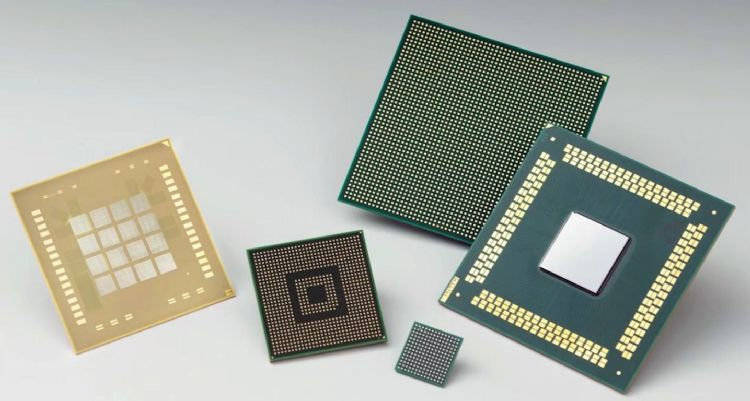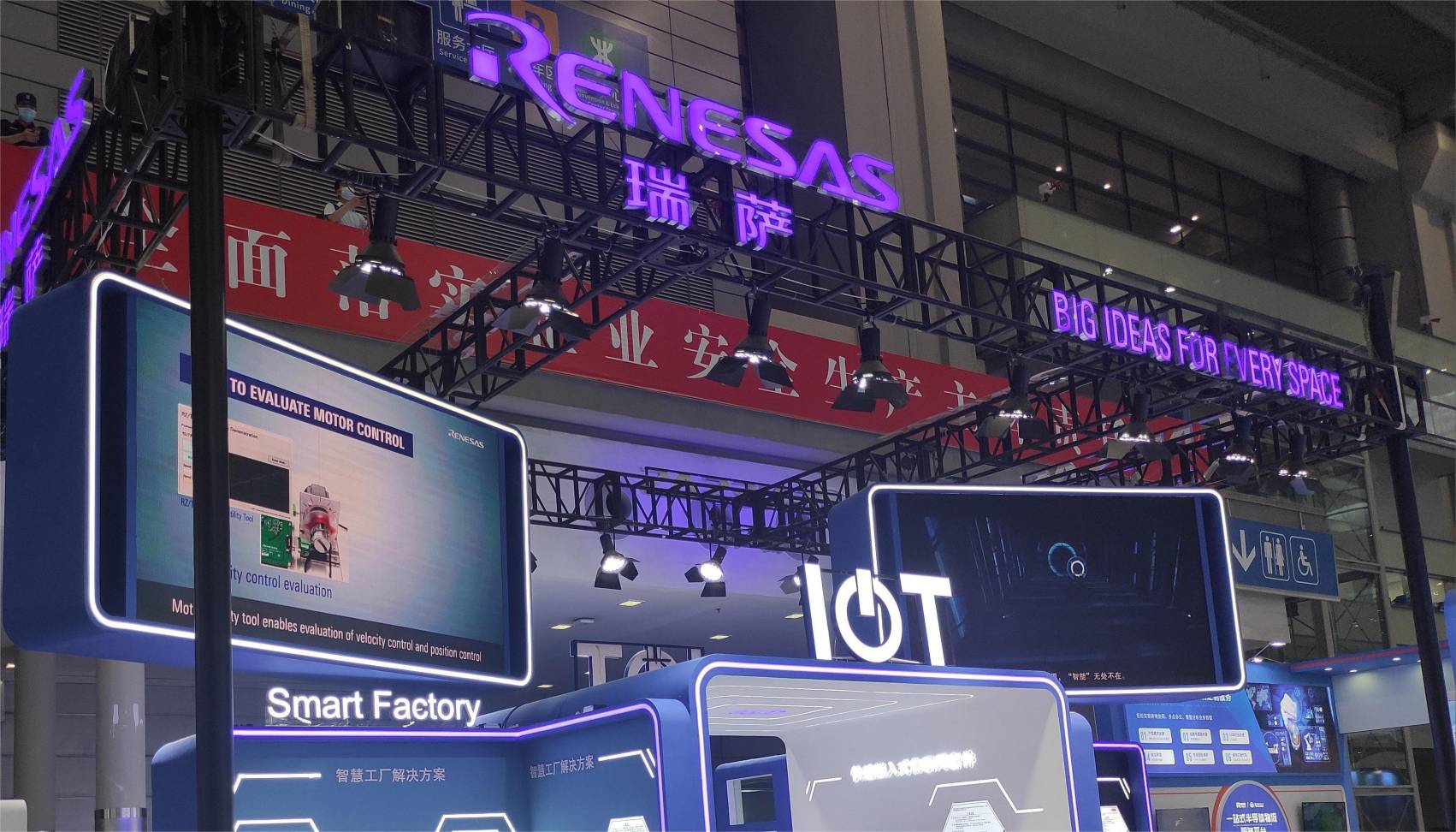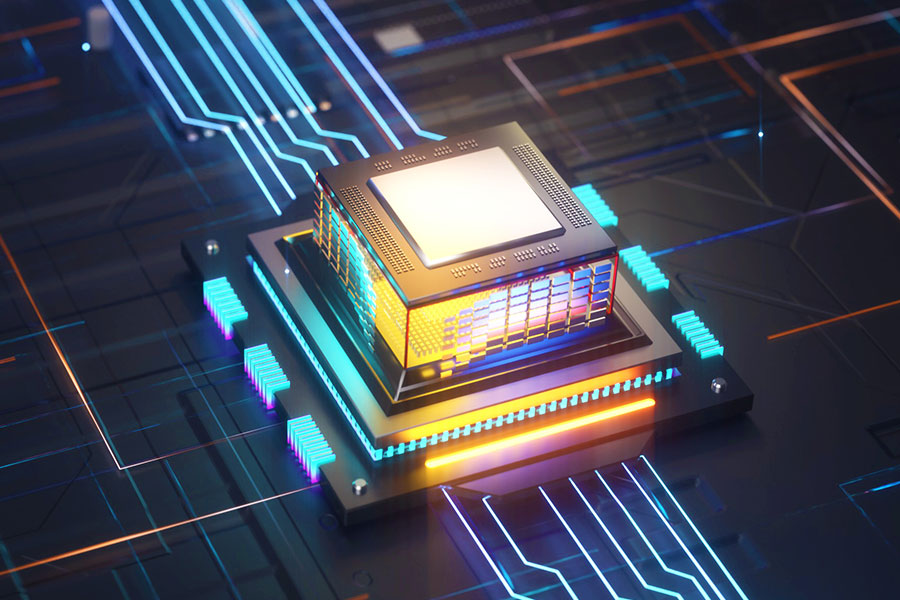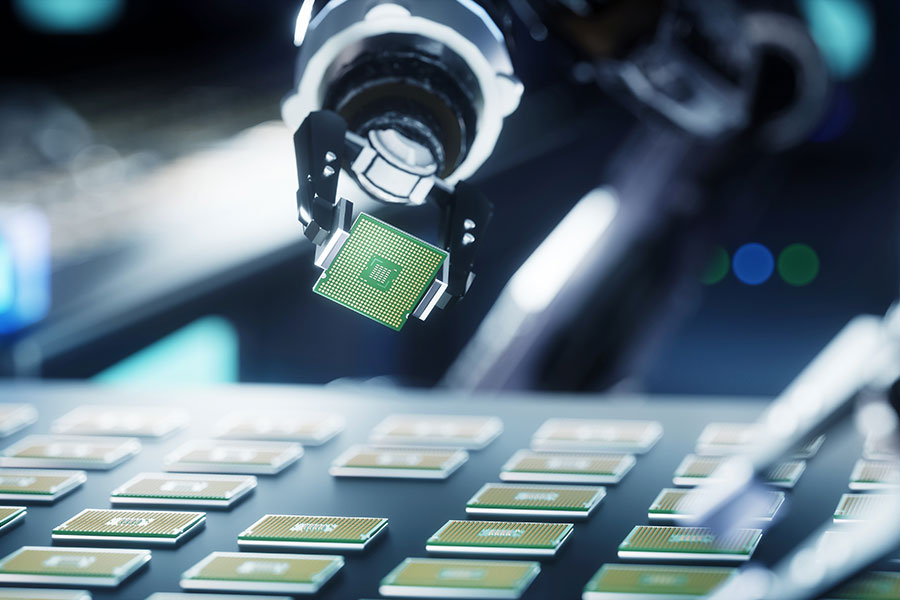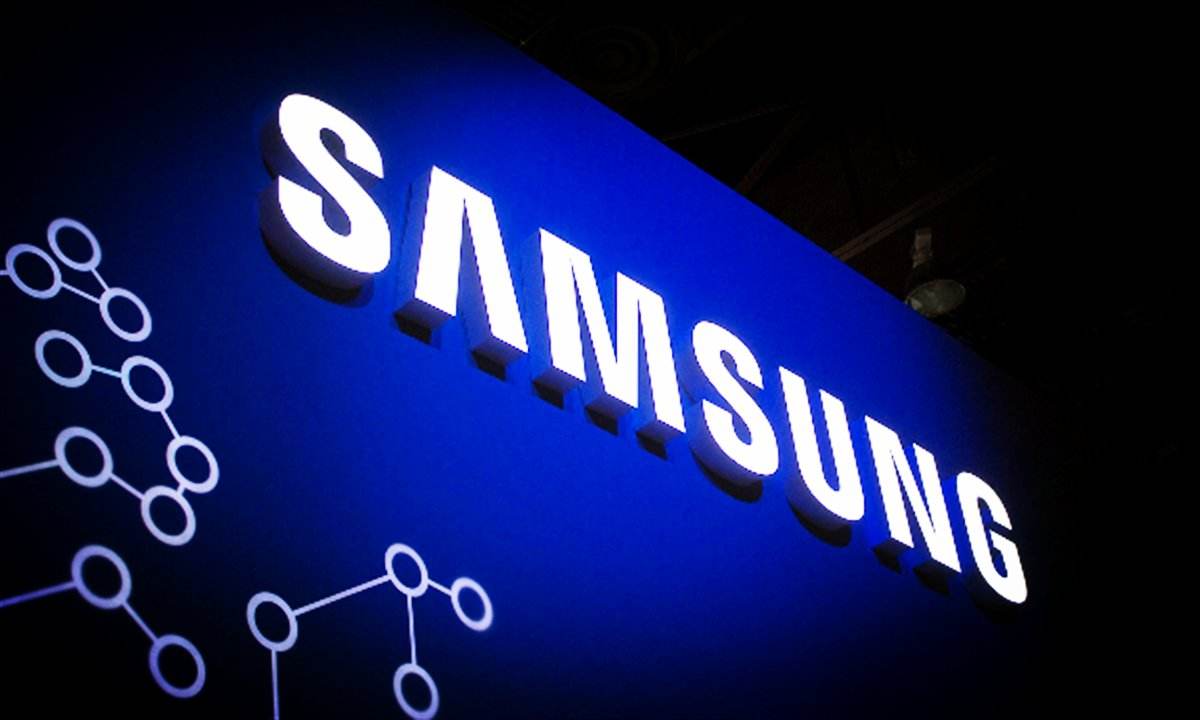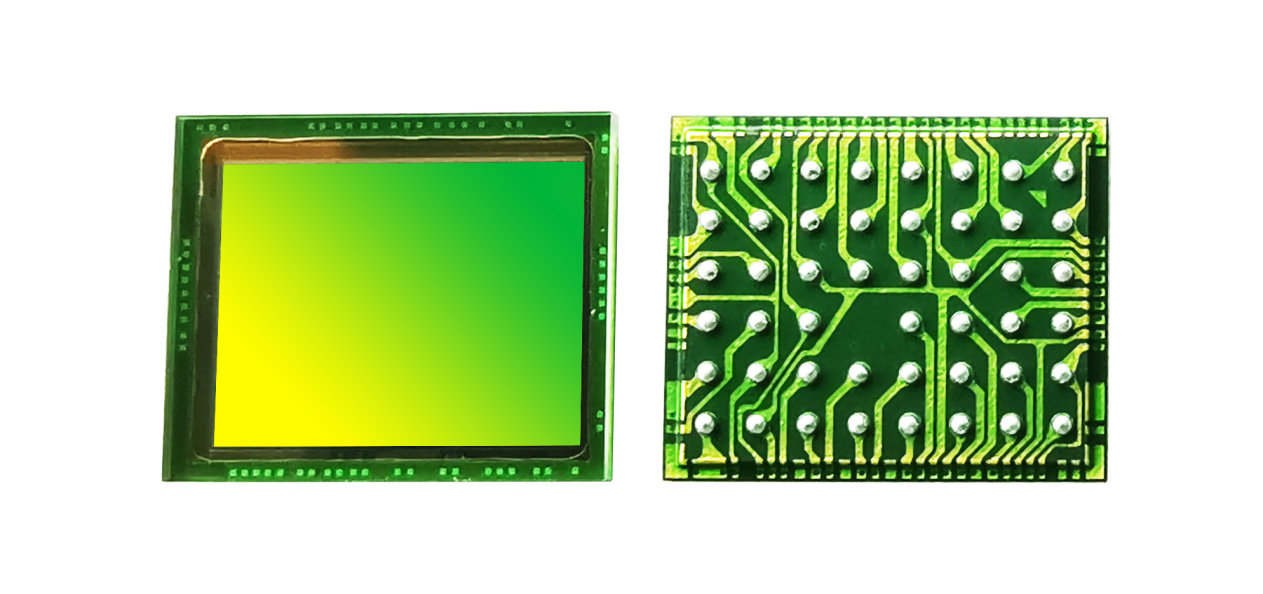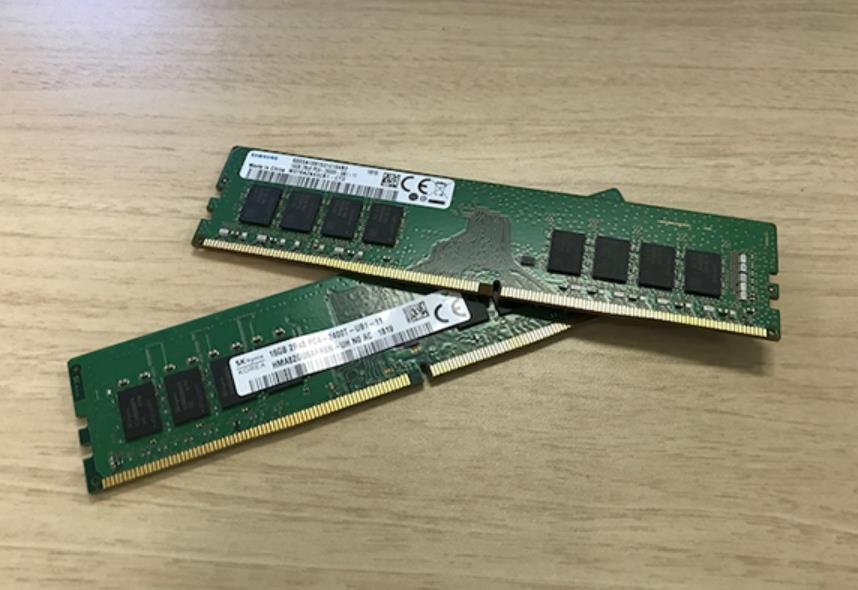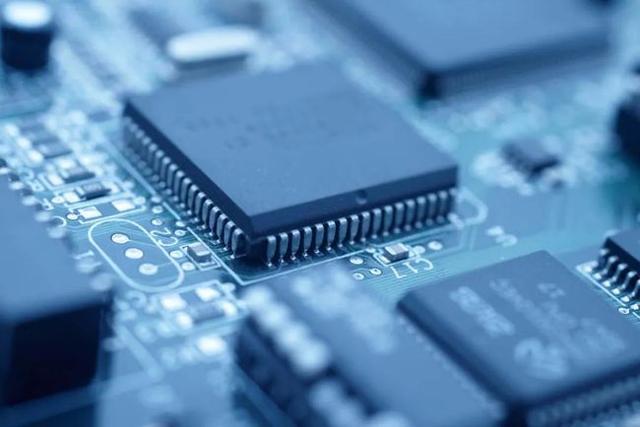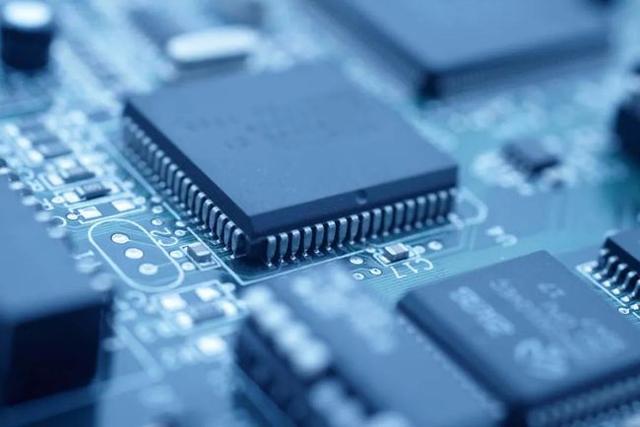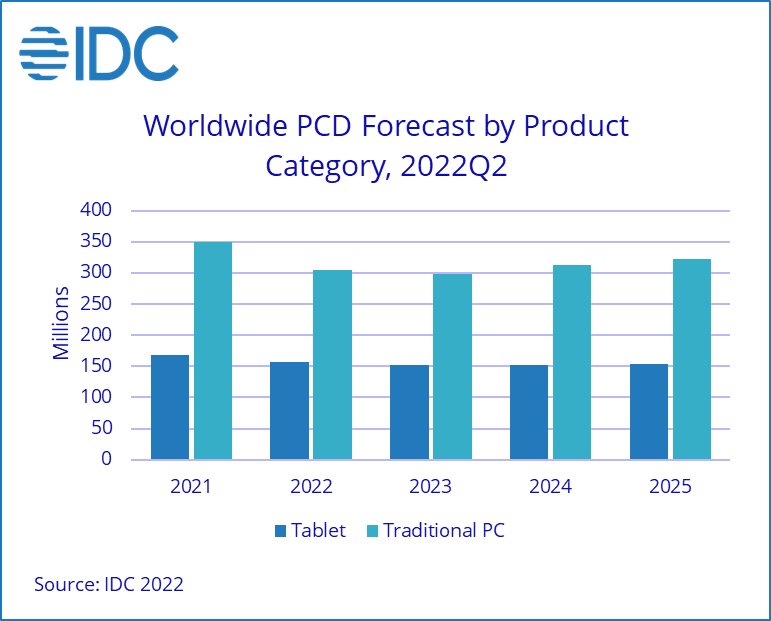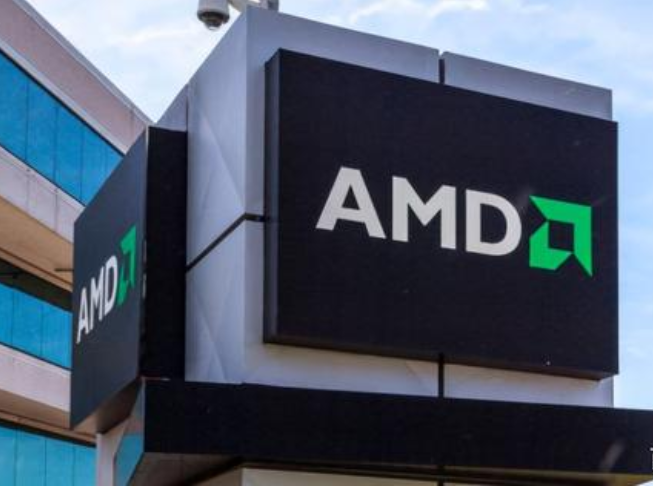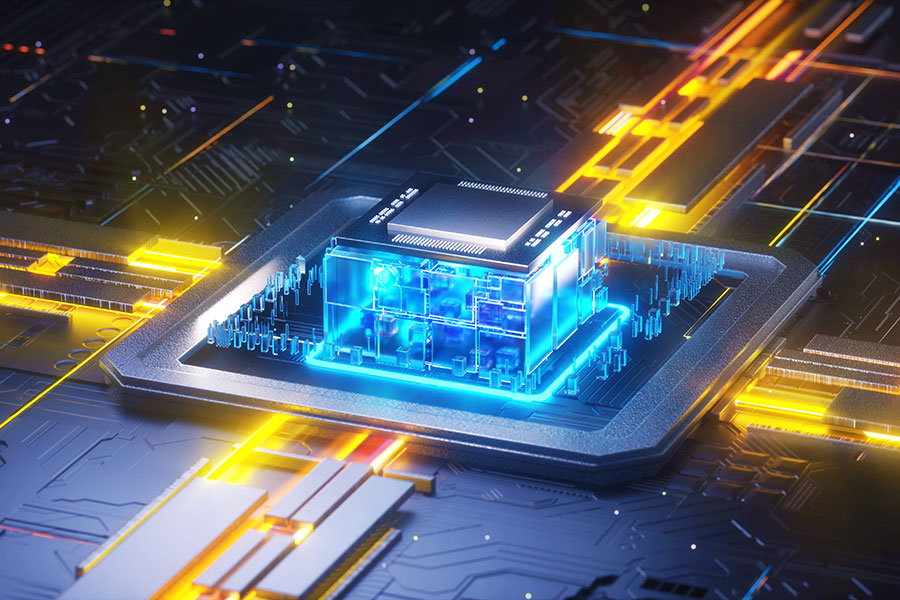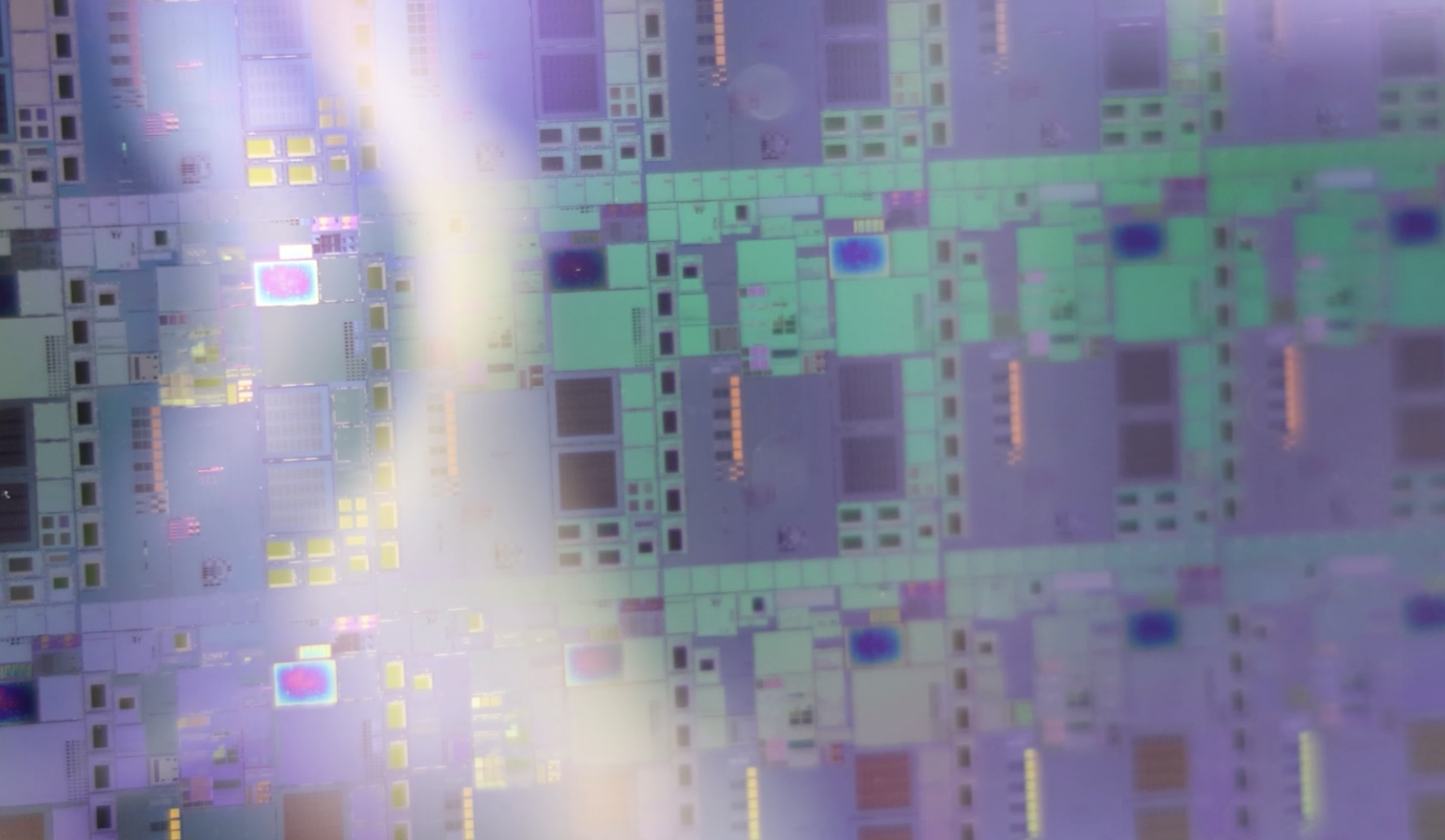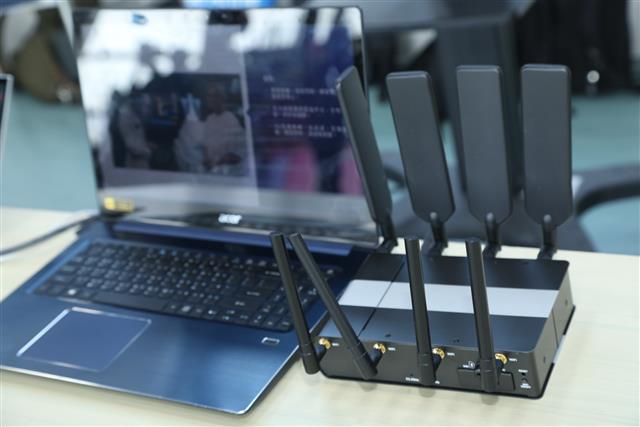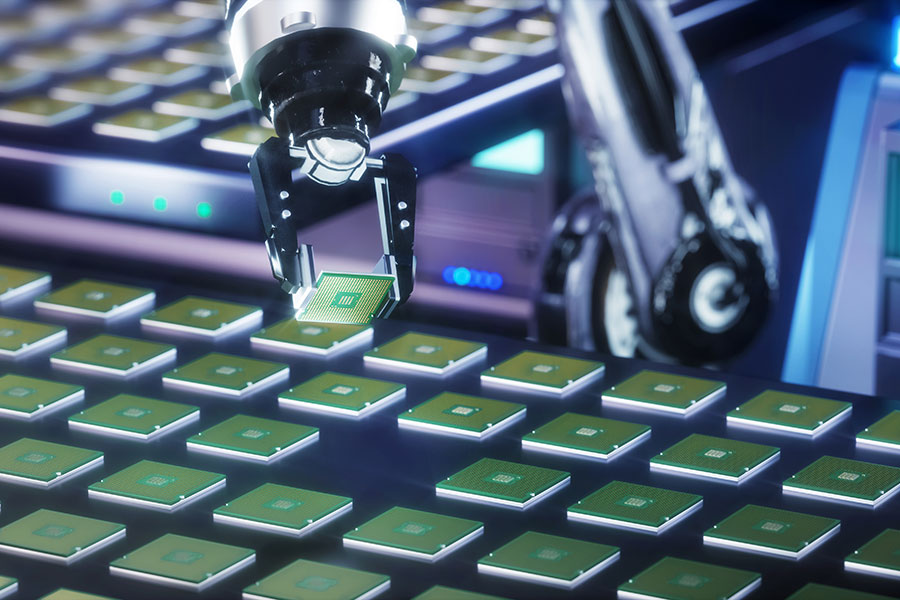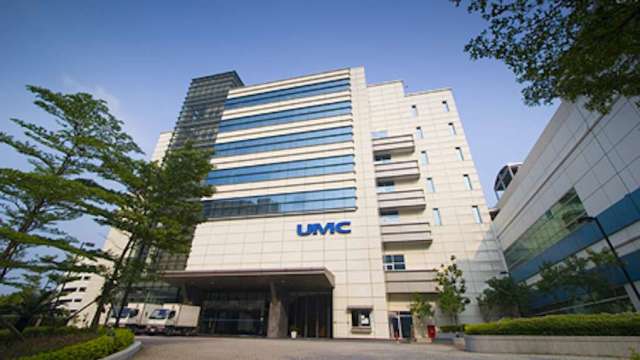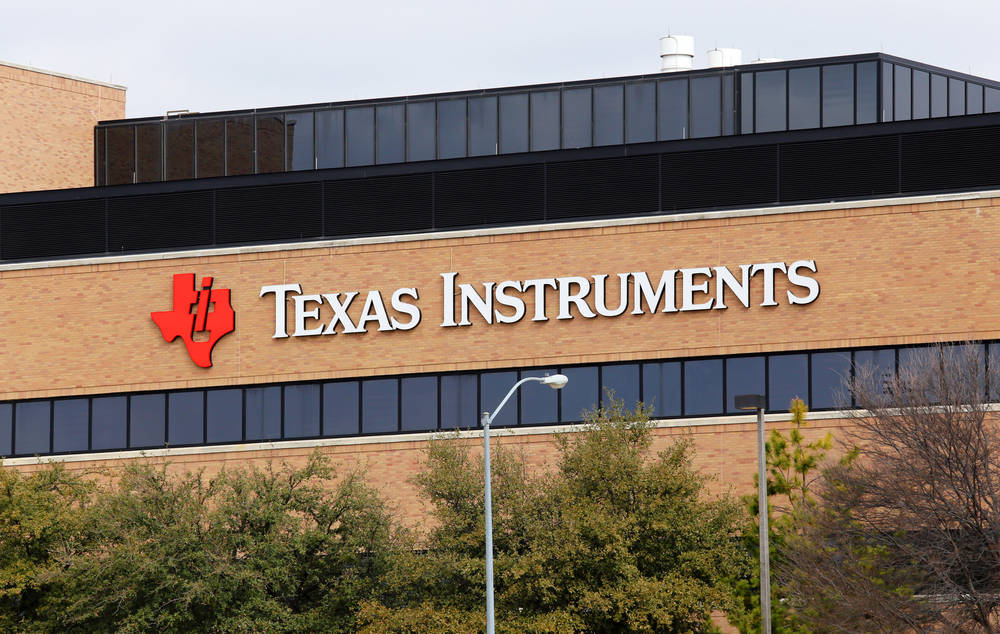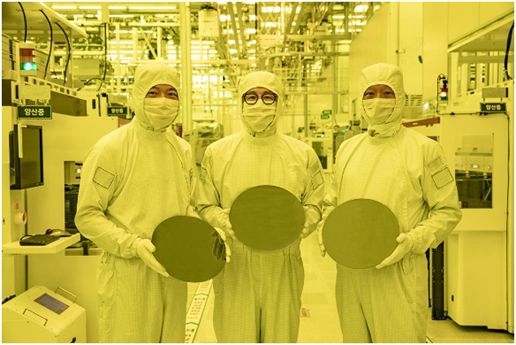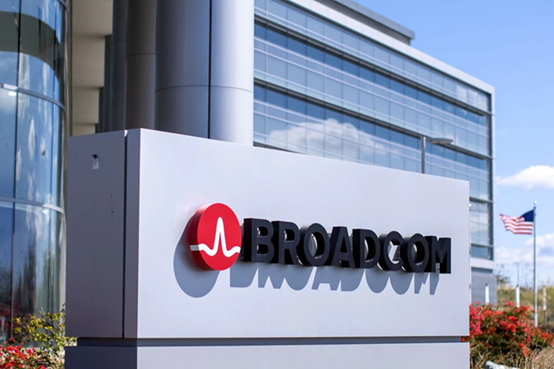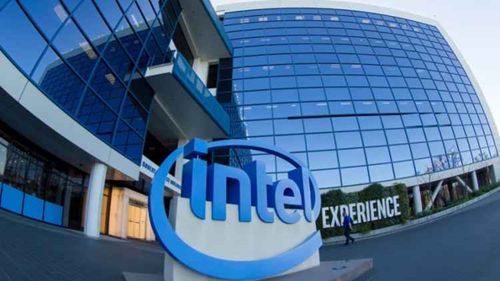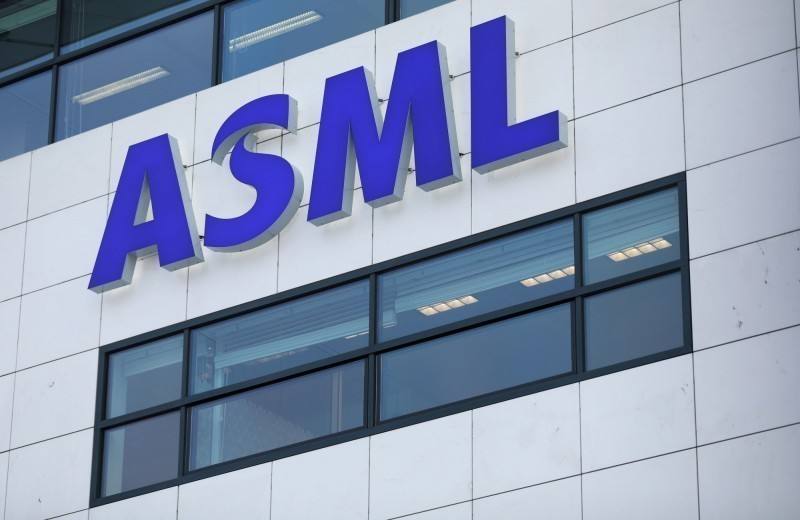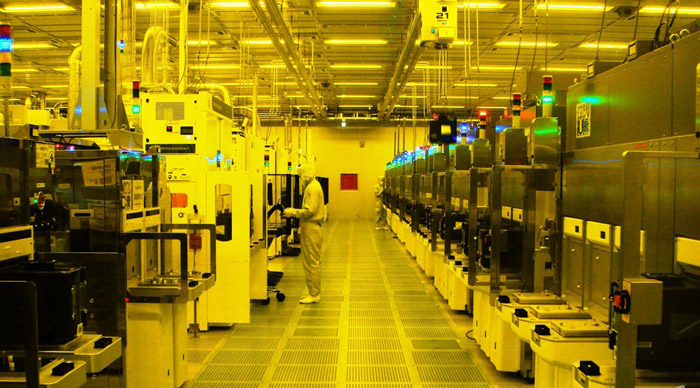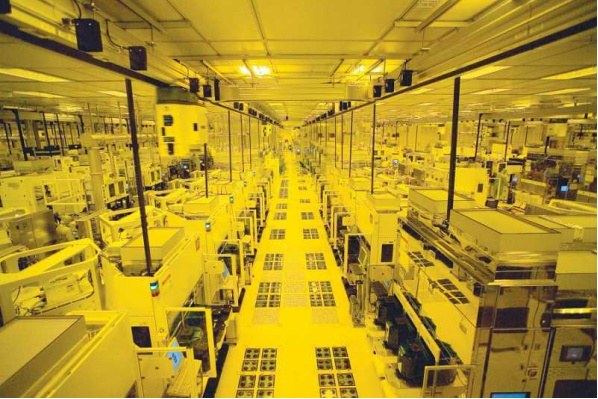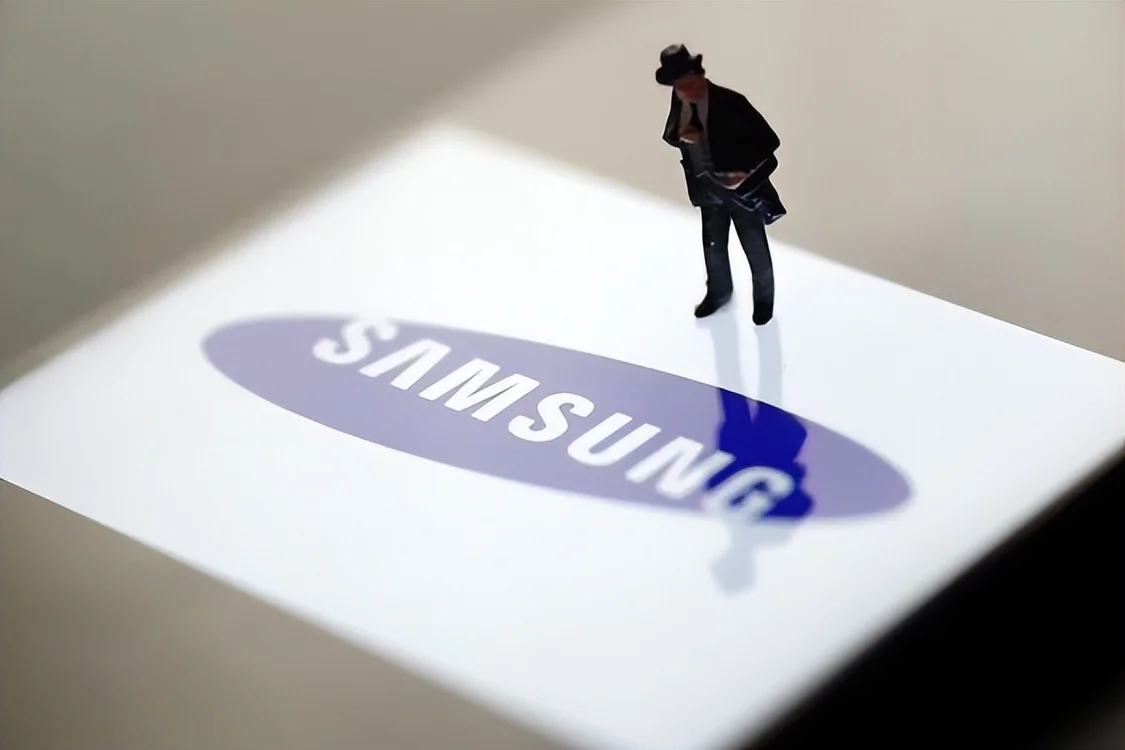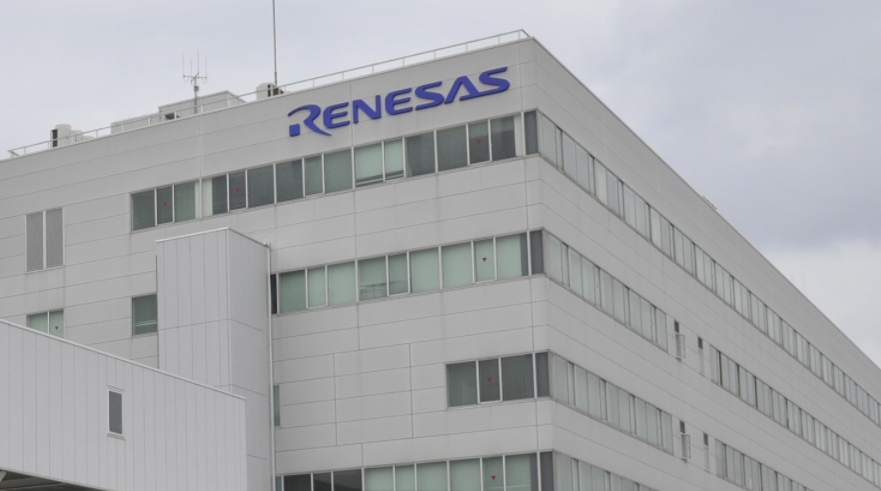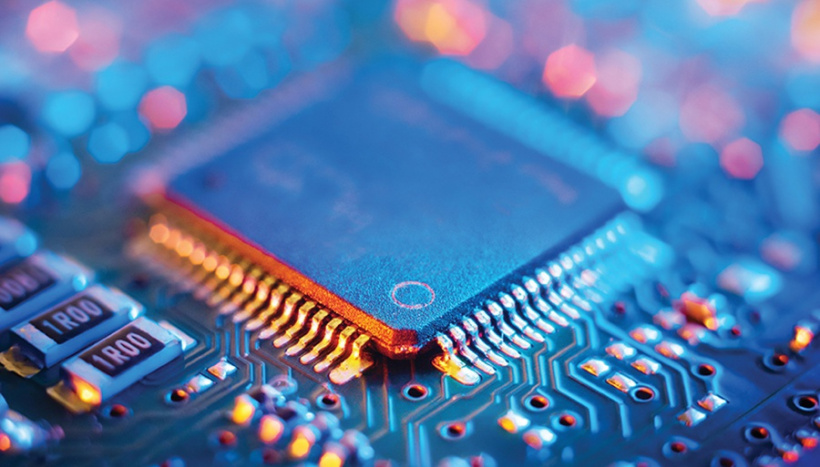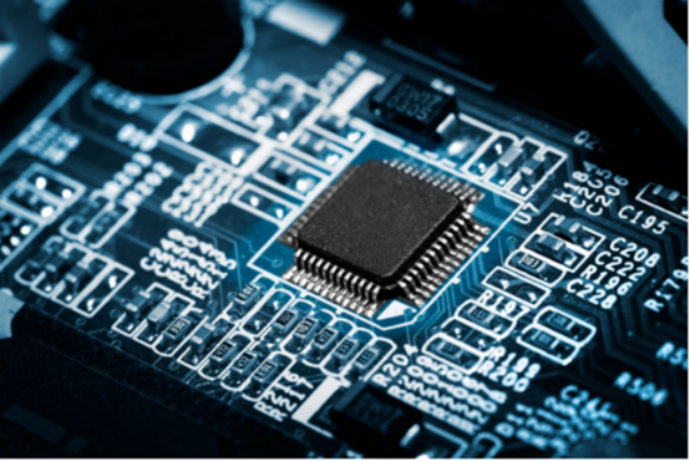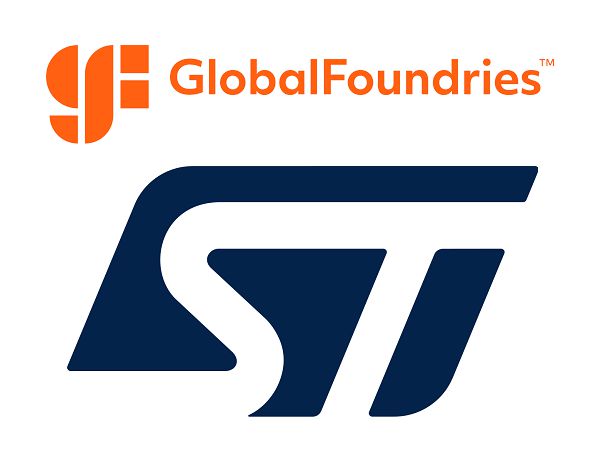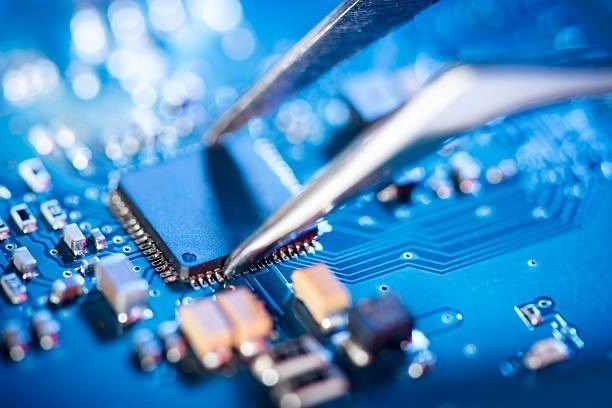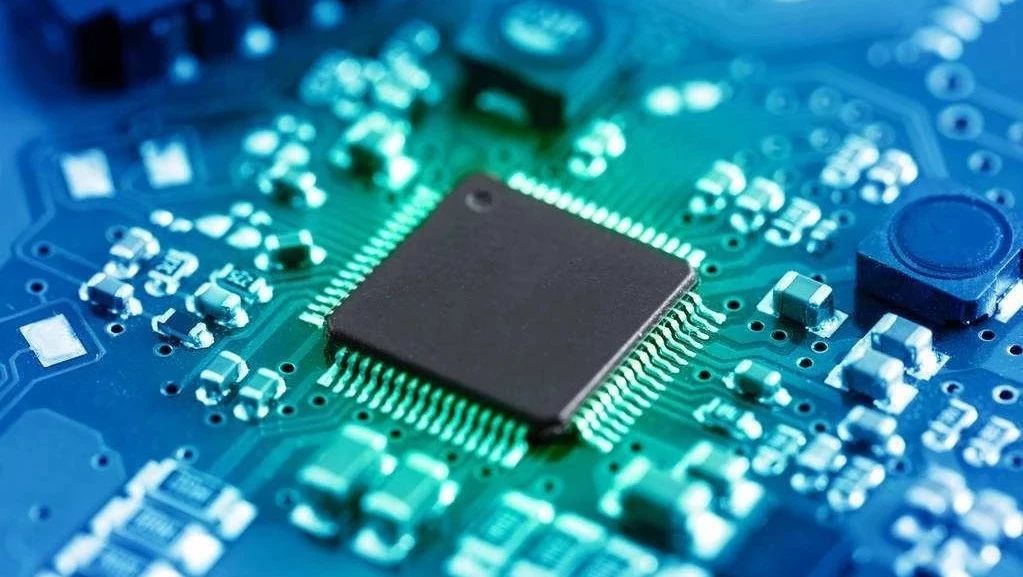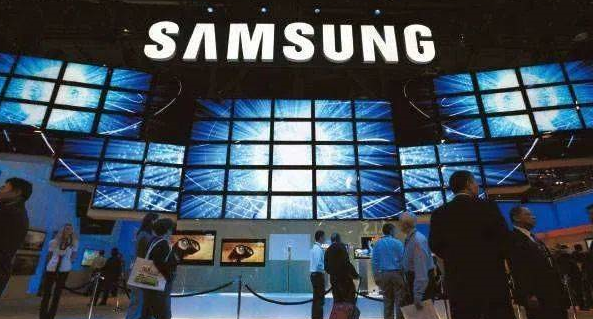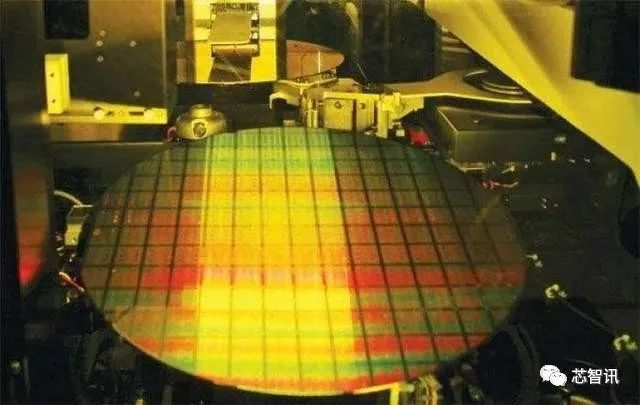570
6
Micron to get $6.1bn in Chips Act money
Micron will get $6.1 billion in US Chips Act grants to help build fabs in New York and Idaho.
Senator Chuck Schumer of New York announced the award and said the money would go towards building two fabs in New York by 2030 and one in Idaho.
US President Joe Biden is expected to make an announcement about the award on Thursday when he visits Syracuse, New York.
Syracuse is where Micron has said it intends to build up to four fabs over the next two decades at a cost of $100 billion.
Last week New York Governor Kathy Hochul said funding from the Chips Act would secure a $100 billion investment in the state.
Major Chips Act awards have now gone to Intel, TSMC, Samsung and Micron. In addition to the grants, the firms qualify for a 25% tax credit on the cost of building fabs.
Jayce
/include/upload/kind/image/20240423/20240423175118_8256.jpg
Micron will get $6.1 billion in US Chips Act grants to help build fabs in New York and Idaho.
Senator Chuck Schumer of New York announced the award and said the money would go towards building two fabs in New York by 2030 and o
2024/4/23 17:51:35
2024/4/23 17:51:35
1
0
568
6
TSMC Q1 Profit Up 8.9%
Earlier today TSMC announced Q1 revenue up 12.9% y-o-y at $18.87 billion and profit up 8.9% y-o-y at $6.96 billion.
Compared to Q4, the Q1 revenue was down 5.3% and net income was down 5.5%.
Gross margin for the quarter was 53.1%, operating margin was 42.0%, and net profit margin was 38.0%.
In Q1, shipments of 3-nanometer accounted for 9% of total wafer revenue; 5-nanometer accounted for 37%; 7-nanometer accounted for 19%.
Advanced technologies, defined as 7-nanometer and more advanced technologies, accounted for 65% of total wafer revenue
Jayce
/include/upload/kind/image/20240418/20240418220445_3569.jpg
Earlier today TSMC announced Q1 revenue up 12.9% y-o-y at $18.87 billion and profit up 8.9% y-o-y at $6.96 billion.
Compared to Q4, the Q1 revenue was down 5.3% and net income was down 5.5%.
Gross margin for the
2024/4/18 22:05:14
2024/4/18 22:05:14
5
0
567
6
Apple Loses Phone Crown as Q1 Market Grows 7.8%
The Q1 smartphone market grew 7.8% q-o-q to 289.4 million units, says IDC. It was the third consecutive quarter of market growth,
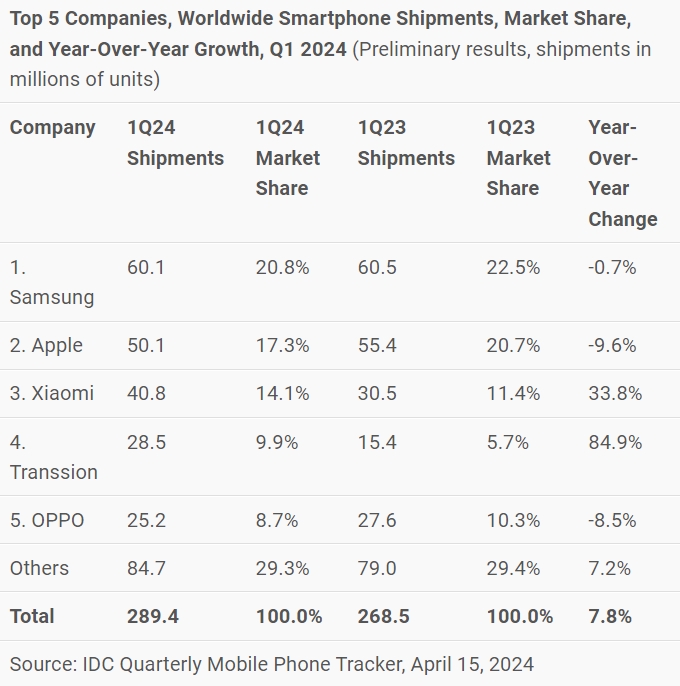
Notes:
? Data are preliminary and subject to change.
-
Company shipments are branded device shipments and exclude OEM sales for all vendors.
-
The “Company” represents the current parent company (or holding company) for all brands owned and operated as a subsidiary.
-
Figures represent new shipments only and exclude refurbished units.
Jayce
/include/upload/kind/image/20240416/20240416174142_5644.jpg
The Q1 smartphone market grew 7.8% q-o-q to 289.4 million units, says IDC. It was the third consecutive quarter of market growth,
Notes:
• Data are preliminary and subject to change.
2024/4/16 17:42:41
2024/4/16 17:42:41
9
0
565
6
Semi Manufacturing Equipment Sales Fell 1.3% Last Year, Says SEMI.
2023 sales of semiconductor manufacturing equipment fell 1.3% to $106.3 billion from 2022’s record $107.6 billion, says SEMI.
China was the biggest market, growing 29% y-o-y to $36.6 billion, followed by Korea which fell 7% to $19.9 billion and Taiwan which fell 27% to $19.6 billion.
The US market rose 15%, the EU fell 3%, Japan fell 5% and RoW fell 39%.
“Despite a slight dip in global equipment sales, the semiconductor industry continues to show strength, with strategic investments fueling growths in key regions,” says SEMI CEO Ajit Manocha, “the overall results for the year were better than anticipated by most industry followers.”
Wafer processing equipment sales rose 1%, other front-end segment billings increased by 10%, assembly and packaging equipment fell 30% and test equipment fell 17%.
Jayce
/include/upload/kind/image/20240412/20240412175142_3554.jpg
2023 sales of semiconductor manufacturing equipment fell 1.3% to $106.3 billion from 2022’s record $107.6 billion, says SEMI.
China was the biggest market, growing 29% y-o-y to $36.6 billion, followed by Korea whi
2024/4/12 17:52:08
2024/4/12 17:52:08
11
0
564
6
TSMC Q1 Up 16.5% Y-o-Y
TSMC had Q1 revenue up 16.5% y-o-y at $18.54 billion up from $16.72 billion Q1 2023.
For March, TSMC had revenues that were 34.3% up y-o-y and 7.5% up m-o-m at $6.2 billion.
It was the biggest m-o-m rise since November 2022.

Jayce
/include/upload/kind/image/20240411/20240411171106_4468.jpg
TSMC had Q1 revenue up 16.5% y-o-y at $18.54 billion up from $16.72 billion Q1 2023.
For March, TSMC had revenues that were 34.3% up y-o-y and 7.5% up m-o-m at $6.2 billion.
It was the biggest m-o-m rise since Nove
2024/4/11 17:12:24
2024/4/11 17:12:24
13
0
563
6
PC Shipments Back to Pre-Covid Levels
After two years of decline, the worldwide traditional PC market returned to growth during the first quarter of 2024 (1Q24) with 59.8 million shipments, growing 1.5% year over year, according to IDC
RECOMMENDED ARTICLESHMI claims smallest SIM card level translatorNordic into tracking with GoogleCurren steps down as CEO of SondrelTSMC gets $11.6bn funding and ups US spend to $65bnIn Q1 2023, the market declined 28.7% – the biggest drop in PC history.
In Q1 2024, global PC shipments finally returned to pre-pandemic levels as volumes rivaled those seen in 1Q19 when 60.5 million units were shipped.
With inflation numbers trending down, PC shipments have begun to recover in most regions, leading to growth in the Americas as well as Europe, the Middle East, and Africa (EMEA). However, the deflationary pressures in China directly impacted the global PC market.
As the largest consumer of desktop PCs, weak demand in China led to yet another quarter of declines for global desktop shipments, which already faced pressure from notebooks as the preferred form factor.
“Despite China’s struggles, the recovery is expected to continue in 2024 as newer AI PCs hit shelves later this year and as commercial buyers begin refreshing the PCs that were purchased during the pandemic,” says IDC’s Jitesh Ubrani.
Among the top 5 companies, Lenovo once again held the top spot and outgrew the market largely due to the steep decline in shipments experienced in 1Q23.
Apple’s strong growth was also due to an outsized decline in the prior year.

Notes:
* IDC declares a statistical tie in the Personal Computing Device market when there is a difference of one tenth of one percent (0.1%) or less in the shipment shares among two or more vendors.
-
Traditional PCs include Desktops, Notebooks, and Workstations and do not include Tablets or x86 Servers. Detachable Tablets and Slate Tablets are part of the Personal Computing Device Tracker but are not addressed in this press release.
-
Shipments include shipments to distribution channels or end users. OEM sales are counted under the company/brand under which they are sold.
Jayce
/include/upload/kind/image/20240409/20240409180932_6610.png
After two years of decline, the worldwide traditional PC market returned to growth during the first quarter of 2024 (1Q24) with 59.8 million shipments, growing 1.5% year over year, according to IDC
RECOMMENDED ARTICLESHMI claim
2024/4/9 18:11:11
2024/4/9 18:11:11
16
0
561
6
TSMC Hit by Quake
Earlier today, TSMC evacuated some of its fabs in Taiwan after an earthquake and is evaluating the loss of production.
“TSMC’s safety systems are operating normally,” says the company, “to ensure the safety of personnel, some fabs were evacuated according to company procedure. We are currently confirming the details of the impact.”
TSMC said construction sites were normal upon initial inspection, but the company decided to suspend work at the sites for the day.
Staff evacuated from some plants have started to return to work.
The earthquake measured 7.4 on the Richter Scale – the worst quake Taiwan has suffered for 25 years.
Jayce
/include/upload/kind/image/20240403/20240403181726_4570.jpg
Earlier today, TSMC evacuated some of its fabs in Taiwan after an earthquake and is evaluating the loss of production.
“TSMC’s safety systems are operating normally,” says the company, “to ensure the safety of personnel, some fab
2024/4/3 18:17:27
2024/4/3 18:17:27
18
0
560
6
Sensor Market Soaring
Sensors for electrification and ADAS are showing remarkably strong growth between 2019 and 2029, with 24% and 17% CAGR, respectively, reports Yole Developpement.
6.5 billion semiconductor sensors for automotive applications were shipped last year generating revenue of $9.3 billion and demand is pointing to a 9 billion unit market with revenue of $14.3 billion by 2029 at a 7% CAGR between 2023 and 2029.
“The upcoming years are poised to witness a dynamic transformation in automotive sensor technology driven by advancements in ADAS, autonomous driving, electrification, and the widespread adoption of sensors across global car fleets,” says Yole’s Pierrick Boulay, “consequently, substantial reorganization within the industry and its supply chain is anticipated.”
The biggest segments are radars and CIS, with more than $4 billion and more than $3 billion, respectively, in 2029. LiDARs will have the biggest growth at 48% to $649 million during the 2019-29 period.
Bosch, leads the market due to strong revenue in MEMS (pressure, accelerometer, IMU) and radar.
During these coming years, the automotive industry is expected to go through massive transformations in all four car domains:
In powertrain and electrification, the automotive industry is transitioning from cars based on internal combustion engines (ICE) to electrified cars, which are expected to represent 43% of production in 2029.
In terms of sensors, this segment will grow with a 3% CAGR between 2023 and 2029. In the long term, the electrification of cars will induce critical changes in the sensor landscape by giving birth to new applications while removing others.

In the ADAS and safety segment, cars are becoming more intelligent, enhancing safety while driving autonomously. Revenue is by far the largest of all segments and Yole forecasts about $8 billion in revenue by 2029.
Infotainment and telematics: with customers demanding greater entertainment options for both drivers and passengers, this sector is projected to achieve a favorable 7% CAGR from 2023 to 2029. This segment should exceed $2.9 billion by 2029.
In the chassis domain, OEMs strive to improve passenger safety, send valuable data to the ADAS computing unit, and even remove hydraulic systems in the car. In this context, the global sensorization of cars is driving sensor volumes to a 3% CAGR between 2023 and 2029. In terms of revenue, Yole Group expects almost $1.9 billion to be generated in 2029.
Jayce
/include/upload/kind/image/20240402/20240402174139_3502.jpg
Sensors for electrification and ADAS are showing remarkably strong growth between 2019 and 2029, with 24% and 17% CAGR, respectively, reports Yole Developpement.
6.5 billion semiconductor sensors for automotive applications were ship
2024/4/2 17:42:39
2024/4/2 17:42:39
17
0
558
6
As the Market Fell Last Year, A Winner Emerged
As the industry fell 9% from $597.7 billion in 2022 to $544.8 billion last year, a new growth driver emerged – AI, says Omdia, with NVIDIA dominating the AI chip space so comprehensively that it took the No.2 slot in the overall semiconductor market.

NVIDIA more than doubled its semiconductor revenue from 2022 to $49 billion in 2023. Before the pandemic, in 2029, NVIDIA’s semiconductor revenue was under $10 billion.
High bandwidth memory (HBM) integrated with GPUs to facilitate AI is also seeing strong demand, with SK Hynix leading this segment and other major memory manufacturers venturing into this space.
The memory market had a down year in 2023 overall, while the HBM market had growth of 127% year-over-year in terms of 1Gb equivalent units, throughout 2023. Omdia forecasts that HBM is likely to record 2024 growth rates of 150-200%.
In 2023, the automotive segment exerted greater influence in the semiconductor market as it increased its revenue growth to over 15% in 2023 to over $75 billion. The demand for semiconductors in automotive accounts for approximately 14% of the entire semiconductor market.
The downturn has notably affected major memory makers, traditionally among the top semiconductor companies by revenue. Previously, from 2017 to 2021, Samsung Electronics, SK Hynix, and Micron Technology were all ranked in the top five companies by revenue.
However, amidst the challenging memory market conditions, Samsung Electronics is now ranked third, SK Hynix is ranked sixth, and Micron Technology is ranked twelfth in 2023.
Jayce
/include/upload/kind/image/20240329/20240329180512_2811.jpg
As the industry fell 9% from $597.7 billion in 2022 to $544.8 billion last year, a new growth driver emerged – AI, says Omdia, with NVIDIA dominating the AI chip space so comprehensively that it took the No.2 slot in the overall
2024/3/29 18:05:58
2024/3/29 18:05:58
22
0
557
6
Renesas Dips Toes Into Few-Pin RISC-V MCUs
Resasas has put its in-house developed 32bit RISC-V core into a few-pin general-purpose MCU series, following earlier RISC-V projects with Anders and SiFive.
Announced last November, the core implementation can accommodate various standard RISC-V options, to which Renesas has added its own options including: a stack monitor register to protect against rogue software, a dynamic branch prediction unit improve the average execution throughput, and a context-saving register bank to speed interrupt response.
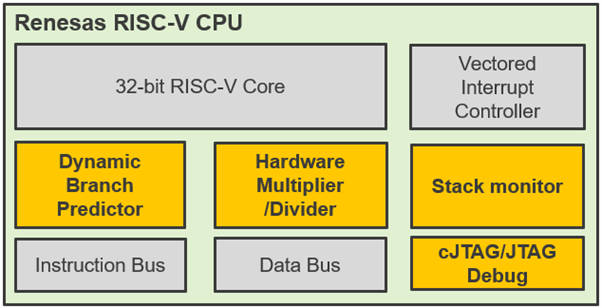
Two-wire compact JTAG debug can be implemented for low pin-count packages, and performance monitor registers can be added for benchmarking, as well as an instruction tracing unit.
The new microcontrollers, called the R9A02G021 group, come in packages with between 16 and 48pads: 2 x 2mm 16pad WLCSP and QFNs from 4 x 4 to 7 x 7mm with 24, 32 or 48pads – there is one part number for each of the four packages.
They implement the RV32I instruction set and include two-wire JTAG and the company’s core-local interrupt controller (CLIC)
Clocking is at up to 48MHz, delivering 3.27Coremark/MHz, and consumption is 162μA/MHz, or 300nA in stand-by with 4μs wake. Operation is over 1.6 to 5.5V and -40 to 125°C.
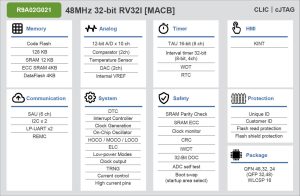
There is 128kbyte of instruction flash, 4kbyte of data flash and 16kbyte of ram, plus a 12bit ADC, an 8bit DAC and serial communication including UART, SPI and I2C.
The company’s ‘SAU’ peripheral is also included to implement up to six simplified SPI interfaces, up to three more UARTs or up to six simplified I2C interfaces, depending on package size.
To tempt potential adopters from more familiar architectures, Renesas has lined up plenty of support from the start, with the its e2 studio Eclipse-based IDE (integrated development environment) providing a code configurator and the LLVM compiler.
“Complete development environments are also available from IAR with its Embedded Workbench IDE and I-jet debug probe, and Segger with the Embedded Studio IDE, J-Link debug probes and Flasher production programmers,” it said.
FPB-R9A02G021 is the hardware development board (right).
No less than 18 application notes have been prepared to go along with the product launch, covering state-switching, boot firmware and many of the peripherals.
Jayce
/include/upload/kind/image/20240327/20240327174207_5562.jpg
Resasas has put its in-house developed 32bit RISC-V core into a few-pin general-purpose MCU series, following earlier RISC-V projects with Anders and SiFive.
Announced last November, the core implementation can accommodate various
2024/3/27 17:43:57
2024/3/27 17:43:57
22
0
555
6
Financing the Chip Business
U.S. President Biden announced on Wednesday an agreement to provide Intel with $8.5 billion in direct funding and $11 billion in loans under the CHIPS and Science Act, reports Semiconductor Intelligence (SI). Intel will use the funding for wafer fabs in Arizona, Ohio, New Mexico, and Oregon.
As SI reported in its December 2023 newsletter, the CHIPS Act provides a total of $52.7 billion for the U.S. semiconductor industry, including $39 billion in manufacturing incentives.
Prior to the Intel grant, the CHIPS Act had announced grants totaling $1.7 billion to GlobalFoundries, Microchip Technology, and BAE Systems, according to the Semiconductor Industry Association (SIA).
Grants under the CHIPS Act have been slow in coming, with the first grants announced over a year after passage. Some major fab projects in the U.S. have been delayed due the slow disbursement. TSMC also cited difficulties in finding qualified construction personnel. Intel said the delay was also due to slowing sales.

Other nations have also allocated funds to promote semiconductor production. The European Union in September 2023 passed the European Chips Act which provides for 43 billion euro (US$47 billion) of public and private investment in the semiconductor industry.
In November 2023, Japan allocated 2 trillion yen (US$13 billion) for semiconductor manufacturing.
Taiwan in January 2024 enacted a law to provide tax breaks for semiconductor companies.
South Korea in March 2023 passed a bill to provide tax breaks to strategic technologies including semiconductors.
China is expected to create a $40 billion fund backed by the government to subsidize its semiconductor industry.
What is the outlook for capital expenditures (CapEx) in the semiconductor industry this year?
The CHIPS Act was designed to spur CapEx, but much of the effect will not occur until after 2024.
After a disappointing 8.2% decline in the semiconductor market last year, many companies are cautious about CapEx in 2024.
SI estimates total semiconductor CapEx in 2023 was $169 billion, down 7% from 2022. Our forecast is a 2% decline in CapEx in 2024.
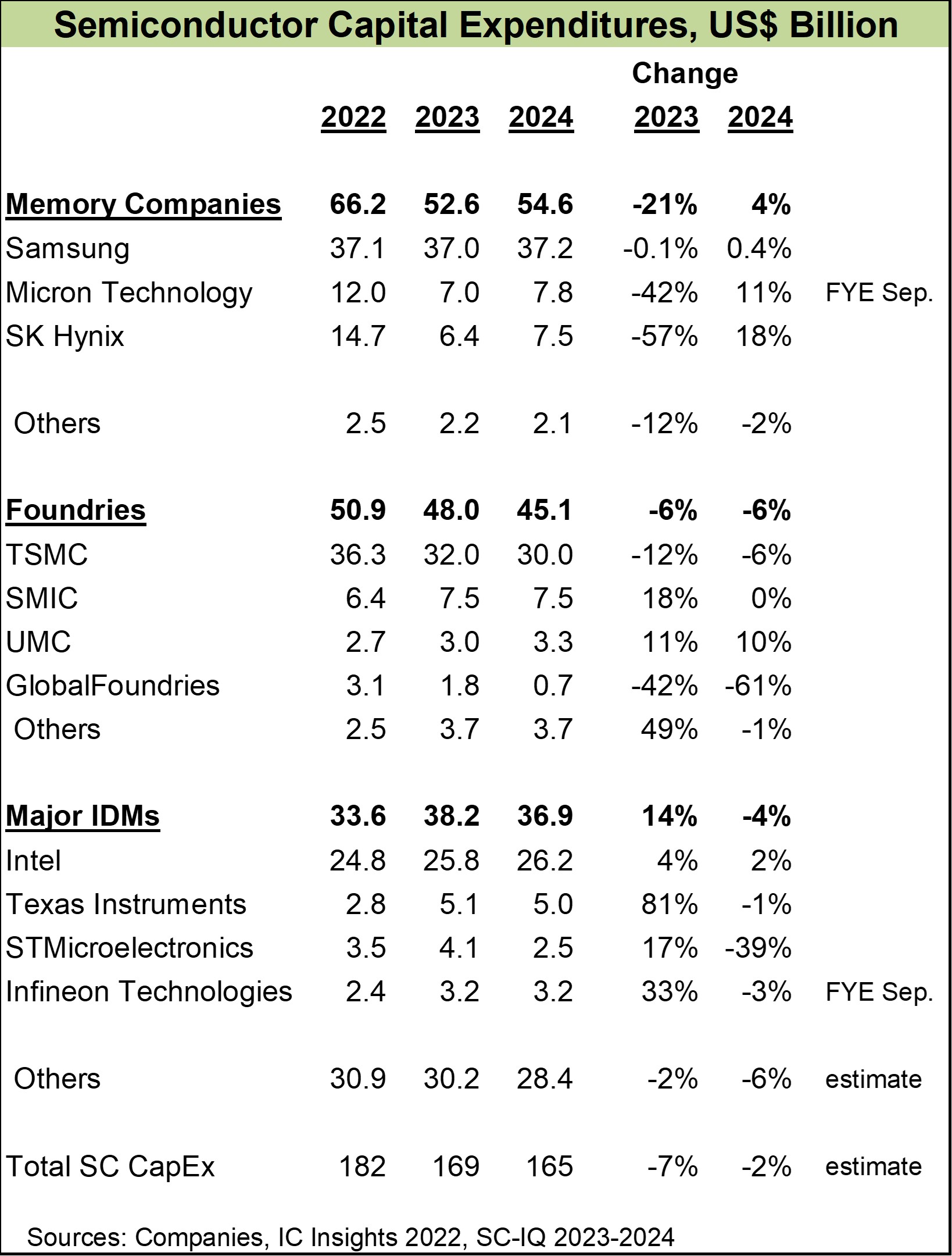
The major memory companies are generally increasing CapEx in 2024 as the memory market recovers and new applications such as AI are expected to increase demand.
Samsung plans relatively flat spending in 2024 at $37 billion but did not cut CapEx in 2023.
Micron Technology and SK Hynix cut back CapEx significantly in 2023 and are planning double-digit increases in 2024.
The largest foundry, TSMC, plans to spend about $28 billion to $32 billion in 2024, with the midrange of $30 billion down 6% from 2023.
SMIC is planning flat CapEx while UMC plans a 10% increase.
GlobalFoundries expects a 61% cut in 2024 CapEx but will ramp up spending in the next few years as it builds a new fab in Malta, New York.
Among IDMs, Intel plans to increase CapEx in 2024 by 2% to $26.2 billion. Intel will increase capacity for foundry customers as well as for internal products.
Texas Instruments’ CapEx is roughly flat. TI plans to spend about $5 billion a year through 2026, primarily for its new fabs in Sherman, Texas.
STMicroelectronics will cut CapEx 39% while Infineon Technologies will cut by 3%.
The three largest spenders – Samsung, TSMC and Intel – will account for 57% of semiconductor industry CapEx in 2024.
What is the appropriate level of CapEx relative to the semiconductor market?
The semiconductor market is notoriously volatile. Over the last 40 years, annual change has ranged from 46% growth in 1984 to a 32% decline in 2001. Although the industry has become somewhat less volatile as it has matured, in the last five years it has shown a 26% increase in 2021 and a 12% decrease in 2019.
Semiconductor companies need to plan their capacity several years out. It takes about two years to build a new wafer fab and additional time for planning and financing. As a result,the ratio of semiconductor CapEx to the semiconductor market varies greatly, as shown below.

The semiconductor CapEx to market size ratio has varied from a high of 34% to a low of 12%. The five-year average ratio ranges between 28% and 18%. Over the total period of 1980 to 2023, the total CapEx was 23% of the semiconductor market. Despite the volatility, the long-term trend of the ratio has been fairly consistent.
Based on expected strong market growth and a drop in CapEx, SI expects the ratio to drop from 32% in 2023 to 27% in 2024.
Most forecasts for semiconductor market growth in 2024 are in the range of 13% to 20%. SI’s forecast is 18%.
Jayce
/include/upload/kind/image/20240323/20240323144522_7523.jpeg
U.S. President Biden announced on Wednesday an agreement to provide Intel with $8.5 billion in direct funding and $11 billion in loans under the CHIPS and Science Act, reports Semiconductor Intelligence (SI). Intel will use the funding for wafer fa
2024/3/23 14:47:37
2024/3/23 14:47:37
20
0
554
6
HBM to be 14% of DRAM Industry This Year
By the end of 2024, the DRAM industry is expected to have allocated approximately 250K/m (14%) of total capacity to producing HBM TSV, with an estimated annual supply bit growth of around 260%, says TrendForce svp Avril Wu.
HBM’s revenue share within the DRAM industry—around 8.4% in 2023—is projected to increase to 20.1% by the end of 2024.

The die size of HBM is generally 35–45% larger than DDR5 of the same process and capacity (for example, 24Gb compared to 24Gb).
The yield rate (including TSV packaging) for HBM is approximately 20–30% lower than that of DDR5, and the production cycle (including TSV) is 1.5 to 2 months longer than DDR5.
HBM has a longer production cycle than DDR5 – over two quarters from wafer start to final packaging.
Samsung’s total HBM capacity is expected to reach around 130K (including TSV) by year-end; Hynix’s capacity is around 120K.

Jayce
/include/upload/kind/image/20240320/20240320175145_2512.jpeg
By the end of 2024, the DRAM industry is expected to have allocated approximately 250K/m (14%) of total capacity to producing HBM TSV, with an estimated annual supply bit growth of around 260%, says TrendForce svp Avril Wu.
HBM’s re
2024/3/20 17:53:24
2024/3/20 17:53:24
23
0
553
6
Magnetic sensors market has 4% CAGR 2023-29 to reach $3.7bn
The magnetic sensor market is expected to reach $3.7 billion in 2029, with an estimated 4% CAGR from 2023 to 2029, says Yole Developpement.
RECOMMENDED ARTICLESHBM to be 14% of DRAM industry this yearUS strategy for microelectronics research publishedTelecom equipment sales fell 5% in 2023, set to fall again in 2024Smartphones bounce backAllegro Microsystems leads in revenue, TDK leads in volume.
A $1 billion investment surge from players like Allegro, TDK, Bosch, LEM etc. is leveraging the technology’s sensitivity, bandwidth, and low power consumption to sense position and current.
Magnetic sensors find widespread application across automotive, mobility, industrial, energy, medical, and consumer sectors. Their versatility has led to their adoption in various fields, propelling the market to a value of $2.9 billion in 2023.
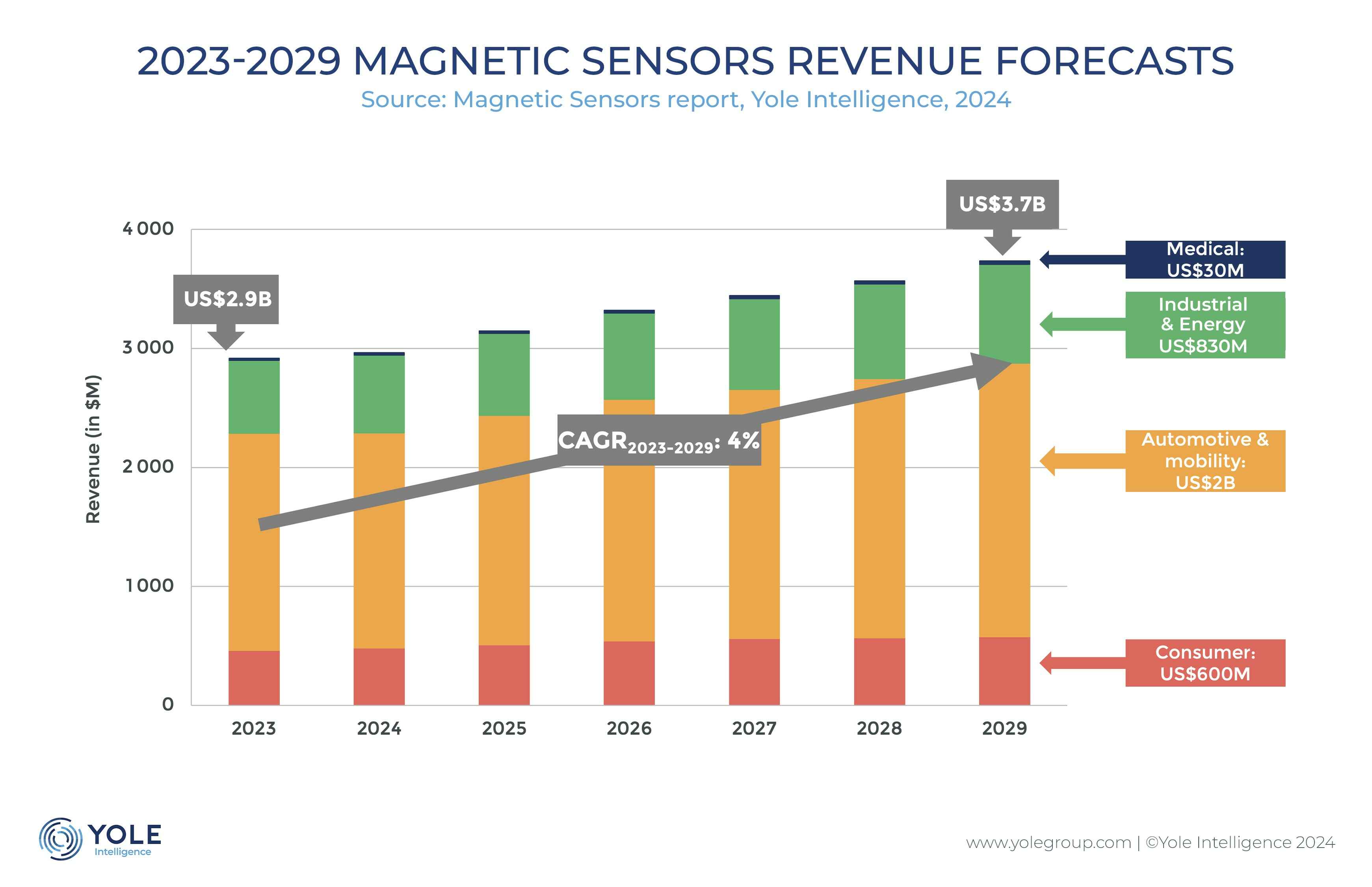

“The automotive & mobility segment significantly dominates the market with sales of more than $2 billion by 2029,” says Yole’s Pierre Delbos, “this segment is driven by important shifts such as vehicle electrification and sensor integration. Conversely, consumer applications lead in terms of volume. At Yole Group, we anticipate a nearly $600 million market by 2029, also growing at a 4% CAGR between 2023 and 2029”.
The evolving landscape of magnetic sensor applications extends to the industrial & energy and medical sectors. By 2029, these sectors are expected to reach $830 million and $30 million, respectively.
Factors such as the proliferation of DC-charging stations with integrated current sensors due to vehicle electrification, the demand for position sensors, switches, and latches driven by Industry 4.0, and the potential implementation of predictive maintenance using current sensors contribute to the promising outlook in these sectors.
Jayce
/include/upload/kind/image/20240319/20240319175909_2918.jpg
The magnetic sensor market is expected to reach $3.7 billion in 2029, with an estimated 4% CAGR from 2023 to 2029, says Yole Developpement.
RECOMMENDED ARTICLESHBM to be 14% of DRAM industry this yearUS strategy for microelectronics
2024/3/19 18:00:31
2024/3/19 18:00:31
24
0
551
6
Q4 Foundry Revenues up 7.9%
Q4 foundry revenues rose 7.9% to $30.49 billion, says TrendForce, primarily driven by demand for smartphone components, such as mid and low-end smartphone APs and peripheral PMICs.
The launch season for Apple’s latest devices also significantly contributed, fueling shipments for the A17 chipset and associated peripheral ICs, including OLED DDIs, CIS, and PMICs. TSMC’s premium 3nm process notably enhanced its revenue contribution, pushing its global market share past the 60% threshold this quarter.

Last year the foundry market suffered a 13.6% fall witnrevenue reaching $111.54 billion.
2024 promises better, says TendForce, with AI-driven demand expected to boost annual revenue by 12% to $125.24 billion.
In Q4, top 5 foundries expanded market share to 88.8% with TSMC taking 60%.
TSMC’s wafer shipments rose in 4Q23 thanks to demand from smartphones, notebooks, and AI-related HPC and its revenue jumped 14% over the quarter to $19.66 billion.
Revenue shares from processes 7nm and below climbed from 59% in Q3 to 67% in Q4, underscoring TSMC’s dependency on cutting-edge technologies. With the progressive ramp-up of 3nm production, the share of revenue from advanced processes is expected to surpass 70%.
Samsung also received orders for various new smartphone components, predominantly in mature processes above 28nm. Meanwhile, demand for advanced process main chips and modems saw steadier demand due to early procurement by clients, leading to a slight 1.9% QoQ drop in Samsung’s foundry revenue to $3.62 billion.
GlobalFoundries saw a modest 5% revenue growth in the automotive segment, primarily attributed to a surge in LTAs signed by numerous automotive clients and slight optimizations in ASP. However, shipments in key application areas such as smart mobile devices, communication, and home/industrial IoT witnessed declines, resulting in overall revenue reaching approximately $1.85 billion in Q4.
UMC experienced occasional spikes in orders from the smartphone and PC sectors, but a weak global economy, conservative wafer start decisions by clients, and inventory adjustments in the automotive sector led to a downturn in wafer shipments, resulting in a 4.1% decrease in Q4 revenue to about $1.73 billion.
SMIC enjoyed a 3.6% quarterly increase in revenue to roughly $1.68 billion, mainly due to urgent orders related to smartphones and notebooks/PCs, while shipments for network communications, general consumer electronics, and automotive/industrial control sectors saw declines.
Three significant changes occurred in rankings were, PSMC moved up to eighth place, benefiting from the recovery in specialty DRAM wafer outputs and urgent orders for smartphone components, Nexchip reentered the top ten and secured the ninth spot, thanks to urgent TDDI orders and high-volume shipments of new CIS products, and VIS dropped to tenth place due to a slowdown in TV-related orders and inventory adjustments by automotive and industrial control customers.
IFS, which entered the top ten for the first time in 3Q23, was pushed out of the rankings by PSMC and Nexchip due to factors such as the transition between new and old generations of CPUs and lackluster inventory momentum at Intel.
Other companies, such as HuaHong Group and Tower, saw their revenue decrease by 14.2% and 1.7%, respectively. The minor decline in revenue for Tower is attributed to its long-term focus on niche markets like RFFEM, automotive, and industrial control, which shielded it from the impacts felt by companies primarily in the consumer electronics sector. However, as automotive and industrial control clients also began adjusting their inventories, the utilization rate of Tower further decreased in the fourth quarter
Jayce
/include/upload/kind/image/20240314/20240314183135_2542.png
Q4 foundry revenues rose 7.9% to $30.49 billion, says TrendForce, primarily driven by demand for smartphone components, such as mid and low-end smartphone APs and peripheral PMICs.
The launch season for Apple’s latest devices also
2024/3/14 18:33:21
2024/3/14 18:33:21
28
0
550
6
Resurgence in Enterprise SSD Market
In Q3 2023 enterprise SSD suppliers cut production leading to a 15% Q4 surge in contract SSD prices, says TrendForce
This produced a 47.6% QoQ increase for Q4 enterprise SSD industry revenues which hit $23.1 billion.
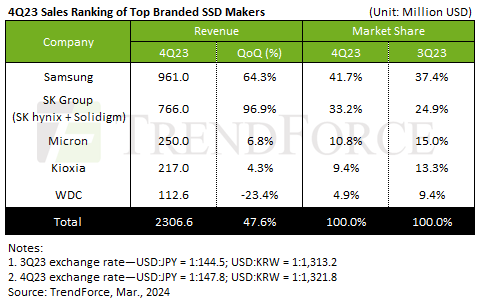
Contract prices are now expected to increase by over 25% delivering 20% revenue growth in Q1.
SK Group recorded the highest growth rate in the enterprise SSD segment for 4Q23, with revenues hitting $766 million —a 96.9% jump.
Samsung secured the second-highest growth at 64.3%, reaching $961 million.
Micron saw a 6.8% rise to $250 million.
Kioxia had a 4.3% revenue increase in 4Q23 to $217 million.
Western Digital’s revenues fell to $113 million — a 23.4% decline.
Jayce
/include/upload/kind/image/20240312/20240312174202_6293.png
In Q3 2023 enterprise SSD suppliers cut production leading to a 15% Q4 surge in contract SSD prices, says TrendForce
This produced a 47.6% QoQ increase for Q4 enterprise SSD industry revenues which hit $23.1 billion.
2024/3/12 17:42:43
2024/3/12 17:42:43
29
0
548
6
Samsung sampling solid state batteries
Samsung says it has begun sampling solid state batteries to car manufacturers and will begin mass production of the batteries for EVs and other applications in 2027.
Last year, the company set up a pilot line in Suwon and is using it to,refine the product and improve yields
The company says that its solid-state batteries will have an energy density of 900 watt-hours per litre which is 40% better than from its lithium-ion batteries.
As well as high energy density solid-state batteries have short charging times of around ten minutes and are lighter and safer than lithium-ion batteries.
Hyundai is also targeting 2027 for mass-production of solid state batteries and Toyota says it will start selling cars with solid state batteries in 2027-8.
Jayce
/include/upload/kind/image/20240308/20240308181129_5144.jpeg
Samsung says it has begun sampling solid state batteries to car manufacturers and will begin mass production of the batteries for EVs and other applications in 2027.
Last year, the company set up a pilot line in Suwon and is us
2024/3/8 18:11:52
2024/3/8 18:11:52
42
0
546
6
Q4 24.5% q-o-q leap for NAND
Q4 saw a 24.5% QoQ increase in NAND revenue reaching $11.49 billion, reports TrendForce.
Q1 is forecast to see a further 20% increase in revenues and a 25% increase in contract prices.
Samsung’s bit shipment volume increased by 35% QoQ, coupled with a 12% increase in ASP, boosting its revenue to $4.2 billion—a 44.8% QoQ growth.

Hynix had a 33.1% revenue jump to $2.48 billion.
Western Digital had 2% dip in shipment volume but a 10% increase in ASP, leading to a 7% revenue increase to $1.67 billion.
Kioxia had an 8% revenue increase to $1.44 billion in Q4.
Micron reduced its supply significantly to improve profitability, leading to a more than 10% QoQ decrease in bit shipments and a 1.1% decrease in revenue to $1.14 billion.
Jayce
/include/upload/kind/image/20240307/20240307171719_4992.png
Q4 saw a 24.5% QoQ increase in NAND revenue reaching $11.49 billion, reports TrendForce.
Q1 is forecast to see a further 20% increase in revenues and a 25% increase in contract prices.
Samsung’s bit shipment vol
2024/3/7 17:18:00
2024/3/7 17:18:00
35
0
545
6
Government approves Vishay takeover of Newport Wafer Fab
Government consent for the acquisition of Newport Wafer Fab by Vishay has finally been given by Deputy Prime Minister and Secretary of State in the Cabinet Office Oliver Dowden.
The site has now been renamed Newport Vishay.
Vishay’s $177 million offer for the fab was accepted last November but the government has been dragging its feet for four months over giving a final consent order.
The old Inmos fab, which opened in 1980, had been acquired by Nexperia, which is controlled by a China government-controlled fund called Wingtech. This was seen as a security risk.
Vishay says it will expand operations at the site, including R&D for compound semiconductor development.
Jayce
/include/upload/kind/image/20240305/20240305173333_0885.jpg
Government consent for the acquisition of Newport Wafer Fab by Vishay has finally been given by Deputy Prime Minister and Secretary of State in the Cabinet Office Oliver Dowden.
The site has now been renamed Newport Vishay.
2024/3/5 17:33:40
2024/3/5 17:33:40
32
0
543
6
Q1 lead times mostly stable, says Sourcengine
Sourcengine has published its Q1 lead time report.
Volatile memory is at 11-17 weeks and going up and NV memory is at 13-19 weeks and is mostly going up or, if not, is stable.
Storage is at 10-15 weeks and mostly going up.
Discretes are at 20-47 weeks and stable
Standard logic and linear are at 7-20 weeks and mostly stable
Advanced analogue is at 23-41 weeks and mostly stable
Embedded processors are 15-48 weeks and mostly stable
Programmable logic is at 20-25 weeks and stable
Here is the full report
Jayce
/include/upload/kind/image/20240301/20240301212338_0118.jpg
Sourcengine has published its Q1 lead time report.
Volatile memory is at 11-17 weeks and going up and NV memory is at 13-19 weeks and is mostly going up or, if not, is stable.
Storage is at 10-15 weeks and mostly going
2024/3/1 21:25:11
2024/3/1 21:25:11
35
0
542
6
This Is the Year of Smartphone Recovery
Over the past seven years, the smartphone market has contracted six times on an annual basis, however, 2024 is set to be the year when the market returns to growth, says IDC.
2024 smartphone shipments are expected to reach 1.2 billion units – up 2.8% y-o-y followed by low single-digit growth till 2028.

While overall volumes are still below pre-pandemic levels, IDC believes the market has corrected itself and is moving on from the bottom.
Foldable smartphone shipments are expected to grow 37% and shipments will reach 25 million in 2024.
AI has become part of the smartphone discussion, sparking interest in AI experiences on a handheld device.
Jayce
/include/upload/kind/image/20240228/20240228183229_7550.png
Over the past seven years, the smartphone market has contracted six times on an annual basis, however, 2024 is set to be the year when the market returns to growth, says IDC.
2024 smartphone shipments are expected to reach 1.2 billio
2024/2/28 18:33:31
2024/2/28 18:33:31
54
0
540
6
H2 2023 high end router market down 8%
The High End Router market declined 8% y-o-y in H2 2023, following an abrupt surge in equipment deliveries in the first half of the year, says Dell’Oro Group.
“The disruptions caused by component shortages and supply chain bottlenecks that started over two years ago are still occurring,” says Dell’Oro vp P Jimmy Yu, “once supply freed up, router manufacturers were able to fulfill backlogged orders at a faster pace, driving High End Router revenue up 12 percent year-over-year in the first half of 2023. However, this turned into extra inventory at customer sites, causing them to rationalize future new orders. We believe it may be another two quarters before inventory levels return to normal levels at these service providers,” added Yu.
The High End Router market reached nearly $13 billion in 2023. The top three vendors by revenue share were Cisco, Huawei, and Nokia. The only vendors to gain more than one percentage point of market share were Cisco and Huawei.
Core Router revenue grew 14 percent in 2023. The top three vendors by revenue share were Cisco, Huawei, and Juniper. Cisco gained nearly 6 percentage points of market share and was the only vendor to gain market share in the year.
Edge Router and Aggregation Switch revenue was unchanged from the year ago period.
Jayce
/include/upload/kind/image/20240227/20240227180039_0877.png
The High End Router market declined 8% y-o-y in H2 2023, following an abrupt surge in equipment deliveries in the first half of the year, says Dell’Oro Group.
“The disruptions caused by component shortages and supply chain bottlene
2024/2/27 18:01:17
2024/2/27 18:01:17
35
0
539
6
Power module revenue on a 12.1% CAGR 2023-29
Power module revenue will grow from $8 billion in 2023 to $16 billion by 2029 representing a 12.1% CAGR between 2023 and 2029, according to Yole Group.
The power module packaging costs fully depend on the packaging materials, such as die-attach and ceramic substrate materials, and the package size.
In 2023, it represented a $2.3 billion market in 2023, with the cost of materials for power module packaging representing about 30 % of the total power module cost.
Materials cost will have an 11% CAGR between 2023 and 2029, and the market should reach $4.3 billion by 2029.
The largest power module packaging material segment is the baseplate, which will be worth $1,070 million by 2029, against $651 million in 2023. Its CAGR will be 9% between 2023 and 2029, closely followed by the ceramic substrate market segment.
“Today, continuous improvements in module materials and packaging design are needed to take advantage of the benefits of SiC technology,” says Yole’s Shalu Agarwal, “however , the development is simultaneously focused on reducing the costs of power modules through “good enough” performance and reliability.”
“The power module packaging supply chain is continually being reshaped, with new companies entering power module manufacturing,” adds Agarwalm “these companies are expanding their product portfolios and forming new partnerships and M&As. In this dynamic context, the growth of Asian packaging material players puts intense cost pressure on European players.”
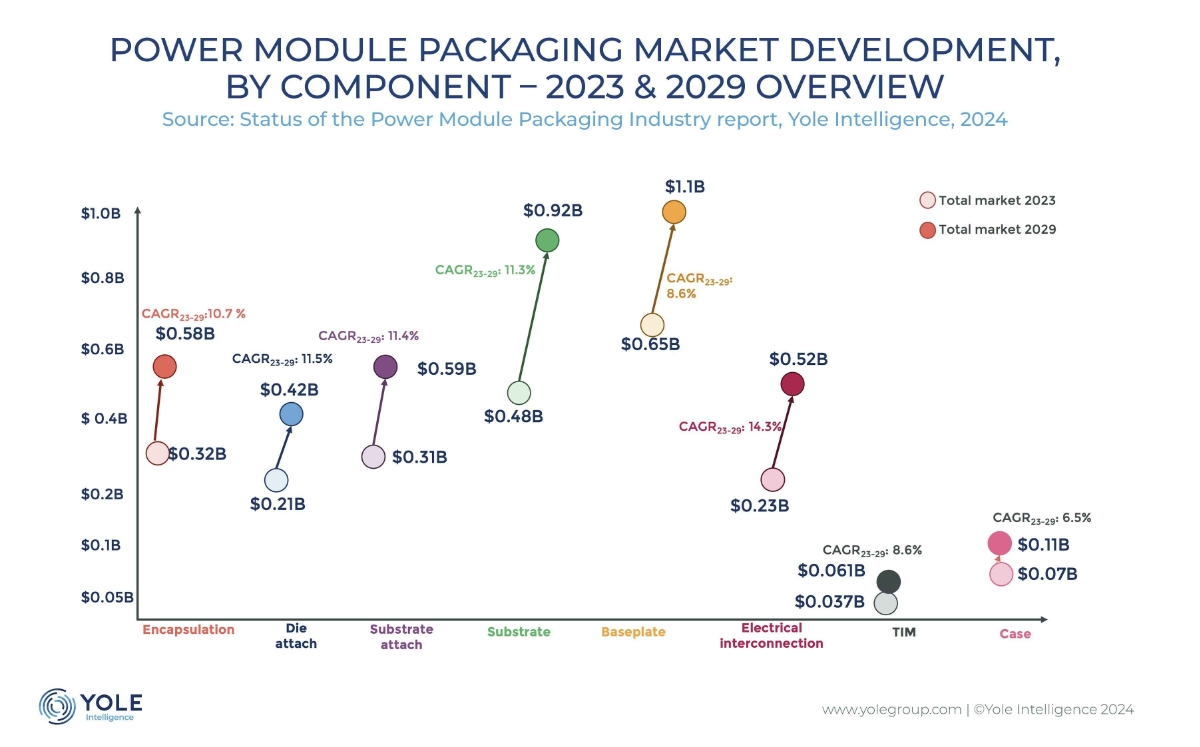
The leading power module suppliers are in Europe and Japan, with Infineon Technologies, Semikron Danfoss, Fuji Electric, and Mitsubishi Electric.
Meanwhile, the leading module packaging material suppliers are primarily located in the US, where Yole Group has identified Rogers Corporation, MacDermid Alpha, 3M, Dow, and Indium Corporation, in Europe with Heraeus, Henkel, for example, and in Japan, with FTH (formally known as Ferrotec), Proterial, Kyocera, Dowa, Denka, Tanaka, Resonac, and NGK Insulators.
The geographic expansion of packaging material providers is increasing. Japanese players have a powerful presence in materials but sometimes need help accessing other regions. Therefore, they are trying to grow their presence in China, Europe, and the United States and are investing in developing their businesses within these regions.
For example, Japan’s NGK Insulators is planning to manufacture ceramic substrates in Poland. Similarly, European and U.S. players, such as Heraeus, Henkel, MacDermid Alpha, and Rogers Corporation, are focusing on Asia, mainly China.
At the same time, several companies along the supply chain have either moved or are planning to transfer their production to countries with a lower cost of production to reduce costs, such as Vietnam, Hungary, Malaysia, and Romania.
This leads to more robust competition, increased price pressure, and increasing motivation for partnerships and M&As.
Jayce
/include/upload/kind/image/20240226/20240226181038_2640.png
Power module revenue will grow from $8 billion in 2023 to $16 billion by 2029 representing a 12.1% CAGR between 2023 and 2029, according to Yole Group.
The power module packaging costs fully depend on the packaging materials, s
2024/2/26 18:11:53
2024/2/26 18:11:53
36
0
537
6
Nvidia Astonishes
Nvidia's Q4 proft was $12.3 billion.
It's full year revenue was up 126% y-o-y at $60.9 billion.
Q4 datacentre revenue was up 409% y-o-y at $18.4 billion.
Full year datacentre revenue was up 27% y-o-y at $47.5 billion.
Q1 revenues are forecast to be up 233% y-o-y at $24 billion plus or minus 2%.
At last night’s close, Nvidia’s market cap was $1.7 trillion.
Although its customers are scrabbling to find proprietary or merchant market alternatives, so far Nvidia looks as if it can out-run them on the tech with better chips, while offering them ASIC solutions tailored to their particular needs.
Jayce
/include/upload/kind/image/20240222/20240222175423_7212.jpg
Nvidia’s Q4 revenue was up 265% y-o-y at $22.1 billion.
2024/2/22 17:55:06
2024/2/22 17:55:06
35
0
534
6
Smart NICs to Be $5bn Market by 2028
The Smart NIC market will top $5 billion by 2028, says Dell’Oro.
Accelerated computing will continue to push the boundaries in server connectivity, demanding port speeds of 400 Gbps and higher speeds.
“The Ethernet Adapter market is poised for a compound annual growth rate of 13 percent, fueled by the increasing adoption of higher-speed ports and Smart NICs within data center infrastructures,” says Dell’Oro’s Baron Fung, “the hyperscale cloud service providers will drive rapid development in server connectivity, including increasing the adoption of customized Smart NICs and DPUs, and server port speeds reaching 800 Gbps in the next several years for accelerated computing. The rest of the market, which lags the hyperscale market in the deployment of these technologies, will still be an attractive market for the open vendors offering off the shelf solutions.”
Total Ethernet Controller and Adapter market, not counting the AI back-end network market, is forecast to exceed $8 billion by 2028.
The majority of the accelerated servers will have server access speeds of 400 Gbps and higher by 2028.
Smart NICs are expected to cannibalise Standard NICs during the forecast period.
Jayce
/include/upload/kind/image/20240208/20240208144929_7137.jpg
The Smart NIC market will top $5 billion by 2028, says Dell’Oro.
Accelerated computing will continue to push the boundaries in server connectivity, demanding port speeds of 400 Gbps and higher speeds.
“The Ethe
2024/2/8 14:49:36
2024/2/8 14:49:36
69
0
533
6
Skills Report on Chip Industry
The METIS (MicroElectronics Training, Industry and Skills) study has concluded and finds that the Top Five Critical Job Profiles in the microelectronics sector in 2023 are:
-
Data specialist
-
Software engineer
-
Design engineer
-
Process engineer
-
Maintenance technician
The Top Emerging Skills in 2023 are:
-
Machine Learning and Artificial Intelligence
-
Data Analysis
-
Systems Design and System Architecture (SoC, SiP, SoP, complex ASIC)
-
Analog and Mixed-Signal Design
-
Verification
The report considers the current skills gap in the microelectronics industry and provides a list of policy recommendations including:
Increase the involvement of the microelectronics industry in the education process.
Develop communications campaigns to improve the sector’s image.
Develop clusters and networks to encourage greater dialog between industry and education providers.
Read the full report here.
Jayce
/include/upload/kind/image/20240207/20240207215559_3608.jpg
The METIS (MicroElectronics Training, Industry and Skills) study has concluded and finds that the Top Five Critical Job Profiles in the microelectronics sector in 2023 are:
Data specialist
Software engineer
2024/2/7 21:56:15
2024/2/7 21:56:15
44
0
532
6
SIA Forecasts 13% Growth This Year
Semiconductor sales of $526.8 billion last year were 8.2% down on 2022’s record-breaking total of $574.1 billion, says the SIA, which forecast a sales rise of 13% this year to almost $600 billion.
Q4 sales of $146 billion were up 11.6% y-o-y and 8.4% m-o-m..
“Global semiconductor sales were sluggish early in 2023 but rebounded strongly during the second half of the year, and double-digit market growth is projected for 2024,” says SIA CEO John Neuffer, “with chips playing a larger and more important role in countless products the world depends on, the long-term outlook for the semiconductor market is extremely strong. Advancing government policies that invest in R&D, strengthen the semiconductor workforce, and reduce barriers to trade will help the industry continue to grow and innovate for many years to come.”
Europe was the only regional market that experienced annual growth in 2023, with sales there increasing 4.0%. Annual sales into all other regional markets decreased in 2023: Japan (-3.1%), the Americas (-5.2%), Asia-Pacific/All Other (-10.1%), and China (-14.0%). Sales for the month of December 2023 increased compared to November 2023 in China (4.7%), the Americas (1.8%), and Asia Pacific/All Other (0.3%), but decreased in Japan (-2.4%) and Europe (-3.9%).
Several semiconductor product segments stood out in 2023. Sales of logic products totaled $178.5 billion in 2023, making it the largest product category by sales. Memory products were second in terms of sales, totaling $92.3 billion. Microcontroller units (MCUs) grew by 11.4% to a total of $27.9 billion. And sales of automotive ICs grew by 23.7% year-over-year to a record total of $42.2 billion.


Jayce
/include/upload/kind/image/20240206/20240206173608_7923.png
Semiconductor sales of $526.8 billion last year were 8.2% down on 2022’s record-breaking total of $574.1 billion, says the SIA, which forecast a sales rise of 13% this year to almost $600 billion.
Q4 sales of $146
2024/2/6 17:36:53
2024/2/6 17:36:53
60
0
530
6
Robot Vehicle Investment Reaches $42.5 Billion
Over the past nine years, the global investment in robotaxis, robot shuttles, and robot trucks has reached nearly $42.5 billion, says Yole Developpement, with the robotic vehicle processor market expected to reach $1 billion in 2034, with an estimated 48% CAGR from 2023 to 2034.
The expanding robotaxi market will see a division between processors tailored for automotive use and those specifically designed for the purpose.
Robotaxis and robot trucks are dominated by the US and China, with Europe trailing behind in robot shuttles.
Essential for achieving autonomy, robotic vehicle processors demand significant computing power for instantaneous decision-making.
Initially, server/PC-grade processors were employed due to their robust computing capabilities.
However, with advancements in the automotive processor market, those tailored for ADAS /AD functions have emerged as more cost-effective and energy-efficient alternatives for robotic vehicles.


“Nvidia, an early player, introduced high-performance processors with the Parker architecture in 2016, now widely utilised in numerous robotic vehicles,” says Yole’s Adrien Sanchez, “however, competition has intensified with the development of ADAS/AD processors, gaining momentum from companies like Mobileye, Qualcomm, and Huawei. Notably, startups such as Horizon Robotic and Black Sesame provide potential solutions, particularly for Chinese companies aiming for secure domestic supply chains.”
On the architectural front, diverse solutions are emerging. Mobileye, for instance, has pioneered a scalable processor family, departing from a fully centralized architecture based on a single processor.
This approach not only reduces development costs but also provides a flexible solution tailored to the specific needs of its customers.
Simultaneously, a prevailing trend among leaders in the robotic industry involves the in-house development of custom processors to precisely address specific requirements.
“The global landscape for robotic vehicles is characterized by three key regions: the United States, China, and Europe,” says Yole’s Hugo Antoine, “in the U.S, active testing of autonomous vehicles is underway, with robotaxi services already available in a few cities, and rapid progress in the deployment of robot trucks connecting the East Coast to the West Coast,”
China has asserted itself as a frontrunner in autonomous technology, with Baidu-Apollo leading in robotaxi and shuttle services, closely followed by dynamic companies like WeRide and Pony.ai.
Europe, too, is actively involved, particularly in robot shuttle companies and testing initiatives.
The Middle East, notably the UAE and KSA, is actively participating in robotic mobility projects through strategic partnerships with European, Chinese, and American companies.
In the autonomous vehicle industry, companies focusing on robotic vehicles initially prioritise their core segments to manage costs and enhance scalability.
Jayce
/include/upload/kind/image/20240202/20240202171041_2638.jpg
Over the past nine years, the global investment in robotaxis, robot shuttles, and robot trucks has reached nearly $42.5 billion, says Yole Developpement, with the robotic vehicle processor market expected to reach $1 billion in 2034, with an estima
2024/2/2 17:12:46
2024/2/2 17:12:46
43
0
529
6
December Jump for Korean Semi Shipments
In December, Korea’s semiconductor factory shipments rose 113.7% y-o-y – the biggest jump in a month since 1997, according to Statistics Korea, the national statistics office.
Inventories rose by 11.6% – the smallest rise since the collapse in demand in late 2022.
Production rose 53.3% y-o-y which was the biggest monthly rise since mid-2016.
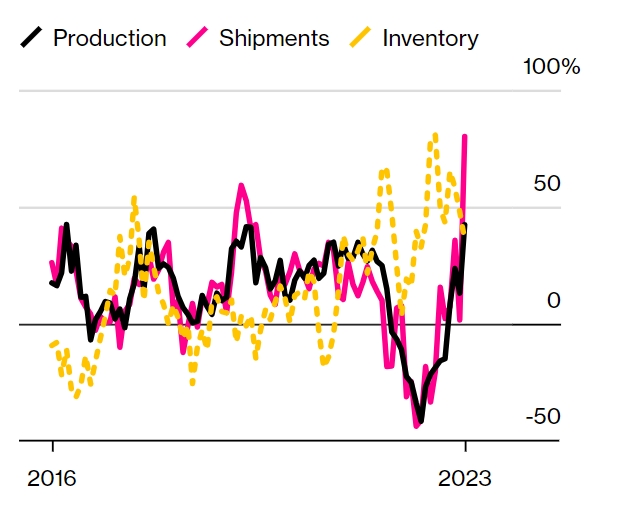
Korea supplies two-thirds of global memory production.
Jayce
/include/upload/kind/image/20240201/20240201171745_7339.png
In December, Korea’s semiconductor factory shipments rose 113.7% y-o-y – the biggest jump in a month since 1997, according to Statistics Korea, the national statistics office.
Inventories rose by 11.6% – the smallest rise since
2024/2/1 17:18:39
2024/2/1 17:18:39
45
0
528
6
Compound Semi Substrate Market Growing at 17% CAGR 2023-29
The compound semiconductor substrate market is expected to reach $3.3 billion in 2029, with a 17% CAGR between 2023 and 2029, says Yole Developpement.
Substrate players consistently craft new strategies to diversify their product portfolios and enhance their market presence.
Compound semiconductor technologies showcase diverse advancements across sectors:leg. SiC , GaN , InP and. have emerged as a transformative influence across various industries.
SiC’s dominance in the automotive sector, especially in the domain of 800V EVs , drives a billion-dollar market, while GaN power electronics is expanding its presence in both the consumer and automotive fields.
Yole expects a billion-unit opportunity in smartphone OVP (Over Voltage Protection) . In anticipation of a resurgence, RF GaAs aligns itself with 5G and automotive connectivity, while RF GaN establishes its presence in defense, telecommunications, and space industries, targeting high-power applications.
Within the realm of photonics, InP and GaAs take the lead, with InP experiencing a resurgence fueled by AI applications, while GaAs photonics sees more modest growth influenced by various market dynamics. Although MicroLEDs show potential, their widespread adoption is gradual,
“The CS industry is at the corner to transition to larger diameter substrates. In the Photonics sector,” saysYole’s Ali Jaffal, “AI is driving the demand of high-data-rate lasers, which could accelerate the transition to 6” InP substrates.
On the other side of the coin, GaAs explores 8” manufacturing for microLED, which is competing with OLED, facing yield and efficiency challenges, questioning its success but gaining momentum with substantial investments.”
Suppliers of GaAs and InP substrates, including Freiberger, Sumitomo Electric, and AXT, play a central role in the transition to larger diameter substrates. Photonics is part of this story, and the Power and RF markets further complement this narrative.

Wolfspeed is leading the change to supply SiC substrates for power electronics applications. It has recently transitioned to the larger 8” wafer fabs and is expanding its material capacity in line with its strategic vision.
Coherent, another leading player, focuses on photonic devices and dominates the SiC substrate market for both power and RF applications. It has made a number of strategic alliances, for example, with SEDI in RF GaN, to reinforce its position and has started supplying power SiC devices. Following these actions, it covers the whole value chain from substrates to advanced devices.
The landscape is continuously evolving, with multiple innovations on many fronts and strategic partnerships.
“Compound semiconductor technologies are advancing across sectors, notably in the booming SiC industry “ says Yole’s Taha Ayari “while 6” wafers are still standard, Wolfspeed’s $1.2 billion investment in MHV fab is pioneering the transition to 8″ wafer size. Other efforts focus on improving SiC wafer yield and supply, with innovations like engineered substrates from Soitec and Sumitomo Mining. Power GaN sees a shift to 8-inch GaN-on-Si, driven by expansion at Innoscience, STMicroelectronics, and Infineon Technologies”.
“RF GaN-on-Si is benefiting from synergies with the relatively more mature Power GaN to enter the telecom market and compete with established RF GaN-on-SiC technology,” says Yole’s Aymen Ghorbel, additionally, major changes in the RF GaN ecosystem, such as Wolfspeed RF business being acquired by Macom, could impact the RF GaN industry”.
Jayce
/include/upload/kind/image/20240131/20240131173146_0446.jpg
The compound semiconductor substrate market is expected to reach $3.3 billion in 2029, with a 17% CAGR between 2023 and 2029, says Yole Developpement.
Substrate players consistently craft new strategies to diversify their produ
2024/1/31 17:32:38
2024/1/31 17:32:38
49
0
526
6
Hynix Surprises With Q4 Profit
Hynix had a Q4 profit of $260 million on revenues up 47.4% at $8.5 billion compared with a loss of $1.4 billion in Q4 2022.
For the full year of 2023, Hynix had a loss of $5.8 billion on revenues which fell 27% y-o-y to $24.6 billion.
“We achieved a remarkable turnaround in the fourth quarter following a protracted downturn, thanks to our technological leadership in the AI memory space,” said CFO Kim Woohyun.
Hynix is working with Nvidia on HBM memories and is about to start producing the latest iteration – HBM3E.
“We are smoothly preparing for mass production of HBM3E as demand for the chips will occur in earnest this year. We plan to supply them during the first half,” said a Hynix exec on the results call.
Jayce
/include/upload/kind/image/20240126/20240126205448_0759.jpeg
Hynix had a Q4 profit of $260 million on revenues up 47.4% at $8.5 billion compared with a loss of $1.4 billion in Q4 2022.
For the full year of 2023, Hynix had a loss of $5.8 billion on revenues which fell 27% y-o-y to $24.6 b
2024/1/26 20:54:50
2024/1/26 20:54:50
68
0
525
6
RAN Market Heads South
The RAN market is headed down, says Dell’Oro.
Following the >40% rise between 2017 and 2021, RAN revenues stabilised in 2022, and are on target to decline sharply in 2023.
Market conditions are expected to remain challenging in 2024 as the Indian RAN market pulls back, though the pace of the global decline this year and for the remainder of the forecast period should be more moderate.
“MBB (Mobile Broadband)-based investments are now slowing and the upside with new growth areas including FWA and private wireless is still too small to change the trajectory,” says Dell’Oro vp Stefan Pongratz, “also weighing on the MBB market is the fact that the upper mid-band capacity boost is rather significant relative to current data traffic growth rates in some markets, which could impact the timing for capacity upgrades.”.
Worldwide RAN revenues are projected to decline at a 1% CAGR over the next five years.
AsiaPac is expected to lead the decline, while easier comparisons following steep contractions in 2023 will improve the growth prospects in the North America region.
5G-Advanced is expected to play an important role in the broader 5G journey, however, it is not expected to fuel another major capex growth cycle.
TRAN segments that are expected to grow over the next five years include: 5G NR, FWA, mmWave, Massive MIMO, Open RAN, private wireless, small cells, and Virtualized RAN.
Ericsson CEO B?rje Ekholm says the telcos’ mobile infrastructure investments are “unsustainably low”.
Jayce
/include/upload/kind/image/20240124/20240124174356_2824.png
The RAN market is headed down, says Dell’Oro.
Following the >40% rise between 2017 and 2021, RAN revenues stabilised in 2022, and are on target to decline sharply in 2023.
Market conditions are expect
2024/1/24 17:44:32
2024/1/24 17:44:32
43
0
524
6
November Semi Sales Up 5.3% Y-o-Y
November semiconductor sales of $48 billion were up 5.3% on the November 2022 total of $45.6 billion and up 2.9% on the October 2023 total of $46.6 billion, says the SIA.
“Global semiconductor sales increased on a year-to-year basis in November for the first time since August 2022, an indication that the global chip market is continuing to gain strength as we enter the new year,” says SIA CEO John Neuffer, “looking ahead, the global semiconductor market is projected to experience double-digit growth in 2024.”
Regionally, year-to-year sales were up in China (7.6%), Asia Pacific/All other (7.1%), Europe (5.6%), and the Americas (3.5%), but down in Europe (-2.8%). Month-to-month sales increased in China (4.4%), the Americas (3.9%), and Asia Pacific/All Other (3.5%), but decreased in Japan (-0.7%) and Europe (-2.0%).

Jayce
/include/upload/kind/image/20240123/20240123173217_2762.png
November semiconductor sales of $48 billion were up 5.3% on the November 2022 total of $45.6 billion and up 2.9% on the October 2023 total of $46.6 billion, says the SIA.
“Global semiconductor sales increased on a year-to-ye
2024/1/23 17:33:24
2024/1/23 17:33:24
56
0
522
6
TSMC Expects 25% Growth This Year
TSMC expects 25% growth this year after an 8.2% expected dip in Q1 revenues to between €18 billion and $18.8 billion.
In Q4, HPC revenues, including AI, grew 17% q-o-q, smartphone revenues grew 27% and auto grew 13%
Capex is expected to be between $28 billion and $32 billion.
Q4 net profit was 19.3% down y-o-y at $7.6 billion and Q4 gross margin was down 9.3% y-o-y.
For the semiconductor industry overall, TSMC expects growth of 10%.
TSMC has said its second Arizona fab will be delayed for a year. Hiring difficulties and the payment of US government subsidies were blamed.
The company repeated that its 3nm process, now in production, is more comparable to Intel’s 2nm process called 18A, which is due for production this year, than it is to TSMC’s 2nm process.
Jayce
/include/upload/kind/image/20240119/20240119175627_5432.jpg
TSMC expects 25% growth this year after an 8.2% expected dip in Q1 revenues to between €18 billion and $18.8 billion.
In Q4, HPC revenues, including AI, grew 17% q-o-q, smartphone revenues grew 27% and auto grew 13%
2024/1/19 17:56:54
2024/1/19 17:56:54
48
0
520
6
IPhone Out-Ships Everyone
The last time a company not named Samsung was at the top of the smartphone market was 2010. Now it is Apple.
Smartphone shipments declined 3.2% year over year to 1.17 billion units in 2023, says IDC.
While this marks the lowest full-year volume in a decade, growth in the second half of the year has cemented the expected recovery for 2024.
Q4 saw 8.5% y-o-y growth and 326.1 million units shipped.
“While we saw some strong growth from low-end Android players like Transsion and Xiaomi in the second half of 2023, stemming from rapid growth in emerging markets, the biggest winner is clearly Apple,” says IDC’s Nabila Popal, “not only is Apple the only player in the Top 3 to show positive growth annually, but also bags the number 1 spot annually for the first time ever. Apple’s ongoing success and resilience is in large part due to the increasing trend of premium devices, which now represent over 20% of the market, fuelled by aggressive trade-in offers and interest-free financing plans.”


Jayce
/include/upload/kind/image/20240118/20240118173933_3608.jpg
The last time a company not named Samsung was at the top of the smartphone market was 2010. Now it is Apple.
Smartphone shipments declined 3.2% year over year to 1.17 billion units in 2023, says IDC.
While this m
2024/1/18 17:39:38
2024/1/18 17:39:38
63
0
519
6
PC Slump Continues
Q4 PC shipments of 67.1 million were down 2.7% y-o-y, reports IDC. It was the eighth consecutive quarter of y-o-y shipment volume contraction and the lowest Q4 volume since 4Q06.
In 2022, shipments fell 16.5% y-o-y and preliminary results suggest an additional 13.9% contraction in 2023 compared to 2022.
The top companies in the industry remain largely unchanged, and just like the overall market, they too are experiencing unusual quarterly growth swings.

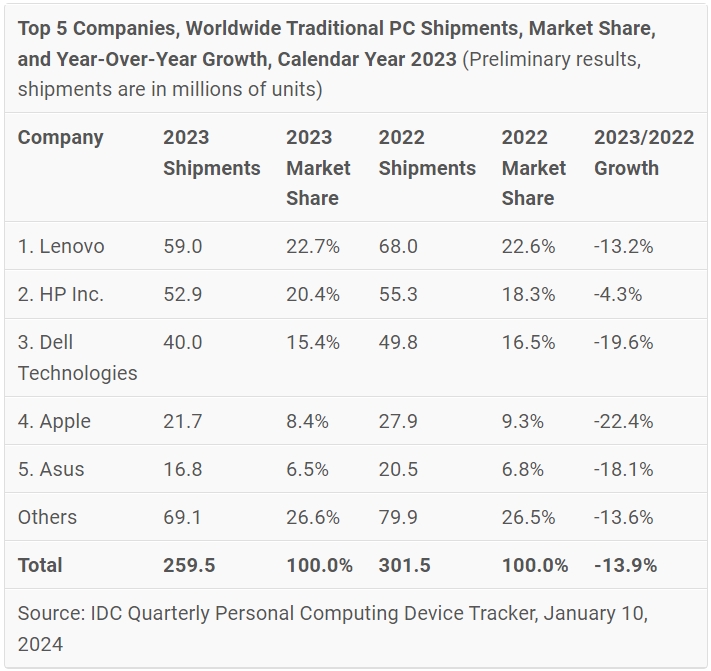
Notes:
-
Traditional PCs include Desktops, Notebooks, and Workstations and do not include Tablets or x86 Servers. Detachable Tablets and Slate Tablets are part of the Personal Computing Device Tracker but are not addressed in this press release.
-
Shipments include shipments to distribution channels or end users. OEM sales are counted under the company/brand under which they are sold.
Jayce
/include/upload/kind/image/20240116/20240116173602_2964.jpg
Q4 PC shipments of 67.1 million were down 2.7% y-o-y, reports IDC. It was the eighth consecutive quarter of y-o-y shipment volume contraction and the lowest Q4 volume since 4Q06.
In 2022, shipments fell 16.5% y-o-
2024/1/16 17:36:03
2024/1/16 17:36:03
38
0
516
6
November semi sales up 5.3% y-o-y
November semiconductor sales of $48 billion were up 5.3% compared with the $45.6 billion of November 2022 and 2.9% up on the October 2022 total of $46.6 billion, says the SIA.
“Global semiconductor sales increased on a year-to-year basis in November for the first time since August 2022, an indication that the global chip market is continuing to gain strength as we enter the new year,” says SIA CEO John Neuffer, “looking ahead, the global semiconductor market is projected to experience double-digit growth in 2024.”
Regionally, year-to-year sales were up in: China (7.6%), Asia Pacific/All other (7.1%), Europe (5.6%), and the Americas (3.5%), but down in Europe (-2.8%).
Month-to-month sales increased in: China (4.4%), the Americas (3.9%), and Asia Pacific/All Other (3.5%), but decreased in Japan (-0.7%) and Europe (-2.0%).

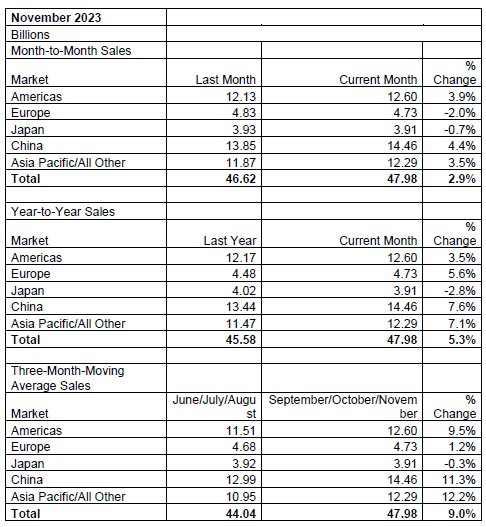
Jayce
/include/upload/kind/image/20240112/20240112200729_2630.png
November semiconductor sales of $48 billion were up 5.3% compared with the $45.6 billion of November 2022 and 2.9% up on the October 2022 total of $46.6 billion, says the SIA.
“Global semiconductor sales increased on a year-to-year
2024/1/12 20:10:06
2024/1/12 20:10:06
65
0
515
6
US gears up for Chinese dumping of legacy ICs
The US is preparing for a tsunami of legacy ICs from China.
Two Congressmen have written to US Secretary for Commerce, Gina Raimondo, expressing concern that China is “on track to flood the United States and global markets with foundational semiconductors.”
By ‘foundational’ they mean chips made on older nodes than 28nm.
In the 50nm to 180 nm range, China currently controls around 30% of global capacity and within a decade could control around 46%, says a Rhodium Group report.
The Congressmen are proposing import duties on ICs rather than duties on finished goods containing ICs.
The Commerce Department is initiating a survey this month to find out how US companies source legacy ICs.
Jayce
/include/upload/kind/image/20240111/20240111184803_3925.jpg
The US is preparing for a tsunami of legacy ICs from China.
Two Congressmen have written to US Secretary for Commerce, Gina Raimondo, expressing concern that China is “on track to flood the United States and global markets with founda
2024/1/11 18:48:34
2024/1/11 18:48:34
53
0
514
6
Memory Prices Surging
Q1 NAND and DRAM prices are set to rise significantly, reports TrendForce.
DRAM contract prices are estimated to increase by approximately 13–18% in 1Q24 with mobile DRAM leading the surge.
It appears that due to the unclear demand outlook for 2024, manufacturers believe that sustained production cuts are necessary to maintain the supply-demand balance in the memory industry.
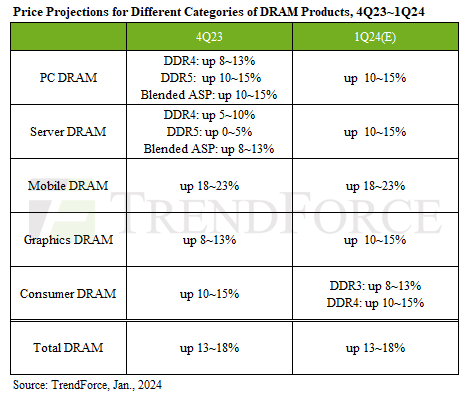
Despite facing a traditional low-demand season, buyers are continuing to increase their purchases of NAND Flash products to establish safe inventory levels.
In response, suppliers, aiming to minimise losses are pushing for higher prices, leading to an estimated 15–20% increase in NAND Flash contract prices in 1Q24.
A key point to note is the aggressive price hike initiated by NAND Flash manufacturers to offset losses. But, with demand struggling to keep pace with these rapid increases, future price escalations hinge on the resurgence of enterprise SSD procurement.

Jayce
/include/upload/kind/image/20240110/20240110183446_8504.jpeg
Q1 NAND and DRAM prices are set to rise significantly, reports TrendForce.
DRAM contract prices are estimated to increase by approximately 13–18% in 1Q24 with mobile DRAM leading the surge.
It appears that due to the
2024/1/10 18:35:56
2024/1/10 18:35:56
51
0
513
6
China Looking for EV Export Markets as US and EU Look at Restrictions
12.8 million EVs were sold last year (including BEVs (Battery EVs, PHEVs (Plud-In Hybrid EVs) , and FCVs (Fuel Cell Vehicles), says TrendForce.
Regional market sales shares were expected to be 60% in China, 22% in Western Europe, 11% in the US, and 6% in other regions.
With China’s subsidies gradually phasing out, the increasing market penetration of NEVs in the country and growing demand for EVs overseas, Chinese EV manufacturers are looking to expand internationally, particularly in Southeast Asia, where they are projected to hold a 67.5% market share in 2023.
TrendForce forecasts that China will export about 4.8 million automobiles in 2023, with NEVs making up approximately 25% of these exports.
The rising export volumes are exercising have caught governments worldwide as they try to balance the protection of local companies , maintaining competitiveness, and managing consumer costs.
For example, the US imposes a 25% tariff on vehicle imports from China, states that EVs and their batteries be assembled in North America and says that critical minerals in the batteries must originate from countries that have signed free trade agreements with the US to qualify for subsidies totalling US$7,500. As such, the Chinese supply chain is excluded.
The EU has initiated an anti-subsidy investigation against Chinese-made EVs, and France’s new subsidy regime for EVs requires compliance with carbon emission standards during manufacturing, effectively excluding many EVs imported from China
Jayce
/include/upload/kind/image/20240110/20240110013233_6299.png
12.8 million EVs were sold last year (including BEVs (Battery EVs, PHEVs (Plud-In Hybrid EVs) , and FCVs (Fuel Cell Vehicles), says TrendForce.
Regional market sales shares were expected to be 60% in China, 22% in Western Europe, 1
2024/1/10 1:33:32
2024/1/10 1:33:32
52
0
511
6
China Projected To Export 1.2 Million NEVs In 2023 Amid Tightening Tariffs By The US, Says TrendForce
TrendForce reports that the global sales volume of NEVs (including BEVs, PHEVs, and FCVs) is estimated to reach approximately 12.8 million units in 2023. Regional market sales shares are expected to be 60% in China, 22% in Western Europe, 11% in the United States, and 6% in other regions, with China’s market demand distinctly in the lead. However, with China’s subsidies gradually phasing out and the increasing market penetration of NEVs in the country, the growth rate of China’s NEV market is starting to slow. This, coupled with the growing demand for electric vehicles in overseas markets, is prompting numerous Chinese automotive brands to expand internationally, particularly in Southeast Asia, where they are projected to hold a 67.5% market share in 2023.
Benefiting from early government and industry initiatives and supported by a large domestic market, China’s EV industry has developed a complete supply chain and cost advantages due to rapid technological evolution driven by intense competition. TrendForce forecasts that China will export about 4.8 million automobiles in 2023, with NEVs making up approximately 25% of these exports. The rising export volumes have caught the attention of governments worldwide, especially since many major manufacturers, not just Chinese brands, have factories in China. Exporting vehicles from China to other markets could reduce local production volumes and values of complete vehicles and components, further impacting employment rates and economic performance.
TrendForce notes that the automotive industry is currently facing high raw material and labor costs, as well as significant investments in electrification and autonomous driving. Balancing the protection of local enterprises, maintaining competitiveness, and managing consumer costs is an urgent task for governments worldwide. Most countries are focusing on the country of origin rather than the brand of vehicles in their restrictive measures. For example, the United States imposes a 25% tariff on vehicle imports from China and is discussing further increases.
Measures taken by the US—specifically for EVs—include requiring that EVs and their batteries be assembled in North America. Furthermore, critical minerals in the batteries must originate from countries that have signed free trade agreements with the US to qualify for subsidies totaling US$7,500. As such, the Chinese supply chain is excluded. The EU has initiated an anti-subsidy investigation against Chinese-made EVs, and France’s new subsidy regime for EVs requires compliance with carbon emission standards during manufacturing, effectively excluding many EVs imported from China.
Overall, under the restrictive measures imposed by various governments, international manufacturers need to assess tariffs, subsidies, and production costs before deciding on their production locations. TrendForce suggests that for Chinese automakers seeking to expand overseas, the high cost of exporting vehicles from existing factories in China could diminish their price competitiveness. Despite this, countries like Italy, Hungary, Thailand, and Indonesia maintain a positive stand toward Chinese automakers setting up local factories—given their significant advantages in the EV market.

Jayce
/include/upload/kind/image/20240105/20240105171145_4342.png
TrendForce reports that the global sales volume of NEVs (including BEVs, PHEVs, and FCVs) is estimated to reach approximately 12.8 million units in 2023. Regional market sales shares are expected to be 60% in China, 22% in Western Europe, 11% in th
2024/1/5 17:12:26
2024/1/5 17:12:26
54
0
510
6
China’s Manufacturing PMI Falls For Third Month In A Row Highlighting 2024 Challenges For World’s Second-Biggest Economy
China’s key factory activity gauge closed the year with a contraction for a third straight month, suggesting that the world’s second-biggest economy may need more policy support to accomplish Beijing’s economic stabilisation goals in 2024.December’s official manufacturing purchasing managers’ index (PMI) fell to 49 from November’s 49.4, according to data from the National Bureau of Statistics released on Sunday.
This was much worse than the median forecast for 49.5 in a Reuters poll, as China’s first post-Covid year ended with a weaker-than-expected recovery.Earlier this year, PMI readings fell for five months in a row starting in April. After a brief expansion in September, they started falling again in October.
A reading above 50 typically indicates expansion of activity, while a reading below that suggests a contraction.
The statistics bureau pointed to an “increasingly complicated, tough and uncertain” external environment as a key reason for the continued fall.
Jayce
/include/upload/kind/image/20240103/20240103181948_4831.jpg
China’s key factory activity gauge closed the year with a contraction for a third straight month, suggesting that the world’s second-biggest economy may need more policy support to accomplish Beijing’s economic stabilisation goals in 2024.Decemb
2024/1/3 18:20:09
2024/1/3 18:20:09
65
0
509
6
Q3 PC Shipments Down 7.2% Y-o-Y
Q3 PC shipments were 7.2% down y-o-y at 68.5 million units in the third quarter of 2023, according to IDC, which expects full-year 2023 shipments to be down 13.8% y-o-y which was itself a 16.6% down year on 2021.
Two consecutive years of double-digit year-over-year drops is unprecedented in the PC market.
IDC’s hopes for a market rebound in 2024 rest on:
PC Refresh Cycle: The vast and aging installed base of commercial PCs surpassing the four-year mark by 2024 is expected to necessitate a refresh, coinciding with the pressing demand to migrate toward Windows 11. The total PC market of 2024 should see growth of 3.4% compared to 2023.AI Integration: The integration of AI capabilities into PCs is expected to serve as a catalyst for upgrades, hitting shelves in 2024 and at first aimed toward certain segments of the enterprise PC market. Over time, further advancement in use cases and cost reductions could spread to the broader market.Continued evolution and recovery of the consumer installed base.Beyond 2024, growth is expected to surpass pre-pandemic shipment levels and culminate in 285 million units by 2027.
“Perhaps historical context can offer some consolation to the tough slog the PC ecosystem is going through,” says IDC’sc Jay Chou, “while we still expect eight consecutive quarters of year-over-year volume declines from Q1 2022 through Q4 2023, it still pales to the 19 consecutive quarters of year-over-year PC declines from Q2 2012 to Q4 2016. Furthermore, notebooks are already at higher levels than 2019, signaling a sizable expansion of the notebook market even after COVID-induced purchases have subsided. We maintain that factors like hybrid work, commercial refresh, and growth in premium PCs can lead to a compound annual growth rate of 3.1% from 2023 through 2027.”

Jayce
/include/upload/kind/image/20240102/20240102180159_7380.jpg
Q3 PC shipments were 7.2% down y-o-y at 68.5 million units in the third quarter of 2023, according to IDC, which expects full-year 2023 shipments to be down 13.8% y-o-y which was itself a 16.6% down year on 2021.
Two cons
2024/1/2 18:02:01
2024/1/2 18:02:01
69
0
507
6
Korea’s Soaring Semis
Korean semiconductor production rose 42% in November while shipments rose 80% says Statistics Korea.

The November rise was the largest increase in 18 months. November inventories rose by 36% – the smallest rise since February.

Korea’s economy grew 5.3% in November. It is expected to grow 1.4% in 2023, down from 2.6% in 2022, and forecast to grow 2.2% in 2024.
Jayce
/include/upload/kind/image/20231228/20231228181739_1585.png
Korean semiconductor production rose 42% in November while shipments rose 80% says Statistics Korea.
2023/12/28 18:18:23
2023/12/28 18:18:23
73
0
505
6
Toshiba to Focus on PMICs, Infrastructure Opportunities and 10% Profit, Says CEO
Toshiba’s initial focus since going private on Wednesday will be on PMICs and making a ten percent operating profit, said CEO Taro Shimada (pictured) earlier today.
“In the short-term, expanding sales of power semiconductors is the first thing Toshiba should do,” said Shimada, “we’d like to ramp up the capacity as early as possible. Power semiconductors are selling like hotcakes because of strong demand for EVs.”Earlier this month Toshiba and Rohm announced a hook-up in PMICs.
Costs imposed by debt for the buy-out mean cost-cutting measures are needed and its four business units – energy, infrastructure, digital solutions and electronic devices – will consolidated and back-office efficiencies implemented.
Shimada said he expects the operating margin target of 10% to be achieved “early.”
“The issue with Toshiba was that it was unable to make any decisions and move forward,” Shimada said.
Shimada sees the data streams generated by Toshiba’s infrastructure businesses – power plants, trains, elevators, retail point-of-sales systems and water treatment systems – as the basis for initiating digital services revenue streams
“Once we are able to monetise the data from our equipment, profitability will easily surpass 10%,” Shimada said.
Shimada, a former Siemens exec, said that climate-related technologies like bendable solar panels, carbon capture systems, measuring industrial emissions and next-generation nuclear power technologies are longer term opportunities.
Jayce
/include/upload/kind/image/20231225/20231225171908_1187.jpg
Toshiba’s initial focus since going private on Wednesday will be on PMICs and making a ten percent operating profit, said CEO Taro Shimada (pictured) earlier today.
“In the short-term, expanding sales of power semiconductors is the
2023/12/25 17:20:08
2023/12/25 17:20:08
85
0
503
6
Sensors in cars
5.4 billion sensors, including imaging sensors, magnetic sensors, MEMS pressure sensors among many others, for the automotive market were shipped in 2022, says Yole Developpement, and with a 7% CAGR between 2022 and 2028, 8.3 billion sensors will be shipped in 2023.
For standard, or legacy, image sensors little has changed in terms of the main players, which remain onsemi, Omnivision and Sony. What has changed as safety features evolve, has been an increase in resolution, from 1-2Mpixel to today’s 8Mpixel cameras.
“We see the adoption of more and different sensors due to regulations and in-vehicle comfort levels. There are two routes to autonomous driving – incrementally from L2 to L4 or transitioning directly to L4 and robotaxis,” says Yole’s Yu Yang, “but this is proving more difficult than people first thought.”
On May 31, 2023, the NHTSA, in the US, proposed introducing a new standard that would make AEB mandatory for light-duty cars and trucks within four years of publication.
This regulation would be more stringent and would require detecting pedestrians even in dark conditions. This later condition could be a game changer as current AEB (Automatic Emergency Braking) works well with a radar and a visible camera, but this hardware have very low performance in dark conditions. That would mean that OEMs could implement another sensor to fulfil this condition.
Thermal cameras are insensitive to low light emissions making them superior to emergency braking systems based on a camera and radar. Thermal cameras perform well when the road bends, in poor weather or in low light conditions.
Adding an algorithm for pedestrian detection would be straightforward and this could be a great opportunity for thermal cameras to finally enter the automotive industry, but the cost of a thermal camera compared to a visual one is still the main obstacle to adoption.
Other sensors like gated imaging cameras or LiDAR could also be used to meet the performance required by this new AEB regulation.
The automotive camera and image sensor markets have seen substantial revenue growth due to increased demand and higher prices driven by safety regulations and the chip shortage.
The automotive camera market should rise from 5.4 billion to $9.4 billion in 2028, a CAGR of 9.7%. ADAS cameras will be present in 94% of cars by 2028, while in-cabin cameras for DMS (Driver Monitoring System) and OMS (Occupancy Monitoring System) will experience rapid growth.
The number of radar modules per car will increase from 1.7 in 2022 to 3.1, on average, in 2028. As a result, the automotive radar module is expected to realise a CAGR of 12% between 2022-2028, growing from $6.7 billion to $13.5 billion. 4D radar is expected to dominate and therefore generate around 60% of the market revenue in 2028.
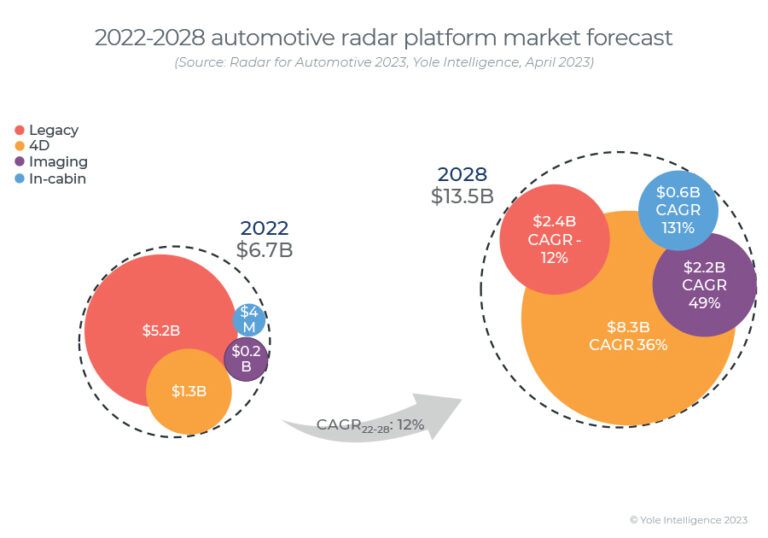
To replace legacy radar, 4D radar comes with the elevation capability and a better resolution. Indeed, 4D radar brings 1° angular resolution which dramatically improves object differentiation compared with 3D radar, which has an angular resolution of 4-6°. But such an increase in performance requires more computing power to process all these data.
Here, innovation is being driven by Arbe Robotics (More News), Uhnder and Metawave. These start-up companies are either using [AMD/Xilinx] FPGAs or, in the case of Arbe Robotics, producing their own ASICs to replace classic MCUs.
In 2023, the computing is usually embedded in the radar module, but in the coming years, we expect to see an increase in the computing part being separated from the radar module.
The LiDAR market for passenger cars has increased 285% since 2021. In 2022, and for the first time, the market for LiDAR in passenger vehicles surpassed the LiDAR market for robotaxis. The LiDAR adoption is driven by Chinese OEMs and in particular new ones making fully electric vehicles.
Innovusion, Valeo, Hesai and RoboSense lead this market (More news about LiDAR companies: Here). Valeo has dominated the passenger cars LiDAR market shares, with partnerships with Audi and Mercedes, for example, but dropped from 79% market share in 2021 to 24% in 2022, with the emergence of Chinese suppliers.
In 2022, Innovusion was leading the market thanks to its partnership with Nio but as the LiDAR market is quite young, we expect that the ranking could change rapidly. Indeed, Hesai and Robosense have partnered with more than 14 OEMs each and their respective market shares should change in 2023 and 2024.
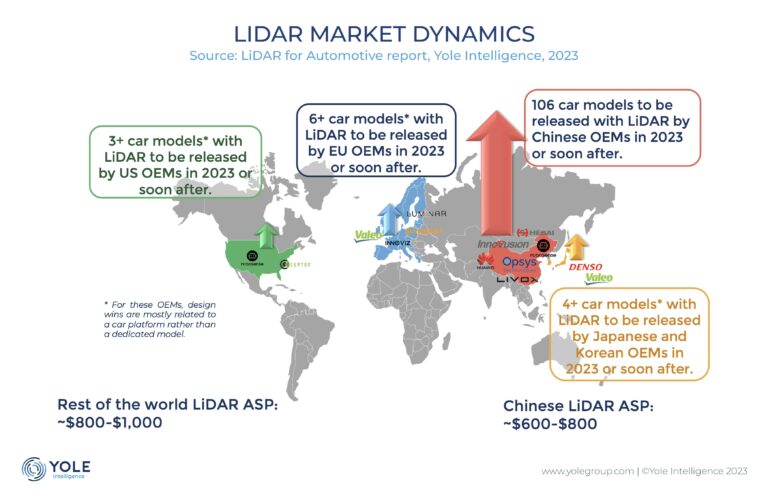
Chinese OEMs are rapidly implementing LiDAR using local suppliers to the extent that Chinese LiDAR manufacturers controlled 73% of the market in 2022. They have little traction in Europe, mostly because there are no large programs from OEMs yet and the market is limited to high end, low volume vehicles, mostly supplied by Valeo.
Another consideration relates to an earlier discussion about electrification. China was incentivised to begin electrification 20 years ago and is now developing new platforms for ADAS and AD, which will implement more and more sensors, including LiDAR, camera and radar,” says Yole’s Pierrick Boulay, “for example, the latest BYD model, the Yangwang U8 SUV has 24 sensors between camera, radar and LiDAR, which is more than the fourth-generation of Waymo robotaxi, implementing only 18 of them.
An increasing number of sensors having better performance in terms of range and resolution directly impacts the need for computing power in passenger cars. Computing revenue for ADAS and cockpit processor is increasing quickly, with a 13% CAGR between 2022 and 2028 and reaching a value of $12.7 billion in 2028.
Among these two categories, ADAS is the largest segment, representing more than 60% of the revenue in 2028.

Mobileye has dominated the automotive vision processor market for a long time, accounting for 52% market share in 2022, followed by players like AMD, Nvidia or Tesla.
The cockpit processor market is dominated by Qualcomm, a new player compared to competitors, Renesas or NXP.
Qualcomm entered the automotive market through the cockpit, leveraging its knowledge in user experience, acquired in the smartphone market. But the ultimate goal of Qualcomm is not the cockpit market, it is the much more lucrative ADAS market. Yole expects that Qualcomm will rapidly gain some market share in the ADAS domain and quickly become a significant player to compete with Mobileye.
Already some players, such as BMW and Volkswagen, are moving away from Mobileye to Qualcomm. Other new players e.g., Nvidia, Horizon Robotics and Black Sesame have a low but rapidly growing market share,thanks to partnerships with Chinese OEMs.
Today, Chinese companies like Horizon Robotics, Black Sesame or Hisilicon, among others, are gaining design wins and their market share is expected to increase significantly in the next five years. They are very active in both ADAS and cockpit domains.
In 2023, several car models from Chinese OEMs were released with a number of sensors that was much higher compared to other car models released by European or US OEMs. But these Chinese cars are still classified in the hands-off category, like Tesla to give a comparison, due to a lack of regulation.
If the regulation changes, we could expect more complex automated driving applications that would be enabled via OTA updates, as the sensor and computing hardware is already in place.
Regarding eyes-off applications, there is no regulation in place in China to allow such applications, but Chinese OEMs are developing NOA (Navigation On Autopilot) systems. Regarding the rest of the world, eyes-off regulation is already in place in Japan, Europe (Germany) and it is also gathering pace in the UK and some states in the U.S, for example, California and Nevada.
Without doubt, the main driver of the automotive semiconductor industry is electrification and ADAS.
The cost of semiconductor devices in cars reached around $540 per car in 2022. In 2028, this figure will grow to about $912 entirely through the implementation of both market drivers.
The related market is showing a significant 11.9% CAGR between 2022 and 2028 to peak at $84.3 billion during this period. Behind this figure, Yole expects a 100 billion semiconductor device market.

Although semiconductors are critical to the on-going disruptive transition in the automotive industry, most players, whether OEMs or Tier 1s, do not yet have a well-defined strategy for semiconductors.
Specific expertise in semiconductor technologies and the supply chain is needed to prepare for the future. There is a need to manage semiconductor complexity. OEMs need to prioritize essential ECUs and semiconductors and establish new relations with device manufacturers and foundries.
OEMs need to secure their supply chain and to do that they are developing new strategies with semiconductor manufacturers, whether it is direct sourcing by partnering with companies like Infineon or onsemi, for example, or by co-development, partnering with companies like STMicroelectronics or Foxconn.
The global supply chain is evolving from OEMs buying a black box to Tier 1 players being more involved in the development of their products. Some OEMs, like BYD, Toyota, or Geely, can be vertically integrated in some domains and able to manufacture their own semiconductors.
Others, like Li Auto or Tesla, can control the design of their devices and only use foundries to manufacture them. Here are only few examples of these changes and 2024 will be a strategic year for all automotive companies
Jayce
/include/upload/kind/image/20231222/20231222174259_9234.jpg
5.4 billion sensors, including imaging sensors, magnetic sensors, MEMS pressure sensors among many others, for the automotive market were shipped in 2022, says Yole Developpement, and with a 7% CAGR between 2022 and 2028, 8.3 billion sensors
2023/12/22 17:45:37
2023/12/22 17:45:37
73
0
502
6
Top Ten Fabless grow 17.8%
Q3 revenues for the fabless top ten rose 17.8% q-o-q to $44.7 billion.
Nvidia’s Q3 revenue rose 45.7% to $16.5 billion. Cirrus Logic grew 51.7% to $481 million take the No.10 slot driven by smartphone stockpiling demand. Will Semiconductor grew 42.3% in Q3 to $752 million.
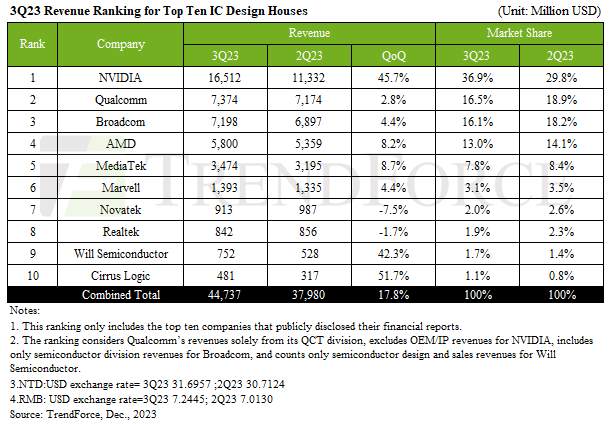
Qualcomm’s Q3 revenues rose 2.8% to $7.4 billion but Nvidia’s success trimmed Qualcomm’s market share to 16.5%. Broadcom’s Q3 revenues grew 4.4% to $7.2 billion.
AMD’s Q3 revenue grew 8.2% to $5.8 billion. . MediaTek’s Q3 revenue rose by 8.7% to $3.5 billion as smartphone stocks were replenished.
Marvell’s Q3 revenues were up 4.4% at $1.4 billion. Novatek and Realtek saw revenues decline by 7.5% and 1.7% respectively.
Jayce
/include/upload/kind/image/20231221/20231221181147_0919.png
Q3 revenues for the fabless top ten rose 17.8% q-o-q to $44.7 billion.
Nvidia’s Q3 revenue rose 45.7% to $16.5 billion. Cirrus Logic grew 51.7% to $481 million take the No.10 slot driven by smartphone stockpiling demand. Will Semico
2023/12/21 18:12:26
2023/12/21 18:12:26
76
0
501
6
Has the US Chips Act Been A Success?
Has the US Chips Act been successful in increasing investment in semiconductor wafer fabs in the U.S? asks Semiconductor Intelligence.
SI’s answer is the table below of major U.S. fab projects announced in the last few years.
The total near term investment is $142 billion. Most of these projects were announced before the passage of the Chips Act.
However, these companies likely expected future U.S. government subsidies. The subsidies listed in the table are from state and local governments. The organization Good Jobs First tracks government financial assistance to business.

Would these fabs have been built in the U.S. without the expectation of U.S. government assistance? Let’s look at each company.
TSMC – the largest semiconductor wafer foundry, based in Taiwan. TSMC has six current 300mm wafer fabs. All are based in Taiwan except for one in Nanjing, China.
TSMC’s third quarter 2023 report shows 69% of its revenue came from companies based in North America (primarily the U.S.). TSMC has been facing pressure from both the U.S. government and its U.S. customers to build a fab in the U.S.
This pressure combined with the hope of U.S. government funding most likely drove its decision to build a fab in Arizona. TSMC is reportedly seeking about $15 billion in funding through the CHIPS Act. TSMC is also planning an $11 billion wafer fab in Dresden, Germany in a joint venture with Bosch, Infineon and NXP.
The German government planned to contribute about 5 billion Euros ($5.4 billion) towards the fab. However, a recent court ruling places the German subsidies in doubt.
Texas Instruments – TI currently has 300mm wafer fabs located in Dallas, Texas; Richardson, Texas; and Lehi, Utah.
The Lehi fab was purchased from Micron Technology and converted by TI to produce analogue ICs. TI in the past has located fabs in Europe and Asia, but in the last several years has only build fabs in the U.S. TI’s proposed fabs in Sherman, Texas are about a one-hour drive from TI’s headquarters.
TI has had operations in Sherman for over 50 years. The city, school district, and county will provide about $2.4 billion in subsidies for the Sherman fabs, primarily through tax breaks.
Any money TI receives through the CHIPS Act will be a bonus. However, it is likely TI would have built its new fabs in Sherman without the CHIPS Act.
Samsung – Most of Samsung’s fabs are in South Korea. Samsung built a fab in Austin, Texas which opened in 1996. The Austin fab operates as a wafer foundry.
Samsung’s announced fab in Taylor, Texas – about 45 minutes from Austin – will also be a wafer foundry. The company will continue to make major fab investments in South Korea with $230 billion planned over the next 20 years, primarily for memory fabs.
Samsung will receive about $1.2 billion in local subsidies from Taylor area governments. The proximity to its Austin fab and the local incentives were most likely the primary drivers for Samsungs Taylor fab.
Funds from the CHIPS Act were probably also a factor, but Samsung presumably would have built the fab in Taylor without CHIPS money.
Intel – Intel has major U.S. fabs in Chandler, Arizona; Hillsboro, Oregon; and Rio Rancho, New Mexico. It also has fabs in Leixlip, Ireland; Jerusalem, Israel; and Kiryat Gat, Israel.
Intel is building a new fab in Kiryat Gat with about $3 billion in Israeli government subsidies. The company also plans a fab in Magdeburg, Germany with about $11 billion in German government aid. However, as with TSMC, the German funding is uncertain.
Intel will receive about $2.4 billion in local aid for its fab in New Albany, Ohio. Intel announced the Ohio fab in January 2022 – before the CHIPS Act was passed but when passage appeared likely. Intel has shown a willingness to locate fabs outside of the U.S. for the right incentives. The CHIPS funds were certainly a major factor in deciding on the Ohio location.
Micron Technology – Micron has fabs in Boise, Idaho; Taichung, Taiwan; Hiroshima, Japan; and Singapore.
The foreign fabs were all procured through Micron business acquisitions: Rexchip Electronics in Japan, Intotera Memories in Taiwan, and Texas Instruments’ memory business in Singapore. Micron plans to expand its fabs in Taiwan and Japan.
The Japanese government will subsidize Micron’s new Hiroshima fab with about $1.3 billion. Micron will build new fabs in Boise, Idaho and Clay, New York over the next several years. Micron will receive about $6.4 billion in state and local incentives for its New York fabs.
The new fabs will produce DRAMs, which Micron currently makes only in Taiwan and Japan. Micron’s strategy is to eventually produce 40% of its DRAMs in the U.S. The new U.S. fabs were announced in September and October of 2022, well after the passage of the CHIPS Act.
Since Micron has shown a willingness to expand its overseas fabs, the CHIPS funds were undoubtedly a major factor in deciding on its Idaho and New York fabs.
In summary, was the CHIPS Act a deciding factor in locating these new fabs in the U.S.? Asks SI.
We say yes for TSMC and probably for Micron and Intel, answers SI. TI and Samsung would likely have made their fab location decisions without the CHIPS Act. It remains to be seen how the CHIPS Act will affect future fab decisions.
Companies decide to build new fabs based on their anticipated capacity needs. Fab locations are based on many factors including proximity to company headquarters, infrastructure, workforce, political stability, customer proximity, and logistics.
Government subsidies may influence the country for the fab and the location within the country but are generally not the primary driving factor.
The SI June estimates for 2023 semiconductor capex were about $156 billion, down 14% from 2022. Most companies appear to be holding to their plans.
One exception is Intel, which we had estimated at $20 billion in 2023 CapEx. Through the third quarter of 2023, Intel capex was $19.1 billion, which means the full year will likely be around $24 billion.
The largest spender, TSMC, confirmed in October their 2023 capex target of $32 billion, down 12% from 2022.
Few companies have indicated their capex plans for 2024.
Micron ended its 2023 fiscal year in August with $7.0 billion in capex. Their guidance for fiscal 2024 capex was “slightly above” fiscal 2023.
Infineon’s fiscal year 2023 ended in September with 3 billion euro ($3.2 billion) in capex. Infineon plans to increase capex to 3.3 billion euro ($3.6 billion). The SI preliminary estimate for 2024 total capex is a 10% to 20% increase from 2023, in the range of $172 billion to $187 billion.
Jayce
/include/upload/kind/image/20231220/20231220173819_2741.jpg
Has the US Chips Act been successful in increasing investment in semiconductor wafer fabs in the U.S? asks Semiconductor Intelligence.
2023/12/20 17:40:15
2023/12/20 17:40:15
75
0
500
6
Predictions for 2024 – 3GPP and Ambient IoT
The next edition of the 3GPP 5G Advanced standard (Release 19) is expected to bring ambient IoT within 6G to increase connectivity from billions of devices to trillions.
Voting in December, the telecom companies and mobile operators that make up 3GPP membership will define what is to be in the latest standard.
“Ambient IoT will almost certainly be part of the release, the question is will it be a Study Item or a Work Item. We believe that Ambient IoT will be as big as the advent of the smartphone in terms of its impact on customers, businesses and society, and that it’s better to move forward incrementally and iteratively using the lessons learnt from deployment that have proven successful using other wireless technologies like Bluetooth ambient IoT,” said Steve Statler, CMO of Wiliot.
IoT has the potential to open up new revenue streams as well as help end consumers. Wiliot announced its IoT Pixels at MWC 2022. “While 5G tracked cars, appliances and shipping containers, 6G will track everything in those cars, appliances and shipping containers,” Statler said at the time. The IoT Pixels device can attach to any product and powers itself using recycled ambient energy waves to provide real time visibility in supply chains, monitor conditions (e.g., temperatures) and stock levels on a real time basis rather than daily updates for efficient deliveries.
Ambient IoT can be used to track the minutiae, such as food, clothing and medicine, rather than the expensive objects containing these individual assets. It uses low-cost, ubiquitous radios and does not rely on manual scanning but automatically senses the things nearby and automates the connectivity rather than relying on handheld scanners, explained Statler. Radios in phones, cars, appliances and other equipment will be upgraded to provide the energy and read the signals from the battery-free postage stamp sized smart tags. “Ambient IoT connections are the tendons connecting the bones of the real world to the computing muscle in the cloud,” he added.
Jayce
/include/upload/kind/image/20231219/20231219175514_1452.jpg
The next edition of the 3GPP 5G Advanced standard (Release 19) is expected to bring ambient IoT within 6G to increase connectivity from billions of devices to trillions.
Voting in December, the telecom companies and mobile operators th
2023/12/19 17:55:50
2023/12/19 17:55:50
70
0
499
6
Data Centre Capex to Grow 11% in 2024
Data centre capex is forecast to grow 11% in 2024 as select hyperscale cloud service providers return to an expansion cycle and the spending freeze in the enterprise markets thaws, says Dell’Oro..
“Worldwide data centre capex is projected for only a 4% growth in 2023,” says Dell’Oro’s Baron Fung, “ the slowdown in general-purpose server and storage deployments weighed down the market despite increased AI-related investments. While Microsoft, Google, and Oracle have increased their data centre investments in 2023 year-to-date, other cloud service providers such as Amazon and Meta have trimmed their data centre capex.”
“Our outlook for 2024 is more optimistic,” added Fung, “AI applications such as generative AI will be a key investment driver in the cloud and enterprise. Furthermore, we anticipate demand for general-purpose servers to recover following a prolonged correction, and as customers make a transition to new server platforms that enable more efficient computing.”
Server and storage system revenue is forecast for growth greater than 20 percent in 2024, while network and physical infrastructure revenues grows single digits.
Dell led all OEMs in server revenue in 3Q 2023, followed by IEI Systems (formerly Inspur) and HPE. White box server vendors gained 8 points of revenue share year-over-year compared to the OEMs.
The hyperscale cloud service providers are forecast to increase their data centre capex by 13 percent in 2024
Jayce
/include/upload/kind/image/20231218/20231218174128_1585.jpg
Data centre capex is forecast to grow 11% in 2024 as select hyperscale cloud service providers return to an expansion cycle and the spending freeze in the enterprise markets thaws, says Dell’Oro..
“Worldwide data centre capex
2023/12/18 17:41:57
2023/12/18 17:41:57
73
0
497
6
Taiwan and Korea Foundry Share to Shrink
The share of the foundry industry now held by Taiwan and Korea will shrinkto 41% and 10% respectively by 2027, says TrendForce.
Currently Taiwan holds approximately 46% of global semiconductor foundry capacity, followed by China (26%), South Korea (12%), the US (6%), and Japan (2%).
In advanced manufacturing processes (including 16/14nm and more advanced technologies), Taiwan leads with a 68% global capacity share in 2023, followed by the US (12%), South Korea (11%), and China (8%).
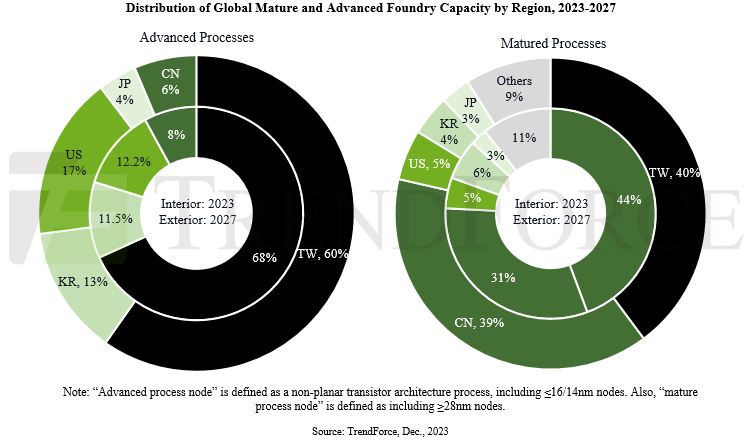
Taiwan holds nearly 80% share when it comes to EUV generation processes (such as 7nm and beyond).
While the US’s share of advanced process capacity is expected to increase to 17% by 2027, TSMC and Samsung will still account for over half of this capacity as they ramp up their US production sites.
China is focusing aggressively on mature process technologies (28nm and older). By 2027, China’s share in mature process capacity is expected to reach 39%, with room for further growth if equipment procurement proceeds smoothly.
As Chinese manufacturers rapidly expand their mature process capacities—backed by government subsidies—this could lead to intense price competition in products like CIS, DDI, PMIC, and power discrete, impacting Taiwan-based foundries like UMC, PSMC, and Vanguard.
Vanguard is expected to be most affected due to its product line including LDDI, SDDI, PMIC, and power discrete. Other companies like UMC and PSMC will maintain their advantages in the 28/22nm OLED DDI and memory sectors.
In response to chip shortages and geopolitical influences, fabless customers are diversifying risk by working with multiple foundries, potentially leading to increased IC costs and concerns over duplicate orders.
Customers are also requiring global validation of production lines, even with long-term foundry partners, to enable flexible capacity adjustments.
Jayce
/include/upload/kind/image/20231215/20231215182403_9529.png
The share of the foundry industry now held by Taiwan and Korea will shrinkto 41% and 10% respectively by 2027, says TrendForce.
Currently Taiwan holds approximately 46% of global semiconductor foundry capacity, followed by China (26%
2023/12/15 18:24:49
2023/12/15 18:24:49
94
0
496
6
Q4 Smartphone Shipments to Be Up 10%+ Sequentially
Snartphone shipments will grow more than 10% q-o-q and 2% y-o-y reaching over 300 million units, says Digitimes Research.
The sequential increase is driven primarily by Apple’s iPhone shipments.
Demand for smartphones has started recovering in emerging markets, such as Southeast Asia, Latin America, and Africa, in the latter half of the third quarter of 2023.
Global smartphone shipments for the third quarter of 2023 totaled nearly 275 million units, narrowing the annual decline to 0.6%.
2023 smartphone shipments for 2023 are forecast at 1.1043 billion units.
In the Chinese market, Q3 shipments have slightly increased to 61.3 million units, with a year-on-year growth rate of 5%.
Outside of China, due to the recovery in demand from emerging countries, shipments have been revised upward to 213.5 million units, narrowing the annual decline to 2.1%.
2023 5G smartphone shipments are forecast to be 571.5 million units, representing a 2.9% decline from 2022.
Jayce
/include/upload/kind/image/20231214/20231214181726_7699.png
Snartphone shipments will grow more than 10% q-o-q and 2% y-o-y reaching over 300 million units, says Digitimes Research.
The sequential increase is driven primarily by Apple’s iPhone shipments.
Demand for smartphones
2023/12/14 18:17:31
2023/12/14 18:17:31
67
0
495
6
Q3 Wearables Out-Ship Pre-Pandemic Volumes
Q3 wearables shipments grew 2.6% y-o-y at 148.4 million units, according to the (IDC) Worldwide Quarterly Wearable Device Tracker which out-shipped 3Q21 (142.1 million) and 3Q22 (144.6 million) when sales were driven by pandemic-related spending.
The growth is largely attributed to the rise of smaller brands and emerging categories.
“Health and fitness tracking has come a long way since the original Fitbits and Pebble watches but the greatest driver of wearables has been the emergence of smaller and sleeker designs,” saisvIDC’s Jitesh Ubrani, “smart rings from newer brands such as Oura, Noise, BoAT, Circular and others are expected to jumpstart the new form factor in the coming quarters.”
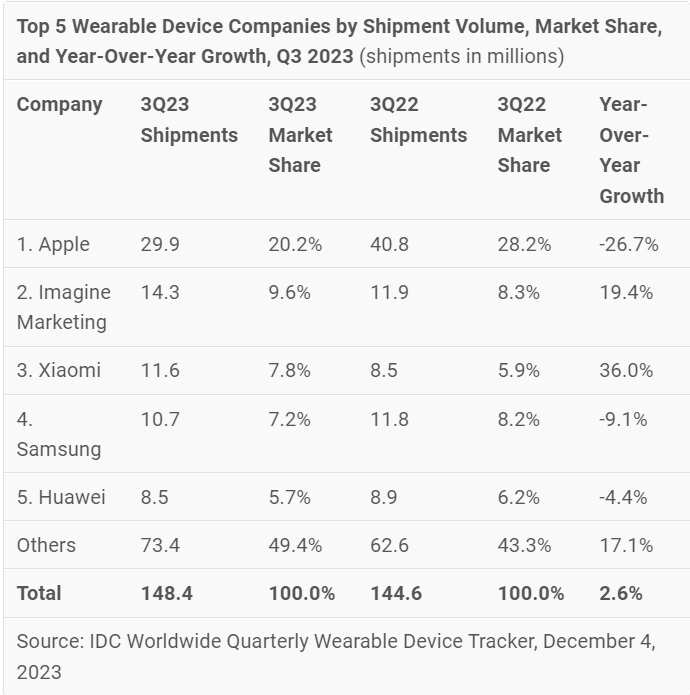

Jayce
/include/upload/kind/image/20231213/20231213181305_6662.png
Q3 wearables shipments grew 2.6% y-o-y at 148.4 million units, according to the (IDC) Worldwide Quarterly Wearable Device Tracker which out-shipped 3Q21 (142.1 million) and 3Q22 (144.6 million) when sales were driven by pandemic-relate
2023/12/13 18:13:06
2023/12/13 18:13:06
82
0
494
6
2023 Sales of Semi Manufacturing Equipment Down 6.1% Y-o-Y
Sales of total semiconductor manufacturing equipment by original equipment manufacturers are forecast to reach $100 billion in 2023, a contraction of 6.1% from the industry record of $107.4 billion posted in 2022, SEMI announced today in its Year-End Total Semiconductor Equipment Forecast – OEM Perspective at SEMICON Japan 2023.
Semiconductor manufacturing equipment growth is expected to resume in 2024, with sales forecast to reach a new high of $124 billion in 2025, supported by both the front-end and back-end segments.
“We anticipate a temporary contraction in 2023 due to the cyclical nature of the semiconductor market,” sai Ajit Manocha, SEMI President and CEO. “2024 will be a transition year. We then expect a strong rebound in 2025, driven by capacity expansion, new fab projects, and high demand for advanced technologies and solutions across the front-end and back-end segments.
After registering a record $94 billion in sales last year, the wafer fab equipment segment, which includes wafer processing, fab facilities and mask/reticle equipment, is projected to slip 3.7% to $90.6 billion in 2023.
This contraction marks a significant improvement from the 18.8% decline forecast by SEMI in its Mid-Year Total Semiconductor Equipment Forecast – OEM Perspective. The upward revision is primarily due to strong equipment spending by China.
Wafer fab equipment segment sales are projected to grow at a modest 3% in 2024 from the revised 2023 base due to limited memory capacity addition and the pause of mature capacity expansion.
A growth path with a further 18% expansion in 2025 is expected as new fab projects, capacity expansion and technology migrations drive investments to nearly $110 billion.
The decline in back-end equipment segment sales started in 2022 and continued in 2023 due to challenging macroeconomic conditions and softening semiconductor demand.
Semiconductor test equipment market sales are projected to contract by 15.9% to $6.3 billion in 2023, while assembly and packaging equipment sales are expected to drop by 31% to $4.0 billion in the same year.
The test equipment and assembly and packaging equipment segments are forecast to expand by 13.9% and 24.3%, respectively, next year.
Back-end segment growth is expected to continue in 2025, with test equipment sales rising 17% and assembly and packaging sales increasing 20%.
Equipment sales for foundry and logic applications, accounting for more than half of total wafer fab equipment receipts, are expected to log a 6% increase year-over-year to $56.3 billion in 2023 despite softer end-market conditions.
The application segment is forecast to contract 2% in 2024 as mature technology expansion slows and spending on leading-edge technology improves.
Foundry and logic equipment investments are projected to increase 15% in 2025 to $63.3 billion, driven by increased capacity expansion purchases and the introduction of new device architectures.
As anticipated, memory-related capital expenditures will see the sharpest decline in 2023.
NAND equipment sales are predicted to drop by 49% to $8.8 billion in 2023 but will surge 21% to $10.7 billion in 2024 and rise another 51% to $16.2 billion in 2025.
DRAM equipment sales are expected to remain stable, growing by 1% and 3% in 2023 and 2024, respectively.
Supported by continuous technology migration and expanding demand for high-bandwidth memory (HBM), DRAM equipment segment sales are expected to increase an additional 20% to $15.5 billion in 2025.
China, Taiwan and Korea are expected to remain the top three destinations for equipment spending through 2025.
China is projected to maintain the top position over the forecast period as the region’s equipment billings continue to soar. Equipment shipments to China are projected to surpass a record $30 billion in 2023, widening its lead with other regions.
While equipment spending for most tracked regions is expected to fall in 2023 before resuming growth in 2024, China is expected to see a mild contraction in 2024 after heavy investments in 2023.
The following results reflect market size by segment and application in billions of U.S. dollars:
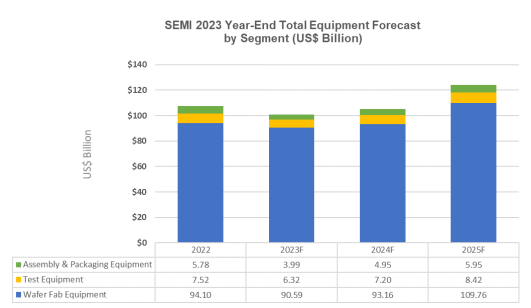

Source: SEMI December 2023, Equipment Market Data Subscription
* Total equipment includes new wafer fab, test, and assembly and packaging. Total equipment excludes wafer manufacturing equipment. Totals may not add due to rounding.
The SEMI forecast is based on collective input from top equipment suppliers, the SEMI Worldwide Semiconductor Equipment Market Statistics (WWSEMS) data collection program and the industry-recognized SEMI World Fab Forecast database.
Jayce
/include/upload/kind/image/20231212/20231212185344_7457.png
Sales of total semiconductor manufacturing equipment by original equipment manufacturers are forecast to reach $100 billion in 2023, a contraction of 6.1% from the industry record of $107.4 billion posted in 2022, SEMI announced today in its Year-E
2023/12/12 18:56:08
2023/12/12 18:56:08
75
0
493
6
Q3 Smartphone Production Rises 13% Q-o-Q; 6.4% Y-o-Y

Q4 is expected to see a further 5–10% QoQ increase in production.
The downturn in global smartphone production for 2023 is expected to be limited to less than 3%, with total annual output estimated to reach approximately 1.16 billion units.
Samsung continues to lead the market after recording an 11.5% increase in its Q3 production at 60.1 million units – only 5 million more than apple.
Apple saw its Q3 production climb 17.9% to reach approximately 49.5 million units. However, it had a 1.5% YoY market share decline, with annual production at 2022 levels.
Huawei’s re-entry with its flagship phones is anticipated to significantly impact Apple’s production performance in the upcoming year.
Xiaomi (including Xiaomi, Redmi, and POCO) saw Q3 production jump by 22.3% to approximately 42.8 million units.
Oppo (including Oppo, Realme, and OnePlus) experienced a 15.2% increase in its Q3 output to 38.7 million units.
Transsion (including TECNO, Infinix, and itel) produced 26.5 million units—a 5.6% increase QoQ.
Vivo (including Vivo and iQoo) saw its Q3 production rise to 24.5 million units, marking a 6.5% increase and placing it in the sixth spot.
Jayce
/include/upload/kind/image/20231211/20231211175611_5054.png
Q4 is expected to see a further 5–10% QoQ increase in production.
The downturn in global smartphone production for 2023 is expected to be limited to less than 3%, with total annual output estimated to reach a
2023/12/11 17:56:48
2023/12/11 17:56:48
70
0
491
6
October Semi Sales Up 3.9% Q-o-Q
October semiconductor sales of $46.6 billion were up 3.9% on the $44.9 billion of September but 0.7% less than the October 2022 total of $46.9 billion, says the SIA.
A WSTS industry forecast projects 2023 sales will decrease 9.4% y-o-y in 2023 but increase 13.1% in 2024.
The forecast puts 2023 sales at $520 billion in 2023, down from the 2022 sales total of $574.1 billion.
In 2024, sales are projected to reach $588.4 billion.
“The global semiconductor market grew on a month-to-month basis for the eighth consecutive time in October, demonstrating clear, positive momentum for chip demand as 2023 winds down,” says SIA CEO John Neuffer, “moving forward, we forecast year-end sales for 2023 will be down compared to 2022, but the global semiconductor market is projected to rebound strongly next year with double-digit growth projected for 2024.”
Regionally, month-to-month sales increased in China (6.1%), Asia Pacific/All Other (4.9%), the Americas (2.9%), Japan (0.6%) and Europe (0.2%). Year-to-year sales were up in Europe (6.6%) and Asia Pacific/All other (0.4%), but down in the Americas (-1.6%), China (-2.5%), and Japan (-3.1%).
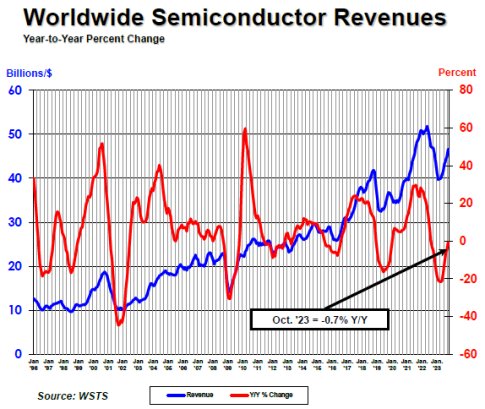

Jayce
/include/upload/kind/image/20231208/20231208171514_1505.png
October semiconductor sales of $46.6 billion were up 3.9% on the $44.9 billion of September but 0.7% less than the October 2022 total of $46.9 billion, says the SIA.
2023/12/8 17:16:12
2023/12/8 17:16:12
74
0
490
6
7.9% Q3 Growth for Top 10 Foundries
The top ten foundries grew revenues 7.9% to $28.29 billion, and Q4 revenues could grow faster, reports TrendForce.

TSMC, with 58% market share, grew Q3 revenue by 10.2%—reaching $17.25 billion. The 3nm process alone contributed 6% to TSMC’s Q3 revenue, with advanced processes (≤7nm) accounting for nearly 60% of its total revenue.
Samsung grew foundry revenue by 14.1% to $3.69 billion in Q3, driven by orders for Qualcomm’s mid-to-low range 5G AP SoC, 5G modems, and mature 28 nm OLED DDI processes.
GlobalFoundries maintained a stable performance in Q3, with its revenue approximating $1.85 billion, similar to the previous quarter.
UMC’s Q3 revenue declined 1.7% to $1.8 billion. Revenue from its 28/22 nm products saw a near 10% increase, representing 32% of UMC’s total revenue.
SMIC had a 3.8% Q3 revenue increase to $1.62 billion. However, the revenue share from American clients decreased to 12.9%. Conversely, revenue from Chinese clients increased to 84% due to the government’s localisation initiatives and urgent orders for smartphone components.
Notable changes in the rankings from sixth to tenth position include VIS and IFS, with the latter entering the global top ten for the first time since Intel’s financial restructuring.
VIS’ Q3 revenue increased by 3.8% to $333 million—surpassing PSMC to take the eighth position.
IFS had a 34.1% increase in revenue to approximately $311 million.
HuaHong saw a 9.3% decrease in Q3 revenue to about $766 million.
HHGrace maintained steady wafer shipment levels from the previous quarter, but a roughly 10% decrease in ASP led to a decline in revenue.
Tower Semiconductor saw stable demand in the smartphone, automotive, and industrial sectors, maintaining revenue at around $358 million in Q3.
PSMC witnessed a 7.5% drop in revenue to $305 million, with PMIC and Power Discrete revenues declining nearly 10% and 20%, respectively, impacting overall performance.
Jayce
/include/upload/kind/image/20231207/20231207183755_7181.png
The top ten foundries grew revenues 7.9% to $28.29 billion, and Q4 revenues could grow faster, reports TrendForce.
TSMC, with 58% market share, grew Q3 revenue by 10.2%—reaching $17.25 billion. The 3nm process alone contribut
2023/12/7 18:39:18
2023/12/7 18:39:18
70
0
489
6
Semi Sales to Grow 16.8% Next Year
2024 semiconductor sales are projected to grow 16.8% in 2024 to total $624 billion, according to Gartner after a 2023 market which is forecast to decline 10.9% to $534 billion.
“We are at the end of 2023 and strong demand for chips to support artificial intelligence (AI) workloads, such as graphics processing units (GPUs), is not going to be enough to save the semiconductor industry from double-digit decline in 2023,” says Gartner vp Alan Priestley, VP“Reduced demand from smartphones and PC customers coupled with weakness in data center/hyperscaler spending are influencing the decline in revenue this year.”
However, 2024 is forecast to be a bounce-back year where revenue for all chip types will grow (see Figure 1), driven by double-digit growth in the memory market.
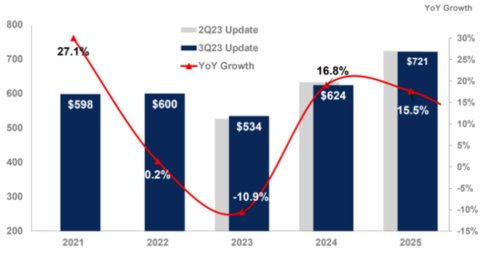
Figure 1. Semiconductors Revenue Forecast, Worldwide, 2021-2025 (Billions of U.S. Dollars)
Source: Gartner (December 2023)
The worldwide memory market is forecast to record a 38.8% decline in 2023 and will rebound in 2024 by growing 66.3%.
Anaemic demand and declining pricing due to massive oversupply will lead NAND flash revenue to decline 38.8% and fall to $35.4 billion in revenue in 2023.
Over the next 3-6 months, NAND industry pricing will hit bottom, and conditions will improve for vendors. Gartner analysts forecast a robust recovery in 2024, with revenue growing to $53 billion, up 49.6% year-over-year.
Due to high oversupply level and lack of demand, DRAM vendors are chasing the market price down to reduce inventory.
Through the fourth quarter of 2023, DRAM market’s oversupply will continue which will trigger a pricing rebound. However, the full effect of pricing increases will only be seen in 2024, when DRAM revenue is expected to increase 88% to total $87.4 billion.
Developments in generative AI (GenAI) and large language modelsare driving demand for deployment of high-performance GPU-based servers and accelerator cards in data centers. This is creating a need for workload accelerators to be deployed in data center servers to support both training and inference of AI workloads.
Gartner analysts estimate that by 2027, the integration of AI techniques into data center applications will result in more than 20% of new servers including workload accelerators.
Jayce
/include/upload/kind/image/20231205/20231205174107_9488.jpg
2024 semiconductor sales are projected to grow 16.8% in 2024 to total $624 billion, according to Gartner after a 2023 market which is forecast to decline 10.9% to $534 billion.
“We are at the end of 2023 and strong demand for chips
2023/12/5 17:42:16
2023/12/5 17:42:16
83
0
488
6
ECSN: cautious optimism for 2024
Last year, Aubrey Dunford, the ECSN (Electronic Components Supply Network) market analyst declared the UK electronics components market had returned to normality. At this year’s Electronics Components Forecast, he reclassified its status as a new, new normal.
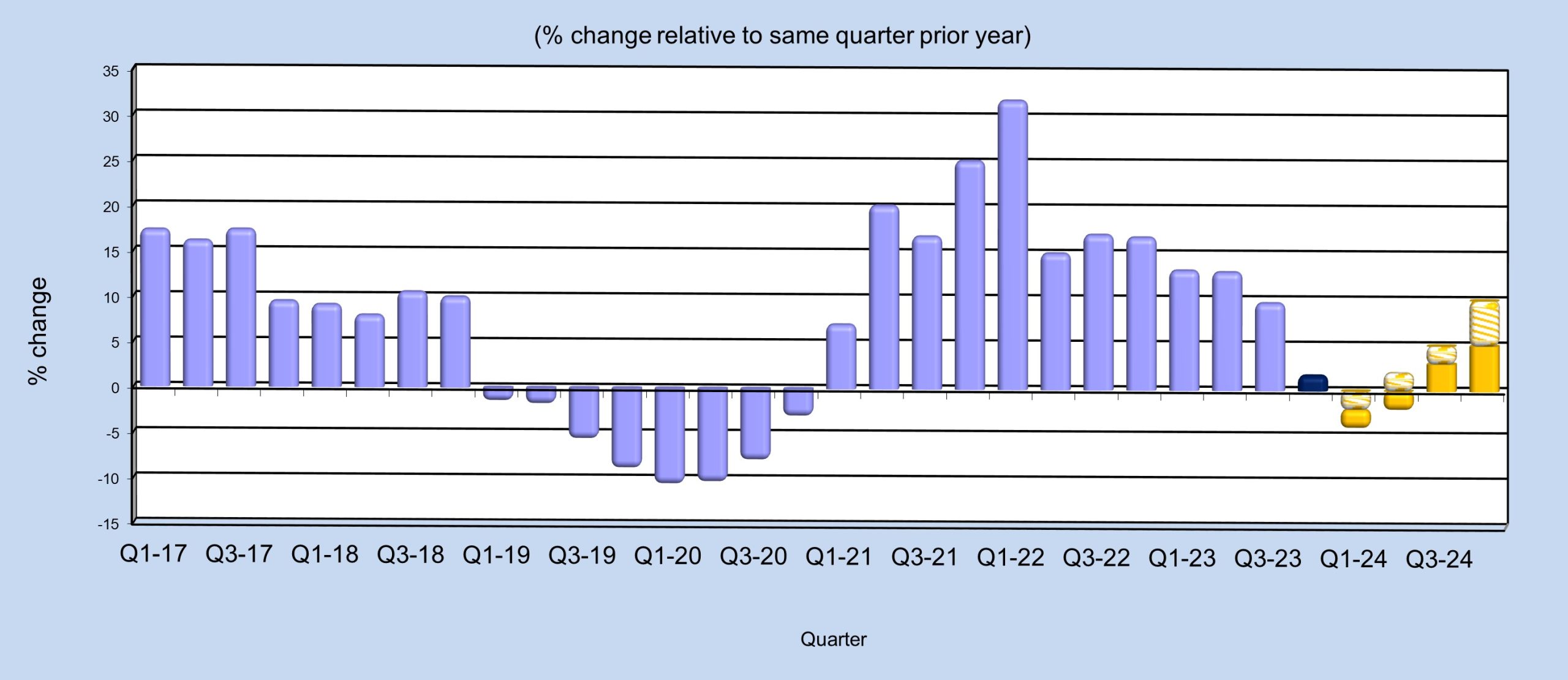
2024 total forecast 1.6% (min) to 4.1% (max)
At the end of 2022, ECSN suppliers were preparing for 2023 with strong order books and confidence in customer demand and an expectation that prices will generally be maintained. Another prediction for 2023 was that growth in the first half of this year was likely but the second half would be less certain as pent-up demand for 5G and smart vehicle infrastructure systems could bear fruit. The book-to-bill ratio was expected to remain strong in 2023 as lead times returned to more normal levels albeit with some shortages expected. All of this came to pass despite uncertainties such as product availability, global trade and political tensions and falling consumer confidence. At the time, Dunford maintained that authorised distributors are “key to helping the industry find its way through uncertainties”.
Component market sales in 2023 were high with a DTAM of £1886m and a TAM of £4254m, compared to £1722 (DTAM) and £3938m (TAM) in 2022.
For 2024, ECSN members are cautious, based on many statistics. Firstly, inventory is still high, making it difficult to judge demand. Price pressures will be minimal and price levels achieved in 2023 are expected to be maintained. A flat first half is expected, supported by the HM Treasury’s comparison of independent forecasts predicts UK economy average growth of 0.5% for 2023 and 0.4% for 2024. The second half of the year will depend on trade and political tensions, with the added unrest in the Middle East and what effect that will have, not least in terms of oil price rises.
There is still a demand for 5G and vehicle infrastructure systems and some strong demand particularly in the industrial sector as UK manufacturing output rises. There are indications that some market sectors will remain strong, said Dunford, but the overall picture is uncertain. A growth in UK consumption may not be reflected in sales in 2024. It is important to note, said Dunford that manufacturers do not know how much stock is out there, as double ordering of inventory through the pandemic is still to be worked through. The DTAM quarter-on-quarter growth since 2021 is related to price increases in a commodity market rather than increased unit sales, he added.
The one seeming certainty is moderate growth in the first half of 2024, said Dunford, followed by a slight to moderate (~1.4% growth), he estimated.
Jayce
/include/upload/kind/image/20231204/20231204171652_2573.jpg
Last year, Aubrey Dunford, the ECSN (Electronic Components Supply Network) market analyst declared the UK electronics components market had returned to normality. At this year’s Electronics Components Forecast, he reclassified its status as a new,
2023/12/4 17:18:00
2023/12/4 17:18:00
85
0
486
6
Q4 Return to Growth for Smartphone Market
Q4 smartphone shipments will see 7.3% y-o-y growth, says IDC. “The tide has finally turned, ” says IDC’s Nabila Popal.
The market recovery will continue in 2024 with 3.8% growth expected, followed by low single-digit growth for 2022-27 for a 1.4% five-year CAGR.
For the whole of 2023, smartphone shipments are forecast to decline 3.5% y-o-y to 1.16 billion units.
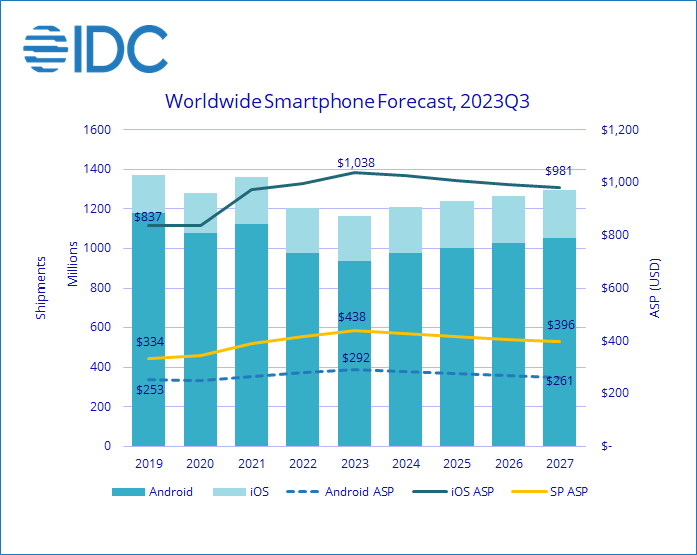
Smartphone ASP is expected to rise 5.5% in 2023 to $438, marking a fourth consecutive year of growth as the premium market continues to grow across all regions.
However, ASP growth is expected to taper off and gradually decline to $396 by 2027, which remains higher than prior forecasts.
iOS market share grew 0.6% growth in Q3, achieving a record share of 19.6% this year, while Android is forecast to decline 4.4%.
Over the long term, Android will grow slightly faster than iOS, increasing its share of the market to 81.3% by the end of the forecast period.
Jayce
/include/upload/kind/image/20231201/20231201180729_5707.png
Q4 smartphone shipments will see 7.3% y-o-y growth, says IDC. “The tide has finally turned, ” says IDC’s Nabila Popal.
The market recovery will continue in 2024 with 3.8% growth expected, followed by low single-digit growth for 2022
2023/12/1 18:08:39
2023/12/1 18:08:39
85
0
485
6
iPhone Assembly Shifting to India
Foxconn is expected to increase its Indian production of iPhones from 12-14% in 2023 to 20-25% in 2024.
Earlier this week the company filed a securities notice in Taiwan that it would build a plant costing $1.54 billion at an unnamed location in India, reported The Nikkei.
According to reports in the Taiwan press, the plant will be used for iPhone production.
It was also reported that the Indian plant would be used for iPhone product development and test production.
Currently 90% of iPhone assembly is done in China and Foxconn accounts for 60-70% of iPhone assembly.
Foxconn has been assembling iPhones in India since 2019 at Sunguvarchatram but it has been a less profitable operation than at its assembly plants in China because of higher material costs and a higher percentage of defective phones.
Jayce
/include/upload/kind/image/20231130/20231130190038_2423.jpg
Foxconn is expected to increase its Indian production of iPhones from 12-14% in 2023 to 20-25% in 2024.
Earlier this week the company filed a securities notice in Taiwan that it would build a plant costing $1.54 billion at an unnamed
2023/11/30 19:01:00
2023/11/30 19:01:00
98
0
484
6
European tech funding dropping but better than elsewhere
Tech investment in Europe will amount to about $45 billion this year compared to $82 billion last year, says a report from Atomico.
Worst hit will be companies at the growth stage requiring late-stage capital injections to scale up.
But Europe is the only region where investment has risen from 2020 levels – by 18% – whereas the US expected figure of $120 billion is a 1% drop from 2020 and the figures for China and RoW are expected to drop by 7% and 8%, respectively.

Investment in European late-stage tech startups has almost dried up as the IPO market makes exits unappealing.
Looking at funds which invest in both public and private companies – so-called cross-over funds – Atomico found only four such investments this year compared with 82 in 2021.
Over the past 12 months, raising capital was the most frequently cited challenge by founders and senior startup leaders, with 38% saying it was their biggest challenge. Securing customers was next on the list of anxieties, with 37% saying it was their biggest challenge.
Founders aren’t particularly bullish for 2024 — 41% said raising capital would be one of their biggest challenges and 44% said securing customers would be

While the rate that founders are starting new companies has fallen 30% since its peak in 2020, there are more new first-time founders in Europe than there are in the US.

Jayce
/include/upload/kind/image/20231129/20231129182254_9854.png
Tech investment in Europe will amount to about $45 billion this year compared to $82 billion last year, says a report from Atomico.
Worst hit will be companies at the growth stage requiring late-stage capital injections to scale up.
2023/11/29 18:23:01
2023/11/29 18:23:01
92
0
483
6
Single-Crystal Material for Electrolytes in Solid State Batteries
Koike of Japan and the Japan National Institute of Advanced Industrial Science and Technology (AIST) have come up with a single-crystal material that could be used as an electrolyte in solid-state batteries.
The company will soon begin sampling battery manufacturers, with production envisaged in 2027/28.
When used for a battery electrolyte the new material material is claimed to reduce electrical resistance by nine-tenths.
To prevent degradation, a liquid is applied to the electrodes, making the battery a type of “semisolid-state” battery that uses both solids and liquids.
Used in such a battery in a pacemaker, the material could extend pacemakers’ battery life from 10-15 to 50 years.
Koike makes monocrystalline wafers and has developed monocrystals with a diameter of 25mm for batteries.
Jayce
/include/upload/kind/image/20231127/20231127174542_4254.jpg
Koike of Japan and the Japan National Institute of Advanced Industrial Science and Technology (AIST) have come up with a single-crystal material that could be used as an electrolyte in solid-state batteries.
The company will soon beg
2023/11/27 17:45:50
2023/11/27 17:45:50
99
0
480
6
Smartphone Market Returns to Growth
Over the last eight quarters shipments have been:
The smartphone market turned up in October, says Counterpoint Research which is the first month it has grown y-o-y for two years. For Q3, Counterpoint is forecasting the first growth quarter for eight quarters.
October shipments grew 5% y-o-y which is the first month in 27 consecutive months since June 2021 to show y-o-y growth.
2021 Q4 371.4
2022: Q1 326.4 Q2 294.5 Q3 301.9 Q4 303.9
2023: Q1 280.2 Q2 268 with a forecast for Q3 of 299.8
Propelling October’s growth was a recovery in smartphone sales in the emerging markets – notably an upswing in the Middle East and Africa, a resurgence by Huawei in the China market and the arrival of the festive season in India.
“Following strong growth in October, we expect the market to grow year-on-year in the fourth quarter of 2023 as well, setting the market on the path to gradual recovery in the coming quarters,” the market research firm said.
For the full year, Counterpoint’s forecast is:
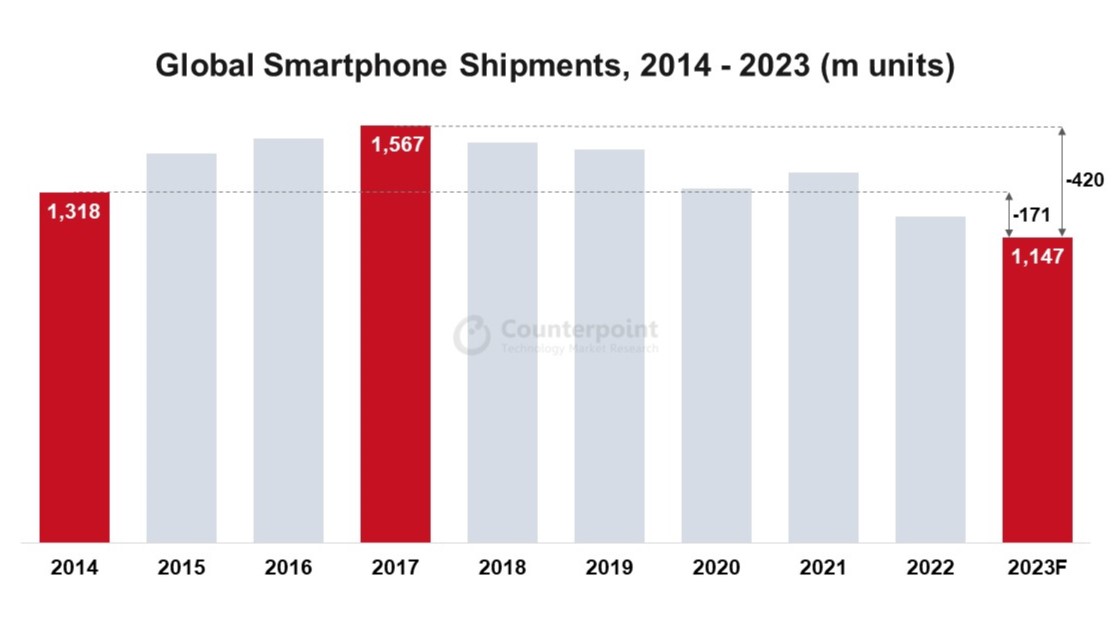
Jayce
/include/upload/kind/image/20231123/20231123171959_8559.jpg
Over the last eight quarters shipments have been:
The smartphone market turned up in October, says Counterpoint Research which is the first month it has grown y-o-y for two years. For Q3, Counterpoint is forecasting the first growth
2023/11/23 17:21:12
2023/11/23 17:21:12
80
0
479
6
Semis Down 12% This Year; Up 20% Next Year
Driving growth are: inventory depletion in PCs, smartphones, automotive and industrial; electrification in automotive and industrial; AI PCs and AI smartphones and rising memory ASPs.
Wafer capacity pricing is expected to remain flat next year as foundry suppliers gradually improve utilisation rates and demand returns from their core fabless customers.
CapEx is expected to improve by 2H24 as revenue shipments match end demand and regional ChipAct incentives stimulate investment across the supply chain.
By 2026, IDC expects that AI silicon will account for almost $200 billion in semiconductor revenues.”
Jayce
/include/upload/kind/image/20231120/20231120225140_1673.png
The 2023 semiconductor market will be worth $526 billion – down 12% from the $598 billion of 2022 – and the 2024 market will grow 20% to $633 billion, says IDC.
2023/11/20 22:51:59
2023/11/20 22:51:59
87
0
477
6
Leti to hook up with LSTC on 1nm
“Leti and the LSTC wish to establish a long-term and sustainable collaboration in different advanced semiconductor fields, including materials, devices, processes, and technology,” says Leti, “the aim is to further strengthen global collaboration in the semiconductor industry over the next decade and to jointly define long-term R&D roadmaps.
Leti’s role will be in the development of new transistor structures for 1.4-1nm processes.
Rapidus is currently working with IBM and Imec on developing a 2nm process. Rapidus intends to have a 2nm pilot line running in April 2025 and a volume 2nm line in Hokkaido in 2027.
Jayce
/include/upload/kind/image/20231117/20231117173941_9892.jpeg
Leti is to join Japan’s Leading-Edge Semiconductor Technology Centre (LSTC) consisting of Tokyo University, Japan’s Riken Institute, various other Japanese universities and Rapidus, the Japanese startup aiming for a 2nm process, reports the Nikkei.
2023/11/17 17:39:57
2023/11/17 17:39:57
84
0
476
6
Infineon FY2023 Revenues Up 15% Y-o-Y
The company expects revenues of €17 billion at a 24.2% margin in 2024.
For FY 2023 to September 30, Infineon had revenues if €16.309 billion, up 15% on FY 2022 for a profit up 30% y-o-y at €4.399 billion with a margin of 27% and free cash flow of €1.158 billion.
Free Cash Flow adjusted for investment in frontend buildings and the acquisition of GaN Systems should be around €2.2 billion and reported Free Cash Flow around €400 million
For calendar Q4 (fiscal Q1) Infineon expects revenues of around €3.8 billion at a margin of 22%.
“In the 2023 fiscal year, Infineon has set new records for revenue and profitability. The results are an initial confirmation of our more ambitious course we embarked on as a company a year ago,” says Jochen Hanebeck, CEO of Infineon (pictured) “nevertheless, we find ourselves in an environment that continues to present challenges. We are seeing different trends in our target markets. Structural semiconductor growth in the areas of renewable energy, electromobility – especially in China – and microcontrollers for the automotive industry remains unabated. In contrast, consumer, communication, computing and IoT applications are experiencing a temporary period of low demand. Overall, we are expecting revenue growth to continue in the 2024 fiscal year but at a slower rate. We are reacting decisively to the market situation. At the same time, we are continuing to implement our strategy consistently with regard to structural growth opportunities and we are reinforcing our leading position in power systems and IoT with long-term investments.”
Jayce
/include/upload/kind/image/20231116/20231116180242_6771.png
Infineon had calendar Q3 (fiscal Q4) revenue of €4.149 billion for a profit of €1.044 billion at a margin of 25.2% with free cash flow of €614 million.
2023/11/16 18:02:51
2023/11/16 18:02:51
87
0
475
6
Sales of systems, chips and front-end IC manufacturing equipment up, but back-end down
Q4 sales of electronics are forecast to rise 22% q-o-q after a 7% rise in Q3, says SEMI, and IC sales are expected to rise 4% sequentially after improving 7% in Q3 2023 as end demand improves and inventories normalise
However, despite the improvement in electronics and IC sales, semiconductor manufacturing indicators remain soft. Fab utilization rates and capital expenditures continue to decline in the second half of this year.
Overall, CapEx on non-memory is expected to outperform memory in 2023, but even spending in the non-memory segments has begun to weaken.
Total capital expenditures in Q4 2023 are hovering at the levels seen in Q4 2020.

While overall semiconductor capital equipment sales are declining in line with capital expenditures, the contraction in wafer fab equipment spending has turned out to be much shallower than expected this year. Furthermore, back-end equipment billings are projected to increase in Q4 2023.
“While semiconductor markets have seen year-over-year declines the last five quarters, year-over-year growth is expected to return in the fourth quarter of 2023 as production cuts have worked their way through the supply chain,” says TechInsights’ Boris Metodiev, “on the other hand, front-end equipment sales have been performing much better than the IC market, buoyed by government incentives and the filling of backlogs, strength expected to continue next year.”
“Despite low fab utilisation rates and slowing capital expenditures in the second half of 2023, we expect back-end equipment billings to bottom in Q4 2023,” says SEMI’s Clark Tseng, “this will mark an important turnaround for the chip manufacturing industry, signaling a recovery from the downturn with building momentum in 2024.”
Jayce
/include/upload/kind/image/20231115/20231115175303_4015.jpg
Sales of electronics products, ICs and front-end manufacturing equipment are moving upwards, while the market for back-end manufacturing equipment remains weak, says SEMI.
2023/11/15 17:53:05
2023/11/15 17:53:05
78
0
474
6
TSMC October revenues up 34.8% q-o-q
TSMC had October revenues of $7.8 billion up 34.8% from the $5.6 billion revenues of September 2023 and an increase of 15.7% from the October 2022 revenues of $6.5 billion.
Revenue for January through October 2023 totalled $57.26 billion, a decrease of 3.7% compared to the $59 billion revenues for the same period in 2022.
TSMC October Revenue Report (Consolidated):
(Unit: NT$ million)

Jayce
/include/upload/kind/image/20231114/20231114174725_3703.jpg
TSMC had October revenues of $7.8 billion up 34.8% from the $5.6 billion revenues of September 2023 and an increase of 15.7% from the October 2022 revenues of $6.5 billion.
Revenue for January through October 2023 totalled $57.26
2023/11/14 17:48:12
2023/11/14 17:48:12
108
0
473
6
Vishay to acquire Nexperia’s Newport Wafer Fab for $177m
Discrete semiconductor and passive electronic component maker Vishay Intertechnology Inc of Malvern, PA, USA has agreed to acquire Newport Wafer Fab in South Wales, UK from Nexperia B.V. of Nijmegen, The Netherlands (a subsidiary of Wingtech Technology Co Ltd) for $177m in cash. ATREG Inc, the Seattle-based global firm for initiating, brokering and executing the exchange of semiconductor manufacturing assets, served as Nexperia’s transaction advisors.
Located on 28 acres and the largest semiconductor manufacturing plant in the UK, Newport is an automotive-certified, 200mm wafer fab that supplies primarily automotive markets.
“Under new leadership in early 2023, Vishay set an ambitious goal of investing approximately $1.2bn in capacity over a three-year period in order to position the company to seize the opportunities created by the megatrends of e-mobility and sustainability needed for a Net Zero economy,” says president & CEO Joel Smejkal. “While this transaction is supplemental to our capex investment strategy, adding Newport Wafer Fab to our manufacturing footprint will be instrumental to achieving our goal of expanding capacity for our customers and to accelerating our SiC [silicon carbide] strategy,” he adds.
“By agreeing to acquire Newport Wafer Fab, our goal is to safeguard the positions of the highly skilled and dedicated employees and to invest the necessary capital to set up production for our SiC trench MOSFETs and diodes. With its solid balance sheet and ample liquidity, Vishay will immediately bring stability and its reliable cash flow generation to ensure the facility becomes a fully operational and profitable fab” reckons Smejkal.
“For Vishay, acquiring Newport Wafer Fab brings together our capacity expansion plans for our customers in automotive and industrial end markets as well as the UK’s strategic goal of improved supply chain resilience. In addition to expanding capacity, we intend to collaborate with the Compound Semiconductor Cluster in South Wales and to join with key stakeholders committed to developing the semiconductor industry in the UK including university and community partners in the UK and particularly South Wales,” concludes Smejkal. “We look forward to welcoming Newport Wafer Fab’s employees into Vishay and to partnering with local authorities and the Welsh and UK Governments to both ensure long-term growth for the fab and deliver value to our customers and stockholders.”
“Vishay’s board made a critical decision last year to pivot the company toward profitable growth under new leadership, leveraging the company’s solid cash flow generation, sound operational capabilities and broad product portfolio,” notes executive chairman Marc Zandman. “A key element of this strategic shift is the investment in technologies and incremental capacity to position Vishay to capitalize on the megatrends in e-mobility and sustainability. Acquiring Newport Wafer Fab demonstrates Vishay’s commitment to executing this strategic shift,” he adds.
“Nexperia would have preferred to continue the long-term strategy it implemented when it acquired the investment-starved fab in 2021 and provided for massive investments in equipment and personnel,” says Toni Versluijs, country manager Nexperia UK. “However, these investment plans have been cut short by the unexpected and wrongful divestment order made by the UK Government in November 2022. The UK Government’s order, in combination with a weakness in the global semiconductor market, recently led us to announce the intention to reduce the number of employees at the site by at least 100. The site needs clarity about its future to avoid further losses,” he adds. “Of all options, this agreement with Vishay is the most viable one to secure the future of the site as Vishay – like Nexperia – has a solid customer base for the fab’s capabilities. For the site, Vishay’s commitment to further make the Newport Wafer Fab a success story is encouraging. Nexperia’s position with regards to the UK Government’s order remains unchanged.”
The closing of the Newport Wafer Fab transaction is subject to UK government review, the purchase rights of a third party, and customary closing conditions, and is expected to occur in first-quarter 2024.
Nexperia states that, while working to ensure that all conditions to the sale are met as soon as possible, it will continue to own and manage the site and support the employees.
Jayce
/include/upload/kind/image/20231113/20231113175418_8535.jpg
Discrete semiconductor and passive electronic component maker Vishay Intertechnology Inc of Malvern, PA, USA has agreed to acquire Newport Wafer Fab in South Wales, UK from Nexperia B.V. of Nijmegen, The Netherlands (a subsidiary of Wingtech Techno
2023/11/13 17:54:21
2023/11/13 17:54:21
81
0
471
6
Vishay Buys Newport Wafer Fab
Vishay is to buy Newport Wafer Fab after years of wrangling over whether it could be owned by Nexperia which is owned y the Chinese company Wingtech.
Vishay paid $177 million cash for the company. Nexperia bought it in 2021 for $63 million. Vishay will set up a SiC line to make Trench MOSFETs and diodes.
“Adding Newport Wafer Fab to our manufacturing footprint will be instrumental to achieving our goal of expanding capacity for our customers and to accelerating our SiC strategy,” says Vishay CEO Joel Smejkal, “Vishay will immediately bring stability and its reliable cash flow generation to ensure the facility becomes a fully operational and profitable fab.”
“Of all options, this agreement with Vishay is the most viable one to secure the future of the site, as Vishay – like Nexperia – has a solid customer base for the fab’s capabilities,” said Nexperia’s UK country manager Toni Versluijs.
Jayce
/include/upload/kind/image/20231110/20231110174046_2263.jpg
Vishay is to buy Newport Wafer Fab after years of wrangling over whether it could be owned by Nexperia which is owned y the Chinese company Wingtech.
Vishay paid $177 million cash for the company. Nexperia bought it in 2021 for
2023/11/10 17:41:03
2023/11/10 17:41:03
101
0
470
6
Q3 wafer shipments fall 9.6% q-o-q
“The decline in global silicon shipments continued as a result of the ongoing broad-based inventory correction cycle,” said Anna-Riikka Vuorikari-Antikainen, Chairman of SEMI Silicon Manufacturing Group, “silicon wafer shipments for the computing, communications, consumer and memory markets saw the most pronounced declines due to a softening in demand and continuing economic uncertainties, while the automotive and industrial sectors were resilient during this period.”
Millions of Square Inches

Data cited in this release include polished silicon wafers, including those used as virgin test wafers, as well as epitaxial silicon wafers, and non-polished silicon wafers shipped by the wafer manufacturers to end users.
Jayce
/include/upload/kind/image/20231109/20231109173212_9497.jpeg
Q3 wafer shipments for semiconductor applications fell 9.6% q-o-q to 3,010 million square inches, a 19.5% drop from the 3,741 million square inches recorded in Q3 2022, says SEMI.
2023/11/9 17:33:10
2023/11/9 17:33:10
81
0
469
6
EV battery market growing at 16.9% 2022-28
The battery cell supply chain is primarily led by Asian players: China accounting for 57%, with South Korea at 25% and Japan at 7% following.
In the coming years, there will be a growing need to recycle tons of end-of-life xEV battery packs.
The total annual demand for lithium-ion battery packs used in PHEVs and BEVs is projected to experience substantial growth, surging from approximately 430 GWh in 2022 to roughly 1,500 GWh by 2028, says Yole.ev
This represents a more than threefold increase in demand. The primary driver of this demand will be BEV applications, which are expected to require a battery capacity of 1,370 GWh, constituting 90% of the total market in terms of GWh by 2028.
“The overall annual market for Li-ion battery packs designed for BEVs and PHEVs is anticipated to expand from about $70 billion in 2022 to approximately $180 billion by 2028,” says Yole’s Shalu Agarwal, “in 2022, CATL from China is the leading manufacturer of EV battery cells, followed by LG Energy Solution, BYD from China, and Panasonic from Japan. While Europe focuses on establishing local cell suppliers, US automakers primarily collaborate with Asian suppliers, like Tesla partnering with Panasonic, LG Energy Solution, and CATL, and GM Motors with LG Energy Solution.”
Battery production capacity is rapidly expanding, with manufacturers announcing expansion plans, particularly in regions with xEV manufacturing facilities.
Many Chinese players, including BYD, CATL, Gotion, and EVE, plan to increase capacity in countries like India, Indonesia, Thailand, and Vietnam.
BATTERY PACK FOR AUTOMOTIVE 2021-2022 MARKET SHARES

The urgent need for increased battery cell manufacturing capacity arises due to the surging demand for EVs.
Projections suggest global battery manufacturing capacity will exceed 6 TWh by 2030, four times the demand, although some announced projects may never materialize.
However, overreliance on China could pose long-term challenges for startups and smaller battery manufacturers.
Europe and the USA face cost disadvantages in the EV battery industry compared to China, mainly due to higher manufacturing costs.
This cost discrepancy is linked to lower material costs in China, driven by advanced supply chains with vertical integration of material supply, processing, and manufacturing.
The relationship between car OEMs and cell suppliers is complex and often involves multiple partnerships. Vertical integration in battery manufacturing is increasing for cost efficiency and supply security reasons.
Both cell makers and automakers are seeking strategic deals with raw material mining companies to secure their supply chains.
Low cobalt-content batteries like NMC 811 and cobalt-free LFP batteries are highly sought-after cell chemistries. Initially used by Chinese companies, LFP cells are now adopted by various global automakers.
The trend is shifting towards a cell-to-pack approach to enhance energy density and reduce weight in battery packs, with some companies like Tesla, BYD, and Leap Motor integrating cells directly into the vehicle chassis.
Battery recycling has become a strategic focus for many battery manufacturers and car OEMs. Players are venturing into the recycling sector through subsidiaries, in-house processes, partnerships, or joint ventures with battery recyclers.
Jayce
/include/upload/kind/image/20231108/20231108174150_5044.jpg
The market for Li-ion battery packs for BEV and PHEV will grow to about $180 billion in 2028, with a 16.9% CAGR 22-28, says Yole Developpement.
2023/11/8 17:43:56
2023/11/8 17:43:56
78
0
468
6
ST further pitches 32bit MCUs against 8bit MCUs
ST is trying harder to displace 8bit MCUs with its entry-level 32bit STM32C0 series by boosting flash to 128kbyte and adding a USB controller.
The devices will be called STM32C071, are scheduled to arrive by mid-2024, to be followed by 256kbyte flash STM32C091 models sampling later that year.
This is not to say that the company is deserting 8bit MCUs: “ST remains dedicated to its STM8 series,” it said. “Some companies need the eerprom available in our 8bit MCUs, while others depend on the AEC-Q10x automotive qualification of some of our devices.”
While the smallest 32C0 has 16kbyte flash and 6kbyte ram, STM32C071 will put 24kbyte of ram alongside its 128kbyte of flash.
“Products that had to adopt significantly more expensive devices because of memory constraints can now exist in entry-level markets and, because we anticipate a lot of these systems to use USB to deliver power, we added a crystal-less USB controller.”
Interfaces for SPI and I2C, and a 32bit timer will also be included. Pin-out similarities with the next-level-up STM32G0 series will be retained, said the company.
The processor remains the same: a 48MHz Arm Cortex-M0+ that scores 114 in the EEMBC CoreMark benchmark.
C0 series MCUs are planned in packages as small as 3 x 3mm 20pad QFN or WLCSP12. Mass quantities of STM32C0 devices are available today in packages including SO8N, TSSOP20, LQFP32 and LQFP48.
Jayce
/include/upload/kind/image/20231107/20231107173848_1829.jpg
The devices will be called STM32C071, are scheduled to arrive by mid-2024, to be followed by 256kbyte flash STM32C091 models sampling later that year.
This is not to say that the company is deserting 8bit MCUs: “ST remains dedicated
2023/11/7 17:39:26
2023/11/7 17:39:26
80
0
465
6
NXP to Implement Distributed Aperture Radar for Automated Driving
“Distributed aperture radar offers a path to enhance the resolution of radar systems while eliminating the need for thousands of antenna channels,” according to NXP. “It coherently fuses information from multiple radar sensors on a vehicle to create a larger effective antenna. The technology enables angular resolution below 0.5°, offering lidar-like performance for precise mapping of the environment – conventional radar sensors operate between 2 and 4°.”
The start-up is Zendar
“Distributed aperture radar technology is fundamentally early fusion from distributed radar modules,” said Zendar CEO and founder Vinayak Nagpal. “The lidar-like performance is a breakthrough for next-generation ADAS.”
Both cameras and lidar can be fooled by rain, fog and dusty conditions. Radar is immune to these, is less expensive, but has far lower resolution that might not reveal the shape of objects.
Zender concept combines the outputs of multiple inexpensive radar front-ends in a central computer, and claims that is can achieve 10x resolution compared with conventional radar, and it is able to “provide high fidelity information, enabling higher levels of autonomy and ADAS under all weather conditions.”
In the NXP case, the software will be implemented on NXP’s SAF8x ICs that combine multiple RF channels with microcontroller cores and specialist radar processing accelerators, and its S32R radar processors.
The combined ICs and software is being offered to vehicle OEMs and Tier 1 suppliers. “Application development can start immediately, and the launch is expected to be scheduled for next-generation OEM platforms,” said NXP.
Jayce
/include/upload/kind/image/20231103/20231103174008_4439.jpg
NXP has invested in a high-resolution distributed aperture radar software start-up, and will use its software in ICs for vehicle radar.
2023/11/3 17:41:08
2023/11/3 17:41:08
92
0
464
6
Global Semiconductor Sales Increase 1.9% Month-to-Month in September
Global sales in Q3 2023 6.3% higher than Q2 2023 and 4.5% lower than Q3 2022
WASHINGTON—Nov. 1, 2023—The Semiconductor Industry Association (SIA) today announced global semiconductor sales for the month of September 2023 increased 1.9% compared to August 2023 and fell 4.5% compared to September 2022. Worldwide sales of semiconductors totaled $134.7 billion during the third quarter of 2023, an increase of 6.3% compared to the second quarter of 2023 and down 4.5% compared to the third quarter of 2022. Monthly sales are compiled by the World Semiconductor Trade Statistics (WSTS) organization and represent a three-month moving average. SIA represents 99% of the U.S. semiconductor industry by revenue and nearly two-thirds of non-U.S. chip firms.
“Global semiconductor sales increased on a month-to-month basis for the seventh consecutive time in September, reinforcing the positive momentum the chip market has experienced during the middle part of this year,” said John Neuffer, SIA president and CEO. “The long-term outlook for semiconductor demand remains strong, with chips enabling countless products the world depends on and giving rise to new, transformative technologies of the future.”
Regionally, month-to-month sales increased in Asia Pacific/All Other (3.4%), Europe (3.0%), the Americas (2.4%), and China (0.5%), but decreased slightly in Japan (-0.2%). Year-to-year sales increased in Europe (6.7%), but decreased in the Americas (-2.0%), Japan (-3.6%), Asia Pacific/All Other (-5.6%) and China (-9.4%).
Jayce
/include/upload/kind/image/20231102/20231102175305_5793.jpg
Global sales in Q3 2023 6.3% higher than Q2 2023 and 4.5% lower than Q3 2022
WASHINGTON—Nov. 1, 2023—The Semiconductor Industry Association (SIA) today announced global semiconductor sales for the month of September 2023 increased
2023/11/2 18:02:31
2023/11/2 18:02:31
76
0
463
6
Renesas ships its first Cortex M85 microcontrollers
Initial parts are general-purpose and consigned to what Renesas has named the RA8M1 group of the RA8 series.
Common specs of RA8M1 parts are: 480MHz Cortex-M85 with Helium and TrustZone, 1 or 2Mbyte programme flash, 12kbyte data flash, 1Mbyte sram, octal SPI with execute-in-place and decryption-on-the-fly, CAN-FD, Ethernet, USB (full/high speed), 16bit camera interface and I3C serial. Package options are 224pad BGA, or LQFP with 100, 144 or 176 pads.
Eight parts in total have been introduced, giving all four package options, with 1 or 2Mbyte of programme flash.
“Renesas today introduced the world’s most powerful microcontrollers,” it claimed, “delivering performance over 3000 CoreMark points, and deterministic low-latency real-time operation. RA8 Series MCUs are the industry’s first to implement the Arm Cortex-M85 processor, enabling the devices to deliver 6.39 CoreMark/MHz. This performance will allow designers to use the MCUs in applications that previously required microprocessors.”
Arm’s Helium vector extension are included for DSP and machine learning algorithms, said by Renesas to make such processing four times faster compared with using a Cortex-M7 processor.
“RA8 series MCUs enable edge and end-point devices to implement natural language processing in voice AI and predictive maintenance applications, using Helium to accelerate the neural network processing,” it added.
Security is high on the last of priorities with these MCUs: the company has designed RA8 series for PSA Certified Level 2 + secure element, NIST CAVP, and FIPS 140-3 certification.
To support this, Arm’s TrustZone provides a protected hardware environment for hypervisor code, and Renesas’ ‘RSIP-E51A’ hardware accelerates cryptography (AES, RSA, ECC, HASH, 128bit ID) and supports secure boot.
“Other security features include immutable storage for a hardware root-of-trust, octal SPI with decryption-on-the-fly, secure authenticated debug, secure factory programming and tamper protection,” said Renesas. The Armv8.1-M architecture employed in the core introduces pointer authentication and branch target identification (‘PACBTI’, see below) security extension to mitigate “software attacks targeting memory safety violations and memory corruptions”.
To reduce power consumption, independent power domains have been implemented as well as low power modes and fast wake-up.
For development, the ‘RA8M1 group evaluation kit’ (RTK7EKA8M1S00001BE, right) is shipping.
Jayce
/include/upload/kind/image/20231101/20231101181033_3502.jpg
Renesas has revealed more on the Arm Cortex-M85 based microcontrollers it announced at Embedded World in May, and started shipping them today.
2023/11/1 18:11:16
2023/11/1 18:11:16
98
0
462
6
Better Q3 for Intel
It expects Q4 revenue to resume growth to reach $14.6 billion to $15.6 billion.
“We delivered a standout third quarter, underscored by across-the-board progress on our process and product roadmaps, agreements with new foundry customers, and momentum as we bring AI everywhere,” said CEO Pat Gelsinger.
Profit was $297 million down from $1.02 billion in Q3 2022. Margin was 45.8%.
Opex was down 15% y-o-y and Intel says it will cut costs by $3 billion this year.
PC sales were down 3% to $7.9 billion.
Data Centre sales were down 10% to $3.8 billion.
Mobileye sales grew 18% to $530 million.
Intel foundry services had sales of $311 million – up up nearly 300% y-o-y.
Network and edge division sales fell 32% to $1.5 billion.
Jayce
/include/upload/kind/image/20231030/20231030174407_9984.jpg
Intel had Q3 revenues of of $14.2 billion, down 8% from $15.3 billion in Q3 2022 and its seventh consecutive quarter of revenue decline.
2023/10/30 17:44:32
2023/10/30 17:44:32
81
0
460
6
Electronics production trending up
According to IDC, smartphone shipments versus a year ago turned negative in 3Q 2021 at -6%. The decline hit a low of -18% in 4Q 2022.
Since then, smartphones have been recovering. IDC data is not yet available, but Canalys estimated 3Q 2023 smartphone shipments were down only 1% from a year earlier.
4Q 2022 shipments should follow the typical pattern of an increase from 3Q shipments, which would result in a mid-single-digit year-to-year increase.
IDC’s August forecast called for a 4.7% decline in full year 2023 smartphone shipments.

PCs are also on an uptrend. IDC estimated global PC unit shipments in 3Q 2023 were down 7.6% from a year earlier, a substantial improvement from the low of the 29% year-over-year decline in 1Q 2023.
Again, based on typical fourth quarter versus third quarter trends, PC shipments in 4Q 2023 should increase by mid to high single-digits versus 4Q 2022.
IDC’s PC forecast in August was a 14% decline for the full year 2023. The IDC forecast will likely be revised upward based on the 3Q 2023 data.
As the largest producer of electronic devices, China is key to understanding trends. August 2023 data shows China’s three-month-average electronics production in local currency (yuan) was up 2.6% from a year ago, the highest rate in eight months.
Limited data on smartphone production shows August 2023 three-month-average units were down a slight 0.6% from a year ago, a major improvement from an 11.6% decline in March 2023.

China PC production is still weak, with August 2023 three-month-average units down 17% from a year ago. August is the twelfth consecutive month of double-digit declines.
However, several major PC makers are in the process of shifting some PC production out of China. Of the four largest global PC suppliers, number one Lenovo is based in China while numbers two through four (HP, Dell, and Apple) are based in the U.S. As reported by Nikkei Asia in July 2023,
HP plans to shift much of their laptop production out of China to Mexico, Thailand and Vietnam. The production outside of China could be up 5 million units in 2023, close to 10% of HP’s total PCs.
In January 2033, PCMag reported Dell may move up to 50% of its PC production out of China by 2025. Also in January, Forbes stated Apple plans to shift much of the production of its MacBook PCs from China to Vietnam.
These moves are primarily due to the impact of the COVID-19 pandemic and increasing trade tensions between the U.S. and China. While these production shifts are ongoing, Chinese data on PC production will not be a reliable indicator of global PC trends.
Electronics production in local currency for major Asia countries is primarily on an uptrend. As mentioned, China’s three-month-average electronics production in August versus a year ago accelerated to 2.6%.
Taiwan production was up 9% in August, the strongest growth in eight months.
In September, Vietnam production increased 0.6%, an improvement from seven consecutive months of year-on-year declines.
South Korea reported a 6% decline in August, but it was an improvement from double-digit declines the previous three months.

Japan’s August production was up a healthy 6.8% but decelerating from double-digit growth in the prior three months.
Electronics production in the U.S. and Europe is generally on a trend of decelerating growth. U.S. three-month-average production in August grew 1.2% from a year ago.
This marked the ninth consecutive month of decelerating growth since a peak of 8.1% in November 2022.
The 27 countries of the European Union (EU 27) reported 2.2% production growth in July, continuing a trend of single-digit growth following seven months of double-digit growth in May through November of 2022. UK production growth slowed to 1.1% in August after growth in the 7% to 17% range in the previous thirteen months.
Differences in the type of electronic devices manufactured in the U.S. and Europe compared to Asia account for some of the differences in production trends.
Asian countries mostly produce smartphones, PCs, televisions, and other consumer electronic devices. Production in the U.S. and Europe is more heavily weighted toward electronic devices sold to business – such as enterprise computing, data centers, communications infrastructure, and industrial electronics.

Based on the above trends, the electronics and semiconductor markets are primed for solid growth in 2024.
Jayce
/include/upload/kind/image/20231025/20231025174936_9083.jpeg
Production of electronic devices is finally on the uptrend following a post-pandemic slump in late 2022, says Semiconductor Intelligence.
2023/10/25 17:49:37
2023/10/25 17:49:37
116
0
458
6
New Approach For Battery Recycling, Using Less Energy And Less Hazardous Chemicals
University of Birmingham researchers have announced a new approach for recycling the highest value component of end-of-life electric car batteries, the battery cathode, that is less energy-intensive and uses less hazardous chemicals than current recycling methods.
Their novel method uses organic acid such as ascorbic acid (Vitamin C) as a leaching agent, and has been tested on cathode material from a first generation Nissan Leaf battery cell that had powered 40,000 miles of driving.
The results of this testing, published today in ChemRxiV, demonstrated that ascorbic acid selectively leaches low-value electrode material (lithium manganese oxide), and leaves the higher value nickel and cobalt-based material in a solid state, from which it can be directly recycled.
The new method has considerable potential for simplifying battery recycling, which currently concentrates on recycling elements by dissolving battery cathodes using strong acids. This poses an additional conundrum of disposal of potentially hazardous waste from the recycling process. Moreover, it relies on the initial shredding of the batteries, which mixes components and creates a jumble of chemistries that can only be separated by chemical processes.
The new leaching method was invented by Professor Peter Slater, Professor Paul Anderson, and Dr Laura Driscoll from Birmingham’s School of Chemistry and has been patented by University of Birmingham Enterprise.
Their research is part of the ReLiB (Recycling and Reuse of EV Lithium-ion Batteries) project, a multi-institution consortium of researchers funded by the Faraday Institution and led by the University of Birmingham, which aims to improve the speed, economics and the environmental footprint of recycling processes.
Professor Slater commented: “Battery chemistry, and cathode chemistry in particular, is constantly evolving to meet the demand for greater energy density. However, battery recycling has remained relatively static, and has focused on breaking down the cathodes into their individual element components particularly when recycling mixed chemistries, which loses a lot on the internal value of the cathode material.
The challenge with recycling mixed chemistries is to separate out the low and high-value materials. Our method removes the low-value material, while leaving the high-value material in a solid state, so it can be directly recycled, maintaining its high value.”
The research team started their research from a real-world perspective, by looking at what is actually going into recycling chains. They chose a battery from a Nissan Leaf, as this car was the first mass-market electric vehicle, and both cars and batteries will be among the first to enter recycling chains, and the recycling industry.
Professor Slater added: “Our method will reduce the cost and number of steps to recover cathode materials, so they can be remanufactured and put back into new batteries, with minimal environmental footprint.”
The research team is now working on scaling up this approach, and is looking for long-term partners for pilot studies, deliver this technology to existing infrastructure, or collaborate on further research to develop the system.
Jayce
/include/upload/kind/image/20231023/20231023181616_8767.jpg
University of Birmingham researchers have announced a new approach for recycling the highest value component of end-of-life electric car batteries, the battery cathode, that is less energy-intensive and uses less hazardous chemicals than current re
2023/10/23 18:16:20
2023/10/23 18:16:20
86
0
456
6
ASML Q3 bookings fall 42%
China has overtaken Taiwan as as ASML’s biggest customer with China accounting for 46% of ASML’s sales in Q3 – up from 24% in Q2 – and Taiwan taking 24% of ASML’s Q3 sales compared to 34% in Q2.
“All in all, on the macro front it’s quite dynamic and quite challenging,” says ASML CFO Roger Dassen, “if you then specifically look into the semiconductor industry, I think it’s plain to say that our customers are really going through the cycle trough.”
Earlier this week the US announced further restrictions on the export of chip-making tools to China which, says ASML, will hit its sales. However it doesn’t expect the restrictions to have a material impact on its financial outlook for the year or in the longer term with 2024 revenues expected to be flat with 2023.
“We believe 2024 is going to be a pivotal year in preparing us for what we think will be very significant growth in 2025,” said Dassen.
Q4 revenue is forecast at €6.7-7.1 billion compared to Q3’s €6.7 billion.
Jayce
/include/upload/kind/image/20231019/20231019175652_0720.jpg
ASML’s Q3 bookings fell 42% q-o-q to $2.8 billion.
2023/10/19 17:57:13
2023/10/19 17:57:13
85
0
455
6
US Extends China Chip Ban
The US has also extended the ban to over 40 countries which are seen as likely to buy the chips for re-sale to China.
“Today’s updated rules will increase effectiveness of our controls and further shut off pathways to evade our restrictions. These controls maintain our clear focus on military applications and confront the threats to our national security posed by the PRC Government’s military-civil fusion strategy,” said IS Secretary of Commerce Gina Raimondo.
The ban is seen as particularly affecting Intel, Nvidia, Xilinx and TSMC. Nvidia has told investors its A100, A800, H100, H800, L40, L40S, and RTX 4090 products could cone under the ban.
“The US needs to stop politicizing and weaponizing trade and tech issues and stop destabilizing global industrial and supply chains,” said China’s Foreign Ministry spokesperson Mao Ning.
“Overly broad, unilateral controls risk harming the US semiconductor ecosystem without advancing national security as they encourage overseas customers to look elsewhere,” said the SIA.
Jayce
/include/upload/kind/image/20231018/20231018174640_6136.png
In a complex 450 page document the US has extended its ban on chip sales to China to devices that are below the leading edge.
2023/10/18 17:47:02
2023/10/18 17:47:02
95
0
454
6
DRAM to rise in Q4
DRAM prices will rise 3-8% in Q4, says TrendForce, with DDR4 expected to show a 0–5% increase, DDR5 a 3–8% increase and PC DRAM expected to increase 3-8%.
Server DRAM: Buyer inventory of DDR5 has climbed from 20% in Q2 to 30–35% recently. However, with only 15% being actually used in servers in Q3, market uptake is slower than expected.
Meanwhile, Samsung’s intensified production cutbacks have notably shrunk DDR4 wafer inputs, causing a supply crunch in server DDR4 stocks. This scenario leaves no leeway for further server DDR4 price reductions. In response, manufacturers, aiming to enhance profits, are accelerating DDR5 output.
Q4 forecasts anticipate stable server DDR4 average prices, while server DDR5 is set to maintain a declining trajectory.
With DDR5 shipments on the rise and a notable 50-60% price disparity with DDR4, the blended ASP for the range is poised for an upswing.
This leads to an estimated 3–8% quarterly hike in Q4 server DRAM contract prices.
Mobile DRAM: Although Q4 smartphone production hasn’t reached Q4 2022 levels, a seasonal increase of over 10% is still supporting demand for mobile DRAM.
However, manufacturer inventories remain high and production cuts haven’t yet altered the oversupply situation in the short term but manufacturers, under profit margin pressures, are insisting on pushing prices upward.
For products where inventory is more abundant, such as LPDDR4X or those from older manufacturing processes, the estimated contract price increase will be about 3–8% for the quarter.
In contrast, LPDDR5(X) appears to be in tighter supply, with projected contract price increases of 5–10%.
Graphics DRAM: A niche market dynamic and an acceptance of price hikes among buyers suggest sustained procurement of mainstream GDDR6 16Gb chips, preparing for expected price increases in 2024.
The launch of NVIDIA’s new Server GPU L40s in the third quarter is facilitating the depletion of existing manufacturer inventories. Furthermore, gaming notebooks are excelling in sales, surpassing the general notebook market this year.
Consequently, manufacturers are experiencing less inventory stress for graphics DRAM than they are for commodity DRAM. This landscape sets the stage for an anticipated 3-8% hike in graphics DRAM contract prices for the fourth quarter.
Consumer DRAM: Samsung’s production cuts are projected to hit 30% by Q4. While manufacturers are looking to increase consumer DRAM contract prices, aiming for hikes of more than 10% to avoid incurring losses, TrendForce’s estimate is for a more modest 3–8% rise in consumer DRAM contract prices for Q4.
Jayce
/include/upload/kind/image/20231017/20231017174642_7138.jpg
DRAM prices will rise 3-8% in Q4, says TrendForce, with DDR4 expected to show a 0–5% increase, DDR5 a 3–8% increase and PC DRAM expected to increase 3-8%.
2023/10/17 17:47:23
2023/10/17 17:47:23
100
0
453
6
Korean NAND exports rise
Shipments increased 5.6% y-o-y after an 8.9% fall in August, said Korea’s trade ministry earlier today.
DRAM exports fell 24.6% in September after falling 35.2% a month in August.

Jayce
/include/upload/kind/image/20231016/20231016175132_6747.jpg
In September, Korea’s NAND exports rose for the first time in a year..
2023/10/16 17:51:55
2023/10/16 17:51:55
90
0
451
6
The potential of CXL
By 2028, DRAM will constitute most of the CXL market revenue, with more than $12 billion market revenue by 2028.
Key players are Astera Labs, Montage, and Microchip.
High-performance, cost-attractive CXL memory expander controllers and CXL switches will be key for the mass adoption of CXL in the datacenter space.
Servers are currently grappling with memory performance challenges, and CXL deployment offers short- and long-term solutions.
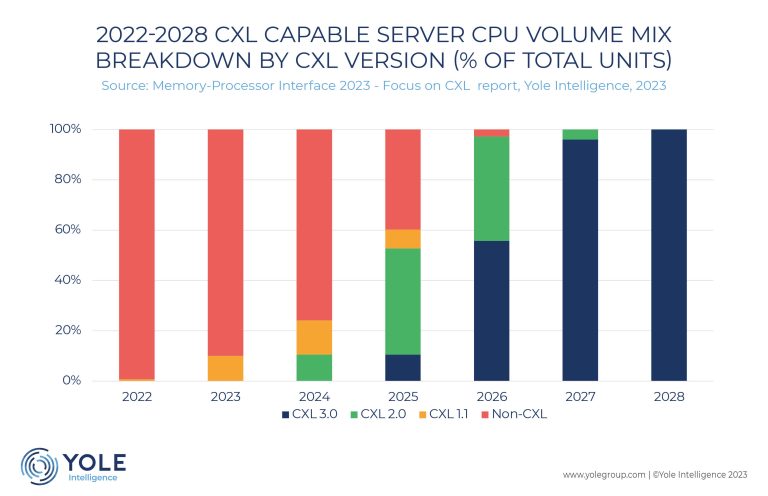
AI cloud servers, starting from CXL 1.1, can benefit from memory expansion, while CXL 3.0 has the potential to grant accelerators such as GPU s, DPU s, FPGA s, and ASIC s direct access to memory pools.
Cloud service providers and hyperscalers are anticipated to express significant interest in memory pooling, initiated by CXL 2.0 and composable servers with CXL 3.0.
Meanwhile, database servers will harness the capability to run larger in-memory databases for quicker analytics.
“CXL expansion takes two primary forms: add-In cards predominantly offered by expander controller providers like Astera Labs, Montage, and Microchip, and CXL drives promoted by memory IDM s such as Samsung, SK hynix, and Micron,” says Yole’s Thibault Grossi.
Astera Labs, Microchip, and Montage presently offer CXL expander controller chips, while CXL switches are being considered by numerous players including Enfabrica, Panmnesia, and Elastics.cloud, typically as embedded blocks within more complex chips.
Conversely, Xconn intends to provide stand-alone CXL switch chips. CXL has the potential to revolutionize memory utilization, management, and access, ushering in a new era of disaggregation and composability akin to the storage paradigm shift of the 90s and potentially spawning an industry focused on CXL memory fabric software, systems, and services.
CXL operates atop the PCIe physical layer, with current CXL 1.1 (PCIe 5.0) enabling direct memory expander attachment. CXL 2.0 (PCIe 5.0) will introduce CXL switches, expanding memory pooling capabilities.
Meanwhile, CXL 3.0, leveraging PCIe 6.0, will enable cascading switches and peer-to-peer connections, facilitating full server disaggregation and composability.
The CXL standard encompasses three protocols (CXL.io, CXL.cache, and CXL.mem), enabling three distinct CXL device types. This report focuses on type-3 devices centered around memory expansion.

CXL, though media-agnostic, is expected to be primarily sought for memory expansion and pooling, predominantly utilizing DRAM memory expanders. These expanders can take the form of add-in cards equipped with DRAM DIMM s, or drives (EDSFF form factors) with embedded DRAM. Drives are poised to gradually supplant add-in cards due to their optimized form factors, compatibility with server chassis standards (critical for cooling), and ease of handling.
Finding the right balance between cost and capacity will be pivotal in determining when CXL drives will outpace add-in cards.
When it comes to the price of CXL memory expander controllers, their complexity is expected to result in costs exceeding US$60 in 2023 due to the emerging market and advanced manufacturing nodes. CXL switches, with their substantial lane configuration (x256 lanes) and reliance on aggressive technology nodes (such as 16nm FinFET for initial prototypes), are anticipated to be even more expensive.
However, pricing for both CXL controllers and switches is projected to normalize as CXL gains widespread deployment
Jayce
/include/upload/kind/image/20231013/20231013174931_4226.jpeg
CXL solutions could transform today’s server memory challenges into a $15 billion opportunity by 2028, says Yole Developpement.
2023/10/13 17:51:11
2023/10/13 17:51:11
77
0
450
6
Q2 notebook units up 21.6% q-o-q; H1 units down 23.5% y-o-y
Q3 notebook shipments are expected to grow 3.8% to 44.13 million units.

Annual notebook shipments are projected to hit 163 million units – a y-o-y decline of 12.2%.
In 2024, shipments are forecast to grow 2-5% to just above pre-pandemic levels.
Jayce
/include/upload/kind/image/20231012/20231012175040_2472.png
Q2 notebook shipments grew 21.6% q-o-q to 42.52 million units, although H1 units were down 23.5% y-o-y at 77.5 million units, reports IDC.
2023/10/12 17:51:21
2023/10/12 17:51:21
91
0
449
6
Global telecom capex to fall 7% 2022-25
“The forces that shape the capex cycle have not changed,” says Dell’Oro vp Stefan Pongratz, “operators can raise capital intensities over the short-term, but there is a reason the trend line has stayed flat over the past 10+ years. Since we are now operating at elevated ratios, capex acceleration remains a transitory phenomenon in a world where neither 4G nor 5G has been able to change the revenue trajectory.”
Global telecom capex is projected to decline at a 2% CAGR over the next three years, as positive growth in India and stable trends in Europe will not be enough to offset steeper capex deceleration in North America.
In the US, the transition towards steady-state conditions will weigh on wireless activity, leading to a 25 to 30% reduction over the next three years.
Given the highly unlikely prospect of a change in the current revenue trajectory and the expectation of flat operator top-line growth, capital intensity ratios are on track to approach 16% by 2025, slightly below the current trendline.
Jayce
/include/upload/kind/image/20231011/20231011174812_8707.jpeg
Worldwide telecom capex, the sum of wireless and wireline telecom carrier investments, is expected to fall by 7% between 2022 and 2025, says Dell’Oro Group.
2023/10/11 17:48:40
2023/10/11 17:48:40
97
0
448
6
Q3 PC sales fall 9%; market may have bottomed
“There is evidence that the PC market’s decline has finally bottomed out,” says Gartner’s Mikako Kitagawa, “seasonal demand from the education market boosted shipments in the third quarter, although enterprise PC demand remained weak, offsetting some growth. Vendors also made consistent progress towards reducing PC inventory, with inventory expected to return to normal by the end of 2023, as long as holiday sales do not collapse.”
The top vendors in the worldwide PC market remained unchanged in the third quarter of 2023, with Lenovo maintaining the No. 1 spot in shipments with 25.1% market share (see Table 1).
Table 1. Preliminary Worldwide PC Vendor Unit Shipment Estimates for 3Q23 (Thousands of Units)


Notes: Data includes desktop and laptop PCs that are equipped with Windows, macOS or Chrome OS.
Source: Gartner (October 2023)
While Lenovo once again saw a year-over-year decline in shipments, it was eased to a single digit decrease. Meanwhile, HP was the only vendor to exhibit year-over-year growth, with shipments increasing across all regions. Dell reported a sixth consecutive quarter of shipment decline, impacted by weak enterprise PC demand given its a strong presence in the market.
Apple’s shipments declined sharply compared to a year ago, in part because its shipment volume increased significantly in 3Q22 once supply disruptions from earlier in 2022 due to China’s lockdown had eased. In the third quarter of 2023, Apple’s shipments followed seasonal trends, primarily driven by demand from students and educators.
“The good news for PC vendors is that that the worst could be over by the end of 2023,” said Kitagawa. “The business PC market is ready for the next replacement cycle, driven by the Windows 11 upgrades. Consumer PC demand should also begin to recover as PCs purchased during the pandemic are entering the early stages of a refresh cycle.”
Gartner is projecting 4.9% growth for the worldwide PC market for 2024, with growth expected in both the business and consumer segments.
Regional Overview
The U.S. PC market declined 9.3% in the third quarter of 2023 (see Table 2).
Table 2. Preliminary U.S. PC Vendor Unit Shipment Estimates for 3Q23 (Thousands of Units)

Source: Gartner (October 2023)
The U.S market’s decline was primarily caused by weak enterprise PC demand. However, Chromebook growth driven by replacement demand in K-12 educational institutions offset some of the decline.
The EMEA PC market declined 3.6% year-over-year. Continued political unrest, inflationary pressures and interest rate increases culminated in a new low in demand for PCs, although this quarter’s decrease was less severe than the previous two quarters.
“Organizations in EMEA are continuing to realign to the disruptive business outlook, limiting business PC spending as companies reduce PC budgets as a cost management strategy,” said Kitagawa. “Meanwhile, consumer demand in EMEA remains low, as all income brackets are affected by inflationary pressures and interest rates.”
The Asia Pacific PC market declined 13% year-over-year, driven by a steep 20% decline in China. In China, consumer PC spending remained weak due to unemployment issues, while enterprise PC demand also slowed due to spending cuts in the government.
In India, the Directorate General of Foreign Trade (DGFT) announced new restrictions on the import of certain devices in August 2023 as part of a bid to encourage local manufacturing. While the initial announcement caused a minor disruption as several vendors had to halt imports, a revised announcement soon after extended the deadline to November 2023 and imports resumed to normal volumes. The decision to implement any restrictions has now been moved to October 2024, meaning that the India PC market will see minimal impacts through the rest of this year.
Jayce
/include/upload/kind/image/20231010/20231010172813_9561.jpg
Q3 PC shipments fell 9% to 64.3 million units marking the eighth consecutive quarter of decline for the PC market, but growth should resume in Q4, says Gartner.
2023/10/10 17:31:38
2023/10/10 17:31:38
108
0
447
6
National Shares of Semi Manufacturing to Shift
“Geopolitical shifts are fundamentally changing the semiconductor game,” says IDC’s Helen Chiang, “while immediate impacts might be subtle, long-term strategies are focusing more on supply chain self-reliance, security, and control. The industry operation will move from global collaborations to multi-regional competitions,”
China’s rapid development of mature processes means its proportion of the foundry market will continue to increase, reaching 29% in 2027, an increase of 2% from 2023.
Taiwan’s proportion of the foundry market will fall from 46% in 2023 to 43% in 2027.
The US will make gains in advanced processes, and its share of the foundry market for 7nm and below is expected to reach 11% in 2027.

For assembly and test, IDMs have begun to invest more in the Southeast Asia market, and OSAT companies have begun to shift operations from China to Southeast Asia.
Southeast Asia is projected to play an increasingly important role in the semiconductor assembly and test market, especially in Malaysia and Vietnam.
Southeast Asia’s share of the global semiconductor assembly and test will reach 10% in 2027, while Taiwan’s share will decline to 47% in the same year from 51% in 2022.

Jayce
/include/upload/kind/image/20231009/20231009152635_5873.jpg
The locations for semiconductor foundry manufacturing will shift over the next few years with China doing more, Taiwan less and the US increasing its share of advanced node manufacturing, says IDC’s report: The Impact of Geopolitics on Asia’s Semiconductor Supply Chain: Trends and Strategies
2023/10/9 15:28:10
2023/10/9 15:28:10
94
0
445
6
August IC sales up 1.9% m-o-m
“Global semiconductor sales ticked up on a month-to-month basis for the sixth consecutive month in August, demonstrating a slow-and-steady increase in market demand during the middle of the year,” says SIA CEO John Neuffer, “global sales were down again in August compared to last year, but the year-to-year decrease was smaller than at any point since October 2022, providing optimism for continued momentum in the months ahead.”
Regionally, month-to-month sales increased in the Americas (4.6%), China (2.0%), and Asia Pacific/All Other (1.2%), but decreased slightly in Japan (-0.4%) and Europe (-1.1%). Year-to-year sales were up in Europe (3.5%) and the Americas (0.3%), but down in Japan (-2.9%), Asia Pacific/All Other (-11.3%), and China (-12.6%).
Jayce
/include/upload/kind/image/20231008/20231008174104_1721.png
August chip sales of $44 billion were up 1.9% on July’s $43.2 billion but 6.8% less than the August 2022 total of $47.2 billion, says the SIA.
2023/10/8 17:41:21
2023/10/8 17:41:21
89
0
444
6
Global Semiconductor Sales Increase 1.9% Month-to-Month in August
WASHINGTON—Oct. 4, 2023—The Semiconductor Industry Association (SIA) today announced global semiconductor industry sales totaled $44.0 billion during the month of August 2023, an increase of 1.9% compared to the July 2023 total of $43.2 billion but 6.8% less than the August 2022 total of $47.2 billion. Monthly sales are compiled by the World Semiconductor Trade Statistics (WSTS) organization and represent a three-month moving average. SIA represents 99% of the U.S. semiconductor industry by revenue and nearly two-thirds of non-U.S. chip firms.
“Global semiconductor sales ticked up on a month-to-month basis for the sixth consecutive month in August, demonstrating a slow-and-steady increase in market demand during the middle of the year,” said John Neuffer, SIA president and CEO. “Global sales were down again in August compared to last year, but the year-to-year decrease was smaller than at any point since October 2022, providing optimism for continued momentum in the months ahead.”
Regionally, month-to-month sales increased in the Americas (4.6%), China (2.0%), and Asia Pacific/All Other (1.2%), but decreased slightly in Japan (-0.4%) and Europe (-1.1%). Year-to-year sales were up in Europe (3.5%) and the Americas (0.3%), but down in Japan (-2.9%), Asia Pacific/All Other (-11.3%), and China (-12.6%).

Jayce
/include/upload/kind/image/20231007/20231007171605_6908.png
WASHINGTON—Oct. 4, 2023—The Semiconductor Industry Association (SIA) today announced global semiconductor industry sales totaled $44.0 billion during the month of August 2023, an increase of 1.9% compared to the July 2023 total of $43.2 billion b
2023/10/7 17:17:00
2023/10/7 17:17:00
82
0
443
6
SIA Urges Congress to Resolve Double Taxation Between U.S. and Taiwan
SIA President and CEO John Neuffer on Sept. 18 sent a letter to congressional leaders expressing the urgency of resolving double taxation between the U.S. and Taiwan, among other related tax matters. Despite being top trading partners, the U.S. and Taiwan lack a formal tax treaty to resolve taxation issues between the two jurisdictions. The letter comes as the industry is set to make substantial investments in U.S. semiconductor manufacturing, spurred by the landmark CHIPS and Science Act signed into law last year. The law provides $52 billion in government investments to reinvigorate domestic semiconductor production and innovation.
In the letter sent to Speaker Kevin McCarthy (R-Calif.), Senate Democratic Majority Leader Chuck Schumer (D-N.Y.), Senate Republican Minority Leader Mitch McConnell (R-Ky.), and House Democratic Minority Leader Hakeem Jeffries (D-N.Y.), SIA expressed the urgency of resolving U.S.-Taiwan tax matters for the semiconductor industry:
Semiconductors are one of America’s top export industries and a key driver of America’s economic strength, national security, and global competitiveness. As you know, Taiwan plays a critical role in the global semiconductor ecosystem and is a top trading partner for U.S. semiconductor companies. To enhance the competitiveness of semiconductor companies in both the U.S. and Taiwan and support the significant investment in the semiconductor industry in the U.S. following passage of the CHIPS and Science Act, a tax agreement between the U.S. and Taiwan has become a pressing matter and is essential to the success of the new law.
Without a tax treaty in place, companies doing business between the U.S. and Taiwan encounter unnecessary and burdensome barriers to trade. Companies may be subject to double taxation and complications with facilitating multinational sales, and many U.S. or Taiwanese employees on work travel or temporary assignment may be subject to duplicative and complicated income tax regimes. In the letter, SIA expresses support of the much-needed congressional effort to advance legislation that will achieve the same policy objectives as would a formal treaty between the United States and Taiwan.
The Senate Finance Committee has taken a positive step forward in addressing these issues by unanimously approving a bill—the U.S.-Taiwan Expedited Double Tax Relief Act—that would do exactly that. If passed, the bill would go into effect once Taiwan enacts parallel changes to its tax laws. The Senate Foreign Relations Committee has also advanced legislation (S. 1457) to provide for the conclusion of a tax agreement between the U.S. and Taiwan. Companion legislation to both bills is being considered in the House by the Ways and Means Committee and the House Foreign Affairs Committee.
Jayce
/include/upload/kind/image/20230927/20230927165918_4913.jpg
SIA President and CEO John Neuffer on Sept. 18 sent a letter to congressional leaders expressing the urgency of resolving double taxation between the U.S. and Taiwan, among other related tax matters. Despite being top trading partners, the U.S. and
2023/9/27 16:59:25
2023/9/27 16:59:25
103
0
441
6
Alphawave looking for 2023 revenue of $340-360m
Alphawave Semi had H1 revenues up 228% y-o-y to $187 million for an EBITDA of $32 million at a margin of 17% compared with $23 million and 41% in H1 2022.
The H1 2023 operating loss was $3 million. In H1 2002, it was $30 million.
The H1 2023 cash outflow from operating activities was $31 million. In H1 2022 it was $32 million.
Net debt in H1 2023 was $100 million.In H1 2022 the company had net cash of $452 million.
H1 2023 bookings were up 251% y-o-y to $187 million and backlog, excluding royalties, was $365 million.
For the full year, Alphawave expects revenue of $340m to $360m and adjusted EBITDA of approximately $87m (or approximately 25% of revenue).
“We are successfully executing on our strategy, with the business offering a growing range of advanced connectivity solutions that enable the next generation of AI and cloud infrastructure,” says CEOnTony Pialis, “in H1 2023 we delivered a good set of results, scaling our business and investing organically to support our pipeline and future revenue growth. Our leading connectivity technology and strong execution give us confidence in the prospects for our business.”
Jayce
/include/upload/kind/image/20230926/20230926180336_5165.jpg
Alphawave Semi had H1 revenues up 228% y-o-y to $187 million for an EBITDA of $32 million at a margin of 17% compared with $23 million and 41% in H1 2022.
The H1 2023 operating loss was $3 million. In H1 2002, it was $30 million.
2023/9/26 18:03:59
2023/9/26 18:03:59
97
0
440
6
200mm capacity to grow 14% 2023-6
Power and compound semiconductors are the biggest drivers of 200mm investment. The development of powertrain inverters and charging stations for EVs in particular is expected to fuel increases in global 200mm wafer capacity as EV adoption continues to rise.
“The global semiconductor industry’s ramp to record 200mm fab capacity highlights the bullish expectations for growth in the automotive market in particular,” says SEMI CEO Ajit Manocha, “while automotive chip supply has stabilised, the increased chip content in EVs and the drive to reduce charging time is spurring capacity expansions.”
Chip suppliers including Bosch, Fuji Electric, Infineon, Mitsubishi, Onsemi, Rohm, STMicroelectronics and Wolfspeed are accelerating their 200mm capacity projects to meet future demand.
The SEMI 200mm Fab Outlook to 2026 report shows fab capacity for automotive and power semiconductors growing 34% from 2023 to 2026, with Microprocessor Unit/Microcontroller Unit (MPU/MCU) ranking second at 21%, followed by MEMS, Analog, and Foundry at 16%, 8%, and 8%, respectively.

Accounting for most of the 200mm fab capacity are 80nm to 350nm technology nodes. Growth of 80nm to 130nm node capacity is forecast to expand by 10%, while 131nm to 350nm technology nodes are expected to register an 18% expansion from 2023 to 2026.
Southeast Asia is projected to lead 200mm capacity growth with a 32% increase during the report period. China is expected to rank second with 22% growth. The biggest contributor to the 200mm capacity expansion, China is projected to reach more than 1.7 million wafers per month by 2026. Americas, Europe & Mideast, and Taiwan will follow at 14%, 11%, and 7% growth, respectively.
In 2023, China is forecast to claim 22% share of 200mm fab capacity, while Japan is expected to account for 16% of total capacity, followed by Taiwan, Europe & Mideast, and America at 15%, 14%, and 14%, respectively.
Jayce
/include/upload/kind/image/20230925/20230925173926_8866.jpg
200mm fab capacity will grow 14% from 2023 through 2026, adding 12 new 200mm volume fabs (excluding EPI), says SEMI in its 200mm Fab Outlook to 2026 report.
2023/9/25 17:40:08
2023/9/25 17:40:08
99
0
438
6
Nvidia to be No.1 this year, says SI
Nvidia’s 2023 revenue will be almost double its 2022 revenue on the strength of its AI processors.
Intel has been the top semiconductor company for most of the last twenty-one years – except for 2017, 2018 and 2021 when Samsung was number one.
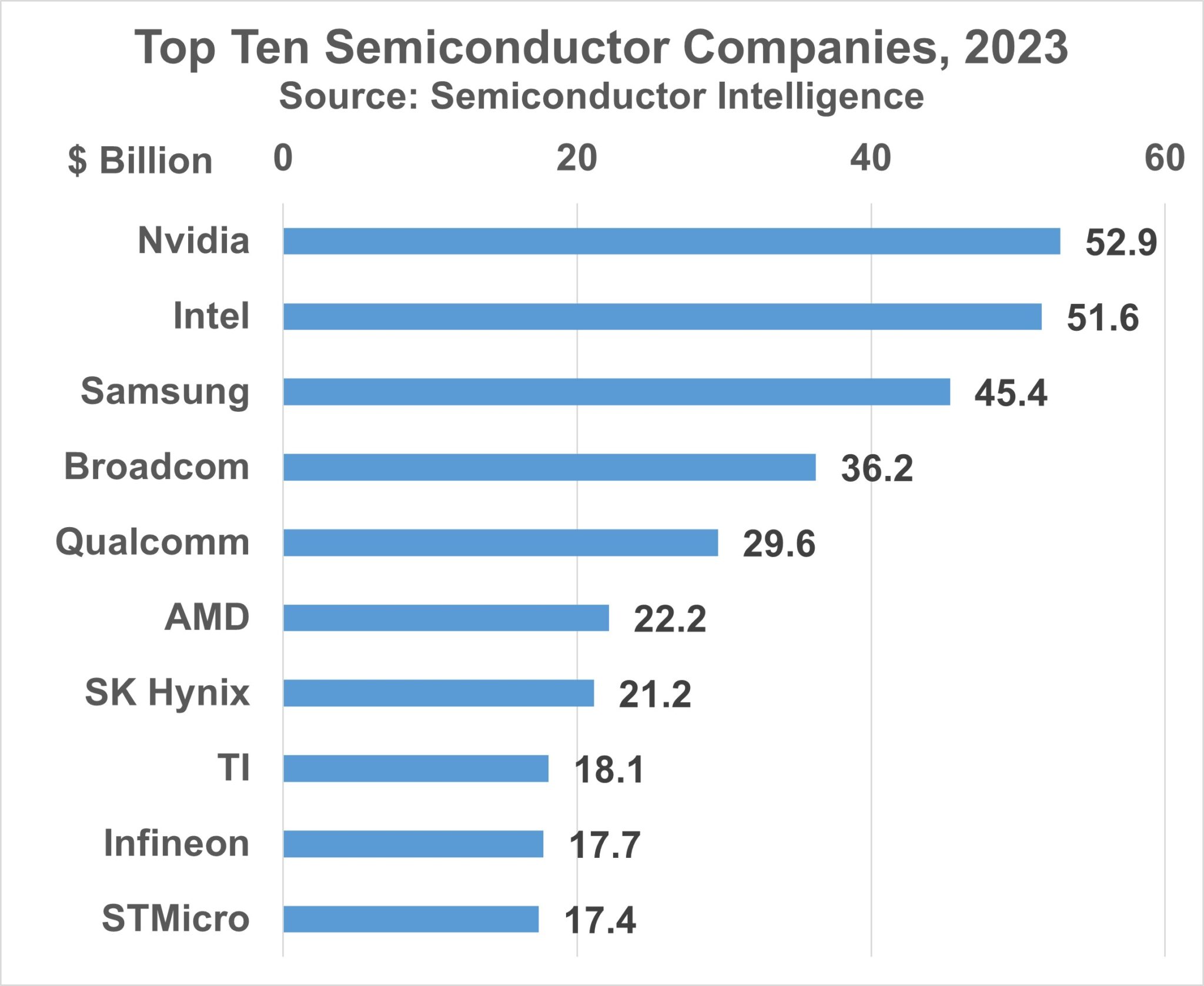
Despite the fast pace of the semiconductor industry and the numerous startup companies, the top ten companies in 2023 have all been in business at least 30 years.
Nvidia is the youngest at 30. Number four Broadcom Inc. is the result of Avago Technologies acquiring Broadcom in 2015. However, the original Broadcom was founded 32 years ago. Avago was a spin-off of Hewlett-Packard which entered the semiconductor business 52 years ago.
38-year-old Qualcomm grew to number five primarily through cellphone ICs and licensing revenues. Only Qualcomm’s IC revenues are included in the rankings. Number ten STMicroelectronics was formed in 1987 through the merger of SGS Microelettronica of Italy with Thomson Semiconducuteurs of France. The semiconductor businesses of SGS and Thomson both date back to the 1970s.
Two of the top ten companies were among the industry pioneers about 70 years ago. Texas Instruments (TI) was founded in 1930 and entered the semiconductor business in 1954. Infineon Technologies was originally part of Siemens AG, which was founded in 1847. Siemens began producing semiconductors in 1953. Infineon was spun out as a separate company in 1999.
The two South Korean companies, Samsung Electronics and SK Hynix, have over 40 years of semiconductor sales. They became dominant in the memory business after it was largely abandoned by U.S. and Japanese companies (except Micron Technology). SK Hynix was originally Hyundai Electronics which began making semiconductors in 1983. Hyundai merged with LG Semiconductor in 1999 to form Hynix, later SK Hynix.
Intel started 55 years ago and originally sold memory devices. AMD began 54 years ago producing logic ICs. Today the two companies primarily sell microprocessors, together accounting for over 95% of the market for computer microprocessors.
The relative stability of the top semiconductor companies can be seen by comparing the 2023 top ten with 1984, 39 years ago and the year the principal of Semiconductor Intelligence began in semiconductor market analysis.
Of the top ten semiconductor companies in 1984, most are still in business today in one form or another. TI was number one in 1984. Since then, TI has narrowed its focus to become primarily an analog company.
Number two Motorola split off its discrete business as ON Semiconductor in 1999. ON is now an $8 billion company and acquired industry pioneer Fairchild Semiconductor in 2016. Motorola spun off its IC business as Freescale Semiconductor in 2004.
NXP Semiconductors was split off from number seven Philips in 2006. Freescale merged with NXP in 2015. NXP is currently a $13 billion company. Number five National Semiconductor was acquired by TI in 2011. Intel and AMD were number seven and eight, respectively, in 1984. They will be number two and number six in 2023.

Japanese companies were strong in the semiconductor industry in most of the 1980s and 1990s, especially in memory. They were all large, vertically integrated companies. Beginning in the late 1990s these companies began spinning off their semiconductor operations.
Renesas Electronics was formed by the merger of the non-memory operations of Hitachi, Mitsubishi, and NEC. Renesas is now a $13 billion company.
NEC and Hitachi split off their DRAM businesses in 1999 to form Elpida Memory. Elpida was acquired by Micron Technology in 2013.
Toshiba spun off its flash memory business as Kioxia in 2016. Kioxia had over $11 billion in revenue in 2022. Toshiba continues to provide primarily discrete semiconductor devices.
Fujitsu divested its IC foundry business in 2014 which was later acquired by UMC. Fujitsu formed a joint venture with AMD for flash memory, Spansion. Spansion merged with Cypress Semiconductor in 2014 and Cypress was acquired by Infineon in 2020.
The relative stability of the semiconductor industry is demonstrated by the market shares of the top ten companies in 1984 and 2023. In 1984 TI had a 9.3% share. In 2023 Nvidia will have about a 10.6% share. The combined market share of the top ten companies in 1984 was 63%. In 2023 it will be about 62%. Although the top companies are relatively stable, the industry has grown from $26 billion in 1984 to $500 billion in 2023, almost a 20-fold increase.
Jayce
/include/upload/kind/image/20230922/20230922170916_2492.jpg
Nvidia will likely become the No.1 semiconductor company for revenue this year, says Semiconductor Intelligence which estimates Nvidia’s 2023 revenue at about $52.9 billion, and Intel’s at $51.6 billion.
2023/9/22 17:11:31
2023/9/22 17:11:31
99
0
437
6
EV charge points to triple by 2026
The number of EV charging stations across the world will increase 3x between 2023 and 2026 to 16 million charging points, says TrendForce.
By 2026, the number of EV’s will be 96 billion globally setting the vehicle-to-charger ratio at 6:1, a significant drop from the 10:1 ratio in 2021.

Europe is targeting the construction of 17 million charging stations by 2030.
America, with a little over 200,000 charging stations currently, aspires to hit the 500,000 mark by 2026 which will coincide with a projected EV count of 15 million, delivering a vehicle-to-charger ratio to 32:1.
Around the same period, Europe and China are projected to have ratios of approximately 9:1 and 4:1, respectively.
NEV owners globally grapple with a maze of charging standards. Prominent among these are the US standard CCS1 (Combo), the European standard CCS2 (Combo), Japan’s CHAdeMO, China’s GB/T, and Tesla’s NACS standard. Europe and China offer a simpler scenario for their citizens by adhering to a single domestic standard.
In contrast, the US is a battleground, with both CCS1 and NACS standards vying for dominance. While adapters provide a temporary bridge between the two, the rapid rise of NACS kindles apprehension among CCS1 aficionados about their future stake.
A diverse array of charging standards across the globe means charging equipment manufacturers must adopt flexible product strategies to cater to different market specifications.
GM, Mercedes-Benz, BMW, HONDA, Hyundai-Kia, and Stellantis are joining forces to spin off dedicated charging infrastructure companies.
Jayce
/include/upload/kind/image/20230921/20230921175817_9453.png
The number of EV charging stations across the world will increase 3x between 2023 and 2026 to 16 million charging points, says TrendForce.
By 2026, the number of EV’s will be 96 billion globally setting the vehicle-to-charger
2023/9/21 17:59:39
2023/9/21 17:59:39
113
0
436
6
Fake Components Went Into 68 Jet Engines, Including Ones On Boeing 737 And Airbus A320 Planes, Says Lawsuit
CFM International Inc. says 68 jet engines were fitted with spare parts backed by fraudulent documentation from a little-known UK-based supplier, a sign that fake components may have been installed on certain older-model aircraft.
The finding was included in a lawsuit filed by the joint venture of General Electric Co. and Safran SA in the UK against closely held AOG Technics Ltd, according to a statement from CFM. The suit seeks an injunction to force AOG to provide more information to aid the aviation industry’s search for suspect components.
“Safety is our first priority, and we are taking aggressive legal action against AOG Technics to accelerate the industry’s ability to identify parts sold by this third-party with falsified documentation,” a CFM spokesman said in a statement.
Representatives for AOG could not be reached for immediate comment.
The development provides the first hint at how many older-generation Airbus SE A320 and Boeing Co. 737 aircraft may have been fitted with spare parts that London-based AOG allegedly sold with falsified airworthiness records. It’s unclear whether additional engines may have used unauthorized replacement parts.
Regulators, airlines and other industry players have since been scouring their records to hunt down the suspect components sold by AOG, the obscure supplier at the center of the crisis. AOG has no direct affiliation with CFM or its partners.
To date, CFM and GE Aerospace have found 78 documents they say are falsified and which cover 52 CFM56 engine part numbers, along with two faked records for CF6 components.
No incidents linked to the suspect parts have been identified, the companies have said.
The European Union Aviation Safety Agency earlier this week determined that the components backed by forged documentation included turbine blades, a critical component of an aircraft’s propulsion system.
“We remain fully engaged with aviation regulatory authorities to support their investigations into AOG Technics, and we continue to work with our customers to assess the authenticity of documentation for parts they acquired directly or indirectly from AOG Technics,” the CFM spokesman said.
— With assistance by Siddharth Vikram Philip and Albertina TorsoliAviation regulators in Europe determined AOG supplied parts for the repair of CFM56 engines, the world’s best-selling turbine, with falsified documentation, Bloomberg News reported last week.
The proliferation of undocumented parts has sent shock waves through an industry where every component requires verification to ensure aircraft safety. Without such assurance, it’s impossible to know how durable uncertified parts will be under stress.
Jayce
/include/upload/kind/image/20230919/20230919180813_3883.png
CFM International Inc. says 68 jet engines were fitted with spare parts backed by fraudulent documentation from a little-known UK-based supplier, a sign that fake components may have been installed on certain older-model aircraft.
Th
2023/9/19 18:10:14
2023/9/19 18:10:14
107
0
435
6
Panmesia raises €12.5m seed round to pursue CXL
Investors were: Daekyo Investment, SL Investment, Smilegate Investment, GNTech Venture Capital, Time Works Investment, Yuanta Investment, and Quantum Ventures Korea.
Panmesia says it has a way of running recommendation models 5x faster by feeding data from external memory pools to GPUs via CXL caching rather than host CPU-controlled memory transfers.
The company’s TrainingCXL technology was developed by computing researchers at the Korea Advanced Institute of Science & Technology (KAIST).
CXL is gaining traction as an interface technology designed to connect diverse system devices, including memory expansion units, accelerators, processors, and switches.
Its promise lies in the ease it offers in memory capacity augmentation and in streamlining data processing. One feature of CXL, memory pooling, presents avenues for cost savings in memory-related operations.
Meta, Microsoft, and Google are demonstrating heightened interest in CXL-centric solutions and Intel, AMD, Samsung Electronics, and SK Hynix have laid out their strategic blueprints to introduce CXL-compliant devices.
Panmnesia ckaims to have presented the world’s first CXL 2.0-based full- system memory pooling framework at the USENIX ATC conference in Boston last year. The company unveiled a solution this May that accelerates data centre-oriented AI applications, using CXL 3.0 technology.
At the Flash Memory Summit 2023 in Santa Clara, California, the company disclosed a full system, from devices to operating systems, connected through a multi-level switch architecture supporting CXL 3.0.
.”CXL 3.0 takes a fundamentally different viewpoint from CXL 2.0 in its approach to various processors and memory semiconductor devices to support high scalability,” says Myoungsoo Jung, CEO of Panmnesia, “regrettably, most companies are still only discussing certain features of CXL 1.1 or 2.0.”
Jung says that Panmnesia has already completed the development of hardware and software to support CXL 3.0, which will be of significant assistance to a diverse range of companies utilising CXL.
Panmesia’s CXL product line covers everything, including CXL IP, hardware, system solutions to enable these, and software essential for accelerating AI and data processing at the server and data centre levels. The products are planned to be available to a broader customer base following the completion of state-of-the-art silicon tape-out later this month.
Jayce
/include/upload/kind/image/20230918/20230918175602_6493.jpeg
Investors were: Daekyo Investment, SL Investment, Smilegate Investment, GNTech Venture Capital, Time Works Investment, Yuanta Investment, and Quantum Ventures Korea.
Panmesia says it has a way of running recommendation models 5x fast
2023/9/18 17:56:04
2023/9/18 17:56:04
105
0
433
6
Improvement in 2023 semiconductor market
An unexpected upturn in Q2 has resulted in a better than anticipated result for the 2023 semiconductor market, said Malcolm Penn (pictured) CEO of Future Horizons, at the company’s IFS2023 forecast seminar yesterday.
The industry down-cycle bottomed out in Q1 which was a quarter earlier than the historical trend indicated. “The 18th industry up-cycle has started,” said Penn.
In Q2, the market increased by 6%, instead of taking an expected 5% drop and, with 6% growth forecast in Q3 followed by 1% growth in Q4, the full year forecast improves from an anticipated 22% decline to a 10% decline.
Inventory depletion will not, however, be over before the end of the year, and it could be longer if end demand softens.
Future Horizons’ forecast for next year is a minus 1% Q1, a plus 2.3% Q2, a plus 6.3% Q3, and a minus 1.5% Q4 for full year growth of 9% to deliver a market worth $562 billion.
There should be a return to the historical 8% unit growth trend line next year, however the capex overspend will keep utilisation rates low and excess capacity will keep a tight rein on ASPs.
Jayce
/include/upload/kind/image/20230915/20230915180021_7709.jpg
An unexpected upturn in Q2 has resulted in a better than anticipated result for the 2023 semiconductor market, said Malcolm Penn (pictured) CEO of Future Horizons, at the company’s IFS2023 forecast seminar yesterday.
The industry down
2023/9/15 18:01:12
2023/9/15 18:01:12
101
0
432
6
Q2 SEMI billings down 2% y-o-y
“Overall demand for capital equipment remains strong despite uncertainty that continued to pervade the macroeconomy in the first half of 2023,” says SEMI CEO Ajit Manocha, “during the report period, some semiconductor market segments exercised caution in making capital equipment investments, though the impact across regions varied.”

Regional data:

Jayce
/include/upload/kind/image/20230914/20230914175834_2920.jpg
“Overall demand for capital equipment remains strong despite uncertainty that continued to pervade the macroeconomy in the first half of 2023,” says SEMI CEO Ajit Manocha, “during the report period, some semiconductor market segments exercised c
2023/9/14 17:59:54
2023/9/14 17:59:54
107
0
431
6
ITA-3: Ushering in a Sustainable Future for Global ICT and Economy
The fresh fall air in Geneva this week appears to mirror the possibilities and benefits inherent in another expansion of the World Trade Organization (WTO) Information Technology Agreement (ITA), originally launched by the WTO in 1997 to eliminate tariffs on a broad swath of tech products, from cell phones to computers. By 2015, 53 nations came together for the ITA-2, further pushing the boundaries, eliminating more tariffs, and bolstering global trade to the tune of an additional $1.3 trillion.
This week, SIA is leading another delegation to Geneva—our fourth visit in a mere 18 months— to carry this torch further. A main focus of our delegation this time around is a freshly updated report from the Information Technology and Innovation Foundation (ITIF). This report, packed with new data, not only reiterates the importance of the full ITA membership, but also highlights the countless benefits of a potential ITA-3 to nations (both developed and developing), workers, diversification and resiliency of global supply chains, and the global environment.
The report examines over 400 unique ICT products as candidates for an ITA-3. These products include digital displays; energy-efficient technologies such as LED “light sources”; digital manufacturing technologies such as industrial robots and 3D printers; commercial-use drones; centrifuges, microscopes and other medical technologies and devices; semiconductor manufacturing parts and supplies; and storage batteries. The ITIF report finds if all 82 ITA-1 signatory countries were to join the proposed ITA-3, global GDP could cumulatively grow by $766 billion over the ensuing 10 years. This could mean a $208 billion surge for the U.S. GDP, the growth U.S. exports of ICT products by nearly $3 billion and the creation of nearly 60,000 new jobs in America.
Countries reluctant to join the ITA have seen themselves excluded from the global value chain for the production of ICT goods, missing out on significant growth opportunities. We would therefor urge them to consider joining ITA-1, ITA-2, and participate launching an ITA-3. Joining the ITA is especially important at a time when major economies are aiming to diversify their supply chains for increased resilience, security, and sustainability and are looking for geographies that provided zero-tariff treatment at the border.
The achievements of the ITA are not solely confined to economic growth. Semiconductor-enabled technologies, for example, can reduce greenhouse gas emissions by up to 15%, almost one-third of the reduction needed by 2030.[1] Semiconductors, which have been one of the biggest beneficiaries of the ITA, form the backbone of modern digitalized technologies – including electronics, computing hardware, telecommunications, electric vehicles, connected devices such as sensors and thermostats, and much more. Their availability, affordability, and environmental benefits are indispensable for a greener global economy.
Moreover, workers stand to gain tremendously. The ITA has helped revolutionize the workspace, enhancing remote work, broadening access to online education, streamlining online job searches, and expanding opportunities for remote services. This has empowered workers, increased employment, improved the work-life balance, and lifted overall job satisfaction.
As part of our work in Geneva this week, we are excited to co-host a panel with the Singapore Semiconductor Industry Association (SSIA) on the critical role of global semiconductor trade in driving energy efficiency and sustainability at this year’s WTO Public Forum, the WTO’s largest public outreach activity. The SIA-SSIA session will explore the vital relationship between global tech trade and environmental sustainability, and underscore the importance of rules-based trade and advancing new market access initiatives at the WTO.
As we wind through the streets of Geneva this week, our discussions promise to be as enlightening as the ITA agreement itself.
Jayce
/include/upload/kind/image/20230913/20230913180527_2415.jpg
The fresh fall air in Geneva this week appears to mirror the possibilities and benefits inherent in another expansion of the World Trade Organization (WTO) Information Technology Agreement (ITA), originally launched by the WTO in 1997 to eliminate
2023/9/13 18:05:35
2023/9/13 18:05:35
137
0
429
6
NI unveils compact battery cycler & emulator for EV, aerospace and energy test News 1 min read
Designed for modularity, versatility, and safety, the NHR 4800 is highly compact and looks to address the needs of battery testing across research, validation, production, and second-life applications in automotive, aerospace and the energy industries.
The data and insights from battery testing has a major impact on battery performance, quality, and overall adoption of new technologies like electric vehicles and energy storage systems and the demand for more efficient test is accelerating the next generation of battery test systems.
The NHR 4800 is highly modular and scalable, allowing engineering teams leading the shift to electric mobility and renewable energy to efficiently scale their test capabilities. When combined with NI’s open and flexible software-defined battery test approach, engineers can easily adjust and evolve for future battery test requirements.
“Battery testing can be a competitive advantage for EV manufacturers, and NI provides them with an open, flexible, and cost-effective platform to achieve it,” said Drita Roggenbuck, Senior VP and GM of Transportation, NI. “The NHR 4800 delivers best-in-class, high-power testing in a safe and compact system to provide our customers the performance necessary for todays and tomorrow’s battery testing requirements across multiple industries.”
The NHR 4800 is capable of functioning as a battery cycler, DC source, DC load, battery emulator, and amplifier for power-level hardware-in-the-loop testing. It delivers up to 80 V and 400 A in a single-4U chassis while delivering scalable power ranging from 16.5 kW up to 165 kW. This wide operating envelope makes the NHR 4800 suitable for testing low to mid-range battery modules and packs, fuel cells, energy storage systems, and solar PV systems and can be used to replace multiple instruments in the lab and production floors.
Key features include:
-
High-density 80 VDC and 400 A, up to 16.5 kW in 4U chassis, optimised for low to mid-range power applications
-
Modular and scalable power with parallel operation of up to 10 systems to go from 16.5 kW to 165 kW
-
Built-in isolation contactor relays, pre-charge circuit, reverse polarity checker, and more
-
High-performance source and regenerative load with typical regenerative power efficiency >90%
-
Regenerative power efficiency >90% (Typical)
-
100% SiC-based technology
-
Optimised battery connections to minimise hazards
-
Air-cooled provides simplified maintenance
-
Easy, flexible integration and set-up
-
Multiple Control Options: Touch Panel and SCPI commands via LabVIEW and Python
Jayce
/include/upload/kind/image/20230912/20230912175826_3681.png
NI has unveiled the latest product in its portfolio of high-power test systems for battery testing and simulation, the NHR 4800 high-density battery cycler and emulator.
2023/9/12 18:01:48
2023/9/12 18:01:48
137
0
427
6
Foxconn Invests US$500 Million In Chihuahua
CHIHUAHUA – The manufacturing company Foxconn, Apple’s main supplier, invested US$500 million in the state of Chihuahua, the company informed in a press release.
The investment comes in response to the nearshoring that is occurring in the country, since they are starting work on the relocation of two new plants in Ciudad Juarez, in addition to the one they already have at the San Jeronimo-Santa Teresa intersection in the state.
SOURCE: Mexico Today
He stated that these two plants, for a total of three in Chihuahua, will generate 5,000 jobs, more than half of which are considered of high value for the border.
The company informed that together with and the Government of the state of Chihuahua, announced a partnership with the objective of boosting talent training, fostering technology and promoting the development of sustainable energy.
Foxconn is committed to fostering a talent pool equipped with cutting-edge skills to meet the demands of the ever-evolving Information and Communication Technology (ICT) and Automotive industry.
“In collaboration with the state, we aim to develop training programs and initiatives that empower the workforce and position Chihuahua as an innovation-driven manufacturing hub,” he detailed.
Hon Hai Technology Group, better known as Foxconn was founded in 1974 in Taiwan; it is the largest electronics manufacturer and a leading provider of technology solutions worldwide.
Jayce
/include/upload/kind/image/20230911/20230911174031_9832.jpg
CHIHUAHUA – The manufacturing company Foxconn, Apple’s main supplier, invested US$500 million in the state of Chihuahua, the company informed in a press release.
The investment comes in response to the nearshoring that is occurring
2023/9/11 17:41:30
2023/9/11 17:41:30
97
0
426
6
Australia’s PC Market Declined By 5.1% YoY In 2Q23, Says IDC
According to the International Data Corporation (IDC) Worldwide Quarterly Personal Computing Device Tracker, Australia’s traditional PC market, inclusive of desktops, notebooks, and workstations, declined by 5.1% YoY in 2Q23 shipping 1,056,969 units.
The consumer segment declined by 13.6% YoY due to weakening purchase sentiment and rising cost of living. However, due to aggressive promotions and deals, the market grew quarter-on-quarter (QoQ). The commercial segment grew by 2.6% YoY driven by an increased demand from the Government and Education sectors. The demand for Chrome in the education sector exhibited robust growth, with a healthy YoY increase of 20.6%.
“Rising interest rates, coupled with increasing living expenses are restricting consumer spending. However, some improvements are expected in the second half of the year, as major market players will augment their preparations for the holiday season with new product launches and focus on generating demand,” said Sharmishtha Bhatt, Sr. Research, Personal Computing Devices Research, IDC Australia.


2023 outlook
The Australia PC market is expected to decline by 11.1% YoY in 2023 due to the prevailing macroeconomic situation, inflation, and uncertainty in the market. However, the year-end sales in Q4 are expected to bring some relief. IDC expects the PC inventory to stabilize, and some uptick in demand by the beginning of 2024.
Notes:
-
Shipments include shipments to distribution channels or end-users. OEM sales are counted under the company/brand under which they are sold.
-
Traditional PCs include Desktops, Notebooks, and Workstations and do not include Tablets or x86 Servers. Detachable Tablets and Slate Tablets are part of the Personal Computing Device Tracker but are not addressed in this press release.
Jayce
/include/upload/kind/image/20230908/20230908173605_4411.png
According to the International Data Corporation (IDC) Worldwide Quarterly Personal Computing Device Tracker, Australia’s traditional PC market, inclusive of desktops, notebooks, and workstations, declined by 5.1% YoY in 2Q23 shipping 1,056,969 uni
2023/9/8 17:39:00
2023/9/8 17:39:00
92
0
425
6
Global Semiconductor Sales Increase 2.3% Month-to-Month in July
WASHINGTON—Sept. 6, 2023—The Semiconductor Industry Association (SIA) today announced global semiconductor industry sales totaled $43.2 billion during the month of July 2023, an increase of 2.3% compared to the June 2023 total of $42.2 billion but 11.8% less than the July 2022 total of $49.0 billion. Monthly sales are compiled by the World Semiconductor Trade Statistics (WSTS) organization and represent a three-month moving average. SIA represents 99% of the U.S. semiconductor industry by revenue and nearly two-thirds of non-U.S. chip firms.
“The global semiconductor market has experienced modest but steady month-to-month growth this year, with sales increasing for the fourth consecutive month in July,” said John Neuffer, SIA president and CEO. “Global sales remain down compared to last year, but the year-to-year decrease in July was the smallest gap of the year to date, providing reason for optimism over the remainder of 2023 and beyond.”
Regionally, month-to-month sales increased in the Americas (6.3%), China (2.6%), Europe (0.5%), and Asia Pacific/All Other (0.3%), but decreased slightly in Japan (-1.0%). Year-to-year sales were up in Europe (5.9%), but down in Japan (-4.3%), the Americas (-7.1%), Asia Pacific/All Other (-16.2%), and China (-18.7%).
For comprehensive monthly semiconductor sales data and detailed WSTS forecasts, consider purchasing the WSTS Subscription Package.
Jayce
/include/upload/kind/image/20230907/20230907183503_6333.png
WASHINGTON—Sept. 6, 2023—The Semiconductor Industry Association (SIA) today announced global semiconductor industry sales totaled $43.2 billion during the month of July 2023, an increase of 2.3% compared to the June 2023 total of $42.2 billion bu
2023/9/7 18:35:39
2023/9/7 18:35:39
93
0
424
6
TDK Spotlights Innovations Fueling Automotive, ICT, IoT, AR/VR, Renewable Energy and Power Supplies
-
TDK joins Electronica India 2023, demonstrating its comprehensive component and system solution portfolio in exhibition hall 5, booth ED11
-
TDK offers multiple demonstrations and experiences for attendees to immerse themselves in the latest solutions for all sorts of passive components including sensors and power supplies for applications like mobility (ADAS, xEV including 2-wheeler), Beyond 5G (information and communication technology), IoT, AR/VR, industrial and renewable energy.
TDK Corporation joins electronica India 2023 to showcase more than 60 technology demonstrations and experiences across its component and system solution portfolio for the entire spectrum of electronics applications at electronica India in Bengaluru, from September 13 to 15, 2023. The TDK booth, located in exhibition hall 5, #ED11, will feature solutions for all sorts of passive components, as well as sensors and power supplies for applications like mobility (ADAS, xEV including 2-wheeler), Beyond 5G (information and communication technology), IoT, AR/VR, industrial and renewable energy.
Mobility ADAS / EV
-
ADAS & xEV Passive Components and Sensors: Showcasing the complete range of TDK solutions placed into real-sized PCBs within a simplified automotive design layout.
-
High-voltage contactors: Gas-filled high-voltage contactors, designed to meet the demands of high-voltage and high-current DC applications, especially for disconnecting high-voltage lithium-ion batteries.
-
Wireless power transfer coil: Qi-compliant planar wireless power coil utilizing a unique copper patterning technology for high-efficiency wireless power transfer.
-
Smart Automotive Demo: MEMS sensors designed or specifically qualified and tested to support infotainment, telematics, advanced driver assistance systems (ADAS), and other technological features for the automotive market e.g., tilt, crash, and crash driving detection.
-
Hall sensors: TDK offers the world’s largest Hall sensor portfolio covering all automotive applications in powertrain, chassis and safety, and body and comfort for linear and angular position detection of the pedal, throttle, gear position, etc.
Beyond 5G
-
Passive components for base stations and smartphones: Showcasing the complete range of TDK solutions specifically for 5G communication applications.
-
μPOL: The smallest available point-of-load DC-DC converter for applications such as big data, machine learning, artificial intelligence (AI), 5G supplies, and IoT networking.
-
Partner demos: 5G, 4G and 4G fallback 2G cellular modules based on Qualcomm for IoT, smart energy meter applications designed and developed in India by partners (Cavli Wireless and MoMagic) using TDK components like RF filters, RF inductors, etc.
IoT
-
Passive components for IoT: Showcasing the complete range of TDK solutions specifically for IoT applications.
-
SmartSonic: TDK’s ultrasonic Time-of-Flight (ToF) sensors integrate a MEMS PMUT (Piezoelectric Micromachined Ultrasonic Transducer) with an ultra-low power SoC (System on Chip) in a miniature package for reflow soldering. These sensor solutions can range to targets of any composition up to 5 meters in any lighting condition, making them ideal for a variety of applications, including obstacle avoidance, presence detection, robotics, security & surveillance, AR/VR, drones, liquid level sensing, smart home/building, and general IoT.
-
SmartIndustrial: Industrial-graded 6-axis MEMS motion sensors for industrial applications including precision agriculture, construction machinery, drones, automatic guided vehicles (AGVs), robots, and predictive maintenance of industrial motors.
-
Partner demos: 4G wearable tracker based on Qualcomm platform for tracking of assets, humans, and pets, developed in India by partners (BORQS) using the entire range of TDK components and sensors for connectivity, haptics, audio, display, EMC and other applications.
Jayce
/include/upload/kind/image/20230906/20230906180904_4734.jpg
TDK joins Electronica India 2023, demonstrating its comprehensive component and system solution portfolio in exhibition hall 5, booth ED11
TDK offers multiple demonstrations and experiences for attendees to immerse themselves i
2023/9/6 18:09:06
2023/9/6 18:09:06
128
0
423
6
New Rambus IP Product Advances Data Center Security
Rambus unveiled its latest innovation in the realm of cybersecurity: the first installment of its Quantum Safe security IP products, featuring the next-generation Root of Trust tailored for fortifying data center and communications security. In an era when the imminent potential of quantum computers threatens to compromise existing asymmetric encryption methods, Rambus is taking proactive measures to safeguard vital data and assets from impending threats.
In an interview with EE Times, Bart Stevens, a marketing executive at Rambus, said this new generation of the Rambus Root of Trust is a flagship first product in the company’s Quantum Safe IP portfolio, offering customers complete security solutions for the data center and advanced workloads like generative AI.
“The Root of Trust core handles platform-security mechanisms, such as secure boot, secure firmware update, secure debug, [Caliptra] platform attestation and authentication, secure personalization, secure provisioning, secure configuration, and feature management, as well as post-boot security and crypto services to data center applications using its crypto accelerators,” Stevens said.
The Rambus Root of Trust IP protects key data center infrastructure and sophisticated AI and machine learning (ML) systems using a post quantum cryptography (PQC)-based hardware security solution. Institutions like the National Institute of Standards and Technology (NIST) helped discover cryptographic algorithms that can withstand a quantum computer’s power in the quest for robust data security.
Jayce
/include/upload/kind/image/20230905/20230905181852_3582.png
Rambus unveiled its latest innovation in the realm of cybersecurity: the first installment of its Quantum Safe security IP products, featuring the next-generation Root of Trust tailored for fortifying data center and communications security. In an
2023/9/5 18:19:27
2023/9/5 18:19:27
91
0
408
6
2023 smartphone market to be down 4.7% y-o-y
IDC expects iOS shipments to see 1.1% growth in 2023 to reach an all-time high share of 19.9%, while Android is forecast to decline 6.0%.
China, Asia/Pacific (excluding Japan and China), and Latin America – focus regions for most Android players – will contribute the most to the decline with shipments down 3.6%, 4.4%, and 6.2% respectively. The United States and Western Europe are forecast to decline 3.8% and 6.1%.

Jayce
/include/upload/kind/image/20230904/20230904175404_3179.png
IDC expects iOS shipments to see 1.1% growth in 2023 to reach an all-time high share of 19.9%, while Android is forecast to decline 6.0%.
China, Asia/Pacific (excluding Japan and China), and Latin America – focus regions for m
2023/9/4 17:54:40
2023/9/4 17:54:40
100
0
406
6
Mouser Electronics Unveils Edge Computing Solutions For Any Engineering Challenge
Mouser Electronics, Inc., a New Product Introduction (NPI) leader? empowering innovation, is serving engineers with trusted resources for the evolving challenges and opportunities of Edge Computing. Their digital library is packed with informative and engaging content that supports professionals with in-depth articles tailored to a broad spectrum of needs like AI on the Edge and Edge Cybersecurity. In two of Mouser’s recent eBooks, Bringing Intelligence to the Edge and Intelligence at the Edge, leading experts from Mouser, Renesas and STMicroelectronics explore using artificial intelligence (AI) and machine learning (ML) in edge computing. Designers will find cutting-edge solutions, high-quality products and enhanced models within Mouser’s dozens of articles, videos and blogs.
With the growing popularity of edge computing in various professional and consumer systems, it is crucial for engineers to have easy access to relevant and practical solutions. Mouser’s Edge Computing content hub provides a carefully curated selection of resources that keeps engineers up to date with the latest edge computing developments. Mouser offers this comprehensive range of content designed to help engineers make informed decisions and implement effective solutions.
Mouser’s Edge Computing resource page is an integrated service centre where customers can find the latest products and industry information quickly and easily – all in one place. Additionally, Mouser stocks the industry’s widest selection of semiconductors and electronic components, including the following solutions for edge computing applications:
● NXP Semiconductors SLN-VIZNAS-IOT Solution for Face Recognition is an EdgeReady development kit for secure face recognition based on the i.MX RT106F Crossover Processor. It features liveness detection, fully integrated turnkey software, and IR and RGB cameras. This i.MX RT106F MCU-based solution is suitable for a variety of smart home applications, smart industrial devices, security, and more.
● Semtech LoRa Edge? LR1120 Wi-Fi/GNSS Scanner + LoRa? is a low-power, long-range transceiver that leverages Semtech’s LoRa Cloud? services. It complies with the physical layer requirements of the LoRaWAN? standard specification while also being able to meet various application requirements. It’s best used in intercontinental logistics, multi-regional inventory management, asset loss and theft prevention, and more.
● STMicroelectronics B-U585I-IOT02A Discovery Kit enables a wide range of applications by exploiting low-power communication, multiway sensing, and direct connection to cloud servers. With 2Mbytes of Flash memory, 786Kbytes of SRAM, and smart peripheral resources, the kit provides unlimited expansion capabilities with a wide choice of specialized add-on boards. It supports a range of wearable or sensor applications in fitness, metering, industrial, or medical, with state-of-the-art energy efficiency and higher security.
● Advantech ESRP-PCS-ADAM6 Intelligent I/O Gateways has a built-in WISE-EdgeLink that supports over 200 drivers, enabling efficient real-time data transmission from the edge to the cloud. The ADAM-6 facilitates data transmission between edge devices and the cloud and is ideal for factory management and energy monitoring. It can perform multiple tasks at the edge and comes with Linux OS installed with its integrated design.
● Terasic Technologies FPGA Cloud Connectivity Kit, available to order at Mouser, is certified with key cloud service providers (CSPs) and comes with open-source design examples that support new users through the process of connecting an FPGA-based edge device to the cloud for the first time. It’s based on the Terasic DE10-Nano Kit and adds Wi-Fi? and Bluetooth? wireless communication while featuring an ambient light sensor, humidity and temperature sensor, Bluetooth SPP, and more.
Jayce
/include/upload/kind/image/20230831/20230831175501_1243.jpg
Mouser Electronics, Inc., a New Product Introduction (NPI) leader™ empowering innovation, is serving engineers with trusted resources for the evolving challenges and opportunities of Edge Computing. Their digital library is packed with informative
2023/8/31 17:55:35
2023/8/31 17:55:35
99
0
405
6
Global ‘Chips Acts’ Open Debate About Best Way Forward
—Part of an ongoing EE Times series: A Vulnerable U.S. Electronics Supply Chain. Previous parts can be found here.
Luc van den Hove (Source: imec)After the U.S. CHIPS and Science Act of 2022 touched off a global race for governments to tap their budgets for billions of dollars’ worth of subsidies and investment to build domestic computer-chips industries, informed observers are weighing in on the phenomenon.
Some assessments are more critical than others, but they universally urge collaboration stemming from countries’ “chips acts” to avoid a missed opportunity, perhaps a once-in-a-lifetime chance to get things right.
“I believe that the ‘chips acts’ should reinforce and complement each other, providing a never-before-seen critical mass to accelerate innovation in the semiconductor industry,” imec CEO Luc van den Hove told EE Times. “Should we duplicate and isolate each region, the outcome will be mediocrity, losing valuable time and resources.”
Imec, which stands for Interuniversity Microelectronics Centre, is a Belgium-based, neutral research and innovation hub in nanoelectronics and digital technologies. A model for collaboration, in December 2022, imec signed a cooperation pact to partner with a new Japanese semiconductor company called Rapidus.
Rapidus was established in August 2022, and it is, itself, an example of collaboration: It has support from eight major Japanese companies: Denso, Kioxia, MUFG Bank, NEC, NTT, SoftBank, Sony and Toyota.
The Japanese chip company plans to mass-produce chips with state-of-the-art, 2-nm technology in the latter half of this decade, imec said in prepared remarks. Such advanced chips can be used for 5G communications, quantum computing, data centers, self-driving vehicles and digital smart cities.
The imec-Rapidus strategic partnership is one collaboration that comes to mind for Chris Miller, a Tufts University professor and author of “Chip War: The Fight for the World’s Most Critical Technology.” But there are others to consider, he said.
“I am impressed by the amount of collaboration between countries like Taiwan, [entities and countries in] Europe, Japan and the United States when it comes to their efforts to boost their chip industries,” Miller told EE Times. “There are certain ways that incentive funds are competitive with each other, but there are also substantial efforts underway by industry and government to use new funds to support collaboration between firms and especially in the R&D process.”
More importantly, all of the key governments, including the U.S., Japan, the E.U. and key member states, have signaled that they realize that independence in semiconductor production is impossible, and that supply-chain resilience and technological leadership is best supported by deeper collaboration, Miller said.
Backdoor protectionism
Another academic with a stake in tech plans sees less existing cooperation than Miller.
While supporters of the U.S. CHIPS Act promise it will create new jobs, strengthen supply chains, make the country more independent of its chief semiconductor rival, China, and reshore chip manufacturing, others are concerned about what they call the law’s protectionist overtones and its global effects.
“This set of policies has created a race to the bottom in which other countries, seeking to insulate and prop up their own industries, try to emulate the U.S. policy by supporting chip production in their countries and regions,” Sarah Kreps, director of the Tech Policy Institute at Cornell University, told EE Times. “The net effect will be that, as countries try to move toward self-sufficiency, access, supply, price and quality will be compromised.”
Kreps is unswayed by comments from Laurie E. Locascio, director of the National Institute of Standards and Technology (NIST), who told an AAAS business meeting in March, “We are working across the Department of Commerce and with the State Department to develop a strategy for coordination globally. We don’t want to incite a chips war across the world when we have strong partners to work with.”
“Here the words and actions diverge,” Kreps said. “The policies of backdoor protectionism have been zero-sum even if the statements have not. Statements are not unimportant, but other countries want to see action that is not putting their industries at a disadvantage.”
NIST declined to provide an interview with Locascio or another representative, and instead offered prepared remarks to be characterized as background from the Department of Commerce:
“As the Department has been implementing the CHIPS and Science Act, it has remained in close contact with U.S. partners and allies, including through engagements with the?Republic of Korea,?Japan,?India, and the?United Kingdom, and through the?Indo-Pacific Economic Framework,?European Union-United States Trade and Technology Council, and?North America Leaders’ Summit. The Department will?continue coordinating closely with U.S. partners and allies?to advance these shared goals, advance our collective security, and strengthen global supply chains.” (Editor’s note: NIST included the hotlinks in this statement).
Rakesh Kumar, professor of electrical and computer engineering at the University of Illinois at Urbana-Champaign, understands the rationale of going it alone.
The bid for autonomy is economic and practical, Kumar wrote on Fortune.com in April, because governments “hope that they can capture as much of the semiconductor industry as possible,” and “transitioning to an alliance-based approach won’t be easy.”
Kumar declined a request for an interview.
In the Forbes piece, he urges governments to collaborate, for several reasons:
-
Semiconductor supply chains are too complex and far-reaching, and take years, if not decades, to develop.
-
The existing supply chain is extremely efficient and sustainable—even at low profits.
-
Different countries already have the technology and access to the raw materials for chip production.
-
No one government can sustain the cost of a chip industry/ecosystem.
“But there is a way to keep the scale and efficiency of a globalized supply chain [and] the security of a consolidated one: create a chip alliance with like-minded countries,” Kumar wrote. “Carefully selected countries can pool together financial and technological resources to build a sustainable and secure semiconductor supply chain—that may be more impervious to external shocks, whether economic or geopolitical.”
Jayce
/include/upload/kind/image/20230830/20230830181858_4368.png
—Part of an ongoing EE Times series: A Vulnerable U.S. Electronics Supply Chain. Previous parts can be found here.
Luc van den Hove (Source: imec)After the U.S. CHIPS and Science Act of 2022 touched off a global race for governments t
2023/8/30 18:19:02
2023/8/30 18:19:02
106
0
404
6
GM Plant In Mexico Offline For Two Weeks Due To Parts Shortage
The GM Silao plant in Mexico has been offline since August 11th, GM Authority has learned. The plant is scheduled to resume production on August 28th, 2023, marking a little over two weeks of idle time. The production stoppage is the result of a parts shortage.
In a statement provided to GM Authority, a Chevy spokesperson addressed the recent production stoppage at the GM Silao plant:
“Silao Assembly production is currently down due to a temporary part shortage,” the spokesperson told GM Authority. “We anticipate regular production to resume at the plant on Monday, August 28th. GM is actively working to resolve this challenge with our supplier in order to meet high customer demand for our vehicles.”
Tthe GM Silao plant produces the Chevy Silverado 1500 and GMC Sierra 1500 full-size pickup trucks. The GM Silao plant is located in Silao, Guanajuato, Mexico, and spans some 26.5 million square feet. The facility first opened in 1996, and provides units of the Chevy Silverado 1500 and GMC Sierra 1500 full-size pickup trucks for North America. There are roughly 6,500 workers employed at the facility.
Jayce
/include/upload/kind/image/20230829/20230829175806_5596.png
The GM Silao plant in Mexico has been offline since August 11th, GM Authority has learned. The plant is scheduled to resume production on August 28th, 2023, marking a little over two weeks of idle time. The production stoppage is the result of a pa
2023/8/29 17:58:32
2023/8/29 17:58:32
100
0
402
6
India Imposes Import Restriction On Laptop And Tablets; Electronic Manufacturing Experts Praise The Move
SOURCE: MINT
In a groundbreaking move to boost domestic electronics production, the Government of India has recently implemented restrictions on the import of laptops, tablets and personal computers falling under HSN 8741 category. As per the government notification, the import of restricted items will be allowed only against a valid license.Reacting to this, Hari Om Rai, Chairman and Co-founder of Lava International, praised the government’s initiative and called it a “leadership move” that will benefit both the industry and consumers.
In his statement to ANI, Rai emphasized the significance of this restriction, which aims to drive electronics manufacturing within India’s borders. He lauded the government’s strategic approach in ensuring a seamless supply chain, preventing any disruptions in the availability of laptops and tablets to consumers.
According to Rai, “The restriction on import of laptops and tablets is truly a leadership move by the Government of India. It is a step forward for making India the global hub for electronics production. The government of India has ensured that there is no disruption in the supply chain and that the consumer does not suffer.”
Rai believes that India will generate a huge number of jobs and have a large component ecosystem and one day become a great electronics manufacturing hub. “It is now a new India that is working for its industry, consumers and citizens. The electronics industry truly welcomes this move by GoI,” Rai added.
Industry experts and analysts believe that this restriction on imports will drive local businesses and entrepreneurs to invest in research, development, and manufacturing capabilities. This, in turn, will reduce dependency on foreign markets and promote the growth of the Indian electronics sector.
Similarly, Sunil Vachani, Founder and Chairman of Dixon Technologies, called this move “a landmark decision”.
According to Vachani, the move will generate massive employment in India and translate to new factories created to cater to the requirement of the industry.
Jayce
/include/upload/kind/image/20230824/20230824190832_7335.png
SOURCE: MINT
In a groundbreaking move to boost domestic electronics production, the Government of India has recently implemented restrictions on the import of laptops, tablets and personal computers falling under HSN 8741 category. A
2023/8/24 19:09:11
2023/8/24 19:09:11
188
0
401
6
Semiconductor PFAS Consortium Concludes First Phase of Technical Research
Following 18 months of research, surveys, working group meetings, and technical review, the Semiconductor PFAS Consortium published its tenth and final white paper on the uses of PFAS in the semiconductor industry. The papers identify the essential performance attributes of different PFAS chemistries in various applications in the semiconductor manufacturing process and semiconductor manufacturing equipment and infrastructure, as well as the significant technical challenges the industry faces in replacing these substances in these various applications. The white papers also consider workplace health and safety, in addition to environmental releases and controls.
This series of papers provides policymakers and industry experts a significant body of knowledge and technical data needed to contribute to the formulation of an industry-wide approach regarding the semiconductor industry’s use of PFAS, as well as to better inform global, national, and state regulation and legislation. The topics of the 10 white papers are listed below and are available for download on the SIA website.
-
Background on Semiconductor Manufacturing and PFAS
-
PFAS-Containing Surfactants Used in Semiconductor Manufacturing
-
PFOS and PFOA Conversion to Short-Chain PFAS-Containing Materials Used in Semiconductor Manufacturing
-
PFAS-Containing Photo-Acid Generators Used in Semiconductor Manufacturing
-
PFAS-Containing Fluorochemicals Used in Semiconductor Manufacturing Plasma-Enabled Etch and Deposition
-
PFAS-Containing Heat Transfer Fluids Used in Semiconductor Manufacturing
-
PFAS-Containing Materials Used in Semiconductor Manufacturing Assembly Test Packaging and Substrate Processes
-
PFAS-Containing Wet Chemistries Used in Semiconductor ManufacturingPFAS-Containing Lubricants Used in Semiconductor Manufacturing
-
PFAS-Containing Articles Used in Semiconductor Manufacturing
The white papers find that a variety of PFAS are used in thousands of essential applications in the semiconductor supply chain, including the complex tools needed to manufacture chips, in numerous process steps in the fab, and in the assembly and packaging process. In the vast majority of instances, the PFAS chemistries used have unique properties and functionality for which there are no readily available alternatives or “drop-in” substitutes. Developing alternatives will require extensive research and new discoveries, and integrating and qualifying a non-PFAS substance with the necessary performance requirements can take between 5-25 years for use in high-volume manufacturing operations. While there may eventually be viable alternatives in some cases, full replacement of PFAS-containing materials may not be possible for some of the most exacting applications without a change in the material systems that enabled scalability and reliability in high volume manufacturing. For ongoing critical uses of PFAS in the industry, substantial work is needed on optimizing and minimizing the use of these substances and capture and abatement of discharges.
The Consortium also published a study on “The Impact of a Potential PFAS Restriction on the Semiconductor Sector,” considering the effects of potential restrictions considering the lack of alternatives for these essential uses.
The Consortium now enters its next phase of collaboration, focused on release mapping and model development as well as assessing the industry’s management of PFAS and identification of technologies that will minimize uses and releases by following the pollution prevention hierarchy.
The Consortium, which features 42 member companies from across the semiconductor supply chain, including device makers, equipment manufacturers, and chemical suppliers, and the papers reflect the tireless work of hundreds of technical experts from these companies. The work of the Semiconductor PFAS Consortium demonstrates the committment of the semiconductor industry and its supply chain to playing a leadership role in addressing the risks posed by PFAS.
Jayce
/include/upload/kind/image/20230822/20230822175212_7508.jpg
Following 18 months of research, surveys, working group meetings, and technical review, the Semiconductor PFAS Consortium published its tenth and final white paper on the uses of PFAS in the semiconductor industry. The papers identify the essential
2023/8/22 17:52:17
2023/8/22 17:52:17
103
0
399
6
Kimball Electronics Announced Financial Results For FY Q4
Kimball Electronics, Inc. (Nasdaq: KE) announced financial results for the fourth quarter and fiscal year ended June 30, 2023.
“I am very pleased with the results we reported Q4 FISCAL 2023. Q4 was our sixth consecutive quarter with record sales, and operating income and EPS were at all-time highs for the Company. The strong finish to the fiscal year drove net sales above the guidance we provided in May, and contributed to better than expected cash flow generation in the quarter. This performance was achieved with the highest levels of teamwork from our global organization, and many others in the value chain. I would like to thank our employees, our customers and our vendor partners for their passion, commitment, and support. In total, fiscal 2023 was an excellent year for Kimball Electronics, highlighted by record topline growth, margin expansion, a 79% increase in net income, and improved return on invested capital. Each of our three vertical end markets reported strong results, with the sales volume to 48% of our customers reaching all-time highs. The team supported new product introductions at a rate four times above the historic norm, and we continued to leverage our facility expansions in Thailand and Mexico, while navigating a challenging macro environment. While we continue to see a strong pipeline for future growth, fiscal 2024 is tempered by slower sales with a large medical customer. Longer term we are excited by the prospects of our funnel of new business, and the relationship with this customer in particular.”
Richard D. Phillips Chief Executive Officer
-
Net sales totaled $496.1 million, a 33% increase compared to Q4 fiscal 2022, and completing a fiscal year with top-line growth of 35%.
-
Operating income of $31.4 million, or 6.3% of net sales, a record high for the Company.
-
For fiscal year 2023, operating income was 4.8% of net sales.
-
Net income of $19.2 million, or $0.76 per diluted share.
-
In fiscal year 2023, the Company earned $2.22 per diluted share, a 79% increase compared to the prior year.
-
Cash flow generated from operating activities of $44.1 million in Q4.
-
Company provides guidance for fiscal 2024 with expected topline growth of 4%-7% and operating income in the range of 4.7%-5.2% of net sales.
Jayce
/include/upload/kind/image/20230818/20230818184059_3016.jpg
Kimball Electronics, Inc. (Nasdaq: KE) announced financial results for the fourth quarter and fiscal year ended June 30, 2023.
“I am very pleased with the results we reported Q4 FISCAL 2023. Q4 was our sixth consecutive quarter wi
2023/8/18 18:41:02
2023/8/18 18:41:02
113
0
398
6
Key Tronic Corporation Announces Results For The Fourth Quarter And Year End Of Fiscal 2023
Key Tronic Corporation (Nasdaq: KTCC), a provider of electronic manufacturing services (EMS), today announced its results for the quarter and the year ended July 1, 2023.
For the fourth quarter of fiscal year 2023, Keytronic reported total revenue of $162.6 million, up 29% from $126.2 million in the same period of fiscal year 2022. For the full year of fiscal 2023, total revenue was $588.1 million, a company record and up 11% from $531.8 million for fiscal year 2022. Revenue for the fiscal year 2023 included new program ramps, as well as increased demand from a number of longstanding customer programs.
For the fourth quarter of fiscal year 2023, the Company’s gross margin was 8.5% and operating margin was 2.6%, compared to a gross margin of 9.3% and an operating margin of 1.8% in the same period of fiscal year 2022. The gross margin in the fourth quarter of fiscal year 2023 was adversely impacted by the foreign currency strengthening of the Mexican Peso. Offsetting in part, the Company continued to see improvements in its asset utilization and gradual stabilization in the supply chain and labor markets.
For the fourth quarter of fiscal year 2023, net income was $1.1 million or $0.10 per share, up from $1.0 million or $0.09 per share for the same period of fiscal year 2022. For the full year of fiscal year 2023, net income was $5.2 million or $0.47 per share, up 53% from $3.4 million or $0.31 per share for fiscal year 2022.
“We’re pleased with our record annual revenue and strong earnings in fiscal 2023, driven by our successful ramp of new programs,” said Craig Gates, President and Chief Executive Officer. “Throughout the year, we continued to see the favorable trend of contract manufacturing returning to North America and a growing number of potential customers evaluating a migration of their China-based manufacturing to our facility in Vietnam. During the fourth quarter, we continued to expand our customer base and won new programs involving inventory control, clean energy and distribution monitoring equipment.”
We move into fiscal 2024 with a strong backlog and pipeline of potential new business, our inventory more in line with our revenue levels and continuing improvement in the global supply issues and lower labor turnover. However, we are also seeing some softening in demand from several large customers and one large customer is pausing production during the next quarter to resolve certain of their design issues. We also expect a strong Mexican Peso and relatively high-interest expense to constrain our bottom line. Over the longer term, however, we’re well positioned for continued growth and increased profitability.”
The financial data presented for the fourth quarter and year end of fiscal year 2023 should be considered preliminary and could be subject to change, as the Company’s independent auditor has not completed their audit procedures.
Business Outlook
For the first quarter of fiscal 2024, Keytronic expects to report revenue in the range of $140 million to $150 million and earnings in the range of $0.05 to $0.15 per diluted share. These expected results assume an effective tax rate of 20% in the coming quarter.
Jayce
/include/upload/kind/image/20230816/20230816181746_0570.jpg
Key Tronic Corporation (Nasdaq: KTCC), a provider of electronic manufacturing services (EMS), today announced its results for the quarter and the year ended July 1, 2023.
For the fourth quarter of fiscal year 2023, Keytronic reported
2023/8/16 18:17:50
2023/8/16 18:17:50
110
0
397
6
SMIC Q2 up 6.7% sequentially; expected to grow 3-5% in Q3
Gross profit was $316.5 million, compared to $304.7 million in 1Q23, and $750.5 million in 2Q22.
Gross margin was 20.3%, compared to 20.8% in 1Q23 and 39.4% in 2Q22.
In Q3 the company expects revenue to increase by 3% to 5% QoQ and gross margin to range from 18% to 20%.
‘In the second quarter of 2023, the Company’s revenue increased by 6.7% sequentially to $1.56 billion, and gross margin declined 0.5 percentage points to 20.3%,’ says SMIC, ‘the capacity demand of 12-inch were relatively full, while the customer demand of 8-inch were weak. The utilization rate for 8-inch was lower than 12-inch, but still better than the industry average.’
Third quarter’s revenue is expected to grow by 3%-5% sequentially, and gross margin is expected to be in the range of 18%-20%. Shipments are expected to continue to increase in the third quarter, meanwhile, the depreciation will also continue to increase. The Company’s revenue in the second half of the year is expected to be better than that in the first half.
Full results at: https://www.smics.com/uploads/64d4aaba/ER_EN.pdf
Jayce
/include/upload/kind/image/20230815/20230815180123_0604.png
Gross profit was $316.5 million, compared to $304.7 million in 1Q23, and $750.5 million in 2Q22.
Gross margin was 20.3%, compared to 20.8% in 1Q23 and 39.4% in 2Q22.
In Q3 the company expects revenue to increase by 3%
2023/8/15 18:01:55
2023/8/15 18:01:55
106
0
395
6
President Biden Signs Executive Order On Addressing United States Investments In Certain National Security Technologies And Products In Countries Of Concern
President Joe Biden signed an Executive Order on Addressing United States Investments In Certain National Security Technologies And Products In Countries Of Concern that authorizes the Secretary of the Treasury to regulate certain U.S. investments into countries of concern in entities engaged in activities involving sensitive technologies critical to national security in three sectors: semiconductors and microelectronics, quantum information technologies, and artificial intelligence. In an Annex to the E.O., the President identified the People’s Republic of China (PRC), including the Special Administrative Region of Hong Kong and the Special Administrative Region of Macau, as a country of concern.
The Department of the Treasury simultaneously released an Advanced Notice of Proposed Rulemaking (ANPRM), with proposed definitions to elaborate the scope of the program, which will be subject to public notice and comment, before it goes into effect.
Cross-border investment flows have long contributed to U.S. economic vitality. We are committed to taking narrowly targeted actions to protect our national security while maintaining our longstanding commitment to open investment. This program will seek to prevent foreign countries of concern from exploiting U.S. investment in this narrow set of technologies that are critical to support their development of military, intelligence, surveillance, and cyber-enabled capabilities that risk U.S. national security.
The program complements the United States’ existing export control and inbound screening tools with a “small yard, high fence” approach to address the national security threat posed by countries of concern advancing such sensitive technologies. Specifically, it will prohibit certain investments in entities that engage in specific activities related to these technology areas that pose the most acute national security risks, and require notification for other sensitive investments.
President Biden signed this Executive Order following extensive and thorough consultations with hundreds of stakeholders, industry members, and foreign allies and partners. Those engagements will continue as part of the notice-and-comment period to solicit additional public feedback to make any needed adjustments before the rule goes into effect.
Source: EMS Now
Jayce
/include/upload/kind/image/20230811/20230811183442_5273.png
President Joe Biden signed an Executive Order on Addressing United States Investments In Certain National Security Technologies And Products In Countries Of Concern that authorizes the Secretary of the Treasury to regulate certain U.S. investments
2023/8/11 18:34:48
2023/8/11 18:34:48
110
0
394
6
One Year After Enactment, CHIPS & Science Act is on Path to Success; Work Remains to Maximize Impact
WASHINGTON—Aug. 9, 2023—Semiconductor Industry Association (SIA) President and CEO John Neuffer today released the following statement regarding the one-year anniversary of enactment of the CHIPS and Science Act, a landmark law that provides $52 billion for semiconductor manufacturing incentives and research initiatives.
“Enactment of the CHIPS and Science Act one year ago today was a pivotal moment in recent American history, uniting government leaders from across the political spectrum to reinvigorate U.S. semiconductor production and reinforce America’s economic strength, national security, and technological competitiveness. On the first anniversary of CHIPS enactment, we applaud the untiring leadership of its champions in Congress—led by Sens. Schumer, Cornyn, Warner, and Young, as well as Reps. Matsui and McCaul—and salute the unwavering determination of President Biden, Secretary Raimondo, and others in the administration to get the legislation across the finish line.
“While implementation of the new law is still ongoing and no funds have been distributed yet, companies in the semiconductor ecosystem have already announced dozens of new projects in the U.S.—totaling hundreds of billions of dollars in private investment—in anticipation of CHIPS incentives. Now, with CHIPS on track to deliver massive benefits to our country, it’s critical for leaders in Washington to advance policies that enhance this historic accomplishment. Next steps should include continuing to implement the new law in a timely manner and in close collaboration with industry experts, addressing the significant shortage of STEM workers facing the semiconductor sector and the entire U.S. economy, and ensuring the chip industry has open access to global markets.
“By enacting the CHIPS and Science Act one year ago, leaders in Washington rose to a fundamental challenge of our time and set America on course to produce a much greater share of a technology that will help define our future. Working together, we can maximize the new law’s impact and unleash the full potential of semiconductor innovation for many years to come.”
Jayce
/include/upload/kind/image/20230810/20230810180154_1149.png
WASHINGTON—Aug. 9, 2023—Semiconductor Industry Association (SIA) President and CEO John Neuffer today released the following statement regarding the one-year anniversary of enactment of the CHIPS and Science Act, a landmark law that provides $52
2023/8/10 18:01:55
2023/8/10 18:01:55
101
0
392
6
SIA Convenes Experts to Address Pressing Workforce Challenges
As America’s semiconductor ecosystem expands in the years ahead, so too will its demand for semiconductor workers with the skills, training, and education needed in the highly innovative semiconductor industry. To address the challenges and opportunities associated with developing a skilled semiconductor workforce, SIA on July 25 convened a Workforce Development and Education Roundtable at its headquarters in Washington, D.C. The event drew approximately 100 leaders in industry, government, education, labor unions, and defense from across the U.S. As part of the event, SIA released its latest report, “Chipping Away: Assessing and Addressing the Labor Market Gap Facing the U.S. Semiconductor Industry”, which quantifies the shortages of skilled workers facing the semiconductor industry and the entire U.S. economy.
The event consisted of keynote remarks from the Undersecretary of Commerce for Standards and Technology, Dr. Laurie Locascio; the Director of the CHIPS R&D Program, Dr. Lora Weiss; and the Assistant Director of the National Science Foundation for the Technology, Innovation, and Partnerships Directorate, Dr. Erwin Gianchandani. Additionally, the event featured a panel discussion to explore the myriad programs that exist across the federal government—at the Departments of Defense, Commerce, and Energy, as well as at the National Science Foundation—that may be leveraged to support technical workforce development (including opportunities for veterans re-entering the civilian workforce). The event concluded with breakout roundtable discussions on building a rapid trajectory for the growing manufacturing workforce, strengthening innovation workforce pipelines, and improving access and retention for global semiconductor talent.
Those in attendance underscored that workforce need exists across all levels of education—from community college programs to post-graduate degrees. There is need for skilled workers in technician and engineering roles to operate state-of-the-art fabrication facilities (fabs) as well as to support the development of engineering and computer science talent for innovation and R&D in semiconductor design and manufacturing. In order to meet this task for the industry, both short-term strategies and long-term solutions are needed.
Additionally, attendees highlighted the importance of advancing workforce development through partnerships between government, industry, and academia. The most effective programs will be informed by specific industry needs and coupled with the know-how of community colleges and universities. Government has a central role to play in supporting and facilitating development of programs. This roundtable initiated critical discussion and partnerships between a diverse cohort of constituents who will be needed to accelerate workforce development efforts. The semiconductor industry has a long history of successful workforce development programs and partnerships, which will continue to expand to meet the need in the coming years.
An uncontested insight from the event: workforce development is—and will continue to be—critical to the success of the CHIPS Act and America’s leadership in microelectronics. Sustained interventions and initiatives are needed to meet this challenge.
Jayce
/include/upload/kind/image/20230809/20230809092511_8432.png
As America’s semiconductor ecosystem expands in the years ahead, so too will its demand for semiconductor workers with the skills, training, and education needed in the highly innovative semiconductor industry. To address the challenges and opport
2023/8/9 9:25:18
2023/8/9 9:25:18
108
0
390
6
Global Semiconductor Sales Increase 4.7% in Q2 Compared to Q1
Q2 sales down 17.3% compared to Q2 2022; worldwide sales in June increase 1.7% month-to-month
WASHINGTON—Aug. 4, 2023—The Semiconductor Industry Association (SIA) today announced worldwide sales of semiconductors totaled $124.5 billion during the second quarter of 2023, an increase of 4.7% over the first quarter of 2023 but 17.3% less than the second quarter of 2022. Global sales for the month of June 2023 were $41.5 billion, an increase of 1.7% compared to the previous month. Monthly sales are compiled by the World Semiconductor Trade Statistics (WSTS) organization and represent a three-month moving average. SIA represents 99% of the U.S. semiconductor industry by revenue and nearly two-thirds of non-U.S. chip firms.

“Although global semiconductor sales in 2023 remain behind the totals from last year, revenue ticked up in June for the fourth consecutive month and notched solid quarter-over-quarter increases, providing optimism the market will continue to rebound over the second half of the year,” said John Neuffer, SIA president and CEO.
Regionally, month-to-month sales increased in the Americas (4.2%), China (3.2%), Japan (0.9%), and Europe (0.1%), but fell slightly in Asia Pacific/All Other (-0.5%). Year-to-year sales were up in Europe (7.6%), but down in Japan (-3.5%), the Americas (-17.9%), Asia Pacific/All Other (-20.4%), and China (-24.4%).
Source: SIA
Jayce
/include/upload/kind/image/20230805/20230805084929_0390.png
Q2 sales down 17.3% compared to Q2 2022; worldwide sales in June increase 1.7% month-to-month
WASHINGTON—Aug. 4, 2023—The Semiconductor Industry Association (SIA) today announced worldwide sales of semiconductors totaled $124.5 billi
2023/8/5 8:50:44
2023/8/5 8:50:44
98
0
389
6
Benchmark Electronics Posts Second Quarter Financial Results
Benchmark Electronics, Inc. (NYSE: BHE) announced financial results for the second quarter ended June 30, 2023.

“Benchmark delivered a strong quarter, exceeding the high end of our guidance ranges on revenue and non-GAAP operating income. Our team’s ability to navigate continued supply chain challenges and progress on operational efficiencies enabled us to deliver these results,” said Jeff Benck, Benchmark’s President and CEO.
Benck continued “As we enter the second half, we are confident that our diversified portfolio and investments in future growth position us to both navigate the dynamic near-term macro environment and capture incremental share in tomorrow’s growth markets.”
Cash Conversion Cycle

Second Quarter 2023 Industry Sector Update
Revenue and percentage of sales by industry sector (in millions) were as follows.

Overall, revenues were up 1% year-over-year from strength in the Industrials, Advanced Computing and Next Gen Communications sectors.
Third Quarter 2023 Guidance
-
Revenue between $680 – $720 million
-
Diluted GAAP earnings per share between $0.45 – $0.51
-
Diluted non-GAAP earnings per share between $0.51 – $0.59 (excluding restructuring charges and other costs and amortization of intangibles)
-
This guidance takes into consideration all known constraints for the quarter and assumes no further significant interruptions to our supply base, operations or customers.
Restructuring charges are expected to range between $1.1 million and $1.5 million in the third quarter and the amortization of intangibles is expected to be $1.6 million in the third quarter.
Jayce
/include/upload/kind/image/20230802/20230802172628_5860.jpg
Benchmark Electronics, Inc. (NYSE: BHE) announced financial results for the second quarter ended June 30, 2023.
“Benchmark delivered a strong quarter, exceeding the high end of our guidance ranges on revenue and non-GAAP operating inc
2023/8/2 17:30:39
2023/8/2 17:30:39
113
0
388
6
SIA Applauds Senate Passage of CHIPS Permitting Legislation
WASHINGTON—July 28, 2023—The Semiconductor Industry Association (SIA) today released the following statement from SIA President and CEO John Neuffer applauding Senate passage of the Building Chips in America Act (Kelly Amendment #985) as part of the National Defense Authorization Act (NDAA). The amendment will maximize the impact of the CHIPS and Science Act by streamlining federal reviews for chip manufacturing projects while keeping environmental protections in place.
“Enactment of the CHIPS and Science Act was a landmark step toward reinvigorating domestic semiconductor manufacturing and innovation. Announced CHIPS projects total more than $200 billion in private investments and will create more than 40,000 jobs in the semiconductor ecosystem and support hundreds of thousands of additional jobs throughout the U.S. economy.
“The Building Chips in America Act will help ensure these new facilities get up and running in an expeditious and environmentally responsible way, which will help maximize the CHIPS Act’s positive impact on America’s economic and national security. We thank the legislation’s Senate sponsors—Sens. Mark Kelly (D-Ariz.), Ted Cruz (R-Texas), Todd Young (R-Ind.), Bill Hagerty (R-Tenn.), Sherrod Brown (D-Ohio), Martin Heinrich (D-N.M.), Kyrsten Sinema (I-Ariz.), and Ted Budd (R-N.C.)—for their leadership, applaud Senate approval, and urge House and Senate negotiators to include the amendment in final NDAA passage.”
Source: SIA
Jayce
/include/upload/kind/image/20230801/20230801174638_6628.jpg
WASHINGTON—July 28, 2023—The Semiconductor Industry Association (SIA) today released the following statement from SIA President and CEO John Neuffer applauding Senate passage of the Building Chips in America Act (Kelly Amendment #985) as part of
2023/8/1 17:47:16
2023/8/1 17:47:16
104
0
386
6
Automotive TDDI Shipments Predicted To Surge By 54% In 2023 Amid Rising Automotive Panel Demand, Says TrendForce
In a forecast that spells positive news for the auto industry, https://www.trendforce.com/membership/WitsView anticipates a substantial increase in demand for automotive panels. As global recovery from the pandemic continues, the automotive market is regaining its momentum. TrendForce predicts that the shipment quantity for automotive panels will cross the 200 million mark in 2023, reaching an estimated 205 million units—a 5.1% YoY growth. The report further highlights that with the increasing usage of automotive panels, the growth of automotive panel driver ICs is stepping into the limelight. In particular, the application of Touch and Display Driver Integration (TDDI) in new designs is gradually rising, leading to a continuous increase in market share.
The advantage of automotive TDDI lies in the integration of touch and drive functions, which can reduce IC usage and optimize overall costs. This simplifies supply chain management for automakers and Tier One suppliers. Moreover, panels equipped with TDDI adopt an embedded touch (In-Cell) design, which promises superior optical performance compared to traditional add-on touch modules.
Most new car models currently under development are predicted to adopt TDDI architecture—increasing its usage even further. TrendForce predicts a 54% YoY increase in 2023, raising TDDI shipment volume from 24 million units in 2022 to 38 million units in 2023.
TrendForce identifies Himax as the current leading IC design house in the automotive TDDI market. The company’s early entry and mature experience in field have garnered high levels of trust from strict Tier One suppliers and automaker clients. Synaptics and FocalTech are also recognized as key players due to their early presence in the automotive TDDI market, each securing a place in Japanese and Chinese automakers’ TDDI supply chain, respectively.
Other IC design houses, although late to the game, are starting to introduce new products in collaboration with panel makers including LX-Semicon, Raydium, and Novatek. Provided the verification process goes smoothly, these companies could potentially experience significant growth in the coming years.
TrendForce predicts that automotive panel sizes will gradually increase, benefitting the growth of automotive TDDI. Additionally, IC design houses are considering cost savings for ICs, and as such panel makers are expected to transition to Large-sized Touch and Display Driver Integration (LTDI) as panel sizes exceed 30 inches. At this stage, most IC houses are in the initial stages of development.
TrendForce highlights that the rapid growth in demand for automotive panels over recent years has motivated various IC design houses to develop and market their products. However, unlike the consumer electronics market, automotive products remand a high level of reliability and safety, in addition to cost. Traditional automakers in Europe, America, and Japan, in particular, have high barriers to entry for their supply chains. The processes and products must comply with automotive specifications such as AEC-Q100 and ISO 26262, with verification times often reaching to 2 to 3 years. Panel makers must also provide at least a 5-year supply guarantee—a requirement quite different from the operating mode of consumer product markets. Therefore, established suppliers are tough to replace, and newcomers will need to commit significant resources to compete for a spot in the supply chain.
Jayce
/include/upload/kind/image/20230727/20230727184827_6374.png
In a forecast that spells positive news for the auto industry, https://www.trendforce.com/membership/WitsView anticipates a substantial increase in demand for automotive panels. As global recovery from the pandemic continues, the automotive market
2023/7/27 18:49:37
2023/7/27 18:49:37
117
0
384
6
Stellantis, Samsung SDI Announce Plans To Build Second StarPlus Energy Gigafactory In The United States
-
Joint venture to build battery plant with start of production planned in early 2027
-
Facility to have an initial annual production capacity of 34 gigawatt hours (GWh)
-
Stellantis and Samsung SDI currently building a gigafactory in Kokomo, Indiana, with launch expected in first quarter of 2025
-
Gigafactory intended to be the sixth battery facility to support Stellantis’ bold electrification plan outlined in Dare Forward 2030
AMSTERDAM– Stellantis N.V. and Samsung SDI announced that they have signed a memorandum of understanding to establish a second battery manufacturing facility in the United States, under the existing StarPlus Energy joint venture. Targeted to start production in 2027, the plant aims to have an initial annual production capacity of 34 gigawatt hours (GWh).
In May 2022, Stellantis and Samsung SDI announced their commitment to build a first battery manufacturing facility in Kokomo, Indiana, U.S. Targeted to launch in the first quarter of 2025, the plantwill have an annual production of 33 GWh, up from the initial target of 23 GWh.
“This new facility will contribute to reaching our aggressive target to offer at least 25 new battery electric vehicles for the North American market by the end of the decade,” said Stellantis CEO Carlos Tavares.“We are continuing to add more capacity in the United States together with our great partner Samsung SDI and laying the next steps to reaching our carbon neutrality commitment by 2038.”
“By establishing the joint venture with Stellantis last year, we laid a solid groundwork for marking our presence in North America,” remarked Samsung SDI President and CEO Yoon-ho Choi. “The second plant will accelerate our market penetration into the U.S. and help Stellantis push forward the U.S. transition to an era of electric vehicles by supplying the products featuring the highest levels of safety and quality.”
As part of the Dare Forward 2030 strategic plan, Stellantis announced plans of reaching a 100% passenger car battery electric vehicle (BEV) sales mix in Europe and 50% passenger car and light-duty truck BEV sales mix in the United States by 2030. To achieve these sales targets, the Company is securing approximately 400 GWh of battery capacity. Stellantis is on track to become a carbon net zero corporation by 2038, all scopes included, with single-digit percentage compensation of remaining emissions.
The location of the new facility is currently under review and further details will be shared at a later date.
The transaction is subject to the execution of definitive documentation.
Jayce
/include/upload/kind/image/20230726/20230726180305_1852.jpg
Joint venture to build battery plant with start of production planned in early 2027
Facility to have an initial annual production capacity of 34 gigawatt hours (GWh)
Stellantis and Samsung SDI currently building a g
2023/7/26 18:03:11
2023/7/26 18:03:11
114
0
383
6
America Faces Significant Shortage of Tech Workers in Semiconductor Industry and Throughout U.S. Economy
WASHINGTON—July 25, 2023—The Semiconductor Industry Association (SIA), in partnership with Oxford Economics, today released a study finding the United States faces a significant shortage of technicians, computer scientists, and engineers, with a projected shortfall of 67,000 of these workers in the semiconductor industry by 2030 and a gap of 1.4 million such workers throughout the broader U.S. economy. The report, titled “Chipping Away: Assessing and Addressing the Labor Market Gap Facing the U.S. Semiconductor Industry,” also makes a set of policy recommendations to help close the talent gap and complement the workforce development initiatives that are already being carried out by semiconductor companies across the U.S.
“Semiconductor workers are the driving force behind growth and innovation in the chip industry and throughout the U.S. economy,” said Matt Johnson, president and CEO of Silicon Labs and SIA board chair. “Effective government-industry collaboration can overcome the talent shortage facing our industry, build the strongest American tech workforce possible, and unleash the full potential of semiconductor innovation.”
With demand for semiconductors projected to increase significantly by 2030 and beyond, semiconductor companies are ramping up production and innovation to keep pace. Fortunately, thanks in large part to enactment of the landmark CHIPS and Science Act in 2022, a significant share of new chip manufacturing capacity and R&D is expected to be located in the U.S. As America’s semiconductor ecosystem expands in the years ahead, so too will its demand for semiconductor workers with the skills, training, and education needed in the highly innovative semiconductor industry.
In fact, the study projects the semiconductor industry’s workforce in the U.S. will grow by nearly 115,000 jobs by 2030, from approximately 345,000 jobs today to approximately 460,000 jobs by the end of the decade. As noted, an estimated 67,000 of these jobs risk going unfilled in the absence of action to close the gap.
To meet this challenge and address the talent gap, the SIA-Oxford Economics study presents three core recommendations to strengthen the U.S. technical workforce:
-
Strengthen support for regional partnerships and programs aimed at growing the pipeline for skilled technicians for semiconductor manufacturing and other advanced manufacturing sectors.
-
Grow the domestic STEM pipeline for engineers and computer scientists vital to the semiconductor industry and other sectors that are critical to the future economy.
-
Retain and attract more international advanced degree students within the U.S. economy.
“Our analysis showcases the critical high-skilled roles across the semiconductor sector and the likely skill shortages the industry will face, if proactive talent development measures are not taken,” said Dan Martin, senior economist and lead researcher at Oxford Economics. “The CHIPS Act set the stage for U.S. long-run investment and increased global competitiveness in semiconductor design and production. Moving forward, tens of thousands of new post-secondary-trained workers will need to fill the roles created as the industry increases their productive capacity in the U.S.”
Of the total estimated semiconductor technical workforce gap of 67,000 by 2030, the study estimates approximately 39% of the gap (26,400 jobs) will be in technician occupations, 41% (27,300 jobs) in engineering occupations, and 20% (13,400 jobs) in computer science. Because semiconductors are foundational to virtually all critical technologies of today and the future, closing the talent gap in the chip industry will be central to the promotion of growth and innovation throughout the economy.
The U.S. semiconductor industry has, for decades, engaged in programs to recruit, train, and employ a diverse and skilled workforce. Across the nation, chip firms have longstanding and expanding partnerships with community colleges and technical schools, apprenticeship programs, universities and laboratories, and regional education networks. As the industry grows to meet demand alongside CHIPS investments, companies are growing their workforce development footprint. At the same time, the U.S. government must work with industry and academia to prioritize measures to address the skills gap facing the broader economy and the semiconductor industry.
“Along with making historic investments to reinvigorate domestic semiconductor production and innovation, the CHIPS and Science Act anticipated the need to strengthen the semiconductor workforce in America,” said John Neuffer, SIA president and CEO. “We look forward to working with government leaders to advance policies that build on our industry’s longstanding workforce development efforts, expand the pipeline of STEM graduates in America, and retain and attract more of the top engineering students from around the world.”
Jayce
/include/upload/kind/image/20230725/20230725182824_0139.png
WASHINGTON—July 25, 2023—The Semiconductor Industry Association (SIA), in partnership with Oxford Economics, today released a study finding the United States faces a significant shortage of technicians, computer scientists, and engineers, with a
2023/7/25 18:28:26
2023/7/25 18:28:26
108
0
381
6
Onsemi hooks up with BorgWarner on SiC
The onsemi EliteSiC 1200 V and 750 V power devices will be incorporated into BorgWarner’s VIPER modules.
”The integration of EliteSiC technology in the traction inverter enables increased gas-equivalent miles per gallon (MPGe),” says onsemi’s Simon Keeton,
By using EliteSiC technology, BorgWarner expects to benefit from increased power density and higher efficiency, which increase the range and overall performance of EVs.
Jayce
/include/upload/kind/image/20230719/20230719175120_4931.jpeg
The onsemi EliteSiC 1200 V and 750 V power devices will be incorporated into BorgWarner’s VIPER modules.
”The integration of EliteSiC technology in the traction inverter enables increased gas-equivalent miles per gallon (MP
2023/7/19 17:51:26
2023/7/19 17:51:26
109
0
380
6
SIA Statement on Potential Additional Government Restrictions on Semiconductors
WASHINGTON—July 17, 2023—The Semiconductor Industry Association (SIA) today released the following statement regarding potential additional government restrictions on semiconductors.
“Recognizing that strong economic and national security require a strong U.S. semiconductor industry, leaders in Washington took bold and historic action last year to enact the CHIPS and Science Act to strengthen our industry’s global competitiveness and de-risk supply chains. Allowing the industry to have continued access to the China market, the world’s largest commercial market for commodity semiconductors, is important to avoid undermining the positive impact of this effort. Repeated steps, however, to impose overly broad, ambiguous, and at times unilateral restrictions risk diminishing the U.S. semiconductor industry’s competitiveness, disrupting supply chains, causing significant market uncertainty, and prompting continued escalatory retaliation by China.
“We call on both governments to ease tensions and seek solutions through dialogue, not further escalation. And we urge the administration to refrain from further restrictions until it engages more extensively with industry and experts to assess the impact of current and potential restrictions to determine whether they are narrow and clearly defined, consistently applied, and fully coordinated with allies.”
Jayce
/include/upload/kind/image/20230718/20230718174921_9066.png
WASHINGTON—July 17, 2023—The Semiconductor Industry Association (SIA) today released the following statement regarding potential additional government restrictions on semiconductors.
“Recognizing that strong economic and national se
2023/7/18 17:49:24
2023/7/18 17:49:24
115
0
371
6
Microchip Strengthens Presence in India with New R&D Facility in Hyderabad
Microchip Technology Inc. has inaugurated its relocated Hyderabad R&D center in the Kokapet business district’s One Golden Mile office tower. Microchip’s new development center joins two other development centers in Bangalore and Chennai, in addition to sales offices in Bangalore, Chennai, Hyderabad, Pune, and New Delhi.
Expanding its footprint with this relocated R&D center will allow Microchip to add to its talented workforce in India. It is a key element of a multi-year investment initiative that the company also announced, aimed at growing its presence in this fast-growing regional semiconductor hub.
“Building on nearly 25 years of successful operations in India, this new facility will enable us to execute Microchip’s growth plans for many years to come,” said Ganesh Moorthy, President and CEO of Microchip. “It is ideally situated in one of India’s top business corridors, and will enable us to significantly expand headcount to support global Microchip business needs and our growing customer base in the region.”
Microchip purchased five floors for its 168,000-square-foot R&D center in the 15-story One Golden Mile office tower. The center was inaugurated yesterday, July 3, in a ceremony attended by Sri K.T. Rama Rao, Hon’ble Minister for IT, Industries, Municipal Administration and Urban Development of Telangana; Sri. Jayesh Ranjan, Principal Secretary IT, IBC Government of Telangana; Krishna Moorthy, President and CEO of India Electronics and Semiconductor Association; Ganesh Moorthy, President and CEO of Microchip; and Srikanth Settikere, Vice President and Managing Director of Microchip’s India Development Center.
“We congratulate Microchip as the latest global technology leader to expand its operations in Hyderabad,” Rao said. “Microchip’s commitment to additional investments here further validates our success in cultivating one of the world’s deepest talent pools and creating a world-class business infrastructure for supporting corporate growth and success.”
“We applaud Microchip for its accomplishments to date in Hyderabad, and its vision for continuing growth here,” Ranjan said. “Microchip is a longstanding member of the Hyderabad business community, and we are delighted to help inaugurate this new facility that will serve the company and its employees and customers well into the future.”
Jayce
/include/upload/kind/image/20230704/20230704175806_5318.jpg
Microchip Technology Inc. has inaugurated its relocated Hyderabad R&D center in the Kokapet business district’s One Golden Mile office tower. Microchip’s new development center joins two other development centers in Bangalore and Chennai, in
2023/7/4 17:58:37
2023/7/4 17:58:37
123
0
370
6
Incap Slovakia Expanded Its Production Area Due To Increasing Volumes
According to Miroslav Michalik, Managing Director of Incap Slovakia, the investment included turning a current warehouse space in the factory into a production area and building a new warehouse for production materials. Also, as part of the expansion, the production workshop entrance was upgraded and there is a plan to extend the production office during June.
“We are excited to see and be part of the business growth of our customers. In order to support them the best way we can, we need to increase our production capacity, to be able to offer flexible and agile services,” Michalik explained. He added that the investment will increase the factory’s overall production capacity by more than 50% in area of box build production.
Incap’s factory in Slovakia currently employs 250 employees. Additionally, a process has been started to hire additional personnel to support planned customer growth during the second half of the year and in the coming years. The expansion and new warehouse were finalised in May 2023.
Incap’s factory in Slovakia, based in Námestovo, provides a competitive-cost volume manufacturing option for customers in addition to featuring a dedicated hall for the automotive business. The factory is experienced in electronics manufacturing since 2008, and it has 6,400 square metres of total floor space to serve customers from global companies with operations in Europe. Incap Slovakia provides specialist, niche PCB assembly, complete product build and electromechanical assemblies.
Jayce
/include/upload/kind/image/20230703/20230703181431_0995.png
According to Miroslav Michalik, Managing Director of Incap Slovakia, the investment included turning a current warehouse space in the factory into a production area and building a new warehouse for production materials. Also, as part of the expansi
2023/7/3 18:14:55
2023/7/3 18:14:55
121
0
368
6
Renesas Chooses Altium to Unify Company-Wide PCB Development and Accelerate Solution Design for Partners and Customers
Renesas Electronics Corporation, a premier supplier of advanced semiconductor solutions, announced that it has standardized development of all printed-circuit board (PCB) design on the Altium 365 cloud-based platform from Altium, LLC, a global software company based in San Diego, Calif.
Renesas currently employs multiple PCB design tools across the company, in part because different companies that Renesas has acquired over the past several years have brought their own legacy software into the company. As Renesas integrates components from these different groups into system solutions as Winning Combinations, a uniform PCB design tool will streamline board designs used for demonstrating and evaluating these Winning Combinations and all other product kits, resulting in reduced complexity, improved cost structure and faster time to market.
Renesas’ Winning Combinations are engineering-vetted designs integrating embedded processing, analog, power, and connectivity. They allow customers to take advantage of an elevated platform for their design ideas, accelerating product development cycles and lowering overall risk in bringing designs to market. Renesas now offers more than 400 Winning Combinations for a wide range of customers and markets.
Altium 365 is the leading cloud-based PCB design platform. With Altium 365, users can collaborate with stakeholders and other participants while maintaining IP security and keeping designs under revision control. Users can organize designs, libraries, and participants in one place while sharing links to designs for real-time collaboration. With the use of CAD-specific intelligence, data can be stored and accessed online. Renesas will publish all its products’ ECAD libraries to the Altium Public Vault. With features such as manufacturer part search on Altium365, customers can choose Renesas parts directly from the Altium library for faster time to market.
“Renesas has made a commitment to digital transformation and making the customer design process easier,” said Chris Allexandre, Senior Vice President, CSMO and Head of the Global Sales and Marketing Unit at Renesas. “The ECAD tool migration is an important step in our journey, and we look forward to continuing collaboration and to strengthening our partnership with Altium.”
“This migration tightly aligns with Renesas’ solution and digitalization strategy, which includes Quick-Connect Platforms and other strategic initiatives,” said DK Singh, VP Renesas System and Solution Team. “This development workflow harmonization will enable internal global collaboration and make it easier for customers to integrate Renesas products and solutions into their systems.”
Renesas will continue to offer full support to customers leveraging ECAD design platforms other than Altium and provide ECAD libraries for other ECAD tools as needed by customers. We are strengthening our partnership with Altium, and this ECAD tool unification is the first chapter of our journey as we work on multiple initiatives to strengthen our “broader and deeper” market strategy.
“Renesas is truly a world leader in the semiconductor business, with one of the industry’s broadest product lineups and a design footprint that spans the globe,” said Marc Boonen, Chief Commercial Officer at Altium. “We are proud that Renesas has chosen Altium 365 as their platform of choice and are looking forward to working together to deliver high-quality integrated solutions faster and less expensively than ever before.”
Jayce
/include/upload/kind/image/20230630/20230630175629_5216.jpg
Renesas Electronics Corporation, a premier supplier of advanced semiconductor solutions, announced that it has standardized development of all printed-circuit board (PCB) design on the Altium 365 cloud-based platform from Altium, LLC, a global soft
2023/6/30 17:57:21
2023/6/30 17:57:21
120
0
366
6
Onsemi Collaborates with Unikie and CoreHW to Revolutionize Asset Tracking Solutions
Onsemi, Unikie, and CoreHW have joined forces to introduce an end-to-end positioning system that simplifies the development of precise asset tracking solutions for warehouses, retail stores, and other buildings. This collaborative effort by Onsemi, a leader in semiconductor industry, utilizes their RSL15 MCU, known for its low power consumption, along with software algorithms and components provided by Unikie and CoreHW. The result is a fully integrated solution that optimizes components to work together seamlessly.
The newly launched Bluetooth Low Energy (Bluetooth LE) solution enables sub-meter accuracy in tracking objects or individuals within enclosed spaces. It offers scalability for large volumes of tracked objects while reducing development time and effort. The RSL15 MCU boasts advanced features such as longer-range support, high data transmissions, and Angle of Arrival (AoA) and Angle of Departure (AoD) localization capabilities, making it ideal for industrial automation applications like asset tracking, smart retail, and IoT edge nodes.
Unikie, an engineering company specializing in smart spaces, has developed software algorithms and components that enable real-time position calculations for Bluetooth LE-based tags. Their high-performance localization software, packaged as the Unikie BLE Localization Engine product, can be deployed at the edge or in the cloud. Furthermore, Unikie's APIs facilitate seamless integration with enterprise systems and data analyzers. CoreHW, a semiconductor company, offers Bluetooth Angle of Arrival (AoA) development kits, empowering industries to leverage indoor location systems for enhanced location-based applications. Their Bluetooth LE-enabled antenna array boards provide highly accurate location capabilities at a level as precise as 10 centimeters. Together, this partnership between Onsemi, Unikie, and CoreHW presents an innovative and comprehensive solution for asset tracking, enabling simplified development, enhanced accuracy, power efficiency, and robust security measures.
Jayce
/include/upload/kind/image/20230629/20230629172558_9407.png
Onsemi, Unikie, and CoreHW have joined forces to introduce an end-to-end positioning system that simplifies the development of precise asset tracking solutions for warehouses, retail stores, and other buildings. This collaborative effort by Onsemi,
2023/6/29 17:26:00
2023/6/29 17:26:00
112
0
364
6
North American EMS Industry Up 7.1 Percent In May
IPC releases EMS industry results for May 2023
IPC announced today the May 2023 findings from its North American Electronics Manufacturing Services (EMS) Statistical Program. The book-to-bill ratio stands at 1.24.
Total North American EMS shipments in May 2023 were up 7.1 percent compared to the same month last year. Compared to the preceding month, May shipments decreased 5.2 percent.
EMS bookings in May increased 0.8 percent year-over-year and increased 4.4 percent from the previous month.
“This month we saw a small reversal in the trend we have been seeing this year,” said Shawn DuBravac, IPC’s chief economist. “New orders rose on a year-over-year basis for the first time since October 2022. Shipments fell slightly compared to last month but continue to show a positive trend.”

Detailed Data Available
Companies that participate in IPC’s North American EMS Statistical Program have access to detailed findings on EMS sales growth by type of production and company size tier, order growth and backlogs by company size tier, vertical market growth, the EMS book-to-bill ratio, 3-month and 12-month sales outlooks, and other timely data.
Interpreting the Data
The book-to-bill ratios are calculated by dividing the value of orders booked over the past three months by the value of sales billed during the same period from companies in IPC’s survey sample. A ratio of more than 1.00 suggests that current demand is ahead of supply, which is a positive indicator for sales growth over the next three to twelve months. A ratio of less than 1.00 indicates the reverse.
Year-on-year and year-to-date growth rates provide the most meaningful view of industry growth. Month-to-month comparisons should be made with caution as they reflect seasonal effects and short-term volatility. Because bookings tend to be more volatile than shipments, changes in the book-to-bill ratios from month to month might not be significant unless a trend of more than three consecutive months is apparent. It is also important to consider changes in both bookings and shipments to understand what is driving changes in the book-to-bill ratio.
IPC’s monthly EMS industry statistics are based on data provided by a representative sample of assembly equipment manufacturers selling in the USA and Canada. IPC publishes the EMS book-to-bill ratio by the end of each month.
Jayce
/include/upload/kind/image/20230628/20230628174253_7561.jpg
IPC releases EMS industry results for May 2023
IPC announced today the May 2023 findings from its North American Electronics Manufacturing Services (EMS) Statistical Program. The book-to-bill ratio stands at 1.24.
Tota
2023/6/28 17:44:39
2023/6/28 17:44:39
122
0
363
6
Infineon, eleQtron Eartner on Trapped-ion Quantum Computing Processors
Infineon Technologies AG and eleQtron GmbH, a pioneer in quantum computing from Siegen, North Rhine Westfalia, Germany, have announced a partnership to jointly develop trapped ion Quantum Processor Units (QPUs) for scalable quantum computers. This second Infineon partnership with a key player in the ion-trap field is the first commercial activity in the German quantum computing ecosystem. It underscores Infineon’s prominent position in offering industry-leading ion trap QPUs that are manufactured predictably, repeatably, and reliably.
“As a leading company in developing quantum computing hardware, Infineon’s goal is to provide the core components and, together with our partners, enable the first meaningful quantum computing systems based on trapped-ion technology. We contribute unique technology and world-class fabrication capabilities towards achieving quantum usefulness,” said Richard Kuncic, Senior Vice President and General Manager Power Systems at Infineon Technologies. “Being chosen by eleQtron as a QPU supplier will enable us to accelerate our quantum computing hardware roadmap and expand our business in this emerging segment.”
“Our partnership with Infineon represents a significant milestone in our strong mission to develop and competitively offer largely scalable quantum computing systems with high computing power, available for the huge business applications market,” said Jan Leisse, CEO eleQtron. “We are confident that our pioneering technology based on ion traps and radio frequency waves, combined with Infineon’s capacity and expertise in innovative QPU production, will provide the foundation for building quantum computing systems ready for first applications until mid-2027.”
eleQtron aims to offer internationally competitive QPUs with high computing power using the promising MAGIC technology. The “MAgnetic Gradient-Induced Coupling” or MAGIC concept allows the control of qubits using radio frequency technology instead of lasers achieving record-low crosstalk between adjacent qubits. This unique approach simplifies the required scaling of TIQC hardware towards higher Qubit numbers and complements other scaling strategies. The partners will also investigate a novel, microstructured 3-dimensional ion memory, paving the way for a modular and versatile QPU architecture.
During the development phase, Infineon will provide eleQtron with three progressively improved generations of ion traps as well as the necessary expertise to adapt them to the MAGIC concept. By employing a co-design strategy, Infineon will enable eleQtron to build ion trap-based quantum computers with successively increasing functionality. These potent quantum computers will later also be made available to industrial and scientific users via cloud access.
Jayce
/include/upload/kind/image/20230627/20230627174110_4212.png
Infineon Technologies AG and eleQtron GmbH, a pioneer in quantum computing from Siegen, North Rhine Westfalia, Germany, have announced a partnership to jointly develop trapped ion Quantum Processor Units (QPUs) for scalable quantum computers. This
2023/6/27 17:43:44
2023/6/27 17:43:44
115
0
361
6
Can Photonics Power Next-Gen AI Chatbots?
What have you asked ChatGPT to do lately? Chances are, if you haven’t tried the AI chatbot yourself, you know someone who has. From writing essays and code to explaining complex concepts, ChatGPT is blowing minds around the world with its speed and human-sounding prose. It’s also another example of how AI is becoming more accessible and pervasive in our smart-everything world.
As compute-intensive applications like AI and machine learning (ML) continue to become more ingrained in our lives, it’s worth considering the underlying infrastructure that makes these innovations possible. Simply put, these applications are demanding a heavy load from the hardware that processes the algorithms, runs the models and keeps data flowing.
Hyperscale data centers with very high-performing compute resources have emerged to tackle the workloads of AI, high-performance computing and big data analytics. However, it is becoming increasingly clear that the traditional copper interconnects that bring together different components inside these data centers are hitting a bandwidth limit. This is where photonic integrated circuits (PICs), which use the power of light, can play a pivotal role.
Photonics can provide an avenue for not only a higher level of performance but also greater energy efficiency. Photonics can also support miniaturization, which can help minimize the footprint of power.
The power price of executing AI models
The authenticity of ChatGPT lies in its use of the Generative Pre-trained Transformer 3 (GPT-3) autoregressive language model from OpenAI, which uses deep learning to produce text. At 175 billion parameters, the architecture for this model surpasses the level of processing exhibited by the human brain (which is equivalent to a model of 100 billion parameters).
AI models like these are putting huge demands on hardware components, such as memory, GPUs, CPUs and accelerators that process them. A hardware foundation comprised of large arrays of GPUs and high-bandwidth optical connectivity is needed to execute AI models, but all of this comes with some serious power (and cost) considerations.
Hyperscale data centers—which typically feature at least 5,000 servers managing petabytes or more of data in 100,000s of square feet of space—provide efficiency in their ability to quickly process voluminous amounts of data. However, this capacity and capability come with a huge power penalty: data center energy use was in the 220-to-330 Terawatt-hours (TWh) range in 2021, representing roughly 0.9% to 1.3% of global final electricity demand, according to an International Energy Agency report. This is more energy than some countries consume in one year.
In many data centers, the hardware components are typically connected via copper interconnects, while the connections between the racks in the centers often use optical fiber. The trend to use optical connections for increasingly shorter distances is now reaching a point where optical I/Os for core silicon, such as switches, CPUs, GPUs and die-to-die interconnects using photonics, are quickly emerging as an inevitable solution for next-generation data centers. By using the properties of light, photonic ICs can enable, extend and increase data transmission.
From a physics standpoint, nothing else can do what photonics can do to increase bandwidth and speed while also reducing latency and power consumption. This is just what data centers—and the AI chatbots that rely on them—need.
“As we drive discovery of the most optimal AI and quantum systems for an array of industries, including healthcare, finance, and industrial, we experience the real benefits of using photonics for a substantial uplift in bandwidth and speed,” QpiAI CEO Nagendra Nagaraja recently said. “Synopsys photonics solutions enable us to infuse our technologies with the speed of light to help our customers enhance their business outcomes.”
Optical highway for disaggregated data centers
We are already seeing a shift in data center architectures toward disaggregation, where homogeneous resources like storage, compute and networking are separated in different boxes and connected optically. This type of architecture wastes no resources; instead, a central intelligence unit determines and takes what’s needed from each of the boxes, with the data traversing optical interconnects. The remaining resources can then be used for other workloads.
Aside from their use in rack-to-rack, room-to-room, and building-to-building configurations, optical interconnects could also become predominant at the CPU and GPU levels and take care of the data I/O using optical signals.
The desire to replace many parallel and high-speed serial electrical I/O lanes with optical high-bandwidth connections is driving the need for near-packaged optics, which use a high-performance PCB substrate (an interposer) on the host board, and co-packaged optics, a single package integration of electrical and photonic dies.
While photonics likely won’t replace traditional electronic semiconductor components in the short term, they clearly have a place at the table to address the bandwidth and latency requirements. Meanwhile, research is underway to understand the value of analog and digital computing in the optical domain.
Addressing bandwidth barriers
Many expect the PIC market to grow substantially in the next decade. With their high-speed data transfer and low energy consumption, it’s obvious that PICs offer a way to break through bandwidth barriers while minimizing energy impacts.
Companies like LightMatter, with its photonic AI computing platform, and Ayar Labs, which develops optical interconnect chiplets, are among those at the forefront of developing new technologies to address bandwidth demands while reducing environmental impact. In addition, several companies are devising analog and digital compute solutions using photons instead of electrons to function as the arithmetic core.
However, PIC design is not as straightforward as designing traditional ICs. The performance of these circuits is tied to the material, as well as optical properties that are, in turn, tied to geometrical shapes. Achieving success in this realm calls for knowledge of the latest research, tools, and techniques, along with a depth of understanding of quantum and physical optics.
Synopsys, providing seamless design flow for photonic devices, systems and ICs, intends to help lead many companies down the path toward photonic design success. We also collaborate closely with major foundries on process design kits that streamline PIC development, and we work with governmental organizations on photonic education initiatives. Of course, Synopsys also invests in the technology, as exemplified by our collaboration with Juniper Networks in creating OpenLight, an open silicon photonics platform with integrated lasers.
From ChatGPT to the IoT and beyond, bandwidth-hungry applications are driving the need for higher speed data transfer. Photonic-based chips answer the call, taking advantage of the speed of light to deliver greater bandwidth, lower latency and lower power.
Jayce
/include/upload/kind/image/20230621/20230621175248_3480.png
What have you asked ChatGPT to do lately? Chances are, if you haven’t tried the AI chatbot yourself, you know someone who has. From writing essays and code to explaining complex concepts, ChatGPT is blowing minds around the world with its speed a
2023/6/21 17:56:02
2023/6/21 17:56:02
112
0
360
6
NXP Rolls Out Linux-Focused Processor Family
One of the primary features of Linux is its flexibility, with the extensibility and ease of programming required to upgrade and update applications over time. These attributes have helped turn it into one of the most widely used operating systems in embedded systems.
Now, NXP Semiconductors is trying to bring it into the era of edge computing with its new i.MX 91 family. Based on Arm’s Cortex-A55 CPU, the processors are said to strike a balance between high performance, connectivity, and security as well as power efficiency and cost, suiting them for the next generation of Linux-based consumer, industrial, medical devices.
Charles Dachs, SVP and GM of Industrial and IoT Edge at NXP, said i.MX 91 is “setting a new standard for Linux platforms across IoT and industrial applications,” and it can serve as “the foundation for thousands of new device classes.”
Dachs added that “the i.MX 91 family enables the rapid development of platforms that may easily pivot into new markets and new applications, leveraging existing investments and streamlining product line updates,” as it has hardware and software compatibility with the rest of NXP’s i.MX 9 offerings.
Packed with Performance
The i.MX 91 app processor family is based on a single Arm Cortex-A55 CPU core clocked at up to 1.4 GHz and 16 lanes of LPDDR4 for the purposes of memory expansion, giving it a leap in performance over the previous-generation iMX 93. Based on the same 16-nm FinFET node as the rest of the platform, the chips are housed in 11- × 11-mm or 9- × 9-mm packages with 0.5-mm pitch.
The chips come with a rich set of connectivity features that fit the flexibility of Linux, including Gigabit Ethernet with time-sensitive networking (TSN) and USB Type-C. NXP said the I.MX 91 family is also equipped with a wide range of I/O features for everything from the factory floor to the smart home, including eight UARTs, eight I2C, eight SPI, and dual I3C interfaces, with a 12-bit ADC (see figure).

The new entry point for the i.MX 9 series, i.MX 91 also plugs into NXP’s industrial platform for smart factories and can be paired with its N-AFE chips, which run sensors and actuators. i.MX 91 is relevant in smart homes as well, when attached to the company’s tri-radio IW612 that supports Wi-Fi 6, Bluetooth 5.2, and 802.15.4. It also works with Matter, a secure connectivity standard for the smart home.
One of the company’s EdgeLock secure enclaves is embedded in the i.MX 91. This gives it access to advanced security features, including device lifecycle management and secure boot, among others.
Jim McGregor, principal analyst at Tirias Research, said the i.MX 91 family will give companies the ability to “add intelligence into traditional embedded and IoT systems, while also delivering scalability through the larger i.MX 9 series.” NXP explained that i.MX 91 shares common package and software libraries with the i.MX 9 series, giving customers the chance to upgrade devices based on the i.MX 93.
On the other end of the i.MX 9 family is the i.MX 95, which is a secure, high-performance embedded processor that integrates NXP’s homegrown NPU for on-device machine learning and a 3D GPU.
Supported by the company’s ecosystem of tools plus software and support, the i.MX91 series is guaranteed for a minimum of 15 years of availability as part of NXP’s product longevity program.
Early-access development kits will be available in the second half of 2023.
Jayce
/include/upload/kind/image/20230620/20230620180633_5917.png
One of the primary features of Linux is its flexibility, with the extensibility and ease of programming required to upgrade and update applications over time. These attributes have helped turn it into one of the most widely used operating systems i
2023/6/20 18:06:34
2023/6/20 18:06:34
123
0
359
6
Stripped-down 2.4GHz-only Wi-Fi 6 radio chip for lower cost designs
ordic Semiconductor has taken 5GHz radios out of its recent nRF7002 Wi-Fi 6 companion IC, to create the 2.4GHz-only nRF7001.
“nRF7001 lowers the cost of the bill-of-materials for designs requiring single band capability for smart home, smart city, industrial automation and other low power Wi-Fi IoT applications”, it said. It “offers all the Wi-Fi functionality of the nRF7002, including compliance with the latest standard and power saving features”.
As a radio companion, it can be used with the company’s nRF52 (Nordic suggests the nRF52840) and nRF53 multi-protocol systems-on-chip ICs, the nRF9160 cellular IoT (LTE-M/NB-IoT) system-in-package, and third-party comms ICs.
Amongst its features are secured Wi-Fi connectivity, Wi-Fi-assisted location based on SSID (service set identifier) scanning, Station (STA), software-emulated Access Point (SoftAP), Wi-Fi Direct operation and compatibility with Wi-Fi 4 (IEEE 802.11b, a, g, n) as well as Wi-Fi 6 (ax). Target Wake Time (TWT) is supported for power saving.
Interfacing with its host is via SPI or Quad SPI (QSPI), and the output is a single spatial stream, 20MHz channel bandwidth, 64 QAM (MCS7), OFDMA, up to 86Mbit/s PHY throughput and BSS colouring.
Packaging is 6 x 6mm QFN.
To support design, the existing nRF7002 development kit can be used, as nRF7001 emulation on that is supported by the ‘nRF Connect’ SDK (software development kit).
Jayce
/include/upload/kind/image/20230615/20230615180059_9106.png
ordic Semiconductor has taken 5GHz radios out of its recent nRF7002 Wi-Fi 6 companion IC, to create the 2.4GHz-only nRF7001.
“nRF7001 lowers the cost of the bill-of-materials for designs requiring single band capability for smart ho
2023/6/15 18:01:53
2023/6/15 18:01:53
117
0
358
6
Vishay (VSH) Up 12.4% Since Last Earnings Report: Can It Continue?
A month has gone by since the last earnings report for Vishay Intertechnology (VSH). Shares have added about 12.4% in that time frame, outperforming the S&P 500.
Will the recent positive trend continue leading up to its next earnings release, or is Vishay due for a pullback? Before we dive into how investors and analysts have reacted as of late, let's take a quick look at the most recent earnings report in order to get a better handle on the important drivers.
Vishay's Q1 Earnings & Revenues Up Y/Y
Vishay Intertechnology delivered first-quarter 2023 adjusted earnings of 79 cents per share, surpassing the Zacks Consensus Estimate by 38.6% and rising 11.3% year over year.
Revenues of $871.05 million increased 2% year over year. The figure surpassed the Zacks Consensus Estimate of $848.05 million.
The strong performance of MOSFETS, resistor and capacitor product lines drove year-over-year revenue growth in the reported quarter.
However, softness in diodes, optoelectronics and inductors was a concern.
Vishay’s book-to-bill ratio was 0.84 at the end of the first quarter.
Product Segments in Detail
Resistors: The segment generated revenues of $223.14 million (25.6% of the total revenues), up 7.8% year over year.
Inductors: The product line generated revenues of $80.34 million (9.2% of the total revenues), which decreased 2.9% on a year-over-year basis.
MOSFET: The product line generated revenues of $198.2 million (22.8% of the total revenues), increasing 14.8% year over year.
Capacitors: The product line generated revenues of $133.3 million (15.3% of the total revenues), up 4.2% year over year.
Diodes: The segment generated revenues of $175.7 million (20.2% of the total revenues), down 3.6% from the year-ago quarter.
Optoelectronics: The product line generated revenues of $60.4 million (6.9% of the total revenues) in the reported quarter. The figure was down 25.4% from the year-ago quarter.
Operating Details
In first-quarter 2023, the gross margin was 32%, expanding 170 basis points (bps) on a year-over-year basis.
Selling, general and administrative expenses were $120.1 million, increasing 6.5% year over year. As a percentage of total revenues, the figure expanded 60 bps from the year-ago quarter to 13.8%.
The operating margin expanded 110 bps on a year-over-year basis to 18.2%.
Balance Sheet & Cash Flows
As of Apr 1, 2023, cash and cash equivalents were $847.5 million, up from $610.8 million as of Dec 31, 2022.
Long-term debt was $566.8 million at the end of first-quarter 2023 compared with $500.9 million at the end of fourth-quarter 2022.
The company generated $112.2 million in cash from operations in the reported quarter, down from $166.5 million in the previous quarter.
In the first quarter, capital expenditures were $45.6 million. Also, free cash flow was $84.6 million.
Guidance
For second-quarter 2023, Vishay expects total revenues of $860-$900 million.
VSH anticipates a second-quarter gross margin of 29% (+/-50 bps).
How Have Estimates Been Moving Since Then?
It turns out, estimates revision have trended upward during the past month.
The consensus estimate has shifted 11.73% due to these changes.
VGM Scores
At this time, Vishay has a great Growth Score of A, though it is lagging a lot on the Momentum Score front with a C. However, the stock was allocated a grade of A on the value side, putting it in the top quintile for this investment strategy.
Overall, the stock has an aggregate VGM Score of A. If you aren't focused on one strategy, this score is the one you should be interested in.
Outlook
Estimates have been trending upward for the stock, and the magnitude of these revisions looks promising. Notably, Vishay has a Zacks Rank #3 (Hold). We expect an in-line return from the stock in the next few months.
Jayce
/include/upload/kind/image/20230614/20230614175523_9720.png
A month has gone by since the last earnings report for Vishay Intertechnology (VSH). Shares have added about 12.4% in that time frame, outperforming the S&P 500.
Will the recent positive trend continue leading up to its next earn
2023/6/14 17:55:26
2023/6/14 17:55:26
121
0
357
6
Micron Technology Q3 preview by Deutsche Bank: target raised as 'recent developments likely remove the downside'
Deutsche Bank analysts believe Micron Technology (NASDAQ:MU) still faces certain "near term risks," but is likely to see a "better recovery in 2H CY23," as they raised the Price Target to $65 from $55, and maintained a "Hold" rating ahead of the company's Q3 earnings report.
In their latest note on Micron, the analysts highlight the broader supply-demand shifts in the memory industry: with Samsung's (KS:005930) decision to cut production, and AI-related spike in memory demand, "we have yet to see an inflection in pricing, but the market is moving in the right direction."
Despite the volatile yet strong demand in the memory sector, analysts also point out the general macro uncertainty: "End demand has worsened especially in servers, and we still need to better understand the extent of strategic buys (mainly in IT Hardware) on future demand trends," as well as the recent geopolitical struggles MU has faced: "things are getting more complicated, with China officially banning MU's products from key infrastructure projects."
Still, overall the analysts believe "recent developments likely remove the downside scenario," and estimate "that memory prices should stabilize earlier that we previously expected, while non-U.S. suppliers could see a stronger recovery," as they raise "estimates for MU for 2H CY23 and CY24," and consequently raise the Price Target to $65 from $55.
Deutsche Bank maintains a Hold rating on the stock, noting it "appears to have already priced in a strong recovery, and we believe upside from the current level is limited."
Micron is set to report Q3 earnings on Wednesday, June 28th, after market closes. The analysts currently project revenues of $3.67 billion and EPS of negative ($1.56).
Shares of MU closed at $65.43 on Friday, and are up nearly 30% YTD.
Source: Investing.com
Jayce
/include/upload/kind/image/20230613/20230613173639_8722.png
Deutsche Bank analysts believe Micron Technology (NASDAQ:MU) still faces certain "near term risks," but is likely to see a "better recovery in 2H CY23," as they raised the Price Target to $65 from $55, and maintained a "Hold" rating ahead of the co
2023/6/13 17:36:43
2023/6/13 17:36:43
115
0
355
6
Global Semiconductor Sales Increase 0.3% Month-To-Month In April, Down 21.6% Year-To-Year
Worldwide chip sales down 21.6% year-to-year; latest industry forecast projects annual downturn of 10.3% in 2023 followed by growth of 11.9% in 2024
WASHINGTON—The Semiconductor Industry Association (SIA) today announced global semiconductor industry sales were $40.0 billion during the month of April 2023, an increase of 0.3% compared to the March 2023 total of $39.8 billion and 21.6% less than the April 2022 total of $50.9 billion. Monthly sales are compiled by the World Semiconductor Trade Statistics (WSTS) organization and represent a three-month moving average. Additionally, a newly released WSTS industry forecast projects annual global sales will decrease 10.3% in 2023 and then rebound with growth of 11.9% in 2023. SIA represents 99% of the U.S. semiconductor industry by revenue and nearly two-thirds of non-U.S. chip firms.
“The global semiconductor market remains in a cyclical downturn, exacerbated by sluggish macroeconomic conditions, but month-to-month sales ticked up for the second consecutive month in April, perhaps foreshadowing a continued rebound in the months ahead,” said John Neuffer, SIA president and CEO. “The latest industry forecast projects a double-digit dip in global chip sales for 2023, followed by a strong rebound in 2024.”
Regionally, month-to-month sales in April increased in China (2.9%) and Japan (0.9%), but decreased in Europe (-0.6%), the Americas (-1.0%), and Asia Pacific/All Other (-1.1%). Year-to-year sales in April were up in Europe (2.3%), but down in Japan (-2.3%), the Americas (-20.5%), Asia Pacific/All Other (-23.9%), and China (-31.4%).
Additionally, SIA today endorsed the WSTS Spring 2023 global semiconductor sales forecast, which projects annual global sales will be $515.1 billion in 2023, down from the 2022 sales total of $574.1 billion. In 2024, global sales are projected to reach $576.0 billion, which would be the industry’s highest-ever total. WSTS tabulates its semi-annual industry forecast by gathering input from an extensive group of global semiconductor companies that provide accurate and timely indicators of semiconductor trends.
Sourcing: EMS Now
Jayce
/include/upload/kind/image/20230609/20230609175123_1676.jpg
Worldwide chip sales down 21.6% year-to-year; latest industry forecast projects annual downturn of 10.3% in 2023 followed by growth of 11.9% in 2024
WASHINGTON—The Semiconductor Industry Association (SIA) today announced global semi
2023/6/9 17:51:27
2023/6/9 17:51:27
127
0
354
6
Vishay Intertechnology Automotive Grade Photovoltaic MOSFET Driver Features Integrated Turn-Off Circuit in Compact SOP-4 Package
AEC-Q102 Qualified Device Combines Industry’s Fastest Switching Times and Highest Open Circuit Output Voltage of 8.5 V
MALVERN, Pa., June 07, 2023 (GLOBE NEWSWIRE) -- Vishay Intertechnology, Inc. (NYSE: VSH) today introduced a new Automotive Grade photovoltaic MOSFET driver that is the first such device to offer an integrated turn-off circuit in the space-saving SOP-4 package. Designed to deliver high performance for automotive applications — while increasing design flexibility and lowering costs — the Vishay Semiconductors VOMDA1271 features the industry’s fastest switching times and highest open circuit output voltage.
The integrated turn-off circuit of the optocoupler released today enables a turn-off time of 0.7 ms typical, which is the fastest for a MOSFET driver in the compact SOP-4 footprint. In addition, the VOMDA1271 provides a turn-on time of 0.05 ms — twice as fast as competing devices — and is the only driver in this package size to offer an isolation voltage of 3750 V and a typical open circuit output voltage of 8.5 V, which allows it to drive a variety of MOSFETs.
The AEC-Q102 qualified device is intended for use in pre-charge circuits, wall chargers, and battery management systems (BMS) for electric (EV) and hybrid electric (HEV) vehicles. To generate the higher voltages needed to drive IGBTs and SiC MOSFETs in these applications, two VOMDA1271 optocouplers can be used in series. In addition, the driver enables designers to create custom solid-state relays to replace legacy electromechanical relays in next-generation vehicles.
The optically isolated VOMDA1271 features an AIGaAs infrared LED (IRLED), which emits light that is absorbed by a photovoltaic gate array, generating the voltage used to turn on a MOSFET. This construction simplifies designs and lowers costs by eliminating the need for an external power supply. For even greater design flexibility, the device can be driven by a microcontroller’s GPIO pin. The optocoupler is RoHS-compliant, halogen-free, and Vishay Green.
Samples and production quantities of the VOMDA1271 are available now, with lead times of eight weeks.
Jayce
/include/upload/kind/image/20230608/20230608172234_6062.png
AEC-Q102 Qualified Device Combines Industry’s Fastest Switching Times and Highest Open Circuit Output Voltage of 8.5 V
MALVERN, Pa., June 07, 2023 (GLOBE NEWSWIRE) -- Vishay Intertechnology, Inc. (NYSE: VSH) today introduced a new A
2023/6/8 17:22:35
2023/6/8 17:22:35
137
0
353
6
EV Battery Prices Plummet In May, Poised For Demand Surge In June, Says TrendForce
TrendForce reports that May proved to be a turning point in the lithium salt market, highlighting a notable surge in prices. The price of battery-grade lithium carbonate and lithium hydroxide in China skyrocketed from less than CNY 200,000/ton (~USD 28,000) to over CNY 300,000/ton (~USD 43,000). Notably, the ASP of battery-grade lithium carbonate surged by more than 28%, hitting CNY 254,300/ton. In contrast, battery-grade lithium hydroxide, while slower to respond, saw a 4% drop, with its ASP at approximately CNY 254,900/ton in May. Interestingly, the price differential between these two types of lithium salts has now been significantly reduced.
Despite the sharp increase in lithium salt prices boosting battery cell costs, this hike hasn’t yet translated into an immediate rise in li-ion battery prices. Alongside this, the prices of other crucial li-ion battery materials, such as cathode precursor materials, anode materials, separators, electrolytes, and PVDF, continue to trend downwards. This combination of factors has led to a continued decline in li-ion battery prices throughout May.
May saw a 9% price drop in EV square ternary cells, LFP cells, and pouch ternary power cells, settling at CNY 0.75/Wh, CNY 0.67/Wh, and CNY 0.79/Wh, respectively, as EV markets gradually regained their footing. In the energy storage cell market, prices dropped by a significant 12.6% to CNY 0.65/Wh, with demand in the LFP storage cell market rebounding well, particularly due to the noticeable increase in orders from leading companies. In the consumer battery cell market, prices fell by 11.5%, with LCO cells pried at CNY 7.55/Ah. However, with consumer markets picking up and an expected surge in e-commerce sales in June owing to the 618 shopping day festival, LCO cells are likely to see a price rebound.
TrendForce posits that after a strong rebound in lithium salt prices in mid-May, the market started to stabilize towards the end of the month. While the Chinese EV battery market was slowly recuperating in May, the surge in lithium salt prices partly stemmed from the suppliers’ reluctance to lower prices. Another contributing factor was the increased demand from downstream battery manufacturers looking to replenish their stocks in anticipation of a price rebound.
TrendForce asserts that the Chinese EV battery industry is currently on a recovery path. In May, lithium salt prices began surging dramatically—at its peak rising by CNY 10,000/ton per day. Multiple factors contributed to this irrational price increase, which is not a result of a rapid surge in actual demand, but a steady recovery. June is expected to be a period of peak market demand. However, it’s important to monitor changes in actual downstream demand to prevent dramatic fluctuations in lithium salt prices due to market expectation psychology, which could potentially worsen market conditions.

Jayce
/include/upload/kind/image/20230607/20230607174922_1436.png
TrendForce reports that May proved to be a turning point in the lithium salt market, highlighting a notable surge in prices. The price of battery-grade lithium carbonate and lithium hydroxide in China skyrocketed from less than CNY 200,000/ton (~U
2023/6/7 17:50:11
2023/6/7 17:50:11
127
0
352
6
5G Radios Shrink With NXP’s New Top-Side Cooling For RF Power
EINDHOVEN, The Netherlands, June 06, 2023 (GLOBE NEWSWIRE) -- NXP Semiconductors (NASDAQ: NXPI) announced today a family of top-side cooled RF amplifier modules, based on a packaging innovation designed to enable thinner and lighter radios for 5G infrastructure. These smaller base stations can be more easily and cost-effectively installed, and blend more discretely into their environment. NXP’s GaN multi-chip module series, combined with the industry’s first top-side cooling solution for RF power, helps to reduce not only the thickness and weight of the radio by more than 20 percent, but also the carbon footprint for the manufacture and deployment of 5G base stations.
“Top-side cooling represents a significant opportunity for the wireless infrastructure industry, combining high power capabilities with advanced thermal performance to enable a smaller RF subsystem,” said Pierre Piel, Vice President and General Manager for Radio Power at NXP. “This innovation delivers a solution for the deployment of more environmentally friendly base stations, while also enabling the network density needed to realize the full performance benefits of 5G.”
NXP’s new top-side cooled devices deliver significant design and manufacturing benefits, including the removal of the dedicated RF shield, use of cost-effective and streamlined printed circuit board, and separation of thermal management from RF design. These features help networking solution providers create slimmer and lighter 5G radios for mobile network operators, while reducing their overall design cycle.
NXP’s first top-side cooled RF power module series is designed for 32T32R, 200 W radios covering 3.3 GHz to 3.8 GHz. The devices combine the company’s in-house LDMOS and GaN semiconductor technologies to enable high gain and efficiency with wideband performance, delivering 31 dB gain and 46 percent efficiency over 400 MHz of instantaneous bandwidth.
The A5M34TG140-TC, A5M35TG140-TC and A5M36TG140-TC products are available today. The A5M36TG140-TC will be supported by NXP’s RapidRF reference board series. For more information, see our fact sheet at NXP.com/TSCEVBFS or contact NXP Sales worldwide.
Jayce
/include/upload/kind/image/20230606/20230606174450_5845.png
EINDHOVEN, The Netherlands, June 06, 2023 (GLOBE NEWSWIRE) -- NXP Semiconductors (NASDAQ: NXPI) announced today a family of top-side cooled RF amplifier modules, based on a packaging innovation designed to enable thinner and lighter radios for 5G i
2023/6/6 17:45:23
2023/6/6 17:45:23
128
0
350
6
Global Economy Continues To Cool; Is Recession Imminent? IPC May Economic Outlook Report
Per IPC’s May 2023 Economic Outlook report, the global economy continues to cool, but not quite as severely as expected at the start of the year. Stronger-than-expected growth in 2023 will come at the cost of weaker growth in 2024.
Labor markets remain extremely strong, despite the widely held view that recession is imminent. Both the United States and Europe are enjoying record low levels of unemployment. Strong labor markets and solid wage growth are likely to keep inflationary pressures stubbornly high.
“Consumer confidence fell sharply in the last month, erasing half of the gains since the all-time low levels of June 2022. Business confidence has also been weak. Manufacturers report a subdued outlook in both the U.S. and Europe,” said Shawn DuBravac, IPC chief economist. “Leading economic indicators continue to suggest a high risk of recession this year, even if the timing continues to push later into the year,” DuBravac added.
Additional data in the May 2023 IPC Economic Outlook show:
-
U.S. consumer sentiment fell in May, declining nearly 7 percent. The debate over the debt ceiling likely contributed to some of this decline.
-
U.S. manufacturing sentiment contracted for the fifth consecutive month in April. The manufacturing PMI rose 0.8 percentage points in the last month, but not enough to move back into expansionary territory.
-
The European economy grew during the first quarter of the year, edging up 0.1 percent in the euro area and up 0.2 percent in the EU.
-
Electronics manufacturing output fell in March, decreasing a sharp 5.9 percent from the prior month and 1.7 percent from the year-ago period.
View May 2023 IPC Economic Outlook. For more information on IPC’s industry intelligence program including current research and reports, visit www.ipc.org/advocacy/industry-intelligence.
Source: EMS Now
Jayce
/include/upload/kind/image/20230602/20230602175321_6398.png
Per IPC’s May 2023 Economic Outlook report, the global economy continues to cool, but not quite as severely as expected at the start of the year. Stronger-than-expected growth in 2023 will come at the cost of weaker growth in 2024.
2023/6/2 17:55:23
2023/6/2 17:55:23
148
0
349
6
Substantial Conclusion Of Negotiations On Landmark IPEF Supply Chain Agreement
The proposed IPEF Supply Chain Agreement would make our supply chains more resilient and competitive, and would establish a framework for lasting cooperation on issues like workforce development, supply chain monitoring, investment promotion, and crisis response.
Completing negotiations on the IPEF Supply Chain Agreement is a major achievement in support of the President’s Indo-Pacific Strategy and a win for consumers, workers, and businesses in the United States and throughout the region.
The IPEF partners will now take steps, including further domestic consultations and a comprehensive legal review, to prepare a final text for signature.
Today, the United States joined its IPEF partners – Australia, Brunei, Fiji, India, Indonesia, Japan, Republic of Korea, Malaysia, New Zealand, the Philippines, Singapore, Thailand, and Vietnam – in announcing the substantial conclusion of negotiations on a landmark IPEF Supply Chain Agreement.
The proposed IPEF Supply Chain Agreement seeks to ensure that American workers, consumers, and businesses benefit from resilient, reliable, and efficient supply chains. It would support the President’s effort to revitalize U.S. manufacturing, facilitating the steady supply of the materials, components, and inputs that U.S. companies rely on to compete effectively on the world stage.
The agreement would foster coordination to identify potential supply chain challenges before they become widespread disruptions. Moreover, through the Agreement, partners would work collaboratively to increase the resilience, efficiency, productivity, sustainability, transparency, diversification, security, fairness, and inclusivity of our supply chains.
The IPEF Supply Chain Agreement would create an IPEF Supply Chain Council to oversee the development of sector-specific action plans designed to build resilience and competitiveness in critical sectors, including by helping companies identify and address supply chain vulnerabilities before they become significant bottlenecks.
Through the proposed agreement, the IPEF partners would also create an IPEF Supply Chain Crisis Response Network that can serve as an emergency communications channel when one or more partners faces an acute supply chain crisis, facilitating more effective responses that can benefit American workers, businesses and consumers.
The proposed Agreement would also establish an innovative tripartite IPEF Labor Rights Advisory Board to help identify areas where labor rights concerns pose risks to the resilience and competitiveness of the partners’ supply chains. The proposed Agreement would also create a mechanism to cooperate with partners to address facility-specific allegations of labor rights inconsistencies.
The IPEF partners will now take steps, including further domestic consultations and a comprehensive legal review to prepare a final text for signature and then ratification, acceptance, or approval. However, the United States and its Partners will begin work immediately to realize the benefits of cooperation on supply chains, including through private sector engagement and the utilization of technical assistance and capacity building activities to increase investment in critical sectors, key goods, physical and digital infrastructure, transportation, and workforce projects.
“The proposed IPEF Supply Chain Agreement would be a win for American consumers, workers, and businesses. It shows that an innovative approach to economic policy that is focused on meeting the challenges of the 21st century in close coordination with partners can deliver meaningful results,” said Secretary of Commerce Gina Raimondo. “By having a network in place ahead of time, we can respond more effectively to supply chain challenges. That is what will make this agreement so unique and so important for the American people.”
In support the goals of the proposed Agreement:
-
The United States will hold a series of trainings and symposiums on issues related to supply chain monitoring and operations, inviting experts from each of the IPEF markets to improve cargo risk assessment practices, share best practices in incident response planning to help industries affected by natural disasters and cyber incidents recover faster, and enhance the ability of IPEF partners to identify import dependencies and other potential supply chain bottlenecks.
-
The United States will launch an IPEF STEM Exchange Program to match early- and mid-career professionals from IPEF countries with professional development opportunities related to supply chain operations.
-
Secretary of Commerce Gina Raimondo will join the President’s Export Council on a fact-finding mission to select IPEF markets.T
-
he Department of Commerce will also lead up to ten trade missions to IPEF markets over the next five years focused on linking American exporters to opportunities in sectors that IPEF Partners are seeking increased diversification and resilience.
-
The United States will work towards Mutual Recognition Arrangements (MRAs) with the eight IPEF Partners’ Authorized Economic Operator (AEO) Programs that currently do not have MRAs with the United States’ Customs Trade Partnership Against Terrorism (CTPAT) program.
-
The United States will announce its support for cooperation on digital shipping including pilot projects with IPEF Partners starting with the Port of Singapore.
-
The United States will also announce several new feasibility studies and reverse trade missions, which brings experts from IPEF markets to the United States to meet with leading U.S. exporters to support supply chain modernization in IPEF markets, while creating new business opportunities for American firms and workers.
As part of the Biden-Harris Administration’s Indo-Pacific Strategy, President Biden launched IPEF one year ago in Tokyo Japan. IPEF is a new platform for sustained economic cooperation with a group of like-minded countries that are aiming to address many of the unique challenges we have faced in recent years because of an increasingly global economy, rapidly changing technology, and an increase in competition. IPEF will help the United States and its partners shape the future of economic cooperation and trade in a region that is home to 40 percent of global gross domestic product (GDP) and a key source of inputs for American manufacturers – as well as a key export market for American-made goods.
President Biden has overseen a revitalization of the American manufacturing base. The Administration has made generational investments in new manufacturing capacity with a focus on industries of the future, with $400 billion of new private sector investment in major manufacturing projects in sectors like clean energy, semiconductor fabrication, and biotechnology, since President Biden took office. This has resulted in nearly 800,000 new manufacturing jobs and the most robust manufacturing growth since the 1950s.
Source: EMS Now
Jayce
/include/upload/kind/image/20230601/20230601180536_4780.png
The proposed IPEF Supply Chain Agreement would make our supply chains more resilient and competitive, and would establish a framework for lasting cooperation on issues like workforce development, supply chain monitoring, investment promotion, and c
2023/6/1 18:05:38
2023/6/1 18:05:38
125
0
348
6
Korea’s April chip inventory up 83%
April factory shipments fell 33% while production was cut by 20%.
In March, Korea’s chip inventory rose 28% on February – the biggest m-o-m increase since February 1996,
March inventory was up 39.5% y-o-y.
Global Q4 DRAM revenue fell by 32.5% QoQ to $12.3 billion, says TrendForce.
The Q4 QoQ decline was larger than the QoQ decline of 28.8% for Q322 and comes close to the QoQ decline of 36% for the final quarter of 2008, when the global economy was in the middle of a major financial crisis
Source: Electronicsweekly
Jayce
/include/upload/kind/image/20230531/20230531174730_8549.png
April factory shipments fell 33% while production was cut by 20%.
In March, Korea’s chip inventory rose 28% on February – the biggest m-o-m increase since February 1996,
March inventory was up 39.5% y-o-y.
2023/5/31 17:48:21
2023/5/31 17:48:21
150
0
346
6
Coalition Urges Congress to Fund R&D, Workforce Initiatives
SIA CEO John Neuffer today joined fellow members of the Task Force on American Innovation (TFAI)—an alliance of industry, scientific societies, and university organizations—in urging congressional appropriators to fund the investments in scientific research, innovation, and workforce authorized by the bipartisan CHIPS and Science Act. Signatories on the letter included SIA Board members Lisa Su (AMD), Dario Gil (IBM), and Pat Gelsinger (Intel), and SIA members Lawrence Loh (MediaTek), Jinman Han (Samsung), as well as corporate leaders and TFAI members Kent Walker (Google), Brad Smith (Microsoft), Mark Becker (APLU) and Barbara Snyder (AAU).
In the letter sent to Senate Appropriations Committee Chairwoman Patty Murray (D-Wash.) and Vice Chair Susan Collins (R-Maine), House Appropriations Committee Chairwoman Kay Granger (R-Texas) and Ranking Member Rosa DeLauro (D-Conn.), TFAI highlighted the importance of investments in innovation to America’s future:
Funding for critical research and education is an investment in our future competitiveness. Our country will reap the benefits of this investment for generations to come … Innovation has driven significant growth over the last 50 years with America’s GDP growing from $550 billion to more than $23 trillion. Federal research funding is a down payment on our nation’s future success.
The CHIPS and Science Act, landmark legislation enacted last year, provides $52 billion in government investments to reinvigorate domestic semiconductor production and innovation. The law also authorized a larger amount of federal funding for research and innovation, but these authorized amounts must still be appropriated by Congress. Failing to do so, the letter states, would “hamper our ability to meet global challenges and may result in the U.S. falling behind our competitors in critical technologies such as artificial intelligence and quantum computing.”
The letter also points out that the governments of global competitors are investing heavily in research, while U.S. government investments have fallen behind: “Between 2000 and 2022, U.S. funding for federal research actually fell as a percentage of GDP. Meanwhile, China is increasing its spending on research and development and is expected to continue this increase at an average yearly rate of 7% until 2025.”
SIA looks forward to continuing to work with U.S. policymakers to ensure consistent, ambitious investment in initiatives that strengthen U.S. scientific research and America’s future technology workforce.
Source: SIA
Jayce
/include/upload/kind/image/20230530/20230530174310_6787.png
SIA CEO John Neuffer today joined fellow members of the Task Force on American Innovation (TFAI)—an alliance of industry, scientific societies, and university organizations—in urging congressional appropriators to fund the investments in scientif
2023/5/30 17:43:13
2023/5/30 17:43:13
136
0
344
6
Q1 DRAM down 21.2% q-o-q
Micron was the only supplier to increase shipments. The Big Three all had ASP declines.

Q2 should see a rise in shipments, predicts TrendForce, but further declines in ASP won’t increase revenues.
The Big Three all reported a drop in quarterly revenue. Samsung saw a decline in both shipment volumes and ASP, resulting in a QoQ decrease in revenue of 24.7%, amounting to about $4.17 billion.
Micron climbed to the second position in Q1 but suffered a 3.8% revenue decline, taking its total down to $2.72 billion.
Hynix had a 15% drop in both units and ASP, leading to a 31.7% plunge in revenue, amounting to approximately $2.31 billion.
Jayce
/include/upload/kind/image/20230526/20230526173033_0131.png
Q1 DRAM revenues were down 21.2% q-o-q, reports TrendForce, at $9.663 billion – the third quarter in a row for revenues to fall.
2023/5/26 17:31:18
2023/5/26 17:31:18
154
0
343
6
Despite Current Economic Headwinds, IDC Forecasts 5G And 4G/LTE Enterprise Wireless WAN Market To Sustain Growth Over The Forecast Period, Reaching $5.5 Billion In 2027
NEEDHAM, Mass. – Worldwide revenues for the 5G and 4G/LTE Enterprise Wireless WAN market (formerly referred to as the 4G/LTE and 5G Router & Gateway Forecast) will reach $5.5 billion in 2027, according to a new forecast from International Data Corporation (IDC). This represents a compound annual growth rate (CAGR) of 23.8% over the 2023–2027 forecast period. Worldwide market revenue in 2022 was just under $1.9 billion.
Enterprise Wireless WAN, the new naming convention of this market, has matured greatly over the last five years, with LTE evolving in its own right and 5G solutions bringing an enhanced set of reliability to wireless WAN offerings. Indeed, IDC has observed Enterprise Wireless WAN evolve beyond simply a fail-over for other access technologies to become a primary connectivity solution, in many cases.
“5G Enterprise Wireless WAN solutions scaled rapidly in 2022 across both the branch and mobile markets. Internet of Things (IoT) use lagged a bit in comparison but saw double-digit growth as well. Overall, Enterprise Wireless WAN has moved from not just a supporting technology, but to a critical capability in its own right,” said Patrick Filkins, research manager, IoT and Telecom Network Infrastructure at IDC. “Beyond simply connectivity, 4G/LTE and 5G solutions are playing an increasingly important role in SD-WAN and enterprise edge initiatives as well as being deployed en masse to connect public safety vehicles, public and private transportation, and across industrial environments where mobile solutions are required.”
The report, 5G and 4G/LTE Enterprise Wireless WAN Forecast, 2023-2027 (IDC #US50622523), presents IDC’s annual forecast for the 5G and 4G/LTE Enterprise Wireless WAN Market. Revenue is forecast for both routers and gateways. The report also provides a market overview, including drivers and challenges for technology suppliers.
Source: EMS Now
Jayce
/include/upload/kind/image/20230525/20230525175748_1449.jpg
NEEDHAM, Mass. – Worldwide revenues for the 5G and 4G/LTE Enterprise Wireless WAN market (formerly referred to as the 4G/LTE and 5G Router & Gateway Forecast) will reach $5.5 billion in 2027, according to a new forecast from International Data
2023/5/25 17:58:27
2023/5/25 17:58:27
138
0
342
6
18% Drop in 2023 VR Units Forecast
AR unit shipments will stay stable at 780,000 units.
The predicted fall for VR units is because of weaker-than-expected sales of newly released high-end devices.

Consequently, manufacturers are likely to pivot their sales strategies, shifting their focus to more cost-effective offerings.
While Apple’s latest offerings could stimulate some demand, the high price tags attached to these units continue to pose a significant barrier to broader market growth.
MetaQuest 2 continues to maintain its status as this year’s market-leading VR product as the release of Meta Quest 3 has been pushed back to 2024.
Although Apple is projected to launch a new product in 2023, this release is primarily targeted at developers, signifying an accompanying escalation in specifications, features, and, most importantly, cost.
TrendForce anticipates that a significant rise in the VR and AR market, potentially nearing a 40% annual increase in shipments, might not be realized until 2025
IDC reckons the 2023 European AR/VR market will be worth $1.1 billion and $3.4 billion respectively rising, by 2027, to a collective $10.5 billion, with a 2022-6 CAGR of 24.9%.
Source: Electronics Weekly
Jayce
/include/upload/kind/image/20230524/20230524174126_4011.png
AR unit shipments will stay stable at 780,000 units.
The predicted fall for VR units is because of weaker-than-expected sales of newly released high-end devices.
Consequently, manufacturers are
2023/5/24 17:42:13
2023/5/24 17:42:13
148
0
341
6
SIA Supports Holistic Approach to Implementing CHIPS Act’s Advanced Manufacturing Tax Credit
The CHIPS and Science Act, landmark legislation enacted last year to reinvigorate domestic semiconductor production and innovation, has already sparked substantial company investment announcements that will create jobs and strengthen America’s economy, national security, and global competitiveness. As part of our ongoing effort to provide input to government leaders during the implementation of this critical new law, SIA today submitted comments on the proposed rule of the Internal Revenue Service (IRS) and the Treasury Department to implement the CHIPS Act “advanced manufacturing investment credit.” In the filing, SIA commends Treasury for adopting a holistic approach to implementing the tax credit, while seeking clarifications or technical changes to provide taxpayers with more certainty and flexibility.
The tax credit, an integral part of the CHIPS Act incentives to strengthen the semiconductor ecosystem in the U.S., complements the grant program implemented by the Commerce Department to promote semiconductor manufacturing. The complex, technologically advanced processes of designing and manufacturing semiconductors and semiconductor manufacturing equipment require high levels of investment in facilities and equipment due to the complexity of the technology and the rigorous and exacting standards needed for construction, equipment, and infrastructure. Congress adopted the advanced manufacturing investment credit as part of the CHIPS Act to act as a powerful incentive to advance the goal of making the U.S. a competitive place for semiconductor manufacturing. The proposed regulations from Treasury and the IRS set forth the parameters of eligible investments for companies seeking to claim the credit.
The proposed regulations generally adopt a sound approach to implement the credit. Consistent with congressional intent to provide a credit for qualified investments “integral to the operation” of the facility, Treasury proposes to provide taxpayers with a credit for a wide range of investments necessary to manufacture semiconductors and semiconductor manufacturing equipment. In other words, the credit applies not only to the clean room where fabrication is conducted, but accompanying equipment and infrastructure needed to make the process work. However, SIA calls on Treasury to clarify that the qualified investments listed in the proposal are illustrative and not an exhaustive list. Treasury also sets forth reasonable rules governing the eligibility for the credit for projects that commence construction prior to December 31, 2026, but continue after that date. This is important since many projects will take years to complete.
SIA’s comments provide feedback on various technical aspects of the proposal, such as clarifying the definition of the term “semiconductor” to include semiconductor grade polysilicon, semiconductor silicon wafers, and compound semiconductors. Similarly, the comments seek clarification on the application of the credit for leased property, refurbished equipment, and other issues. SIA also comments on the “recapture” provision – a part of the CHIPS Act that restricts tax beneficiaries from engaging in certain transactions in China or another foreign country of concern. The Commerce Department proposed largely similar regulations to implement “guardrails” applicable to funding recipients of CHIPS grants. SIA also filed comments today on that proposal. In that filing, SIA urges Commerce and Treasury to align the rules, where applicable, in order to facilitate compliance with the grant program and credit recapture requirements and reduce administrative burdens, particularly for companies who participate in both the direct funding program and the tax credit.
The advanced manufacturing investment credit will be a driving force of investments in semiconductor manufacturing and equipment manufacturing facilities in the U.S., and SIA looks forward to the prompt implementation of final regulations to provide certainty and flexibility to the semiconductor industry.
Source: SIA
Jayce
/include/upload/kind/image/20230523/20230523174614_3757.jpg
The CHIPS and Science Act, landmark legislation enacted last year to reinvigorate domestic semiconductor production and innovation, has already sparked substantial company investment announcements that will create jobs and strengthen America’s eco
2023/5/23 17:48:27
2023/5/23 17:48:27
149
0
339
6
AmpliTech’s growth in LNA sales offset by drop in semiconductor distribution demand
For first-quarter 2023, AmpliTech Group Inc of Hauppauge, NY, USA – which designs and makes signal-processing radio frequency (RF) microwave components for satellite communications, telecoms (5G & IoT), space, defense and quantum computing markets – has reported revenue of $4.1m, down on $5.1m a year ago. Core low-noise amplifier (LNA) sales continued to grow, but semiconductor distribution sales fell due to softer international demand.
Gross margin was 44%, down only slightly from 45.6% a year ago despite inflationary pressures.
Compared with net income of $3.63m a year ago, net loss was $619,000, attributed largely to a combination of corporate expenses, continuing R&D efforts in new product development, and a temporary downturn in sales in the Spectrum Division.
As of end-March, cash, cash equivalents and marketable securities totaled $10.6m (down from $16m a year ago). Working capital was $18m. AmpliTech says that this still gives it ample capital to finance all of its strategic growth initiatives.
With the AmpliTech MMIC Design Center (AGMDC) division completing design releases and ready to manufacture monolithic microwave integrated circuit (MMIC) products, in Q2/2023 an intense marketing campaign has begun, with expected bookings to occur during Q2 and shipments of MMIC-related products expected to contribute to sales in Q3/2023.
AmpliTech says that, by utilizing its Customer Relationship Management (CRM) engine, implementing artificial intelligence (AI)-powered sales prospecting techniques and leveraging increased attendance at trade shows, it achieved a 70% surge in request for quotes (RFQs) for its low-noise amplifier and 5G systems. CRM currently has $66m in the opportunity funnel, some of which the firm expects to turn into sales over the next Q3 and Q4 quarters.
AmpliTech is participating as a gold sponsor at the IEEE International Microwave Symposium (IMS 2023) in San Diego, CA, USA (11–16 June).
“Our team has been working relentlessly to develop the lowest-noise, lowest-power-dissipating amplifiers on the market and these are included in our new 5G and wireless infrastructure products and MMIC designs for the satellite, wireless and 5G markets, including the advanced military and commercial markets,” says CEO Fawad Maqbool.
“We have also recently expanded into the design of full-service, true5G Open Radio Access Network (O-RAN) front ends. These offerings are cutting-edge, end-to-end solutions and also backwards-compatible and retrofittable with existing obsolete 3G, and 4G systems,” he adds.
The 5G infrastructure market will rise at a compound annual growth rate (CAGR) of 37% to $99bn by 2030, forecasts Precedence Research. “This tremendous growth outlook reaffirms our belief in the significant potential of our product line to serve this market,” continues Maqbool.
“Despite weakening economic trends and the expected 11% decline in the semiconductor market for 2023, as reported by Gartner, we remain optimistic about semiconductors, which are integral to modern technology, and why we have invested heavily in our AGMDC semiconductor division in Texas. We anticipate that global demand will bounce back as market conditions improve,” says Maqbool.
“The second-quarter launch of the MMIC line under the AmpliTech Inc division, coupled with our recent distribution deal with NGK, are important developments that are expected to drive future growth, in addition to our diversified portfolio, strategic investments, and the unwavering commitment of our team,” concludes Maqbool.
Source: Semiconductor today
Jayce
/include/upload/kind/image/20230519/20230519174748_3775.png
For first-quarter 2023, AmpliTech Group Inc of Hauppauge, NY, USA – which designs and makes signal-processing radio frequency (RF) microwave components for satellite communications, telecoms (5G & IoT), space, defense and quantum computing mar
2023/5/19 17:47:50
2023/5/19 17:47:50
394
0
338
6
Server Shipments To Fall An Estimated 2.85% YoY In 2023, Says TrendForce
TrendForce reveals that alongside the four major CSPs reducing their procurement volumes, OEMs like Dell and HPE have also scaled back their annual shipment volume forecasts at some point between February and April, predicting YoY declines of 15% and 12%, respectively. Furthermore, server demand in China is facing headwinds due to geopolitical and economic challenges. Consequently, TrendForce projects a downward revision in global server shipment volumes for this year—a 2.85% YoY decrease at 13.835 million units.
TrendForce emphasizes that the server market in 1H23 remains pessimistic, with 1Q23 shipments experiencing a 15.9% QoQ decrease due to off-season factors and end-user inventory adjustments. The expected industry boom in 2Q23 failed to materialize, leading to a modest QoQ growth estimate of only 9.23%. Persistent influences on server shipments include OEMs lowering shipment volumes, subdued domestic demand in China, and continuous supply chain inventory adjustments. ESG issues have also led CSPs to prolong server lifecycles and reduce procurement volume. Moreover, OEMs are lengthening supports period for older platforms as businesses seek to control capital expenditures, further contributing to market strain.
Concurrently, with the growing excitement surrounding ChatBOTs this year, AI server shipments have witnessed a significant boost, driven by the proactive investments of industry giants such as Microsoft and Google. TrendForce anticipates a remarkable 2023 growth rate surpassing 10% for AI server shipments. However, as AI servers currently account for a relatively small portion (<10%) of total server shipments, their impact on revitalizing the sluggish server market remains fairly restricted.
Whether the server market can rebound this year hinges upon the rate of inventory reduction. Given current estimates, this turnaround could materialize as early as late 2023 or extend into the first half of 2024. Meanwhile, the rate of inventory depletion will also affect the schedule for introducing new platforms and may temper suppliers’ eagerness to transition to DDR5 and lower prices. Taking into account present market conditions, TrendForce does not rule out the possibility of further downward revisions to annual server shipment forecasts.
Source: EMS Now
Jayce
/include/upload/kind/image/20230518/20230518175548_4459.png
TrendForce reveals that alongside the four major CSPs reducing their procurement volumes, OEMs like Dell and HPE have also scaled back their annual shipment volume forecasts at some point between February and April, predicting YoY declines of 15% a
2023/5/18 17:56:23
2023/5/18 17:56:23
141
0
337
6
Penn State and onsemi sign MOU for $8m collaboration on silicon carbide growth
Power semiconductor IC supplier onsemi of Phoenix, AZ, USA has signed a memorandum of understanding (MOU) for an $8m strategic collaboration that includes the establishment of the onsemi Silicon Carbide Crystal Center (SiC3) at Penn State University’s Materials Research Institute (MRI). onsemi will fund SiC3 with $800,000 per year over the next 10 years.
In addition to conducting SiC research at SiC3, Penn State and onsemi aim to raise awareness about the increasing demand for tech jobs in the semiconductor industry as part of their efforts to enhance the USA’s share of global semiconductor manufacturing. They will also partner on workforce development initiatives such as internship and cooperative programs and include SiC and wide-bandgap crystal studies in Penn State’s curriculum. The relationship with Penn State is part of onsemi’s commitment to promoting STEAM (Science, Technology, Engineering, Arts and Mathematics) education, ranging from helping K-12 students in underserved communities to university collaborations that support the development of the workforce.
“onsemi is a proven innovator, delivering a comprehensive portfolio of intelligent power and sensing technologies to enable and accelerate sustainable solutions across multiple markets,” comments Lora Weiss, Penn State senior VP of research. “At the same time, as per the National Science Foundation’s research expenditure rankings, Penn State is ranked first in materials science and second in materials engineering. We have world-class nanofab and characterization facilities that support research on thin films, silicon carbide and other materials used in semiconductors and other technologies. These complementary capabilities between onsemi and Penn State will have a strong impact on research and development, economic growth, and workforce development,” she believes.

Picture: Catherine C?té, VP & chief of staff to onsemi’s CEO, and Penn State executive VP & provost Justin Schwartz, after signing the MOU.
“Penn State is uniquely positioned to rapidly establish a silicon carbide crystal growth research program,” comments Pavel Freundlich, chief technology officer of onsemi’s Power Solutions Group. “The university offers a wide breadth of capability based on its current materials research, wafer processing capabilities in its nanofab facility, and a comprehensive, world-class suite of metrology instrumentation,” he adds.
“Over the next decade, this collaboration will enable Penn State to become the nation’s leading resource for semiconductor crystal science and workforce development,” believes Justin Schwartz, Penn State executive VP & provost. “This would not be possible without the relationship-building efforts of Priya Baboo, senior director of corporate and industry engagement, and the technical expertise of Joshua Robinson, professor of materials science and engineering, and their counterparts at onsemi,” he adds.
“Penn State’s expansion of its curriculum to offer specialty courses in SiC and wide-bandgap technology will play a key role in meeting onsemi’s strategic workforce development goals and help to meet American semiconductor workforce goals as outlined in the recently signed CHIPS and Science Act,” concludes Scott Allen, vice president, University Relations, at onsemi.
Source: Semiconductor Today
Jayce
/include/upload/kind/image/20230517/20230517172957_9712.png
Power semiconductor IC supplier onsemi of Phoenix, AZ, USA has signed a memorandum of understanding (MOU) for an $8m strategic collaboration that includes the establishment of the onsemi Silicon Carbide Crystal Center (SiC3) at Penn State Universit
2023/5/17 17:31:46
2023/5/17 17:31:46
135
0
336
6
NXP Semiconductors Reports First Quarter 2023 Results
EINDHOVEN, The Netherlands, May 01, 2023 (GLOBE NEWSWIRE) -- NXP Semiconductors N.V. (NASDAQ: NXPI) today reported financial results for the first quarter, ended April 2, 2023.
“NXP delivered quarterly revenue of $3.12 billion, with all our focus end-markets performing better than anticipated, which resulted in total company revenue above the high end of guidance. Solid first-quarter results, guidance for the second quarter, and our early views into the second half of the year underpin a cautious optimism that NXP is successfully navigating through the cyclical downturn in our consumer-exposed businesses, while we see continued strength in our automotive and core-industrial businesses,” said Kurt Sievers, NXP President and Chief Executive Officer.
Key Highlights for the First Quarter 2023:
●Revenue was $3.12 billion, down 0.5 percent year-on-year;GAAP gross margin was 56.7 percent,
●GAAP operating margin was 26.4 percent and GAAP diluted Net Income per Share was $2.35;
●Non-GAAP gross margin was 58.2 percent, non-GAAP operating margin was 34.8 percent, and non-GAAP diluted Net Income per Share was $3.19;
●Cash flow from operations was $632 million, with net capex investments of $251 million, resulting in non-GAAP free cash flow of $381 million;
●During the first quarter of 2023, NXP paid cash dividends of $219 million. The interim dividend for the first quarter 2023 was paid in cash on April 5, 2023 to shareholders of record as of March 15, 2023;
●Beginning with the first quarter 2023 financial guidance, NXP began to apply an estimated annual tax rate to its GAAP and non-GAAP income before tax;
●On January 4, 2023, NXP announced the i.MX 95 family of applications processors, which delivers high performance safety and security features, developed in compliance with automotive ASIL-B and industrial SIL-2 functional safety standards and including an integrated EdgeLock? secure enclave;
●On January 5, 2023, NXP announced the SAF85xx, the automotive industries first 28nm, single chip RFCMOS radar family for next generation ADAS and autonomous driving systems. The SAF85xx radar family reinforces NXP’s leading radar portfolio, built on more than 15 years of technology leadership;
●On February 17, 2023, NXP was named one of the Top 100 Global Innovators? 2023 by Clarivate? for the sixth time. The award identifies organizations at the pinnacle of the global innovation landscape by measuring excellence focused on exceptional consistency and scale in innovativeness;
●On February 22, 2023, NXP announced the EdgeLock SE051H, a single chip secure element designed for Matter, adding to the industry’s broadest portfolio of Matter devices; and
●On March 29, 2023, NXP announced the UCODE? 9xm family of RFID tag solutions, providing high-capacity, flexible memory and industry-leading read/write performance. The UCODE? 9xm family, enables smaller tag antennas, supporting the tagging of smaller objects in supply chain tracking applications.
For the full Semiconductors Reports, please visit: https://media.nxp.com/news-releases/news-release-details/nxp-semiconductors-reports-first-quarter-2023-results
Source: NXP
Jayce
/include/upload/kind/image/20230516/20230516173716_8746.png
EINDHOVEN, The Netherlands, May 01, 2023 (GLOBE NEWSWIRE) -- NXP Semiconductors N.V. (NASDAQ: NXPI) today reported financial results for the first quarter, ended April 2, 2023.
“NXP delivered quarterly revenue of $3.12 billion, with a
2023/5/16 18:58:40
2023/5/16 18:58:40
235
0
334
6
Legislation Introduced To Restore America’s Printed Circuit Board Industry After Two Decades Of Decline
The bipartisan Protecting Circuit Boards and Substrates Act of 2023 introduced by Representatives Blake Moore (R-UT-1) and Anna Eshoo (D-CA-16) finishes the job the CHIPS Act began by incentivizing investment in the domestic printed circuit board (PCB) industry.
This bill is a necessary follow-on to the CHIPS Act: without a trusted, reliable domestic source of PCBs and substrates, computer chips don’t connect to end use electronic devices.
Domestic PCB production shrunk over the past 20 years, falling from 30% to barely 4%of the world’s supply.
Ninety percent of the world’s supply now comes from Asia…56% in China alone.
Major provisions of the bill:
· $3 billion to fund factory construction, workforce development and R&D
· A 25% tax credit for purchasers of American-made PCBs and substrates
“Now is the moment for Congress to take decisive action by furthering robust legislation to reshore our manufacturing, strengthen our supply chains, and prioritize national security,” said Congressman Blake Moore. “The Protecting Circuit Boards and Substrates Act provides a tried and true approach to incentivizing American companies to produce printed circuit boards here at home, which will maintain the integrity of military and national security commercial materials, boost our economy and workforce, and usher in a new era of American manufacturing. The progress we have made on semiconductors is a significant step in the right direction, but congressional support for the entire microelectronics ecosystem is needed to reduce reliance on China. I am grateful to reintroduce this bill with Congresswoman Eshoo and am hopeful this bipartisan effort will successfully move through the legislative process.”
“Printed circuit boards (PCBs) are critical components of almost every piece of electronics used today. However, over the past two decades, a vast majority of PCB manufacturing has moved offshore, making PCBs vulnerable to tampering by foreign adversaries, and only 4% of PCBs are manufactured in the United States. If we want to ensure technological superiority across the global stage and strengthen national security, we need to bring PCB production back to America, which is exactly what my bipartisan bill does,” said Rep. Eshoo.
“Remember, chips don’t float. They need PCBs to connect to any electronic device. With production of American-made semiconductors ramping up, PCBs are a key ingredient in revitalizing the nation’s microelectronics ecosystem. Without a robust domestic supply chain, we have become almost entirely reliant on foreign suppliers for the PCBs we need,” said Travis Kelly, Chairman of the Printed Circuit Board Association of America.
PCBAA President Will Marsh said, “Our industry is grateful for this bipartisan support for American-made microelectronics. This is the right response to years of offshoring and a dangerous dependence on foreign sourcing.”
PCBAA Executive Director David Schild said, “From F-35s to F-150s, the modern world is built on printed circuit boards, and we need to make more of them in America. This bill will lead to new factories, high paying jobs and an ecosystem to support the work being done by our colleagues in the semiconductor industry.”
Source: EMS Now
Jayce
/include/upload/kind/image/20230512/20230512175548_1266.jpg
The bipartisan Protecting Circuit Boards and Substrates Act of 2023 introduced by Representatives Blake Moore (R-UT-1) and Anna Eshoo (D-CA-16) finishes the job the CHIPS Act began by incentivizing investment in the domestic printed circuit board (
2023/5/12 17:55:52
2023/5/12 17:55:52
169
0
333
6
Kimball Electronics Announces 3rd Quarter Financial Results
JASPER, Ind. — Kimball Electronics, Inc. (Nasdaq: KE) announced financial results for the third quarter ended March 31, 2023.
·Net sales in the third quarter of fiscal 2023 totaled $484.7 million, an all-time quarterly high and up 32% year-over-year; foreign currency had a 2% unfavorable impact on net sales compared to the third quarter of fiscal 2022.
·Operating income of $25.2 million, or 5.2% of net sales, compared to $20.3 million, or 5.5% of net sales, in the same period last year
·Adjusted operating income of $25.6 million, or 5.3% of net sales, compared to $19.6 million, or 5.3% of net sales, in the same period last year
Net income of $16.4 million, or $0.65 per diluted share, compared to net income of $13.6 million, or $0.54 per diluted share, in the third quarter of fiscal 2022“I am very pleased with my first quarter as CEO of Kimball Electronics, and the opportunity to share strong results for Q3,” said Richard D. Phillips Chief Executive Officer. “The Company has been on a path of unprecedented growth, and for the fifth consecutive quarter, revenue reached an all-time record high. Throughout this journey, operating margin has improved as we ramp-up new and existing programs, and leverage our recent facility expansions in Thailand and Mexico. While the macro environment remains challenging, we are forecasting a solid finish in the fourth quarter, and we are updating our outlook for fiscal year 2023, with sales expected at the high-end and adjusted operating margin in the mid-to-low end of our guidance range. We also have been updating our Strategic Plan, which includes review of the positioning, and growth opportunities, within the vertical markets we support. The learnings from this review are encouraging and the path to $2 billion in annual revenue is within our sights. After a fast-paced onboarding, I’m even more excited about our future.”

Source: EMS Now
Jayce
/include/upload/kind/image/20230511/20230511175309_3154.png
JASPER, Ind. — Kimball Electronics, Inc. (Nasdaq: KE) announced financial results for the third quarter ended March 31, 2023.
·Net sales in the third quarter of fiscal 2023 totaled $484.7 million, an all-time quarterly high and
2023/5/11 17:54:52
2023/5/11 17:54:52
154
0
332
6
NuCurrent, Infineon Cozy Up to Expand NFC Use Cases
A preferred partnership between NuCurrent and Infineon aims to achieve more use cases for near-field communication (NFC), with cellphones powering contactless, wireless smart locks, Tim Tumilty, executive VP of business development at NuCurrent, said.
This is the same technology at work when using a cellphone to open a hotel room door or Tap to Pay. The key difference: Infineon’s energy-harvesting actuator collects the phone’s energy to power the transaction—minimizing or even eliminating the need for batteries and the costs associated with those batteries, Tumilty said.
“One of the challenges of deploying smart locks is the batteries,” he said. “Home-lock manufacturers put 9-V battery terminals on the outside of the lock. If the battery goes dead, the homeowner has to find a 9-V battery. Many companies and industries—schools, hospitals and manufacturers—want to replace traditional keyed locks with smart locks. But batteries cost time and money to replace. Eliminating the dead battery problem is driving the demand.”
Infineon was looking for a wireless-charging expert to complement its single-chip technology on the system side, said Qi Zhu, Infineon’s director of marketing and business development.
“Infineon and NuCurrent are bringing together complementary capabilities that are paving the way for new solutions eliminating batteries in locks, sensors and other applications via contactless energy transfer,” Doris Keitel-Schultz, VP of contactless power and sensing at Infineon, said in a press release. “We are providing a reliable, low-maintenance and secure replacement for batteries that significantly reduces e-waste. Our energy-harvesting technology via a mobile phone NFC field enables the digitization of the passive world and connects [that world] to the mobile phone ecosystem.”The companies, which announced their partnership this year, expect to see the technology deployed to customers ahead of next year, with scaling afterward, Tumilty said.
“We’ve shipped evaluation kits to some customers,” he said. “The technology is ready to go for certain applications.”
The energy-harvesting technology comes from Infineon. NuCurrent is using its optimization tools and intellectual property around magnetics, circuit design and system integration to speed up the energy-harvesting process and to improve user experience, especially in highly metallic environments, such as locks, Tumilty said.
In the meantime, Infineon’s NFC tag-side controllers with integrated H-bridge and energy harvesting enable a way to develop more cost-effective, miniaturized actuation and sensing applications that operate in both passive and active mode, the companies said.
In the past, companies have used microcontrollers, but that required more components and was difficult to manage, Zhu said. “We’re the only company to provide single-chip solutions for this use case,” he added.
New potential use cases include locked cabinets to store power tools, locked storage units for delivered packages and drug delivery carts, Tumilty said. The application can also work with sensors and could eliminate batteries on the medical patches that some people wear.
Others include employee lockers, outdoor locks where frigid temperatures will damage batteries and medical wound care, Zhu said.
Zhu said he expected that new use cases would come from the traditional lock market finally making a switch to wireless locks. Meantime, Tumilty said the greatest interest is from lock manufacturers for both consumer and industrial applications whose users complain about dead batteries.
Remote access sites, such as cellphone towers and industrial maintenance areas, are another big potential market, Tumilty said: “Being able to manage locks and credentials for that industrial infrastructure through a cellphone is huge. Keys can get lost. Then you have to replace those remote locks. All of those kinds of costs can be eliminated.”
Improving sustainability by avoiding or limiting battery disposal is a factor for decision-makers at many companies, he said.
Improving response/unlocking time and user experience remain major hurdles.
The energy harvesting already takes less than a minute, Tumilty said. But most users are not patient enough to wait that long.
“Our goal is to at least double the performance time,” he added. “It takes three to five seconds to open a [standard] padlock. Reducing time is huge.”
Improving the antenna to harvest energy as fast as possible is important, Zhu said. Besides improving the antenna performance, optimizing the mechanical design to reduce the energy demand is also important for a better user experience.
“We also need to inform customers that this is a battery-free, green product, and they may need to wait a little longer,” Zhu said.
Another goal is to improve spatial freedom, enabling the technology to work with less precise placement of the cellphone, Tumilty said.
“We want to get the same experience as Tap to Pay,” he said. “That gives you more flexibility to the types of other products you can add.”
“NFC wireless energy harvesting and charging are game-changing technologies from various perspectives: product design, environmental sustainability and user experience,” NuCurrent CEO Jacob Babcock said in prepared remarks. “NFC is in billions of devices today, but the capabilities of energy harvesting are expanding such that it’ll deliver entirely new features to product developers.”
Source: EE Times
Jayce
/include/upload/kind/image/20230510/20230510174754_0499.png
A preferred partnership between NuCurrent and Infineon aims to achieve more use cases for near-field communication (NFC), with cellphones powering contactless, wireless smart locks, Tim Tumilty, executive VP of business development at NuCurrent, sa
2023/5/10 17:50:08
2023/5/10 17:50:08
128
0
331
6
Cost Pressures Receding As Industry Expects Some Sector Growth In 2023
Per IPC’s April 2023 Global Sentiment of the Electronics Supply Chain Report, last month delivered a mixed bag of industry sentiment: cost pressures are receding; industry demand appears to be slowing; and industry expects growth in some sectors.
Survey results show:
54 percent of respondents reported that labor and material costs are rising, but the number of companies experiencing rising costs continues to decline.
The Orders Index slipped to 105. While this is still in expansionary territory, it is the lowest it has been since the start of the survey.
Industry believes the military sector will grow 16 percent on average this year, followed by the aerospace sector and the communications sector which are both expected to grow by roughly 11 percent. The medical sector is expected to rise 10 percent.
The automotive sector and industrial electronics sector are both expected to rise 5.6 percent. The consumer electronics sector is expected to decline 3 percent and the computer sector is expected to decline 7 percent in 2023.
“Over the next six months, electronics manufacturers expect to see continued increase in both labor and material costs,” said Shawn DuBravac, IPC chief economist. “Meanwhile, backlogs, ease of recruitment, and profit margins are expected to contract.”
For the report, IPC surveyed hundreds of companies from around the world, including a wide range of company sizes representing the full electronics manufacturing value chain.
View full report.
Source: EMS Now
Jayce
/include/upload/kind/image/20230509/20230509175201_4072.png
Per IPC’s April 2023 Global Sentiment of the Electronics Supply Chain Report, last month delivered a mixed bag of industry sentiment: cost pressures are receding; industry demand appears to be slowing; and industry expects growth in some sectors.
2023/5/9 18:01:21
2023/5/9 18:01:21
147
0
330
6
APEC 2023: SiC Moving Into Mainstream, Cost Major Barrier
Silicon carbide (SiC) technology is well into the power electronics mainstream, and it’s been apparent at the APEC 2023 show in Orlando, California. SiC semiconductors, which complement silicon in many applications, are now enabling new solutions by facilitating high power and high switching frequency in the 650 V to 3.3 kV range.
Keynote speakers and seminar presenters at APEC 2023 explained how SiC devices are uniquely positioned to serve the next-generation power electronics. They emphasized that know-how and learning cycles need to be developed and that there is a growing need for a trained workforce to skillfully insert SiC devices into power electronics systems.
There has also been a consensus that cost is a major issue for SiC components. At the same time, however, there is a broad agreement that cost is application-specific, and it can be reduced at the system level via clever engineering. “Meanwhile, SiC technology will continue to decrease cost at the component level,” said Peter Friedrichs, senior director for wide bandgap at Infineon Technologies.
Source: EE Times
Jayce
/include/upload/kind/image/20230508/20230508172028_8966.jpg
Silicon carbide (SiC) technology is well into the power electronics mainstream, and it’s been apparent at the APEC 2023 show in Orlando, California. SiC semiconductors, which complement silicon in many applications, are now enabling new solutions
2023/5/8 17:21:34
2023/5/8 17:21:34
125
0
329
6
Benchmark Reports First Quarter 2023 Results
First quarter 2023 results:
-
Revenue of $695 million, up 9% year-over-year led by:
-
Advanced Computing growth of 74%
-
Medical growth of 17%
-
Next Generation Communications growth of 45%
-
GAAP operating income of $23 million, up 48% year-over-year
-
Non-GAAP(1) operating income of $26 million, up 21% year-over-year
-
GAAP diluted EPS of $0.35, up 13% year-over-year
“Our first quarter results include double-digit year-over-year product shipment growth despite the pause in Semi-Cap spending, demonstrating the power of our sector diversification,” said Jeff Benck, Benchmark’s President and CEO.
Benck continued “While 2023 has already been a dynamic year, we are encouraged by the demand trends we are experiencing across the majority of our sectors. Coupled with our continued execution, we remain confident in our outlook for the current year as well as our ability to execute to our long-term targets.”
Source: EMS Now
Jayce
/include/upload/kind/image/20230506/20230506175950_2634.jpg
First quarter 2023 results:
Revenue of $695 million, up 9% year-over-year led by:
Advanced Computing growth of 74%
Medical growth of 17%
Next Generation Communications growth o
2023/5/6 18:07:33
2023/5/6 18:07:33
133
0
328
6
Onsemi, VW Collaborating on Next-Gen EV Inverters
Volkswagen is working with onsemi, a developer of intelligent power and sensing technologies, to produce a next-generation front and rear traction inverter for electric-vehicle powertrains. Execs at the companies say the inverters are part of a system optimization that will improve range, reliability and performance.
Onsemi has developed a power module around its EliteSiC 1200, Pietro Scalia, senior director of automotive traction solutions at onsemi, told EE Times. The module is designed with high levels of integration, scalability and flexibility. A 3D design structure enables a family of products with a common interface, he said.
The modules scale in terms of current and voltage ratings, with minimum changes for electrical, thermal and mounting interfaces, Scalia said. Flexibility comes from providing a half-bridge circuit; scalability comes from the ability of the same package to accommodate different chip quantities and sizes.onsemi’s Pietro Scalia“This makes our modules very scalable and modular for different customer platforms,” Scalia said. “Reliability and high-efficiency performance make it a top performer in the market, enabling the extra miles in the EV, which our customers value. Scalability and flexibility are essential because OEMs typically don’t just design one powertrain for an EV. They develop platforms that scale to cover multiple types of vehicles with different performance and price points.
“Drivers don’t necessarily care about the chip technology or module package, but they do experience the benefits, but drivers do notice vehicle response and the excitement that comes with it, a lack of range anxiety, as well as reliability and a good value for their money,” he added.VW’s electric sports utility vehicle, the ID.4, has an estimated range per charge for 2023 of 275 miles, according to VW.
For customers who prefer to minimize the use of rare Earth metals and avoid permanent magnet motors, onsemi also offers exciter modules as an accompanying module to accommodate externally excited motors, Scalia said.
While the current strategic collaboration was announced this year, teams from the two companies have collaborated for more than a year on optimization of the power modules, the companies told the press. Teams are now developing and evaluating prototypes for a new inverter. As part of the agreement, onsemi will deliver its EliteSiC 1,200-V traction inverter power modules, which are pin-to-pin–compatible to easily scale to different power levels and types of motors, the companies said.
“The superior performance and quality of onsemi’s traction inverter modules, together with our joint efforts to create the best system solution, enable us to deliver the outstanding driving experience and quality that customers expect from a VW Group vehicle,” Karsten Schnake, head of the operative and strategic semiconductor taskforce Compass at Volkswagen, told the press. “Onsemi’s broad portfolio of intelligent power and sensing solutions further allows us to offer cutting-edge technologies and features in our EVs, from the traction inverter and beyond. Besides this milestone, onsemi, with its balanced production-facility layout in the U.S., Asia and Europe, including the plant in the Czech Republic, is the perfect match to support our strategic markets with all high-voltage solutions and more.”
VW declined to comment further for this story.
With 19 wafer fabrication and packaging manufacturing sites, onsemi provides VW with more than 500 devices, including insulated-gate bipolar transistors, metal-oxide–semiconductor field-effect transistors, image sensors and power-management integrated circuits, the company told the press.
“Our broad manufacturing footprint, including a resilient end-to-send SiC supply chain, empowers onsemi to deliver the supply assurance that OEMs demand,” Simon Keeton, executive VP and general manager of onsemi’s power solutions group, said in prepared remarks. “Our investments in ramping production globally, especially in silicon carbide, further allow us to support VW’s rapidly scaling EV production.”
Source: EE Times
Jayce
/include/upload/kind/image/20230505/20230505175101_3516.png
Volkswagen is working with onsemi, a developer of intelligent power and sensing technologies, to produce a next-generation front and rear traction inverter for electric-vehicle powertrains. Execs at the companies say the inverters are part of a sys
2023/5/5 17:53:06
2023/5/5 17:53:06
117
0
327
6
Global Semiconductor Sales Decrease 8.7% in First Quarter; March Sales Tick Up Month-to-Month for First Time Since May 2022
WASHINGTON—May 1, 2023—The Semiconductor Industry Association (SIA) today announced worldwide sales of semiconductors totaled $119.5 billion during the first quarter of 2023, a decrease of 8.7% compared to the fourth quarter of 2022 and 21.3% less than the first quarter of 2022. Sales for the month of March 2023 increased 0.3% compared to February 2023. Monthly sales are compiled by the World Semiconductor Trade Statistics (WSTS) organization and represent a three-month moving average. SIA represents 99% of the U.S. semiconductor industry by revenue and nearly two-thirds of non-U.S. chip firms.
“Semiconductor sales continued to slip during the first quarter of 2023 due to market cyclicality and macroeconomic headwinds, but month-to-month sales were up in March for the first time in nearly a year, providing optimism for a rebound in the months ahead,” said John Neuffer, SIA president and CEO.

Regionally, month-to-month sales increased in Europe (2.7%), Asia Pacific/All Other (2.6%), and China (1.2%), but decreased in Japan (-1.1%) and the Americas (-3.5%). Year-to-year sales decreased across all regions: Europe (-0.7%), Japan (-1.3%), the Americas (-16.4%), Asia Pacific/All Other (-22.2%), and China (-34.1%).
Source: SIA
Jayce
/include/upload/kind/image/20230504/20230504181615_5943.png
WASHINGTON—May 1, 2023—The Semiconductor Industry Association (SIA) today announced worldwide sales of semiconductors totaled $119.5 billion during the first quarter of 2023, a decrease of 8.7% compared to the fourth quarter of 2022 and 21.3% les
2023/5/4 18:16:42
2023/5/4 18:16:42
142
0
325
6
Smartphone Market Woes Continue With 14.6% Drop In First Quarter This Year, According To IDC Tracker
Worldwide smartphone shipments declined 14.6% year over year to 268.6 million units in the first quarter of 2023 (1Q23), according to preliminary data from the International Data Corporation (IDC) Worldwide Quarterly Mobile Phone Tracker. This marks the seventh consecutive quarter of decline as the market continues to struggle with lukewarm demand, inflation, and macro uncertainties. While the decline is more than the 12.7% IDC previously forecasted, the results aren’t surprising. Inventory has remained elevated across regions, however it is in significantly better shape compared to six months ago thanks to reduced shipments and heavy promotional activities.
“The industry is going through a period of inventory clearing and adjustment. Market players remain cautious deploying a conservative approach rather than dumping more stock into channel to chase temporary gains in share. I think is the smart thing to do if we want to avoid an unhealthy situation like 2022,” said Nabila Popal, research director with IDC’s Worldwide Tracker team. “While we are optimistic about recovery by the end of the year, we still have a tough 3-6 months ahead. Everyone is anxious about exactly when the tide will turn and wants to be first to ride the wave of recovery. However, it’s a tricky situation. Anyone who jumps in too soon will drown in excess inventory. Now more than ever, it’s important to keep a close pulse of market. Barring unforeseen elements, IDC expects the market to cross into positive territory in the third quarter and see healthy double-digit growth by the holiday quarter.”
Almost all the regions suffered double digit decline in 1Q23. China witnessed close to 12% drop, which was slightly more than expected despite the recent reopening of the market. Consumers are prioritizing travel and entertainment over smartphone purchases and uncertainty still lingers, which is dampening consumer sentiment. Developed markets like the USA and Western Europe fared better than others with declines of 11.5% and 9.4% respectively. Emerging markets like APeJC, CEE and MEA saw larger 17- 20% declines.
“On a positive note, based on recent discussions we’ve had with OEMs and supply chain it appears the smartphone industry is collectively gaining confidence that we’ll see return to growth late this year, and into 2024,” said Ryan Reith, Group VP with IDC’s Worldwide Tracker team . “The largest supply side pullback in recent months was primarily those brands that serve the mid to low end of the market. This is usually where competition is high, and margins are low. Typically, these players are more hesitant to ramp back up again, and while this may still be the case, we are starting to see signs that optimism is growing amongst this crowd.”

Source: EMS Now
Jayce
/include/upload/kind/image/20230428/20230428173901_5589.jpg
Worldwide smartphone shipments declined 14.6% year over year to 268.6 million units in the first quarter of 2023 (1Q23), according to preliminary data from the International Data Corporation (IDC) Worldwide Quarterly Mobile Phone Tracker. This mark
2023/4/28 17:42:10
2023/4/28 17:42:10
208
0
324
6
STMicroelectronics Publishes 2023 Sustainability Report
STMicroelectronics has released its annual sustainability report detailing 2022 performance, strategy, and ongoing action plans.
“We provide our customers with the key enabling products and technologies for decarbonization and a more sustainable society through digitalization and electrification. We are committed to doing so through a secure and responsible supply chain that prioritizes our people and the planet,” said Jean Marc Chery, President and CEO, STMicroelectronics. “Our strong commitment to sustainability is clear from the important progress we are making in all areas and from our ambition to drive further improvement to achieve all our sustainability goals, including our goal to be carbon neutral by 2027.”
The identification of ST’s priority sustainability topics is formalized through a regular multistakeholder materiality exercise and the company’s reporting is aligned with Global Reporting Initiative (GRI) Standards for stakeholder inclusiveness, sustainability context, materiality, and completeness.
ST’s performance across many areas was recognized again by multiple ESG rankings, indices and international certifications including, among others, Dow Jones Sustainability Index World and Europe, EuroNext VIGEO Europe 120, FTSE4Good, ISS ESG Corporate Rating and MSCI.
ST’s 2022 ESG achievements and progress include:
Sustainable Technology
ST technologies and products enable its customers to boost sustainability and seize opportunities with continued improvement of the Company’s social and environmental footprint at every stage of the product lifecycle (Sustainable technology). In 2022: 77% of new products were identified as responsible (responsible sourcing, eco-design, advanced EHS standards of manufacturing, responsible products, and applications) (vs 69% in 2021); and 23% of total revenue derived from responsible products (vs 20% in 2021).
Sustainable Way
ST is on track to become carbon neutral by 2027 (Energy and climate change) and, while continuing to expand manufacturing capacity, actively worked in 2022 to further reduce its environmental footprint, including the following achievements: a 40% decrease in GHG emissions for scopes 1 and 2 since 2018 in absolute terms (vs a 34% decrease in 2021); an increased sourcing of electricity coming from renewable sources to 62% (from 51% in 2021); and the reuse, recovery, or recycling of 95% of the Company’s waste (vs 90% in 2021), reaching the 2025 target ahead of time.
ST also continued to put people first, with actions and training to support a more diverse and inclusive culture, along with continued progress on health and safety, and talent attraction and engagement, including the following achievements:
? Sustainability performance is now part of the incentive program for over 21,000 employees.
? Over 19,000 employees trained in 2022 on the new leadership model designed to support the transformation journey of the company.
? 86% of employees recommend ST as a great place to work (+3 points vs 2021) (Talent attraction and engagement).
? A further decrease in the recordable case rate for employees (work-related injuries per 100 employees per year) to 0.10 (from 0.12 in 2021), a best-in-class performance.
? Reached the target of hiring 30% women for exempt positions for the second year in a row.
Sustainable Company
Innovation is the driving force that fuels ST’s growth and helps achieve the Company’s business objectives. ST has a collaborative approach for profitable growth, working across ecosystems and communities and with academic, private, and public partners, to create market-leading products and solutions that enable the Company’s customers to tackle tomorrow’s challenges and fuel their future growth:
? 12% of net revenues (US$1.9 billion) invested in R&D to support innovation.
? Involved in 186 active R&D partnerships worldwide.
? More than 450 STEM (Science, Technology, Engineering, and Mathematics) events and initiatives reaching over 100,000 students and teachers (Community and education).
The 26th annual report contains highlights and details of ST’s sustainability performance in 2022 and presents the Company’s ambitions and longer-term goals in alignment with both the United Nations Global Compact Ten Principles and Sustainable Development Goals and the Science Based Targets initiative (SBTi). It is aligned with Global Reporting Standards (GRI), Sustainability Accounting Standards Boards (SASB), and Task Force on Climate-Related Financial Disclosures (TCFD). A third party has verified this report.
More information on ST’s sustainability efforts can be found at https://www.st.com/content/st_com/en/about/sustainability.html.
Source: EE Times
Jayce
/include/upload/kind/image/20230427/20230427175539_0865.png
STMicroelectronics has released its annual sustainability report detailing 2022 performance, strategy, and ongoing action plans.
2023/4/27 17:57:56
2023/4/27 17:57:56
136
0
323
6
European Chips Act Crosses The Finish Line As IPC Looks To The Future
The European Institutions recently reached provisional agreement on the European Chips Act, paving the way for the region’s introduction of an important framework to build out innovation in the European semiconductor ecosystem and security of supply for Europe’s industries.
The European Chips Act, proposed by the European Commission in February 2022, has been the subject of negotiation with the European Parliament and the EU Council (Member States). While this week’s agreement must still be finalized, endorsed and formally adopted by both institutions, it sets the wheels in motion for the roll-out of Europe’s own Chips Act. Formally, following adoption, the EU Council will pass an amendment for the establishment of the Chips Joint Undertaking under Horizon Europe. Both legal texts will be published at that time.
IPC welcomes the European Chips Act as an important step towards strengthening European leadership in innovation and secure and resilient supply chains. In the negotiation process, IPC strongly welcomed fresh emphasis brought by the European Parliament to strengthening European semiconductor packaging capability and enabling a more robust electronics ecosystem. Throughout the process, IPC has urged the adoption of a final package that reflects the strategic role of advanced packaging in driving semiconductor innovation and ensures needed funding is allocated accordingly (see our position on the initial draft legislation).
In an executive meeting with European Government officials organized by IPC and iMAPS on April 13th, industry leaders welcomed the imminent adoption of the Chips Act and its inclusion of packaging in scope. They discussed next steps needed to enable European leadership in back-end segments of the value chain, including IC substrate fabrication and semiconductor assembly & test. The meeting also included leading European EMS and Printed Circuit Board companies that underscored the next steps needed to support a more resilient European electronics manufacturing ecosystem “silicon-to-systems.”
A silicon-to-system strategy would enhance the region’s capabilities and capacities to package semiconductors into advanced components but also include the assembly of those components onto printed circuit boards. This entire silicon to systems ecosystem is necessary to support Europe’s digital and green transitions.
IPC applauds the dedicated work of the European institutions in their negotiation process on the Chips Act. We remain committed to working with the EU Institutions, the industry and other key stakeholders in the Chips Act implementation, as well as the region’s broader initiatives to realign industrial policies to address vital vulnerabilities and ensure a more competitive, resilient and sustainable electronics industry.
Source: EMS Now
Jayce
/include/upload/kind/image/20230426/20230426173744_6469.png
The European Institutions recently reached provisional agreement on the European Chips Act, paving the way for the region’s introduction of an important framework to build out innovation in the European semiconductor ecosystem and security of supp
2023/4/26 17:38:47
2023/4/26 17:38:47
126
0
322
6
India Growth Forecasts From Invest India
The world’s fastest-growing industry, Electronics System Design and Manufacturing (ESDM) continues to transform lives, businesses, and economies across the globe. The global electronic devices market is estimated to be $ 2.9 Tn in 2020. India’s share in the global electronic systems manufacturing industry has grown from 1.3% in 2012 to 3.6% in 2019.SOURCE: Invest India
Technology transitions such as the rollout of 5G networks and IoT are driving the accelerated adoption of electronics products. Initiatives such as ‘Digital India’ and ‘Smart City’ projects have raised the demand for IoT in the electronics devices market and will undoubtedly usher in a new era for electronic products.India is expected to have a digital economy of $1 Tn by 2025.India committed to reach $300 Bn worth of electronics manufacturing and exports by 2025-26.One of the largest electronic devices industries in the world anticipated reaching $ 300 Bn by FY 2025-26.India’s exports are set to increase rapidly from $10 Bn in FY21 to $120 Bn in FY26.India’s domestic production in electronics has increased $ 29 Bn in 2014-15 to $ 67 Bn in 2020-21.Production of mobile handsets is further slated to increase in value from $30 Mn in FY 21 to $ 126 Mn in FY 26.India produces roughly 10 mobile phones per second which amounts to ~$950 worth of production every second.India’s semiconductor market is expected to increase from ~$15 Bn in FY20 to ~$110 Bn in FY30, growing at a CAGR of 22%.100% FDI is allowed under the automatic route. In the case of electronics items for defence, FDI up to 49% is allowed under automatic route and beyond 49% through government approval.
SOURCE: Invest India, EMS Now
Jayce
/include/upload/kind/image/20230425/20230425174955_3074.jpg
The world’s fastest-growing industry, Electronics System Design and Manufacturing (ESDM) continues to transform lives, businesses, and economies across the globe. The global electronic devices market is estimated to be $ 2.9 Tn in 2020. India’s s
2023/4/25 17:50:03
2023/4/25 17:50:03
126
0
320
6
Infineon’s LPDDR Flash Memory to enable next-generation automotive E/E architectures
The SEMPER X1 LPDDR Flash provides safer, more reliable, and real-time code execution which is deemed critical for automotive domain and zone controllers. According to Infineon, the device delivers 8 times the performance of current NOR Flash memories and achieves 20 times faster random read transactions for real-time applications, enabling software-defined vehicles to deliver advanced features with enhanced safety and architectural flexibility.
Intelligence, connectivity, and complexity, along with safety and dependability requirements means that next-generation vehicles are increasingly reliant on state-of-the-art multi-core processors developed on advanced manufacturing processes.
Consequently, higher density embedded non-volatile memories are no longer seen as a viable cost option at these advanced nodes, and system architects need to consider using external NOR for code storage. These complex automotive real-time processors, however, demand more performance than current memories available on the market.
To address this, Infineon developed the SEMPER X1 with an LPDDR4 interface operating at 3.2 GBytes/sec and a multi-bank architecture to meet the performance and density requirements of domain and zone controllers.
“With the drive towards semi-autonomous vehicles and more sophisticated engine control, real-time decisions are critical to the dependability and safety of the vehicle and driver,” said Jim Handy, General Director of the semiconductor market research firm Objective Analysis. “Infineon’s LPDDR Flash memory should address these needs well in next-generation vehicles, providing real-time execute-in-place (XiP) memory and enabling it to scale independently of the processor.”
Source: New Electronic
Jayce
/include/upload/kind/image/20230423/20230423174801_3600.png
The SEMPER X1 LPDDR Flash provides safer, more reliable, and real-time code execution which is deemed critical for automotive domain and zone controllers. According to Infineon, the device delivers 8 times the performance of current NOR Flash memor
2023/4/23 17:48:47
2023/4/23 17:48:47
125
0
319
6
EU Chips Act To Drive $47 Billion Investments In Semiconductor Manufacturing
The European Council and the European Parliament has reached an agreement on a deal that will invest $3.6 billion in EU funds — with the aim of attracting a further $43.7 billion in private investment — to build out the continent’s semiconductor manufacturing capabilities.
Europe, like the U.S., is grappling with a fast-changing semiconductor marketplace, as governments around the world increasingly adopt more restrictive policies on the import and use of chips from overseas.
The EU’s Chips Act is broadly similar in its goals to the US CHIPS and Science Act, which was signed into law by President Joe Biden in August 2022. Both the US and EU measures are meant as a response to post-pandemic supply chain issues that the semiconductor market has faced in recent years and to the US’ ongoing “chip war” with China, over security concerns posed by close governmental oversight of major silicon manufacturers in that country.
Meanwhile, the new EU deal reached between the Parliament and the Council of Ministers, announced Tuesday, has three central “pillars.” The first is the “Chips for Europe Initiative,” which centers on building out manufacturing capacity through knowledge transfer and the establishment of “competence centers” around Europe. These centers will be designed to provide access to experimental data and technical expertise, letting subject-matter experts improve their skills and help create new designs.
The second policy pillar centers on attempts to attract new investment by granting fast-track permitting to “first-of-its-kind” facilities in Europe and designating additional centers of excellence.EU Chips Act Call For Monitoring Supply ChainFinally, the Chips Act provides for a monitoring and crisis response system for the supply chain, which is designed to alleviate the supply shortages that resulted from the COVID pandemic and the war in Ukraine. The European Commission welcomed the news that an agreement had been reached in an official statement, saying that semiconductors are a critical geostrategic concern and that the Chips Act would buttress both Europe’s economic competitiveness in the area and its strategic position, by increasing the share of chips produced in the EU.
“Recent shortages of semiconductors have highlighted Europe’s dependency on a limited number of suppliers outside of the EU, in particular Taiwan and South-East Asia for manufacturing of chips, and the United States for their design,” the Commission statement said.Margrethe Vestager, executive vice president of the EC, tweeted her own approval, as well, saying that boosting Europe’s ability to produce chips domestically makes it a bigger partner in the global supply chain, and helps enable societal advances.
“We need chips to power digital and green transitions or healthcare systems,” she said.
The Chips Act dates back to a European Commission proposal first issued in February 2022, and adopted by the European Council in December of that year. The European Parliament approved it this February, and the measure will now go back to the Council and the Parliament for formal ratification and adoption.
Source: EMS Now
Jayce
/include/upload/kind/image/20230421/20230421175730_6135.png
EU Chips Act will aim to double Europe’s share of the global semiconductor market from 10% to 20% by the end of the decade.
2023/4/21 17:57:35
2023/4/21 17:57:35
367
0
318
6
SIA Applauds House Introduction of Bipartisan Legislation to Restore Immediate Deductibility of R&D Investments
WASHINGTON—April 18, 2023—The Semiconductor Industry Association (SIA) today released the following statement from SIA President and CEO John Neuffer commending the introduction in the House of Representatives of bipartisan legislation to restore full tax deductibility of R&D investments. The legislation, the American Innovation and R&D Competitiveness Act, was introduced in the House today by Reps. Ron Estes (R-Kan.) and John Larson (D-Conn.), along with more than 60 bipartisan supporters. A similar bill to restore R&D expensing was introduced in the Senate on March 16 by Sens. Maggie Hassan (D-N.H.) and Todd Young (R-Ind.) and has garnered 20 bipartisan cosponsors.
“R&D is the driving force behind semiconductor innovations that have advanced modern technology and made the world smarter, more efficient, and better connected. U.S. semiconductor companies invest an average of one-fifth of their revenues in R&D annually, among the largest shares of any sector. Restoring the longstanding policy of allowing the immediate, full deduction of R&D investments would help expand U.S.-based R&D and innovation, spur economic growth and job creation, and strengthen America’s tech workforce.
“We commend Reps. Estes and Larson for introducing the American Innovation and R&D Competitiveness Act and look forward to working with bipartisan leaders in Congress to swiftly pass this critical legislation.”
Since 1954, R&D expenditures were treated as an immediate deduction. For decades, the immediate deduction for U.S. R&D expenditures provided a longstanding incentive for chip companies to make those investments, helping to maintain U.S. leadership in this vital technology. As of 2022, however, U.S. R&D expenses must now be amortized over five years, making it less attractive to perform R&D in the U.S. and harming competitiveness of the domestic semiconductor industry.
Even prior to the amortization requirement, the U.S. R&D incentive trailed those offered by global competitors, and without action to restore immediate deductibility of R&D expenses, the U.S. ranking for incentivizing research is projected to fall to the bottom quarter of OECD countries.
In addition, R&D costs are rising exponentially, with the most advanced semiconductor node costing more than $500 million to design, double the cost to design the previous leading-edge chips. Full and immediate expensing is necessary to spur R&D investments in the U.S. semiconductor industry and allow companies to further innovate and expand the domestic R&D workforce.
Source: SIA
Jayce
/include/upload/kind/image/20230420/20230420174623_9843.jpg
WASHINGTON—April 18, 2023—The Semiconductor Industry Association (SIA) today released the following statement from SIA President and CEO John Neuffer commending the introduction in the House of Representatives of bipartisan legislation to restore
2023/4/20 17:47:39
2023/4/20 17:47:39
135
0
317
6
Incap Corporation Decreases Its Revenue And Operating Profit Estimate For 2023
Incap estimates that its revenue and operating profit (EBIT) for 2023 will be lower than in 2022. The decrease in the revenue and operating profit estimate is related to Incap’s largest customer, who has decided to reduce inventory levels and is therefore postponing some orders from 2023 to 2024.
With the current change in the market dynamics including improved component availability as well as a recession in some key markets, the customer has built up too high inventory levels, as growth is smaller than they initially projected.
Incap has a long-term relationship with the customer and is working closely with them by adjusting the production volumes to help them reduce their inventory levels. The inventory adjustment period is expected to be temporary. The customer is in a strong financial position, and the outlook for their business remains good.
Incap expects growing revenue from most of its other customers, but the growth is not enough to compensate for the decreased sales to the largest customer.
Previously Incap estimated that its revenue, operating profit (EBIT) and adjusted operating profit (EBIT) for 2023 would be higher than in 2022.
Incap’s business review for January–March 2023 will be published on 26 April 2023.
Source: EMS Now
Jayce
/include/upload/kind/image/20230419/20230419180818_7179.png
Incap estimates that its revenue and operating profit (EBIT) for 2023 will be lower than in 2022. The decrease in the revenue and operating profit estimate is related to Incap’s largest customer, who has decided to reduce inventory levels and is t
2023/4/19 18:09:39
2023/4/19 18:09:39
157
0
316
6
Renesas’ Cloud Kits Now Support Azure
Renesas Electronics Corp.’s cellular-to-cloud development kits powered by its 32-bit microcontrollers (MCUs) now fully support Microsoft’s Azure cloud services. The two Cloud Kits—the CK-RA6M5 and CK-RX65N—enable users to readily connect and manage wireless IoT devices via the cloud.
With these latest updates, IoT device developers can now take advantage of unique features and services available through Azure, an open and flexible cloud computing platform used by billions of devices worldwide.
Both cloud development kits incorporate Renesas’ LTE CAT-M1 module, which wirelessly connects MCUs to cloud services without a gateway. The kits are equipped with Microsoft’s new Embedded Wireless Framework, providing a simplified link to the Azure cloud platform. The Embedded Wireless Framework lets any network adapter securely connect to the cloud, providing greater flexibility and better lifecycle management of cloud-based products. Asset tracking, building automation, medical data management, voice command and industrial control are some of the embedded applications that can benefit from the Renesas Cloud Kits.
To ensure reliable functionality and interoperability, both CK-RA6M5 and CK-RX65N kits have been certified by Microsoft Azure. This means that the devices are validated to connect with Azure IoT Hub and can be securely provisioned through the Device Provisioning Service. Additionally, both devices are IoT Plug and Play-certified, enabling developers to integrate the devices into their solutions using pre-defined device models. This eliminates the need to manually configure hardware.
The Renesas Cloud Kits include a high-performance MCU, the RYZ014A Cat-M1 Pmod, six on-board sensors, and extensive peripherals, including a USB FS connector, USB-to-UART serial converter, two PMOD connectors, and a battery connector. For additional layers of security, Renesas collaborated with its partner, Crypto Quantique to implement a software-based IoT cryptography platform that securely connects IoT devices to server-hosted applications on-premises or in the cloud. Hardware-based security such as the Renesas Secure Crypto Engine 9 (SCE9) and Trusted Secure IP (TSIP) driver has been incorporated on the RA6M5 and RX65N MCUs respectively.
“The opportunities that the Azure cloud platform brings to IoT developers are limitless,” said Roger Wendelken, Senior Vice President and Head of MCU Business in Renesas’ IoT and Infrastructure Business Unit. “Our Azure-enabled Cloud Kits provide engineers with a powerful development environment to create, evaluate and deploy cloud-based IoT solutions with confidence. With real-time data analytics and easy integration with other Azure services, developers can focus on building best-in-class IoT applications.”
“Bringing the Renesas Cloud Kits into the Azure cloud ecosystem is a natural step forward,” said Stefan Wick, Product Lead IoT Edge and RTOS at Microsoft Azure. “By customizing the Embedded Wireless Framework for Renesas’ MCUs, engineers can reuse application code across different IoT products and leverage a flexible abstraction interface for seamlessly connecting IoT systems to the Azure cloud services. Using the pre-configured development platform, system developers can leverage the power of Azure IoT and create reliable and scalable IoT solutions, while saving time and cost for development.”
“We are proud to have been involved in the implementation of enhanced security measures for the Renesas Cloud Kits, as well as providing seamless and speedy connectivity to the Azure cloud,” said Chris Jones, Director of Applications at Crypto Quantique. “Our QuarkLink IoT platform provides industry-leading security, giving customers peace of mind knowing that their data and devices are secure.”
Renesas’ Cloud Kits make it easy to collect data from onboard sensors, upload them to the cloud for AI/Machine Learning processing and tools, and download the model back to the end point. Simplified development software is available out-of-the-box, including Reality AI Tools and Edge Impulse Studio. Reality AI Tools provide a true endpoint AI for a range of applications, including anomaly detection and voice recognition. The Edge Impulse Studio integrated cloud environment enables end-to-end AI/ML development using the kits’ accelerometer for asset and package tracking use cases.
Source: EE Times
Jayce
/include/upload/kind/image/20230418/20230418173810_6828.png
Renesas Electronics Corp.’s cellular-to-cloud development kits powered by its 32-bit microcontrollers (MCUs) now fully support Microsoft’s Azure cloud services. The two Cloud Kits—the CK-RA6M5 and CK-RX65N—enable users to readily connect and ma
2023/4/18 17:40:13
2023/4/18 17:40:13
127
0
315
6
Apple Triples India IPhone Output To US$7 Billion In Shift Away From China
Apple is exploring ways to reduce its reliance on China as tensions between Washington and Beijing continue to escalate.
Its longtime partners, who make most of the world’s iPhones in sprawling factories in China, have added assembly lines in other countries at a rapid pace over the past year, the people said on the condition of anonymity.
The world’s most valuable company struggled last year with chaos at Foxconn’s main “iPhone City” complex in Zhengzhou, which drove home vulnerabilities in Apple’s supply chain and forced it to cut output estimates.
Of the total production, Apple exported US$5 billion of iPhones in the fiscal year ended last month, nearly four times as much as the previous period, the people said.
Apple is likely to manufacture the next iPhones in India at the same time as in China, sometime in the fall of this year. If so, that would be the first time that iPhone assembly begins concurrently in the two countries.
If the aggressive expansion of its suppliers continues, Apple could assemble one-quarter of all its iPhones in India by 2025.
Even before last year’s iPhone City difficulty, Apple had recognized the need to diversify its supply chain. It successfully lobbied for incentives in India and pushed suppliers Foxconn, Pegatron and Wistron Corp (緯創) to ramp up locally. The trio, which together employ about 60,000 workers in India, make models ranging from the aging iPhone 11 to the latest iPhone 14.
That has helped place Apple at the heart of India’s ambitions to become a major manufacturing alternative to China.
Apple is among the world’s most exacting when it comes to manufacturing. Its production chain encompasses hundreds of companies across the world and employs millions, much of that now in China.
The migration of iPhone production represents an economic triumph for India that could have implications for how other US brands plan their futures. For Apple, the country itself represents a fount of future growth as the Chinese economy sputters.
Apple is scheduled to open its first two retail stores in India next week, one in the financial hub of Mumbai and another in the capital New Delhi.
Apple CEO Tim Cook is scheduled to fly in to inaugurate the two stores, underscoring the domestic market’s rising importance.
Apple has also sought changes in India’s labor laws as part of its effort to expand local production and create mega factories.
Its largest contract manufacturer, Foxconn, plans to invest about US$700 million in a southern state to make phone components and possibly iPhones.
The tech industry’s reliance on China could be reduced by 20 to 40 percent by 2030, Bloomberg analysts said, adding that it could take years of investment to untangle from China’s complex, efficient and skilled supply chain.
Jayce
/include/upload/kind/image/20230417/20230417181741_2705.png
Apple is exploring ways to reduce its reliance on China as tensions between Washington and Beijing continue to escalate.
Its longtime partners, who make most of the world’s iPhones in sprawling factories in China, have added assembl
2023/4/17 18:18:52
2023/4/17 18:18:52
138
0
314
6
Reference development platform based on NXP i.MX 93 processor
EInfochips, a leading provider of product engineering and digital transformation services, has announced the launch of a Reference Development Platform (RDP) based on the NXP? Semiconductors i.MX 93 applications processors, designated EIC-i.MX93-210.“
As an early access partner for the NXP i.MX 93 platform, eInfochips offering a cutting-edge reference development platform. This platform enables customers across smart home, smart city and industrial verticals to quickly prototype their ideas and bring them to reality”, says Parag Mehta, chief sales, and business development officer at eInfochips.
The i.MX 93 applications processor includes the scalable Arm? Cortex?-A55 Core, which enables efficient machine learning acceleration and advanced security with an integrated EdgeLock? secure enclave to support edge computing.
This RDP enables developers to kick-start the development of creating more capable high-performance, cost-effective, and energy-efficient machine learning applications. As engineers progress in their product development journey, eInfochips can support them in accelerating time to market with its 25-plus years of ER&D experience. Further, eInfochips’ expertise spans across hardware development, firmware, edge-AI enablement, end-to-end design and manufacturing.
The next-generation NXP i.MX 93 processor is a robust innovation that provides new use cases and opens a new gateway to a faster, more secure, powerful, and advanced edge-based system for industrial automation, smart home and intelligent appliances, smart buildings and automotive applications.
“NXP’s i.MX 93 applications processor combines both a level of performance and low power that will enable a wide range of innovative edge devices,” said Jeff Steinheider, vice president and general manager, Industrial Edge, NXP. “The eInfochips RDP will enable a wide range of customers to rapidly prototype and move into production.”
Jayce
/include/upload/kind/image/20230414/20230414181848_1621.png
EInfochips, a leading provider of product engineering and digital transformation services, has announced the launch of a Reference Development Platform (RDP) based on the NXP® Semiconductors i.MX 93 applications processors, designated EIC-i.MX93-2
2023/4/14 18:21:17
2023/4/14 18:21:17
114
0
313
6
Gartner Says Worldwide PC Shipments Declined 30% In First Quarter Of 2023
High Inventory And Low Demand Led To Second Consecutive Quarter Of Historic Year-Over-Year Decline
Worldwide PC shipments totaled 55.2 million units in the first quarter of 2023, a 30% decrease from the first quarter of 2022, according to preliminary results by Gartner, Inc. An unfavorable combination of oversupply and continued low PC demand due to economic uncertainties and a lack of purchase motivation led to the second consecutive quarter of historic year-over-year decline.
“PC pricing pressures intensified during the quarter as vendors offered considerable discounts to clear inventory,” said Mikako Kitagawa, Director Analyst at Gartner. “To drive demand, vendors temporarily reduced average selling prices (ASPs) of PCs already in the channels, but ASPs of new PCs shipping into the channels remained elevated due to inflation-driven supply chain cost increases.”
“Essentially, PC vendors pursued a strategy to protect margins rather than to pursue market share by lowering prices,” added Kitagawa. “ASPs will increase moderately in 2023 as vendors pass the cost increases for new PCs entering the channel to end users.”
The top vendors in the worldwide PC market remained unchanged in the first quarter of 2023, with Lenovo maintaining the No. 1 spot in shipments with 23.3% market share (see Table 1).
Table 1. Preliminary Worldwide PC Vendor Unit Shipment Estimates for 1Q23 (Thousands of Units)

Notes: Data includes desktop and laptop PCs that are equipped with Windows, macOS and Chrome OS. All data is estimated based on a preliminary study. Final estimates will be subject to change. The statistics are based on shipments selling into channels. Numbers may not add up to totals shown due to rounding.
Source: Gartner (April 2023)
Lenovo recorded the steepest annual shipment decline in its corporate history over two quarters. While the U.S. was a particularly challenging market for Lenovo, the company had modest growth in Japan driven by end of fiscal year PC purchases.
This was the seventh consecutive quarter of double-digit shipment decline for HP. HP shipments in EMEA dropped by 37% compared to a year ago but declined less steeply in the U.S. market.
Dell saw its fourth consecutive quarter of year-over-year decline. Asia Pacific was its hardest-hit market, with shipments down by over 40%. Dell’s decline was largely driven by the weak business PC market.
“Business PC demand was slow overall this quarter, but the small and midsize business (SMB) market was especially weak due to economic uncertainties,” said Kitagawa. “IT has remained a top area for SMB spending as organizations recognize the importance of leveraging technology for growth, but PCs are often the first area to face budget cuts as the product life can be extended. In contrast, spending in other technology segments such as software and IT services is expected to grow in 2023.”
Regional Overview
The U.S. PC market declined 25.8% in the first quarter of 2023. While the US economic outlook in the first quarter of 2023 was better than initially anticipated, particularly for consumer spending, it did not significantly impact PC sales as consumers opted to spend their money elsewhere.
Dell secured the top spot in the U.S. PC market based on shipments with 26.4% market share, while HP followed with 25.7% share (see Table 2).
Table 2. Preliminary U.S. PC Vendor Unit Shipment Estimates for 1Q23 (Thousands of Units)

Notes: Data includes desktop and laptop PCs that are equipped with Windows, macOS and Chrome OS. All data is estimated based on a preliminary study. Final estimates will be subject to change. The statistics are based on shipments selling into channels. Numbers may not add up to totals shown due to rounding.
Source: Gartner (April 2023)
The EMEA PC market experienced a significant decline of 35.9% compared with a year ago, with shipment volumes for the whole region falling below the total U.S. shipment volume.
“The continued impact of political unrest, inflationary pressures, interest rate increases and a pending recession has culminated in another massive decline in the EMEA PC market,” said Kitagawa. “None of the top six vendors were immune from the collapse, all losing more than a third of their shipment volumes year-over-year.”
The Asia Pacific PC market also had a significant decline, with China suffering the most due to high inventory in the channel and weak demand. Outside of China, the PC market was also weak due to inflation, increasing interest rates and local currency depreciation. However, countries including India and Vietnam fared slightly better due to the shift of manufacturing sites and business operations out of China, as enterprises tried to diversify to reduce over-reliance on China as a single production source. The Japanese market saw a relatively moderate decline at 9.8% compared to other regions.
These results are preliminary. Final statistics will be available soon to clients of Gartner’s PC Quarterly Statistics Worldwide by Region program. This program offers a comprehensive and timely picture of the worldwide PC market, allowing product planning, distribution, marketing, and sales organizations to keep abreast of key issues and their future implications around the globe.
Source: EMS Now
Jayce
/include/upload/kind/image/20230413/20230413174443_3122.jpeg
Worldwide PC shipments totaled 55.2 million units in the first quarter of 2023, a 30% decrease from the first quarter of 2022, according to preliminary results by Gartner, Inc. An unfavorable combination of oversupply and continued low PC demand du
2023/4/13 17:45:39
2023/4/13 17:45:39
110
0
312
6
Shipments Of Gaming Monitors Fell To 19.8 Million Units In 2022, Expected To Recover In 2023, Says TrendForce
TrendForce’s latest research revealed that shipments of gaming monitors have seen their first decline since 2016 due to high inflation, resulting in only 19.8 million units being shipped in 2022 for a 13% YoY decline. TrendForce predicts that demand should recover in 2023 however, jumping back up to 20.8 million units—an increase of 5% YoY. This recovery will mostly be driven by three factors: First, a number of brands are replacing their 75Hz models with 100Hz models. Second, the 2023 Hangzhou Asian Games is scheduled to take place in the third quarter, where Esports is set to be one of the competing categories. This will help drive up demand for gaming products. Lastly, China has finally begun lifting COVID restrictions, which means demand for Internet cafes should gradually recover.

TrendForce reveals that vertical alignment (VA) LCD monitors took the lion’s share of the market in 2022 at 51%. This was followed by in-plane switching (IPS) LCD monitors at 43.4%, and finally twisted nematic (TN) LCD monitors accounted for 5%. However, it’s worth noting that OLED gaming monitors have grown in popularity, taking 0.6% of the market share in 2022. Thanks to the diversification of OLED products, that market share is expected to grow to 1.6% in 2023. Furthermore, TrendForce predicts that IPS monitors may begin competing with VA monitors given that not only are IPS products increasing their market share but many IPS gaming monitors are seeing a continuous price reduction.

In 2022, 165–180Hz gaming monitors had the highest market share at 51.9%, followed by 120–160Hz monitors at 32.5%, 200Hz and above at 11.7%, and finally 100Hz at 3.9%. TrendForce predicts that the market share of 165–180Hz and 100Hz monitors will increase significantly in 2023. It is believed that 165–180Hz monitors will eventually absorb the market share of 120–160Hz monitors as the price difference between the two ranges is not large. Furthermore, it is expected that 100Hz monitors will come to mostly replace 75Hz gaming monitors, and TrendForce predicts that their market share will increase 5.1 percentage points to 9% in 2023 (the market share of 100Hz monitors mentioned in this article only accounts for gaming monitors).

Source: EMS now
Jayce
/include/upload/kind/image/20230412/20230412174610_6356.png
TrendForce’s latest research revealed that shipments of gaming monitors have seen their first decline since 2016 due to high inflation, resulting in only 19.8 million units being shipped in 2022 for a 13% YoY decline. TrendForce predicts that dem
2023/4/12 17:46:13
2023/4/12 17:46:13
124
0
311
6
Global Semiconductor Sales Decrease 4% Month-to-Month in February

WASHINGTON—April 6, 2023—The Semiconductor Industry Association (SIA) today announced global semiconductor industry sales totaled $39.7 billion during the month of February 2023, a decrease of 4.0% compared to the January 2023 total of $41.3 billion and 20.7% less than the February 2022 total of $50.0 billion. Monthly sales are compiled by the World Semiconductor Trade Statistics (WSTS) organization and represent a three-month moving average. SIA represents 99% of the U.S. semiconductor industry by revenue and nearly two-thirds of non-U.S. chip firms.
“Global semiconductor sales continued to slow in February, decreasing year-to-year and month-to-month for the sixth consecutive month,” said John Neuffer, SIA president and CEO. “Short-term market cyclicality and macroeconomic headwinds have led to cooling sales, but the market’s medium- and long-term prospects remain bright, thanks to growing demand across a range of end markets.”
Regionally, year-to-year sales increased slightly in February in Japan (1.2%), but decreased in Europe (-0.9%), the Americas (-14.8%), Asia Pacific/All Other (-22.1%), and China (-34.2%). Month-to-month sales were down across all regions: Europe (-0.3%), Japan (-0.3%), Asia Pacific/All Other (-3.6%), the Americas (-5.3%), and China (-5.9%).
Source: SIA
Jayce
/include/upload/kind/image/20230410/20230410174202_7118.jpg
WASHINGTON—April 6, 2023—The Semiconductor Industry Association (SIA) today announced global semiconductor industry sales totaled $39.7 billion during the month of February 2023, a decrease of 4.0% compared to the January 202
2023/4/10 17:44:41
2023/4/10 17:44:41
134
0
310
6
China Asks WTO to Intervene in Chip Manufacturing Equipment Ban
China has gone to the World Trade Organisation (WTO) to try and get it to intervene in the denial of chip-making equipment exports to China by the US, Japan and the Netherlands.
The three countries have agreed to ban exports to China of any equipment which could allow them to run processes capable of 14nm and below.
Yesterday the Chinese commerce ministry said the government was concerned about Japan’s export ban and said it should correct its “wrong practice”.
Last weekend, China’s foreign minister Qin Gang, met Japan’s foreign minister Yoshimasa Hayashi and tried to persuade him to that Japan should not back the ban. Qin argued that the US had ‘brutally suppressed’ Japan’s chip industry and was now trying to do the same thing to China.
Last December, China filed a complaint with the WTO about the US restrictions on chip-making technology but the US said that this was a matter of US national security because the technology could be used to make chips for military purposes and so fell outside the remit of the WTO.
Source: Electronics Weekly
Jayce
/include/upload/kind/image/20230406/20230406174117_9359.jpg
China has gone to the World Trade Organisation (WTO) to try and get it to intervene in the denial of chip-making equipment exports to China by the US, Japan and the Netherlands.
The three countries have agreed to ban exports to
2023/4/7 16:32:01
2023/4/7 16:32:01
122
0
309
6
POET reports highlights of Q4/2022
For fourth-quarter 2022, POET Technologies Inc of Toronto, Ontario, Canada — designer and developer of the POET Optical Interposer, photonic integrated circuits (PICs) and light sources for the data-center, telecom and artificial intelligence (AI) markets — has reported non-recurring engineering revenue (NRE) of $200,000 compared with $233,000 last quarter and $nil a year ago. In 2022, POET provided NRE contract services to multiple customers, one of which continued to contract services from the prior year. The revenue relates to unique projects that are being addressed utilizing the capabilities of the POET Optical Interposer.
Net loss has risen further, from $3.7m ($0.10 per share) a year ago and $4m ($0.11 per share) last quarter to $6.3m ($0.17 per share). This included R&D costs of $2.7m, up from $2m a year ago and $1.9m last quarter. The firm notes that fluctuations in R&D costs for a company of this size and this stage of growth is expected on a period-over-period basis as it transitions from technology development to product development.
Cash flow from operating activities was –$2.7m, compared with –$3.2m a year ago and –$2.5m last quarter.
During the quarter, POET:
· Completed a non-brokered private placement of 1,126,635 units of the corporation at a price of C$3.81 (US$2.78) per unit for gross proceeds of C$4,292,479 (US$3,184,332).
· Released to production four optical engine products, further advancing the firm’s commercialization goals. The products included transmit and receive optical engines for 100G CWDM4 as well as receive optical engines for 200G FR4 and 400G FR4.
· Developed multi-engine 100G CWDM4 and 100G LR4 chip-on-board solutions for lead customer ADVA Optical Networking SE. ADVA will use POET’s multi-engine transmit & receive chips in a pluggable solution that packs the functionality of four independent 100Gb/s interfaces into a single QSFP-DD housing that is scalable to high volume as well as higher data rates.
· Began sampling 400G FR4 and 800G 2xFR4 receive optical engines in partnership with Luxshare Technology Co Ltd., a global technology provider for data-communication facilities and enterprise-level products, to enable the sale of power-efficient and cost-optimized 400G and 800G transceiver solutions.
· Amended the terms of 1,764,720 common share purchase warrants with an expiry date of 11 February and an exercise price of C$11.50 to expire on 11 May at an exercise price of C$4.25. By 10 March, the firm had received US$5,475,102 from the exercise of 1,758,716 of these warrants.
· Demonstrated 800G optical engines and light source products at the Optical Fiber Communications (OFC 2023) Conference & Exhibition, where the firm also hosted meetings with potential customers, partners and media. Additionally, it introduced and showcased a live demonstration of ‘POET Infinity’, a new chiplet-based transmitter platform for 400G, 800G and 1.6T pluggable transceivers and co-packaged optics solutions.
· Entered into an agreement with Beijing FeiYunYi Technology Ltd (BFYY) to design optical engines for deployment of optical modules in the telecom market globally, beginning in China. Valued at up to $1m over a two-year period, the agreement includes NRE for POET and an initial purchase order for 10,000 units that will be used to sample customers. BFYY has forecasted optical engine purchases from POET’s joint venture Super Photonics Xiamen (SPX) at over $30m over a three-year period.
· Announced a collaboration with Vanguard Automation GmbH, the developer of 3D-nanoprinted Photonic Wire Bond and Micro-Lens technology and manufacturer of software-defined equipment for photonic integration and packaging, to enable the integration of Micro-Lenses on the Optical Interposer platform to maximize coupling efficiency while maintaining POET’s wafer-level passive assembly process.
· Several current and former directors holding warrants that expire on 3 April have exercised their warrants.
“The company’s effort during the fourth quarter has been well rewarded in the form of several pivotal announcements in early 2023,” notes chairman & CEO Dr Suresh Venkatesan. “In January, we released to production four optical engines, marking a significant commercialization milestone for both POET and Super Photonics. Having recently completed product design verification and reliability testing on these optical engines, we are now working closely with multiple customers on the internal qualifications for their end customers,” he adds.
“We were also pleased to announce POET’s optical engines enabling ADVA’s unique MicroMux Quattro pluggable device. The opportunity to work with ADVA serves to further validate the company’s optical engines. As additional evidence of our progress, in February we announced our partnership with Luxshare Technology, which is focused on leveraging POET’s highly integrated Infinity chiplet platform to expand its 400G and 800G pluggable transceiver solutions for the data-center market. Also notable was the signing of key supplier arrangements in the fourth quarter with Lumentum Holdings for its directly modulated lasers,” he adds.
“In conjunction with OFC, we also showcased our POET Infinity chiplet-based transmitter platform for 400G, 800G and 1.6T pluggable transceivers and co-packaged optics solutions. Our team was extremely pleased with the high level of interest and engagement at OFC, which we anticipate to lead to expanded product sampling and customer qualifications in the coming quarters,” continues Venkatesan. “POET is increasingly in a predominant position to become a leading optical engine supplier at advanced data rates, as we continue preparations to ramp volume production in second-half 2023,” he believes. “Additionally, we are making important advancements on our targeted products for AI-ML applications at an ideal time as market demand rapidly expands for new scalable, cost-effective solutions.”
Source: Semiconductor Today
Jayce
/include/upload/kind/image/20230404/20230404171951_7002.jpg
For fourth-quarter 2022, POET Technologies Inc of Toronto, Ontario, Canada — designer and developer of the POET Optical Interposer, photonic integrated circuits (PICs) and light sources for the data-center, telecom and artificial intelligence (AI)
2023/4/4 17:20:14
2023/4/4 17:20:14
133
0
308
6
MeitY sets up task force to make India a manufacturing nation
In a bid to make India a ‘product developer and manufacturing nation’, the Ministry of Electronics and Information Technology (MeitY) has set up a nine-member task force. The move marks as a step in country’s efforts to position itself as an alternative to China and Vietnam.The task force will be chaired by additional secretary (MeitY), Bhuvnesh Kumar with joint secretary (electronics), Amitesh Kumar Sinha as the member convenor. The task force will be submitting their recommendations in two months.
The task force includes veterans of the electronics industry in India such as Ajai Chowdhry, founder, HCL; Sunil Vachani, chairman, Dixon Technologies; Hari Om Rai, chairman, Lava International; Vivek Bansal, President Engineering, VVDN; Aman Gupta, co-founder, Boat Lifestyle; Sanjay Nayak, managing director, Tejas Networks; and Vivek Tyagi, Chairperson, IESA (India Electronics and Semiconductor Association).
The circular though does not go into the details of the mission, it says that the task force will be deliberating on how to propel India to be a product developer and manufacturer nation.
Industry executives in the know said the task force will look at deepening the domestic value addition in electronics manufacturing and charting the local production story beyond the ambitious production-linked incentive (PLI) scheme.
The government has been running a Rs 36,000-crore PLI scheme for smartphone manufacturing since 2020. The scheme, now in its third year, has attracted global manufacturing companies including Apple contact manufacturer Foxconn, Wistron and Pegatron, and Korea’s Samsung, along with Indian companies such as Dixon Technologies, Lava International and more. Later the Union Cabinet had given approval to the Production-Linked Incentive (PLI) Scheme for White Goods (Air Conditioners and LED lights) on 7th April 2021, to be implemented from FY 2021-22 to FY 2028-29 with an outlay of Rs 6,238 Crore.
The PLI Scheme on White Goods is designed to create complete component ecosystem for Air Conditioners and LED Lights Industry in India and make India an integral part of the global supply chains. The Scheme extends an incentive of 6% to 4% on reducing basis on incremental sales for a period of five (5) years subsequent to the base year and one year of gestation period.
Jayce
/include/upload/kind/image/20230403/20230403174449_3515.png
In a bid to make India a ‘product developer and manufacturing nation’, the Ministry of Electronics and Information Technology (MeitY) has set up a nine-member task force. The move marks as a step in country’s efforts to position itself as an alt
2023/4/3 17:45:50
2023/4/3 17:45:50
132
0
307
6
Global Smartphone Shipments from ODMs/IDHs Down 5% YoY as OEMs Cut Orders
Smartphone shipments from original design manufacturers/independent design houses (ODMs/IDHs) declined by 5% year-on-year (YoY) in 2022, according to Counterpoint Technology Market Research’s latest Global Smartphone ODM Tracker and Report.
According to Senior Research Analyst Shenghao Bai, the YoY decline in ODM/IDH companies’ shipments in 2022 was driven by weak performance from OPPO Group, Transsion Group, Lenovo Group and HONOR.
“These smartphone OEMs were hurt by economic headwinds during the year and the negative effects were passed directly to their ODM partners,” said Bai. “However, the contribution of ODMs toward smartphone shipments has been increasing. For instance, the proportion of ODM shipments in vivo rose rapidly in 2022 after the brand kicked off its cooperation with Huaqin and Longcheer.”
Longcheer, Huaqin and Wingtech continued to dominate the competitive landscape of the global smartphone ODM/IDH industry in 2022. The companies, also known as the ‘Big Three’, accounted for 76% of the global ODM/IDH smartphone market in 2022 compared with 70% in 2021.
Global Smartphone ODM/IDH Vendors Shipment Share, 2022

Source: Counterpoint Research’s Global Smartphone ODM/IDH Tracker, 2022
“Longcheer’s shipments surged in 2022 due to strong orders from Xiaomi and Samsung, helping the company rank first in terms of shipment share. Meanwhile, Huaqin managed to remain one of the leaders among ODMs due to its diversified client portfolio and an increase in orders from vivo, the top smartphone OEM in China. In contrast, Wingtech saw only a modest YoY increase in shipments, as it continues to view smartphone ODMs as only one component of its overall ODM business,” Senior Research Analyst Ivan Lam said. “In Tier 2, Tinno’s shipments continued to grow steadily after the spin-off of the WIKO brand, due to successful marketing with major carriers in the US, Japan and Africa. Its partnerships with Lenovo and Transsion also contributed to an increase in shipments. MobiWire experienced a significant rise in shipments after winning Transsion’s projects. Additionally, its recent collaboration with TCL is expected to serve as an alternative revenue source as TCL shifts its focus to the below $300 segment.”
“The leading ODM players are actively expanding their ODM and EMS services to other smart device categories, with Huaqin ranking first in shipments in broader smart devices categories. To enrich their portfolios, ODMs are actively exploring sectors such as components, semiconductors, automotive and XR products. They are trying to put more helmsmen in place to ensure their company sails more steadily in the face of global headwinds,” Lam said.
China’s manufacturing sector has been recovering after COVID-19 restrictions in the country were lifted. China’s capacity is expected to return to normal by 2023. Meanwhile, the global electronic industry’s manufacturing diversification continues to grow.
Bai said, “Smartphone OEMs are investing heavily in India. Meanwhile, EMS companies are expanding their assembly lines to India, Southeast Asia, LATAM and other regions. India’s local manufacturing will be able to fulfill the domestic demand and will also be sufficient for exports.”
Jayce
/include/upload/kind/image/20230331/20230331175924_2788.png
Smartphone shipments from original design manufacturers/independent design houses (ODMs/IDHs) declined by 5% year-on-year (YoY) in 2022, according to Counterpoint Technology Market Research’s latest Global Smartphone ODM Tracker and Report.
2023/3/31 18:00:33
2023/3/31 18:00:33
119
0
305
6
New SIA Map Highlights Broad U.S. Semiconductor Ecosystem
The semiconductor ecosystem in the United States is broad and diverse, as illustrated by SIA’s new U.S. Semiconductor Ecosystem Map, a first-of-its-kind tool that allows users to explore industry activities across the country, including nearly 500 locations in 42 states. This expansive ecosystem is comprised of semiconductor manufacturing, chip design, intellectual property and chip design software providers, semiconductor materials and manufacturing equipment, and research and development, including university R&D partners of the Semiconductor Research Corporation (SRC) and the National Nanotechnology Coordinated Infrastructure (NNCI).
Of particular note, the U.S. Semiconductor Ecosystem Map highlights announced company investments for new and expansion semiconductor ecosystem projects. These projects cover a range of activities needed to bolster the U.S. chip ecosystem, including new, expanded, or upgraded fabs in various semiconductor segments (e.g., advanced logic, memory, analog, and legacy chips), semiconductor equipment facilities, and facilities to produce key materials used in the chip manufacturing process. From the time the CHIPS Act was introduced in the Spring of 2020 through the months following its enactment in August 2022, companies in the semiconductor ecosystem announced dozens of projects to increase manufacturing capacity in the U.S. As of March 2023, some highlights of announcements spurred by the CHIPS Act include:
·Over $210 billion in new private investments announced across 19 states to increase domestic manufacturing capacity.
·Over 50 new semiconductor ecosystem projects announced across the U.S., including the construction of new fabs, expansions of existing sites, and facilities that supply the materials and equipment used in chip manufacturing.
·44,000 new high-quality jobs announced in the semiconductor ecosystem as part of the new projects, which will support many more jobs throughout the broader U.S. economy.
As the CHIPS Act incentives and R&D programs continue to be implemented, SIA’s U.S. Semiconductor Ecosystem Map will be updated to reflect the ever-growing domestic semiconductor footprint.
Source: SIA
Jayce
/include/upload/kind/image/20230330/20230330173430_6709.jpg
The semiconductor ecosystem in the United States is broad and diverse, as illustrated by SIA’s new U.S. Semiconductor Ecosystem Map, a first-of-its-kind tool that allows users to explore industry activities across the country, including nearly 500
2023/3/30 17:38:29
2023/3/30 17:38:29
148
0
304
6
New Report Outlines Steps to Help UK Deliver on Science and Tech Superpower Ambition
The report draws up ten key recommendations for Government if it is to achieve its ambitions of becoming a science and technology superpower. The report, ‘How can the UK turbocharge its ambition to become a science and technology superpower?’, has been published following a parliamentary roundtable which Pragmatic convened last month.
The roundtable brought together policy makers, business leaders, industry bodies and think tanks from across the science and technology sector.
The report was also based on research commissioned by Pragmatic earlier this year, which revealed that 40% of UK business leaders surveyed do not agree the Government is providing enough support for this sector to help them compete on a global scale and reach superpower status by 2030.
According to the report the UK has a rich background in science and technology, but while the Department for Science, Innovation and Technology is driving further investment and world-leading work in five ‘critical technologies’ - AI, engineering biology, semiconductors, quantum computing and telecoms – in order to become a true global ‘superpower’, stronger foundations are needed to maximise the potential of the UK’s tech and science business ecosystem.
Pragmatic’s report lays out ten key recommendations for the government:
Levelling the playing field – the Government must create a level playing field for UK-based science and technology companies in comparison with other global markets. More than half (53%) of business leaders surveyed by Pragmatic thought the Government didn’t provide enough incentives for companies to keep their manufacturing operations and headquarters in the UK.
Strategy – the Government should publish the promised white papers and strategies to support the five ‘critical technologies’ as soon as possible, including the long-awaited semiconductor strategy.
Leveraging domestic demand – the Government must look into how it uses public sector procurement as a tool to support domestic demand for cutting-edge science and technology companies. Over a third (37%) of business leaders surveyed felt that more government procurement opportunities would be helpful for securing UK-based investment to grow their businesses.
Supply chain security – the Government must consider how new innovative models for delivering technologies could assist in a more secure supply chain in the UK.
Cultivate an investor ecosystem – the Government should cultivate a more dynamic and confident approach from British investors towards innovative science and technology businesses.
Capitalise on existing networks – working with the existing Catapult network and other expert bodies, the Government must examine how to better marry tech investors and experts to guide investment decisions.
Global communications campaigns – the Government should prioritise global communications campaigns to promote British success stories.
Streamlining visas – the Government should streamline the current visa process and reduce costs for the sector to recruit talent from abroad.
Training the next generation – the Government should create more opportunities for British post-graduates to undertake secondments in science and innovation hubs abroad.
Promoting STEM in schools – the Government should better promote better STEM careers in schools, fostering links between innovative businesses and local educational institutions.
The Government recently published the Science and Technology Framework, with a clear intention to publish strategies and white papers to support the five 'critical technologies', including semiconductors.
To achieve ‘Superpower’ status the Government must take concrete action to capitalise on the UK's strong foundations and help the sector grow and prosper. Failure to do so, will see the country losing out on a thriving science and technology business ecosystem.
“As an innovative British business, we want to help this country achieve its goal of becoming a science and technology superpower,” said Scott White, CEO and founder of Pragmatic Semiconductor. “To begin to grapple with these questions, we brought together experts and decisionmakers from across the science and technology sector for a parliamentary roundtable, and undertook research to underpin our understanding of the challenge we face. We hope it will make a practical contribution to the Government’s work to turn scientific and technological ambition into a reality.”
Chair of the roundtable, Paul Howell, MP for Sedgefield, said, “I know that in the UK, we have the ingredients that we need to succeed in becoming a science and technology superpower. We have a tradition of innovation and a hunger to succeed. We have some of the world’s finest universities, employing and teaching the brightest minds. And we have some of the most exciting, ground-breaking science and technology companies in the world.
“The UK’s ambition to become a science and technology superpower is crucial to driving economic growth and prosperity. Pragmatic’s report is a welcome addition to the public discussion about how we can best realise that ambition, and I look forward to the debate it will provoke.”
Source: New Electronics
Jayce
/include/upload/kind/image/20230329/20230329170907_4037.png
The report draws up ten key recommendations for Government if it is to achieve its ambitions of becoming a science and technology superpower. The report, ‘How can the UK turbocharge its ambition to become a science and technology superpower?’, h
2023/3/29 17:13:14
2023/3/29 17:13:14
119
0
303
6
Chip Sales Rise in 2022, Especially to Auto, Industrial, Consumer Markets
Semiconductors are the key enabling technology in a broad range of products across virtually all segments of our economy. Despite a cyclical market downturn that took hold during the second half of 2022, global semiconductor sales reached an all-time high of $574 billion for the year, an increase of 3.3% over 2021 sales. Newly released data on 2022 semiconductor sales by broad product category, known as “end use,” reveal which types of products saw the largest sales increases in 2022.
Historically, the PC/computer and communication end markets have accounted for approximately two-thirds of overall sales, with sectors such as automotive, industrial, and consumer electronics accounting for the remainder. But sales by end-market in 2022 showed a marked shift, according the 2022 Semiconductor End-Use Survey from the World Semiconductor Trade Statistics (WSTS) organization. While the PC/computer and communication end markets still accounted for the largest share of semiconductor sales in 2022, their lead shrunk. Meanwhile, the automotive and industrial applications experienced the largest growth for the year.
The table below presents the change in market share.

Source: WSTS and SIA analysis
Illustrating the growing demand for chips in these industries, the automotive and industrial sectors will represent 14% and 12% of the average growth in chip sales by 2030, respectively, driving demand growth through the decade, according to a McKinsey analysis (see table below). Despite the current short-term downturn in the global semiconductor market, demand for chips in the long-term is expected to show vibrant growth. And, to meet this growing demand, our industry has recently committed to expanding manufacturing capacity in the U.S. through private investments of over $200 billion thus far.

Note: Per Annum (p.a.)
Source: SIA
Jayce
/include/upload/kind/image/20230328/20230328163929_3227.png
Semiconductors are the key enabling technology in a broad range of products across virtually all segments of our economy. Despite a cyclical market downturn that took hold during the second half of 2022, global semiconductor sales reached an all-ti
2023/3/28 16:48:45
2023/3/28 16:48:45
129
0
302
6
Dual Output 40V DC/DC Step-Down Regulator
ADI has introduced a dual output DC/DC μModule regulator with patented silicon, layout, and packaging innovations. Operating from up to 40V input, the LTM8080’s front-end is a high efficiency synchronous Silent Switcher step-down regulator followed by two separate low noise, low dropout (LDO) regulators. To further suppress switching noise, the LTM8080’s packaging integrates an EMI barrier wall or shield. The result is low noise values of <1μVRMS (10Hz to 100kHz), 2nV/√Hz (10kHz) spot noise, and 80dB PSRR (100kHz). Compared to discrete solutions without an EMI shield, the LTM8080 reduces output ripple voltage by up to 70% for a simplified and quiet design. The LTM8080 is specifically designed to power digital loads that are susceptible to switching regulator noise such as data converters, RF transmitters, FPGA I/O and clock, op amps, transceivers, and medical scanners.
The LTM8080 μModule regulator’s integrated Silent Switcher architecture minimises EMI emissions and enables the device to pass CISPR22 Class B and CISPR25 Class 5 without an input filter. The adjustable switching frequency (200kHz to 2MHz) and selectable operation modes minimise the risk of frequency interference for very low noise instrumentation and high speed/high precision signal chain applications.
LTM8080 Additional Features:
· Dual 500mA or Single 1A Output Current
· Output Voltages: 0V to 8V
· Voltage Tracking Function to Minimise Power Loss
· 100μA SET Pin Current with ±1% Initial Accuracy
· Parallelable for Lower Noise and Higher Current
Pricing and Availability
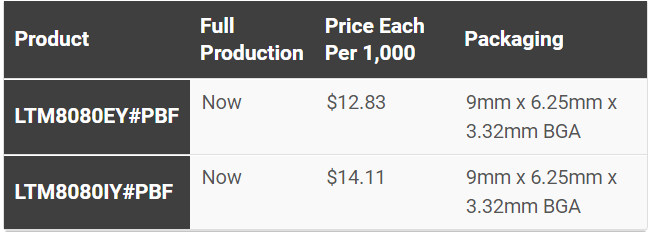
Source: Electronics Weekly
Jayce
/include/upload/kind/image/20230327/20230327171821_2708.jpg
ADI has introduced a dual output DC/DC μModule regulator with patented silicon, layout, and packaging innovations. Operating from up to 40V input, the LTM8080’s front-end is a high efficiency synchronous Silent Switcher step-down regulator followed by two separate low noise, low dropout (LDO) regulators.
2023/3/27 17:20:31
2023/3/27 17:20:31
135
0
301
6
Infineon and Delta Extend Collaboration
Infineon Technologies and Delta Electronics are expanding their long-term cooperation from industrial to automotive applications to provide more efficient and higher-density solutions for the fast-growing market of electric vehicles (EV).
The agreement covers a wide range of components such as high-voltage and low-voltage discretes and modules as well as microcontrollers to be used in EV drivetrain applications such as traction inverters, DC-DC converters and on-board chargers.
In addition, both parties agreed to set up a joint innovation lab for automotive applications. The Delta-Infineon Automotive Innovation Centre will be co-managed by both companies. It is scheduled to be set up in Pingzhen, Taiwan in the second half of 2023.
“Infineon and Delta share the common goal of developing increasingly energy-efficient and CO2-saving solutions that support global decarbonisation efforts,” said Peter Schiefer, president of Infineon’s Automotive division. “We want to further advance the energy efficiency of electromobility together by combining Infineon’s comprehensive automotive product portfolio and application know-how with Delta’s expertise in integration and system optimisation. Ensuring the energy efficiency of automotive applications is of paramount importance in our time and we are committed to further improving it.”
“Infineon is a trusted partner of Delta. Over the past 25 years we have successfully collaborated in the area of industrial products. We are now looking forward to extending this partnership to electromobility,” said James Tang, corporate VP of Delta Electronics. “We see a growing demand in the automotive industry for innovative, clean and energy-efficient solutions. Together with Infineon, we are committed to support the global transition to electromobility with our products and solutions and to bring electromobility to a whole new level.”
Source: PEW
Jayce
/include/upload/kind/image/20230324/20230324173546_1822.jpg
Infineon Technologies and Delta Electronics are expanding their long-term cooperation from industrial to automotive applications to provide more efficient and higher-density solutions for the fast-growing market of electric vehicles (EV).
2023/3/24 17:37:30
2023/3/24 17:37:30
116
0
300
6
Huawei Seeks Domestic Sources for Chips & Supply Chain
Huawei had to redesign more than 4,000 boards and replace over 13,000 components to circumvent U.S. sanctions and restrictions, according to Huawei founder Ren Zhengfei.
Ren delivered the speech during a February 24 seminar to thank the public and academics who participated in the company’s search for solutions to its technology predicament. The transcript was also posted by Peking University and Shanghai Jiao Tong University, among others.
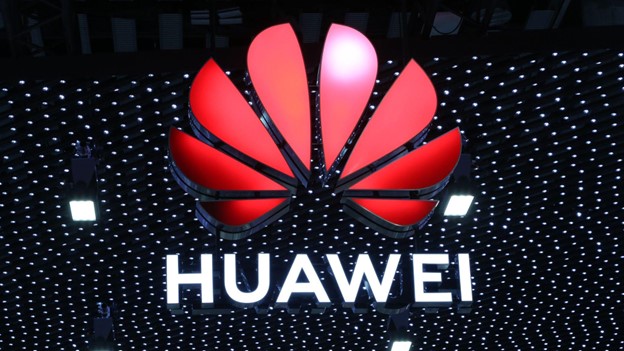
Huawei claims to be out of what rotating chairman Eric Xu described at the turn of 2023 as “crisis mode.” In his new year message, Xu noted the company would keep R&D investments high and cited growth areas, including its cloud division, and other products and services aiding the digital transformation of industries.
Xu said Huawei’s core business of selling telecom infrastructure grew in 2022 and the decline in the company’s once-dominant consumer device business has stabilized. The privately held Chinese company didn’t release annual profit figures or provide a complete breakdown of its business lines.
As part of a continued push to develop its own products, the company spent around $23.8 billion on R&D in 2022.
Chinese firms like Huawei have been stockpiling chips since 2019 in preparation for potential U.S. sanctions. Additionally, Chinese fabs were purchasing as much manufacturing equipment as possible in case the west tightened export restrictions on semiconductor manufacturing tools.
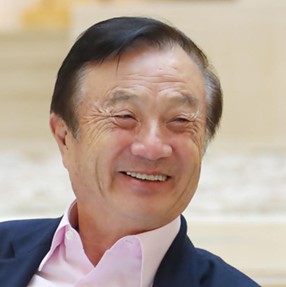
In 2019, because of the new restrictions, Ren Zhengfei forecasted a hit to revenue of about $30 billion that year and in 2020.
In 2020, the U.S. Commerce Department issued new rules prohibiting non-U.S. companies from selling any chips made using U.S. technology to Huawei without a special license. The rule covers even widely available, off-the-shelf chips made by overseas firms, placing potentially severe new limits on Huawei’s ability to source parts.
Earlier this month, the German government launched a review of the country’s 5G high-speed mobile telecommunications networks as part of a broader revamp of its relationship with China, suggesting Berlin is moving closer to banning Chinese suppliers from German networks. Unlike other European countries, Germany has stopped short of explicitly prohibiting the use of Huawei or other Chinese equipment by German operators.
Under legislation passed two years ago, the German government has broad authority to review the country’s telecommunications infrastructure for security flaws.
Huawei can’t survive with an all-domestic supply chain
Despite the rhetoric and bold moves, Huawei can’t function without foreign-made semiconductors and components. Even a non-U.S. supply chain is not possible today, and probably never.
Most of the investment in new semiconductor manufacturing in China is happening on lagging-edge nodes, where volume is needed. While Taiwan’s TSMC is the only company manufacturing leading-edge chips for mobile devices and high-performance applications, China’s HSMC can produce the millions of chips required for their automotive industry and many components Huawei uses in their communications equipment and other consumer products.
Chinese companies are also investing heavily in emerging semiconductor materials like silicon carbide (SiC) and gallium nitride (GaN), which will likely play a more significant role in managing the power systems in many applications, including in electric vehicles. Here, too, China has the necessary technology and materials, and government subsidies may help it win business on price.
For the most advanced products, such as smartphones, tablets, and laptops, Huawei must purchase components from companies such as Qualcomm, Broadcom, Intel, AMD, Sony, and many others.
The real issue is that Huawei, a company in the People’s Republic of China, evolved from manufacturing simple phone switches in the 1980s to build the most advanced telecom and networking gear.
China is shifting government policy to help its semiconductor industry
“China is giving a handful of its most successful chip companies easier access to subsidies and more control over state-backed research, as tightening U.S. controls on access to advanced technology force a major rethink in Beijing’s approach to supporting the sector,” reports Qianer Liu for the Financial Times.
According to the author, SMIC, Hua Hong Semiconductor, Huawei, Naura, and AMEC will have access to additional government funding without having to achieve performance goals that were previously required.
While it would be difficult, almost impossible, for SMIC or any other Chinese chip manufacturer to start producing leading-edge semiconductors soon, China can increase its chip output and become one of the most significant players in lagging-edge chips.
“It is projected that during the next decade, China will add about 40 percent of the new capacity and become the largest semiconductor manufacturer location in the world.” said a report by Boston Consulting Group in September 2020.
Now that component and semiconductor supplies are approaching normal, China’s real supply chain problem will be about profits and power.
Source: EPS News
Jayce
/include/upload/kind/image/20230323/20230323163314_6190.jpg
Huawei had to redesign more than 4,000 boards and replace over 13,000 components to circumvent U.S. sanctions and restrictions, according to Huawei founder Ren Zhengfei.
Ren delivered the speech during a February 24 seminar to thank
2023/3/23 16:36:46
2023/3/23 16:36:46
165
0
299
6
Microchip Puts $880m into SiC and Silicon Fab
“One significant phase of the expansion is for increased SiC manufacturing for use in automotive, e-mobility, grid infrastructure, aerospace and defence applications,” according to the company.
The 850 person Colorado Springs campus currently runs six inch wafers, and is to get eight inch capability as part of the upgrade. 400 more staff are also anticipated, said Microchip.
“Our Colorado Springs fab is part of our dual-fab strategy using both internal and external capacity to increase the resiliency of the supply chain for SiC,” Microchip silicon carbide v-p Clayton Pillion told Electronics Weekly. “The expansion includes equipment that can handle both 6in and 8in silicon carbide wafer fabrication, and we will transition to 8in when it’s prudent to do so.”
“This campus is an integral part of producing our SiC technology to assure our customers with supply certainty as they transition to SiC solutions,” said Microchip v-p of analogue Rich Simoncic.
“The Chips and Science Act is already making a positive impact on our business through the Investment Tax Credit and we are seeking capacity expansion grants for several of our semiconductor factories, including our Colorado Springs factory,” explained Microchip president and CEO Ganesh Moorthy.
Source: Electronicsweekly.com
Jayce
/include/upload/kind/image/20230321/20230321175142_8510.jpg
“One significant phase of the expansion is for increased SiC manufacturing for use in automotive, e-mobility, grid infrastructure, aerospace and defence applications,” according to the company.
The 850 person Colorado Springs campu
2023/3/21 17:52:49
2023/3/21 17:52:49
134
0
296
6
SIA Commends Introduction of Bipartisan Legislation to Restore Immediate Deductibility of R&D Investments
Significant R&D Investment May Further Drive the Growth of the U.S. Semiconductor Industry
WASHINGTON—March 17, 2023—The Semiconductor Industry Association (SIA) today released the following statement from SIA President and CEO John Neuffer commending the introduction in Congress of bipartisan legislation to restore full tax deductibility of R&D investments. The legislation, the American Innovation and Jobs Act, was introduced in the Senate by Sens. Maggie Hassan (D-N.H.) and Todd Young (R-Ind.) along with 10 other cosponsors.
“We applaud the bipartisan group of senators—led by Sens. Hassan and Young—for introducing this legislation, and we urge its swift approval.
“R&D investments are the lifeblood of innovation in the semiconductor industry, giving rise to technologies that reinforce our economy, national security, and high-tech workforce. The U.S. chip industry plows an average of one-fifth of its revenues back into R&D annually, one of the largest shares of any sector. Those investments propel rapid innovation in semiconductor technologies and seismic advancements in computing, 5G, health care, energy, AI, and more.
“Restoring the decades-long policy of allowing the immediate, full deduction of R&D investments would help make the U.S. a more competitive place for R&D and innovation, boost economic growth and job creation, and attract and retain talented workers. We look forward to working with leaders in Congress to get this bipartisan, commonsense initiative across the finish line in short order.”
Since 1954, R&D expenditures were treated as an immediate deduction. For decades, the immediate deduction for U.S. R&D expenditures provided a longstanding incentive for chip companies to make those investments, helping maintain U.S. leadership in this vital technology. As of 2022, however, U.S. R&D expenses must now be amortized over five years, making it less attractive to perform R&D in America and harming U.S. competitiveness in the semiconductor industry.
Even prior to the amortization requirement, the U.S. R&D incentive trailed those offered by global competitors, and without action to restore immediate deductibility of R&D expenses, the U.S. ranking for incentivizing research is projected to fall to the bottom quarter of OECD countries.
In addition, R&D costs are rising exponentially, with the most advanced semiconductor node costing more than $500 million to design, double the cost to design the previous leading-edge chips. Full and immediate expensing is necessary to spur R&D investments in the U.S. semiconductor industry and allow companies to further innovate and expand the domestic R&D workforce.
Source: SIA
Jayce
/include/upload/kind/image/20230320/20230320174018_5075.jpg
WASHINGTON—March 17, 2023—The Semiconductor Industry Association (SIA) today released the following statement from SIA President and CEO John Neuffer commending the introduction in Congress of bipartisan legislation to restore full tax deductibil
2023/3/21 8:54:01
2023/3/21 8:54:01
173
0
293
6
Secretary Raimondo Announces U.S.-India Semiconductor Supply Chain And Innovation Partnership MOU In New Delhi
On March 10, Secretary Gina Raimondo joined Indian Minister of Commerce and Industry Piyush Goyal and announced a U.S.-India Memorandum of Understanding (MOU) that will establish a Semiconductor Supply Chain and Innovation Partnership. The MOU was announced at the relaunch of the U.S.-India Commercial Dialogue and will focus on clean energy as well as semiconductor supply chains. The Secretary was in New Delhi from March 5-10 where she met with Prime Minister of India Narendra Modi, attended the U.S.-India CEO Forum, and held several important bilateral meetings with Indian officials. “As both of our great nations seek to create stronger and more secure supply chains, particularly in the field of semiconductors, this MOU will establish a collaborative mechanism between our two countries on semiconductor supply chain resiliency and diversification and will aim to create economic opportunity in the U.S. and India,” said Secretary Raimondo in a statement. “This is a significant step in the coordination of both our countries’ semiconductor incentive programs and will strengthen mutual priorities, including promoting commercial opportunities, R&D, and talent and skill development.”
To begin her trip, India’s Defense Minister Rajnath Singh hosted Secretary Raimondo at his home in honor of the annual Hindu festival Holi. Several other Indian officials also joined the festivities.
“A day filled with color, joy, and light,” said Raimondo. “May we carry it with us as we continue to strengthen the bonds between India and the United States.”
Later in the week, Secretary Raimondo met with Prime Minister of India Narendra Modi where they discussed the U.S.-India CEO Forum and U.S.-India Commercial Dialogue as well as the new Strategic Trade Dialogue and U.S.-India MOU on Semiconductor Supply Chain and Innovation Partnership.
At the U.S.-India CEO Forum, Raimondo stressed the importance that the Biden Administration places on U.S.-India relations and emphasized the significant opportunity to deepen commercial ties between the two countries.
The U.S.-India CEO Forum was soft-launched by Secretary Raimondo and Indian Commerce & Industry Minister Goyal in November 2022 during a meeting between the two leaders. During the meeting, they identified key priorities as increasing supply chain resilience; enhancing energy security & reducing overall greenhouse gas emissions; advancing inclusive digital trade; and facilitating post-pandemic economic recovery, especially for small businesses.
Throughout her visit, Secretary Raimondo also held several bilateral meetings with ministers from India including Minister of Electronics and Information Technology Ashwini Vaishnaw, Minster of External Affairs Dr. S. Jaishankar, Minister of Finance Nirmala Sitharaman, Minister of Education and Skill Development and Entrepreneurship Dharmendra Pradhan, and Indian National Security Advisor Ajit Doval. During these meetings, the Secretary discussed key areas of shared interest, including the Indo-Pacific Economic Framework for Prosperity, semiconductors, and supply chain resilience.
The trip comes on the heels of last month’s successful special negotiating round for the Indo-Pacific Economic Framework in New Delhi, which was attended by senior U.S. Department of Commerce officials.
lynnli
/include/upload/kind/image/20230317/20230317103042_8521.jpg
On March 10, Secretary Gina Raimondo joined Indian Minister of Commerce and Industry Piyush Goyal and announced a U.S.-India Memorandum of Understanding (MOU) that will establish a Semiconductor Supply Chain and Innovation Partnership. The MOU was
2023/3/17 10:31:02
2023/3/17 10:31:02
136
0
292
6
Chancellor Announces Over £2.5 Bn In Tech R&D: Will It Suffice To Bolster UK Tech Economy Following Sillicon Valley Bank Collapse?
British Chancellor of the Exchequer, Jeremy Hunt, announced the government’s plan to solidify Britain’s position in the global tech landscape. Among his 4 E’s – Enterprise, Education, Employment and Everywhere – to boost growth, the chancellor has announced the launch of an AI sandbox – committing £900 million to implementing recommendations for an exascale computer. Investment of £2.5 billion in a Research and Innovation Program towards the development of a quantum-enabled economy by 2033 was also announced.
However, this comes following the second and third biggest bank failures in US history (Silicon Valley Bank and Signature Bank), which have caused anxiety among investors worldwide, causing a FTSE 100 wipe off of over £50 billion on Monday. On Tuesday, the FTSE 100 remained down as major US banks experienced around $90 billion in stock market value loss on Wall Street.
The collapse of Silicon Valley Bank (SVB) sent shockwaves across the global tech sector, with the British government grappling over the weekend to limit the repercussions on the UK’s SME arena. Undoubtedly, the effects of the collapse will have a significant fallout on some of the UK’s most promising companies, mitigated to some extent by HSBC’s intervention. However, Claire Trachet, tech industry expert and CEO and founder of leading business advisory, Trachet, explains the need for stronger support for UK tech startups outside the lines of institutional funding.
Whilst Trachet explains that it’s welcome news to see HSBC step in, she also warns that this marks a turning point for the UK tech ecosystem, particularly for companies without the luxury to fall into the safety net of institutional investors. With some VC firms additionally feeling the impacts of cashflow following the demise of SVB, private equity houses now bear a significant responsibility to buffer the fallout.
Tech industry and M&A expert, Claire Trachet, comments on the Spring statement and its implications on startups, tech and M&A:
“Although the UK economy has shown signs of rebounding, it is imperative that the government continues to prioritize the tech sector. While the Science and Technology Framework is a positive step, sustained investment and attention are needed to maintain Britain’s status as a leading country for tech innovation and growth. With technology solving significant problems and investor interest growing, now is the time to be competitive and create incentives that will incite investment into the UK tech sector – something the chancellor’s spring statement has successfully addressed.
“Following the recent collapse of the UK arm of the Silicon Valley Bank, government intervention was reactive, effective, and demonstrates the speed and togetherness which will create market confidence in the UK.
“The government’s commitment to strengthening the country’s position in artificial intelligence through the AI sandbox and the clarity on IP rules for generative AI companies will enable us to bring cutting-edge products to market faster. Additionally, the £900 million funding for an exascale computer and the £2.5 billion Research and Innovation Program for quantum computing will position the UK as a world leader in this field. Introducing funds such as “The Manchester Prize” also offers an incredible opportunity for groundbreaking AI research to be recognized and incentivized in the country. “
Source:EMSNOW
lynnli
/include/upload/kind/image/20230317/20230317102602_7206.jpg
British Chancellor of the Exchequer, Jeremy Hunt, announced the government’s plan to solidify Britain’s position in the global tech landscape. Among his 4 E’s – Enterprise, Education, Employment and Everywhere – to boost growth, the chancellor
2023/3/17 10:26:06
2023/3/17 10:26:06
165
0
291
6
Smart Eye and Texas Instruments Collaborate on Next-Generation Automotive
Interior sensing technology from Smart Eye and TI enables automakers to deliver safer and more engaging in-cabin experiences for the driver and vehicle occupants.
GOTHENBURG, SWEDEN and BOSTON, MA / ACCESSWIRE / March 15, 2023 / Smart Eye, (STO:SEYE)(OTC PINK:SMTEF)(FRA:SE9) the global leader in Human Insight AI, today announced a collaboration with Texas Instruments (TI) (Nasdaq: TXN). The companies' technologies work together to provide automakers with an innovative interior sensing solution that improves driver safety, and enables in-cabin experiences that enhance comfort, wellness, and entertainment. Running on TI's new AM62A7-Q1 automotive qualified vision processor, Smart Eye's award-winning Automotive Interior Sensing AI provides critical safety features to upcoming car models going into production in 2023 and 2024. Fully compliant with new General Safety Regulations (GSR) and European New Car Assessment Programme (Euro NCAP) requirements, the solution enables higher performance and more cost-effective implementations in vehicles, to realize a collision-free future.
As GSR and Euro NCAP requirements make advanced sensing features mandatory in new vehicles in Europe, automakers now require advanced processing chips that deliver the right performance without sacrificing critical system resources, such as power, size, weight, and cost. Smart Eye's Automotive Interior Sensing AI combines its industry-leading Driver Monitoring System (DMS) software with Cabin Monitoring System (CMS) software to bring deep, human-centric insight into what is happening with all occupants inside of a vehicle.
Smart Eye's software solution supports the new AM62A7-Q1 vision processor and family of devices as well as the TDA4VM-Q1 automotive processor and family of devices for different use cases. Automakers are able to easily scale their designs and optimize performance from one car model to the next by reusing TI's device IP and single software development kit across their vehicle line up.
The AM62A7-Q1 device offers integrated ISP that can handle 5 MP at 30 frames per second, support for up to two RGB-IR cameras and a highly efficient 2 TOPS deep learning accelerator. With a high level of system integration, the TI systems on chip (SoCs) enable scalability and lower costs for advanced automotive platforms supporting multiple sensor modalities in centralized ECUs or stand-alone sensors, such as infrared cameras. Using these cameras, Smart Eye's AI-based software detects various levels of driver distraction and drowsiness as well as the attention, emotions, and activities of all occupants in the vehicle, including the objects they use. This data lets automakers adapt safety measures and advanced driver assistance systems (ADAS) in real-time - improving road safety and enhancing the mobility experience for the driver and all other occupants in a vehicle.
"Smart Eye's Interior Sensing AI is designed to run on a large variety of automotive SoCs," said Martin Krantz, Founder and CEO of Smart Eye. "We are especially excited to collaborate with TI to combine their state-of-the-art chipsets with our deep learning expertise and deliver advanced safety and mobility features that run with the highest power efficiency and performance accuracy."
"The collaboration of TI with Smart Eye allows automakers to design best-in-class driver and occupant monitoring systems, increasing the overall safety of the vehicle," said Sameer Wasson, vice president and general manager of Processors at TI. "By leveraging our new family of vision processors-coupled with Smart Eye's advanced AI software-automakers are able to create a powerful interior sensing solution that supports multiple modalities and runs at the highest levels of reliability and efficiency."
lynnli
/include/upload/kind/image/20230316/20230316112258_0965.jpg
Interior sensing technology from Smart Eye and TI enables automakers to deliver safer and more engaging in-cabin experiences for the driver and vehicle occupants.
GOTHENBURG, SWEDEN and BOSTON, MA / ACCESSWIRE / March 15, 2023 / Smart
2023/3/16 11:24:53
2023/3/16 11:24:53
138
0
290
6
Electric Vehicle Components Market Is Estimated To Be Valued At US$ 1001.95 Billion By 2032
The global electric vehicle component market is valued at USD 148.32 Billion in 2022. The market is further expected to gain size of USD 1001.95 Billion by the year 2032. The market is expected to grow with a CAGR of 21.05% in the forecast period.
Batteries used in electric vehicles come in three types, out of which lithium-ion batteries are quite expensive yet have good performance, lead-acid batteries are the cheapest in price, and nickel metal hydride batteries are moderately priced and have a higher output than lead-acid batteries. Motors used in electric vehicles are DC motors, AC induction motors switched reluctance motors and permanent magnet synchronous motors.
Electric vehicles originated in the late 18th century. Since then there have been numerous developments in the electric vehicle including the evolution of batteries, no noise pollution at all, and adaption of the technology in cars after bicycles and motorcycles. The use of lightweight material in the manufacturing of e-vehicles gives a new dimension to e-motor racing.
Which region holds the major share of this market?
Asia Pacific leads in the sales of e-vehicles because of countries like India and China owing to benefits such as government subsidies and large-scale domestic production hence increasing the electric vehicle component market. North America, Latin America, and Europe are also estimated to drive the global electric vehicle component market owing to a significant focus on minimizing vehicular emissions leading to the growing use of e-vehicles over the coming ten years. The governments in this region are actively taking steps to improve infrastructure and components. Countries like China and India are set to be dominant market space for EVM components owing to the rise in sales of electric cars.
Recent development
The market is characterized by key players which are offering a wide range of EV components that are particularly dedicatedly to the production of passenger cars and electric buses.
Companies focused on innovation and technologically driven change. These companies are opting for strategic collaboration and mergers in order to increase business reach. These players are focused on the research and development into electric vehicle components that make these firms stay competitive in the market.In 2022 March the Panasonic Corporation announced the setting up of a plant to boost the manufacturing of lithium batteries. Tesla increased their benefits due to Panasonic corporation.In 2021 February The introduction of Hyundai in the development of electric vehicle parts enhanced cost effectivity. The collaboration of Kia and Hyundai have been working on EV components in India and are likely to get a major market share in the forecast period.
Source:semiconductor digest
lynnli
/include/upload/kind/image/20230315/20230315171242_1025.png
The global electric vehicle component market is valued at USD 148.32 Billion in 2022. The market is further expected to gain size of USD 1001.95 Billion by the year 2032. The market is expected to grow with a CAGR of 21.05% in the forecast period.
2023/3/15 17:12:46
2023/3/15 17:12:46
672
0
289
6
Mitsubishi Electric to build new 8-inch SiC fab to boost power semi production

Tokyo-based Mitsubishi Electric Corp is to double the investment plan (that it announced in 2021) from 130bn yen to about 260bn yen in the five-year period to March 2026, mainly for constructing a new wafer plant to increase production of silicon carbide (SiC) power semiconductors.
Under the plan, Mitsubishi Electric expects to respond to the rapidly increasing demand for SiC power semiconductors for electric vehicles (EVs) as well as expanding markets for new applications that require, for example, low energy loss, high-temperature operation or high-speed switching.
About 100bn yen of the 130bn yen increased investment will be used to construct a new 8-inch SiC wafer plant and to enhance related production facilities. The new factory, which will incorporate an owned facility in the Shisui area of Kumamoto Prefecture, will produce large-diameter 8-inch SiC wafers. The firm will also enhance its production facilities for 6-inch SiC wafers to meet the growing demand in this sector.
In addition, Mitsubishi Electric will newly invest about 10bn yen in a new factory that will consolidate existing operations (currently dispersed throughout the Fukuoka area) for the assembly and inspection of power semiconductors. The integration of design, development and production technology verification is expected to greatly enhance the company’s development capabilities and facilitate timely mass production in response to market demand.
The remaining 20bn yen of the new investment will be targeted at equipment enhancements, environmental arrangements and related operations.
lynnli
/include/upload/kind/image/20230315/20230315170447_4984.png
Tokyo-based Mitsubishi Electric Corp is to double the investment plan (that it announced in 2021) from 130bn yen to about 260bn yen in the five-year period to March 2026, mainly for constructing a new wafer plant to increase production of
2023/3/15 17:04:50
2023/3/15 17:04:50
140
0
288
6
Top ten foundries see 4.7% q-o-q Q4 revenue fall

TSMC and GlobalFoundries raised their market shares in Q4 while the top five saw big reductions in orders.
Although TSMC had a QoQ drop of 1.0% in revenue to $20 billion, its revenue market share climbed to almost 60% mainly because tier-2 and -3 foundries took a heavier hit from customers’ inventory corrections.
TSMC’s decline in revenues from the 7/6nm nodes was mostly offset by the rise in the revenues from the 5/4nm nodes. The share of the ≤7nm nodes in TSMC’s overall revenue remained stable at 54%.
Samsung had a Q4 QoQ drop of 3.5% in foundry revenue to reach $5,391 million.
Samsung has lost a significant amount of demand for its ≤7nm nodes as Qualcomm and NVIDIA made the decision to reallocate orders for chips used in flagship hardware products.
The utilization rates of Samsung’s advanced processes are projected to remain at a low level of around 60% through 2023. Samsung lacks the momentum to achieve a positive YoY revenue growth for this year.
UMC saw a drop in both capacity utilisation rate and wafer shipments in 4Q22, so its revenue fell by 12.7% QoQ to $2,2 billion.
UMC saw a QoQ revenue decline for both 12- and 8-inch wafer foundry services, and its 0.35/0.25μm nodes had the worse revenue performance with a QoQ decline coming to 47%.
GlobalFoundries’ revenue actually rose by 1.3% QoQ to $2,101 million thanks to the optimisation in its ASP and product mixes, as well as an increase in revenue from its non-wafer business.
GlobalFoundries was the only one among the top 10 to record a positive QoQ growth, and its revenue market share also climbed to 6.2%.
SMIC saw a drop in both wafer shipments and wafer ASP. As a result, its revenue slid by 15.0% QoQ to $1.6 billion.
The sharpest falls in SMIC’s revenue for consumer ICs. To get its customers to raise wafer input, SMIC has been offering price concessions. However, this aggressive pricing strategy has not been particularly effective as customers are concerned about the risks associated with the US-China trade dispute.
Therefore, SMIC’s capacity utilisation rate and revenue are expected to shrink further in 1Q23.
VIS and Nexchip suffered from a downturn in the display panel industry and Nexchip dropped out of the top ten.
DB Hitek took Nexchip’s tenth place. Tower, which was in ninth place in the 3Q22 ranking, rose to 8th place with a 5.6% revenue decline.
VIS slipped to ninth place in the ranking.
HuaHong’s Q4 revenue for fell by 26.5% QoQ to €882 million. PSMC’s capacity utilization rate slid significantly for both 8- and 12-inch wafer foundry and suffered a 27.3% revenue drop to $408 million.
lynnli
/include/upload/kind/image/20230314/20230314164502_0418.png
In Q4 the top 10 foundries saw a 4.7% q-o-q revenue decline to $33.5 billion, reports TrendForce which expects a bigger drop in Q1.
2023/3/14 16:45:13
2023/3/14 16:45:13
169
0
287
6
Onsemi’s EFK Fab Purchase Ups Its Sustainability Game
Onsemi successfully acquired GlobalFoundries’ (GF) 300-mm East Fishkill (EFK), NY, site and fabrication facility, helping onsemi manufacture products with high gross margins in high-growth and sustainable applications like electric vehicles (EVs) and energy infrastructure, CEO Hassane El-Khoury said in an exclusive interview with EE Times.
With the acquisition, onsemi added more than 1,000 engineers and technologists. U.S. Senator Chuck Schumer (D-NY) and J.D. Grom, senior advisor to the U.S. Secretary of Commerce on CHIPS Act implementation, were on hand for the event celebrating the acquisition, emphasizing the significance of domestic semiconductor manufacturing.
“EFK offers an improved manufacturing cost structure due to the economics of scale of a 300-mm wafer compared to smaller wafer sizes,” El-Khoury told EE Times. “While the highly automated wafer fab equipped with advanced toolsets enables us to produce superior quality chips that meet automotive standards, it is the skilled and experienced engineers that will improve our ability to ramp products to volume and reduce our time to market. With the EFK site, onsemi is adding complex CMOS capabilities [including 65-nm technology nodes] that are required for image sensor production to its manufacturing footprint.”
Automotive OEMs, renewable energy companies and industrial manufacturers are some of the customers that require these advanced products, he added.Ribbon-cutting ceremony for onsemi’s EFK fab acquisition. (Source: onsemi)Workforce and marketsThe purchase plan was in the works for a long while: In the last three years, onsemi has focused on securing a long-term future for the EFK fab and its employees, making substantial investments in its 300-mm capabilities to accelerate growth in the company’s power, analog and sensing products, and enable a more cost-effective manufacturing structure.The EFK fab is the largest onsemi manufacturing facility in the U.S., according to the company. It adds advanced CMOS capabilities to the company’s manufacturing profile, including 65-nm technology nodes with specialized processing capabilities required for image-sensor production.
The transaction entails an exclusive agreement to provide differentiated semiconductor solutions to GF, as well as investments in research and development, as the parties collaborate to build future growth.
“Short term, the ramp at our EFK site helps onsemi to ensure continuous supply to customers of our intelligent power technologies, especially in the automotive sector,” El-Khoury said. “As a highly automated fab with advanced toolsets, EFK is also able to meet the most stringent quality requirements as, for example, demanded by the automotive industry.
“Long term, moving production from less efficient fabs to EFK and making significant investments in the site’s 300-mm capabilities gives onsemi a key competitive advantage by improving its manufacturing cost structure. It also enables high growth and differentiation in onsemi’s power, analog and sensing technologies, which are instrumental in accelerating onsemi’s growth in key applications such as 5G, EVs, ADAS, solar, energy infrastructure and factory automation.”
The ability to run such a diverse portfolio of technologies using shared tools with different requirements and specifications is one of the challenges, according to El-Khoury. The specifications and requirements for discrete production processes and tools are distinct from those for image sensor products and must be carefully managed.
“Another challenge is that this being the only 300-mm fab, there is no exact copy for bringing in new technologies. Instead, processes need to be developed and scaled to 300mm from smaller wafer size fabs,” he added.
Recruiting a highly skilled workforce in this geographic location is difficult compared with other locations where a robust ecosystem of technologists and engineers already exists. This is one of the reasons onsemi is supporting regional and local institutions, such as high schools and community colleges, El Khoury said.
“Upcoming community programs will include cultivating educational ecosystems, supporting future innovators from high school to Ph.D., and fostering local skilled labor development through community college partnerships,” he said. “Onsemi will also work with under-served communities and high schools to help provide a focus on STEM. As part of developing a strong talent pipeline, onsemi recently pledged to donate $500 thousand to Rochester Institute of Technology over the next 10 years to support projects and education targeting engineers in the semiconductor industry. Outside of institutions, we pride ourselves on focusing on cultivating a strong sense of community and having a deep history of giving back to local communities we work and live in.”Onsemi CEO Hassane El-Khoury. (Source: onsemi)Sustainability a strong focusFluctuating energy prices and a growing awareness of environmental impact are advancing a new era of environmentally friendly electronics production. Given that the electronics industry is responsible for 4% of global greenhouse gas emissions, there is an urgent need for innovative research and development aimed at addressing this issue. Recently, a number of promising new technologies have emerged, which bodes well for the long-term prospects of the industry.
Semiconductor manufacturing can both be a resource and carbon emissions intensive process, according to El-Khoury. This is due to direct emissions (Scope 1) from process gases with high global warming potential used during wafer etching or chamber cleaning, and indirect emissions (Scope 2) that occur from use of purchased electricity, steam, heating, and cooling of equipment.
Corporations, particularly electronic device manufacturers (semiconductors), have initiated environmental, social and governance initiatives in response to severe climate change. The increasing temperature of the Earth’s surface as a result of the uncontrolled burning of fossil fuels around the world has disrupted its entire ecosystem. Damage to natural flora and fauna, melting ice caps, erratic climate, and rising temperatures are examples of the impact. The sustainability of the semiconductor and electronics industries is being enhanced by both government regulations and green investment initiatives.
“As an industry, we know there is work to be done and believe that, through continued collaboration and innovation, we can drive meaningful greenhouse gas and resource reductions across the industry,” El-Khoury said. “In November, onsemi, along with more than 60 other founding members, formed the Semiconductor Climate Consortium, demonstrating commitment as the first global collaborative of semiconductor ecosystem companies focused on reducing greenhouse gas emissions across the value chain.”
Industries across different sectors are responsible for the increasing carbon emissions in the environment. This magnitude of carbon emissions, also known as the carbon footprint, is increasingly large for the semiconductor manufacturing industry. With the rising demand for faster and more efficient hardware platforms, a large amount of energy generated from fossil fuels contributes to growing pollution.
As a result of the global threat posed by climate change and its adverse effects, semiconductor device manufacturers like onsemi are setting an example by not only reducing greenhouse gas emissions in their own supply chain, but also developing products that will assist their customers in doing the same.
sources:eetimes
lynnli
/include/upload/kind/image/20230307/20230307173714_1163.jpeg
Onsemi successfully acquired GlobalFoundries’ (GF) 300-mm East Fishkill (EFK), NY, site and fabrication facility, helping onsemi manufacture products with high gross margins in high-growth and sustainable applications like electric vehicles (EVs)
2023/3/7 17:39:39
2023/3/7 17:39:39
143
0
286
6
Global Semiconductor Sales Decrease 5.2% Month-to-Month in January
WASHINGTON—March 3, 2023—The Semiconductor Industry Association (SIA) today announced global semiconductor industry sales totaled $41.3 billion during the month of January 2023, a decrease of 5.2% compared to the December 2022 total of $43.6 billion and 18.5% less than the January 2022 total of $50.7 billion. Monthly sales are compiled by the World Semiconductor Trade Statistics (WSTS) organization and represent a three-month moving average. SIA represents 99% of the U.S. semiconductor industry by revenue and nearly two-thirds of non-U.S. chip firms.
“Despite record-high sales in 2022, the global semiconductor market cooled considerably during the second half of the year, and that trend continued during the first month of 2023,” said John Neuffer, SIA president and CEO. “Despite the current short-term cyclical downturn, the long-term outlook for the semiconductor market remains strong due to the ever-increasing role of chips in powering the critical technologies of today and tomorrow.”

Regionally, month-to-month sales increased slightly in January in Europe (0.6%), but decreased in Japan (-2.1%), Asia Pacific/All Other (-2.7%), the Americas (-7.9%), and China (-8.0%). Year-to-year sales ticked up in Europe (0.9%) and Japan (0.7%), but fell in the Americas (-12.4%), Asia Pacific/All Other (-19.5%), and China (-31.6%).
For comprehensive monthly semiconductor sales data and detailed WSTS forecasts, consider purchasing the WSTS Subscription Package. For detailed historical information about the global semiconductor industry and market, consider ordering the SIA Databook.
sources:SIA
lynnli
/include/upload/kind/image/20230306/20230306153029_7918.png
WASHINGTON—March 3, 2023—The Semiconductor Industry Association (SIA) today announced global semiconductor industry sales totaled $41.3 billion during the month of January 2023, a decrease of 5.2% compared to the December 2022 total of $43.6 bill
2023/3/6 15:33:01
2023/3/6 15:33:01
160
0
285
6
Semiconductor Wet Chemicals 1H2023 Trending Down
TECHCET— the electronic materials advisory firm providing business and technology information on semiconductor supply chains — is forecasting the Semiconductor Wet Chemicals market to slow to -0.9% in growth in 2023, as noted in the most recent update to TECHCET’s Wet Chemicals Critical Materials Report? . This slowdown is following downward trends for the overall global economy as risks of recession and rising inflation continue. Through 2023, the semiconductor materials market is expected to be flat, though positive growth could be seen if average selling prices from last year’s demand hold over to this year. By 2H2023, TECHCET is anticipating growth to return, leaving a forecasted 6.4% 5-Year CAGR from 2022-2027.

TECHCET is estimating wafers starts to also decline by about 5% in 2023. Between 2022 and 2023, NAND flash makers are rolling out approximately 200+ layer chips offerings. Into 2026 and 2027, 4XXL and 5 XXL 3DNAND are also expected to surge.
DRAM is currently undergoing a transition to EUV and full implementation of High-k/Metal Gate. Architectural changes and new patterning technology has also driven the need for new unit processes and new materials. With each such change, there is a growing need for more Chemicals and Wet Clean processes.
Several new material expansions have been announced between the US and Korea that should affect the Wet Chemicals market in the coming future. For example, LCY Group based in Taiwan, who is a key supplier to TMSC, has publicly announced an IPA repackaging and purification in Phoenix. Additionally, Chang Chun Group’s $400M investment towards a H2O2, TMAH, and plating solution facility in Arizona is expected to conclude their phase 1 soon.
sources:semiconductor digest
lynnli
/include/upload/kind/image/20230306/20230306151925_7829.png
TECHCET— the electronic materials advisory firm providing business and technology information on semiconductor supply chains — is forecasting the Semiconductor Wet Chemicals market to slow to -0.9% in growth in 2023, as noted in the most recent u
2023/3/6 15:21:08
2023/3/6 15:21:08
157
0
284
6
Demand to return in H2
Currently there are bloated inventories for components like memory, small case-size ceramic capacitors and automotive MCUs, but FPGAs, analogue ICs, power MOSFETs, MCUs and discretes remain constrained and costly.
In Q3, lead times for all electronic components will reduce compared to Q3 2022 with nearly 60% of component lead times decreasing versus 1% in Q3 22 with none expected to increase compared to 73% in Q3 22.
Despite inventory reductions that will likely be complete by the end of H1, IC orders, wafer starts, and capacity utilisation will begin to rise and memory pricing will reach its bottom in H2. DRAM prices will start to recover in Q3 and NAND pricing will follow in Q4 or early in 2024.

lynnli
/include/upload/kind/image/20230303/20230303170344_4108.jpg
Currently there are bloated inventories for components like memory, small case-size ceramic capacitors and automotive MCUs, but FPGAs, analogue ICs, power MOSFETs, MCUs and discretes remain constrained and costly.
In Q3, lead times for
2023/3/3 17:04:43
2023/3/3 17:04:43
151
0
283
6
Infineon buys GaN Systems
“GaN technology is paving the way for more energy-efficient and CO 2-saving solutions that support decarbonization. Adoption in applications like mobile charging, data center power supplies, residential solar inverters, and onboard chargers for electric vehicles is at the tipping point, leading to a dynamic market growth,” said Jochen Hanebeck (pictured) CEO of Infineon. “The planned acquisition of GaN Systems will significantly accelerate our GaN roadmap, based on unmatched R&D resources, application understanding and customer project pipeline. Following our strategy, the combination will further strengthen Infineon’s leadership in Power Systems through mastery of all relevant power technologies, be it on silicon, silicon carbide or gallium nitride.”
As a wide bandgap material, GaN offers customer value by higher power density, higher efficiency, and size reductions, especially at higher switching frequencies.
These properties enable energy savings and smaller form factors, making GaN suited for a wide range of applications.
GaN is becoming a key material for power semiconductors, alongside silicon and silicon-carbide, and coupled with new topologies, such as Hybrid Flyback and multi-level implementations.
In February 2022, Infineon announced doubling down on wide bandgap by investing more than €2 billion in a new frontend fab in Kulim, Malaysia, strengthening its market position.
The first wafers will leave the fab in the second half of 2024, adding to Infineon’s existing wide bandgap manufacturing capacities in Villach, Austria.
lynnli
/include/upload/kind/image/20230303/20230303170043_9771.png
“GaN technology is paving the way for more energy-efficient and CO 2-saving solutions that support decarbonization. Adoption in applications like mobile charging, data center power supplies, residential solar inverters, and onboard chargers for el
2023/3/3 17:01:52
2023/3/3 17:01:52
160
0
282
6
Europe Plans for a Comeback as Automakers Sign with Chipmakers
Mitigating the effects of future shortages is on everyone’s mind. As the shortage downturn continues, countries and companies are planning on how to conquer the next. Lack of diversification and traditional methods of chip capacity is no longer safe. The vulnerabilities of manufacturing within a single geopolitical area and the lack of collaboration between chipmakers and other equipment manufacturers are dangerously significant.
To keep history from repeating itself, federal organizations are doing what they can to ensure investments for a resilient chip future. Automakers are becoming more proactive in their supply chains by partnering with chipmakers to secure future stock capacity no matter the demand. These steps will make all the difference in the future.
General Motors Signs with Global Foundries as Automakers Suffer from Shortage Impacts
The chip shortage has been rough on automakers for years now. Despite the downturn for advanced chips in white goods, automotive and industrial original equipment manufacturers (OEMs) still face allocation issues. It will take some time to achieve a supply-demand balance, especially with automotive demand still at record highs. In the meantime, automakers and original chip manufacturers (OCMs) are doing what they can to mitigate future shortages.
General Motors recently entered a long-term agreement with GlobalFoundries to establish exclusive production capacity of U.S.-produced chips. This deal, the first of its kind, demonstrates dedicated production capacity exclusively for key auto suppliers for General Motors at the GlobalFoundries fab in upstate New York.
Doug Parks, executive VP of global product development at General Motors, said, “the supply agreement with GlobalFoundries will help establish a strong, resilient supply of critical technology in the U.S. that will help GM meet this demand while delivering new technology and features to our customers.” The agreement couldn’t come at a better time as Mr. Parks believes that General Motors’ usage of semiconductors will double over the coming years as technological capabilities in cars increase.
The deal is expected to provide the framework for future agreements between GlobalFoundries and other automakers. Historically, automotive OEMs and OCMs have yet to work together. The last few years of the global chip shortage have mercilessly exposed the dangers of that traditional method.
This is especially true within the development of all-electric cars and trucks that require more chips than traditional vehicles. While the deal is the first of its kind, that doesn’t mean that other automakers are making similar agreements with OCMs. Volkswagen recently signed a contract with Onsemi to provide modules and semiconductors. Onsemi will offer a complete electric vehicle (EV) traction inverter solution for VW, with semiconductors being integral in support of front and rear traction inverters. ZF invested in Wolfspeed’s construction of its first semiconductor facility in Europe. The research and development unit of the new facility will be majority owned by ZF, whose first research applications will be chips in power converters for electric ships and wind turbines.
As the automotive shortage drags on, these partnerships will continue to increase over the next few months. These effects are still being felt and will continue through 2023, with Ford’s recent billion-dollar loss from 100,000 vehicles undelivered, highlighting the impact.
How Europe is Combating the Chip Shortage
The chip shortage hurt, and now countries are doing what they can to prevent a similar situation in the future. The U.S. has spent the last few years enticing chipmakers to its shores through the CHIPS and Science Act. The law allocates $52 billion in subsidy programs and incentives for semiconductor fabrication plant construction and research. Outside the federal level, states are passing their programs to make their locations more appealing to OCMs eager to take advantage of federal programs.
India and Vietnam are competing to become the new Asian chip market supplier. Foxconn, Google, Samsung, and other big-name chipmakers have been viewing different locations and entering joint partnerships for new facilities in either country. Both countries have various benefits, from subsidies to talented labor supply, that make them attractive options for OCMs.
The European Semiconductor Industry Association (ESIA) forecasts volatility within the semiconductor supply chain. Despite a possible .3% decline in market growth, challenges within the automotive chip supply chain.
The most significant effort to fortify semiconductor supply resilience is the European Union’s Chips Act. The act aims to bolster production and set up emergency measures to prevent shortages through an investment of €43 billion, both public and private. It should boost the EU’s share of global chip production from 9% to 20% by 2030. This will be done in tandem with a chip diplomacy initiative as the EU recognizes the importance of its foreign partnerships.
Should the Chips Act pass, several domestic and foreign chipmakers have been considering expanding production within the EU. STMicroelectronics, a Swiss firm, received €600 million from the European Investment Bank to support research, development, and pre-industrialization within Europe. STMicroelectronics has several facilities that operate within Italy and France, with a new fab in eastern Sicily planned to begin production in 2026. German-based chipmaker Infineon is planning its €5 billion investment for a new semiconductor plant in Dresden, hinging on the passage of the EU’s Chips Act.
If the Chips Act passes, Infineon’s Dresden fab should begin production in 2026. It would be the most significant single investment in the country’s history and add demand from end markets, including automotive, industrial, and renewables.
Intel is also considering a semiconductor mega-site in Germany should the Chips act pass. Throughout the last few years, Germany has risen in popularity as an attractive location for semiconductor production. US chipmaker Wolfspeed recently announced its plans for Germany's largest silicon carbide (SiC) manufacturing facility. As the first chip factory in Europe for Wolfspeed, it will rely on the European Commission for approval.
Should the Chips Act pass, Europe can quickly fortify its domestic capabilities and future resilience to chip shortages.
Sources:sourcengine
lynnli
/include/upload/kind/image/20230302/20230302140017_1677.jpg
Mitigating the effects of future shortages is on everyone’s mind. As the shortage downturn continues, countries and companies are planning on how to conquer the next. Lack of diversification and traditional methods of chip capacity is no longer sa
2023/3/2 14:00:19
2023/3/2 14:00:19
160
0
280
6
Micross Completes Acquisition of the High-Reliability DC-DC Converter Business of Infineon Technologies AG
Feb. 28, 2023. Micross Components, Inc. ("Micross" or the "Company"), a leading provider of high-reliability microelectronic product and service solutions for aerospace, defense, space, medical and industrial applications and a portfolio company of Behrman Capital, today announced it has closed the acquisition of the High-Reliability DC-DC converter business (the "Business") of Infineon Technologies AG (FSE: IFX / OTCQX: IFNNY), a global semiconductor leader in power systems and IoT.
Headquartered in San Jose, California with a facility in Copenhagen, Denmark, the Business provides high-reliability DC-DC converters, including hybrid and custom board-based power products for space, strategic defense, aerospace, and other high-reliability customers. The Business designs and manufactures proprietary power solutions which operate in the harshest environments.
Micross' acquisition – the eighth under Behrman Capital's ownership and fourth since consummating a continuation fund transaction in February of 2022 – continues to build on the strategic priorities for the Company. The addition of Infineon's High-Reliability DC-DC converter business expands Micross' power management solution offerings which are supported by a high degree of intellectual property. The acquisition also expands Micross' geographic footprint in the US and Europe and the Company's presence in the high-growth space end market, better positioning the Company for future growth opportunities.
Vince Buffa, Chairman and CEO of Micross, said, "We are delighted to partner with this experienced team which further expands the Micross team's design capabilities. The acquisition brings significant proprietary IP around power management, combined with state-of-the-art manufacturing capabilities and a product portfolio that is a market leader for the advancement of innovative solutions. We will be better positioned to produce an even wider range of high-quality products for our customers. Together, we plan to pursue a number of compelling opportunities to further realize our exciting growth prospects, all while upholding excellent quality and service to our customers."
Simon Lonergan, Managing Partner of Behrman Capital, said, "This acquisition represents an extremely strong strategic fit for Micross, as the Company continues to build out its high-reliability product portfolio to better serve its customer base. Adding Infineon's DC-DC converter Business to Micross' platform further differentiates and adds significant IP to the Company's leading position as a one-stop source of supply for high-reliability electronic products and services. We look forward to continuing to work with management to identify additional opportunities to drive growth at Micross."
Sources:marketscreener
lynnli
/include/upload/kind/image/20230302/20230302134030_8391.jpg
Feb. 28, 2023. Micross Components, Inc. ("Micross" or the "Company"), a leading provider of high-reliability microelectronic product and service solutions for aerospace, defense, space, medical and industrial applications and a portfolio comp
2023/3/2 13:42:33
2023/3/2 13:42:33
130
0
279
6
Intel releases Quantum Software Development Kit
The SDK is a full quantum computer in simulation that can interface with Intel’s quantum hardware, including the Horse Ridge II control chip and Intel’s quantum spin qubit chip when it becomes available this year.
The kit has been created to allow developers to programme quantum algorithms in simulation, and it features an intuitive programming interface written in C++ using an industry-standard low-level virtual machine (LLVM) compiler toolchain. Consequently, Intel’s SDK offers a seamless interface with C/C++ and Python applications, making it both versatile and customisable.
“The Intel Quantum SDK helps programmers get ready for future large-scale commercial quantum computers. It will not only help developers learn how to create quantum algorithms and applications in simulation, but it will also advance the industry by creating a community of developers that will accelerate the development of applications, so they are ready when Intel’s quantum hardware becomes available,” said Anne Matsuura, director of Quantum Applications & Architecture, Intel Labs.
The Intel Quantum SDK 1.0: Version 1.0 of the SDK includes an intuitive programming interface based on C++, providing a programming language that’s familiar to classical computing developers, enabling collaboration between them and quantum developers.
The kit also features a quantum runtime environment that’s been optimised for executing hybrid quantum-classical algorithms. Developers have the choice of two target backends for simulating qubits to either represent a higher number of generic qubits or Intel hardware.
The first backend is a high-performance open-source generic qubit simulator, Intel Quantum Simulator (IQS). IQS has a backend capable of 32 qubits on a single node and more than 40 qubits on multiple nodes. The second is a target backend that simulates Intel quantum dot qubit hardware and enables compact model simulation of Intel silicon spin qubits. Intel’s qubits leverage the company’s expertise in silicon transistor manufacturing to build a large-scale quantum computer.
With the SDK, users will be able to develop small workloads to determine what functionalities are needed from the quantum computer’s system architecture to run algorithms efficiently and accurately on qubits. In addition, Intel is using the SDK internally to co-design quantum hardware and software in tandem, accelerating system development.
The SDK is a customisable and expandable platform providing greater flexibility when developing quantum applications. It also provides for users to compare compiler files, a standard feature in classical computing development, to discern how well an algorithm is optimized in the compiler. It allows users to see the source code and obtain lower levels of abstraction, gaining insight into how a system stores data.
Intel has also extended the industry-standard LLVM with quantum extensions and developed a quantum runtime environment that is modified for quantum computing, and the IQS provides a state-vector simulation of a universal quantum computer.
The compiler extensions allow developers to integrate results from quantum algorithms into their C++ project, opening the door to the feedback loops needed for hybrid quantum-classical algorithms like the quantum approximate optimization algorithm (QAOA) and quantum variational eigen-solver (VQE).
Finally, Intel DevCloud users will be able to build executables capable of simulating applications and algorithms with up to 32 qubits on a single computational node and more than 40 on multiple nodes.
Intel has said that it is committed to advancing the quantum computing field and is working to build a community of developers. As a starting point for this effort, Intel has provided grants to five universities to develop quantum course curricula to share with additional universities and proliferate its use across academia. These include: the University of Pennsylvania, Technische Hochschule Deggendorf, Keio University, The Ohio State University and Pennsylvania State University.
Sources:new electronics
lynnli
/include/upload/kind/image/20230301/20230301161104_9451.jpg
The SDK is a full quantum computer in simulation that can interface with Intel’s quantum hardware, including the Horse Ridge II control chip and Intel’s quantum spin qubit chip when it becomes available this year.
The kit has been
2023/3/1 16:12:44
2023/3/1 16:12:44
146
0
278
6
Quantum market to be worth $2bn in 2030
The quantum market will be worth $2.1 billion in 2030, says Yole Developpement, with the quantum computing segment reaching more than $4 billion by 2035.
Overall the quantum technology market place will grow with a 13% CAGR from a total market of $761 million in 2022 to $1,099 million in 2025.
Breaking this down to sub-markets: quantum computing was worth $65 million in 2022, which Yole differentiates from Quantum computing as a service (QaaS), which it reckons was worth $46 million.
So quantum computing overall was worth $111 million in 2022. Meanwhile quantum sensing and timing market was already worth $545 million in 2022. The quantum cryptography market was smaller at $106 million.
This is a small market with much of the effort in R&D, particularly on the quantum computing side, where tremendous growth is expected
Step by step, an industrial quantum supply chain is developing as many companies are positioning themselves.
Many technological options are being pursued (superconductors, photons, trapped ions, cold atoms …) for quantum technologies, but the final choices are not yet fixed.

Quantum technologies have three primary applications: computing, communication, and sensing.
Computing still attracts most of the R&D effort and investor money. However, pushed by quantum computing developments, the other two are also starting to attract more attention: quantum networking will be necessary to interconnect quantum computers, and new applications will require ultra-sensitive sensors based on quantum effects.”
“As quantum computers become readily available, they will be able to break the current integrity keys used for data exchange,” says Yole’s Eric Mounier, “this creates a direct connection to quantum cryptography, and post-quantum approaches are being developed to prevent future hacking by quantum computers (communication, bitcoins, cryptocurrency, etc., could also be compromised by quantum computers).”
“The quantum ecosystem is maturing step-by-step and strengthening through research project collaborations, patent portfolio (China is currently dominant), creation of numerous startups (USA, Canada, and Europe are leading), and big semiconductor vendor/equipment makers entering the game,” adds Mounier, “as a consequence, an industrial quantum supply chain is developing. Many companies are positioning themselves, from materials and equipment providers to chip foundries, systems, services, and associated hardware.”
The involvement of semiconductor players, including GlobalFoundries, TSMC, X-FAB, Intel, photonics with Ligentec, and equipment makers (for example, Keysight, Formfactor, Oxford Instruments, AMAT) is setting up a robust technological base for future quantum technologies: spin QD is, of course, also of interest, as it leverages Si CMOS technology.
But partnerships are still critical since only relatively few companies can pursue different R&D approaches simultaneously.
Infineon Technologies is the exception, with R&D on three different technological qubit techniques: superconducting, trapped ions, and spin.
The trend today is to have a “full stack approach” from the quantum chips up to the computer and software/service level.
However, as this approach requires significant R&D resources, people, budget, and effort, not all players can do it
Sources:electronicsweekly
lynnli
/include/upload/kind/image/20230301/20230301160009_0076.jpg
The quantum market will be worth $2.1 billion in 2030, says Yole Developpement, with the quantum computing segment reaching more than $4 billion by 2035.
Overall the quantum technology market place will grow with a 13% CAGR from a to
2023/3/1 16:02:37
2023/3/1 16:02:37
135
0
277
6
Rochester Electronics Partners With Toshiba
Rochester Electronics is partnering with Toshiba Electronic Devices & Storage Corporation, a leading supplier of advanced semiconductor and storage solutions. Toshiba semiconductors and storage products support a wide range of industrial, automotive, and consumer applications.
“We are deeply honored to announce a new partnership with Toshiba Electronic Devices & Storage, a highly respected global brand offering top-quality semiconductor and storage solutions. It is through this strategic agreement, that our valued customers can be assured to have a continued supply of Toshiba semiconductor solutions, which will not only be certified and guaranteed by Rochester but will also be 100% authorized by the original manufacturer. We look forward to continuing to grow our partnership with Toshiba.”- Rob Maycroft, VP, Global Supplier Development, Rochester Electronics
About Toshiba Electronic Devices & Storage Corporation
Toshiba Electronic Devices & Storage Corporation, a leading supplier of advanced semiconductor and storage solutions, draws on over half a century of experience and innovation to offer customers and business partners outstanding discrete semiconductors, system LSIs, and HDD products. The company shares a determination to maximize product value and promote close collaboration with customers in the co-creation of value and new markets. Toshiba Electronic Devices & Storage Corporation looks forward to building and to contributing to a better future for people everywhere.
About Rochester Electronics
Rochester Electronics is the world’s largest continuous source of semiconductors–100% Authorized by over 70 leading semiconductor manufacturers.
As an original manufacturer stocking distributor, Rochester has over 15 billion devices in stock encompassing more than 200,000-part numbers, providing the world’s most extensive range of end-of-life (EOL) semiconductors and broadest range of active semiconductors.
As a licensed semiconductor manufacturer, Rochester has manufactured over 20,000 device types. With over 12 billion die in stock, Rochester has the capability to manufacture over 70,000 device types. Rochester o?ers a full range of manufacturing services including Design, Wafer Processing, Assembly, Test, Reliability, and IP Archiving providing single solutions through to full turnkey manufacturing, enabling faster time-to-market.
Rochester is the Semiconductor Lifecycle Solution. No other company compares to the breadth of Rochester’s product selection, value-added services, and manufacturing solutions.
With direct sales and support staff in all major markets, complemented by a network of regional and global authorized channel partners, we aim to meet your needs over the phone or via our e-commerce platforms anytime, anywhere.
sources:EPSNews
lynnli
/include/upload/kind/image/20230228/20230228153132_5389.jpg
Rochester Electronics is partnering with Toshiba Electronic Devices & Storage Corporation, a leading supplier of advanced semiconductor and storage solutions. Toshiba semiconductors and storage products support a wide range of industrial, autom
2023/2/28 15:33:12
2023/2/28 15:33:12
140
0
276
6
MediaTek showcases satellite connectivity technology at MWC 2023
The first smartphones with MediaTek’s satellite connectivity are also being launched at MWC, and the company said that more devices would be unveiled in the coming months. MediaTek is also sharing its next-generation 5G New Radio NTN (NR-NTN) technology for the next wave of satellite-enabled devices.
Satellite networks aim to fill gaps in mobile coverage, offering a reliable way for devices to communicate in remote locations. With satellite-enabled smartphones, consumers will be able to stay in touch in situations where there has traditionally been no connectivity; but this technology will also enable users to request assistance in emergency situations.
At present, the biggest market opportunity for 3GPP NTN technology is smartphones, although there is a growing demand for satellite connectivity in IoT applications such as agriculture, forestry, and logistics. The automotive industry is also expected to be a major market for satellite communications technology in the coming years.
“Two-way satellite communications on smartphones and other devices will usher us into a new era of connectivity and open up new possibilities across many different verticals,” said JC Hsu, Corporate Vice President and General Manager of MediaTek’s wireless communications business unit. “Our standalone MT6825 chipsets, which are based on the 3GPP NTN open standard, can be integrated into any flagship smartphone to deliver a seamless satellite connectivity experience.”
MediaTek’s satellite communications portfolio will look to target both IoT-NTN and NR-NTN technology based on the 3GPP 5G specification for Release 17 (R17). IoT-NTN is suitable for messaging since it is designed for low data rate connections, while NR-NTN allows for higher data rates that can support video calls and other applications.
Since satellite networks can currently only support IoT-NTN on a mass scale, the initial wave of satellite-enabled smartphones and other devices powered by MediaTek will be designed for two-way satellite messaging services.
MediaTek is currently working with Bullitt to bring the world’s first commercially available devices with 3GPP NTN technology, utilising the MT6825 chipset to connect to the Bullitt Satellite Connect platform. This includes the Motorola defy 2 and CAT S75 smartphones; and the Motorola defy satellite link, a compact and lightweight Bluetooth accessory that allows Android and iOS devices to connect to the Bullitt
According to Bullitt its Satellite Connect service will provide users with access to two-way satellite messaging, location sharing, and emergency SOS in more places around the world.
The forthcoming NR-NTN chipset from MediaTek will allow devices to support services with higher data rates like navigation and real-time communication.
As satellite networks build capacity for NR-NTN over the coming years, this is expected to open up a range of new consumer, enterprise, and industrial use cases as smartphones, IoT devices, and vehicles can take advantage of reliable connectivity everywhere.
To make it easy for brands to integrate two-way satellite communications into smartphones and other devices, MediaTek’s IoT-NTN solutions are standalone chipsets that can be added to any 4G or 5G device. The chipsets utilise the open 3GPP R17 NTN standard, rather than proprietary solutions. For OEMs, the advantage of the standard is that once a device has been certified for 3GPP R17 IoT-NTN it can be used on any IoT-NTN compliant network.
Additionally, mobile network operators can partner with service providers to offer roaming services or establish their own satellite networks that support the standard.
In addition to the benefits of supporting 3GPP R17 NTN, MediaTek’s MT6825 IoT-NTN chipset has a number of other features. It can connect to Geosynchronous Equatorial Orbit (GEO) constellations, which could be converted into 3GPP NTN compliant network easily and are widely available now on the orbit. To provide a seamless experience, MT6825 allows devices to automatically receive messages from satellites, unlike other solutions that require users to manually check for messages. The chipset has low system requirements, is very power efficient to provide greater battery life, and comes in a highly integrated design that helps accelerate time to market.
lynnli
/include/upload/kind/image/20230228/20230228152101_0801.png
The first smartphones with MediaTek’s satellite connectivity are also being launched at MWC, and the company said that more devices would be unveiled in the coming months. MediaTek is also sharing its next-generation 5G New Radio NTN (NR-NTN) tech
2023/2/28 15:22:25
2023/2/28 15:22:25
283
0
275
6
Infineon presents user-friendly LCC design tool
The PFC plus LCC topology is said to be 5 to 6 percent more efficient than other commonly used two-stage topologies, but the design of LED drivers with this topology is highly time-consuming. Infineon’s new LCC tool, which is said to be a first in the market, is intended to make the design work much faster and easier.
Lighting accounts for a significant portion of the world’s total electricity consumption, emphasising the importance of energy-efficient solutions in this sector. PFC plus LCC resonant topology for constant current output has offered improved levels of efficiency together with a large output voltage range in high-power LED lighting applications, such as outdoor and horticultural lighting. The high design effort and complexity involved have, however, been limiting in terms of the widespread usage of this well-suited and efficient topology in LED drivers.
“Our new LCC design tool offers a streamlined solution for designers to deploy highly efficient and reliable PFC plus LLC solutions in reduced time and effort, bypassing a time-consuming iterative design approach,” explained Hakan Yilmazer, Head of Application Management Lighting at Infineon Technologies.
“Assuming that 300 million LED drivers with an average power of 60W were converted from less efficient topologies to PFC plus LCC topology, the energy produced by one large coal power plant with a capacity of 1000 MW could be saved per year. This is now possible with the support of Infineon’s LCC tool as well as the broad portfolio of suitable controllers and power switches.”
PFC plus LCC topology is the preferred version of PFC plus resonant topology due to the wide output voltage range that can be achieved, offering high efficiency of up to 94 percent.
Resonant topologies are usually used for power ranges greater than 100W by most LED driver vendors, where the topology benefits are most obvious. This topology is not limited to high-power LED drivers only, but it can also be deployed in power ranges down to 40W as an alternative topology to Flyback plus DC-DC buck.
With Infineon’s LCC design tool, designers simply enter their key parameters, and the tool will then provide the necessary data to design their circuit, reducing their time and effort to design the circuit by more than 50 percent.
Infineon is also able to offer two high-performance and highly integrated combo controllers, the ICL5102 and ICL5102HV, that can fulfil the PFC and resonant functions. These ICs can be operated at a maximum frequency of up to 500 kHz continuously due to their particular architecture, which helps to minimise the bill of materials, especially for passive components.
Infineon’s CoolMOS 600 V P7 and 950 V PFD7 families can also be used with higher-frequency designs.
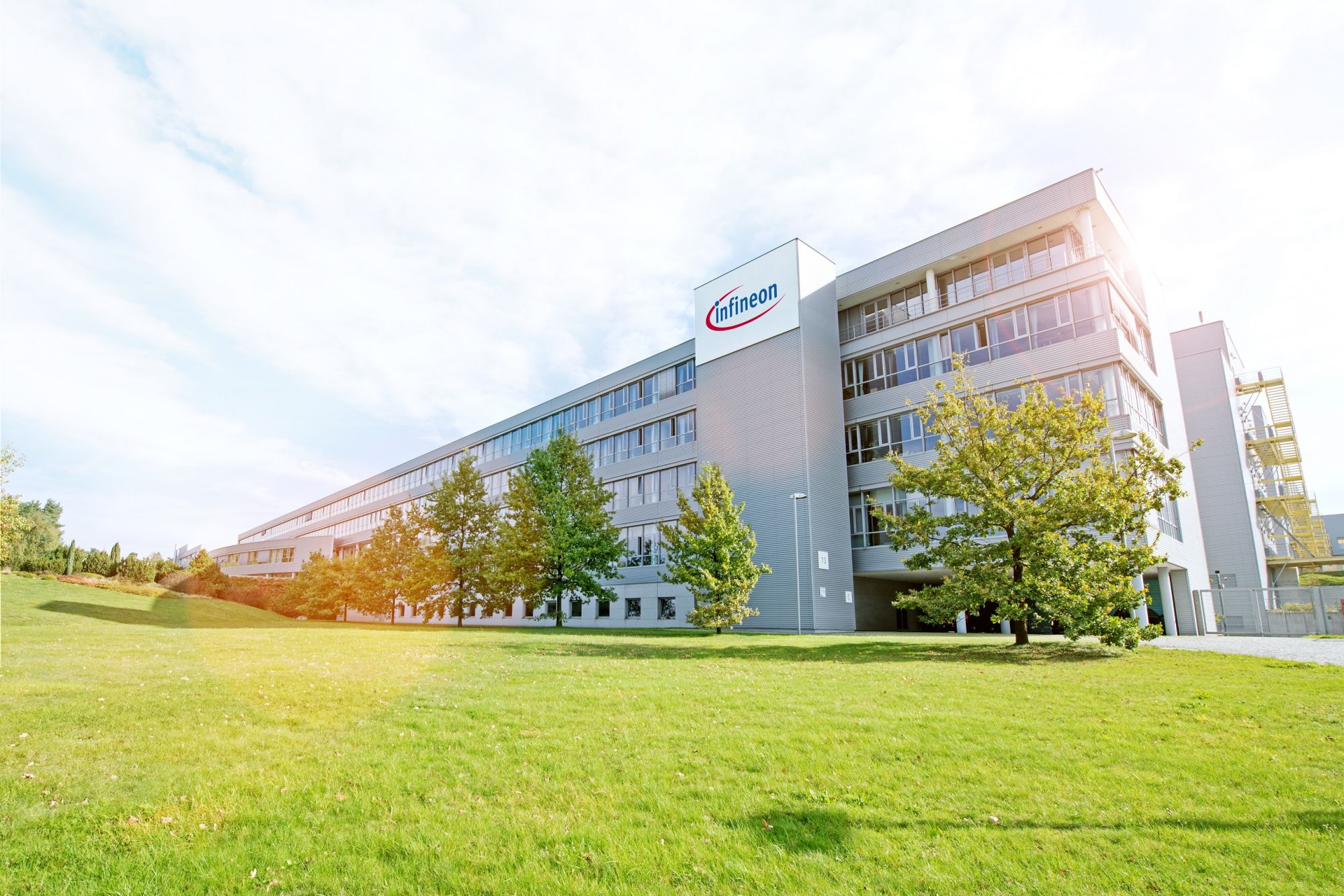
Sources:newelectronics
lynnli
/include/upload/kind/image/20230227/20230227161308_4331.jpg
Infineon Technologies has created an easy-to-use LCC design tool to make what is a highly efficient but complex design topology such as power factor correction (PFC) plus LLC accessible to a much broader range of LED driver manufacturers.
2023/2/27 16:14:36
2023/2/27 16:14:36
135
0
274
6
‘Get in the boat and row’, Commerce Sec tells US chip industry
By 2030 the US will set up ‘at least’ two semiconductor clusters to produce advanced ICs, said US Commerce Secretary Gina Raimondo (pictured) last week, when outlining plans for spending the $250 billion of Chips and Science Act money.
“Each cluster will include a robust supplier ecosystem, R&D facilities to continuously innovate new process technologies, and specialised infrastructure,” said Raimondo.
‘At least’ two large-scale logic fabs and multiple high-volume advanced packaging facilities will be built by 2030, said Raimondo, and $11 billion will go into setting up The National Semiconductor Technology Center.
“The vision for it is an ambitious public-private partnership where government, industry, customers, suppliers, educational institutions, entrepreneurs, and investors converge to innovate, connect, and solve problems,” said Raimondo, which will actually comprise several locations around the country aimed at “solving the most impactful, relevant and universal R&D challenges in the industry,” she added.
“Most importantly, the NSTC is going to ensure the U.S. leads the way in the next generation of semiconductor technologies—everything from quantum computing, materials science, and AI to the future applications we haven’t even thought of yet,” said Raimondo.
‘The NSTC is going to make it easier and less expensive for new and disruptive entrants to get into the market,” said Raimondo, ‘and, if we do this right, by the end of the decade, we’ll cut in half the projected cost of moving a new chip from concept to commercialisation.”
“This is fundamentally a national security issue,” said Raimondo, “CHIPS is about gaining a technological edge, export controls are about keeping it.”
Raimondo called on semiconductor companies to work with high schools and community colleges to train 100,000 new technicians over the next decade through apprenticeships, career and technical education, and career pathway programs.
“If we don’t invest in America’s manufacturing workforce, it doesn’t matter how much we spend, we will not succeed,” said Raimondo, “if we get this right, the U.S. semiconductor workforce will be the gold standard for other industries to follow.”
Raimondo called on the US chip industry to invest ‘at least’ another $500 billion on top of the Chips Act money.
“I want the United States to be the only country in the world where every company capable of producing leading-edge chips will have a significant R&D and high-volume manufacturing presence,” said Raimondo, “I am here to issue a call to the private sector to get in the boat and row with us. We must produce chips right here in America. It is America’s obligation to lead. We must push like no time before.”
lynnli
/include/upload/kind/image/20230227/20230227160539_8416.jpg
By 2030 the US will set up ‘at least’ two semiconductor clusters to produce advanced ICs, said US Commerce Secretary Gina Raimondo (pictured) last week, when outlining plans for spending the $250 billion of Chips and Science Act money.
2023/2/27 16:05:59
2023/2/27 16:05:59
152
0
273
6
ADI and Marvell Showcase Next-Generation 5G Massive MIMO Radio Unit Platform at Mobile World Congress 2023
The combination of ADI’s latest RadioVerse Transceiver SoC and the ?Marvell OCTEON 10 Fusion?? 5G baseband processor – the industry’s first 5 nm digital beamforming solution for 5G, improves the time-to-market for advanced mMIMO radio units and O-RAN support with up to 40% lower energy consumption, smaller size, and lower weight. The OCTEON 10 Fusion baseband processor also provides flexible L1 implementation, with hardware and software reuse across the RU (Radio Unit) and DU (Distributed Unit) to facilitate evolving L1 splits among operators worldwide over the coming years, while the RadioVerse SoC provides extensive digital RF front end capabilities including field proven DPD.
“As mMIMO radio functionality grows in complexity, more specialized silicon approaches are required,” said Alex Jinsung Choi, Chairman of the O-RAN ALLIANCE. “Reference designs like the one created by ADI and Marvell help catalyze the O-RAN market for 5G mMIMO radio units by enabling advanced configurations that meet network operators’ high expectations for power efficiency and performance.”

Together, the RadioVerse Transceiver SoC and the OCTEON 10 Fusion processor support the entire signal chain with unmatched RU system efficiency. The ADRV9040 RadioVerse Transceiver SoC includes substantial digital capabilities including linearization algorithms for boosting power amplifier efficiency and performance, as well as digital channel filters which reduce interface rates. The OCTEON 10 Fusion 5G baseband processor has specialized accelerators optimized for efficiently processing complex beamforming algorithms, along with dedicated processors for the low PHY baseband which can be configured for the various O-RAN split 7.2x configurations.
“Infrastructure vendors face many challenges when developing O-RAN mMIMO radio units, including access to optimized semiconductors,” said Joe Barry, Vice President of Marketing, Systems & Technology in the Communication and Cloud Business Unit at ADI. “The performance and efficiency of this platform makes industry-leading technology available to both established and emerging vendors.”
“Marvell is pleased to collaborate with ADI in taking mMIMO radios to the next level,” said Will Chu, Senior Vice President, Processors Business Group at Marvell. “The combination of Marvell’s OCTEON 10 Fusion 5G baseband processor and ADI’s leading RF transceiver technology provides OEMs a 5G Open Radio Unit reference design that scales the capabilities and performance of next-generation mMIMO beamforming at the lowest possible power.”
The reference design, which is expandable to support a 64T64R configuration, supports 32 transmit and receive antennas (32T32R) with 400 MHz of operational bandwidth and 300 MHz of instantaneous bandwidth. The OCTEON 10 Fusion 5G baseband processor and RadioVerse SoC leverage hardware accelerators as well as the industry-leading RF and digital baseband process nodes shipping commercially—16 nm and 5 nm respectively—delivering up to 40% reduction in energy consumption per bit as compared over the previous generation. The platform enables Network Energy Savings (NES) modes, which deliver additional power savings.
The platform is on display at Mobile World Congress within ADI’s booth (Hall 2, 2B18) and Marvell’s booth (Hall 2, 2F34).
Source:Analog Devices
wanda
/include/upload/kind/image/20230224/20230224164546_0614.jpg
The combination of ADI’s latest RadioVerse Transceiver SoC and the ®Marvell OCTEON 10 Fusion®® 5G baseband processor – the industry’s first 5 nm digital beamforming solution for 5G, improves the time-to-market for advanced mMIMO radio units a
2023/2/24 16:45:51
2023/2/24 16:45:51
496
0
272
6
Supplyframe Commodity IQ Reveals New Signs of Semiconductor and Electronic Components Price Stability and Improved Availability
Supplyframe today announced that its latest Commodity IQ insights reveal positive signs for a normalized supply-demand balance and reduced pricing and availability challenges as we advance into the new year. Excluding memory devices, 85% of semiconductor pricing dimensions will be stable and the remainder will move squarely in favor of buyers for the second half of 2023. But Supplyframe Commodity IQ indicates that extended lead times for semiconductors, including programmable logic devices and passive components like automotive-specific resistors, will continue into the second half of the year.
“New Commodity IQ insights, the resilience of world economies to inflation and threats of recession, and China’s reopening economy in the second half suggest there is reason to be optimistic. Commodity IQ indicates that component availability has improved in large part, and prices across many commodities and sub commodities have stabilized,” said Supplyframe CEO and founder Steve Flagg. “But electronic component lead times remain longer than historical norms. Component lead times are improving faster than prices as demand in some markets deteriorates. And in this age of macroeconomic uncertainty, where it is becoming increasingly difficult to forecast demand amid mixed end-market signals, further intensification of the Russia-Ukraine war, continuing COVID-19 challenges in China or any number of other disruptions could emerge.”
Supplyframe Commodity IQ is a transformed approach to electronics supply chain sourcing and analysis that provides unique, predictive, and prescriptive intelligence for electronic components, systems, and associated commodities based on operational analytics. This always-on software-as-a-service solution from Supplyframe pairs expert analysis and context with global electronics design, demand, pricing, lead time, and inventory indices to help companies connect the dots.
For the first quarter of 2023, Commodity IQ forecasts indicate the market will experience an 8% decline in the number of rising lead times and commodities with part allocations for active and passive components. According to the Commodity IQ Price Index for Q1, the number of component pricing dimensions will decrease by 14%. And global electronic component demand and sourcing activities quarter-on-quarter in the first quarter of this year are expected to be down by 2%, while engineering design will be off by 20% – further evidence of demand erosion.
While there are bloated inventories for components like memory and small case-size ceramic capacitors, automotive-grade microcontrollers and FPGAs remain far below the Commodity IQ Inventory Index baseline. And analog integrated circuits (ICs), microcontrollers, and discrete ICs (especially power MOSFETs) will remain constrained and costly in the first quarter and beyond.
In the third quarter of 2023, lead times for all electronic components will ebb dramatically as compared to the third quarter of 2022. Commodity IQ projects that nearly 60% of lead time dimensions will decrease in the third quarter versus 1% in the third quarter of 2022, with none expected to increase in the third quarter compared to a massive 73% in the same quarter of 2022. But Commodity IQ expects extended lead times to endure into the second half for semiconductors, including programmable logic devices and passive components like automotive-specific resistors.
Despite inventory reductions that will likely be complete by the end of the first half, IC orders, wafer starts, and capacity utilization will begin to rise and memory pricing will reach its bottom in the second half of this year. The company forecasts that DRAM prices will commence recovery in the third quarter and NAND pricing will follow in the fourth quarter or early in 2024.
“Commodity IQ data clearly indicate that certain aspects of the electronic component arena are headed for greater stability, but the fact remains that disruption is the new normal throughout the world,” said Flagg. “Sanctions between China and the U.S., among others, and the trends toward friendshoring, nearshoring, onshoring, and reshoring are changing the game. Shifts to more mature semiconductor process nodes could benefit Chinese players and industries that lack restrictions on the Chinese content of manufactured items. Supply chain complexity is increasing, with shorter product and demand cycles. And while some financial leaders are indicating the U.S. could avert a recession altogether, that could result in the return of electronic component constraints should we see, for example, a resurgence in electric vehicle demand.”
“Buy-side and sell-side organizations in the electronics component supply chain can use the power of intelligence to better position themselves in this complex, uncertain world,” said Richard Barnett, chief marketing officer and SaaS sales leader at Supplyframe. “They can use such intelligence to build resilience into their products and better understand and act to address current and future demand. As Commodity IQ indicates, there are many opportunities for enhanced supplier negotiations, better-timed sourcing events, and 360-degree supply chain visibility.”
Source:semiconductor digest

wanda
/include/upload/kind/image/20230223/20230223175235_1119.jpg
Supplyframe today announced that its latest Commodity IQ insights reveal positive signs for a normalized supply-demand balance and reduced pricing and availability challenges as we advance into the new year. Excluding memory devices, 85% of semicon
2023/2/23 17:54:59
2023/2/23 17:54:59
124
0
271
6
Fujitsu, Nvidia bring out vRAN system
Fujitsu will start offering the new solution to customers including telecommunications carriers globally in March 2023.
The new solution was developed as part of the “5G Open RAN Ecosystem” (OREC) project promoted by NTT DOCOMO which also supported performance verification and evaluation tests of the new solution.
The solution applies NVIDIA’s GPU processing engine “NVIDIA A100X” to the physical layer processing at the base station.
In this way, the new solution enables parallel processing of virtualized base stations and edge applications on GPU hardware resources in an all-in-one configuration that allows each function to be built on the same server.
This enables telecommunication carriers to build a flexible open network with a simple device configuration that can be ramped up with a variety of functions.
The solution further offers improved radio unit (RU) capacity and processing power, provides a high-quality communications environment, and is able to handle high-load data processing along with future improvements in antenna technologies.
Source:Electronics Weekly.com

wanda
/include/upload/kind/image/20230221/20230221174310_2150.jpg
Fujitsu will start offering the new solution to customers including telecommunications carriers globally in March 2023.
The new solution was developed as part of the “5G Open RAN Ecosystem” (OREC) project promoted by NTT DOCOMO which
2023/2/21 17:45:13
2023/2/21 17:45:13
134
0
270
6
U.S. Department of Commerce Announces CHIPS for America Leaders and Staff
The U.S. Department of Commerce today announced leaders and staff joining the CHIPS for America team who will play key roles implementing the bipartisan CHIPS and Science Act’s historic investments in the semiconductor industry. The CHIPS for America team pulls together talent from across the public and private sectors, including leaders with experience managing large federal programs, experts from the semiconductor industry, and executives with financial sector experience. These individuals will serve in the CHIPS Program Office, which is housed within the Department of Commerce’s National Institute of Standards and Technology (NIST).
“We are building a team of experienced experts who will ensure CHIPS for America spurs manufacturing and innovation and revitalizes our domestic semiconductor industry, while being good stewards of taxpayer dollars,” said Secretary of Commerce Gina M. Raimondo. “This group of accomplished leaders brings the diversity of experience, ideas, and backgrounds needed to secure our position as the global leader in semiconductor manufacturing and R&D for decades to come.”
“CHIPS for America will put our country at the forefront of semiconductor innovation, R&D, and technology implementation, and we are excited to welcome these accomplished individuals to DOC and NIST,” said Under Secretary of Commerce for Standards and Technology and NIST Director Laurie E. Locascio. “These leaders have decades of experiences across government, industry, and the R&D space and will play an essential role standing up this historic program.”
The new CHIPS for America staff sitting in the CHIPS Program Office are:
Rebecca Callahan, Director of Legislative Affairs
Morgan Dwyer, Chief Strategy Officer
Adrienne Elrod, Director of External and Government Affairs
Todd Fisher, Chief Investment Officer
Matt Hill, Communications Director
Dan Kim, Chief Economist and Director of Strategic Planning and Industry Analysis
Brad Koenig, Senior Relationship Director
Andy Kuritzkes, Chief Risk Officer
Atissa Ladjevardian, Chief of Staff for External and Government Affairs
Nikita Lalwani, Senior Advisor to the Director
Sara Meyers, Chief Operating Officer & Chief of Staff
Mike O’Brien, Senior Relationship Director
Sara O’Rourke, Head of Operations and Chief of Staff to the Chief Investment Officer
Kylie Patterson, Senior Advisor for Opportunity and Inclusion
Fayrouz Saad, Director of Public Engagement
The Biden-Harris administration previously announced key leaders charged with guiding implementation of the CHIPS and Science Act, including Director of the CHIPS Program Office Mike Schmidt and Interim Director of the CHIPS Research and Development Office Eric Lin. Both offices are housed within NIST at the U.S. Department of Commerce.
Source:SEMICONDUCTORS

wanda
/include/upload/kind/image/20230220/20230220174212_8825.jpg
The U.S. Department of Commerce today announced leaders and staff joining the CHIPS for America team who will play key roles implementing the bipartisan CHIPS and Science Act’s historic investments in the semiconductor industry. The CHIPS for Amer
2023/2/20 17:50:01
2023/2/20 17:50:01
120
0
269
6
Texas Instruments selects Lehi, Utah, for its next 300-millimeter semiconductor wafer fab
DALLAS and SALT LAKE CITY, Feb. 15, 2023 /PRNewswire/ -- Texas Instruments Incorporated (TI) (Nasdaq: TXN) today announced plans to build its next 300-millimeter semiconductor wafer fabrication plant (or fab) in Lehi, Utah. The new fab will be located next to the company's existing 300-mm semiconductor wafer fab in Lehi, LFAB. Once completed, TI's two Lehi fabs will operate as a single fab.
"This new fab is part of our long-term, 300-mm manufacturing roadmap to build the capacity our customers will need for decades to come," said Haviv Ilan, TI executive vice president and chief operating officer, and incoming president and chief executive officer. "Our decision to build a second fab in Lehi underscores our commitment to Utah and is a testament to the talented team there who will lay the groundwork for another important chapter in TI's future. With the anticipated growth of semiconductors in electronics, particularly in industrial and automotive, and the passage of the CHIPS and Science Act, there is no better time to further invest in our internal manufacturing capacity."
The landmark $11 billion investment marks the largest economic investment in Utah history. The Lehi expansion will create approximately 800 additional TI jobs as well as thousands of indirect jobs. TI looks forward to strengthening its partnership with the Alpine School District and will invest $9 million to improve student opportunities and outcomes.
"Companies like Texas Instruments continue to invest in Utah because of our world-class business climate and exceptional workforce," said Utah Gov. Spencer Cox. "TI's new semiconductor fab will solidify Utah as a global semiconductor manufacturing hub for generations to come."
Lehi is an ideal location because of its access to skilled talent, robust existing infrastructure and strong network of community partners. The new fab will manufacture tens of millions of analog and embedded processing chips daily that will go into electronics everywhere.
The fab will be designed to meet one of the Leadership in Energy and Environmental Design (LEED) building rating system's highest levels of structural efficiency and sustainability: LEED Gold. Plans include recycling water at nearly double the rate of the existing Lehi fab. Advanced 300-mm equipment and processes in Lehi will further reduce waste, water and energy consumption per chip.
Construction of the new fab is expected to begin in the second half of 2023, with production as early as 2026. The cost of the new fab is comprehended in TI's previously announced capital spending plan to expand manufacturing capacity and will complement TI's existing 300-mm fabs, which include DMOS6 (Dallas), RFAB1 and RFAB2 (both in Richardson, Texas), and LFAB (Lehi, Utah). TI is also building four new 300-mm wafer fabs in Sherman, Texas.
Source:CISION

wanda
/include/upload/kind/image/20230216/20230216171818_0091.jpg
DALLAS and SALT LAKE CITY, Feb. 15, 2023 /PRNewswire/ -- Texas Instruments Incorporated (TI) (Nasdaq: TXN) today announced plans to build its next 300-millimeter semiconductor wafer fabrication plant (or fab) in Lehi, Utah. The new fab will be loca
2023/2/16 17:22:44
2023/2/16 17:22:44
118
0
268
6
Renesas Automotive IPD Touts 40% Smaller Footprint
Renesas Electronics Corp. has launched a new automotive Intelligent Power Device (IPD) that will safely and flexibly control power distribution within vehicles, addressing the requirements of next-generation E/E (electrical/electronic) architectures.
The new RAJ2810024H12HPD is available in the small TO-252-7 package and reduces the mounting area by about 40% compared to the conventional TO-263 package product. In addition, the advanced current detection function of the new device allows highly accurate detection of abnormal currents such as overcurrent.
Since the new IPD detects abnormal currents even at low loads, it allows engineers to design highly safe and precise power control systems that can detect even the smallest abnormalities.
The new IPD was developed to address the growing requirements as E/E architectures continue to evolve. In a conventional distributed E/E architecture, power supply from the battery is distributed to each Electronic Control Unit (ECU) via long, thick wires from a power box consisting of mechanical relays and fuses. IPDs have a longer life and are maintenance-free compared to mechanical relays, so they can be placed anywhere in the vehicle.
As the automotive industry moves toward centralized or zone-oriented E/E architectures, IPDs are becoming an ideal choice for building efficient and flexible power supply networks since they use shorter, thinner wires. Renesas’ IPD in particular provides a more efficient, safer and smaller solution for power distribution control.
Source:EE Times

wanda
/include/upload/kind/image/20230215/20230215172623_3589.jpg
Renesas Electronics Corp. has launched a new automotive Intelligent Power Device (IPD) that will safely and flexibly control power distribution within vehicles, addressing the requirements of next-generation E/E (electrical/electronic) architecture
2023/2/15 17:27:31
2023/2/15 17:27:31
113
0
267
6
Qualcomm Introduces the World’s First 5G NR-Light Modem-RF System to Fuel a New Wave of 5G Devices
Qualcomm Technologies, Inc. today announced Snapdragon? X35 5G Modem-RF System, the world’s first 5G NR-Light modem-RF system. NR-Light, a new class of 5G, fills the gap in between high-speed mobile broadband devices and extremely low-bandwidth NB-IoT devices. NR-Light devices, powered by Snapdragon X35, can be smaller, more cost-efficient, and provide longer battery life than traditional mobile broadband devices.
With its optimized design and breakthrough performance, Snapdragon X35 offers a device platform that bridges the complexity and capability gap between the extremes in 5G today and addresses the need for mid-tier use cases. This lower cost option provides device makers with a long-term migration path to replace LTE CAT4+ devices, ultimately increasing 5G adoption and allowing for faster transition to a unified 5G network.
In addition to Snapdragon X35, Qualcomm Technologies also announced Snapdragon? X32 5G Modem-RF System, a modem-to-antenna solution built to lower complexity and fuel cost-efficient NR-Light devices.
“Snapdragon X35 brings together key 5G breakthroughs expected from the world’s leading wireless innovator,” said Durga Malladi, senior vice president and general manager, cellular modems and infrastructure, Qualcomm Technologies, Inc. “The world’s first 5G NR-Light modem features a cost-effective, streamlined design with leading power efficiency, optimized thermal, and reduced footprint. Snapdragon X35 is poised to power the next wave of connected intelligent edge devices and empower a wide spectrum of uses. We look forward to working with industry leaders to unleash what’s possible with a unified 5G platform.”

Key innovations in the Snapdragon X35 5G Modem-RF System include:
World’s first 5G NR-Light modem-RF with a new streamlined architecture
Snapdragon X35, a 3GPP Release 17 RedCap modem with optimized RFIC and PMIC modules, offers OEMs new 5G capabilities to create next-generation devices for a new era of use cases. The flexible, streamlined architecture and high-level modem-RF integration deliver superior power and thermal efficiency while enabling a small form factor design tailored to fit in compact devices.
Expansion of 5G ecosystem to new wave of use cases
Snapdragon X35 brings a unique mix of capabilities in data rates, power consumption, complexity, and reduced footprint needed to cost-effectively enable new use cases such as entry-level industrial IoT devices, mass tier fixed wireless access consumer premise equipment, mass tier connected PCs, and first generation 5G consumer IoT devices like direct-to-cloud glasses and premium wearables.
With support for both LTE and 5G NR-Light, Snapdragon X35 is backwards compatible and future-proof enabling OEMs to develop devices which coexist with a wide range of 4G and 5G device classes helping scale 5G NR-Light services.
Breakthrough performance with advanced Modem-RF feature set
Snapdragon X35 is equipped with advanced modem-RF technologies aimed to significantly reduce power consumption, enhance 5G coverage, lower latency, increase battery life, and improve uplink speeds:
– Qualcomm? QET5100 Envelope Tracking
– Qualcomm? Smart Transmit? Technology
– Qualcomm? 5G Ultra-Low Latency Suite
– Qualcomm? 5G PowerSave Gen 4
In addition, Snapdragon X35 supports dual-frequency GNSS (L1+L5) to offer precise positioning suited to enable new industrial use cases and applications. With its global RF-band support, Snapdragon X35 supports all spectrum bands within Sub-6GHz, FDD, and TDD, to satisfy the needs of various markets.
These innovations and other improvements in Snapdragon X35 are designed to power a new generation of use cases and applications from entry-level to premium.
Customer sampling of Snapdragon X35 and X32 are expected to begin in the first half of 2023 and commercial mobile devices are expected to be launched by the first half of 2024. For additional details, please visit the Snapdragon X35 webpage.
wanda
/include/upload/kind/image/20230209/20230209175456_5473.png
Qualcomm Technologies, Inc. today announced Snapdragon® X35 5G Modem-RF System, the world’s first 5G NR-Light modem-RF system. NR-Light, a new class of 5G, fills the gap in between high-speed mobile broadband devices and extremely low-bandwidth N
2023/2/9 17:54:57
2023/2/9 17:54:57
444
0
266
6
Infineon leads EU PowerizeD special project to advance the development of new generation power electronics
According to foreign media reports, representatives from 62 European regional cooperation agencies recently announced at Infineon's headquarters the launch of PowerizeD, a pan-European R&D special project that aims to raise the sustainability and resilience of the European energy chain from generation to application to a new level and strengthen Europe's technological sovereignty through electronic and electronic technology innovation.
The project will focus on 17 demonstration application scenarios in the energy and mobility sector, including electrified railroads, car charging systems, liquid batteries and more, the report said. Partners will use an interdisciplinary approach with topics including modeling and digital twins, federal learning, and reliability and sustainability. Immediate project goals include: reducing losses in power conversion by 25%; extending device and system lifetime by 30%; reducing chip size by at least 10%; and reducing development time by 50%.
Technically, PowerizeD aims to improve the mechanical and electrical integration of control, drive and switching functions in power components and to advance the optimization of the integration of all power switching functions. New switching topologies and advanced control strategies involving artificial intelligence applications will further improve efficient, robust and reliable operation.
Of the total €72 million project, the EU will provide approximately €18 million in funding. The project will run for three years and is expected to be completed in December 2025.
source:aijiwei

wanda
/include/upload/kind/image/20230208/20230208172655_3023.jpg
According to foreign media reports, representatives from 62 European regional cooperation agencies recently announced at Infineon's headquarters the launch of PowerizeD, a pan-European R&D special project that aims to raise the sustainability a
2023/2/8 17:27:29
2023/2/8 17:27:29
128
0
265
6
Storage industry continues to slump! Western Digital announces its first NAND flash production reduction
Amid the downturn in the storage industry, Western Digital announced further reductions in equipment investment and production.
Western Digital said during its fourth-quarter 2022 earnings call that annual equipment investments will total $2.3 billion in fiscal 2023, according to Korean media outlet Business Korea. The figure represents a 14.8 percent decline from the $2.7 billion disclosed during the third-quarter earnings call in October 2022. It is a 28.12 percent decrease from the $3.2 billion announced in August 2022.
In addition, Western Digital said it will reduce NAND flash wafer production to 30 percent of current levels, the first time Western Digital has announced a production reduction.
It is reported that Western Digital has a 12.6% share of the global NAND flash memory market, ranking fourth after Samsung Electronics, Armor Man and SK Hynix. In addition to Western Digital, major memory manufacturers such as SK Hynix, Micron and Armor Man have also cut production and investment.
source:aijiwei

wanda
/include/upload/kind/image/20230207/20230207174357_7097.jpg
Amid the downturn in the storage industry, Western Digital announced further reductions in equipment investment and production.
Western Digital said during its fourth-quarter 2022 earnings call that annual equipment investments will to
2023/2/7 17:44:29
2023/2/7 17:44:29
145
0
264
6
Infineon: Expects automotive MCU shortage to ease in second half of the year
Infineon recently said at its earnings meeting that it expects the shortage of automotive MCUs to ease in the second half of 2023.
Infineon reiterated the divergence in the semiconductor market, with demand for semiconductors remaining strong in the automotive, renewable energy and security sectors, but a cyclical slowdown in demand for consumer products and weak corporate spending on IT infrastructure, according to Taiwan's Electronic Times.
According to Infineon, as electric vehicles and ADAS continue to evolve, customers are now more willing to sign capacity reservation agreements or place longer term commitment orders to secure semiconductor supply. OEMs now have a "strong tendency" to source strategic components directly and seek higher inventory levels.
To meet such demand, the company is increasing its production rate to nearly 1 million pieces per day. 2023 fiscal year, automotive products have been fully booked capacity.
Infineon reported revenues of 3,951 million euros in the fourth quarter of 2022 (first quarter of fiscal 2023), down 5 percent from the previous quarter, and net income of 1,107 million euros, up about 4.6 percent from the previous quarter.
Source:aijiwei

wanda
/include/upload/kind/image/20230206/20230206172322_3004.jpg
Infineon recently said at its earnings meeting that it expects the shortage of automotive MCUs to ease in the second half of 2023.
Infineon reiterated the divergence in the semiconductor market, with demand for semiconductors remaining
2023/2/6 17:23:59
2023/2/6 17:23:59
147
0
263
6
Intel dumps previous-generation processors, cutting prices by up to 20 percent
According to Digitimes, Intel is negotiating with a number of PC suppliers and expects to do a price cut of up to 20 percent on 12th generation Core (Alder Lake) processors.
Intel's 13-generation Core K-series and non-K-series desktop processors are both on sale, while 12-generation Core models are also on sale at the same time. Price reduction products, the previous generation i9 processor price reduction is the largest, the price difference of up to 70 ~ 80 U.S. dollars, a reduction of about 20%; followed by the i7 processor, a price reduction of 40 ~ 50 U.S. dollars. To mainstream i5 models, for example, i5-12400F in the domestic Jingdong self-owned price of 1189 yuan; the latest 13-generation Core models, Jingdong self-owned price of 1599 yuan.
In fact, at the end of 2022, HP, Acer and other PC manufacturers revealed that inventory clearance is nearing its end. But now, Acer said that the PC has been saturated, the resources previously invested by the industry should belong to more than, the PC industry to the process to actively transform. The market is saturated and still needs time to digest, so this does not mean that replenishment momentum will emerge.
AMD CEO Zifeng Su also revealed today at the earnings meeting, "We do think the first quarter is the bottom of our PC market."
PC shipments have fallen sharply. Research firm Gartner said PC shipments fell 28.5 percent in the final quarter of last year, the biggest drop since the company began tracking the market in the 1990s.
source:aijwei

wanda
/include/upload/kind/image/20230202/20230202174004_0186.jpg
According to Digitimes, Intel is negotiating with a number of PC suppliers and expects to do a price cut of up to 20 percent on 12th generation Core (Alder Lake) processors.
Intel's 13-generation Core K-series and non-K-series desktop
2023/2/2 17:40:34
2023/2/2 17:40:34
218
0
262
6
Inventory can supply three to four months of demand, the world's major storage plants in 2023 or loss of up to $ 5 billion
According to the news, the storage industry is experiencing severe challenges, chip oversupply, customers were forced to cut orders, as well as product prices plummeted. According to Bloomberg reports, the total loss of the world's major storage chip makers this year, the largest ever, will be as high as $ 5 billion.
The industry believes that manufacturers, including Samsung, SK Hynix, Micron, South Asia and other manufacturers are difficult to avoid the pressure of huge losses.
Bloomberg reported that storage vendors said less than a year ago that tighter management and products would have new markets, including 5G technology and cloud-based services, which would ensure that companies reach more predictable surpluses.
However, Tiburon Consulting senior research director Arden Wu noted that "the chip industry thought suppliers would have better control, and this downturn proves everyone wrong."
Tibco expects DRAM price declines to narrow to an estimated 13% to 18% this quarter, but it is not yet possible to see the end of the industry's boom down cycle.
According to a report in Taiwan's Economic Daily, China's largest DRAM maker Nanya Technology also believes that the global economy is still shrouded in the impact of high inflation, interest rate hikes and other variables, keeping the DRAM industry under pressure this year.
Nanya's general manager, Pei-Ying Lee, also admitted that the overall DRAM industry is facing greater pressure this year than last year, but fortunately, the two largest manufacturers have already taken action to reduce production and cut capital expenditures. NAN YATCO's capital expenditures this year will continue to be conservative and are expected to drop to NT$18.5 billion for the year, with equipment investments reduced by as much as 50%.
Micron has also reacted positively to the plunge in demand, announcing at the end of last month that in addition to production cuts, it will also scale back budgets for new plants and equipment. In addition, SK Hynix has also cut investment and scaled back production.
According to the report, in the broader environment, consumers and businesses face inflation and interest rate hikes, postponing purchases of computers, tablets and smartphones, manufacturers of these devices are big buyers of memory chips, and there is no need to make more purchases when inventory components cannot be cleared.
Industry inventories have more than tripled to an unprecedented high water level, enough to supply three to four months of demand. Samsung and its competitors are losing money on every chip produced, Bloomberg estimates that all major memory chip factory operating losses this year, fearing the largest ever, will reach $ 5 billion.
source:aijiwei

wanda
/include/upload/kind/image/20230201/20230201172939_7408.png
According to the news, the storage industry is experiencing severe challenges, chip oversupply, customers were forced to cut orders, as well as product prices plummeted. According to Bloomberg reports, the total loss of the world's major storage ch
2023/2/1 17:30:12
2023/2/1 17:30:12
230
0
261
6
Infineon signs long-term supply agreement with Resonac for continued expansion of silicon carbide capacity
Infineon has announced a multi-year supply and cooperation agreement with Resonac (formerly Showa Denko) to complement and extend their agreement through 2021 in order to continue to expand its silicon carbide (SiC) production capacity. The new agreement will deepen their long-term cooperation in the supply of SiC materials, with Resonac supplying a double-digit share of Infineon's estimated demand for SiC wafers over the next 10 years.
Peter Wawer, president of Infineon's Industrial Power Control business unit, said that there will be huge business opportunities in the coming years in the areas of renewable energy generation, energy storage, electric mobility and infrastructure equipment. Infineon is doubling its investment in its silicon carbide technology and product portfolio, and the partnership with Resonac will provide a strong boost to Infineon.
Resonac will initially supply 6" SiC wafers and will transition to 8" SiC wafers during the contract period, and Infineon will provide Resonac's IP on SiC material technology; the partnership will contribute to supply chain stability and the rapid growth of the emerging semiconductor material SiC.
Infineon is now actively expanding its SiC device production capacity in order to reach its target of 30% market share by 2030. Infineon's SiC production capacity is expected to grow tenfold by 2027, and a new plant in Kulim, Malaysia, is scheduled to start up in 2024.
Angelique van der Burg, Infineon's Chief Procurement Officer, emphasized that demand for SiC is growing rapidly, so Infineon is expanding our capacity significantly to prepare for such growth and has therefore decided to deepen its collaboration with Resonac and strengthen their partnership.
According to the information, Resonac is an 84-year-old chemical giant (formerly Showa Denko), a leader in the market for key semiconductor packaging materials such as laminates, photographic films and SiC epitaxial wafers, and aims to increase the proportion of chip materials revenue to 45% of overall sales by 2030, up from 31% in 2021.
Resonac plans to increase production of SiC epitaxial wafers to 50,000 wafers per month (converted to 6" wafers) by 2026, an increase to approximately five times the current capacity. Mass production of 8-inch silicon carbide substrates will also begin by 2025, enabling more semiconductor chips to be cut, with a concomitant increase in production efficiency.
source:xinzhixun

wanda
/include/upload/kind/image/20230131/20230131172453_9950.jpg
Infineon has announced a multi-year supply and cooperation agreement with Resonac (formerly Showa Denko) to complement and extend their agreement through 2021 in order to continue to expand its silicon carbide (SiC) production capacity. The new agr
2023/1/31 17:25:19
2023/1/31 17:25:19
311
0
260
6
Storage industry's historic collapse hits memory companies
The memory chip industry, known for its boom-and-bust cycles, has changed its ways, according to Bloomberg. "Tighter management and new markets for products, namely 5G technology and cloud services, will ensure that companies achieve more predictable earnings," the memory company made such a statement less than a year after the $160 billion industry was suffering one of its worst setbacks ever: a glut of chips in inventory, customers cutting orders and product prices plummeted.
The unprecedented crisis has not only depleted industry leaders SK Hynix and Micron Technology, but has also shaken up those companies' suppliers, weakened Asian economies that rely on technology exports and forced a handful of remaining memory makers to form alliances or even form coalitions to consider mergers, according to the report.
Samsung Electronics and its competitors are losing money on every chip they produce. Their collective operating loss this year is expected to reach a record $5 billion. Inventories have more than tripled to a record three to four months of supply.
Still, Samsung is the only memory company that is generally unaffected, thanks to its large and diversified business, but its semiconductor division is also headed for a loss. On Tuesday, Samsung will report its fourth-quarter earnings, followed by a conference call in which analysts may question its capacity management plans.
Micron, a U.S. memory chip maker, said late last month that it would cut budgets for new plants and equipment in addition to cutting production. CEO Sanjay Mehrotra said the pace of the industry itself will depend on how quickly the company's peers take similar action.
In addition, SK Hynix has cut investments and scaled back production. The company's excess inventory is partly due to its acquisition of Intel Corp.'s flash memory business - a deal that was struck before the industry's downturn.
The memory industry has seen mergers and acquisitions during all downturns, and this one is no exception. Talks of a deal between NAND maker Western Digital and Armor Man are progressing, people familiar with the matter said this month.
source:aijiwei

wanda
/include/upload/kind/image/20230130/20230130171550_4174.jpg
The memory chip industry, known for its boom-and-bust cycles, has changed its ways, according to Bloomberg. "Tighter management and new markets for products, namely 5G technology and cloud services, will ensure that companies achieve more predictab
2023/1/30 17:17:00
2023/1/30 17:17:00
299
0
259
6
ADI to spend $1 billion to upgrade Oregon semiconductor plant
ADI is spending $1 billion to upgrade its semiconductor facility near Beaverton, Oregon, which will double production capacity, according to the news.
We are making a significant investment to modernize our existing manufacturing space, reassemble equipment to increase productivity, and expand our overall infrastructure by adding 25,000 square feet of additional cleanroom space," said Fred Bailey, ADI vice president of plant operations, according to oregonlive. "
ADI is said to produce high-end analog chips that can be used for heat management and thermal control, targeting markets such as industrial and automotive, which can avoid the impact to some extent in the current weak market demand for consumer electronics end markets.
The company beat estimates with sales of $3.25 billion and net income of $936 million for the quarter ended Oct. 29, 2022. Sales revenue increased 38.8 percent from a year ago and 4.5 percent from the previous quarter. For the full fiscal year, ADI Semiconductor achieved sales of $12 billion, an increase of 64 percent over the previous fiscal year, reflecting the rapid growth in sales resulting from ADI Semiconductor's acquisition of MMS.
source:aijiwei

wanda
/include/upload/kind/image/20230117/20230117172741_7164.jpg
ADI is spending $1 billion to upgrade its semiconductor facility near Beaverton, Oregon, which will double production capacity, according to the news.
We are making a significant investment to modernize our existing manufacturing space
2023/1/17 17:28:05
2023/1/17 17:28:05
275
0
258
6
Semiconductor oversupply to be resolved after fall 2023
The oversupply of semiconductors is continuing for a long time. In addition to consumer-oriented electronics such as smartphones and personal computers, data center investments by IT giants are slowing down. Demand, centered on cutting-edge semiconductors, is declining. It is expected that the balance between supply and demand will not be achieved until after the fall of 2023. However, demand for semiconductors in fields such as pure electric vehicles (EVs), where demand is growing, continues to outstrip supply, and supply constraints persist.
Due to the sharp decline in demand for smartphones and other effects, memory for data storage, etc. has rapidly turned into excess supply since the second half of 2022. Semiconductors for smartphones and personal computers turn to oversupply as of July to September 2022. Despite the gradual progress in the suppression of semiconductor supply and inventory digestion, the restoration of the balance of supply and demand for semiconductors for smartphones is expected to wait until October to December 2023, and for semiconductors for personal computers until July to September 2023. IT giants in China and the U.S. are reducing investment due to slowing advertising revenues and other impacts, and demand for data center-oriented semiconductors is slowing. It is expected to tend to oversupply by January to March 2023.
In contrast, demand for automotive and industrial-oriented semiconductors continues to outstrip supply. Although the number of parts available with shorter lead times is increasing, CoreStaff, a semiconductor trading company, said, "If one type of semiconductor and electronic parts cannot be procured, they cannot be produced, and other parts have to be turned into inventory. Centering on the semiconductor parts with old production technology, it is still difficult to procure sufficient quantities.
Especially for automotive semiconductors, the supply shortage is expected to be maintained in 2023. In addition to automakers regaining production, the increase in semiconductor usage per vehicle is also pushing up demand. Against the backdrop of increasing demand for automotive semiconductors, power semiconductors for current control and analog semiconductors for power management, etc. are "less investment in equipment, and it may be difficult to increase supply rapidly. Both will maintain a shortage of supply in 2023.
Toyota and Honda were affected by the shortage of semiconductors, and production in December was lower than previously planned, while some plants, including domestic plants, will adjust their operating rates in January 2023.
Thanks to the support of national and regional governments, new plants of Intel and TSMC will come into operation in 2024 in the United States. Micron Technology and others have also announced large-scale investment plans. While betting on long-term demand growth is indispensable for investment, capacity will increase rapidly. If capacity increases faster than demand recovers, there is a risk of further oversupply centered on cutting-edge products.
source:Japan News

wanda
/include/upload/kind/image/20230112/20230112173052_1091.jpg
The oversupply of semiconductors is continuing for a long time. In addition to consumer-oriented electronics such as smartphones and personal computers, data center investments by IT giants are slowing down. Demand, centered on cutting-edge semicon
2023/1/12 17:33:12
2023/1/12 17:33:12
324
0
257
6
Infineon announces sale of part of its DC-DC converter business
Infineon today announced that it has reached a definitive agreement on the sale of Infineon's HiRel DC-DC converter business, including its hybrid and custom on-board power products, to Micross, according to marketwatch. The transaction is expected to be completed in the first quarter of this year.
Infineon officials said the sale will enable Infineon to expand its focus and investment in core semiconductor development for the high-reliability market, while de-emphasizing the need to provide more custom products for the high-reliability industry in the business.
The HiRel DC-DC converter business is understood to be a solution for high-reliability DC-DC power conversion for the harshest environments, including outer space, and will operate under the Micross Hi-Rel Products business unit, including main power converters, control circuits, filters and enclosures.
In December last year, Infineon announced that it was working to optimize DC-DC designs and that the company would be rolling out a new generation of DC-DC power solutions to help customers build low-energy, high-performance data centers.
source:aijiwei

wanda
/include/upload/kind/image/20230111/20230111164939_3908.jpg
Infineon today announced that it has reached a definitive agreement on the sale of Infineon's HiRel DC-DC converter business, including its hybrid and custom on-board power products, to Micross, according to marketwatch. The transaction is expected
2023/1/11 16:50:05
2023/1/11 16:50:05
244
0
256
6
Agency: Inflation overlaid with sluggish demand, automotive display shipments will only increase slightly in 2022
According to DIGITIMES Research's forecast, automotive display shipments will only increase slightly year-over-year to 189.2 million units in 2022 due to factors such as the Russia-Ukraine war and the Fed's interest rate hike leading to inflation overlaid with sluggish demand.
The agency predicts that by the end of 2023, shipments of displays for automotive applications, including rearview mirrors, flat-screen displays (HUDs), instrument panels and central controls, are expected to exceed 200 million pieces, reaching 209.4 million pieces, and will grow at a 6.2% CAGR to 255.5 million pieces by 2027, according to the Taiwanese media "Electronic Times".
From a technology perspective, more than 80% of automotive displays will be made of amorphous silicon (a-Si) TFT LCD in 2022, and the share of LTPS TFT LCD will increase from 16% in 2022 to about 26% in 2027. In addition, the mass production of Micro LED for automotive displays will be postponed to 2027 from the previously expected 2025, and the shipment of Micro LED automotive displays is expected to reach 20,000 pieces by the end of 2027.
Previously, market research firm Omdia said the geographic distribution of the automotive display supply chain for mainland China will mainly supply LCD, while Japan and South Korea will supply low-temperature polysilicon LCD and OLED. Taiwan will be the main supply of MiniLED and MicroLED.
source:aijiwei

wanda
/include/upload/kind/image/20230110/20230110171026_2161.jpg
According to DIGITIMES Research's forecast, automotive display shipments will only increase slightly year-over-year to 189.2 million units in 2022 due to factors such as the Russia-Ukraine war and the Fed's interest rate hike leading to inflation o
2023/1/10 17:10:53
2023/1/10 17:10:53
269
0
255
6
Agency: IDM capacity release, the first half of 2023 PMIC market overall under pressure
Research institute TrendForce recently predicted that with the release of new production capacity of TI, the global power management chip production capacity will increase by 4.7% in the first half of 2023, while demand is still affected by the off-season preparation, consumer electronics demand is weak and other factors, most segments will continue to bring down the price pressure, is expected to continue to drop 5-10% in the first half of the offer, while the performance of automotive products will remain Stable.
The agency further analyzed that the current power management chip market IDM still dominates the global shipment market size, IDM industry combined market share of 63%, of which TI and accounted for 22% market share to become the leading manufacturers. In 2022, IDM manufacturers due to the impact of inflation and price increases, further boosting ASP, but Fabless manufacturers have been the first to show weakness.
TrendForce said that the power management chips used in products including notebooks, tablets, TVs, smartphones, etc. have started to drop in price since the third quarter of 2022, with a quarterly decline of 3-10%, and demand in the network communications and industrial sectors has also loosened by the fourth quarter. At present, only a few industrial (defense) and automotive demand remains stable, orders are scheduled until the second quarter of 2023, the pressure to reduce prices is not great, but because of this type of high-end products more than 83% of the market in the hands of large IDM manufacturers, Fabless manufacturers are trying to cut into the product sample testing in the ongoing.
According to the agency's survey, the current average delivery time of power management chip Fabless manufacturers for 12 to 28 weeks, and even some models of products such as panel power management chip because of the inventory backlog, as long as the order can be shipped immediately; and IDM large manufacturers are still generally longer delivery time, non-vehicle delivery time of 20 to 40 weeks, while the vehicle delivery time is more than 32 weeks, there are also a few manufacturing, assembly and inspection process is more cumbersome products are still in the state of allocation.
source:aijiwei

wanda
/include/upload/kind/image/20230109/20230109173344_3334.jpg
Research institute TrendForce recently predicted that with the release of new production capacity of TI, the global power management chip production capacity will increase by 4.7% in the first half of 2023, while demand is still affected by the off
2023/1/9 17:34:11
2023/1/9 17:34:11
378
0
254
6
Memory Chip Makers Expect Losses to Widen in First Quarter of 2023
Memory chip makers, including major memory chip makers, are set to report operating losses in the fourth quarter of 2022, with their losses set to widen in the first quarter of 2023 as chip prices continue to fall, Digitimes reported.
Micron Technology fell into the red in its first fiscal quarter ended Dec. 1, 2022, and has warned of a bigger loss in the following second quarter of fiscal 2023.
Other memory chip makers are also expected to post losses in the fourth quarter of 2022, the sources said. Samsung Electronics also struggled to keep its chip business profitable in the current quarter, the sources said.
Nevertheless, the sources noted that mainstream 8Gb DDR4 prices were flat in December, which may indicate that chip suppliers intend to stop prices from falling further. Average DDR4 contract prices remained in the high single digits this month.
Average server memory contract prices slipped about 5 percent in December due to high inventory held by OEMs, the sources said. Prices will remain under pressure in the first quarter of 2023, the sources said. And suppliers such as Meta and Google have put data center expansion plans on hold, leaving uncertainty about the growth prospects for the server memory market in 2023.
source:aijiwei

wanda
/include/upload/kind/image/20230105/20230105170856_1030.jpg
Memory chip makers, including major memory chip makers, are set to report operating losses in the fourth quarter of 2022, with their losses set to widen in the first quarter of 2023 as chip prices continue to fall, Digitimes reported.
2023/1/5 17:09:29
2023/1/5 17:09:29
263
0
253
6
Agency: 2023 memory chip market remains sluggish, equipment order demand continues to decline
According to Taiwan's Economic Daily News, research firm TechInsights recently released an analysis of the 2023 semiconductor-related market situation after acquiring ICinsight, saying that the semiconductor market began a new year in 2023, with the downturn in memory market conditions continuing to affect related manufacturers' capital expenditure reductions and expansion plans slowing down.
TechInsights said that from the semiconductor market situation, the market for memory chips continues to be sluggish, which also makes the demand for memory chip equipment orders continue to decline, hitting a new record since September 2019, and many manufacturers are struggling to cope with weak demand and serious inventory problems.
In addition, DRAM and NAND price performance indices continue to fall, while MPUs are flat, but inventory and turnover ratios continue to be too high.
IT Home has learned that TrendForce indicated last month that Client SSD demand will slow down significantly in the future, which in turn will limit the overall NAND Flash demand bit growth, with the annual growth rate expected to be less than 30% from 2022-2025.
source:aijiwei

wanda
/include/upload/kind/image/20230104/20230104174225_9029.jpg
According to Taiwan's Economic Daily News, research firm TechInsights recently released an analysis of the 2023 semiconductor-related market situation after acquiring ICinsight, saying that the semiconductor market began a new year in 2023, with th
2023/1/4 17:42:50
2023/1/4 17:42:50
278
0
252
6
Slow inventory de-stocking, MOSFET market conditions in the first half of the grim
January 3, 2023 news, PC, consumer electronics market in the fourth quarter of 2022 demand continues to be weak, and the client market strategy in the first quarter of this year still tends to be conservative, making MOSFET inventory de-stocking rate will be more slowly than originally expected. The supply chain expects that the worst-case scenario may continue into the third quarter of this year before the inventory de-stocking phase may gradually end. MOSFET manufacturer operations are expected to remain flat until the middle of this year.
PC, consumer electronics market conditions in the second half of 2022 by the boom winter, and until the end of 2022 have failed to effectively de-inventory, making the MOSFET market inventory de-inventory slow. The supply chain pointed out that the previous foundry capacity is tight, the client repeated orders in the second half of 2022 fully emerged, even if the MOSFET factory has significantly reduced the amount of investment, but the previous order to invest in wafers still need to continue to deliver in accordance with the contract.
In the cast continued output, coupled with the slowdown in the client's pull rate, the supply chain that the current MOSFET factory inventory levels are generally more than six months level, coupled with the channel and the terminal is still digesting the hands of MOSFET inventory, making the first half of 2023 MOSFET market conditions are quite severe.
Road business pointed out that the current IDM low-voltage MOSFET delivery period has been more than half a year from the original, down to about 5-6 months level, compared to the previous situation has been much more relaxed, and because the IDM low-voltage MOSFETs mainly attack industrial control, automotive and other high-end market, in industrial control, automotive demand is still in the growth period, the supply of MOSFETs have been relatively Slowdown, making the PC, consumer and other relatively weak growth momentum of the MOSFET market is even weaker.
The industry believes that the MOSFET market in the first half of 2023 may still remain in the off-season state, and the follow-up as foundry capacity continues to soothe, MOSFETs are likely to face price pressure, MOSFET factory operations in the first half of the year is still more challenging.
Mainly for PC, consumer and other MOSFET manufacturers, operations may remain flat to mid-2023, must wait for the second half of the semiconductor demand rebound, and in the third quarter to end inventory de-stocking, before the business opportunities are expected to grab.
source:xinzhixun

wanda
/include/upload/kind/image/20230103/20230103172213_7987.jpg
January 3, 2023 news, PC, consumer electronics market in the fourth quarter of 2022 demand continues to be weak, and the client market strategy in the first quarter of this year still tends to be conservative, making MOSFET inventory de-stocking ra
2023/1/3 17:22:45
2023/1/3 17:22:45
293
0
251
6
Qualcomm is rumored to reduce the price of cell phone SoC next year
Qualcomm may reduce the price of its mid-range and entry-level Snapdragon mobile processors, including the 400 and 600 series, in 2023, according to industry sources.
The sources said the short-term purpose of the price cut is most likely to reduce inventory, however, industry insiders are concerned that it could be the start of a price war for mid-range and entry-level cell phone SoCs, according to Taiwanese media outlet Electronic Times.
"Whether Qualcomm's move will trigger a price war is unclear. In any case, slowing demand in mid-range and entry-level handset markets and general price sensitivity increase the likelihood that future handset brands will push Qualcomm and MediaTek to cut prices." The source said.
Market research firm Strategy Analytics released a report showing that global smartphone shipments will decline 10 percent year-over-year in 2022. The downward trajectory will continue through 2023, but the annual growth rate will improve to -5%. Global smartphone shipments will reach their lowest level since 2014. This is a very tough time for the industry as a whole.
In addition, Bank of America also conservatively look at the smartphone industry, the agency believes that the industry chain is undergoing end-product destocking, smartphone inventory days will climb to the top in Q1 to Q2 next year, reaching 3.2 months, and may continue to Q3, maintaining a level of 3.1 months, the relevant supply chain will be difficult to get rid of operational pressure in the first half of next year.
source:aijiwei

wanda
/include/upload/kind/image/20221229/20221229174311_8982.jpg
Qualcomm may reduce the price of its mid-range and entry-level Snapdragon mobile processors, including the 400 and 600 series, in 2023, according to industry sources.
The sources said the short-term purpose of the price cut is most lik
2022/12/29 17:43:39
2022/12/29 17:43:39
243
0
250
6
TSMC is rumored to have won a large order for Tesla's advanced chips
According to the Economic Daily News, the market rumors that TSMC won the Tesla advanced chip bill, and Tesla became the first three customers of the new U.S. plant, for the sluggish semiconductor market injection of living water, TSMC market value back to 12 trillion New Taiwan dollars mark.
The news said, "In addition to customers such as Volkswagen, General Motors, Toyota, etc., the industry has recently become more prevalent rumors that TSMC kicked out Samsung Electronics and took Tesla's advanced chip bill, and decided to cast the new U.S. 4-nanometer plant in 2024 mass production, Tesla became the first three customers of the new plant."
Previously there were rumors that Tesla has placed a large order with TSMC to manufacture its next-generation fully automated driving (FSD) chips. The chips will be manufactured on the 4/5nm node and are expected to be used in Tesla's Hardware 4 (HW 4.0) computer.
Tesla reportedly began producing its own self-driving chips in 2016, with its first-generation FSD chips entering mass production in 2019, using Samsung's 14nm process in Austin, Texas. Previously, it was widely expected that Tesla would continue to work with Samsung and manufacture its second-generation FSD chips on the latter's 7nm node.
source:aijiwei

wanda
/include/upload/kind/image/20221222/20221222170339_7988.jpg
According to the Economic Daily News, the market rumors that TSMC won the Tesla advanced chip bill, and Tesla became the first three customers of the new U.S. plant, for the sluggish semiconductor market injection of living water, TSMC market value
2022/12/22 17:04:06
2022/12/22 17:04:06
297
0
249
6
Agency: Q3 PC shipments fall 22% to 12.8 million units
Shipments of laptops, desktops and workstations in Western Europe fell 22 percent year-on-year to 12.8 million units in the third quarter of 2022, Canalys data showed on Dec. 20.
Of these, laptops underperformed due to slowing demand in the consumer market and education sector, with shipments down 25% year-over-year to 10.4 million units. Desktops performed relatively well, down just 6 percent, due to continued purchases by large enterprises. Although the third quarter ushered in the back-to-school season, there was not much demand for replacement in the education sector, with tablet shipments reaching 6 million units, down 13 percent year-over-year and flat year-over-year.
The agency sees PC demand in Western Europe accelerating in the third quarter. The commercial market, which was previously strong, is now declining, as is the consumer market. As a result of the macroeconomic impact, cash flow has shrunk and interest rates have risen, making financing more expensive, so small and medium-sized businesses have cut back sharply on PC purchases, more than large enterprises.
Canalys expects: "The second half of next year will see some growth. At least a small percentage of people will update the devices they bought at the beginning of the new epidemic, but most will not do so until 2024. From the fourth quarter of next year through 2026, we expect the overall market to return to normal seasonal purchasing patterns and for overall demand to stabilize at a new normal level that is about 25% above the pre-New Crown epidemic average. Positive trends in consumer device usage and hybrid work mean that the outlook for PC and tablet development is more positive in the longer term."
source:aijiweiAPP

wanda
/include/upload/kind/image/20221220/20221220172606_8156.jpg
Shipments of laptops, desktops and workstations in Western Europe fell 22 percent year-on-year to 12.8 million units in the third quarter of 2022, Canalys data showed on Dec. 20.
Of these, laptops underperformed due to slowing demand i
2022/12/20 17:26:34
2022/12/20 17:26:34
294
0
248
6
Industry: DRAM memory demand to pick up in Q2 next year
DRAM memory demand is expected to pick up in the second quarter of 2023, while NAND flash demand is unlikely to see a recovery in the second half of the year, according to memory module company Ten Ambrose Technology.
Ten Ambrose Technology said DRAM prices have fallen by nearly half since 2022, and the decline is expected to slow, according to Taiwanese media outlet Electronic Times. As more chipmakers cut production, the DRAM market's supply-demand balance is expected to recover in the first quarter of 2023, and the recovery in DRAM prices will precede that of NAND flash prices.
Overall DRAM demand is reportedly low this year, with analysis by semiconductor data consultancy IC Insights pointing out that weak economic conditions and high inflation have slowed global demand for personal computers, mainstream smartphones and other consumer electronics. As a result, DRAM demand is spiraling downward, with sales now expected to fall 40 percent to $29.3 billion in the second half of 2022, compared to $49 billion in the first half of 2022. The DRAM market is expected to decline by 18 percent for the full year 2022.
source:aijiwei

wanda
/include/upload/kind/image/20221219/20221219174033_2963.jpg
DRAM memory demand is expected to pick up in the second quarter of 2023, while NAND flash demand is unlikely to see a recovery in the second half of the year, according to memory module company Ten Ambrose Technology.
Ten Ambrose Techn
2022/12/19 17:41:13
2022/12/19 17:41:13
293
0
247
6
Marvell's product price increase of 10% is rumored to take effect on Jan. 1 next year
According to a recent industry outflow of Marvell's price increase letter, the company will increase the price of its products by 10% effective January 1, 2023, according to Science and Technology Daily.
Marvell noted that while supply chain dynamics remain challenging and unpredictable, we have seen some improvements, reducing lead times to 26 weeks for most products starting in December 2022. The 16-week lead time for Fibre Channel HBAs will not change. In addition, due to increased costs and additional fees on the vendor side, the company will increase the price of its products by 10% effective January 1, 2023.
However, Marvell did not specify the relevant products and models, nor did it make clear whether the price increase was for the entire line.
Marvell, founded in 1995 and headquartered in Silicon Valley with R&D centers in Shanghai, Nanjing, Chengdu and Beijing, China, is a leading global semiconductor vendor providing a full suite of broadband communications and storage solutions for the high-speed, high-density, digital data storage and broadband digital data networking markets, engaging in the design, development and delivery of mixed-signal and digital signal processing integrated circuits. The company is a global leader in the design, development and supply of mixed-signal and digital signal processing integrated circuits for the high-speed, high-density, digital data storage and broadband digital data networking markets.
At the end of October, Marvell China was rumored to be laying off a large number of employees, and Marvell insiders confirmed the news to Tibco. The sources said that Marvell's China layoffs involve all departments and will give the laid-off employees a two-month buffer period, with compensation rumored to be N+3.
source:aijiwei

wanda
/include/upload/kind/image/20221216/20221216170138_3145.jpg
According to a recent industry outflow of Marvell's price increase letter, the company will increase the price of its products by 10% effective January 1, 2023, according to Science and Technology Daily.
Marvell noted that while supply
2022/12/16 17:02:05
2022/12/16 17:02:05
291
0
246
6
Samsung Q3 DRAM sales fell 34.2%
According to Yonhap News Agency, Samsung's dynamic random access memory (DRAM) sales fell 34.2% in the third quarter of this year from a year earlier against the backdrop of a cold market for memory chips due to the global economic downturn.
Market research agency Omdia data show that global DRAM sales in Q3 this year fell 29.8% from a year earlier to $17.548 billion. Analysts believe that the global economic recession has led to shrinking demand, combined with customer adjustments to inventory and falling prices, the semiconductor storage market has entered a full-scale winter.
Specifically, Samsung Q3 DRAM sales fell 34.2% to $7.133 billion, SK Hynix was $5.246 billion, down 25.3%, and Micron sales fell 26.3% to $4.35 billion.
According to a previous report released by Eugene Investment & Securities with little difference from Omdia, shows Q3 global DRAM market sales of $17.973 billion, down 29.3% from Q2's $25.427 billion. Samsung's Q3 market share fell to 41.0%, a record low in eight years.
source:aijiwei

wanda
/include/upload/kind/image/20221215/20221215173856_8761.jpg
According to Yonhap News Agency, Samsung's dynamic random access memory (DRAM) sales fell 34.2% in the third quarter of this year from a year earlier against the backdrop of a cold market for memory chips due to the global economic downturn.
2022/12/15 17:39:17
2022/12/15 17:39:17
273
0
245
6
Agency: Semiconductor materials market expected to grow 8% to $66 billion in 2022, but may decline next year
On December 14, according to VantageHub, strong demand in the semiconductor materials market, coupled with strong sales of CMP abrasive pads, special gases and other materials, research TECHCET expects the market size to exceed $66 billion this year, up 8% from last year. Looking ahead to next year, due to the global economy faces many challenges, sales may recession.
The survey said that this year, grinding pads, special gases, precursor materials, SOI wafers and other market growth is strong, all double-digit growth over last year, next year by the overall economic uncertainty, the semiconductor industry revenue is expected to decline, including storage equipment manufacturers revenue decline is greater.
Research pointed out that the semiconductor materials market revenue is relatively flat this year, but sales will decline compared to this year, is expected to decline next year wafer crop rate, including storage crop rate decline, will make the former body, special gases, cleaning with chemical sales affected.
However, the advanced process semiconductor materials next year is still more than 5% growth than this year. Overall, despite the recessionary concerns, but in the United States under the chip bill to promote the second half of next year, there will be more money betting on the semiconductor market, driving the materials market back to the growth track in the third quarter of next year.
source:aijiwei

wanda
/include/upload/kind/image/20221214/20221214172747_6562.jpg
On December 14, according to VantageHub, strong demand in the semiconductor materials market, coupled with strong sales of CMP abrasive pads, special gases and other materials, research TECHCET expects the market size to exceed $66 billion this yea
2022/12/14 17:28:22
2022/12/14 17:28:22
368
0
244
6
Intel B760 motherboard pricing will be higher than the B660 series, roughly 10% higher
Intel has now released the 13th generation Core desktop processors with "K" and "KF" suffixes, as well as the Z790 chipset. Its positioning is relatively high-end, mainly for overclockers and gaming enthusiasts. Previously it was reported that Intel plans to launch more Raptor Lake processors and H770/B760 chipsets on January 3, 2023, mainly for mainstream gamers and general user products, closer to the needs of the general user community.
BoBoard Hall said that the brand manufacturers of B760 motherboard will probably reach the channel at the end of the month, in accordance with Intel's new pricing, this new motherboard compared to the previous generation of B660 series products is about 10% higher, depending on the specific product to its cost. According to the motherboard manufacturers previously exposed Intel's 13th generation Core desktop processor lineup, there will be a total of 22 models, there are 16 models yet to be released.
It is worth noting that the Core i5-13400 and Core i5-13400F may exist in two versions of the chip, B-0 and C-0, with B-0 being Raptor Lake and C-0 being Alder Lake, and there may be some differences, while Intel is not ruled out from releasing a product like the Core i5-12490F in some regions to provide a version. In addition, the 13th generation Core desktop processors will also be compatible with the original Z690, H670, B660 and H610 motherboards.
source:chaonengwang

wanda
/include/upload/kind/image/20221213/20221213171837_7192.jpeg
Intel has now released the 13th generation Core desktop processors with "K" and "KF" suffixes, as well as the Z790 chipset. Its positioning is relatively high-end, mainly for overclockers and gaming enthusiasts. Previously it was reported that Inte
2022/12/13 17:19:03
2022/12/13 17:19:03
296
0
243
6
Spain to focus on producing mid-range semiconductors after failed bid to make chips for domestic auto industry
Spain will focus on producing less advanced semiconductors used in domestic industry after its ambition to make cutting-edge microchips has so far failed to attract investment, according to people familiar with the government's plans, Bloomberg reported.
The Spanish prime minister is focusing Spain's 12.3 billion euro ($12.9 billion) plan on mid-range semiconductors after losing bids for production facilities to Germany and the United States this year, said the person familiar with the matter, who requested anonymity because the strategy was not made public.
"Spain has not changed its position. From the beginning, the top priority of our strategy has been to attract companies that can design or produce microchips, and part of the value chain," a statement from the prime minister's press office said.
Spain has now scaled back its desire to produce the most technologically advanced chips and is adjusting its plans to take advantage of growing global demand for 10- to 28-nanometer chips that could supply Spain's automotive industry.
When Spain first announced its strategic plan, funded by EU recovery funds, more than half of the budget was earmarked to subsidize chips smaller than 5nm. These top-of-the-line semiconductors will require facilities costing tens of billions of dollars to develop.
Even before the plan was officially announced, Spanish officials considered changing their strategy after U.S. tech giant Intel Corp. chose Germany to build a 17 billion euro European complex in March, according to people familiar with the matter. Then, a major U.S. manufacturer pulled out of advanced negotiations for an investment deal in Spain after the Biden administration announced $50 billion in subsidies for chipmakers.
"We will subsidize chip manufacturing in Spain, which may be thinner or more mature, based on innovation and in line with the EU chip bill," the press office statement said. "We have a clear strategy, but we will adjust as the market evolves."
This coincides with a shift in European policy, after the European Commission earlier this year proposed a Chip Bill that would allow subsidies for the production of "first-of-a-kind" semiconductors.
Countries with large automotive industries, including France, have pushed to subsidize the less advanced chips needed for car production, arguing that if the EU wants to achieve its 20 percent target, it can't just focus on cutting-edge chips.
EU countries last week adopted their own version of the chip bill, and slightly expanded the scope of subsidies.
source:aijiwei

wanda
/include/upload/kind/image/20221212/20221212172009_7443.jpg
Spain will focus on producing less advanced semiconductors used in domestic industry after its ambition to make cutting-edge microchips has so far failed to attract investment, according to people familiar with the government's plans, Bloomberg rep
2022/12/12 17:20:40
2022/12/12 17:20:40
449
0
242
6
Supply shortage, price hike for photomask film used in chip production
As China continues to emerge fabless chip design startups, resulting in a short supply of photomask shields (pellicle) for wafer fabrication Arf and Krf lithography processes, prices are rising.
Photomask film used to protect the photomask, according to Korean media The Elec reported that South Korea's only photomask film manufacturer FST mask export revenue ratio this year is expected to increase from 30% last year to 40% this year.
Earlier this year, 3M, an upstream raw material supplier, had to close its plant in Belgium to comply with local environmental protection laws, and higher raw material prices have led to higher photomask shroud prices.
In addition, several photomask film manufacturers are also developing new films for advanced process nodes such as EUV, resulting in an overall decline in production.
source:aijiwei

wanda
/include/upload/kind/image/20221208/20221208165726_7208.png
As China continues to emerge fabless chip design startups, resulting in a short supply of photomask shields (pellicle) for wafer fabrication Arf and Krf lithography processes, prices are rising.
Photomask film used to protect the photo
2022/12/8 16:58:01
2022/12/8 16:58:01
293
0
241
6
Automotive chip supply likely to remain short until 2024
Despite recent improvements, the automotive chip shortage is unlikely to be fully resolved until 2024, as supply growth cannot keep up with the rapid growth in demand, according to automotive supply chain sources, Digitimes reported.
In response to the ongoing chip crunch, some automakers have begun adjusting their 2023 vehicle designs so that chips with the same functionality can be sourced from more than two suppliers, or chips from the same supplier can accept different pins. In this way, they can respond more flexibly to shortages of automotive chips, mainly MCUs, MPUs and IGBT chips and modules, the sources said.
The shortage of some chips and components made it difficult to assemble as a whole in the short term, affecting the normal production of cars and instead leading to an increase in the inventory of other components instead of a shortage. This has led automotive customers to adjust their order schedules or slow down shipments from customers with sufficient supply, the sources continued.
Automotive semiconductors will continue to be supply-constrained due to two major factors. One is the limited growth in the supply of automotive chip process capacity. If the foundry's capacity has been validated by automotive customers, it will take at least six months to convert their process capabilities to manufacture automotive chips, and for process capabilities that have not yet been certified for automotive chip production, they will need to spend another 2-3 years to complete validation.
Another factor is the lack of transparency in the uneven supply of chips and components. Two years ago, some channel players tried to consolidate the uneven supply of components faced by supply chain participants to achieve the best ratio of overall supply, but did not succeed, the sources said. idm, tier-one suppliers and automakers usually treat which components are in short supply as confidential.
According to research firm Yole Development, the value of semiconductors used in vehicles is estimated to grow from $550 in 2021 to $912 by 2027, with the corresponding number increasing from 820 to 1,100 chips, due to the growing popularity of electric and self-driving cars.
source:aijiwei

wanda
/include/upload/kind/image/20221207/20221207172457_6447.jpg
Despite recent improvements, the automotive chip shortage is unlikely to be fully resolved until 2024, as supply growth cannot keep up with the rapid growth in demand, according to automotive supply chain sources, Digitimes reported.
I
2022/12/7 17:26:21
2022/12/7 17:26:21
336
0
240
6
Intel: customer inventory digestion is expected to continue until 2023
According to foreign media Seeking Alpha this 6th news, Intel CFO David Zinsner said at the UBS event, customers digesting inventory should not end at the end of this year, is likely to continue until 2023.
Zinsner also pointed out that the world is facing economic downturn. In view of this, Intel can not be clear that the semiconductor industry in 2023 Q1 there are signs of recovery. Intel is still dealing with customers to clean up inventory actions, perhaps not at the end of this year, will continue into next year, "coupled with the general headwinds in almost all regions, should not be better than the same period in the past".
Mizuho Securities technology analyst Jordan Klein believes that Zinsner's remarks may be a precautionary shot in advance, implying that Intel's 1Q next year may be about 5% lower than analysts' estimates, with gross margins and profits likely to be less than expected. He believes that Intel shares will encounter downside risk in the coming weeks.
It is reported that Intel announced its fiscal year 2022 third-quarter earnings in October, lowering its capital expenditure forecast for the fiscal year to $25 billion from the previous $27 billion and warning of job cuts.
source:aijiwei

wanda
/include/upload/kind/image/20221206/20221206171016_6354.jpg
According to foreign media Seeking Alpha this 6th news, Intel CFO David Zinsner said at the UBS event, customers digesting inventory should not end at the end of this year, is likely to continue until 2023.
Zinsner also pointed out tha
2022/12/6 17:10:44
2022/12/6 17:10:44
274
0
239
6
SSD prices continue to fall to new lows due to weak PC market
According to a recent report by Nikkei News, the impact of global inflation and other factors has led to a decrease in consumer purchasing power, sluggish demand in the PC market, and a drop in the price of core chip NAND Flash, making the price of SSDs for PCs continue to fall and reach new lows.
According to the report, the wholesale price (bulk price) of TLC 256GB, an SSD indicator product, was around $29.5 each during October-December 2022, down 6% (down $2) compared to the previous quarter (July-September), the fifth consecutive quarterly decline and the third consecutive quarter to set a new record low; a 21% decrease (down $8) compared to the same period last year.
Market research firm Gartner pointed out that the global PC shipments during July-September 2022 fell by 19.5% to 67.996 million units compared with the same period last year, the largest decline in history since the survey began in the mid-1990s, which is a historic slowdown for the PC market.
In addition to weak PC demand, falling NAND Flash prices are also the reason for the continued decline in SSD prices. The price of TLC 256Gb, an indicator NAND Flash product, will be around $2.40 per unit during October-December 2022, down 14% from the previous quarter (July-September).
The report points out that although entering the year-end season, but because of inflation pressures on household consumption, the market is generally expected this winter PC sales fear weak, and storage chip manufacturers began to NAND Flash production reduction measures, but it is estimated that the effect of production cuts will not begin to appear until after the spring of 2023, the current NAND Flash prices are afraid of continued decline, so SSD prices are also afraid of further The current NAND Flash prices are likely to continue to fall, so SSD prices are likely to go down further.
source:xinzhixun

wanda
/include/upload/kind/image/20221205/20221205172922_6180.png
According to a recent report by Nikkei News, the impact of global inflation and other factors has led to a decrease in consumer purchasing power, sluggish demand in the PC market, and a drop in the price of core chip NAND Flash, making the price of
2022/12/5 17:30:00
2022/12/5 17:30:00
304
0
238
6
Institutions: storage prices will plunge more than 50% next year
According to the Economic Times, Nomura, JP Morgan and other institutions warned that the storage industry will be more gloomy in the first half of next year, with prices set to plunge by more than 50%. Although storage manufacturers and channel operators to actively go to inventory, but the results will not gradually appear until Q1 next year. Among the various types of storage, coded flash storage (NOR Flash) related manufacturers will outperform pure DRAM manufacturers.
According to the news, JPMorgan Chase issued a report after visiting Nanya Technology, Lixin, Huabang, Macronix and other storage manufacturers in Taiwan, most of them expect demand will not rebound rapidly, but will recover gradually. Mainly due to the increase in supply chain inventories and the longer time required to consume inventories in the overall global economic downturn, it is estimated that the overall situation will not start to turn better until Q2 or the second half of next year. In addition, NOR Flash related vendors will outperform pure DRAM vendors due to strong demand for high density NOR chips in the automotive/industrial sector.
Affected by the global economic downturn and the new crown epidemic, foreign media reports expect the global semiconductor market to shrink by 4% to $557 billion in 2023, the first annual contraction since 2019. Another World Semiconductor Trade Statistics (WSTS) organization said the memory market, which accounts for more than one-fifth of the total, will decline by 17 percent.
source:aijiwei

wanda
/include/upload/kind/image/20221130/20221130172721_0948.jpg
According to the Economic Times, Nomura, JP Morgan and other institutions warned that the storage industry will be more gloomy in the first half of next year, with prices set to plunge by more than 50%. Although storage manufacturers and channel op
2022/11/30 17:27:44
2022/11/30 17:27:44
295
0
237
6
Customers have already placed orders! NVIDIA to export low-spec AI GPUs to China
NVIDIA has launched its A800 AI GPU, a downgraded version of its A100 and H100 series, to Chinese customers and already has orders in place, according to industry sources, Electronic Times reported.
The U.S. ban on high-end GPU exports to China is said to have affected NVIDIA's A100 and H100 AI chips exported to China, prompting it to launch the lower-spec A800 series to comply with new U.S. control regulations on Chinese exports of advanced chips. The new U.S. export control regulations limit the rate to 600 GB per second and above, and NVIDIA's A800 chips have a data transfer rate of 400 GB per second, down from 600 GB per second in the previous generation.
NVIDIA still needs to obtain a U.S. export license for its A800 series AI GPUs sold in China, the sources said, adding that the processor supplier should be able to start shipping chips to Chinese customers in a few months.
NVIDIA disclosed in early November that the A800 GPU, a replacement for the A100 model, went into production in the third quarter. It also said it met clear tests for the new U.S. regulatory rules.
Sources close to the matter said the 7nm A800 will still be manufactured and packaged by TSMC, with China's Taiwan-based Jinyuan Electronics in charge of test operations and IC test interface solutions to come from Chunghwa Precision Test Technology and Yingwei Technology. TSMC's 7nm capacity utilization has declined recently, and the launch of NVIDIA's A800 GPU may help boost TSMC's 7nm process capacity utilization.
source:aijiwei

wanda
/include/upload/kind/image/20221129/20221129173712_7455.jpg
NVIDIA has launched its A800 AI GPU, a downgraded version of its A100 and H100 series, to Chinese customers and already has orders in place, according to industry sources, Electronic Times reported.
The U.S. ban on high-end GPU exports
2022/11/29 17:37:37
2022/11/29 17:37:37
295
0
236
6
Poor market conditions, rumors that silicon wafer fabs agreed to delay customer shipments
According to the "Economic Daily News" reported that the logic IC de-stocking and storage manufacturers a large number of production cuts resulting in weakening demand for silicon wafers, silicon wafer fabs are rumored to have begun to agree with customers to delay the pull, the previous attitude of holding fast to the offer has also changed, some manufacturers loose mouth willing to cooperate with market conditions and customers to negotiate prices, said "I'm afraid the first half of next year will be a little tougher ".
The recession in the semiconductor industry in the foundry reflected in the capacity utilization rate decline, storage plants have been reducing capital expenditure and production cuts for the winter, IC design houses are actively de-stocking and reduce the amount of investment, even at the expense of paying a breach of contract to cancel the foundry long contract, but the previous performance of the silicon foundry is still relatively supportive, and now it is rumored that the silicon foundry agreed to delay the customer pull, highlighting that the market situation is even more critical.
It is understood that a few customers in Taiwan, China, silicon wafer factory agreed to delay shipments, the schedule delayed about one or two months; another silicon wafer factory is to negotiate with customers, from the first quarter of next year can be slightly delayed pull; a silicon wafer factory business said that the semiconductor market is really bad now, the inventory level of long-term contract customers has been increasing, the current silicon wafer shipping conditions actually do not match the actual market demand.
Previously rumored that TSMC to the supply chain cut orders, Global Crystal pointed out that "the order has a long contract protection and no customer default", is expected to 8-inch and 12-inch silicon wafer capacity utilization rate to maintain strong.
TSMC said that this year will still be full production and full sales, looking ahead to next year, customers continue to comply with the long-term contract, the company will cooperate with customers, flexible adjustment of product mix.
Wafer Works pointed out that the next negotiation with customers in the first half of next year prices will be adjusted according to market conditions.
source:aijiwei

wanda
/include/upload/kind/image/20221128/20221128165103_3650.jpg
According to the "Economic Daily News" reported that the logic IC de-stocking and storage manufacturers a large number of production cuts resulting in weakening demand for silicon wafers, silicon wafer fabs are rumored to have begun to agree with c
2022/11/28 16:51:24
2022/11/28 16:51:24
330
0
235
6
Rumor that the world advanced or will get power management IC transfer orders from mainland China
According to news, according to industry sources, China's Taiwan foundry World Advanced is in talks with Qualcomm, MPS, ADI and other potential customers for orders for power management ICs. These customers are looking to shift orders from their foundries in mainland China after the U.S. introduced a series of new export restrictions.
According to Taiwan's Electronic Times, the foundry's long-term growth prospects remain strong, despite short-term macro headwinds that pose a challenge to World Advanced's operations.
Earlier World Advanced Chairman and General Manager Fang Liao talked about the impact of U.S. export controls at a legal conference, and he believes that it currently appears to be in advanced processes and AI, HPC applications such as 16nm and even more advanced processes, so there is no negative impact on the company in the short term. At the same time, there are IDM companies in some cases to transfer part of the foundry to the world advanced, from the special process related to Power to mature processes have felt the relevant demand, so the overall opportunity outweighs the negative impact.
It is reported that the world advanced currently has five eight-inch fabs, located in Taiwan, China and Singapore. World Advanced continues to expand eight-inch wafer foundry capacity, with an average monthly capacity of about 241,000 8-inch wafers in 2021.
source:aijiwei

wanda
/include/upload/kind/image/20221124/20221124174022_0933.png
According to news, according to industry sources, China's Taiwan foundry World Advanced is in talks with Qualcomm, MPS, ADI and other potential customers for orders for power management ICs. These customers are looking to shift orders from their fo
2022/11/24 17:40:53
2022/11/24 17:40:53
369
0
234
6
TrendForce: Original factory price reduction for sales hit Q3 NAND Flash industry revenue, down as much as 24.3%
TrendForce reports that the third quarter NAND Flash market is still defeating the impact of weak demand, with shipments in both consumer electronics and servers falling short of expectations, leading to an 18.3% drop in NAND Flash prices in the third quarter.
According to the report, vendor bit shipments decreased by 6.7% YoY in Q3, and the average unit sales price continued to fall, resulting in overall NAND Flash industry revenue of approximately $13.71 billion (approximately RMB 97.889 billion), a 24.3% YoY decline.
IT Home learned that TrendForce said that the most obvious changes in the NAND Flash revenue ranking in the third quarter were in two areas, firstly, SK Group's revenue dropped the most by 29.8% year-over-year to $2.54 billion (about RMB 18.136 billion), relegating it to the third place. This is mainly due to the weak demand for PCs and smartphones, while the relatively robust demand for servers also impacted Solidigm's sales performance as companies cut back on spending and entered the inventory adjustment cycle, resulting in an 11.1% decline in bit shipments and a sharp drop of more than 20% in average unit sales price.
Secondly, Armor Man has gradually gotten rid of the impact of raw material pollution at the beginning of the year, and its revenue and market share have returned to the second place. Despite the sluggish consumer demand, the average unit price declined sharply, but bit shipments benefited from the seasonal pull of smartphone customers to support the third quarter revenue growth of 23.5% YoY to $2.83 billion (about 20.206 billion yuan), revenue fell by only 0.1% YoY.
As for other manufacturers, Samsung, Western Digital and Micron all faced volume and price declines, with revenue down by a similar margin, with sluggish terminal demand being one of the main factors dragging down revenue performance.
The company's revenue is expected to drop to 20-25% in the fourth quarter, and the revenue is expected to drop by nearly 20% from the previous quarter.
source:ITzhijia

wanda
/include/upload/kind/image/20221123/20221123165522_8267.jpg
TrendForce reports that the third quarter NAND Flash market is still defeating the impact of weak demand, with shipments in both consumer electronics and servers falling short of expectations, leading to an 18.3% drop in NAND Flash prices in the th
2022/11/23 16:55:52
2022/11/23 16:55:52
350
0
232
6
IC Insights: Global DRAM Market Expected to Decline 18 Percent by 2022
According to the news, the DRAM market usually sells strongly in the second half of the year as system manufacturers order memory chips for the next generation of products they plan to release during the year-end holidays. But that hasn't been the case this year.
Weak economic conditions and high inflation have slowed global demand for personal computers, mainstream smartphones and other consumer electronics, according to analysis by IC Insights, a semiconductor data consultancy. As a result, DRAM demand is spiraling downward, with sales now expected to fall 40 percent to $29.3 billion in the second half of 2022, compared with $49 billion in the first half of 2022. The DRAM market is expected to decline by 18 percent for the full year 2022.
The DRAM market saw strong sales in the first few months of the year, although the first signs of a DRAM market correction began to appear in late 2Q22. Micron, for example, reported an 11 percent increase in sales for its fiscal 3Q22 (ending in May). But then the company guided for -17% sales for its fiscal Q4 (ending August). Micron's actual sales for the fourth quarter of 2022 were down 23 percent, well above its expectations. Later this year, Micron also said it expects its annual DRAM bit volume to decline by 1%, further evidence that the DRAM market is in a rapid and severe downturn.
SK Hynix and Samsung also announced sharp declines in their memory sales for the third quarter of 2022, and both expect the DRAM market weakness to continue through the end of this year and into at least the first quarter of '23.
In their earnings calls, the three memory makers noted that inflation has eroded consumer discretionary spending at a time of year when sales typically heat up. Combined with ongoing supply chain disruptions and bloated inventory levels, a DRAM market correction is almost inevitable.
Over the past 30 years, the DRAM market has been characterized by periods of phenomenal growth and years of great decline (e.g., 2022) with high volatility.
IC Insights notes that in the past four years alone, the DRAM market has declined 37% in 2019, grown 42% in 2021, and is expected to decline 18% in 2022. With such extreme volatility, it's no wonder that the number of DRAM suppliers in this number has decreased from more than 25 30 years ago to the top three suppliers today.
source:aijiwei

wanda
/include/upload/kind/image/20221122/20221122162752_3103.jpg
According to the news, the DRAM market usually sells strongly in the second half of the year as system manufacturers order memory chips for the next generation of products they plan to release during the year-end holidays. But that hasn't been the
2022/11/22 16:28:12
2022/11/22 16:28:12
360
0
231
6
Micron: will reduce memory chip supply by 20% and cut capital expenditures again
Storage major Micron recently said it is taking further action to address storage market conditions, including reducing DRAM and NAND wafer production by about 20% this quarter compared to the previous quarter, and plans to further cut capital expenditures, according to the Economic Times.
In a statement released yesterday, Micron said it is reducing DRAM and NAND wafer production, which will be about 20 percent lower than in Q4 of fiscal year 2022, which ended Sept. 1.
Micron said in September that it would reduce its capital expenditures by 30 percent this year, and in the new statement Micron said it would further reduce capital expenditures.
Wedbush analyst Bryson pointed out that the widespread reduction in supply and capital spending, which usually means that the storage industry falls to the bottom, is a good sign, but there is the possibility of a longer-term demand downturn that will put pressure on the entire technology industry.
According to research data from TrendForce, global DRAM industry revenue for the third quarter of 2022 was $18.19 billion, down 28.9% QoQ, the second highest decline since 2008 due to the financial tsunami. Throughout the market, the fundamental reason for the decline in DRAM revenue is the weakness on the consumer side. The demand for consumer electronics continues to shrink, and the contract price decline has not only expanded to 10-15%, but even server DRAM clients, which originally shipped relatively stable volumes, have begun to adjust their inventories, resulting in a significant decline in pulling power.
source:aijiwei

wanda
/include/upload/kind/image/20221117/20221117163915_8342.jpg
Storage major Micron recently said it is taking further action to address storage market conditions, including reducing DRAM and NAND wafer production by about 20% this quarter compared to the previous quarter, and plans to further cut capital expe
2022/11/17 16:39:39
2022/11/17 16:39:39
365
0
230
6
Semiconductor industry weakness industry chain performance worst case may fall in this year Q4 and next year Q1
According to Electronic Times, due to the slow process of de-stocking, demand has not seen a significant uptick, many semiconductor industry chain companies choose to announce all the bad news in Q4, looking forward to a quick bottom and then revive the flag. The industry expects that the worst case scenario of semiconductor and electronics industry chain performance may fall in 2022 Q4 and 2023 Q1.
By the global economic downturn inflation and other factors, the semiconductor industry chain demand is weak. Although many companies are not in the loss, but in the customer to stop pulling goods, cut orders and the impact of price drops, Q4 revenue will decline significantly. Industry estimates, semiconductor, electronics industry operations are expected to fall in the worst case in 2022 Q4 and 2023 Q1, many manufacturers have been in advance in the second quarter, the third quarter has shown weakness. Among them, the terminal PC, cell phone brands and IC design manufacturers and other supply chain performance quickly reversed downward, a number of major manufacturers have warned that inventory down to normal levels at least a few quarters of time to digest.
In the third quarter, the supply chain has been revealing plummeting earnings, and the financial test has been continuously revised downward, while the international makers Intel (Intel) and Meta are very conservative in their future outlook and have started layoff plans.
Such as Intel in late October on the revision of 2022 full-year earnings estimates, revenue from the beginning of the year estimated at $ 76 billion, reduced to $ 63 billion to $ 64 billion, and decided to cut $ 3 billion in operating costs in 2023, up to $ 10 billion before 2025. Qualcomm has also significantly revised its 2022 global smartphone shipment forecast, and announced that it will freeze personnel and cut expenses, while MediaTek estimates that Q4 revenue will be reduced by more than 20% quarterly.
Yesterday, Samsung warned that inventory continues to rise. Because of weak product demand, Samsung inventory assets increased in the third quarter, more than 57 trillion won. To reduce supply chain risk, Samsung had increased raw material purchases, but the global demand for its products did not recover in the ongoing recession.
source:aijiwei

wanda
/include/upload/kind/image/20221116/20221116170839_8767.jpg
According to Electronic Times, due to the slow process of de-stocking, demand has not seen a significant uptick, many semiconductor industry chain companies choose to announce all the bad news in Q4, looking forward to a quick bottom and then reviv
2022/11/16 17:08:44
2022/11/16 17:08:44
374
0
229
6
Samsung SDI speeds up construction of joint venture battery plant with GM, Volvo
Samsung SDI is pushing to establish joint venture electric vehicle battery plants in the U.S. with each of the two global automakers, sources said.
The total cost of the two joint ventures is estimated at $8 billion, of which Samsung SDI is expected to invest $4 billion. Some analysts believe that this massive investment plan of Samsung Group indicates that the conservative attitude of Samsung Group towards electric vehicle battery business is changing.
They plan to build a plant with an annual capacity of 50 GWh to meet the demand for power batteries for 670,000 electric vehicles with a range of 500 km. To do so, Samsung SDI and GM will each invest about $2 billion.
IT House learned that GM has previously purchased soft pack batteries from LG Energy Solution, but Samsung SDI does not produce such batteries. Samsung mainly specializes in prismatic and cylindrical batteries. This could signal a change in GM's battery form factor strategy.
The type of batteries to be produced at the joint plant has not yet been determined. However, some industry insiders speculate that the plant will launch square batteries.
In addition, Samsung SDI is pushing for a separate joint venture with Volvo, which Korean media said will be announced in December.
The joint venture is said to be similar in size to the Samsung-GM joint venture, with each company investing about $2 billion in the joint plant to produce 50GWh of batteries per year.
According to Volvo's strategy, the brand will use cylindrical batteries in the future, while the EX90 will use square batteries, and Samsung SDI is well positioned to produce both types of batteries. Samsung SDI will now partner with the world's top three automakers -- General Motors, Volvo and Stellantis.
Source:ITzhijia

wanda
/include/upload/kind/image/20221115/20221115170557_5717.jpg
Samsung SDI is pushing to establish joint venture electric vehicle battery plants in the U.S. with each of the two global automakers, sources said.
The total cost of the two joint ventures is estimated at $8 billion, of which Samsung S
2022/11/15 17:06:36
2022/11/15 17:06:36
456
0
228
6
Sources said the car companies and foundries 2023 price negotiations still have not reached agreement
According to the Taiwan media "Electronic Times" reported, sources said that most of the car companies and semiconductor foundries 2023 price negotiations still have not reached agreement process "is not as smooth as expected".
Automotive supply chain sources pointed out that most car companies are still negotiating prices with foundries recently, from the core to TSMC, UMC, world advanced and other foundries are still negotiating, a small part is near the end. Foundries, IDMs and Tier 1 suppliers are considering whether they each need to take a step back, with manufacturing prices expected to increase by single-digit percentages in 2023.
For most in the automotive industry, negotiations are not going as well as expected, especially as fabs' automotive chip capacity growth remains unimpressive. Suppliers also hinted that the difficult part of the negotiations with fabs is to agree on advance payments, and both sides are not sure whether they should invest in a common future or just pay a deposit for the order.
For automakers, they want upfront payments to support investments by fabs to expand or convert their capacity to automotive use so that their supply can increase quickly. The automotive side can guarantee orders and deliveries, during which time the fab can maintain stable prices and expand into the industrial/automotive market. Simply put, the fabs want to build a long-term future that is mutually beneficial to both parties, represented by the mainstream IDM model, including Infineon, NXP, Renesas, Texas Instruments, STMicroelectronics or Tier 1.
With ongoing macro changes, especially inflation, likely to affect the market's spending power in 2023, the automotive industry is still searching for the best way to work together.
Source:aijiwei

wanda
/include/upload/kind/image/20221114/20221114162845_2508.jpg
According to the Taiwan media "Electronic Times" reported, sources said that most of the car companies and semiconductor foundries 2023 price negotiations still have not reached agreement process "is not as smooth as expected".
Automot
2022/11/14 16:29:23
2022/11/14 16:29:23
306
0
226
6
A number of manufacturers of automotive chips may be a small price increase
According to the "Electronic Times" reported that the recent car companies and foundries for 2023 offer consultation into the climax, in which a small part of the foundry for the car with a small price increase is expected to succeed, the price increase ratio is still under negotiation.
Sources said that some manufacturers tend to foundry and IDM and Tier 1 each step back, it is estimated that the year 2023 foundry offer single-digit percentage increase, but still depends on the customer, the size of the order varies. In fact, the initial negotiations with customers that, as long as the supply is smooth, the price can be "with the line on the market". It is understood that the automotive chip foundry offer in the past few years soared, because the demand sharply exceeded the supply. But inflationary pressures and other factors have clouded the outlook for demand next year, prompting automakers to re-examine risks and costs.
This comes on the heels of news that TSMC, the leading foundry, may have uncertainty about price increases next year, and that automotive chip customers are already considering renegotiating their prices.
Due to the impact of the epidemic, geopolitics, inflation and other factors, the market demand for PCs and other consumer electronic devices is rapidly slowing down, foundries are facing customer cut orders, capacity utilization has declined significantly. Automotive chip IDMs are also experiencing a shortfall in fab utilization and are likely to scale back outsourcing. Previously due to chip shortages, head down not to ask the price only to have capacity car manufacturers and chip makers seized the opportunity to renegotiate prices with foundries in the fourth quarter. Foundries due to weak demand for consumer electronic devices caused by the capacity gap, but also plans to industrial and automotive chips to make up.
Source:aijiwei

wanda
/include/upload/kind/image/20221103/20221103165842_3417.jpeg
According to the "Electronic Times" reported that the recent car companies and foundries for 2023 offer consultation into the climax, in which a small part of the foundry for the car with a small price increase is expected to succeed, the price inc
2022/11/3 16:59:20
2022/11/3 16:59:20
393
0
225
6
NXP CEO: automotive and industrial chip demand is still resilient
NXP recently released Q3 earnings, total revenue increased 20.4% year-on-year, net profit increased 42.2% year-on-year. CEO Kurt Sievers (Kurt Sievers) said he is cautious about the development prospects of the chip industry in the coming months, pointing out that market demand is divided into two kinds of chips needed for consumer products and automotive chips, demand from consumer electronics such as game consoles and personal computers is declining, but the demand for automotive and industrial chips is still "resilient. Automotive and industrial chip demand is still "resilient".
Data show that, according to NXP business division, Q3 automotive revenue of $1.804 billion, up 24% year-on-year, accounting for about 50% of total revenue; industrial and IoT business revenue of $713 million, up 17%; mobile device business revenue of $410 million, up 19%; communications infrastructure and other business revenue of $518 million, up 14% year-on-year.
Because of the large share of revenue from automotive chips, NXP avoided the dilemma of a rapid decline in demand for semiconductors. Like vendors in the automotive end of the market, NXP said there is still a shortage of some products here. Investors are now concerned about how long the automotive-side market can provide a cushion under the widespread decline in demand.
Most of the demand in the chip industry is falling like a rock, and there is an inventory overhang," said Schiff. But the other part "continues to retain a healthy demand, supply and demand is still unbalanced.
Source:aijiwei

wanda
/include/upload/kind/image/20221102/20221102165734_7969.jpg
NXP recently released Q3 earnings, total revenue increased 20.4% year-on-year, net profit increased 42.2% year-on-year. CEO Kurt Sievers (Kurt Sievers) said he is cautious about the development prospects of the chip industry in the coming months, p
2022/11/2 16:58:01
2022/11/2 16:58:01
422
0
224
6
Intel chip foundry business picked up seven major customers
Intel revealed in its third quarter 2022 earnings report that they have signed seven of the world's top 10 semiconductor design vendors. eenewseurope.com tried to analyze the "top seven customers" component and concluded that they include Qualcomm, Broadcom, Marvell and Cirrus Logic, as well as the already Nvidia, MediaTek, and Rexchip were identified.
Eenewseurope website believes that in the global Top 10 manufacturers, Qualcomm, Broadcom, Marvell and Cirrus Logic are all chip companies based in the United States, as the U.S. domestic companies, they signed a foundry cooperation with Intel is very logical. In addition, Nvidia has also expressed interest in Intel foundry before, and is now sure to join, but is currently only involved in a project operated by Intel for the Department of Defense. In addition, the Taiwanese chip factory MediaTek has confirmed the use of Intel foundry, there is a Taiwanese factory RuiYu followed MediaTek, announced the use of Intel foundry. It is reported that one of these seven customers has tested the 18A process for mass production in 2024, and completed the chip flow in the factory.
The analysis that Intel's large customers have been assembled to seven, while AMD, Wing and Weir were excluded.
The analysis points out that Wing and Weir because of the type of chip, almost unlikely to use Intel foundry. AMD's CPU, GPU, FPGA and other chip business is in direct competition with Intel, so the possibility of using Intel foundry is not very likely.
But the site also said that the actual business volume of these seven companies is limited, mostly of specialty processes with 16nm and above process, and not too many advanced process foundry.
As early as March last year, Intel's chief CEO Pat Kissinger announced the "IDM2.0" strategy, announced the development of foundry business. Since then, Intel has continued to announce new moves to prove the feasibility of their "IDM2.0". In February this year, Intel announced that it would buy the Israeli company Tower Semiconductor (Tower) for $5.4 billion, trying to make up for the drawbacks of its single business with the existing customer base of the world's top 10 foundries, Tower Semiconductor. The outside world believes that Intel is determined to develop foundry business, its logic should be running to break the business model.
source:aijiwei

wanda
/include/upload/kind/image/20221101/20221101162926_3940.jpg
Intel revealed in its third quarter 2022 earnings report that they have signed seven of the world's top 10 semiconductor design vendors. eenewseurope.com tried to analyze the "top seven customers" component and concluded that they include Qualcomm,
2022/11/1 16:32:03
2022/11/1 16:32:03
350
0
223
6
Semiconductor analysts: analog chip stocks fear greater downside
Recently, semiconductor analyst BlayneCurtis adjusted the stock ratings of three analog chip makers, AnalogDevices (ADI) and NXP Semiconductor's rating from "plus" to "equal weight", but also down Silicon Laboratories originally revised its "equal weight" rating to "reduce".
and said the three analog chip stocks fear greater downside.
The three shares fell to varying degrees yesterday, ADI fell 1.41%, NXP fell 0.21%, Silicon Laboratories plunged 5.10%.
With the impact of the epidemic and inflation, as well as people's expectations for the future of the economy, the analog chip market has also seen a downturn. Curtis expects that as chip orders begin to decline due to weak demand, ADI will significantly lower its profit expectations for 2023, and although this quarter's earnings may not happen, he believes it will happen sooner rather than later.
The analyst is understood to have lowered his target price for ADI to $140 from $180, lowered his target price for NXP shares to $140 from $200, and lowered his target price for Silicon Laboratories shares to $95 from $140.
source:aijiwei

wanda
/include/upload/kind/image/20221025/20221025164829_6635.jpg
Recently, semiconductor analyst BlayneCurtis adjusted the stock ratings of three analog chip makers, AnalogDevices (ADI) and NXP Semiconductor's rating from "plus" to "equal weight", but also down Silicon Laboratories originally revised its "equal
2022/10/25 16:48:59
2022/10/25 16:48:59
289
0
222
6
Samsung plans to increase outsourced production of non-memory chips to diversify chip supply
According to Korean media reports, Samsung is planning to increase outsourced production of non-memory chips, including display driver ICs and image sensors.
It is understood that China's Taiwan foundry UMC may provide Samsung with more image sensors and display driver IC capacity, while Samsung's foundry division continues to produce more advanced products such as smartphone application processors, which aims to increase the stability of chip procurement by diversifying supply channels, in addition to the force accumulation and world advanced is also expected to become a new partner of Samsung.
At the same time, Samsung foundry division is planning to build a third production line in South Korea's Pyeongtaek and the United States after Tyler, Texas, the location is likely to be in Europe, the European Union has been open to foreign investment since last year, and Europe is also where Samsung can be more closely linked to customers.
In addition, Samsung is also focusing on automotive chip development. With the development of intelligent automotive electronics and autonomous driving, the demand for chips in the automotive industry is soaring.
source:aijiwei

wanda
/include/upload/kind/image/20221020/20221020165553_4238.png
According to Korean media reports, Samsung is planning to increase outsourced production of non-memory chips, including display driver ICs and image sensors.
It is understood that China's Taiwan foundry UMC may provide Samsung with mor
2022/10/20 16:55:58
2022/10/20 16:55:58
334
0
221
6
Automotive chip shortage may last until 2026, about 50% of mature node capacity growth from mainland China
On October 18, DIGITIMES reported that McKinsey & Company and Boston Consulting Group (BCG) said that the shortage of automotive chips has not been fully resolved and could last until 2026 or even 2030.
Although foundries such as TSMC and UMC have been increasing their 28nm capacity, the two consulting firms stressed that more mature nodes for different applications in cars will still be in short supply. Even if only one chip of any kind needed to run is missing, these cars will be stalled in the production line.
BCG recently released a report titled "Automotive Industry Semiconductor Outlook," saying that although the supply of automotive chips has been rising, it still can't keep up with demand growth.
BCG predicts that the automotive semiconductor market is expected to grow at more than 9 percent per year through 2030, as the adoption of electric vehicles and advanced driver assistance systems (ADAS) will increase chip content in vehicles.
Based on the fact that battery-only electric vehicles (BEVs) will become mainstream in electric vehicles by 2026 and will require the most semiconductor components, BCG expects the shortage of analog and MEMS-related chips to be a major challenge for the automotive industry by 2026.
Demand growth will be highest for logic chips fabricated at 20nm to 45nm nodes to meet the growing computing demands of centralized electrical/electronic architectures, while demand pressure at mature nodes larger than 55nm may ease.
However, McKinsey's analysis shows that chips manufactured using 90nm and above process nodes are also facing the same supply shortage problem. Its report shows that the annual demand for 12-inch equivalent automotive wafers may increase from about 11 million in 2019 to 33 million in 2030, a compound annual growth rate of 11%. But production of 90-nanometer and above process node chips, which account for 67 percent of automotive demand, will grow by only about 5 percent between 2021 and 2026.
BCG said that as about 50% of the growth in mature node semiconductor capacity comes from mainland China, geopolitical risks or resulting uncertainty about access to capacity in mainland China could increase the risk to the global automotive supply chain. In addition, underinvestment in mature node capacity outside of mainland China is likely to persist due to a lack of cost efficiency.
source:aijiwei

wanda
/include/upload/kind/image/20221019/20221019165838_9000.jpg
On October 18, DIGITIMES reported that McKinsey & Company and Boston Consulting Group (BCG) said that the shortage of automotive chips has not been fully resolved and could last until 2026 or even 2030.
Although foundries such as T
2022/10/19 16:59:10
2022/10/19 16:59:10
649
0
220
6
Average global chip lead time shortened by 4 days to 26.3 weeks in September
October 18 news, according to Bloomberg local time reported on October 17, Susquehanna Financial Group released the latest research report pointed out that the overall average chip delivery cycle in September 2022 was 26.3 weeks, shortened by 4 days compared to August, the largest drop in the past two years, showing that the chip industry supply tightness is being eased.
Susquehanna analyst Christopher Rolland pointed out that the waiting time for all key product categories are showing a trend of shortening, power management, analog chips fell the most.
It is worth noting that the U.S. Department of Commerce Bureau of the Census released data on October 14, 2022 September U.S. retail sales of electronic and electrical stores fell 8.6% annually (0.8% monthly) to $ 7.444 billion, the lowest since January of this year, the seventh consecutive month showing a year-on-year decline.
The U.S. Department of Labor Bureau of Labor Statistics (BLS) released on October 7, 2022, the number of U.S. semiconductor and related electronic components employment in September compared to the August 388,400 (the highest since March 2009) decreased by 100 people a month to 388,300, the first time in nine months to show a contraction.
AMD CEO Lisa Su said on Oct. 6 that the personal computer (PC) market turned significantly weaker in the third quarter of 2022, and the overall economic situation led to lower-than-expected PC demand, resulting in a significant adjustment in the entire PC supply chain inventory.
U.S. media "Automotive News" (Automotive News) reported on October 16, forecasting agency AutoForecast Solutions (AFS) pointed out that so far this year, the global car manufacturers due to chip supply shortage and cut nearly 3.6 million units of production capacity, down from 10.5 million units in 2021, chip shortage led to a shortfall of 25,900 units of global car production last week. The chip shortage led to a 25,900-unit shortfall in global vehicle production last week, including 23,300 units for North American car makers.
Sam Fiorani, vice president of AFS Global Automotive Forecast, pointed out that although the chip supply continues to improve, the end point of the shortage of automotive chips continues to be delayed, and automakers expect the chip shortage to enter its third year and have begun to revise production plans for 2023.
The Federal Reserve Board (FED) announced on September 15 that the annual rate of U.S. car and light truck assembly in August (adjusted for seasonal factors) rose to 10.16 million units from 10.06 million units in July, the highest since April, the third consecutive month of upward movement.
The Kelley Blue Book (KBB), a Cox Automotive brand, announced on October 12 that the U.S. average transaction price (ATP) for new vehicles increased 6.1% annually (0.3% monthly) to $48,094 in September 2022, the first monthly decrease in five months.
source:xinzhixun

wanda
/include/upload/kind/image/20221018/20221018163700_1180.jpg
October 18 news, according to Bloomberg local time reported on October 17, Susquehanna Financial Group released the latest research report pointed out that the overall average chip delivery cycle in September 2022 was 26.3 weeks, shortened by 4 day
2022/10/18 16:37:49
2022/10/18 16:37:49
318
0
219
6
High semiconductor inventory level affects next year's packaging market
According to Taiwan's Central News Agency, the problem is estimated to continue into the first half of next year; TSMC has even warned that the biggest impact of inventory adjustment will be in the first half of next year, and the pressure of inventory de-stocking in the IC design industry will also affect the latter part of IC packaging and testing demand.
Looking ahead to next year's electronic technology industry market conditions, the "Institute for Industrial Information" (MIC) senior industry consultant and director of Hong Chunhui pointed out that the current demand has not seen a rebound, the supply chain downstream to the upstream spread of different degrees of inventory problems, the slow pace of depletion, fear will continue into the first half of next year.
From the days point of view, MIC analysis, compared to the same period last year in the second quarter of this year, all types of industry inventory days increased by an average of 15.5% to 25.1%, of which the inventory days to the semiconductor industry increased by 100.1 days the most, the electronic components industry 98.3 days next.
Allianz Investment Trust's Taiwan stock team said that inventory adjustments began in the third quarter, especially in personal computers and notebook computers related to the most obvious, inventory adjustments are expected to end in the first half of next year.
MIC industry analyst Yang Kexin pointed out that the negative factors in the external environment have not been removed, the consumer market buying is not good, the pulling power is weak, customer stocking momentum slowed down, from the terminal, the system factory to the semiconductor chip production and marketing supply chain operators, are facing the problem of high inventory levels, inventory decomposition will affect the semiconductor market performance next year.
Observe the semiconductor field, MIC analysis, semiconductor chip production and marketing is limited by the long-contract mechanism, repeat, over-orders have to take delayed delivery and other practices, unfavorable semiconductor supply chain regulation, inventory adjustment is expected to last until the first half of next year.
Wafer foundry leading TSMC President Wei Zhejia pointed out that the semiconductor industry inventory adjustment and other factors, affecting the 4th quarter to the first half of next year TSMC overall crop performance, he expected the semiconductor supply chain inventory inventory high point in the 3rd quarter of this year hit the top, the 4th quarter began to decline, it is estimated that the first half of next year to return to a healthy level, inventory adjustment factors will have the greatest degree of impact in the first half of next year.
Chip design major MediaTek predicts that customer inventory adjustment may continue for 2 to 3 quarters; wafer foundry world advanced recently said that the 4th quarter customers continue to adjust inventory, do not rule out that may continue into the first half of next year.
Observe the IC design, memory, IC packaging end, Yang can Xin analysis, the current semiconductor industry inventory adjustment, IC design and memory industry is facing a decline in demand, oversupply problem, IC design industry is facing the pressure of inventory de-stocking, and the impact of the latter part of the IC packaging demand, unfavorable to the overall operation next year.
From the perspective of products, including panel driver chips, consumer power management chips (PMIC), general-purpose and consumer microcontrollers (MCU) and other weak demand, related industry inventory levels continue to rise.
Among them, the passive component maker Guoguang said that in the fourth quarter, due to the long holiday in mainland China in October and the Christmas holidays in December in Europe and the United States to reduce the number of working days, and the standard product inventory adjustment period than expected to extend, prudent response to the performance and operating outlook.
The U.S. foreign corporation pointed out that the weak end market demand, supply chain inventory level to record high, is the main reason for the decline in the passive components market, the terminal channel continues to de-stocking, the estimated adjustment time takes 6 months.
In the memory, MIC pointed out that the consumer terminal market to server customers are facing different degrees of inventory adjustment, and there is a high degree of uncertainty in the short-term demand of the memory industry.
However, the industry is not all pessimistic, PEGATRON Chairman Tzu-Hsien Tong recently said that the current market needs a little time to digest the relevant product inventory, and he believes that about 2 quarters can be completed digestion.
The memory factory South Asia Tech General Manager Lee Pei-ying analysis, some customers to de-stocking positive development, demand has the opportunity to rebound, although the 4th quarter prices may continue to fall, but the decline will converge.
The MIC pointed out that the chip industry is facing the problem of high inventory turnover days and is now facing severe inventory de-stocking challenges. If the terminal market situation still does not improve, it is difficult to avoid a price and volume drop. The rapid decline in prices cannot be avoided.
source:aijiwei

wanda
/include/upload/kind/image/20221017/20221017164045_7928.jpg
According to Taiwan's Central News Agency, the problem is estimated to continue into the first half of next year; TSMC has even warned that the biggest impact of inventory adjustment will be in the first half of next year, and the pressure of inven
2022/10/17 16:41:23
2022/10/17 16:41:23
243
0
218
6
IBM Announces the Integration of Red Hat Storage into the Storage Business Unit, Redefining Hybrid Cloud Applications and Data Storage
IBM has announced that it will incorporate the Red Hat Storage product roadmap and its associated teams into the IBM Storage business unit to provide enterprises with consistent application and data storage across local infrastructures and the cloud.
With this move, IBM will integrate Red Hat OpenShift Data Foundation (ODF) storage technologies as the foundation for IBMSpectrum Fusion. This combines IBM and Red Hat's containerized storage technology for providing data services and helps accelerate IBM's capabilities in the emerging Kubernetes platform market.
In addition, IBM intends to offer a new Ceph solution that provides a unified software-defined storage platform that bridges the architectural divide between data center and cloud providers. This will further advance IBM's leadership position in the software-defined storage and Kubernetes platform market.
Under the agreement between IBM and Red Hat, IBM will assume lead sponsorship of the Ceph Foundation, and Ceph Foundation members will collaborate to drive innovation, development, marketing and community activities for the Ceph open source project. will continue to follow an upstream-first model that reinforces IBM's commitment to these important communities. the involvement of the Ceph leadership team and other aspects of the open source project is a key priority for IBM to maintain and nurture Red Hat's ongoing innovation.
Red Hat and IBM intend to complete the transition by January 1, 2023, which will involve the storage roadmap and the transfer of relevant Red Hat employees to IBM's storage business unit. After this date, Red Hat OpenShift Platform Plus will continue to include OpenShift Data Foundation, sold by Red Hat and its partners. in addition, Red Hat OpenStack customers will still be able to purchase Red Hat Ceph storage from Red Hat and its partners. Red Hat OpenShift and Red Hat OpenStack customers with existing subscriptions will be able to maintain and expand their storage footprint as needed, without changing their relationship with Red Hat.
The upcoming Ceph-based IBM Ceph and IBM Spectrum Fusion storage solutions are reportedly expected to begin shipping in the first half of 2023.
source:aijiwei

wanda
/include/upload/kind/image/20221013/20221013171128_1386.jpg
IBM has announced that it will incorporate the Red Hat Storage product roadmap and its associated teams into the IBM Storage business unit to provide enterprises with consistent application and data storage across local infrastructures and the clou
2022/10/13 17:11:59
2022/10/13 17:11:59
330
0
217
6
Analog IC party is over? Foreign media: delivery delays, cancellations widespread
Citi Research has issued a warning that widespread delivery delays and cancellations suggest that the analog IC party is over.
MarketWatch, Investing.com reported that Citi analyst Christopher Danley published a research report on July 11, indicating that the delayed and cancelled lead times that hit analog IC and DSP major Analog Devices, Inc. (ADI), a major analog IC and digital signal processor (DSP) manufacturers, delivery delays and cancellation problems now also affect other analog IC manufacturers, lead time gradually reduced, "we believe that the demand turned weak (especially in Europe) and high inventory is the main cause of this boom cooling.
Danley predicts that Texas Instruments Inc. and NXP Semiconductors N.V. will report poor earnings, "This is only the beginning of the cycle of the downturn, and every company and every end market will feel the impact.
Danley also predicts that the Philadelphia Semiconductor Index will reach a new low due to increased downward momentum and lower corporate earnings estimates on Wall Street. He believes that the chip stocks will bottom out in the first half of 2023 after each company aggressively revises its profit outlook downward, investors pledge to surrender, and memory, logic IC, and foundry industry players cut capital expenditures.
Danley as early as more than a month ago, a lone opinion, warning automotive and industrial customers (the most severely affected by the chip shortage industry) signs of correction.
TSMC is scheduled to report earnings this Thursday (Oct. 13), while Dutch semiconductor equipment giant ASML Holding NV will also report then, and semiconductor etching machine maker Lam Research Corp. will announce a week later on Oct. 19.
The earnings season for U.S. chip stocks will be kicked off by Texas Instruments on Oct. 25.
So far, some analog IC stocks have performed much better than their semiconductor counterparts. Year-to-date, ON Semiconductor (ON Semiconductor), DEI only fell 12.44%, 18.58%, respectively, performing much better than the 43.78% decline in fee and a half.
source: EETOP半导体社区

wanda
/include/upload/kind/image/20221012/20221012162549_3653.jpg
Citi Research has issued a warning that widespread delivery delays and cancellations suggest that the analog IC party is over.
MarketWatch, Investing.com reported that Citi analyst Christopher Danley published a research report on July
2022/10/12 16:26:32
2022/10/12 16:26:32
361
0
216
6
Korea semiconductor sales in overseas markets in September 11.49 billion U.S. dollars, still down year-on-year
According to foreign media reports, under the influence of the dual decline in demand and prices, South Korea's semiconductor sales in overseas markets, in August this year fell to $10.78 billion, down 7.8% year-on-year, after 26 months of year-on-year decline again.
And from the latest data released by the Korean Ministry of Trade, Industry and Energy, September their semiconductor product sales in overseas markets, year-on-year growth still has not resumed.
The latest data released by the Korean Ministry of Trade, Industry and Energy show that sales of semiconductor products in overseas markets in September were $11.49 billion, down 5.7% year-on-year.
Although there is a decline year-on-year, but in September, South Korea's semiconductor product sales in overseas markets, but still higher than in August, 10.78 billion U.S. dollars, a return to growth.
As in August, Korea's semiconductor sales in overseas markets in September fell year-on-year, still affected by the global economic slowdown caused by the decline in demand and price declines.
Sitting Samsung Electronics and SK Hynix, the two major memory chip manufacturers in South Korea, is an important global supplier of semiconductors, semiconductors are also an important export commodity in South Korea, in their exports accounted for about 20% of the proportion of semiconductor products in overseas sales stability, for their export stability has an important impact.
source:TechWeb

wanda
/include/upload/kind/image/20221011/20221011170545_6933.jpg
According to foreign media reports, under the influence of the dual decline in demand and prices, South Korea's semiconductor sales in overseas markets, in August this year fell to $10.78 billion, down 7.8% year-on-year, after 26 months of year-on-
2022/10/11 17:06:19
2022/10/11 17:06:19
487
0
215
6
Survey Shows China's EV Battery Market Share Is Rising Rapidly
Market research firm SNE Research said on Oct. 6 that global EV battery usage from January to August this year was 287.6 GWh, which was up 78.7 percent from a year ago. usage of CATL EV batteries rose 114.7 percent year-on-year to 102.2 GWh, and the company's market share rose from 29.6 percent to 35.5 percent.
In comparison, LG Energy Solutions' market share fell from 22.3% to 13.7%, while the combined market share of SK On, Samsung SDI and LG Energy Solutions fell from 33.5% to 25%. BYD's EV battery usage, on the other hand, grew over 192% year-over-year.
Right now, Chinese companies are rapidly expanding their overseas operations. Companies like CATL recently announced that its cylindrical batteries will be supplied to BMW starting in 2025. Currently, cylindrical batteries are a major product for LG Energy Solutions, Samsung SDI and Panasonic.
CATL is currently building a 100 GWh per year plant in Hungary with an investment of €7.3 billion. This is CATL's second plant to be built in Europe, after the German plant scheduled to be operational this year. In addition, it is considering building a third plant in Europe to double its production.
China is dominating EV battery minerals, which is a huge advantage for Chinese EV battery makers. When it comes to mineral processing and smelting, China has a 50 to 70 percent market share in different areas. The raw materials used by Korean EV battery manufacturers are in most cases imported from China.
source:ECCN

wanda
/include/upload/kind/image/20221010/20221010173518_1207.jpg
Market research firm SNE Research said on Oct. 6 that global EV battery usage from January to August this year was 287.6 GWh, which was up 78.7 percent from a year ago. usage of CATL EV batteries rose 114.7 percent year-on-year to 102.2 GWh, and th
2022/10/10 17:36:01
2022/10/10 17:36:01
424
0
214
6
Memory chip demand slows, but Samsung Electronics executives say they don't plan to cut production
According to foreign media reports, the current situation of the memory chip market is not optimistic, subject to the global economic recession concerns caused by the slowdown in demand, has affected the demand for end products, which in turn affects the demand for memory chips, research institutions are expected to NAND flash and DRAM prices are declining, the market oversupply situation will intensify next year.
Memory chip demand is slowing, but Samsung Electronics executives said they do not intend to reduce production
Memory chip demand slowdown, price decline, will inevitably affect Samsung Electronics, SK Hynix and other memory chip manufacturers, Samsung Electronics is currently the world's largest memory chip manufacturer, memory chips are also an important source of revenue and profits for them.
In the decline in demand and prices, product manufacturers usually cut production to reduce inventory pressure, improve supply and demand conditions and thus stabilize prices, but in the case of a decline in demand for memory chips, Samsung Electronics does not intend to cut production.
Samsung Electronics does not intend to cut production, is their executive vice president and global marketing head of the storage business Han Jin-man, in San Jose, California, at a conference, he said they did not have internal discussions on cutting production of memory chips.
Han Jin-man also revealed at the meeting that Samsung Electronics' basic position on the issue of cutting production of memory chips is that there should be no artificial reduction in production, and that Samsung is working to ensure that there is neither a chronic shortage nor an oversupply of chips in the market.
Although Samsung Electronics does not intend to cut the production of memory chips, but the memory chip manufacturer Micron Technology, but there are considerations. Foreign media reports mentioned that Micron Technology has indicated that they may cut capital expenditures for fiscal year 2023 (through the end of September 2023), by up to 30%, and spending on chip equipment, by up to 50%, to slow supply growth.
source:IT zhijia

wanda
/include/upload/kind/image/20221009/20221009162244_1056.jpg
According to foreign media reports, the current situation of the memory chip market is not optimistic, subject to the global economic recession concerns caused by the slowdown in demand, has affected the demand for end products, which in turn affec
2022/10/9 16:23:04
2022/10/9 16:23:04
304
0
213
6
AMD shares plunge nearly 14% on sluggish PC market sales that fall short of expectations
A few days ago, the U.S. stocks semiconductor chip stocks across the board plunged, including chip stocks in the IT sector fell more than 4%, while chip stocks in AMD is a plunge of nearly 14%.
According to AMD announced preliminary financial results for the third quarter, AMD's third-quarter revenue is expected to be about $5.6 billion (about $39.8 billion), an increase of 29% year-on-year. But this performance is much lower than previously expected, AMD previously said Q3 quarter revenue is expected to grow about 55% year-on-year.
The reason given by AMD for the decline in performance is that "macroeconomic contraction led to less than expected sales in the traditional PC consumer market, accompanied by a large inventory in the supply chain, so the overall market is not very enthusiastic about the installation, resulting in a significant reduction in processor shipments."
The report also noted that the company's processor shipments were significantly lower due to weaker-than-expected PC market and inventory backlogs in the supply chain, and that revenue from the personal user (Client) segment was lower than expected, falling 53 percent sequentially and 40 percent year-over-year.
Previously, prior to the release of the report, AMD had expected to bring in $6.7 billion in revenue, but revenue will be $1.1 billion lower than expected, now at $5.6 billion, mainly due to a decline in desktop and notebook computer CPU sales.
It is reported that a report by market research firm Canalys shows that the U.S. economy is facing a looming recession and high inflation, making shipments to the U.S. PC market fall by more than 20% year-on-year in the second quarter of this year.
source:icspec

wanda
/include/upload/kind/image/20221008/20221008171210_2325.jpg
A few days ago, the U.S. stocks semiconductor chip stocks across the board plunged, including chip stocks in the IT sector fell more than 4%, while chip stocks in AMD is a plunge of nearly 14%.
According to AMD announced preliminary fi
2022/10/8 17:12:42
2022/10/8 17:12:42
332
0
212
6
IC packaging leadframe demand to fall further in Q4, sources say
Demand for IC packaging leadframes is expected to fall further in Q4 2022, and it may take a quarter or two to see if demand will rebound, industry sources said, as inventory adjustments for consumer chips take longer than expected.
According to the Electronic Times, demand for packaged leadframes for custom high-end sensors, MEMS components and chips currently used in industrial control and automotive applications is relatively stable. However, demand related to mainstream logic computing chips and power management ICs (PMIC) remains weak.
Recently, China Taiwan packaging major Sunrise had said that it will be able to maintain sales growth in 2022, but capacity utilization will decline slightly in the fourth quarter of this year.
Sources had pointed out that the slowdown in consumer electronics demand is affecting not only second-tier back-end companies, but also leading companies such as Sun and Moon, and that utilization rates at Sun and Moon's main back-end plant in Kaohsiung will drop to between 70-80% in the fourth quarter of this year.
source:aijiweiAPP

wanda
/include/upload/kind/image/20220929/20220929163150_6769.jpg
Demand for IC packaging leadframes is expected to fall further in Q4 2022, and it may take a quarter or two to see if demand will rebound, industry sources said, as inventory adjustments for consumer chips take longer than expected.
Ac
2022/9/29 16:32:24
2022/9/29 16:32:24
316
0
211
6
ABF carrier board supply and demand gap will expand again from 2023
September 27 news, according to foreign institutions for the ABF carrier board market forecast shows that due to the low demand for PCs and Intel's new server processors delayed to next year's release, making this year's ABF carrier board supply and demand situation under great pressure, but in 2023, benefiting from the rise in the contribution of Intel's new PC and server chips, the ABF carrier board market supply and demand gap will again expand, while BT, the PCB demand is affected by weak demand in the consumer electronics market underperformed.
Foreign institutions also pointed out that in the next few years, non-Intel camp ABF carrier board demand will continue to expand, ABF carrier board supply and demand gap to maintain at least 15%, mainly because of AMD, Ceres, NVIDIA and Marvell's structural HPC, cloud, network drive, as well as the acceleration of demand for automotive electronics, and the rising trend of China's semiconductor localization.
Foreign investors analyze that the still tight non-Intel camp ABF supply situation should bring favorable pricing and profits for the non-Intel ABF carrier board business of Shinex, NDT, and Kingmaker, as Intel enjoys exclusive or priority capacity support from all ABF carrier board suppliers, making it difficult to switch to other chip designers given delivery times and dedicated equipment.
Although market sentiment is likely to remain subdued in the coming months due to inflation dragging down consumer electronics demand, strong non-PC demand for networking, automotive, AI/HPC, AR/VR, and urgent GPU/CPU orders from China-related sources, as well as a gradual return to growth from top US IDM/fabless suppliers in the first half of next year, can be expected to be a catalyst for Taiwan's ABF carrier board catalyst for production capacity.
Foreign investors emphasized that overall, the outlook for BT and PCB is gloomy due to the impact of weak consumer electronics demand, so they maintained their "Buy" ratings on Shinex, NDT and Kingmaker, but lowered their target stock prices and suggested investors to buy when the supply/demand gap for ABF carrier boards expands from 2023.
source:xinzhixun

wanda
/include/upload/kind/image/20220927/20220927164452_6278.jpeg
September 27 news, according to foreign institutions for the ABF carrier board market forecast shows that due to the low demand for PCs and Intel's new server processors delayed to next year's release, making this year's ABF carrier board supply an
2022/9/27 16:45:26
2022/9/27 16:45:26
342
0
210
6
Renesas CEO: automotive chip shortage will be alleviated in mid-2023
China Taiwan Electronics Times reported that recently, Renesas CEO Hidetoshi Shibata (Hidetoshi Shibata) said that this round of global chip shortage will be alleviated in mid-2023.
Information shows that Renesas 2022Q2 total revenue of 376.6 billion yen, an increase of nearly 73% year-on-year, an increase of nearly 9%, the automotive business growth is relatively flat, while the industrial / IoT business is growing rapidly.
Specifically, automotive revenue was 163.8 billion yen, up 54.3% year-over-year and 6.4% sequentially. In terms of inventory of automotive products, the inventory of related products improved little from the previous quarter and was well below the expected inventory.
At this stage, the chip shortage in the automotive sector is gradually easing, but we continue to see some shortages and, more importantly, growth remains a strong driver for the foreseeable future. In particular, the fundamentals of ADAS and electric vehicles are intact and will provide strong structural growth opportunities for these automotive chip majors.
In an interview recently, Hidetoshi Shibata said that Renesas does not intend to build a chip factory in the United States, and will continue to expand production capacity in Japan. He said, in terms of front-end production, Europe or the United States and other regions may not have a good supply of raw materials, Renesas is investing in natural disaster challenges and other related technologies, and to keep some inventory in case of emergency.
Customers in the automotive industry are currently trying out Renesas' first 7nm chips. Shibata Hidetoshi said that the automotive chip is generally using a more mature process technology, Renesas expansion will continue to use the 40nm process.
Renesas also recently announced the completion of its acquisition of Reality Analytics, Inc. (Reality AI), an outstanding provider of embedded AI solutions, on July 19, 2022, after receiving approval from Reality AI shareholders and regulators.
The acquisition will enable Renesas Electronics to expand its suite of tools and software products for AI applications and enhance Renesas Electronics' own ability to provide highly optimized endpoint solutions combining hardware and software. Among other things, combining Reality AI's AI inference technology with Renesas Electronics' MCU and MPU products will enable a seamless integration of machine learning and signal processing.
source:aijiwei

wanda
/include/upload/kind/image/20220926/20220926160404_8953.jpg
China Taiwan Electronics Times reported that recently, Renesas CEO Hidetoshi Shibata (Hidetoshi Shibata) said that this round of global chip shortage will be alleviated in mid-2023.
Information shows that Renesas 2022Q2 total revenue o
2022/9/26 16:04:28
2022/9/26 16:04:28
586
0
209
6
Auto parts and module suppliers intend to raise prices
Automotive parts and module suppliers intend to raise prices due to rising material costs and other expenses, according to industry sources.
While the extreme material shortages of the past two years have eased, shortages of certain ICs persist, according to Electronic Times. According to automotive module suppliers, tier-one suppliers have been adjusting their orders weekly for the past two months, with orders from automotive customers increasing and decreasing. Sources noted that shortages of special ICs and control boards have not yet eased, and suppliers still need to match the pull-in adjustments.
"Automotive component and module suppliers have received a positive response when discussing price increases with their Tier 1 customers. Because Tier 1 understands that all costs have increased significantly in recent years, upstream suppliers have also borne the burden of declining gross margins," The source said.
It is reported that the market research agency had predicted that the shortage of automotive semiconductors may continue at least until 2023. While some automakers say they have resumed full production, most automakers report that automotive semiconductors are still in short supply. The shortage will prevent automakers from producing enough cars to meet demand in 2022 and 2023, resulting in continued high prices for most cars.
source:aijiwei

wanda
/include/upload/kind/image/20220923/20220923172923_0843.jpg
Automotive parts and module suppliers intend to raise prices due to rising material costs and other expenses, according to industry sources.
While the extreme material shortages of the past two years have eased, shortages of certain IC
2022/9/23 17:30:21
2022/9/23 17:30:21
295
0
208
6
TrendForce: DRAM price decline to expand to 13-18% in Q4
Research firm TrendForce pointed out in its latest report that due to weak demand for consumer products and further pressure on suppliers' inventories, DRAM prices fell by 13-18% in the fourth quarter, and the market even saw "combined bargaining in the third and fourth quarters" or In the fourth quarter, DRAM prices fell by 13-18%, and the market even saw "combined third and fourth quarter bargaining" or "volume negotiation before price negotiation".
However, as DDR5 penetration continues to rise, coupled with its higher unit price, DDR5 penetration in PC DRAM will increase to 13-15% in the fourth quarter, making the overall PC DRAM (combined DDR5 and DDR4) average unit price slightly increased, the fourth quarter PC DRAM price is estimated to drop about 10 ~ 15% quarterly.
IC Insights recently estimated that the DRAM market will shrink 38% year-over-year in the third quarter of this year. In addition, IC Insights also expects the DRAM market to see a greater decline in the fourth quarter and early next year.
source:aijiwei

wanda
/include/upload/kind/image/20220922/20220922173443_7628.jpg
Research firm TrendForce pointed out in its latest report that due to weak demand for consumer products and further pressure on suppliers' inventories, DRAM prices fell by 13-18% in the fourth quarter, and the market even saw "combined bargaining i
2022/9/22 17:36:00
2022/9/22 17:36:00
337
0
207
6
Samsung to slightly expand OLED driver chip production capacity in 2023
September 20, according to South Korean media THEELEC, citing market sources, reported that Samsung Electronics System LSI Division plans to slightly expand OLED DDI (driver chip) production capacity in 2023, and will further secure OLED DDI production capacity for smartphones through a partnership with Taiwan's UMC.
Samsung Electronics' system LSI division is currently the global leader in the OLED DDI market. According to market research firm Omdia, as of Q1 2022, Samsung Electronics' System LSI division has a 55% market share of smartphone OLED DDI, significantly ahead of second-ranked LX Semicon at 14.6% and third-ranked Novatech at 11.6%. Samsung Electronics System LSI Division has such a strong market position, but mainly due to Samsung Electronics and Apple, two of the world's major smartphone manufacturers of large-scale adoption.
The report points out that at this stage, Samsung Electronics System LSI Division 12-inch wafer OLED DDI production line has two, mainly including Samsung foundry department and Taiwan UMC supply. In the UMC part, it uses a 28nm process 12-inch wafer production line, and the line is also used for foundry CMOS image sensors. In addition, Samsung is also actively investing, such as investing in UMC's P6 fab in Taiwan, which is scheduled to come online in 2023, not only to provide mass production equipment for the fab, but also to sign a long-term supply contract with the fab.
Source:xinzhixun

wanda
/include/upload/kind/image/20220920/20220920170216_7347.jpg
September 20, according to South Korean media THEELEC, citing market sources, reported that Samsung Electronics System LSI Division plans to slightly expand OLED DDI (driver chip) production capacity in 2023, and will further secure OLED DDI produc
2022/9/20 17:03:15
2022/9/20 17:03:15
385
0
205
6
Survey: China Taiwan's export orders contract for second straight month in August due to slowing IC demand
China Taiwan's export orders may contract for a second straight month in August as global demand cools, Reuters found by a survey, similar to the decline in July.
The report combined the views of 13 economists to predict that China Taiwan's export orders will fall 3.7 percent in August from a year ago, revising downward the original estimate of a 3.4 percent decline.
China Taiwan's export orders, which carry a significant portion of the world's semiconductor supply chain demand, were hit by weak demand for technology and continued weakness in mainland China, the largest market, with an unexpected drop in exports in July, with orders shrinking 1.9 percent to $54.26 billion from a year earlier, and the Chinese authorities forecast that the value of exports in August would fall 0.9 percent to 3.7 percent from August 2021.
The report pointed out that the export orders through China Taiwan can be a glimpse of the high-tech industry and the overall situation of Asian export demand, with China Taiwan leading the actual exports from Asia by 2 to 3 months.
It is reported that the data of China Taiwan's exports in August will be released on Tuesday this week.
Translated with www.DeepL.com/Translator (free version)
source:aijiwei

wanda
/include/upload/kind/image/20220919/20220919170858_9221.png
China Taiwan's export orders may contract for a second straight month in August as global demand cools, Reuters found by a survey, similar to the decline in July.
The report combined the views of 13 economists to predict that China Tai
2022/9/19 17:09:44
2022/9/19 17:09:44
446
0
204
6
Agency: power battery installed base will soon enter TWh, Chinese manufacturers lead the world in capacity expansion

Research firm TrendForce recently published a forecast of the power battery market, showing that the power battery market demand will continue to grow at a rapid pace, by 2024, the global installed power battery scale will exceed 1TWh (1000 GWh), by 2030 will exceed 3TWh, of which, China's market size will occupy a global share of about 45%.

From the supply side, Ningde Time, LG New Energy, BYD, Sinova, Samsung SDI, Panasonic and other major global power battery manufacturers are accelerating their production expansion, with a total of about 4.2 TWh of power & energy storage battery capacity planned by 2025, of which Chinese manufacturers account for about 3.1 TWh, leading the world in capacity expansion rhythm.

TrendForce also pointed out that the boom in power & storage batteries, so that the upstream lithium, cobalt, nickel and other mineral resources supply bottlenecks are increasingly prominent, lithium carbonate and other lithium-ion battery raw materials prices also continue to be high, the power battery production cost pressure is expected to continue until 2024, but the agency also pointed out that the high price of lithium materials will accelerate the application of sodium-ion battery technology, the vertical integration of downstream enterprises layout, will also inject more resources into the development of lithium, cobalt and nickel resources, helping to accelerate the relief of supply tension.
Source:aijiwei APP
wanda
/include/upload/kind/image/20220915/20220915163903_7560.jpg
Research firm TrendForce recently published a forecast of the power battery market, showing that the power battery market demand will continue to grow at a rapid pace, by 2024, the global installed power battery scale will exceed 1TWh
2022/9/15 16:40:36
2022/9/15 16:40:36
682
0
195
6
Numerous Fabless Manufacturers: Inventory Adjustment May Last Until First Half of 2023
Sources at Taiwan-based IC design firms said inventory adjustments for ICs could continue into the first half of 2023 due to weaker-than-expected demand for high-end consumer electronics, Digitimes reported.

So far, disappointing chip orders for high-end notebooks and smartphones in the second half of 2022 have prompted many fabless chipmakers to be conservative about their sales prospects for the rest of 2022, the sources said.
Fabless companies are also concerned about whether branded manufacturers' sales strategies, such as price promotions and greater use of commodity ICs rather than high-priced ICs, will adversely affect their ability to maintain profit growth in the second half of the year, the sources said.
Some downstream device assemblers believe that customer inventory corrections could end within a quarter or two, allowing them to achieve a seasonal pickup in sales later in the year. However, many IC design companies have indicated they will be more cautious given that customer orders show no signs of picking up, according to industry sources.
source:aijiwei
wanda
/include/upload/kind/image/20220914/20220914163607_6742.png
Sources at Taiwan-based IC design firms said inventory adjustments for ICs could continue into the first half of 2023 due to weaker-than-expected demand for high-end consumer electronics, Digitimes reported.
So far, disap
2022/9/14 16:36:35
2022/9/14 16:36:35
330
0
194
6
DRAM prices hit a nearly two-year low as PC demand continues to decline
On September 13, the Nikkei News reported that DRAM prices hit a 1-year, 9-month low as PC shipments shrink and prices of memory and other components continue to fall.

Image source: Nikkei News
Among them, the wholesale price of DDR4 4GB was around $2 in August, down 3% YoY, having fallen for 4 consecutive months and hitting the lowest level since November 2020; DDR4 8GB was around $2.48, down 3% YoY.
In the quarterly negotiations, DRAM prices for each category in July-September were about 10% lower than in April-June; for NAND flash memory, TLC's 256GB products were around $2.80 each in July-September, down 10% from April-June.
In addition, the LCD panel is also reducing prices. 15.6-inch TFT panels for notebook PCs were around $26.50 each in August, down $0.50 (2 percent) from July.
The report believes that due to the increase in prices of products and services, consumers' purchasing power is declining, while companies also seem to be reducing the renewal of PCs for employees. it is expected that the reversal of the market will take a longer time.
source:aijiwei
wanda
/include/upload/kind/image/20220913/20220913165044_8175.jpg
On September 13, the Nikkei News reported that DRAM prices hit a 1-year, 9-month low as PC shipments shrink and prices of memory and other components continue to fall.
Image source: Nikkei News
Among them, the whole
2022/9/13 16:51:33
2022/9/13 16:51:33
319
0
193
6
Intel motherboard chipset products in the fourth quarter, the entire line of price increases of 10-20%
September 7 news, according to the industry breaking information, Intel has issued the latest notice: is expected to start from the fourth quarter of 2022 for all products planned to implement price increase policy, the range of 10-20%, will involve Intel motherboard chipset products.
In July this year, there are media reports that Intel has informed 3C brand manufacturers, will be three months after the price increase, raise the price of most microprocessors and peripheral chips products, the increase may be as high as 10% to 20%. The reason for the price increase is the increase in raw material prices resulting in higher costs. However, the industry judges that this is a move to improve their own financial margins.
After releasing its earnings for the second quarter of 2022, Intel said it missed its double-digit revenue and earnings per share targets. Intel's customer computing and data center divisions both saw large declines in revenue, and while the company reiterated that they are trying to do better and launch a very good set of products in the second half of 2022, it will be raising prices on most of Chipzilla's components, including CPUs.
source:xinzhixun

wanda
/include/upload/kind/image/20220908/20220908171221_0296.png
September 7 news, according to the industry breaking information, Intel has issued the latest notice: is expected to start from the fourth quarter of 2022 for all products planned to implement price increase policy, the range of 10-20%, will involv
2022/9/8 17:12:53
2022/9/8 17:12:53
344
0
192
6
Car chip is not urgent? Japanese media revealed 4 major manufacturers reversed
Global shortage of automotive chips in the past serious problems, TSMC CEO Wei Zhejia has revealed that there are senior to TSMC urgently asked for 25 wafers, so he was quite dumbfounded, because the company received orders at least 25,000 pieces of the jump. However, the current tight supply and demand for chips has improved significantly, according to the Nikkei News, the world's four largest automotive chip makers, including Renesas Electronics, Infineon, NXP, STMicroelectronics and other inventory has returned to the level before the new crown epidemic, car manufacturers are expected to gradually resume production.
The report pointed out that the above four car manufacturers in 2022 during April to June inventory turnover of 3.48 months on average, almost equal to the annual average of 3.51 months in 2019, showing that the tight supply and demand situation for chips that lasted nearly two years has improved.
The report mentions that when the new crown pneumonia epidemic first broke out, the inventory turnover months swelled to 3.9 months in April~June 2020, and in the second half of 2020 due to the global chip shortage, the inventory turnover months decreased to 2.85 months in January~March 2021, which severely impacted the production of vehicle manufacturers.
The report pointed out that the tight supply and demand situation for chips has improved, but for each chip factory, inventory fears become pressure, because once the supply surplus, fears make trading conditions deteriorate.
In response to the chip market conditions, FOSS Treasurer Arno Antlitz said at the end of July, the second half of the chip supply shortage is expected to slow down.

source:aijiwei
wanda
/include/upload/kind/image/20220907/20220907175903_6253.jpg
Global shortage of automotive chips in the past serious problems, TSMC CEO Wei Zhejia has revealed that there are senior to TSMC urgently asked for 25 wafers, so he was quite dumbfounded, because the company received orders at least 25,000 pieces o
2022/9/7 17:59:31
2022/9/7 17:59:31
397
0
191
6
Automotive chip supply relief, the four major original manufacturers inventory has returned to the pre-epidemic level
September 6 news, according to Nikkei News reported that the world's top four original automotive chip manufacturers - Renesas Electronics (Renesas), Infineon (Infineon), NXP Semiconductors (NXP Semiconductors), STMicroelectronics ( STMicroelectronics) inventory has returned to the level before the new crown epidemic, which also means that the tight supply and demand situation for automotive chips has improved.
Reports show that the trend of inventory turnover months after the outbreak of the new crown epidemic in 2020, the average inventory rose to 3.9 months in April-June 2020 when the car makers mass production cuts, but then since the second half of 2020 due to the global shortage of chips, the average inventory cycle has been reduced to 2.85 months in January-March 2021. The average inventory turnover of these four automotive chip makers is 3.48 months during April-June 2022, almost equal to the annual average of 2019 (3.51 months), indicating that the tight supply-demand situation for automotive chips that has persisted since 2020 is showing improvement, which is expected to bring about an improvement in the resumption of production by car manufacturers (to fill the gap previously caused by chip shortages). is expected to contribute to the resumption of production (to fill the gap forced to reduce production due to chip shortages).
Volkswagen's chief financial officer (CFO) Arno Antlitz said in late July, "the second half (July-December) chip supply shortage is expected to ease.
The report also pointed out that although the tight supply and demand situation for chips has improved, but on the other hand, for each chip factory, inventory growth may become downward pressure on performance, and once the supply turns to excess, it is feared that the performance will deteriorate. In addition, the soaring prices of raw materials is also one of the hidden worries. Renesas president Shibata Hidetoshi pointed out that "some raw materials do not pay 10 times the previous price, you can not buy".
source:xinzhixun

wanda
/include/upload/kind/image/20220906/20220906174508_0602.jpg
September 6 news, according to Nikkei News reported that the world's top four original automotive chip manufacturers - Renesas Electronics (Renesas), Infineon (Infineon), NXP Semiconductors (NXP Semiconductors), STMicroelectronics ( STMicroelectron
2022/9/6 17:45:34
2022/9/6 17:45:34
345
0
190
6
Korea's trade deficit continues in August, semiconductor exports shrink for the first time in 26 months
The Ministry of Industry, Trade and Resources of South Korea has released a briefing on the country's foreign trade operations in August.
Data reality, August South Korea's export trade volume rose 6.6% year-on-year to 56.7 billion U.S. dollars, imports rose 28.2% to 66.2 billion U.S. dollars, trade deficit of 9.5 billion U.S. dollars, for the fifth consecutive month in the state of excess.
Among the 15 categories of major commodities, semiconductor exports saw negative growth for the first time in 26 months, with system semiconductor exports up 31% to $4.7 billion, while storage semiconductor exports declined, with SSD exports plunging 28.2% to $970 million.
In addition to semiconductors, wireless communication equipment, displays, computer exports also fell year-on-year, OLED panel exports fell 8.7% to $1.3 billion in the month.
According to export destinations, Korea's exports to the United States, ASEAN, the EU, Japan, India, the Middle East and other regional exports remained positive growth, while exports to China, Latin America and the CIS countries shrank.
source:aijiwei

wanda
/include/upload/kind/image/20220905/20220905161423_0607.jpg
The Ministry of Industry, Trade and Resources of South Korea has released a briefing on the country's foreign trade operations in August.
Data reality, August South Korea's export trade volume rose 6.6% year-on-year to 56.7 billion U.S
2022/9/5 16:14:51
2022/9/5 16:14:51
415
0
189
6
IDC: 2022 and 2023 global PC and tablet PC shipments will further decline
September 2, according to the latest International Data Corporation (IDC) global quarterly personal computing device forecast report, PC and tablet PC market is about to usher in a period of turmoil.
IDC expects global traditional PC shipments to fall 12.8% to 305.3 million units in 2022, while tablet shipments will fall 6.8% to 156.8 million units. Inflation, a weak global economy and a surge in purchases over the past two years are the main reasons for the decline in shipments over the next two years.

IDC: Global PC and tablet shipments to decline further in 2022 and 2023
IDC noted that further contraction is expected in 2023 due to a slowdown in consumer demand, coupled with education demand that has largely been met, deteriorating macroeconomic conditions and crowded out enterprise demand. The combined market for PCs and tablets is expected to decline by 2.6 percent in 2023 before resuming growth in 2024.
Jitesh Ubrani, research manager at IDC Mobility and Consumer Device Trackers, said, "Although demand is slowing, the outlook for shipments is still higher than it was before the epidemic," IT House learned.
"As economic headwinds accelerate, we expect deteriorating consumer sentiment to lead to further contraction in the consumer market over the next six quarters," added Linn Huang, vice president of device and display research, "with a timely economic recovery likely to drive our forecast before the next major update cycle. for some growth in the external years. While sales will not reach the peak seen during the epidemic, we expect the consumer market to move toward the higher end of the market."

source:IT zhiijia
wanda
/include/upload/kind/image/20220902/20220902150951_5598.png
September 2, according to the latest International Data Corporation (IDC) global quarterly personal computing device forecast report, PC and tablet PC market is about to usher in a period of turmoil.
IDC expects global traditional PC s
2022/9/2 15:10:47
2022/9/2 15:10:47
499
0
188
6
AMD and Nvidia have received a notice that the United States may cut off the supply of high-end GPU to China!

Recently, there is news that AMD and Nvidia have received a notice from their headquarters to cut off the supply of high-end GPU chips to their customers in China.
Specifically to AMD, it is understood that AMD informed its headquarters received an urgent notice: one is to suspend the shipment of all data center GPU cards MI100 and MI200 in China; the second is to count the amount of Ml 100 shipped in China; the third is to count the list of customers shipped in China MI 200 and shipment details. In this regard, AMD analysis may be the U.S. government to restrict the sale of high-performance GPU cards to China, especially for the Chinese HPC double precision high-performance cards.
NVIDIA has also informed that it has received the following notices: First, NVIDIA China has received a request from headquarters to suspend the shipment of A100 and H100 data center GPU cards to all agents of all customers in China, while other GPU cards are not affected; second, the existing inventory of A100 GPU cards of server OEMs can continue to be delivered to their respective industry customers at this time. It is reported that NVIDIA headquarters is still analyzing the U.S. government's policy requirements, and it is expected that it will take 2~3 days to have the communication caliber to the customers and partners in China.
In this regard, Jiwei.com contacted AMD China, but the other party did not comment; in addition, NVIDIA also did not comment.
It is understood that with GPU's own advantages in parallel processing and general-purpose computing, it has gradually expanded its derivative demand in servers, automobiles, mining machines, artificial intelligence, edge computing and other fields.

Figure: Overall growth of GPU market, data source: www.T4.ai
Thanks to the increasing industry demand and the gradual penetration of new fields, the GPU market has been growing steadily. According to the data, the GPU industry will be $20 billion in 2020. From 2015 to 2025, the GPU industry is expected to grow at an average of 13% per year, expanding from $8 billion to $35 billion in size.
Currently, the GPU industry market is mainly occupied by two Nvidia and AMD. GPU industry market share in terms of AMD's solo display share is 17%, while Nvidia has grown to 83%.
source:aijiwei
wanda
/include/upload/kind/image/20220901/20220901165108_2994.png
Recently, there is news that AMD and Nvidia have received a notice from their headquarters to cut off the supply of high-end GPU chips to their customers in China.
Specifically to AMD, it is understood that AMD informed i
2022/9/1 16:52:11
2022/9/1 16:52:11
369
0
187
6
ADI may raise prices on some chip products from September 25

The U.S. analog chip giant ADI recently issued a price increase letter to its distributors, saying that "due to the supply chain was affected by inflation in the past year, although we tried our best to reduce the impact on end customers and did not raise prices, but now we must raise prices on some models of chip products to maintain our gross margin level." ADI stressed that the price increase is not intended to expand profit margins.
According to the price increase letter circulated in the industry, ADI will increase the price of the entire product line, including new orders and existing booking requirements, but did not disclose the specific rate of increase, the price increase will be implemented from September 25, 2022 onwards.

Figure source: industry insiders
It is reported that ADI mainly produces high-end analog chips that can be used for heat source management and thermal control, the target market is mainly industrial and automotive and other fields, which can avoid the impact to a certain extent in the current weak market demand for consumer electronics end market.
source:aijiwei
wanda
/include/upload/kind/image/20220830/20220830163334_3055.jpg
The U.S. analog chip giant ADI recently issued a price increase letter to its distributors, saying that "due to the supply chain was affected by inflation in the past year, although we tried our best to reduce the impact on end cu
2022/8/30 16:34:33
2022/8/30 16:34:33
487
0
186
6
EUV lithography machine consumes huge energy chip makers production and energy saving and emission reduction is difficult to be concurrent
According to Bloomberg, ASML's new-generation EUV consumes about 1 megawatt of electricity each. Samsung, TSMC and other chip manufacturing majors consume huge amounts of energy; TSMC is highly dependent on fossil fuels and will consume an estimated 12.5% of Taiwan Province of China's energy in 2025.
ASML, the world's only EUV company, has a new generation of EUV lithography machines costing up to $150 million, containing 100,000 components and up to 2 km of wiring. euv lithography embodies the manufacturing process of more advanced chips is becoming complex and energy intensive. ASML's current rated power consumption per EUV is about 1 megawatt, about 10 times that of previous generations of equipment, but since there is no alternatives to make state-of-the-art semiconductors, the chip industry could become a major stumbling block to reducing global carbon emissions.
TSMC has the most EUV lithography machines in the industry, and the company currently has more than 80 EUVs, with a new generation of equipment still being installed. TSMC alone is expected to account for 12.5% of the overall energy consumption of all of Taiwan Province of China by 2025, up from 6% by 2020.
In addition to TSMC, another major storage chip maker Micron Technology plans to use at least one EUV lithography machine at its plant in Taiwan, China. According to Bloomberg analyst Charles Shum, within three years, a quarter of the chip manufacturing in China's Taiwan foundries will use EUV lithography.
For the chip manufacturing energy consumption problems, environmental groups Greenpeace (Greenpeace) climate energy project director Zheng Chu Xin has said that the lack of electricity is bound to happen, other industries will be implicated by it. Belgium Microelectronics Research Center (Imec) Lars-AkeRagnarsson pointed out that in the use of high energy-consuming equipment chip factory, renewable energy becomes urgent and necessary.
Bloomberg suggested that the impact of chip manufacturing on the environment will depend on the source of electricity consumption. TSMC is said to be highly dependent on fossil fuels. in 2016, the Chinese authorities in Taiwan set a target of achieving 20% of its electricity from renewable sources by 2025, but its latest energy assessment released in July showed that only 6% of its electricity would come from renewable sources by the end of 2021.
South Korean chip manufacturing giant Samsung is facing similar energy consumption problems. Samsung has six semiconductor manufacturing sites in South Korea, accounting for 3 percent of its power consumption in 2021. To compete with TSMC for more customer orders, Samsung is expanding its use of EUVs. The company has not publicly stated the number of machines it owns. in early June, JayLee, head of Samsung Group, traveled to the Netherlands to strike a new deal with ASML.
source:aijiwei

wanda
/include/upload/kind/image/20220826/20220826142913_1657.png
According to Bloomberg, ASML's new-generation EUV consumes about 1 megawatt of electricity each. Samsung, TSMC and other chip manufacturing majors consume huge amounts of energy; TSMC is highly dependent on fossil fuels and will consume an estimate
2022/8/26 14:29:50
2022/8/26 14:29:50
624
0
185
6
WSTS lowered the growth of the memory chip market is expected to grow only 0.6% next year
Tibco News, the World Semiconductor Trade Statistics (WSTS) announced on August 23, lowered the global semiconductor market size growth expectations, is expected to grow 13.9% this year and 4.6% next year. In June, the WSTS expects growth of 16.3% this year and 5.1% next year, with overall expectations revised downward.
For the semiconductor market accounted for more than 20% of the memory chip, WSTS had predicted in June, the market size will grow 18.7% this year, but the expectation has been revised down to 8.2%, at $ 166.517 billion. In addition, its expectations for next year fell to 0.6%, at $ 167.494 billion. This means that the memory chip market is contracting faster than expected.
From the latest WSTS report, the overall growth rate of the semiconductor market will slow down significantly this year and next year, not just memory chips, separation semiconductors, sensors, analog chips, microprocessors, logic chips market size growth will slow down, but these major product categories next year, the minimum market size growth rate of 3.6%, much higher than the 0.6% of the memory chip market.
source:aijiwei

wanda
/include/upload/kind/image/20220825/20220825182318_0469.jpg
Tibco News, the World Semiconductor Trade Statistics (WSTS) announced on August 23, lowered the global semiconductor market size growth expectations, is expected to grow 13.9% this year and 4.6% next year. In June, the WSTS expects growth of 16.3%
2022/8/25 18:24:08
2022/8/25 18:24:08
352
0
184
6
Industry sources: Network IC lead times shortened from more than 50 weeks to 30 weeks
Tibco News, Aug. 24, DIGITIMES reported that sources at network equipment makers said that some network IC suppliers are reducing their lead times from more than 50 weeks to 30 weeks, indicating that the chip shortage is easing.

Image source: DIGITIMES
The IC shortage faced by network communication products over the past year is gradually easing in the second half of 2022, the report said. This is largely due to weak demand for consumer electronics, freeing up supply for network communications customers.
Unizyx CEO Gordon Yang noted that the company faces supply chain challenges in the first half of 2022. The company's operations will improve significantly in the second half of the year as lead times are reduced to 30 weeks and transportation costs are lower, while Sercomm Chairman James Wang said material supply remains tight, but their order fulfillment rate has improved from less than 80 percent to nearly 90 percent.
In addition, Arcadyan noted that lead times for major chips remain at 50 weeks or more, but supply has increased significantly. The order fulfillment rate improved from 75% in the second half of 2021 to 85% in the second quarter of 2022 and is expected to reach nearly 90% in the third quarter.
Wireless broadband and networking equipment manufacturers such as Unizyx, Arcadyan and Sercomm all believe the industry will continue to grow, driven by demand for broadband networks, according to the report. Demand for broadband networks is not expected to change, even if inflation curbs consumer spending levels.
source:aijiwei
wanda
/include/upload/kind/image/20220824/20220824175604_2585.jpg
Tibco News, Aug. 24, DIGITIMES reported that sources at network equipment makers said that some network IC suppliers are reducing their lead times from more than 50 weeks to 30 weeks, indicating that the chip shortage is easing.
2022/8/24 17:56:42
2022/8/24 17:56:42
394
0
183
6
IC Insights: Global semiconductor capital expenditure to reach $185.5 billion this year, up 24% year-on-year
According to the latest data released by IC Insights, a leading semiconductor analyst firm, shows that the three years from 2020-2022 will be the first three-year period since 1993-1995 when capital expenditures achieved double-digit growth.
IC Insights adjusted its 2022 global semiconductor capital expenditure forecast, which now shows a 21 percent increase this year to $185.5 billion, as follows:
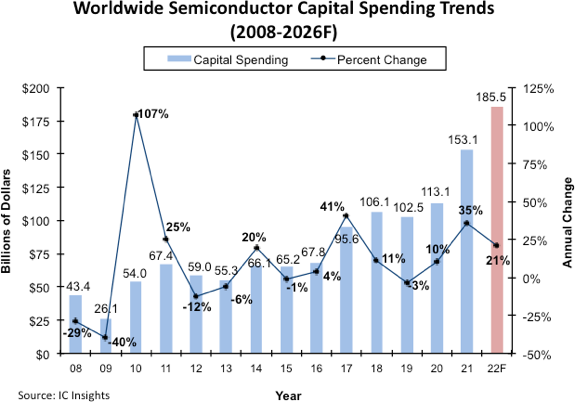
This is a decrease from the $190.4 billion and 24% growth forecast earlier this year. Despite the downward revision, the revised capex forecast still represents a new high level of spending.
Utilization rates remain well above 90% for many IDM plants and 100% for many pure-play foundries in the first half of the year, as the economic recovery during the epidemic kept orders strong.
Semiconductor capital spending is now expected to reach $338.6 billion for the two years combined in 2021 and 2022. IDMs and foundries are investing heavily in expansions for the manufacture of logic and storage devices using leading-edge process technologies. However, strong demand and continued shortages of many other important chips, such as power semiconductors, analog ICs and various MCUs, have led suppliers to increase manufacturing capacity for these products as well.
Despite all of this positive news, soaring inflation and a rapidly slowing global economy caused semiconductor manufacturers to reassess their aggressive expansion plans mid-year. Several (but not all) suppliers, particularly many of the leading DRAM and flash memory manufacturers, have already announced cuts to their capital expenditure budgets for the year. More suppliers are noting that they expect to cut capex in 2023 if they assess capacity needs based on the industry absorbing three years of strong spending and slowing economic growth.
source:aijiwei
wanda
/include/upload/kind/image/20220823/20220823172920_3582.jpg
According to the latest data released by IC Insights, a leading semiconductor analyst firm, shows that the three years from 2020-2022 will be the first three-year period since 1993-1995 when capital expenditures achieved double-digit growth.
2022/8/23 17:30:18
2022/8/23 17:30:18
493
0
182
6
UMC attacked the automotive market and won orders from Infineon, Texas Instruments and other major manufacturers
According to the Economic Daily News, UMC has made great progress in its automotive layout, and recently won new certifications from Texas Instruments, Infineon and other automotive chip makers, with eight key areas of automotive certification in hand, and availing itself of the world's top-tier automotive chip makers.
The supply chain pointed out that UMC has obtained Infineon, NXP, Texas Instruments and other automotive chip makers large single, these customers in the global automotive chip market share of more than 30% of the total, the recent also in the fight for 22nm related automotive certification, all-out assault on the automotive market. Due to the reliability of automotive chips to be greater than 15 years, coupled with the Zero Defects (Zero Defects) requirements, UMC has received new certifications from a number of major manufacturers, highlighting the technical competitive advantage.
It is understood that UMC has taken eight key certifications in the field of automotive chips, covering power semiconductors, WiFi/Bluetooth and other wireless communication applications, millimeter wave radar sensors (Radar sensor), Auto AP, microcontrollers (MCU), CIS sensors, OLED/LCD driver ICs, micro-electromechanical sensors, etc. Almost all the necessary certifications for automotive chips have arrived.
UMC's third-generation semiconductor business has also reported good news. Benefiting from the strong demand for 5G and automotive applications, UMC's third-generation semiconductor business has made profits for five consecutive quarters in the second quarter of this year and has been growing quarter by quarter.
According to UMC's financial results, the company's revenue in July was NT$24.827 billion (same unit below), an annual increase of 35.18%, and has set a new revenue record for ten consecutive months. UMC's consolidated revenue for the first seven months of this year was 160.305 billion yuan, an annual increase of 37.75%.
source:aijiwei

wanda
/include/upload/kind/image/20220822/20220822165048_4180.jpg
According to the Economic Daily News, UMC has made great progress in its automotive layout, and recently won new certifications from Texas Instruments, Infineon and other automotive chip makers, with eight key areas of automotive certification in h
2022/8/22 16:51:23
2022/8/22 16:51:23
495
0
181
6
Industry sources: whether consumer device chip demand can pick up in the fourth quarter or not until October to determine
IC design companies remain cautious about demand for this year's year-end shopping season, given the uncertainty of order visibility, industry sources said, according to DIGITIMES on Aug. 19.
Fabless chipmakers agree that replenishment demand from PC customers is unlikely to pick up significantly until at least 2023, the sources said. Demand for PC-related commodity chips will remain subdued through the fourth quarter of this year.
Whether the upcoming iPhone will spur demand for mobile chips as a whole remains to be seen, the sources said. Sluggish sales of Android smartphones in China during the Double 11 shopping festival also prompted Fabless chip makers to be conservative about sales. In addition, sales of Android phones during this year's 618 online shopping in China were also sluggish.
Meanwhile, sources noted that back-to-school demand has also been disappointing so far. The market for educational PCs and other mass-market electronic devices is becoming increasingly saturated.
According to the sources, whether demand for chips for cell phones, PCs and other consumer electronic devices will pick up in the fourth quarter may not be determined until October. By then the new iPhones will hit store shelves and Chinese channel players will be making purchasing decisions for the upcoming shopping season.
"As momentum in smartphone, PC and consumer end markets rapidly slows, supply chains in related industries will engage in inventory adjustments throughout the second half of 2022," TSMC CEO Chieh-Chih Wei said during a July earnings call, adding that such adjustments are justified after two years of home demand driven by the new crown epidemic.
source from:aijiwei app
wanda
/include/upload/kind/image/20220819/20220819171420_3387.jpg
IC design companies remain cautious about demand for this year's year-end shopping season, given the uncertainty of order visibility, industry sources said, according to DIGITIMES on Aug. 19.
Fabless chipmakers agree that replenishment
2022/8/19 17:14:44
2022/8/19 17:14:44
274
0
179
6
Qualcomm's large orders will be the main driver of TSMC's earnings growth in the second half of the year
Tiburon News, TSMC has raised its full-year revenue target at the same time many companies are cutting or canceling orders. Recently, sources told digitimes that TSMC's confidence in its performance stems from securing orders from six major customers, including Qualcomm, Intel and Nvidia.
The main driver of TSMC's second-half earnings growth came from a large order from Qualcomm. In addition to the 7nm process, Qualcomm has placed orders for 5nm and 4nm chips, which are expected to make up for reduced orders from other customers.
It is understood that TSMC's 5nm and below processes have better yields and performance than competitors, and sources said Qualcomm's cooperation with TSMC will continue on 3nm and 2nm.
Meanwhile, Qualcomm recently signed a long-term purchase agreement with Ge-Core. Qualcomm will buy a total of $7.4 billion from GF through 2028, more than double the $3.2 billion in the previous agreement. 12nm and 14nm and above special processes do not affect Qualcomm's cooperation with TSMC at 7nm and below.
TSMC has noted weaker market demand on the consumer side, but demand for data center and automotive electronics applications has remained stable. TSMC has been able to support these demands by reallocating capacity. Even with continued inventory adjustments, customer demand continues to exceed TSMC's capacity supply. As a result, capacity is expected to remain tight throughout 2022.
The semiconductor industry believes that eventual inventory adjustments will continue through the first half of 2023.
TSMC's largest customer is believed to be Apple, accounting for more than 25 percent of its revenue. The customer is gradually increasing TSMC's Mac series orders, and TSMC will become the exclusive manufacturer of Mac chips in 2023, sources said.
TSMC will also benefit from favorable exchange rates and overall price increases in 2022. In addition, the average selling price (ASP) of the 7nm and 5nm processes, which account for 51% of the company's revenue, has increased significantly. The 28nm process is estimated to have risen to more than $3,000. 16nm and 12nm wafers are priced at around $5,000, 7nm at close to $10,000, and 5nm and 4nm at $16,000-$20,000.
After the merger of AMD and Xilinx -- both of which are TSMC customers -- their data center platform shipments and market share have increased, while TSMC's orders have not dropped significantly, the sources said.
Intel and Nvidia will not be TSMC's main revenue growth drivers in 2022, the sources noted. Intel's 7nm and 5nm process orders are contributing less revenue, while Nvidia's RTX30 series has a higher inventory with Samsung's 8nm process.
Intel's next-generation Meteor Lake processor platform reportedly won't be available until the first quarter of 2024, which has also delayed the adoption of TSMC's 3nm process by U.S. customers, the sources said. However, Intel will reportedly expand its 7nm and 5nm orders to maintain its relationship with TSMC, the sources said.
NVIDIA's next-generation RTX40 series using TSMC's 5nm process was originally scheduled to launch in August, but has been delayed by at least a quarter and may not even launch until the first quarter of 2023, the sources said. TSMC already has other customer orders to make up for the delay, and the two sides have reached an agreement on an order contract, the sources added.
Translated with www.DeepL.com/Translator
source from:jiweiwang
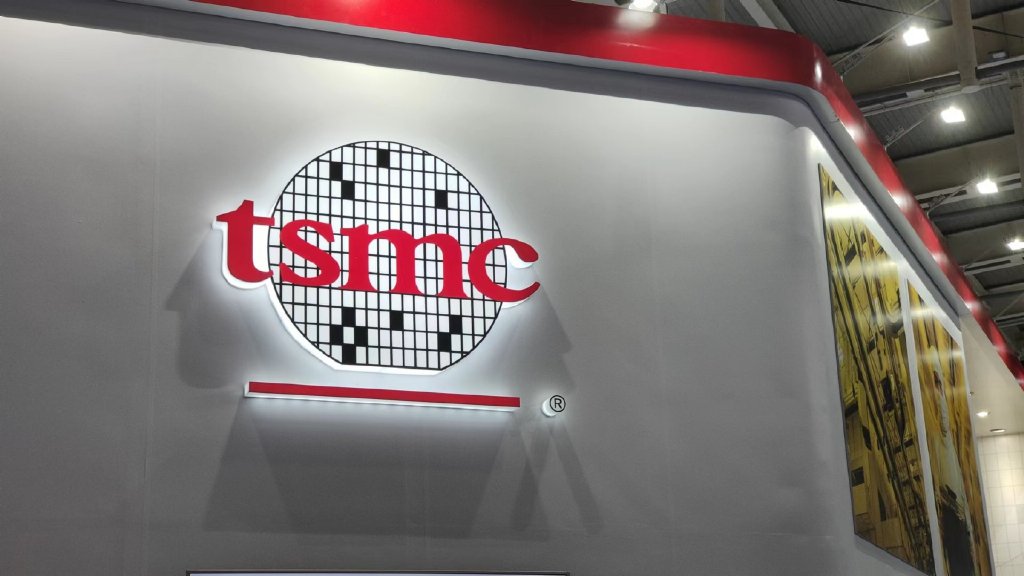
wanda
https://n.sinaimg.cn/sinakd20116/0/w1024h576/20220811/55cd-07195f19d508c55f2bd813fed2cc68ea.jpg
Tiburon News, TSMC has raised its full-year revenue target at the same time many companies are cutting or canceling orders. Recently, sources told digitimes that TSMC's confidence in its performance stems from securing orders from six major custome
2022/8/12 16:22:59
2022/8/12 16:22:59
312
0
174
6
Global smartphone shipments fell for four consecutive seasons! IDC: the main reason from the Chinese market
Tibco News, according to data agency IDC report shows that global smartphone shipments fell 8.7% year-on-year in the second quarter of 2022, with shipments dropping to 286 million units in the quarter, down 3.5% from expectations. This time is the global smartphone shipments fell for four consecutive seasons.
Similarly, Canalys released a report on Aug. 1 saying that global smartphone shipments in the second quarter of 2022 were the lowest quarterly point since the second quarter of 2020.
Nabila Popal, IDC's global research director, said original equipment manufacturers have cut orders for the rest of the year, with the biggest cuts coming from their Chinese suppliers. Demand is expected to start picking up in some regions by the end of the year, but smartphone market shipment expectations are bound to be revised downward in 2022. IDC believes that the current decline in various figures is not a disappearance of demand, but is being brought forward.
From a regional perspective, the most obvious part of the decrease in Q2 2022 is Central and Eastern Europe. Due to the ongoing impact of the Russia-Ukraine war, shipments to Ukraine fell 36.5% year-over-year in the second quarter. In terms of volume, the decline in global smartphone shipments came primarily from China, where shipments fell 14.3% year-over-year in Q2.
Despite the downward revision in industry sentiment, the ranking of suppliers did not change much in 2Q2022. Samsung held the No. 1 position with a 21.8% market share, Apple came in second with 15.6%, while Xiaomi came in third with 13.8% and closed the gap.
source from:aijiwei
wanda
https://img.ithome.com/newsuploadfiles/2022/8/06645671-98fd-4db5-bcc8-39c6c820bb6a.png
Tibco News, according to data agency IDC report shows that global smartphone shipments fell 8.7% year-on-year in the second quarter of 2022, with shipments dropping to 286 million units in the quarter, down 3.5% from expectations. This time is the
2022/8/4 16:46:59
2022/8/4 16:46:59
323
0
172
6
TrendForce: The United States will improve the proportion of advanced process capacity in the next three years, and China will account for 70% by 2025
On July 28, EST, the U.S. House of Representatives passed the "Chip and Science Act" to subsidize the U.S. semiconductor chip manufacturing industry.
In this regard, the market research agency TrendForce predicts that the 7nm (including) the following advanced process capacity, to 2025, China Taiwan accounted for about 69%, China 1%, South Korea 18%, the United States 12%.
In terms of global 12-inch production capacity by region, by 2025, Taiwan will account for 43%, followed by mainland China 27%, the United States 8%, and South Korea 12%. Compared with the pattern in 2022, it is clear that the U.S. will increase the proportion of advanced process capacity in the next three years, while mainland China will be the main axis of the mature process.

It is understood that the bill, which has undergone several redactions, was finally named the "Chip and Science Act," which will provide about $52 billion in government subsidy funds for U.S. semiconductor manufacturing and $24 billion worth of investment tax credits for chip factories, and is expected to fund 10 to 15 new semiconductor factories in the next decade. It also includes more than $170 billion over five years to authorize the National Science Foundation, the U.S. Department of Commerce and others to increase investments in science and technology research and development in key areas to promote scientific research in the United States.
In addition, TrendForce pointed out that in addition to actively cultivating domestic production lines through the chip bill, the U.S. has frequently sought to increase the intensity and depth of sanctions against mainland China's semiconductors to curb their development through additional restrictions, in line with the entity list ban that had been in place for several years before the epidemic.
Source from:ITzhijia
wanda
https://img.ithome.com/newsuploadfiles/2022/8/21a5e0b9-25ec-4678-8324-e2bd2c845f3d.png
On July 28, EST, the U.S. House of Representatives passed the "Chip and Science Act" to subsidize the U.S. semiconductor chip manufacturing industry.
In this regard, the market research agency TrendForce predicts that the 7nm (includin
2022/8/2 8:56:34
2022/8/2 8:56:34
390
0
171
6
Auto and industrial chip supplies remain tight, Consumer ICs need six months to complete inventory correction
According to the report from DIGITIMES on July 27, the supply of automotive and industrial chips remains tight, while consumer chip inventories continue piling up throughout the supply chain.

Industry sources said consumer IC inventories held by distributors and downstream device vendors have reached alarming levels; nearly every segment of the consumer IC industry is in a state of overstock.
In the best-case scenario, it may take half a year for consumer IC suppliers to complete their inventory correction, according to the sources. Thus, the outlook for consumer electronics demand in the second half of 2022 is generally pessimistic.
TSMC has previously warned that customers may adjust inventory through the first half of 2023.
TSMC CEO CC Wei said in the latest earnings conference call that with smartphone, PC and consumer end market momentum slowing down, related industry supply chains will be involved in inventory correction throughout the second half of 2022.
Additionally, the outlook for automotive, industrial and other non-consumer IC demand remains promising, according to industry sources. IDMs, such as NXP Semiconductors, continue to see their automotive and industrial chip supply fall short of demand.
Source from ijiwei
Cathy
/include/upload/kind/image/20220729/20220729101739_2549.jpg
According to the report from DIGITIMES on July 27, the supply of automotive and industrial chips remains tight, while consumer chip inventories continue piling up throughout the supply chain.
Industry sources said consume
2022/7/29 10:18:26
2022/7/29 10:18:26
491
0
170
6
Texas Instruments current-quarter revenue above expectations: inventory days decrease, the revenue of automotive chips increases over 20%
According to the report on July 26, Chipmaker Texas Instruments Inc on Tuesday announced its 22Q2 revenue increased by 14% year-on-year, 6.3% quarter-on-quarter, to $5.212 billion, better than the expectation of $4.65 billion. Meanwhile, its revenue grew by double-digit percent year-over-year for six consecutive quarters.

The gross profit for Q2 was $3.625 billion, up 18% year-over-year; operating profit was $2.723 billion, up 23% year-over-year; net income was $2.291 billion, up 19% year-over-year; and diluted earnings per share were $2.45, better than the expectations of $2.12, compared to $2.05 in the same period last year.

Analog revenue grew 15% to $3.992 billion, Embedded Processing grew 5% to $821 million, and other segments grew 19% from the year-ago quarter to $399 million.
Dave Pahl, director of DEI Investor Relations of Texas Instruments, pointed out that the industrial market was up high-single digits, and the automotive market was up more than 20%. Weakness could be seen throughout the quarter in personal electronics, which grew low-single digits. Next, communications equipment was up about 25%. Finally, enterprise systems were up mid-teens.
Rafael Lizardi, treasurer of Texas Instruments, said in the teleconference the inventory days in Q2 were 125, down two days sequentially and below desired levels.
Texas Instruments CEO Rich Templeton said Q3 revenue is estimated to range from $4.90 billion to $5.30 billion (median $5.10 billion). EPS is estimated to range from $2.23 to $2.51 (median $2.37).
Lizardi added that Q3 financial expectation has considered the weak demand, especially in the personal electronics market.
According to the analysis on Yahoo Finance, the Q3 revenue of Texas Instruments is estimated to be $4.97 billion, and EPS is expected to be $2.26.
Source from Xinzhixun
Cathy
/include/upload/kind/image/20220728/20220728105027_4453.jpeg
According to the report on July 26, Chipmaker Texas Instruments Inc on Tuesday announced its 22Q2 revenue increased by 14% year-on-year, 6.3% quarter-on-quarter, to $5.212 billion, better than the expectation of $4.65 billion. Meanwhile, its revenu
2022/7/28 10:51:27
2022/7/28 10:51:27
560
0
168
6
Owing to strong demands for automotive and IoT devices, NXP Q3 revenue increased by 27.6 percent year-on-year to $3.31 billion
According to the report from cnYES, automotive chipmaker NXP Semiconductors N.V. reported financial results for the second quarter on July 25. The report pointed that owing to the strong demand within the Auto and Industrial and IoT end-markets, NXP's quarterly revenue increased by 36% year-on-year to $1.713 billion. Hence, the company delivered better earning expectations for Q3.
NXP reported a year-on-year revenue increase of 27.6% to $3.31 billion, a Non-GAAP EPS increase of 78% to $3.55 and a Non-GAAP gross margin increase of 57.8%, for the three months ended July 3, all exceeding the expectations.
In terms of the performance of each division, NXP's Q2 automotive revenue increased 36% to $1.713 billion, industrial and IoT revenue increased 25% to $713 million, mobile revenue increased 12% to $388 million, and communications infrastructure and other revenue increased 20% to $498 million.

NXP announced Q3 revenue will be between $3.35 billion and $3.5 billion, better than analysts' estimate of $3.32 billion, and gross margin is estimated to reach 58.3%, better than the expected 57.6%.
Source from Tencent
Cathy
/include/upload/kind/image/20220727/20220727100234_9187.jpg
According to the report from cnYES, automotive chipmaker NXP Semiconductors N.V. reported financial results for the second quarter on July 25. The report pointed that owing to the strong demand within the Auto and Industrial and IoT end-markets, NX
2022/7/27 10:03:34
2022/7/27 10:03:34
310
0
167
6
From 70% to 50%! South Korean expects to reduce the reliance on imported materials, parts and equipment
South Korea said it aims to increase the share of local enterprises in the global non-storage semiconductors market from 3% to 10% by 2030, reducing the reliance on imported materials, components and equipment from 70% to 50%.

As reported by Business Korea, the government will enlarge the tax break for semiconductor development and infrastructure investment. The tax deduction rate for infrastructure investment for large firms will increase from 6-10% to 8-12%. The government is also looking at establishing a training center for semiconductor engineers this year to provide at least 150,000 people over ten years to bolster the semiconductor labor force.
The government revealed that the volume of semiconductor production hubs would be enhanced from 350% to 490%, increasing the clean room facilities in Pyeongtaek and Yongin from 12 to 18 and 9 to 12, respectively, expecting to create 9,000 jobs.
Additionally, South Korea will also spend 450 billion and 500 billion won on feasibility studies on the development of power and auto chips from 2024 to 2030, 1.25 trillion won to develop artificial intelligence chips in the next seven years, and 1.5 trillion won to invest in 30 promising fabless semiconductor companies.
Source from ijiwei
Cathy
/include/upload/kind/image/20220726/20220726101001_2709.jpg
South Korea said it aims to increase the share of local enterprises in the global non-storage semiconductors market from 3% to 10% by 2030, reducing the reliance on imported materials, components and equipment from 70% to 50%.
2022/7/26 10:12:12
2022/7/26 10:12:12
790
0
166
6
Rumor: Broadcom and Texas Instruments are planning to raise chip prices
Intel, Qualcomm and Marvell have recently informed clients of the price hiking. According to insiders, Broadcom and Texas Instruments will also hike the chip prices these days.

According to the report from Digitimes, the insider said as the demands for 5G and Wi-Fi 6 devices continue to exceed the supply of wireless network chips, Broadcom has informed the customer that the price of its network communication chips will increase by 6-8% starting in January 2023.
The insider pointed that despite the low demand for consumer electronics, the analog IC suppliers still profit from the strong demand for automotive electronics and industrial controls. Texas Instruments has announced to clients the prices of some specialized ICs, including server ICs will increase by around 10% in Q3 2022.
Source from ijiwei
Cathy
/include/upload/kind/image/20220722/20220722093039_6993.png
According to insiders, Broadcom and Texas Instruments are planning to hike the chip prices these days.
2022/7/22 9:32:15
2022/7/22 9:32:15
343
0
165
6
Toyota’s global August production is expected to decline by 20%; EV production line will be suspended for a month
As reported by Taiwanese media MoneyDJ, influenced by the shortages of chips and other parts, Japan’s leading automotive manufacturer Toyota is expected to reduce global production volume by 20% in August. EV production line in Japan will be suspended for one month.

Toyota announced on July 19 that its global August production is expected to hit around 700,000 cars, including approximately 200,000 units produced in Japan and 500,000 units produced overseas, down from the 850,000 it intended to make when briefing suppliers at the start of the year. Toyota still says its global production volume for August through October is estimated to average about 850,000 units per month, and its production forecast for April 2022 to March 2023 fiscal year remains unchanged at approximately 9.7 million cars.
At the same time, Toyota will suspend production at nine lines across 6 of its 14 plants during August. The pauses will vary depending on production lines, with a minimum of 2 days and a maximum of 18 days.
Source from ijiwei
Cathy
/include/upload/kind/image/20220721/20220721095204_3846.jpg
Influenced by the shortages of chips and other parts, Japan’s leading automotive manufacturer Toyota is expected to reduce global production volume by 20% in August. EV production line in Japan will be suspended for one month.
2022/7/21 9:54:34
2022/7/21 9:54:34
312
0
164
6
Taiwanese media: Qualcomm, Marvell, Intel and TSMC will raise chip prices
According to the reports from foreign media, on July 19, Qualcomm, Marvell, Intel and TSMC began to raise chip prices.
Qualcomm and Marvell have informed customers that price increases could begin as early as August, according to Taiwanese media reports. Several chip suppliers, including Intel and TSMC, are also planning to raise prices despite growing concerns about fluctuating demand.
Intel told customers that the company would begin hiking prices in the second half year by 10-20%, as reported yesterday.
The company informed that due to the increasing costs caused by global inflation, the prices of CPU processors, peripheral chips, and other core servers are expected to hike. The price volatility varies by type, with the lowest in a single-digit percentage, and some product prices may increase by up to 20%.
Besides Intel, other chipmakers have also begun to increase their product prices to some extent. Samsung announced it will increase chip prices by 20% in March. TSMC also told customers it will raise prices by a “single-digit” percentage.
Source from TechWeb

Cathy
/include/upload/kind/image/20220720/20220720093757_5411.jpg
According to the reports from foreign media, on July 19, Qualcomm, Marvell, Intel and TSMC began to raise chip prices.
2022/7/20 9:39:17
2022/7/20 9:39:17
329
0
163
6
Intel announced to hike prices on various chip products, and some product prices would increase by up to 20%
According to the reports from foreign media on July 18, chip giant Intel told customers that the company would begin hiking prices on its chip products in the second half year by 10-20%.
Intel indicated it would increase pricing in certain segments of its business due to inflationary pressures in its April earnings report. Recently, the company has informed that it would begin hiking the prices on CPU processors, peripheral chips, and other core servers to deal with the increasing costs caused by inflation and that the price volatility varies by type, with the lowest in a single-digit percentage, and some product prices may increase by up to 20%.
The price increases are set to take place just as PC shipments experienced a big decline, and inflation is already impacting average selling prices of PCs. Gartner revealed this week that worldwide PC shipments dropped nearly 13 percent this quarter. “This is the sharpest decline in nine years for the global PC market, brought on by geopolitical, economic and supply chain challenges impacting all regional markets,” said Gartner in a press release.
Reportedly, the CPI of the U.S. in June increased 9.1% year-over-year, reaching a record in the past 40 years.
As inflation increases in the U.S., Europe and much of the world, other chipmakers also begin to increase their product prices to some extent. Besides Intel, Korean technology giant Samsung announced it will increase chip prices by 20%; TSMC told customers it will raise prices by a “single-digit” percentage.
Source from Xinzhixun

Cathy
/include/upload/kind/image/20220719/20220719101421_2160.jpg
According to the reports from foreign media on July 18, chip giant Intel told customers that the company would begin hiking prices on its chip products in the second half year by 10-20%.
2022/7/19 10:15:14
2022/7/19 10:15:14
315
0
162
6
The Dutch foreign minister confirmed talks with US on blocking ASML from selling essential equipment to China
According to the report from Bloomberg on July 14, Dutch foreign minister Wopke Hoekstra confirmed that the Netherlands and the U.S. are holding discussions on blocking ASML Holding NV from selling to China technology used in making a large chunk of the world's chips.

Wopke Hoekstra said in an interview in The Hague, "What I can tell you is that it does make sense that you always liaise with friends when certain goods have broader strategic implications and ramifications across the globe. Of course, you have conversations about that, and that we do."
On July 6, Bloomberg quoting a person familiar with the matter reported that the U.S. was pushing the Dutch government to restrict ASML from selling the Chinese Mainland the essential equipment used in most chip manufacturing, including the major lithography machine DUV machine, to restrain China's semiconductor rise.
On July 8, Bloomberg again reported that the U.S. Commerce Department responsible for export controls was discussing the possibility of banning the export of chip manufacturing equipment to China's fabs able to make process chips at 14nm and below.
It was also reported that if the U.S. Commerce Department moves forward with this concept, which has not yet been drafted as a formal proposal, the U.S. will look to bring in allies such as the Netherlands, Japan and South Korea, which have top chip manufacturing equipment.
The response from the Foreign Minister Wopke Hoekstra demonstrated the U.S. and the Netherlands are indeed holding discussions on blocking the lithography machine giant ASML Holding NV from selling technology used in chip manufacturing to China.
Last week, Chinese Foreign Ministry Spokesperson Lijian Zhao criticized the U.S. at a press conference for abusing state power to impose a technology blockade on other countries, which will only prompt them to become independent and self-reliant in science and technology quickly. "Those who seek to block others' way will only end up blocking their own way," said Zhao. He also implicitly appealed to the Netherlands and Japan to adopt an objective and impartial stance on this matter and make independent decisions based on their own long-term interests and the market principles of equity and fairness.
The Dutch government has not agreed to the restriction. China is the third largest trading partner of the Netherlands, after Germany and Belgium.
ASML's CEO Peter Wennink said earlier this year that he opposed a ban on selling DUV lithography equipment to Chinese customers because it is already a mature technology. Based on the data revealed by the company and Bloomberg's investigations, ASML's plants located in China contribute to 14.7% of its total revenue in 2021.
Source from Xinzhixun
Cathy
/include/upload/kind/image/20220715/20220715104153_3962.jpg
According to the report from Bloomberg on July 14, Dutch foreign minister Wopke Hoekstra confirmed that the Netherlands and the U.S. are holding discussions on blocking ASML Holding NV from selling to China technology used in making a large chunk o
2022/7/15 10:43:17
2022/7/15 10:43:17
652
0
161
6
The global total sales of semiconductor manufacturing equipment will reach $117.5 billion, rising 14.7% from the previous industry
SEMI announced in its recent report that 2022 global sales of total semiconductor manufacturing equipment are forecast to reach a record $117.5 billion, rising 14.7% from the previous industry, and increase to $120.8 billion in 2023.

Regionally, Taiwan, the Chinese Mainland, and Korea are projected to remain the top three equipment buyers in 2022, among which Taiwan will gain the top position in 2022 and 2023.
According to SEMI, the wafer fab equipment segment, including wafer processing, fab facilities, and mask/reticle equipment, is projected to expand 15.4% to a new industry record of $101 billion in 2022. In 2023, the sales are expected to continue increasing by 3.2%, reaching $104.3 billion.

SEMI said in line with the semiconductor industry’s push from huge investments in digital facilities to increase and upgrade capacity, the wafer fab equipment segment could reach the $100 billion milestones for the first time in 2022.
Driven by demand for leading-edge and mature process nodes, the foundry and logic segments are expected to increase 20.6% year over year to $55.2 billion in 2022 and another 7.9%, to $59.5 billion, in 2023.
In terms of memory and storage, the DRAM equipment segment is expected to grow by 8% to $17.1 billion in 2022, while a decline of 7.7% is forecast in 2023; The NAND equipment market is projected to grow 6.8% to $21.1 billion this year, followed by a 2.4% decrease in 2023.
SEMI also estimated the packaging equipment segment is expected to grow 8.2% to $7.8 billion in 2022 and down 0.5% to $7.7 billion in 2023. The test equipment segment is forecast to grow 12.2% to $8.8 billion in 2022 and continue to increase by 0.4% in 2023 on demand for high-performance computing applications.
Source from Xinzhixun
Cathy
/include/upload/kind/image/20220714/20220714100144_2900.jpg
SEMI announced in its recent report that 2022 global sales of total semiconductor manufacturing equipment are forecast to reach a record $117.5 billion, rising 14.7% from the previous industry, and increase to $120.8 billion in 2023.
2022/7/14 10:03:22
2022/7/14 10:03:22
471
0
160
6
IC Insights: The top 10 semiconductor suppliers in Taiwan show poor revenue performance in June
According to the latest report from IC Insight, the financial results in this quarter of Micron Technology Inc., a large memory and storage solution provider, were far worse than expected. Taiwan top 10 semiconductor suppliers mostly show a decrease in revenue in June, which is a warning of the reversal of the semiconductor industry boom.

Micron estimated its quarterly revenue will be $7.2 billion (up or down $0.4 billion), decreasing by 17% compared with the last quarter. IC Insights pointed that the sharp decline in Micron’s quarterly revenue is a warning of the weak memory demand in Q3.
IC Insights said the semiconductor suppliers in Taiwan also sound an alarm. The top 10 semiconductor suppliers showed a decline in monthly revenue by 5%. Among the top 4 suppliers, TSMC, MediaTek, and Rayson’s revenue reduced from last month. The monthly revenue of Uniwin, the leading manufacturer of drive ICs, decreased by 26%. DRAM manufacturer Nanya Technology’s revenue also decreased by 16%.
In addition, the report suggested that TSMC's revenue in June decreased by 5%, but its June revenue from 2016 to 2021 averagely increased by 14% and decreased by 13% in 2018 only. Reportedly, TSMC will announce its 2022Q2 revenue on July 14.

Source from Sina
Cathy
/include/upload/kind/image/20220713/20220713100843_0471.jpg
According to the latest report from IC Insight, the financial results in this quarter of Micron Technology Inc., a large memory and storage solution provider, were far worse than expected. Taiwan top 10 semiconductor suppliers mostly show a decreas
2022/7/13 10:10:31
2022/7/13 10:10:31
447
0
159
6
Warning! Samsung continues to suspense procurement, even worse than cutting orders
Taiwan media reported on July 11 that Samsung recently notified its supply chain that the suspension of procurement, which had been planned to end up at the end of July, has been postponed to the end of August. Some categories of materials will not be purchased until the end of the year. The performance of related manufacturers in the next half-year may be hurt.
Reportedly, Samsung extending the suspension of procurement means an overall high inventory level. The previous repeated ordering may bring more serious results than expected, among which the sales of mid-range smartphones have been most heavily affected. Hence, Samsung’s current suspension mainly focuses on the manufacturers related to the supply chains of smartphones. Some industrial insiders said Samsung’s suspension of purchasing could be even worse than cutting orders. After all, order cutting means decreasing quantity, while purchasing break means null.
It was originally believed that if Samsung pauses the procurement in July only, the supply chain could maintain its agility by stockpiling goods in distributors or other methods. However, there will be no place to store the components if the purchasing suspension is extended to the end of August, resulting in a bad performance in the traditional peak season in the second half-year.
The supply chain revealed that inflation leads to the decline in public consumption, hitting the sales of mid-range smartphones, which triggers Samsung to pause purchasing further.
Source from Xinzhixun

Cathy
/include/upload/kind/image/20220712/20220712101442_1929.jpg
Taiwan media reported on July 11 that Samsung recently notified its supply chain that the suspension of procurement, which had been planned to end up at the end of July, has been postponed to the end of August. Some categories of materials will not
2022/7/12 10:15:23
2022/7/12 10:15:23
365
0
158
6
A drop in voltage happened to Renesas Electronics’ MCU plant, causing a loss of two weeks’ worth of output!
Although the supply of consumer MCUs has recently eased, automotive MCUs continue to be in short supply due to the explosion of the new energy vehicle market. Recently, Renesas Electronics, a large automotive MCU manufacturer, was forced to shut down one of its MUC plants due to the voltage drop caused by lightning. The supply of automotive MCUs may become even tighter.
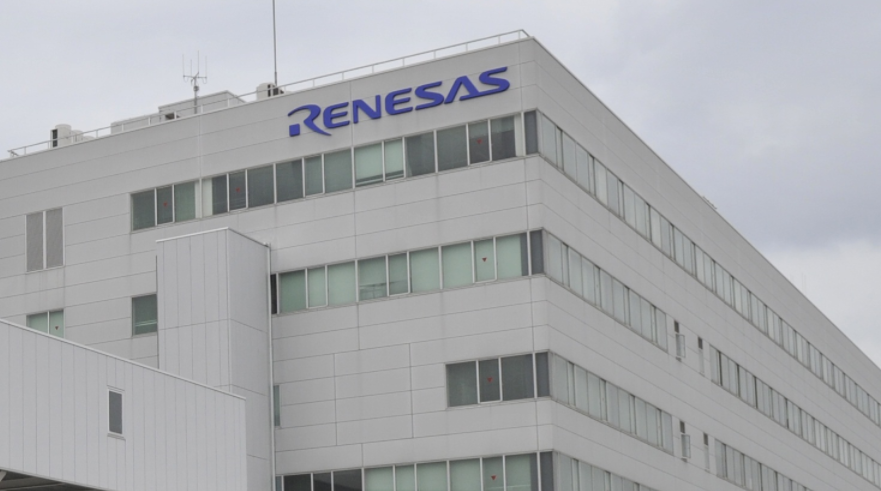
According to the announcement on Renesas Electronics' website, lightning hit an electric line supplying its plant in Kawashiri, Japan, as Typhoon No.4 led to a local thunderstorm, resulting in a temporary suspension of production facilities at the plant.
Although Renesas Electronics activated its UPS immediately after the voltage dropped, the duration of the voltage drop was significantly longer than the historical records and expectations over the past ten years, halting 90 percent of the equipment. Fortunately, the plant's cleanroom function remained in effect after the voltage drop.
Renesas Electronics said it had restarted production facilities and that a part of the production will recover from July 6. The production capacity expected to return to the normal minimum on July 11.
In addition, Products in the middle of the manufacturing process at the moment of voltage drop were ruined and will be thrown.
The incident is estimated to cause the loss of two weeks' worth of output.
According to the global MCU supplier ranking in 2021 published by IC Insights, a semiconductor research organization, Renesas Electronics is the third-largest MCU supplier in the world, with $3.42 billion in sales and 17.0% market share.

And Renesas Electronics mainly focuses on automotive MCUs. According to Qianzhan Industry Research Institute, in 2020, Renesas Electronics ranked first with a market share of up to 30% in the global automotive MCU market.
Obviously, the voltage drop at Renesas Electronics' Kawashima plant will lead to an even tighter supply of automotive MCUs, under the current circumstance of automotive MCU shortage.
Source from Xinzhixun
Cathy
/include/upload/kind/image/20220708/20220708100013_8498.png
Although the supply of consumer MCUs has recently eased, automotive MCUs continue to be in short supply due to the explosion of the new energy vehicle market. Recently, Renesas Electronics, a large automotive MCU manufacturer, was forced to shut do
2022/7/8 10:02:49
2022/7/8 10:02:49
803
0
157
6
The chip price in the U.S. hikes and chipmakers are difficult to deliver products
According to Taiwan Economic Daily, due to the global shortage of network communication chips and the surging chip price of the U.S. leading manufacturers, customers cannot get their chips as scheduled even if they accept the increased price. Therefore, some telecom customers in Europe and America asked the Netcom factories to change the terminal designs and transfer to the chips produced by MediaTek and Realtek.
Industrial insiders revealed that the telecom industry previously adopted the chips produced by the U.S. leading manufacturers, and the communications operators were responsible for the design and manufacturing of xDSL, client optical fibers, IAD integration devices, IP STBs, etc. But recently, some customers have been impatient with the leading manufacturers who raise prices but cannot deliver products. They have transferred to the chips manufactured by MediaTek, Realtek, etc.
MediaTek responded that they would not comment on the orders placed by customers. At the same time, Realtek said it would continuously optimize product portfolios to cooperate with more customers.
Industrial insiders pointed out that the situation that leading international chipmakers delay deliveries and focus on more advanced products gives the manufacturers like MediaTek opportunities. Since the beginning of this year, some manufacturers have been unwilling to wait for the delivery of the leading chipmakers and considered transferring to other chips. Still, it is estimated that they won’t get their new chips until the second half of this year.
Source from TechWeb

weihu
/include/upload/kind/image/20220706/20220706171742_3853.png
According to Taiwan Economic Daily, due to the global shortage of network communication chips and the surging chip price of the U.S. leading manufacturers, customers cannot get their chips as scheduled even if they accept the increased price. There
2022/7/6 17:25:00
2022/7/6 17:25:00
361
0
125
6
The Revenue of TSMC in This Quarter Will Overtake Intel, Become The Second-Largest Chipmaker Worldwide
According to Taiwan Economic Daily, TSMC will catch up withe Intel for the first time this quarter to become the second-largest chipmaker behind Samsung, and will further widen the gap in Q3, as the peak season.
TSMC’s performance has grown steadily in recent years, while Intel’s is relatively unstable. TSMC’s revenue in Q2 will reach a new high for the 7th season if it successfully reach the financial target. In the contrary, the quarterly revenue of Intel declined for two consecutive quarters in the first half of this year after hitting a record high of $20.5 billion in Q4 2021. Based on the projected revenues announced by TSMC for April and May, there is no concern about reaching the target revenues of $17,6 billion to $18.2 billion. Intel expects revenue target of $18 billion for this quarter.
Some analyst said TSMC’s revenue for the quarter is expected to overtake Intel mainly because it diversely applies its customer base, and its customers are mostly from the North American market. TSMC concentrates its production capacity in Taiwan, China, while Intel encounters the tests from the lockdown in China’s mainland, supply chain dispatch, concentrated end-use applications in a single personal computer (PC), and servers.
Source from ITHome

Cathy
/include/upload/kind/image/20220627/20220627180424_4097.png
According to Taiwan Economic Daily, TSMC will catch up withe Intel for the first time this quarter to become the second-largest chipmaker behind Samsung, and will further widen the gap in Q3, as the peak season.
TSMC’s performance has
2022/6/27 18:05:48
2022/6/27 18:05:48
358
0
124
6
The Tight Supply of Automotive MCUs will last until 2023
Although the demand for consumer electronics is decreasing, the supply of automotive MCUs is expected to stay tight until 2023, according to industry sources.
According to Digitimes, the electrification of vehicles is driving the use of electronics in vehicles. Demand for key automotive microcontroller units (MCU) continues to be hot. Taiwan-based semiconductor manufacturers estimate a single vehicle needs 20-30 MCUs. In the future, luxury vehicle models may need up to 100 MCUs, which is higher than the previously estimated 70 units.
With respect to the automotive MCUs, the manufacturers based in Chinese mainland constantly achieve great breakthroughs. For example, GigaDevice Semiconductor said that its sample of the 40-nm automotive MCU had been sent to the customers. SinoWealth estimated that its newly-developed automotive MCU would be released in the middle of the year. Chipsea also announced it is developing the MCU chip, mainly divided into M-series and R-series; the M-series chip is mainly introduced into the manufacturing of bodywork including windows, wipers, lamps, etc.; the R-series chip is introduced into manufacturing chassis and dynamical system. The above products are being developed as planned.
Source from ijiwei.com

Cathy
/include/upload/kind/image/20220622/20220622175855_2395.png
Although the demand for consumer electronics is decreasing, the supply of automotive MCUs is expected to stay tight until 2023, according to industry sources.
2022/6/22 18:01:20
2022/6/22 18:01:20
338
0
123
6
STMicroelectronics Opens New Production Line for Electronic Vehicle in Morocco
According to Ijiwei.com, STMicroelectronics opens new production line for electronic car SiC power device packaging in Bosquekula, located in Casablanca-Setat region, Morocco. The $244 million investment will expand the current production area by 7,500 square meters. The manufacturing unit is now ST’s second largest plant.
According to eeNews, STMicroelectronics is the key supplier for Tesla, an American electronic vehicle manufacturer, covering from powders needed in ingot manufacturing, to SiC wafers and the fabs in Catania, to the chips packaged in Morocco. The new plant will be essential for ST to further expand its supply chain of silicon carbide equipment to Europe.
Reportedly, a number of high-profile officials attended the inauguration, including the Executive Vice-President of the Back-end Technology and Manufacturing organization, Fabio Gualandris; Morocco’s Minister of Industry and Trade, Ryad Mezzour; and the Governor of Nouaceur Province, Abdellah Chater.
Source from ijiwei.com

Cathy
/include/upload/kind/image/20220622/20220622085432_3255.png
According to Ijiwei.com, STMicroelectronics opens new production line for electronic car SiC power device packaging in Bosquekula, located in Casablanca-Setat region, Morocco. The $244 million investment will expand the current production area by 7
2022/6/22 8:56:08
2022/6/22 8:56:08
330
0
119
6
GlobalFoundries and STMicroelectronics mull a new fab in Europe, which may focus on chips needed in automotive industry
At the end of 2020, 17 of the 27 countries in the EU jointly issued a joint statement on European processors and semiconductor technologies, aiming to encourage research and investment in advanced processors and semiconductor processes in the EU. The European Union has schemed to increase its global semiconductor market share, hoping to account for 20% of global production by 2030. Its current market share is 10%, lower than in East Asia and North America.
One step to achieve the goal is to encourage the manufacturers from other countries to set up new fabs in Europe, such as attracting Intel to build a new fab in Magdeburg, Germany; while TSMC, the world's largest foundry, does not seem to be very interested in it owing to its lack of customers and the high fab-construction costs in Europe. Other companies that already have had fabs in Europe are eager to take actions for the sake of high subsidies, including STMicroelectronics and GlobalFoundries.
According to the relevant media, ST and GlobalFoundries aimed to get high subsidies like Intel to reduce construction costs. ST is headquartered in Geneva, Switzerland, with a new fab located in France; GlobalFoundries is headquartered in New York, the U.S., currently owning a large fab in Dresden, Germany, and may expand it nearby.
Since the main foundry markets of ST and GlobalFoundries are MCUs, sensors, MEMS, and automotive chips, they will not depend on cutting-edge manufacturing processes in production. Earlier this year, ST and GlobalFoundries announced a partnership. Some industry insiders speculate that the new fabs are likely to focus on chips needed in European industries such as automotive.
Source from Tencent
Cathy
/include/upload/kind/image/20220616/20220616180010_6912.jpg
At the end of 2020, 17 of the 27 countries in the EU jointly issued a joint statement on European processors and semiconductor technologies, aiming to encourage research and investment in advanced processors and semiconductor processes in the EU. T
2022/6/16 18:02:22
2022/6/16 18:02:22
636
0
118
6
National Bureau of Statistics: The production of integrated circuits in May 2022 was 27.5 billion units, which decreased by 10.4% year on year
According to the news reported by IT Home on June 15th, NBS (National Bureau of Statistics) data show that the industrial added value above designated size actually increased by 0.7% year on year (the following growth rates of added value ignore the price factors), and increased by 5.61% over the previous month. From January to May, the industrial added value above designated size increased by 3.3% year on year.

IT Home learned that the output of integrated circuits in May 2022 was 27.5 billion pieces, decreasing by 10.4% compared with May 2021. From January to May, the cumulative production was 134.9 billion pieces; the month-on-month decrease was 6.2%.
In addition, the production of microcomputers in May 2022 was 34.61 million units, with a 6.1% year-on-year decrease. The cumulative output from January to May was 170.89 million units, decreasing by 5.8% year on year. The production of mobile communication handheld production in May was 126.66 million units, down 4.6% year on year. The cumulative production volume from January to May was 608.71 million units, with a 1.7% year-on-year decrease.
Source from IT Home
Cathy
/include/upload/kind/image/20220615/20220615180517_9396.jpg
According to the news reported by IT Home on June 15th, NBS (National Bureau of Statistics) data show that the industrial added value above designated size actually increased by 0.7% year on year (the following growth rates of added value ignore th
2022/6/15 18:05:23
2022/6/15 18:05:23
359
0
116
6
The Supply Gap Reaches 20%! The Shortage Could Spread to Advanced Chips
According to the Wall Street Journal, the global shortage of chips that has plagued the world over the past two years could soon spread to more advanced chips to power the next generation of smartphone and data center.
The two-year chip shortage has only influenced the low-end chips so far, but that could change as semiconductor manufacturers struggle to get the equipment to manufacture more advanced processors.
The report points out that the supply gap of advanced chips is likely to reach 20% by 2024, which will have a knock-on effect on the relevant industries such as AI, high-performing computing, and self-driving cars.
Due to technical obstacles and the huge investment required, only two chip-makers, TSMC and Samsung, have the ability to produce high-end chips.
In some cases, the delivery period of new orders has been extended by two to three years. An industry insider revealed that some customers of TSMC have received warnings that equipment procurement problems may prevent the company from increasing production in the next two years.
In the face of these challenges, both TSMC and Samsung Electronics stated that they were working to avoid interference in chip production.

Source from ECCN
Cathy
/include/upload/kind/image/20220613/20220613174438_1922.jpg
According to the Wall Street Journal, the global shortage of chips that has plagued the world over the past two years could soon spread to more advanced chips to power the next generation of smartphone and data center.
The two-year chip sho
2022/6/13 17:46:25
2022/6/13 17:46:25
877
0
115
6
The global semiconductor market is expected to grow by 5.1% to $680 billion in 2023
The World Semiconductor Trade Statistics Association grew 26.2 percent in 2021 (WSTS) expects the global semiconductor market to grow 16.3 percent to $646 billion in 2022 and continue to grow 5.1 percent in 2023 to $680 billion, according to foreign media reports.
During the pandemic, more and more people work and study from home, leading to increased global demand for various semiconductor products, such as chips used in smartphones and computers, but semiconductor products are in short supply.Industries, including cars, mobile phones, game consoles and PC, have been affected by the global semiconductor supply shortage.
In addition, semiconductor has become an integral part of modern cars, it is in the aspect of engine management, temperature control, car entertainment and collision safety play a positive role, but the global supply shortage of Toyota, Honda, Volkswagen, ford, Fiat Chrysler and nissan brands were forced to cut production, even forced to stop production.
Strong demand for semiconductor products has driven growth in the semiconductor market.WSTS predicts that chip demand will continue to be strong, with most major categories expected to see higher year-over-year growth in 2022.
Source:TechWeb
wanda
http://upload.techweb.com.cn/s/640/2022/0608/1654659927190.jpg
The World Semiconductor Trade Statistics Association grew 26.2 percent in 2021 (WSTS) expects the global semiconductor market to grow 16.3 percent to $646 billion in 2022 and continue to grow 5.1 percent in 2023 to $680 billion, according to foreig
2022/6/8 17:30:20
2022/6/8 17:30:20
304
0
114
6
High supply chain inventory!In the first quarter of 2022, the average inventory turnover days of Chinese IC designers increased to 192 days
Since 2022, the consumer market, as an important driving force of the global semiconductor industry, has been affected by the war, the epidemic and inflation, and the terminal market demand is sluggish, the power of manufacturers to stock up is down, and the inventory level of consumer products has generally increased.In the first quarter of 2022, the proportion of consumer products in the operating revenue of global wafer manufacturers declined.Among them, the proportion of smartphones in TSMC's operating revenue fell to 40%, down about 5 percentage points year-on-year, and consumer electronics also fell to 26% and 52%, respectively, down about 1 percentage point and 4 percentage points year-on-year, respectively.
CINNO Research statistics show that in the first quarter of 2022, the average inventory turnover days of Chinese IC designers increased to 192 days, an increase of about 58 days from the first quarter of 2021.For SMIC, Huahong and other manufacturers, which account for a relatively high proportion of domestic customers, the rising inventory level of domestic IC design manufacturers brings certain variables to their future revenue growth point.
At present, the upstream price of semiconductor to the downstream transfer is blocked, IC in the demand and price is more obvious differentiation.Among:
· CINNO Research data shows that in the first quarter of 2022, the average inventory turnover days of domestic consumer IC design companies increased to 201 days, and the market demand weakened significantly; while the average inventory turnover days of domestic simulated IC designers increased to 135 days, less than the average inventory turnover days of domestic IC designers.
· At present, the semiconductor market has undergone structural differentiation, and automobiles and some HPC and A loT chips still have significant market growth momentum, but the supply and demand relationship between electronics consumption, PC, NB and other markets have changed.
· The analog chip market has the characteristics of long life cycle, wide downstream application and anti-cycle. At the same time, the improvement of the penetration rate of new energy vehicles brings sustainable development momentum to the analog chip market.
At present, although the global semiconductor industry is facing many challenges, such as inventory adjustment, structural capacity shortage, and weakened terminal demand, but the new infrastructure, dual-carbon, Internet of things, new energy and other market power is still good.From the perspective of wafer manufacturing, the global foundry wafer market will remain strong in 2022, and with the continuous optimization of the product portfolio, the confidence of the global semiconductor industry will not decrease.

Source:国际电子商情
wanda
http://mianbaoban-assets.oss-cn-shenzhen.aliyuncs.com/xinyu-images/MBXY-CR-607e6ba5a50bf66e55ad09c73791e2d6.png
Since 2022, the consumer market, as an important driving force of the global semiconductor industry, has been affected by the war, the epidemic and inflation, and the terminal market demand is sluggish, the power of manufacturers to stock up is dow
2022/6/7 17:16:50
2022/6/7 17:16:50
344
0
113
6
Shenzhen 2025 Semiconductor Plan: Focus on breaking through CPU, GPU, DSP, FPGA and other high-end general chip design
On June 6, Shenzhen Development and Reform Commission, Shenzhen Science and Technology Innovation Commission, Shenzhen Industry and Information Technology Bureau and Shenzhen State-owned Assets Supervision and Administration Commission released the Action Plan for Cultivating and Developing Shenzhen Semiconductor and Integrated Circuit Industry Cluster (2022-2025).
The Plan points out that by 2025, the industrial revenue will exceed 250 billion yuan, form more than 3 design enterprises with revenue exceeding 10 billion yuan and a batch of revenue exceeding 1 billion yuan, introduce and cultivate 3 manufacturing enterprises with revenue of more than 2 billion yuan, the integrated circuit industry level has been significantly improved, and the industrial structure is more reasonable.
In addition, we will also focus on breaking through the design of high-end general chips such as CPU, GPU, DSP and FPGA, and lay out the development of special chips such as artificial intelligence chips and edge computing chips.
The plan also mentioned that we will take the 5G communication industry as the lead to fully break through the core chips such as RF front-end chips, baseband chips and optoelectronic chips.Focusing on intelligent "terminal" and other pan-Internet of Things applications, to promote the rapid industrialization of ultra-low-power dedicated chips and NB-IoT chips.We will actively foster emerging business formats such as lidar and actively foster upstream chip supply chains such as lidar.
"Plan", to improve core technology research ability, continue to promote key areas research and development plan, around key materials, core equipment and parts to carry out technical research, support EDA whole process design tool system development, realize the core chip product breakthrough, promote high-end chip market proportion, explore new architecture chip research and development.Encourage qualified units to undertake major projects, major technical research plans and key research and development plans.
In addition, Shenzhen plans to build more than 4 professional IC industrial parks by 2025, to form a spatial pattern of integrated circuit industry development with "prominent focus, dislocation and coordination".

Source:IT之家
wanda
https://img.ithome.com/newsuploadfiles/2022/6/37ea8056-c7e4-42e0-b513-f35198c4dda3.jpg
On June 6, Shenzhen Development and Reform Commission, Shenzhen Science and Technology Innovation Commission, Shenzhen Industry and Information Technology Bureau and Shenzhen State-owned Assets Supervision and Administration Commission released
2022/6/6 17:45:37
2022/6/6 17:45:37
495
0
112
6
Samsung has shut down its LCD production line completely and moved its 300 employees to the chip packaging unit

Samsung has officially abandoned its LCD panel business and fully switched to OLED panels and quantum dot panels, and its previously operational LCD panel production line also ceased operations in June.Since Samsung's display and chip packaging businesses belong to Samsung's equipment solution division, Samsung has transferred its LCD panel factory employees to the chip packaging business.
At the end of 2021, Samsung made changes to its top and major business divisions, with its consumer electronics and mobile businesses merged and renamed the Device Experience division, led by Vice President and CEO Zong Xi.The equipment solutions division, which controls Samsung's display and chip businesses, is run by president and co-executive.This is not the first time that Samsung has transferred 300 Samsung display LCD panel factory employees to the chip packaging business to adjust its two divisions, with similar adjustments in the first and second half of 2021.
Samsung moved Samsung display employees to the chip packaging business, mainly to exit the LCD panel business as planned.As early as 2020, Samsung decided to close its LCD panel production line, but delayed plans to close its LCD production line in the second half of 2020 with LCD panels at the request of its TV business.Last year, Samsung's Samsung Display decided to close its only remaining LCD panel factory in South Korea in June and officially exit LCD manufacturing, but Samsung will not abandon its LCD TV business altogether.As a result, Samsung Video Display Division (Samsung, V D) still has an active shipment and external procurement of LCD plans.
With Samsung completely withdrawing from the LCD panel market, Chinese panel makers such as Chinese panel makers BOE and TCL's Huaxing Optoelectronics are expected to further increase their share of the LCD panel market.
According to Omida, a market research firm, China has gradually become the world's first in LCD production capacity. Its share was only 23% in 2015%, but it reached 46% by the end of 2019. In 2020, it exceeded 50%, occupying more than half of the share, and further increased to more than 60% in 2023.
Source::芯智讯
wanda
/include/upload/kind/image/20220602/20220602172149_9900.png
Samsung has officially abandoned its LCD panel business and fully switched to OLED panels and quantum dot panels, and its previously operational LCD panel production line also ceased operations in June.Since Samsung's display and
2022/6/2 17:23:01
2022/6/2 17:23:01
1381
0
110
6
IC Insights: Samsung, SK Hynix and Micron will occupy 94% of the DRAM market share in 2021
Over the past three decades, the DRAM market has been characterized by a period of phenomenal growth and devastating collapse years, according to IC Insights, in an excerpt from the MacLean Report.In recent years, the DRAM market has fallen by 37% in 2019, but has soared by 42% in 2021.Whatever the reason, the "boom, depression" cycle has reduced the number of major DRAM suppliers from 20 in the mid-1990s to six today.In 2021, Samsung, the three largest suppliers, SK Hynix, and Micron, had a combined 94% share of the DRAM market.South Korea-based Samsung and SK Hynix accounted for 71.3 per cent of global DRAM sales last year.

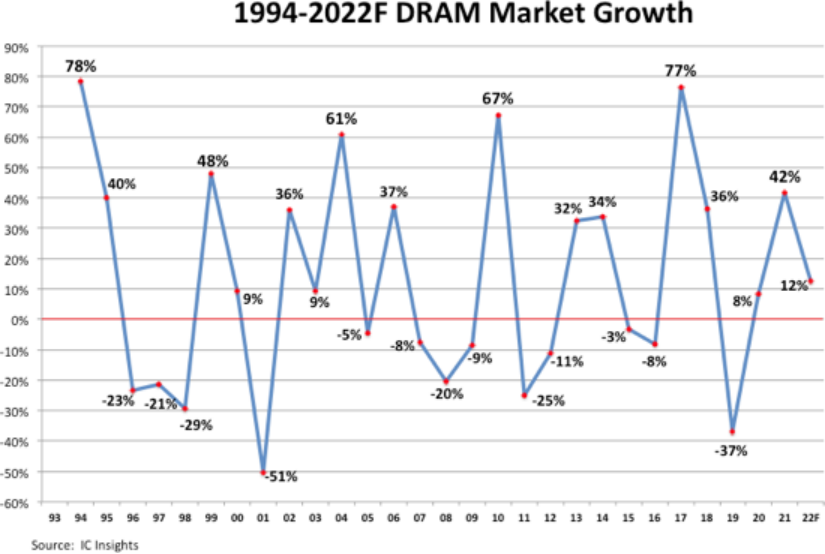

With a 44 percent market share, Samsung remained the world's largest DRAM supplier in 2021, with sales of nearly $41.9 billion, the report said.Last year, Samsung advanced its DRAM business in several ways, including mass production of the EUV-based 14nm DRAM in October 2021, after pioneering ultra-UV (EUV) lithography in March 2020.In the process, Samsung increased the number of EUV layers on its most advanced 14nm DDR5 from two to five-layer DRAM processes.

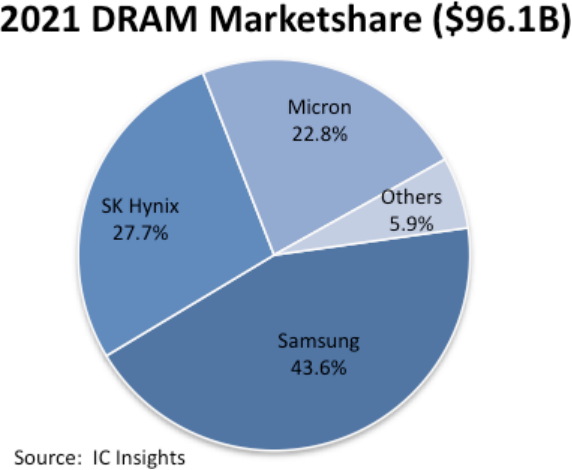
In November 2021, Samsung said it had developed a 14nm 16Gb low-power 5X (LPDDR5X) DRAM for high-speed applications such as 5G, artificial intelligence (AI), machine learning (ML) and other big data applications.The company claims that LPDDR5X DRAM has data processing speeds of up to 8.5Gbps (1.3 times faster than existing 6.4Gbps LPDDR5 devices), saving about 20% of power consumption over LPDDR5 of memory.In addition, the company has released its first DRAM memory module supporting the new computing fast link (Compute Express Link, CXL) interconnection standards, and a 2GB GDDR6 and 2GB DDR4 car DRAM designed for autonomous electric vehicles and high-performance infotainment systems.
SK Hynix ranked second in the 2021 market with a DRAM market share of 28%, with sales of $26.6 billion, up 39%.DRAM accounts for approximately 71% of the company's total semiconductor sales in 2021, with 40% server DRAM; mobile DRAM 35%; PC DRAM 15%, and 5% consumer and graphics card DRAM each.In 2021, SK Hynix released what is said to be the highest-performing DDR5 DRAM in the industry, with a data speed capable of transmitting 163 full HD movies per second.The chip is known as HBM3 because it is Hynix's third generation high bandwidth memory.Like Samsung, SK Hynix has begun using EUV lithography in mass production of 8Gb LPDDR4 DRAM based on the fourth-generation 10nm process (1a nm).
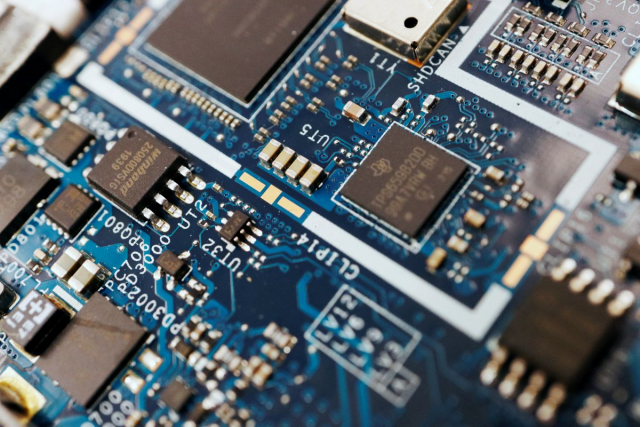
In addition, Micron was the third-largest DRAM supplier in 2021, with DRAM sales up 41% to $21.9 billion, accounting for 23% of the global market share.Overall, DRAM accounts for about 73% of Micron's total annual IC sales of $30 billion.In 2021, Micron launched a 1a nm memory node.The node, driven by a new CPU platform and designed in part to support the transition from data centers to DDR5 DRAM, is expected to begin development later this year and gain growth momentum in 2023.Micron's 1a nm DRAM is also being used in low-power communication applications, including 5G smartphones.Although the process does not require EUV lithography, Micron has ordered EUV equipment and plans to produce DRAM using its 1 gamma (1 g a m m a) nanonode transition to EUV technology from 2024.
Source: 爱集微
wanda
https://x0.ifengimg.com/ucms/2022_22/C6EEB1D21A0EC4BC1862AFA35B827EFBF3CD0497_size798_w641_h427.png
Over the past three decades, the DRAM market has been characterized by a period of phenomenal growth and devastating collapse years, according to IC Insights, in an excerpt from the MacLean Report.In recent years, the DRAM market has fallen by 37%
2022/5/30 14:11:10
2022/5/30 14:11:10
376
0
109
6
Semiconductor inventories rose 11% in the first quarter, exceeding the normal seasonal pattern
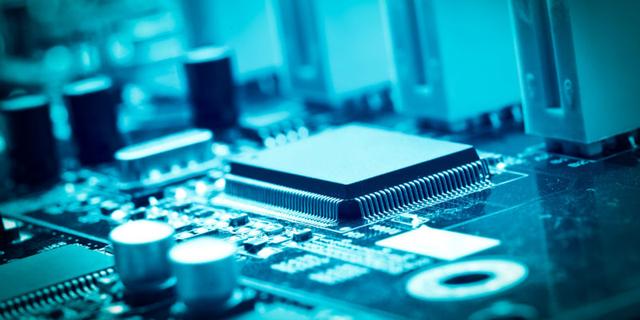
May 24 news, according to the latest report issued by American foreign investors, the current first quarter of the end product inventory increase, considering the weakened consumer demand, and OEM, ODM, O D M and components, semiconductor supplier inventory increase, personal computers, smartphone components and semiconductor shipments in the second half of the focus.
Inventories rose 11% in the first quarter, up from the typical seasonal increase, and inventory days rose to 63 days from 53 days in the previous quarter, the report said.
As for downstream company inventory, including automotive OEM / Tier 1, wireless infrastructure and network OEM, personal PC and mobile OEM / ODM, server and storage, OEM and EMS, inventory grew 10% in Q1 this year, above typical seasonal quarterly growth; inventory was 24% above the 3-year average tracked, while downstream inventory increased from 49 days in Q4 2021 to 58 days in Q1 this year, higher than typical seasonal 51 days.
American foreign investors believe that inventory growth in the first quarter of multiple end markets compared with the fourth quarter of 2021 exceeded the typical seasonal factors; the most obvious gap was PC OEM / ODM, which rose 21% in quarter to quarter and 6% in the typical seasonal growth quarter.
On the other hand, the server OEM / ODM is the only inventory continuous changes lower than the typical seasonal model, the inventory amount increased by 17% quarter on quarter, while the typical seasonal growth of 20%.
If from 2021,2022 Q1, the overall inventory of Q1 industry increased by 24% year on year, higher than the overall sales growth of 5%.From the end market, server OEM / ODM, network OEM, PC OEM / ODM, mobile OEM / ODM and automotive Tier 1 inventory has the fastest annual growth rate.
Foreign investors said the total number of days in Q1 industry stocks has increased from 53 days to 63 days this year.In general, the inventory days in the end market should be consistent or higher than the general or seasonal level, but the network OEM, PC OEM / ODM, server OEM / ODM and automotive Tier 1 are all well above the seasonal level.
Source: technews
wanda
http://www.icsmart.cn/wp-content/uploads/2022/05/1652880883.jpeg
May 24 news, according to the latest report issued by American foreign investors, the current first quarter of the end product inventory increase, considering the weakened consumer demand, and OEM, ODM, O D M and components, semicondu
2022/5/24 17:37:48
2022/5/24 17:37:48
377
0
108
6
Semiconductor cutting storm hit
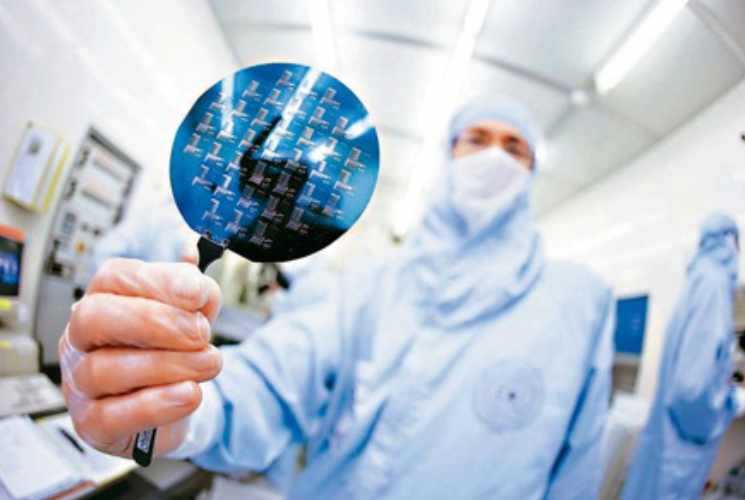
Semiconductor "cut single storm" officially hit, the panel drive IC factory fired the first shot.Due to the weak demand for panel control, prices falling, the industry, has driven IC factories to cut wafer foundry cast volume, as high as 20 to 30%, last year driven IC factories to earn several share capital has become the past; some consumer IC by the mainland sealing and inflation caused by consumption tightening pressure, also afraid to cut orders.
Taiwan, China listed cabinet drive IC factory including Lianyong, Silicon, Duntai, Tianyu, Ruida, related industries on the stage are not willing to talk much about this.Some people privately revealed that the current environment is really not good, "should cut (order) or to cut", in order to control inventory, "do not place so many orders behind".
Before the outbreak, IC was the least reluctant to produce wafer foundry because of the worst foundry prices, mostly only to "fill in capacity".Unexpectedly, the epidemic brought good demand for electricity, monitors, TV and so on, making the driving IC instantly in short supply, become the market popular fried chicken, the price rose constantly, related manufacturers operating scenery, last year generally earned several share capital.
Now the demand boom receded, especially the panel market conditions significantly revised, the price fell down, dragging down the driver IC market conditions "from heaven to earth", making the driver IC factory unprepared.
Some people do not shy about saying, "the tide receded, you know who didn't wear pants", last year, whether the first, second or even third-line drive IC factories rushed to bid up the train, "IC is equal to money", and even caused the problem of wafer foundry repeated orders.
Now the market from gorgeous return to plain, manufacturers no longer have the opportunity to make money, than who is a thick foundation, strong product competitiveness, "the industry has become the past".
Have drive IC related manufacturers said, before in short supply, many orders, but the capacity is limited, order shipment ratio (B / B value) is about 1.7 to 1.8, but now customer demand is not before, can only cut down part of the wafer foundry orders, let molecules and denominator adjustment, so at present order shipment ratio remains around 1.15 to 1.2, if not cut wafer foundry orders, B / B value is less than 1.
A driver IC factory, who declined to be named, said customer orders had not been cancelled but had been deferred, so wafer foundry orders have not been cut.Another driver IC factory is quietly saying that fabs orders will be adjusted according to market conditions.
Drive IC factory out of the semiconductor cut the first shot, industry research, some consumer IC by Chinese mainland sealing and inflation caused by consumption tightening pressure, also afraid to take the stick cut the order.
Some consumer IC designers pointed out that this year, some additional purchase capacity, now the situation has changed, this part will assess the order, leaving capacity for other companies who still need.
wanda
http://s.laoyaoba.com/jwImg/news/2022/05/23/16532580587092.png
Semiconductor "cut single storm" officially hit, the panel drive IC factory fired the first shot.Due to the weak demand for panel control, prices falling, the industry, has driven IC factories to cut wafer foundry cast volume, as high as
2022/5/23 17:22:50
2022/5/23 17:22:50
349
0
107
6
Global semiconductor partial supply and demand reversal: Chinese power is still growing
The sharp change in consumer end demand has also affected the overall supply and demand performance of the semiconductor market this year.
According to Gartner, the global semiconductor market revenue rose 26.3% last year, due to the imbalance between supply and demand, but a larger proportion was due to the price increase of semiconductor devices.With the downturn in the biggest semiconductor demand side, including smartphones, this year, the semiconductor market will be driven mainly by upstream price increases this year, which the agency expects to decline by 2023 and could enter an industry recession in 2024.However, the continued changes in external factors, or may accelerate the arrival of a recession period.
Sheng Linghai, vice president of Gartner Research, told the 21st Century Business Herald that although the overall market, especially in specific areas, the relatively strong —— demand is concentrated in the industrial and automotive sectors.But in fact, since the second half of last year, the semiconductor market has begun to oversupply some products, mainly in communications, mobile phones and other fields.
For the domestic semiconductor industry, in the general market rise, the threshold of domestic Top is also rising, in the global supply system, the domestic semiconductor role still has a large room for growth.
Part of the oversupply
The year 2021 is undoubtedly a bumper harvest year for the semiconductor market. Major chip companies at home and abroad have gained rapid growth in performance, and "repeated new highs" emerge in an endless stream.
However, with the previous production capacity in place, the demand side is tightening, and the external environment continues to change, the semiconductor market may gradually move to the other side of the cycle.
Sheng Linghai analyzed that the growth of the global semiconductor market in 2021 mainly comes from two aspects: the rebound in the demand side, such as cars, smartphones, data centers and other markets; the greater driver comes from the unit price rise, that is, the continuous price growth of many devices due to the supply shortage, such as power devices, network chips and 4G chips.
"So last year's 26.3% growth last year does not mean a surge in semiconductor or consumer electronics consumption, but a large part of a rise in ASP prices.We forecast a 13.6% semiconductor market revenue growth in 2022, but it may not be that big, based on the demand side."He continued that this year, the main driver of semiconductor market growth will remain from unit price growth from some supply shortages.
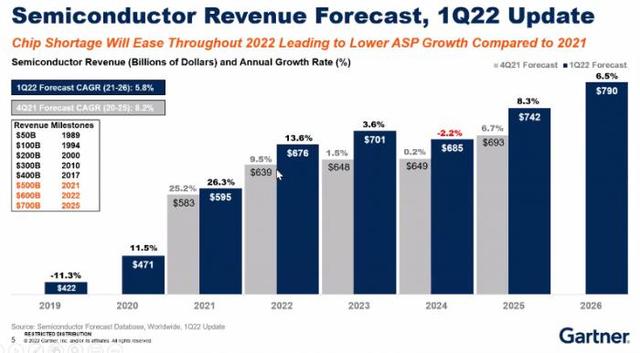
(Global Semiconductor Revenue forecast, updated as of quarter 12022, Source: Gartner)
It is generally believed in the industry that since the second half of 2021, the supply shortage of main chips on the mobile phone end has been significantly eased, and the demand shortage mainly comes from general devices such as MCU and power management chips.
Sheng linghai told reporters that in the first half of last year, some companies have begun to hoard goods to some extent for the supply shortage.This leads to a rise in demand in the short term and drives the price rise, but when the inventory reaches a certain water level, the purchase volume decreases, leading to a subsequent drop in price. ——, that is, the seasonal supply and demand imbalance caused by the supply problem, typically in the memory industry.
"At present, some chips are already overloaded, including the older generation of 5G chips, some RF front-end chips, CIS (image sensor chips), mobile phone memory, mobile phone-related DDI (display driver chips), and some low-threshold consumer chips."He continued, and the demand related to industry applications, industry and automobiles remains strong, from the product categories, including analog chips, MCU, power management and so on are still popular."It should be said that the entire semiconductor market has shifted from structural out of stock to specific areas out of stock.”
Of course, due to the relatively complex supply chain links of the semiconductor industry, the price adjustment still needs time to bring about by the change in supply and demand, leading to the current upstream impulse to rise.
Seek a higher breakthrough
With tight supply and continuous changes in the external environment, the "multi-supplier" strategy has become a common decision for back-end manufacturers.In this context, domestic manufacturers previously difficult to enter the industrial chain also ushered in a round of introduction and development opportunities.
At the same time, domestic manufacturers in the recent years of entrepreneurship and financing wave, have also consolidated or adjusted the boundary of capacity, showing a rapid rise in the performance level.
A decade ago, the revenue threshold for domestic Top10 semiconductor manufacturers was about $200 million, but by 2021, the threshold had risen to nearly $500 million.Under the birth of the market last year, the vast majority of companies grew rapidly.
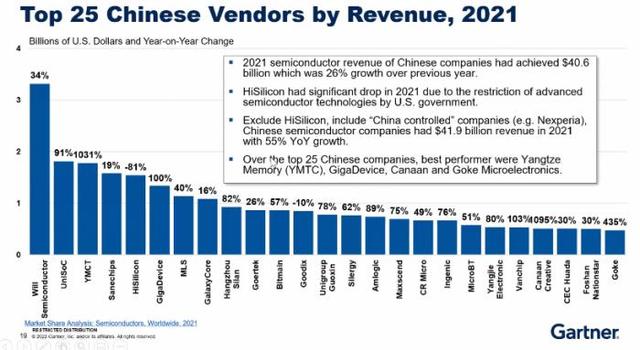
(Top25 revenue for Chinese semiconductor manufacturers in 2021, data source: Gartner)
For example, in the main chip, radio frequency devices, MCU, multimedia chip and other fields, domestic manufacturers have better seized the introduction of development opportunities.However, it should be pointed out that the import is only the first step, and if the subsequent capabilities or services cannot continue to follow up, there is still a risk of being eliminated.
It is also worth paying attention to the market share of domestic manufacturers, at present, there is still a large room for growth.
Gartner believes that occupying more than 10% of the market share means that there is a certain voice or dominance of the industry.Some head manufacturers in domestic vertical fields have achieved a certain position through endogenous development and extension expansion, but overall, not many products occupy more than 10% of the position.
Sheng Linghai introduced, according to statistics, the current domestic share in more than 10% of the field including CIS and LED, NAND Flash (flash memory), analog chips, etc.However, there are more concentrated in the 5% -10% range, including MCU, DDI, AP (power amplifier), etc.In the fields below 5%, GPU, FPGA, DRAM, etc., with higher research and development difficulty and entry threshold. The development of these fields requires not only profound chip itself, but also to build a relatively rich semiconductor industry ecology.
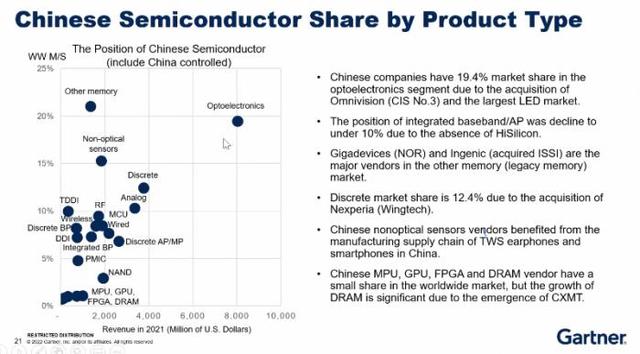
(Market share of Chinese semiconductor companies by product type, data source: Gartner)
He further pointed out, " In the past, domestic manufacturers mainly entered the market at low cost, participate in low-dimensional competition, and now grow to a certain extent, the challenge is to no longer win more markets through the 'following model'."So for domestic semiconductor companies, the first thing to find a way to achieve their own market share of more than 10%, and then consider whether to continue to get more revenue in the market segment, or another track development.
"Domestic semiconductor development opportunities also have something to do with the domestic supply chain.For example, mobile phone communication and consumer electronics, the domestic supply chain has an absolute advantage, then the most opportunity; then I think there is a great opportunity in the automotive and industrial fields, especially the industry has national standards, but cars are relatively in the initial stage."He continued, at present there are many semiconductor companies are actively into the automotive supply chain, but gauge itself threshold is higher, verification and import time is longer, but with oems also actively invest in semiconductor companies, forming the industry linkage, hope to be able to see the development of domestic gauge chip, it also need oems to actively embrace.
For Chiplet (small chip / core particle), which has attracted much attention due to the failure of Moore's Law, Shenglinghai told reporters that the current redefined Chiplet is to connect different high-speed chips and transform the PCIe interface between chips into silicon chip connection mode, but no one can do this at present.
"Advanced packaging does not represent Chiplet. It should be said that Chiplet has a smaller range of definitions than advanced packaging.Generally, if you want to do Chiplet, such as now Apple, Nvidia, AMD, Intel to do a lot of related products, all using advanced technology.However, the domestic can not achieve advanced technology, if TSMC does Chiplet, the cost is still high, the mobile phone chip has not used this technology, the 2.5D package Apple uses is not Chiplet; according to the narrow definition of Chiplet, most applications are still in the high price, high cost applications, such as data center."He analyzed.
Source: 21st Century Economic Daily
wanda
http://www.icsmart.cn/wp-content/uploads/2022/05/1652871165.jpeg
The sharp change in consumer end demand has also affected the overall supply and demand performance of the semiconductor market this year.
According to Gartner, the global semiconductor market revenue rose 26.3% last year, due to the i
2022/5/18 16:36:16
2022/5/18 16:36:16
401
0
106
6
The supply of semiconductor equipment into the vicious cycle of core components has been extended to more than half a year
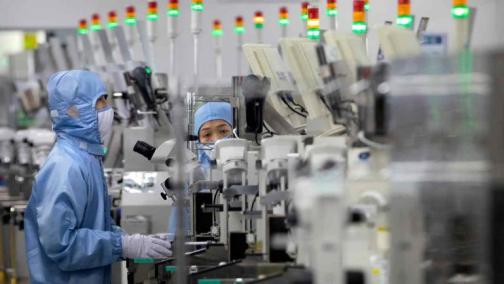
Photo source:AP
With the demand for semiconductor equipment, the supply of components has been a bottleneck.The delivery time of advanced parts required for semiconductor manufacturing equipment is more than twice longer than usual.The supply of equipment has entered a vicious circle due to the price of rising raw materials and a shortage of equipment semiconductors.
According to ETNews, delivery times for core parts were extended from the usual two to three months to more than six months.Delivery times for advanced parts such as the United States, Japan and Germany have also increased significantly.Products facing bottleneck effects include advanced sensors, precision thermometers, MCU for management equipment, and power line communication (PLC) equipment.Some components, such as PLC equipment, were delayed by more than 12 months.
A person from semiconductor equipment manufacturers said: " Although orders were placed last year, semiconductor equipment manufacturers that did not ensure their inventory encountered difficulties in producing equipment.As the delivery time of the accessories is extended, the delivery date of the equipment is also delayed.”
Manufacturers of test equipment imported from the United States tried to buy parts locally, but failed because of insufficient inventory.With the rising prices of semiconductor raw materials such as aluminum and steel, semiconductor companies have encountered difficulties in ensuring semiconductor accessories and casting accessories.
The shortage of semiconductor equipment components is due to a surge in demand.Orders for semiconductor equipment have surged as global semiconductor companies have invested heavily to address shortshortage for semiconductor equipment.In some cases, the past equipment delivery time of only a few months has exceeded two years.As the equipment industry rapidly increases production in response to surging demand, entire parts stocks have run out.Overseas parts manufacturers have not greatly improved their production capacity, which is also one of the reasons for short supply.Semiconductor equipment companies are responsive to equipment investment and begin to rapidly expand production capacity; however, component manufacturers are slow to respond.
A semiconductor industry official said: " Semiconductor equipment companies can easily improve production capacity, but component companies need to do a lot to build new infrastructure.Because of the heavy large-scale equipment investment burden, parts enterprises have encountered bottlenecks.”
Local semiconductor equipment companies, including South Korea, are also facing delayed delivery priorities.In other words, major overseas parts enterprises will first supply to the application semiconductor, ASML, TEL, Lam Research and other top semiconductor equipment enterprises.Local South Korean semiconductor equipment manufacturers, which had relatively low sales, received fewer parts.
The global shortage of semiconductor supplies is expected to worsen as production of —— manufacturing equipment, a core element of semiconductor production.With the delayed delivery date of semiconductor equipment under inventory, the equipment investment cycle of semiconductor manufacturers will inevitably slow down.
wanda
http://s.laoyaoba.com/jwImg/news/2022/05/17/16527583387983.png
Photo source:AP
With the demand for semiconductor equipment, the supply of components has been a bottleneck.The delivery time of advanced parts required for semiconductor manufacturing equipment is more than twice longer than u
2022/5/17 16:28:56
2022/5/17 16:28:56
610
0
105
6
Outages continue to raise their global semiconductor revenue forecasts this year
Gartner, an international electronic business agency, has updated its total global semiconductor revenue forecast for 2022.The agency expects total global semiconductor revenue to reach $676 bn in 2022, up 13.6 per cent from 2021.The latest forecast was revised from its previous quarter forecast, up $37 billion.

According to Evertiq, Gartner, vice President of research Alan Priestley, said, " in 2022, the semiconductor average selling price (ASP) will continue to become the main driver of global semiconductor market growth, but is expected to 2022, the overall supply of semiconductor components will gradually ease, with the improvement of inventory, prices will be stable.”

Chip shortages will continue to be one of the concerns in the electronics supply chain in 2022 and will have different impacts on major electronics device markets depending on different semiconductor device types.
As production enters a slow season and has increased semiconductor supply in the market, most semiconductor shortages in personal computers and smartphones have eased.However, by the end of 2022, some semiconductor devices will continue to be in a shortage in the automotive supply chain.Until 2023, automotive applications will continue to face component supply restrictions, especially in terms of microcontrollers (MCU), power management chips (PMIC) and voltage regulators.
Priestley said: " While unit vehicle production will grow 12.5% in 2022, A S P is expected to remain high after double-digit (19%) growth in 2022."" During the forecast period, automotive high-performance computing, EV / HEV and advanced driver assistance systems will lead the growth of the automotive electronics industry.”
The memory market will remain the largest segment during the forecast period, being expected to account for 31.4% of the entire semiconductor market in 2022.DRAM and NAND are expected to be undersupply in the second quarter of 2022.The NAND market will begin to experience oversupply in the fourth quarter of 2022, and the DRAM market will begin to experience oversupply in the second half of 2023.Second shipments and a higher annual average ASP will maintain revenue growth in 2022, with DRAM expected to grow 22.8% and NAND expected to grow 38.1%.
Smartphone semiconductor revenue is expected to grow 15.2% in 2022, while 5G smartphone production will grow 45.3% to 808 million units, accounting for 55% of all smartphone production.The massive migration of major smartphone chipset suppliers from 4G to 5G has led to a temporary shortage of 4G SoC baseband IC starting from the second half of 2021.The increase in 5G baseband IC inventory will lead to a drop in the prices of 5G smartphones and further accelerate 5G penetration during the forecast period.
wanda
/include/upload/kind/image/20220510/20220510173828_9628.jpg
With the production into the slow season, the recent analysts gave the chip shortage of optimism, but from the chip manufacturing equipment chip shortage caused by the delivery delay news, in the short term, the chip shortage will continue to become one of the concerns of the electronic equipment supply chain in 2022.The market adjustment agency recently raised its 2022 global semiconductor revenue forecast...
2022/5/10 17:40:50
2022/5/10 17:40:50
362
0
104
6
Global first | crystal feng mingyuan domestic 10 phase digital control power management chip BPD93010
With the development of informatization, the Internet age, 5G, artificial intelligence, metaverse, cloud computing and autonomous driving applications, the core processor CPU, GPU, AI computing power requirements is higher and higher, the core processor current demand as high as 1000A, above, high watt number, high efficiency, high density, high frequency of DCDC multiphase power management chip demand rose sharply.
In the field of domestic high-end D C D D power management chip, foreign enterprises with difficult technical barriers, dominated the huge domestic high-end computing market, 10 phase digital control power management chip BPD93010, born, successfully applied in CPU, GPU, AI and other high-power computing chip, can be widely used in PC, server, data center, base station, automatic driving tuyere industry.
BPD93010, supports native 1~10 phase Buck controller, digital control, small package (QFN 5 * 5), in the computing field of high current and high power to seize the localization of power management chip opportunity.In China, it has realized a leap from single phase to multi-phase, from analog control to digital control. Large current technology has now reached the order of 1000A, taking the "pearl" in the crown of DCDC field.

BPD93010 Demo Board
BPD93010, the strong product advantages are:
More intelligent: one key touch, along with the "core" and move!Supporting GUI software, digital control, simple operation, make the application experience more intelligent; powerful Monitor function, always detect and record the chip working status.
More flexible: Many key functions can be achieved both by replacing peripheral R / C devices and by changing some digital configurations; the work interface supports custom settings for more flexible application possibilities.
More powerful: The same control chip can support not only the traditional DCR power detection, meet the low-cost separation solution, but also support a more concise and efficient DrMOS power level scheme.
More stable: digital control mode, automatic loop compensation function, accelerate the transient response ability, enhance the stability of the system.
More secure: with editable UVLO / OTP / O T P / OCP / UVP / OVP / VINOVP / VINUVP.
Cheaper: fewer peripheral R / C electronic component configurations that save more BOM costs and enhance the power density of the system.
Multi-function: support PMBUS / I2C and other voltage control protocols; Unique Multi CFG Detection features, Just change the resistance value of some peripheral resistors, Can solve the complex problem of digital chip material number control; unique Fault Monitors function, A mere simple measurement of the voltage values of certain Pin feet is required, Can assist to judge the working status of the chip, Greatly convenient for the engineer Debug; The Auto Phase Shedding function automatically adjusts the phase number of the controller according to the size of the load; The Interleaving + function can modulate the PWM phase, Helps to reduce the input ripple, Reduce the amount of input capacitance, etc.

Jingfeng Mingyuan DCDC, a strong team of more than 100 top elites in the industry, builds a complete industrial chain of research and development, operation and sales, with digital control IP, high current design IP, BCD process, packaging and other core technologies.High standard reliability laboratory, with a variety of high temperature aging, high acceleration stress, temperature cycle and other reliability identification and reliability monitoring capabilities, each mass production product, has been rigorously tested, to ensure the stability and reliability of the products.Jingfeng Mingyuan DCDC aims to catch up with the technical advantages of international giants and become the blockbuster player of computing power supply.
wanda
http://uploadimg2.moore.ren/images/news/2022-05-05/100226.jpg
With the development of informatization, the Internet age, 5G, artificial intelligence, metaverse, cloud computing and autonomous driving applications, the core processor CPU, GPU, AI computing power requirements is higher and higher, the core processor current demand as high as 1000A, above, high watt number, high efficiency, high density, high frequency of DCDC multiphase power management chip demand rose sharply.
2022/5/6 9:37:28
2022/5/6 9:37:28
441
0
103
6
IC onboard Xinxing Kunshan two factories, gradually resumed production yesterday
Wechat news, IC board factory Xinxing announced 28, Kunshan Dingxin Electronics Co., Ltd. and Xinxing Tongtai Technology (Kunshan) Co., Ltd., with the local government epidemic prevention policy, from April 21 to April 27, from April 28 can be closed loop gradually resume production.
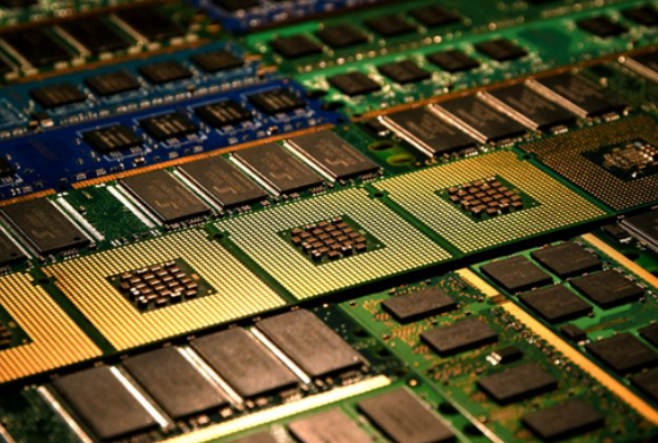
Xin xing said the company and its subsidiaries will closely observe the subsequent development of the epidemic and cooperate with local government regulations to take contingency measures to ensure the safety and health of employees.
As the outbreak in Kunshan improves, local factories are gradually resuming production.Guo Ming, an analyst at Tianfeng International, also said Tuesday that the Kunshan plant will resume production as early as this week, assuming the epidemic situation in Kunshan continues to improve.Based on the component situation, phase I capacity is expected to recover by 40 to 60 percent, he said.
Kunshan, as a heavyweight production settlement in China, is also a gathering place for Taiwan businessmen, commonly known as "Little Taipei". From PCB, panels, institutional components to OEM assembly plants, heavyweight suppliers have set up factories.
wanda
https://n.sinaimg.cn/spider20220428/301/w658h443/20220428/36c9-84e165724a41b381ee9d70e03a96c97c.png
Wechat news, IC board factory Xinxing announced 28, Kunshan Dingxin Electronics Co., Ltd. and Xinxing Tongtai Technology (Kunshan) Co., Ltd., with the local government epidemic prevention policy, from April 21 to April 27, from April 28 can be closed loop gradually resume production.
2022/4/29 10:07:56
2022/4/29 10:07:56
516
0
102
6
Smic responds to Shanghai chip factory production: has been closed-loop management
Shanghai has been closed for nearly a month, and a number of chip factories have also been affected. SMIC recently responded to the latest situation of the Shanghai chip factory, saying that production and operation are normal and employees have entered closed-loop management.
According to the China Securities Journal, SMIC said it began to implement closed-loop management on March 18, realizing the synchronous and integrated closed-loop management in the Zhangjiang factory and the two life parks. The total number of employees in the closed-loop accounts for more than 60 percent of Shanghai employees, effectively ensuring the stable operation during the epidemic.
At present, the company's production and operation are normal, and the capacity utilization rate remains at a high level.
According to SMIC, the executives and employees in the closed loop of the company actively joined the volunteer team, while ensuring production, organized nucleic acid testing, maintaining bus order and garbage transportation, including the factory and living areas, ensuring the normal operation of the company and the community during the epidemic.
After Shanghai issued relevant guidelines on the resumption of work and production, SMIC actively sorted out the returning personnel, handled relevant procedures for employees outside the closed loop, and arranged employees to take shuttle buses back to work.At present, some external closed-loop external employees have successively entered the closed-loop management.
On the evening of March 8, SMIC issued an announcement in A shares and Hong Kong shares, reporting the performance of January to February 2022, revenue rose 59% and profit rose 95%, achieving a good start in 2022, which is the first time SMIC released monthly revenue data.
The announcement showed that from January to February 2022, according to the preliminary accounting of SMIC IC Co., Ltd., the total operating revenue in the first two months was about $1.223 billion, up 59.1% year on year; the net profit attributable to shareholders of the company was about $309 million, up 94.9% year on year.

wanda
https://img1.mydrivers.com/img/20220427/29cdc02a-ca71-4a38-8cec-82c541fd6d0c.jpg
Shanghai has been closed for nearly a month, and a number of chip factories have also been affected. SMIC recently responded to the latest situation of the Shanghai chip factory, saying that production and operation are normal and employees have entered closed-loop management.
2022/4/28 14:34:43
2022/4/28 14:34:43
361
0
100
6
New capacity at China's six 8-inch fabs will be released this year
On April 26, since the outbreak of 2020 global shortage core tide, the Chinese wafer manufacturers have 17 are expanding, production capacity has gradually began to release, but the expansion mainly with 12 inch wafer capacity, 8 inch wafer capacity only smic (Tianjin), sea Chen semiconductor, Shaoxing SMIC, Ningbo SMIC, micro (Hangzhou) and byd semiconductor six manufacturers in expansion, from the point of capacity time, new capacity will be released in 2022.
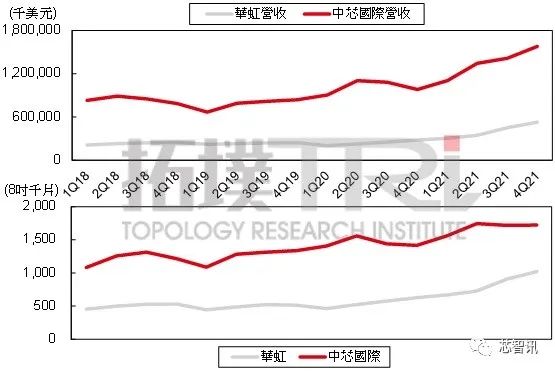
▲ SMIC and Huahong Semiconductor revenue and wafer sales from 2018 to 2021.(Source: Financial report; organized by Extension Industrial Research Institute, 2022.4)
From the demand side, driven by the 5G industry chain (mobile phones, base stations), data centers, online office and new energy vehicles, the demand for 8-inch wafers will continue to be strong, especially the penetration of new energy vehicles will rise rapidly driven by the policy, and the demand for power semiconductors will also be greatly increased, which will significantly increase the demand for 8-inch wafers.
Due to equipment constraints, 8-inch wafer capacity expansion relative to 12-inch wafer slow, causing some manufacturers to power management IC products from 8 inches to 12 inches, but the technical difficulty is relatively increased, the cost increases, so this change is not common; in addition, the power semiconductor need high reliability, and the supply chain is fixed, so 8-inch wafer still have this powerful end market.
wanda
https://n.sinaimg.cn/sinakd20220426s/245/w640h405/20220426/7c8d-5092c19a78867ed12690a3d88d4f727c.jpg
On April 26, since the outbreak of 2020 global shortage core tide, the Chinese wafer manufacturers have 17 are expanding, production capacity has gradually began to release, but the expansion mainly with 12 inch wafer capacity, 8 inch wafer capacity only smic (Tianjin), sea Chen semiconductor, Shaoxing SMIC, Ningbo SMIC, micro (Hangzhou) and byd semiconductor six manufacturers in expansion, from the point of capacity time, new capacity will be released in 2022.
2022/4/27 14:09:38
2022/4/27 14:09:38
333
0
99
6
Foreign media: As a traditional product type in the industry, ASIC is currently dominated by two types of fabless companies
Micro network news, recently the world famous semiconductor community semiwiki published the world core Electronics (Alchip) on ASIC technology research report.According to the report, ASIC was the foundation of the semiconductor industry until the IDM model flourished in the 1980s and 1990s.During this transition period, many semiconductor companies adopted ASIC production mode, which design and manufacture chips for other system companies such as IBM, NEC, Toshiba, and some specialized ASIC companies like VLSI Technology and LSI Logic, which also own their own fab.

Photo source: Network
Fabless has reversed the current situation, and the ASIC market is currently dominated by fabless-type companies.Today, the ASIC business is divided into two categories: ASIC-based fabless (GUC, Faraday, Core, Sondrel, Core, Alphawave, SemiFive, eInfochips, etc.) and other chip companies that are also designing ASIC (Broadcom, Marvell, Mediatek, etc.).Broadcom owns former Avago ASIC business; Marvell acquired ASIC business for eSilicon and Core / IBM; Mediatek develops its ASIC business.
Why is the surge in ASIC business?The reason is the same as why EDA, IP and TSMC thrive.All industries are developing their own ASIC.
World Core (Alchip) released more convincing data, the company's revenue (88%) from 16nm to 5nm FinFET process design, including sophisticated advanced packaging technologies (CoWoS and MCM).
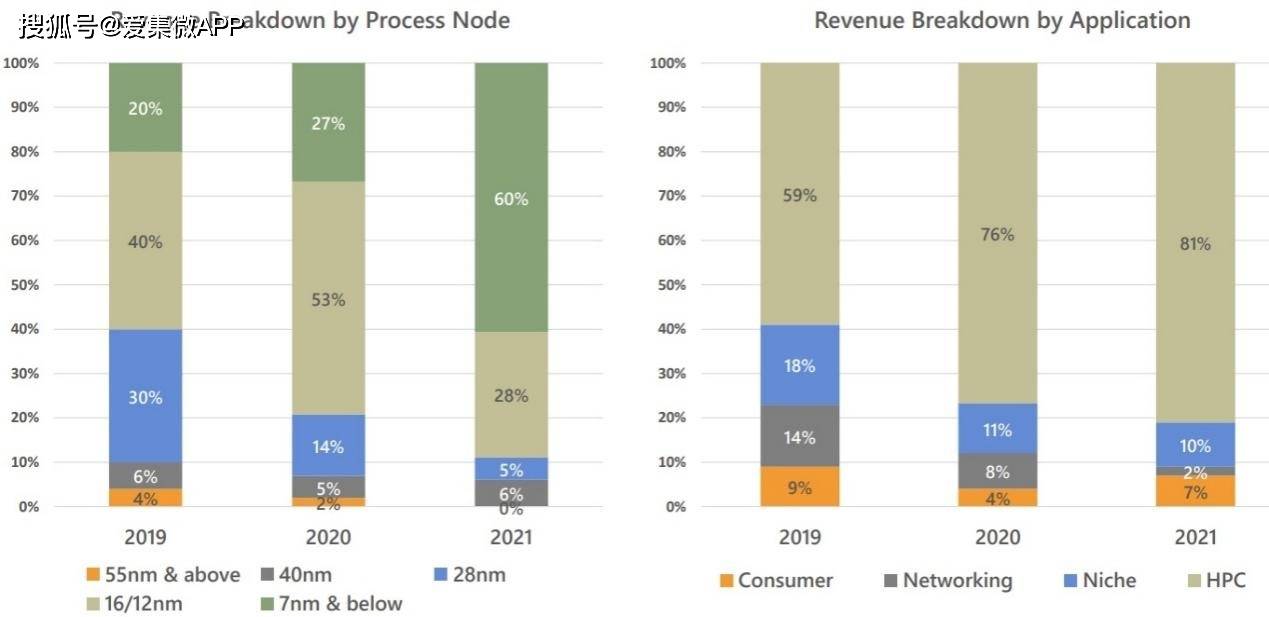
Figure source: Alchip
Johnny Shen, president and CEO of Alchip, expects strong demand for AI, high-performance computing and the Internet of Things in 2022.He also noted that a large number of advanced AI equipment will enter mass production in 2021.In short, the ASIC business is the oldest process in the semiconductor industry, and its development process has been very low-key.
wanda
/include/upload/kind/image/20220426/20220426104652_2619.png
Recently, semiwiki, the world famous semiconductor community, published the world core Electronics (Alchip) research report on ASIC technology.
2022/4/26 10:47:54
2022/4/26 10:47:54
415
0
98
6
Industrial chain: Chip shortage remains a major challenge for automakers this year, and the development of electric vehicles is also uncertain
According to foreign media reports, the global auto chip shortage that began at the beginning of last year will remain a major challenge for automakers this year.

In addition, the industrial chain news also showed that the global shortage of automotive chips is exacerbated by some factors, rising crude oil prices and rising battery materials prices have also brought variables to the development of global electric vehicles.
In the report, foreign media also mentioned that in the past few years, the global auto industry has been affected by the epidemic, chip shortage and other factors. Car sales in the US, a major global market, fell by nearly 15% in 2020, while global sales fell to 77.97 million units.
While global car sales picked up to 85 million last year, it is difficult to return to pre-pandemic levels due to continued chip shortages and other new factors.
According to the news from the automakers, the chip shortages that affected them last year are still affecting their production and sales this year.Earlier this week, Toyota announced on its website that nine of its 14 factories in Japan would be production in May, involving 10 production lines, due to chip shortages.
wanda
http://news.eccn.com/uploads/news/202204/20220424095210652.jpg
According to foreign media reports, the global auto chip shortage that began at the beginning of last year will remain a major challenge for automakers this year.
2022/4/25 11:14:18
2022/4/25 11:14:18
327
0
97
6
Domestic sealing control cut off the supply chain Anson American car chip fired the first gun
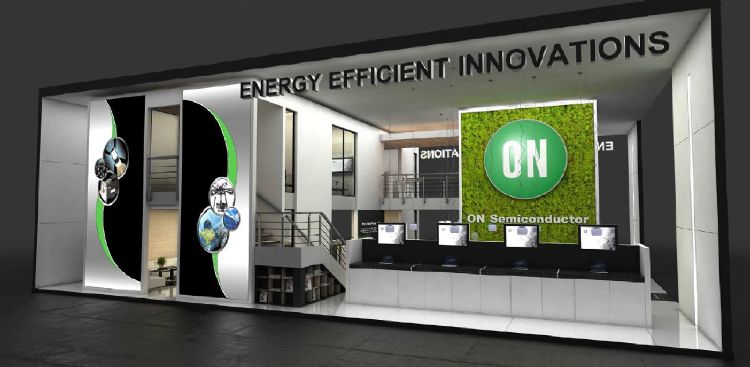
Anson Mei (onsemi), an international automotive chip manufacturer, sent a letter on April 20 that its global distribution centers were forced to close due to the epidemic in Shanghai, which will continue to affect production and shipments.
Supply chain industry said that the goods can not go, storage is difficult to take goods, especially PCB production, plus other domestic provinces and cities have also been closed control, the chain situation has increased, the shortage of goods may quickly emerge.
Anson beauty pointed out that as the domestic government strengthened the closure, especially in Shanghai, Anson beauty domestic global distribution centers were forced to close and affect the business, also did not receive any notice of lifting the closure.In addition to the closure of Shenzhen, Suzhou and Leshan, smaller cities have also begun to impose closures or strengthen restrictions on access to cities, particularly affecting external manufacturing locations.Anson will closely monitor the impact of supply disruptions of materials, equipment and services at home.
In addition to trying its best to deliver products quickly, it has also started moving to other Anson American subdivisions to ease capacity constraints, such as Singapore and Manila in the Philippines, relocating alternative warehouses and accelerating transportation, but is still unable to transport enough materials to meet all customers.
Supply chain companies point out that Anson Mei's situation may only be the tip of the iceberg in the domestic auto supply chain.Seal control seriously affects the smooth flow of transportation logistics, at present, the goods can not enter, even if there is storage is difficult to get the goods, not only vehicle chips, PCB are also stopped production, some car parts are also stuck in the middle of transportation.
In 2021, the automobile market is short because the chip capacity is not below the demand growth rate. At present, even if the materials are blocked, the supply situation is worse.Even if the Shanghai municipal government announces a white list of production available, a number of automakers and international OEM (Tier 1), including Tesla and Volkswagen (VW).
However, the supply chain operators reiterated that the key is still in the domestic transportation agents and Shanghai customs, otherwise these named whitelist companies will still be in the dilemma of cooking without rice.Many companies are even worried about the risk of the outbreak at the factory and are reluctant to start work.
With domestic closures starting in late March, the market is expected that the auto industry will be significantly hit in the second quarter.Of course, supply chain companies are more worried about whether even if automakers are currently full of orders, consumers' purchasing power or willingness to buy cars will be hit by containment, inflation and international wars.
wanda
http://img.icspec.com/article/64d8683f-c130-11ec-8c95-b8ca3a6cb5c4.jpg
Domestic expansion of sealing control, automotive chip into the chain crisis
2022/4/22 13:37:16
2022/4/22 13:37:16
503
0
96
6
Anson Beauty Semiconductor Emergency notice: China's global distribution center was forced to close due to the outbreak in Shanghai
'As the government strengthens closure measures, especially in Shanghai, the closing of our global distribution centers in China has affecting the business.The collection of micro network confirmed, the news is true.
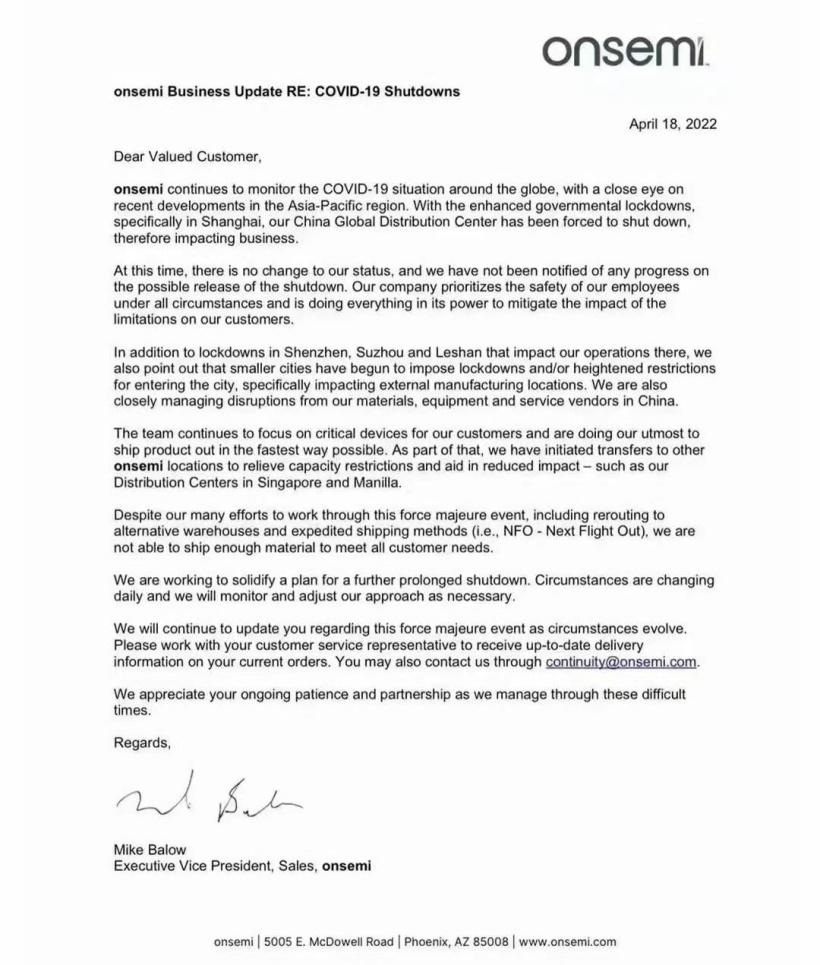
Here are some translations of the notification letter:
The onsemi continues to monitor global COVID-19 and closely monitor the latest developments in the Asia-Pacific region.As the government strengthens the containment measures, especially in Shanghai, our Chinese global distribution centers are forced to close, thus affecting the business.
At present, there is no change in our situation, and we have not received any notice of the progress that may lift the closure.Our company prioritizes the safety of its employees in any case and does its best to mitigate the impact of closure on our customers.
In addition to the closures of Shenzhen, Suzhou and Leshan affecting our local operations, we also note that smaller cities have begun to implement closures or strengthen restrictions on access to cities, particularly affecting external manufacturing locations.We are also responding closely to the disruptions of our materials, equipment and service suppliers in China.
The relevant team will continue to focus on providing key equipment to our customers and do our best to deliver products in the quickest possible way.In addition to that, we have started moving to other onsemi subdivisions to ease capacity constraints and help reduce the impact on ——, such as our distribution centers in Singapore and Manila, Philippines.
Despite many efforts to address this force majeure event, including relocating to alternative warehouses and accelerating transportation (i. e. NFO-Next Flight Out expedited Air Service), we were unable to transport sufficient materials to meet the needs of all our customers.
We are working to consolidate plans to further extend the closure period.Things are changing day to day and we will monitor and adapt our approach as needed.
It is reported that it is one of the world's largest suppliers of analog IC, logic IC and discrete semiconductor components.
In the past month, due to the strict prevention and control of the epidemic, many important manufacturers have closed their factories and encountered transportation obstacles, which gradually began to affect the global supply chain.On April 15, the Ministry of Industry and Information Technology has sent a Shanghai front working group to take multiple measures to support the stable production of key enterprises in Shanghai.
wanda
https://x0.ifengimg.com/res/2022/AB0514BC21BDEE74E9DF0F4CA5902021726E994C_size192_w820_h965.jpeg
Anson mei issued a notice letter on April 18, saying that as the government strengthened the closure measures, especially in Shanghai, our Chinese global distribution center was forced to close, thus affecting the business.
2022/4/21 13:57:39
2022/4/21 13:57:39
361
0
95
6
Shanghai Automobile Group responded to the start of the resumption of work and production stress test: make good preparations
April 15 news, today it is news that SAIC began to prepare for the resumption of work and production matters.SAIC responded to the Securities Times, "Regarding time, there are internal goals, but it will be adjusted according to the epidemic control situation and their own preparations." "Now first cooperate with the epidemic prevention according to the requirements of the government, maintain and transform the equipment, and make careful preparations for production under the epidemic prevention conditions."
IT Home learned that Shanghai Automobile Group Co., LTD. (hereinafter referred to as "SAIC") is the largest automobile listed automobile company in the domestic A-share market, including passenger car companies, SAIC Datong, SAIC Volkswagen, SAIC-GM, SAIC-GM-Wuling, Nanjing Iveco, SAIC Iveco Hongyan, Shanghai Shenwo, etc.
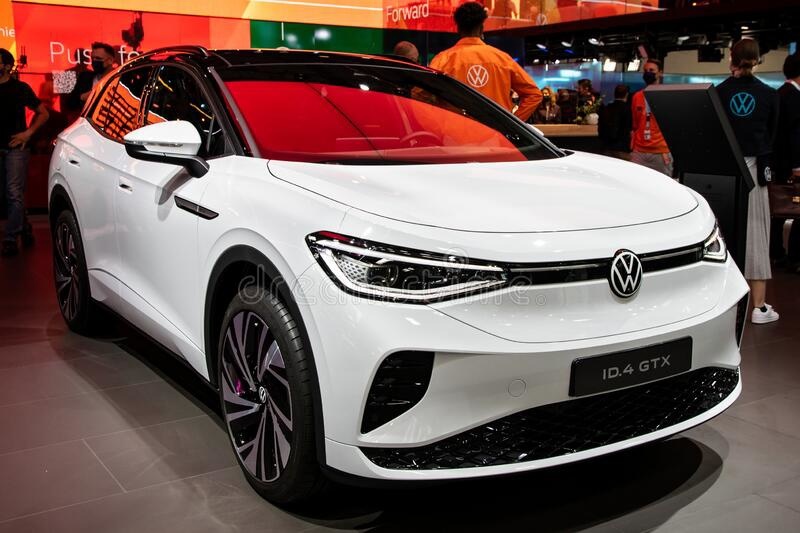
The current epidemic situation in Shanghai is still not optimistic.The Shanghai Municipal Health Commission announced this morning (April 15) that 3,200 new confirmed local COVID-19 cases and 19,872 asymptomatic infections occurred from 0:00 on April 14,2022.
Before the full closure of Shanghai, SAIC had declared to enter the "white list" of enterprises to start work and resume production in advance.When the company and the independent area of the work and factory, the abnormal and infected personnel are cleared and meet the conditions for no new positive cases for 7 consecutive days, the resumption of work can start.After entering the factory, the staff will immediately accept the 3-day silent period management (managed separately from the original resident personnel). During this period, the nucleic acid or antigen test is negative daily before returning to work.
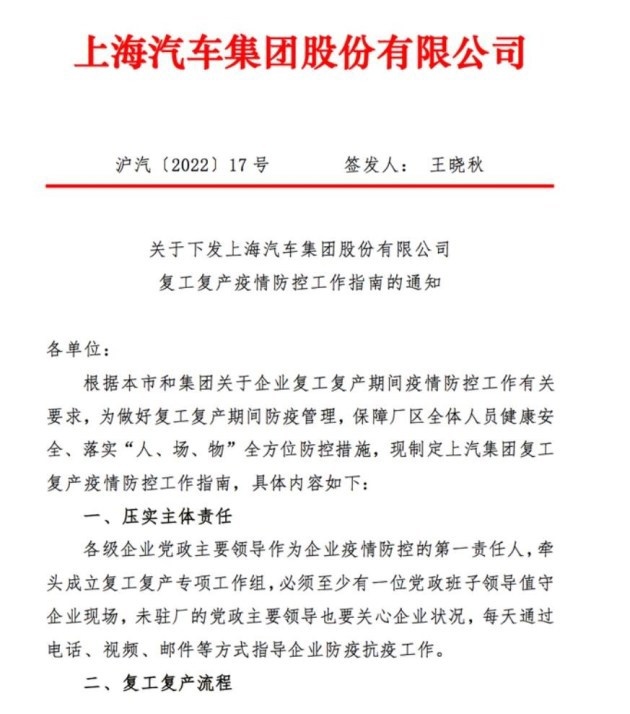
SAIC Motor is said to have issued a notice on issuing the epidemic prevention and control guidelines of Shanghai Automobile Group Corporation for resuming work and production today.According to the notice, enterprises should actively carry out stress tests in accordance with the guidelines for the resumption of work and production.Once the stress test goes well, the enterprise will arrange the production of the whole vehicle and parts as soon as possible.
In addition, the notice also mentioned that SAIC manufacturers will prepare for the resumption of work and production, the results will be feedback before April 17 (Sunday), and the production enterprises will start the resumption of work and production on April 18 (Monday).
All production enterprises shall carry out stress tests in five aspects: personnel guarantee, supply chain guarantee, logistics guarantee, closed production management and epidemic prevention measures, and timely report the results and problems of stress tests.Arrange the production of vehicles and parts as soon as possible for the enterprises with smooth stress test.
At the supply chain level, SAIC will cooperate with its partners to fully promote the gradual resumption of work and production.In the document, SAIC will ask suppliers in advance to resume work, and timely determine the resumption capacity of supporting suppliers at all levels.
wanda
https://x0.ifengimg.com/ucms/2022_16/14AFD0B5094AC3A6C6A8A59D64A97C5450659834_size128_w800_h533.jpg
April 15 news, today it is news that SAIC began to prepare for the resumption of work and production matters.SAIC responded to the Securities Times, "Regarding time, there are internal goals, but it will be adjusted according to the epidemic contro
2022/4/18 13:32:33
2022/4/18 13:32:33
333
0
46
6
Qualcomm Strives to Advance 5G Lead
SAN JOSE, Calif. — New chips coming from Qualcomm and a startup rival show that there’s plenty of work yet to do to make 5G networks live up to their hype.
For handsets, Qualcomm announced a more integrated 5G modem, an optimized RF front-end (RFFE) module for millimeter-wave bands, and a handful of supporting parts. Startup Movandi said that it is also working on a mmWave front end for handsets and announced a device to optimize 5G links across many use cases.
The chips come at a time when operators say that they are still in the early phase of a slow buildout of 5G networks. Work on mmWave signals is the most challenging aspect of the work.
“Just two to three years ago, there was so much skepticism about mmWave,” said Maryam Rofougaran, a serial entrepreneur and co-founder of Movandi. “From early trials, [operators] realized it can work, but they are not getting all they would like. There is room for improvement, especially to deploy 5G cheaply in a wide variety of places.”
The startup is mainly focused on infrastructure gear such as base stations and home receivers. That said, it has taped out a version of its RFFE for smartphones. “Realistically, the market [for 5G mmWave handsets] is not ready for meaningful volumes until 2020 or 2021,” said Rofougaran.
Qualcomm showed first-generation 5G smartphones and home gateways in December using its X50 modem and mmWave module. Today, it announced updates of both products.
The X55 is the company’s first baseband to support all key 5G features, including standalone (SA) and non-standalone operation as well as both FDD and TDD techniques. It also supports LTE and legacy cellular links. The X50 did not support SA or FDD or LTE.
Over 5G networks, the X55 delivers up to 7 Gbits/s down and 3 Gbits/s up. Over Category 22 LTE, it hits up to 2.5 Gbits/s. The 7-nm chip is sampling now and also supports 100-MHz envelope tracking and adaptive antenna tuning for 5G sub-6-GHz nets.

The QTM is thinner than 8 mm, and the X55 handles both 5G and LTE. (Image: Qualcomm)
The X55 is likely the second of three 5G chips that Qualcomm will release within 12 months in its efforts to lead the field. Analysts expect that Qualcomm will release early next year an integrated apps processor with a 5G modem.
The X50 targets premium smartphones — typically paired with a Snapdragon 855 that sports an integrated LTE modem — and snagged more than 30 design wins, Qualcomm claims. The first handsets using the X50 are expected to emerge at Mobile World Congress later this month. Handsets using the X55 will be available before the end of the year, Qualcomm said.
Given that supports LTE and 5G, the X55 is Qualcomm’s first 5G modem suitable for embedded devices. It can also be used in China where operators are expected to start services with SA, skipping the non-standalone mode that uses LTE as a control network.
In addition, Qualcomm announced the QTM525, a new version of its mmWave RFFE module. It is longer but thinner than the company’s first module and adds support for 26-GHz bands to the prior part’s support for 28 and 39 GHz.
The company is using the shift to 5G to expand its related business in RF in the face of rivals such as Broadcom, Qorvo, and Skyworks who are initially targeting sub-6-GHz 5G handsets. Qualcomm also announced the QET6100, a 100-MHz envelope tracker solution, the QAT3555 5G adaptive antenna tuner, and a family of integrated 5G/4G power amplifier and diversity modules.
Startup preps active repeater for 5G mmWave
Next week’s Mobile World Congress will probably be the first opportunity to gauge how much of a lead Qualcomm has in 5G. Several handsets using its X50 modem are expected to emerge along with whatever giants Huawei and Samsung may have planned using their own chips.
Intel announced recently that it plans a 5G chip for base stations called Snow Ridge. The chip, along with Intel’s delayed 5G baseband for handsets, the XMN 8165, will ship in the second half of the year. Mediatek is said to have also delayed release of its first 5G modem.
Huawei and Samsung are said to also be aggressively working on their own cellular RF front ends. However, they would be unlikely to announce such parts given that they would be focused on use only in their own handsets.
Qualcomm’s early move to mmWave potentially disrupts RF rivals such as Broadcom, Qorvo, and Skyworks even though it also challenged end users such as AT&T and Verizon. The mmWave bands also provide bandwidth to deliver the highest data rates — a traditional selling point — albeit at shorter distances.
“RFFE modules will completely change with mmWave,” said Rofougaran of Movandi.
The startup announced in mid-2017 its BeamX modules for base stations and other gear. The relatively large components have been tested by operators and OEMs but are not yet ready for deployment, and Movandi listed no customers for them in a press statement.
Meanwhile, “we have been engaged with a couple of critical mobile [handset] vendors and we have a good understanding of what’s needed and taped out a chip that addresses their size and power [requirements], and it’s better than what I’ve seen out there,” she said, in an oblique reference to the Qualcomm module.
Movandi’s next step is a kind of advanced active repeater that helps complete mmWave links. The BeamXR uses some new algorithms and more digital processing to overcome 5G mmWave challenges getting signals around buildings, through trees, or otherwise dealing with a lack of line of sight.
The BeamXR aims to fill in coverage or boost capacity for operators without adding the thousands of dollars to buy and deploy another small-cell base station. Its potential use includes residences with fixed-wireless access as well as indoor access for multiple handset users in cafes, malls, or offices.
The product is sampling in a prototype form now supporting 28 and 39 GHz. A next-generation version also will support 24- and 26-GHz bands. The startup hopes to have versions for commercial use in production before the end of the year.
NXP said it will work with Movandi, pairing its Layerscape SoCs and 5G modems with the startups mmwave front-end for applications such as smart homes, self-driving cars and future mobile cloud-based services.
xinhan
/include/upload/kind/image/20190228/20190228114503_9724.png
New chips coming from Qualcomm and a startup rival show that there’s plenty of work yet to do to make 5G networks live up to their hype.
2019/2/28 11:46:30
2019/2/28 11:46:30
1017
0
45
6
STMicroelectronics Reveals State-Of-The-Art Lighting Controller
STMicroelectronics, has combined its cutting-edge LED-control know-how with advanced power technologies in a new all-in-one LED control chip that enables future luminaires to save more energy and deliver better user experiences.All-in-one high-voltage LED-lighting control chip meets latest demands for efficient dimmingEnhanced accuracy and fast start-up ensure superior user experienceThe HVLED001B controller simplifies designing LED-lighting modules, maximizes energy efficiency at all dimming levels, and ensures smoother brightness control. Lighting innovator TCI of Italy, a lead customer, has already designed forthcoming products containing the new chip to increase energy savings, safety, and usability.
The HVLED001B is the second generation of ST’s LED driver family containing high-voltage startup and sensing circuitry that simplifies connection to the AC line.
Its advanced features support multi-platform reuse and compliance with the latest lighting regulations, and include:Very accurate line and load regulation over wide range to ensure constant output voltage or output currentConstant output voltage regulation, with no need of an optocoupler, to ensure voltage remains below recognized 60V safe limit, improving the application robustnessFrequency foldback for improved efficiency and regulation at light load with good efficiency at medium loadAccurate and smooth dimmingPower-conversion efficiency greater than 90%No-load power consumption less than 100mWPower factor greater than 0.9, Total Harmonic Distortion (THD) below 10%Low EMI at light load and medium loadBuilt-in over-current, input over-voltage, brownout, and optocoupler failure protectionST’s smart Auto-Reload Timer (ART) ensures latch-free protection for enhanced safetyThe HVLED001B is in production now, housed in the familiar and compact SSOP10 package.
xinhan
/include/upload/kind/image/20190228/20190228114356_3195.png
TMicroelectronics, have produced a new all-in-one LED control chip that enables future luminaires to save more energy and deliver better user experiences.
2019/2/28 11:44:11
2019/2/28 11:44:11
903
0
44
6
Intel Says FinFET-Based Embedded MRAM is Production-Ready
SAN FRANCISCO — Intel gave further details on its technique for embedding spin-transfer torque (STT)-MRAM into devices using its 22-nm FinFET process, pronouncing the technology ready for high-volume manufacturing. Embedded MRAM is considered a promising technology for applications such as internet of things (IoT) devices.
In a paper presented at the International Solid-State Circuits Conference here Tuesday, Intel said that it has used a “write-verify-write” scheme and a two-stage current sensing technique to create 7-Mb perpendicular STT-MRAM arrays in its 22FFL FinFET process. The company had provided early details of its success in developing the first FinFET-based MRAM devices last year at the International Electron Devices Meeting.
The embedded MRAM technology achieves 10-year retention at 200°C and endurance of more than 106 switching cycles, said Ligiong Wei, an Intel engineer who presented the paper Tuesday. The arrays have demonstrated write endurance of more than 1E06 cycles and read disturb error rate of more than 1E12 cycles, Wei said.
In addition to high endurance, the 22-nm embedded MRAM technology boasts robust yields, with a bit yield rate of greater than 99.9%, according to Wei. However, manufacturing the devices requires error-correction code bits, increasing the size and power budget of the design, Wei said.
MRAM — which is a non-volatile memory technology — is considered a promising long-term candidate to replace memory chip stalwarts DRAM and NAND flash, which face major scaling challenges as the industry moves to smaller nodes. But MRAM is also appealing as an embedded technology replacement for flash and embedded SRAM because of its fast read/write times, high endurance, and strong retention.

Globalfoundries has been offering embedded MRAM on its 22FDX 22-nm FD-SOI process since 2017, but it is not known if any customers are using the technology in commercial products currently shipping.
Analysts believe that Intel is already using its embedded MRAM technology in currently shipping products for foundry customers.
According to Intel’s ISSCC paper, each 0.0486-μm2 transistor to one magnetic tunnel junction (1T1MTJ) MRAM bit cell is 216 × 225 nm2, with two polysilicon word lines. The tunnel-magneto-resistance ratio of the MTJs is 180% at 25°C, with a target device-critical dimension between 60 nm and 80 nm.
Wei said that the eMRAM design is also tolerant of wide variations in supply voltage. The design achieves a 4-ns read sensing time at 0.9 V but is also capable of 8-ns read sensing time at 0.8 V, she said.

In a separate ISSCC paper presented Tuesday, Intel also described the development of resistive RAM (ReRAM) as a low-cost option for embedded non-volatile memory for SoCs used in IoT and automotive. The embedded ReRAM technology — also implemented in a 22-nm FinFET process — demonstrate what the company says is the smallest and highest-density ReRAM subarray and material innovations to allow low-voltage switching without impact to transistor reliability.
— Dylan McGrath is the editor-in-chief of EE Times.
xinhan
/include/upload/kind/image/20190225/20190225113501_5820.png
SAN FRANCISCO — Intel gave further details on its technique for embedding spin-transfer torque (STT)-MRAM into devices using its 22-nm FinFET process, pronouncing the technology ready for high-volume manufacturing. Embedded MRAM is considered a pr
2019/2/28 11:42:20
2019/2/28 11:42:20
966
0
43
6
Samsung, Toshiba Detail AI Chips
ISSCC papers target smartphones, cars
SAN FRANCISCO — Samsung described a new neural-network accelerator for smartphones that matches blocks from rivals such as Huawei. Toshiba detailed one for self-driving cars that pulls ahead of competitors such as Intel’s Mobileye at the International Solid-State Circuits Conference here.
A 5.5-mm2 block in the latest 8-nm Exynos chip delivers 1.9 tera-operations/second (TOPS) using 8-bot precision running at up to 933 MHz, said Jinook Song, a Samsung AI engineer. That’s about the rating for the latest Kirin processor in Huawei phones and the latest commercial IP blocks.
However, the block hits performance of 6.937 TOPS when a neural net allows pruning of up to three-quarters of its weight. The chip delivers a range of 4.5 to 11.5 TOPS/W when consuming from 39 mW at 0.5 V to 1.553 W at 0.8 V.

Samsung detailed its 8-nm Exynos deep-learning block and its performance. Click to enlarge. (Source: ISSCC)Like mobile architectures from Cadence, Ceva, and Nvidia, the Samsung chip makes heavy use of pruning and quantization, running 8- and 16-bit operations to optimize for efficiency and network sparsity. “If you are not using sparsity and compression at this point, you are behind the curve,” said Mike Demler, an analyst from the Linley Group who was attending the session.
It’s not clear if the implementation is a full dataflow architecture, another trend implemented in the latest IP blocks, Demler said.
The Samsung design appears in the latest Exynos chip and is expected to be used in at least some new handsets that the South Korean giant is announcing as early as this week. To enhance parallelism, it uses two cores, each with two data-staging units sharing 512-KByte scratch pads.
Toshiba described an accelerator for advanced driver-assistance systems that delivers up to 20 TOPS and 2 TOPS/W, up from 1.9 TOPS and 564 GOPS/W with its 2015 chip.
Two new image-processing cores carried most of the work in the new version. Each block processes 8-MPixel images and up to 40 frames/second.
The 94.5-mm2 chip was made in a 16-nm node. It added to the 2015 design four DSPs, believed to be NeuPro cores from Ceva, as well as three new specialty accelerator blocks.
The image processors in Toshiba’s latest ADAS processor pack a punch. Click to enlarge. (Source: ISSCC)“I was surprised; there is a lot in this chip, and with four levels of processing, it looks pretty complete,” said analyst Demler.
For example, the Toshiba design packs eight Cortex-A53 cores and two Cortex-R4s, compared to four MIPS cores and no R4 equivalents on the latest Mobileye chips. In addition, the Mobileye chips run at 5 W in 7 nm, making them more power-hungry and expensive than the Toshiba SoC, he said.
However, it was not clear if the 2.7-W rating for the Toshiba design included the entire SoC. Also, Mobileye supports LiDAR and radar. It was not clear what sensors the Toshiba chip supports beyond cameras, and Nvidia’s Xavier design is likely more powerful, he added.
— Rick Merritt, Silicon Valley Bureau Chief, EE Times
Eason
/include/upload/kind/image/20190225/20190225113927_2633.png
SAN FRANCISCO — Samsung described a new neural-network accelerator for smartphones that matches blocks from rivals such as Huawei. Toshiba detailed one for self-driving cars that pulls ahead of competitors such as Intel’s Mobileye at the International Solid-State Circuits Conference here.
2019/2/25 11:39:28
2019/2/25 11:39:28
907
0
